ZyXEL Communications P660HWT1V2 802.11g Wireless ADSL 2+4-port Gateway User Manual P 660HW T1 V2
ZyXEL Communications Corporation 802.11g Wireless ADSL 2+4-port Gateway P 660HW T1 V2
Contents
- 1. User manual part 1
- 2. User manual part 2
User manual part 1

P-660H/HW/W-T Series
ADSL 2+ Gateway
User’s Guide
Version 3.40
6/2005

P-660H/HW/W-T Series User’ Guide
Copyright 2
Copyright
Copyright © 2005 by ZyXEL Communications Corporation.
The contents of this publication may not be reproduced in any part or as a whole, transcribed,
stored in a retrieval system, translated into any language, or transmitted in any form or by any
means, electronic, mechanical, magnetic, optical, chemical, photocopying, manual, or
otherwise, without the prior written permission of ZyXEL Communications Corporation.
Published by ZyXEL Communications Corporation. All rights reserved.
Disclaimer
ZyXEL does not assume any liability arising out of the application or use of any products, or
software described herein. Neither does it convey any license under its patent rights nor the
patent rights of others. ZyXEL further reserves the right to make changes in any products
described herein without notice. This publication is subject to change without notice.
Trademarks
ZyNOS (ZyXEL Network Operating System) is a registered trademark of ZyXEL
Communications, Inc. Other trademarks mentioned in this publication are used for
identification purposes only and may be properties of their respective owners.

P-660H/HW/W-T Series User’ Guide
3 Federal Communications Commission (FCC) Interference Statement
Federal Communications
Commission (FCC) Interference
Statement
This device complies with Part 15 of FCC rules. Operation is subject to the following two
conditions:
• This device may not cause harmful interference.
• This device must accept any interference received, including interference that may cause
undesired operations.
This equipment has been tested and found to comply with the limits for a Class B digital
device pursuant to Part 15 of the FCC Rules. These limits are designed to provide reasonable
protection against harmful interference in a residential installation. This equipment generates,
uses, and can radiate radio frequency energy, and if not installed and used in accordance with
the instructions, may cause harmful interference to radio communications. However, there is
no guarantee that interference will not occur in a particular installation
If this equipment does cause harmful interference to radio/television reception, which can be
determined by turning the equipment off and on, the user is encouraged to try to correct the
interference by one or more of the following measures:
• Reorient or relocate the receiving antenna.
• Increase the separation between the equipment and the receiver.
• Connect the equipment into an outlet on a circuit different from that to which the receiver
is connected.
• Consult the dealer or an experienced radio/TV technician for help.
This Class B digital apparatus complies with Canadian ICES-003.
Cet appareil numérique de la classe B est conforme à la norme NMB-003 du Canada.
FCC Caution
Any changes or modifications not expressly approved by the party responsible for compliance
could void the user's authority to operate this equipment.
IMPORTANT NOTE: FCC Radiation Exposure Statement
This equipment complies with FCC radiation exposure limits set forth for an uncontrolled
environment. This equipment should be installed and operated with minimum distance 20cm
between the radiator & your body.

P-660H/HW/W-T Series User’ Guide
Federal Communications Commission (FCC) Interference Statement 4
This transmitter must not be co-located or operating in conjunction with any other antenna or
transmitter.
ZyXEL Communications Corporation declared that Prestige 660HW-T1 is limited in CH1~11
from 2400 to 2483.5 MHz by specified firmware controlled in USA.
Certifications
Go to www.zyxel.com
1Select your product from the drop-down list box on the ZyXEL
home page to go to that product's page.
2Select the certification you wish to view from this page.

P-660H/HW/W-T Series User’ Guide
5Safety Warnings
Safety Warnings
For your safety, be sure to read and follow all warning notices and instructions.
• To reduce the risk of fire, use only No. 26 AWG (American Wire Gauge) or larger
telecommunication line cord.
• Do NOT open the device or unit. Opening or removing covers can expose you to
dangerous high voltage points or other risks. ONLY qualified service personnel can
service the device. Please contact your vendor for further information.
• Use ONLY the dedicated power supply for your device. Connect the power cord or
power adaptor to the right supply voltage (110V AC in North America or 230V AC in
Europe).
• Do NOT use the device if the power supply is damaged as it might cause electrocution.
• If the power supply is damaged, remove it from the power outlet.
• Do NOT attempt to repair the power supply. Contact your local vendor to order a new
power supply.
• Place connecting cables carefully so that no one will step on them or stumble over them.
Do NOT allow anything to rest on the power cord and do NOT locate the product where
anyone can walk on the power cord.
• If you wall mount your device, make sure that no electrical, gas or water pipes will be
damaged.
• Do NOT install nor use your device during a thunderstorm. There may be a remote risk of
electric shock from lightning.
• Do NOT expose your device to dampness, dust or corrosive liquids.
• Do NOT use this product near water, for example, in a wet basement or near a swimming
pool.
• Make sure to connect the cables to the correct ports.
• Do NOT obstruct the device ventilation slots, as insufficient airflow may harm your
device.
• Do NOT store things on the device.
• Connect ONLY suitable accessories to the device.

P-660H/HW/W-T Series User’ Guide
ZyXEL Limited Warranty 6
ZyXEL Limited Warranty
ZyXEL warrants to the original end user (purchaser) that this product is free from any defects
in materials or workmanship for a period of up to two years from the date of purchase. During
the warranty period, and upon proof of purchase, should the product have indications of failure
due to faulty workmanship and/or materials, ZyXEL will, at its discretion, repair or replace the
defective products or components without charge for either parts or labor, and to whatever
extent it shall deem necessary to restore the product or components to proper operating
condition. Any replacement will consist of a new or re-manufactured functionally equivalent
product of equal value, and will be solely at the discretion of ZyXEL. This warranty shall not
apply if the product is modified, misused, tampered with, damaged by an act of God, or
subjected to abnormal working conditions.
Note
Repair or replacement, as provided under this warranty, is the exclusive remedy of the
purchaser. This warranty is in lieu of all other warranties, express or implied, including any
implied warranty of merchantability or fitness for a particular use or purpose. ZyXEL shall in
no event be held liable for indirect or consequential damages of any kind of character to the
purchaser.
To obtain the services of this warranty, contact ZyXEL's Service Center for your Return
Material Authorization number (RMA). Products must be returned Postage Prepaid. It is
recommended that the unit be insured when shipped. Any returned products without proof of
purchase or those with an out-dated warranty will be repaired or replaced (at the discretion of
ZyXEL) and the customer will be billed for parts and labor. All repaired or replaced products
will be shipped by ZyXEL to the corresponding return address, Postage Paid. This warranty
gives you specific legal rights, and you may also have other rights that vary from country to
country.

P-660H/HW/W-T Series User’ Guide
7Customer Support
Customer Support
Please have the following information ready when you contact customer support.
• Product model and serial number.
• Warranty Information.
• Date that you received your device.
• Brief description of the problem and the steps you took to solve it.
METHOD
LOCATION
SUPPORT E-MAIL TELEPHONEAWEB SITE
REGULAR MAIL
SALES E-MAIL FAX FTP SITE
CORPORATE
HEADQUARTERS
(WORLDWIDE)
support@zyxel.com.tw +886-3-578-3942 www.zyxel.com
www.europe.zyxel.com
ZyXEL Communications Corp.
6 Innovation Road II
Science Park
Hsinchu 300
Ta i w a n
sales@zyxel.com.tw +886-3-578-2439 ftp.zyxel.com
ftp.europe.zyxel.com
CZECH REPUBLIC
info@cz.zyxel.com +420 241 091 350 www.zyxel.cz ZyXEL Communications
Czech s.r.o.
Modranská 621
143 01 Praha 4 - Modrany
Ceská Republika
info@cz.zyxel.com +420 241 091 359
DENMARK
support@zyxel.dk +45 39 55 07 00 www.zyxel.dk ZyXEL Communications A/S
Columbusvej 5
2860 Soeborg
Denmark
sales@zyxel.dk +45 39 55 07 07
FINLAND
support@zyxel.fi +358-9-4780-8411 www.zyxel.fi ZyXEL Communications Oy
Malminkaari 10
00700 Helsinki
Finland
sales@zyxel.fi +358-9-4780 8448
FRANCE
in fo @ z yxe l. f r +3 3 (0 )4 72 5 2 9 7 97 ww w. zyx el .f r Zy XEL F ran ce
1 r u e d e s Ve rg e rs
Bat. 1 / C
69760 Limonest
France
+33 (0)4 72 52 19 20
GERMANY
support@zyxel.de +49-2405-6909-0 www.zyxel.de ZyXEL Deutschland GmbH.
Adenauerstr. 20/A2 D-52146
Wuerselen
Germany
sales@zyxel.de +49-2405-6909-99
NORTH AMERICA
support@zyxel.com +1-800-255-4101
+1-714-632-0882
www.us.zyxel.com ZyXEL Communications Inc.
1130 N. Miller St.
Anaheim
CA 92806-2001
U.S.A.
sales@zyxel.com +1-714-632-0858 ftp.us.zyxel.com
NORWAY
support@zyxel.no +47 22 80 61 80 www.zyxel.no ZyXEL Communications A/S
Nils Hansens vei 13
0667 Oslo
Norway
sales@zyxel.no +47 22 80 61 81
SPAIN
support@zyxel.es +34 902 195 420 www.zyxel.es ZyXEL Communications
Alejandro Villegas 33
1º, 28043 Madrid
Spain
sales@zyxel.es +34 913 005 345
SWEDEN
support@zyxel.se +46 31 744 7700 www.zyxel.se ZyXEL Communications A/S
Sjöporten 4, 41764 Göteborg
Sweden
sales@zyxel.se +46 31 744 7701

P-660H/HW/W-T Series User’ Guide
Customer Support 8
UNITED KINGDOM
support@zyxel.co.uk +44 (0) 1344 303044
08707 555779 (UK only)
www.zyxel.co.uk ZyXEL Communications UK
Ltd.,11 The Courtyard,
Eastern Road, Bracknell,
Berkshire, RG12 2XB,
United Kingdom (UK)
sales@zyxel.co.uk +44 (0) 1344 303034 ftp.zyxel.co.uk
a. “+” is the (prefix) number you enter to make an international telephone call.
METHOD
LOCATION
SUPPORT E-MAIL TELEPHONEAWEB SITE
REGULAR MAIL
SALES E-MAIL FAX FTP SITE

P-660H/HW/W-T Series User’ Guide
9Customer Support

P-660H/HW/W-T Series User’ Guide
Table of Contents 10
Table of Contents
Copyright .................................................................................................................. 2
Federal Communications Commission (FCC) Interference Statement ............... 3
Safety Warnings ....................................................................................................... 5
ZyXEL Limited Warranty.......................................................................................... 6
Customer Support.................................................................................................... 7
Table of Contents ................................................................................................... 10
List of Figures ........................................................................................................ 24
List of Tables .......................................................................................................... 32
Preface .................................................................................................................... 38
Introduction to DSL................................................................................................ 40
Chapter 1
Getting To Know Your Prestige............................................................................. 42
1.1 Introducing the Prestige .....................................................................................42
1.2 Features .............................................................................................................42
1.2.1 Wireless Features (P-660HW/P-660W) ....................................................45
1.3 Applications for the Prestige ..............................................................................46
1.3.1 Protected Internet Access .........................................................................46
1.3.2 LAN to LAN Application ............................................................................46
1.4 Front Panel LEDs ...............................................................................................46
1.5 Hardware Connection ........................................................................................47
Chapter 2
Introducing the Web Configurator........................................................................ 48
2.1 Web Configurator Overview ...............................................................................48
2.1.1 Accessing the Web Configurator ..............................................................48
2.1.2 Resetting the Prestige ..............................................................................49
2.1.2.1 Using the Reset Button ...................................................................49
2.1.3 Navigating the Web Configurator ..............................................................50
2.2 Change Login Password ...................................................................................52

P-660H/HW/W-T Series User’ Guide
11 Table of Contents
Chapter 3
Wizard Setup for Internet Access......................................................................... 54
3.1 Introduction ........................................................................................................54
3.1.1 Internet Access Wizard Setup ..................................................................54
Chapter 4
LAN Setup............................................................................................................... 62
4.1 LAN Overview ...................................................................................................62
4.1.1 LANs, WANs and the Prestige ..................................................................62
4.1.2 DHCP Setup .............................................................................................63
4.1.2.1 IP Pool Setup ..................................................................................63
4.1.3 DNS Server Address ................................................................................63
4.1.4 DNS Server Address Assignment .............................................................63
4.2 LAN TCP/IP ........................................................................................................64
4.2.1 IP Address and Subnet Mask ...................................................................64
4.2.1.1 Private IP Addresses .......................................................................65
4.2.2 RIP Setup .................................................................................................65
4.2.3 Multicast ....................................................................................................66
4.2.4 Any IP .......................................................................................................66
4.2.4.1 How Any IP Works ..........................................................................67
4.3 Configuring LAN ................................................................................................68
Chapter 5
Wireless LAN .......................................................................................................... 70
5.1 Wireless LAN Introduction .................................................................................70
5.2 Wireless Security Overview ...............................................................................70
5.2.1 Encryption .................................................................................................70
5.2.2 Authentication ...........................................................................................70
5.2.3 Restricted Access .....................................................................................71
5.2.4 Hide Prestige Identity ................................................................................71
5.3 The Main Wireless LAN Screen ........................................................................71
5.4 Configuring the Wireless Screen .......................................................................73
5.4.1 WEP Encryption ........................................................................................73
5.5 Configuring MAC Filters ..................................................................................75
5.6 Introduction to WPA .........................................................................................77
5.6.1 WPA-PSK Application Example ................................................................77
5.6.2 WPA with RADIUS Application Example ..................................................78
5.6.3 Wireless Client WPA Supplicants ............................................................79
5.7 Configuring IEEE 802.1x and WPA ...................................................................79
5.7.1 No Access Allowed or Authentication .......................................................80
5.7.2 Authentication Required: 802.1x ...............................................................80
5.7.3 Authentication Required: WPA .................................................................82
5.7.4 Authentication Required: WPA-PSK .........................................................84

P-660H/HW/W-T Series User’ Guide
Table of Contents 12
5.8 Configuring Local User Authentication ..............................................................85
5.9 Configuring RADIUS .........................................................................................87
Chapter 6
WAN Setup.............................................................................................................. 90
6.1 WAN Overview ..................................................................................................90
6.1.1 Encapsulation ...........................................................................................90
6.1.1.1 ENET ENCAP .................................................................................90
6.1.1.2 PPP over Ethernet ..........................................................................90
6.1.1.3 PPPoA .............................................................................................90
6.1.1.4 RFC 1483 ........................................................................................91
6.1.2 Multiplexing ...............................................................................................91
6.1.2.1 VC-based Multiplexing ....................................................................91
6.1.2.2 LLC-based Multiplexing ...................................................................91
6.1.3 VPI and VCI ..............................................................................................91
6.1.4 IP Address Assignment ............................................................................91
6.1.4.1 IP Assignment with PPPoA or PPPoE Encapsulation .....................91
6.1.4.2 IP Assignment with RFC 1483 Encapsulation .................................92
6.1.4.3 IP Assignment with ENET ENCAP Encapsulation ..........................92
6.1.5 Nailed-Up Connection (PPP) ....................................................................92
6.1.6 NAT ...........................................................................................................92
6.2 Metric ................................................................................................................92
6.3 PPPoE Encapsulation ........................................................................................93
6.4 Traffic Shaping ...................................................................................................93
6.5 Zero Configuration Internet Access ....................................................................94
6.6 The Main WAN Screen ......................................................................................95
6.7 Configuring WAN Setup ....................................................................................95
6.8 Traffic Redirect ..................................................................................................98
6.9 Configuring WAN Backup ..................................................................................99
Chapter 7
Network Address Translation (NAT) Screens.................................................... 102
7.1 NAT Overview .................................................................................................102
7.1.1 NAT Definitions .......................................................................................102
7.1.2 What NAT Does ......................................................................................103
7.1.3 How NAT Works .....................................................................................103
7.1.4 NAT Application ......................................................................................104
7.1.5 NAT Mapping Types ...............................................................................105
7.2 SUA (Single User Account) Versus NAT ..........................................................106
7.3 SUA Server ......................................................................................................106
7.3.1 Default Server IP Address ......................................................................106
7.3.2 Port Forwarding: Services and Port Numbers ........................................106
7.3.3 Configuring Servers Behind SUA (Example) ..........................................107

P-660H/HW/W-T Series User’ Guide
13 Table of Contents
7.4 Selecting the NAT Mode .................................................................................107
7.5 Configuring SUA Server Set ...........................................................................108
7.6 Configuring Address Mapping Rules ...............................................................110
7.7 Editing an Address Mapping Rule ................................................................... 111
Chapter 8
Dynamic DNS Setup............................................................................................. 114
8.1 Dynamic DNS Overview ................................................................................. 114
8.1.1 DYNDNS Wildcard ..................................................................................114
8.2 Configuring Dynamic DNS ..............................................................................114
Chapter 9
Time and Date....................................................................................................... 116
9.1 Configuring Time and Date .............................................................................116
Chapter 10
Firewalls................................................................................................................ 118
10.1 Firewall Overview ..........................................................................................118
10.2 Types of Firewalls ..........................................................................................118
10.2.1 Packet Filtering Firewalls ......................................................................118
10.2.2 Application-level Firewalls ....................................................................119
10.2.3 Stateful Inspection Firewalls ................................................................119
10.3 Introduction to ZyXEL’s Firewall .....................................................................119
10.3.1 Denial of Service Attacks ......................................................................120
10.4 Denial of Service ............................................................................................120
10.4.1 Basics ...................................................................................................120
10.4.2 Types of DoS Attacks ...........................................................................121
10.4.2.1 ICMP Vulnerability ......................................................................123
10.4.2.2 Illegal Commands (NetBIOS and SMTP) ....................................123
10.4.2.3 Traceroute ...................................................................................124
10.5 Stateful Inspection ..........................................................................................124
10.5.1 Stateful Inspection Process ..................................................................125
10.5.2 Stateful Inspection and the Prestige .....................................................126
10.5.3 TCP Security .........................................................................................126
10.5.4 UDP/ICMP Security ..............................................................................127
10.5.5 Upper Layer Protocols ..........................................................................127
10.6 Guidelines for Enhancing Security with Your Firewall ....................................127
10.6.1 Security In General ...............................................................................128
10.7 Packet Filtering Vs Firewall ............................................................................129
10.7.1 Packet Filtering: ....................................................................................129
10.7.1.1 When To Use Filtering .................................................................129
10.7.2 Firewall .................................................................................................129
10.7.2.1 When To Use The Firewall ..........................................................129

P-660H/HW/W-T Series User’ Guide
Table of Contents 14
Chapter 11
Firewall Configuration ......................................................................................... 132
11.1 Access Methods .............................................................................................132
11.2 Firewall Policies Overview .............................................................................132
11.3 Rule Logic Overview .....................................................................................133
11.3.1 Rule Checklist .......................................................................................133
11.3.2 Security Ramifications ..........................................................................133
11.3.3 Key Fields For Configuring Rules .........................................................134
11.3.3.1 Action ...........................................................................................134
11.3.3.2 Service .........................................................................................134
11.3.3.3 Source Address ...........................................................................134
11.3.3.4 Destination Address ....................................................................134
11.4 Connection Direction ......................................................................................134
11.4.1 LAN to WAN Rules ................................................................................134
11.4.2 Alerts .....................................................................................................135
11.5 Configuring Default Firewall Policy ..............................................................135
11.6 Rule Summary ..............................................................................................136
11.6.1 Configuring Firewall Rules ..................................................................138
11.7 Customized Services .....................................................................................141
11.8 Configuring A Customized Service ...............................................................141
11.9 Example Firewall Rule ....................................................................................142
11.10 Predefined Services .....................................................................................146
11.11 Anti-Probing .................................................................................................148
11.12 DoS Thresholds ...........................................................................................149
11.12.1 Threshold Values ................................................................................150
11.12.2 Half-Open Sessions ............................................................................150
11.12.2.1 TCP Maximum Incomplete and Blocking Time ..........................150
11.12.3 Configuring Firewall Thresholds .........................................................151
Chapter 12
Content Filtering .................................................................................................. 154
12.1 Content Filtering Overview ............................................................................154
12.2 The Main Content Filter Screen .....................................................................154
12.3 Configuring Keyword Blocking .....................................................................155
12.4 Configuring the Schedule .............................................................................156
12.5 Configuring Trusted Computers ...................................................................156
Chapter 13
Remote Management Configuration .................................................................. 158
13.1 Remote Management Overview ....................................................................158
13.1.1 Remote Management Limitations .........................................................158
13.1.2 Remote Management and NAT ............................................................159
13.1.3 System Timeout ...................................................................................159

P-660H/HW/W-T Series User’ Guide
15 Table of Contents
13.2 Telnet ..............................................................................................................159
13.3 FTP ................................................................................................................160
13.4 Web ................................................................................................................160
13.5 Configuring Remote Management ................................................................160
Chapter 14
Universal Plug-and-Play (UPnP) ......................................................................... 162
14.1 Introducing Universal Plug and Play .............................................................162
14.1.1 How do I know if I'm using UPnP? ........................................................162
14.1.2 NAT Traversal .......................................................................................162
14.1.3 Cautions with UPnP ..............................................................................163
14.2 UPnP and ZyXEL ...........................................................................................163
14.2.1 Configuring UPnP ................................................................................163
14.3 Installing UPnP in Windows Example ............................................................164
14.4 Using UPnP in Windows XP Example ...........................................................168
Chapter 15
Logs Screens........................................................................................................ 176
15.1 Logs Overview ..............................................................................................176
15.1.1 Alerts and Logs .....................................................................................176
15.2 Configuring Log Settings ...............................................................................176
15.3 Displaying the Logs .......................................................................................178
15.4 SMTP Error Messages ...................................................................................179
15.4.1 Example E-mail Log ..............................................................................180
Chapter 16
Media Bandwidth Management Advanced Setup.............................................. 182
16.1 Media Bandwidth Management Overview .....................................................182
16.2 Bandwidth Classes and Filters .......................................................................182
16.3 Proportional Bandwidth Allocation .................................................................183
16.4 Bandwidth Management Usage Examples ....................................................183
16.4.1 Application-based Bandwidth Management Example ..........................183
16.4.2 Subnet-based Bandwidth Management Example .................................183
16.4.3 Application and Subnet-based Bandwidth Management Example .......184
16.5 Scheduler .......................................................................................................185
16.5.1 Priority-based Scheduler ......................................................................185
16.5.2 Fairness-based Scheduler ....................................................................185
16.6 Maximize Bandwidth Usage ...........................................................................185
16.6.1 Reserving Bandwidth for Non-Bandwidth Class Traffic ........................185
16.6.2 Maximize Bandwidth Usage Example ..................................................186
16.7 Bandwidth Borrowing .....................................................................................187
16.7.1 Maximize Bandwidth Usage With Bandwidth Borrowing ......................187
16.8 The Main Media Bandwidth Management Screen ........................................188

P-660H/HW/W-T Series User’ Guide
Table of Contents 16
16.9 Configuring Summary ...................................................................................188
16.10 Configuring Class Setup ............................................................................190
16.10.1 Media Bandwidth Management Class Configuration ........................190
16.10.2 Media Bandwidth Management Statistics .........................................193
16.11 Bandwidth Monitor .....................................................................................194
Chapter 17
Maintenance ......................................................................................................... 196
17.1 Maintenance Overview ...................................................................................196
17.2 System Status Screen ...................................................................................196
17.2.1 System Statistics ...................................................................................198
17.3 DHCP Table Screen ......................................................................................200
17.4 Any IP Table Screen ......................................................................................201
17.5 Wireless Screen ............................................................................................201
17.5.1 Association List ....................................................................................201
17.6 Diagnostic Screens .......................................................................................202
17.6.1 General Diagnostic ..............................................................................202
17.6.2 DSL Line Diagnostic ...........................................................................203
17.7 Firmware Upgrade ........................................................................................205
Chapter 18
Introducing the SMT ............................................................................................ 208
18.1 SMT Introduction ............................................................................................208
18.1.1 Procedure for SMT Configuration via Telnet .........................................208
18.1.2 Entering Password ................................................................................208
18.1.3 Prestige SMT Menus Overview ............................................................209
18.2 Navigating the SMT Interface .........................................................................210
18.2.1 System Management Terminal Interface Summary ..............................211
18.3 Changing the System Password ....................................................................212
Chapter 19
Menu 1 General Setup ......................................................................................... 214
19.1 General Setup ................................................................................................214
19.2 Procedure To Configure Menu 1 ....................................................................214
19.2.1 Procedure to Configure Dynamic DNS .................................................215
Chapter 20
Menu 2 WAN Backup Setup ................................................................................ 218
20.1 Introduction to WAN Backup Setup ................................................................218
20.2 Configuring Dial Backup in Menu 2 ................................................................218
20.2.1 Traffic Redirect Setup ...........................................................................219

P-660H/HW/W-T Series User’ Guide
17 Table of Contents
Chapter 21
Menu 3 LAN Setup ............................................................................................... 222
21.1 LAN Setup ......................................................................................................222
21.1.1 General Ethernet Setup ........................................................................222
21.2 Protocol Dependent Ethernet Setup ..............................................................223
21.3 TCP/IP Ethernet Setup and DHCP ................................................................223
Chapter 22
Wireless LAN Setup ............................................................................................. 226
22.1 Wireless LAN Overview .................................................................................226
22.2 Wireless LAN Setup .......................................................................................226
22.2.1 Wireless LAN MAC Address Filter ........................................................227
Chapter 23
Internet Access .................................................................................................... 230
23.1 Internet Access Overview ..............................................................................230
23.2 IP Policies ......................................................................................................230
23.3 IP Alias ...........................................................................................................230
23.4 IP Alias Setup .................................................................................................231
23.5 Route IP Setup ...............................................................................................232
23.6 Internet Access Configuration ........................................................................233
Chapter 24
Remote Node Configuration ............................................................................... 236
24.1 Remote Node Setup Overview .......................................................................236
24.2 Remote Node Setup .......................................................................................236
24.2.1 Remote Node Profile ............................................................................236
24.2.2 Encapsulation and Multiplexing Scenarios ...........................................237
24.2.2.1 Scenario 1: One VC, Multiple Protocols ......................................237
24.2.2.2 Scenario 2: One VC, One Protocol (IP) ......................................237
24.2.2.3 Scenario 3: Multiple VCs .............................................................237
24.2.3 Outgoing Authentication Protocol .........................................................239
24.3 Remote Node Network Layer Options ...........................................................240
24.3.1 My WAN Addr Sample IP Addresses ...................................................241
24.4 Remote Node Filter ........................................................................................242
24.5 Editing ATM Layer Options ............................................................................243
24.5.1 VC-based Multiplexing (non-PPP Encapsulation) ................................243
24.5.2 LLC-based Multiplexing or PPP Encapsulation ....................................243
24.5.3 Advance Setup Options ........................................................................244
Chapter 25
Static Route Setup ............................................................................................... 246
25.1 IP Static Route Overview ...............................................................................246

P-660H/HW/W-T Series User’ Guide
Table of Contents 18
25.2 Configuration ..................................................................................................246
Chapter 26
Bridging Setup ..................................................................................................... 250
26.1 Bridging in General ........................................................................................250
26.2 Bridge Ethernet Setup ....................................................................................250
26.2.1 Remote Node Bridging Setup ...............................................................250
26.2.2 Bridge Static Route Setup .....................................................................252
Chapter 27
Network Address Translation (NAT) ................................................................... 254
27.1 Using NAT ......................................................................................................254
27.1.1 SUA (Single User Account) Versus NAT ..............................................254
27.2 Applying NAT .................................................................................................254
27.3 NAT Setup ......................................................................................................256
27.3.1 Address Mapping Sets ..........................................................................256
27.3.1.1 SUA Address Mapping Set .........................................................257
27.3.1.2 User-Defined Address Mapping Sets ..........................................258
27.3.1.3 Ordering Your Rules ....................................................................259
27.4 Configuring a Server behind NAT ..................................................................260
27.5 General NAT Examples ..................................................................................261
27.5.1 Example 1: Internet Access Only ..........................................................262
27.5.2 Example 2: Internet Access with an Inside Server ...............................262
27.5.3 Example 3: Multiple Public IP Addresses With Inside Servers .............263
27.5.4 Example 4: NAT Unfriendly Application Programs ...............................267
Chapter 28
Enabling the Firewall ........................................................................................... 270
28.1 Remote Management and the Firewall ..........................................................270
28.2 Access Methods .............................................................................................270
28.3 Enabling the Firewall ......................................................................................270
Chapter 29
Filter Configuration.............................................................................................. 272
29.1 About Filtering ................................................................................................272
29.1.1 The Filter Structure of the Prestige .......................................................273
29.2 Configuring a Filter Set for the Prestige .........................................................274
29.3 Filter Rules Summary Menus .........................................................................275
29.4 Configuring a Filter Rule ................................................................................276
29.4.1 TCP/IP Filter Rule .................................................................................277
29.4.2 Generic Filter Rule ................................................................................279
29.5 Filter Types and NAT .....................................................................................281
29.6 Example Filter ................................................................................................281

P-660H/HW/W-T Series User’ Guide
19 Table of Contents
29.7 Applying Filters and Factory Defaults ............................................................283
29.7.1 Ethernet Traffic .....................................................................................284
29.7.2 Remote Node Filters .............................................................................284
Chapter 30
SNMP Configuration ............................................................................................ 286
30.1 About SNMP ..................................................................................................286
30.2 Supported MIBs ............................................................................................287
30.3 SNMP Configuration ......................................................................................287
30.4 SNMP Traps ...................................................................................................288
Chapter 31
System Security ................................................................................................... 290
31.1 System Security .............................................................................................290
31.1.1 System Password .................................................................................290
31.1.2 Configuring External RADIUS Server ...................................................290
31.1.3 IEEE 802.1x ..........................................................................................292
31.2 Creating User Accounts on the Prestige ........................................................294
Chapter 32
System Information and Diagnosis .................................................................... 296
32.1 Overview ........................................................................................................296
32.2 System Status ................................................................................................296
32.3 System Information ........................................................................................298
32.3.1 System Information ...............................................................................298
32.3.2 Console Port Speed ..............................................................................299
32.4 Log and Trace ................................................................................................300
32.4.1 Viewing Error Log .................................................................................300
32.4.2 Syslog and Accounting .........................................................................301
32.5 Diagnostic ......................................................................................................303
Chapter 33
Firmware and Configuration File Maintenance ................................................. 306
33.1 Filename Conventions ...................................................................................306
33.2 Backup Configuration .....................................................................................307
33.2.1 Backup Configuration ...........................................................................307
33.2.2 Using the FTP Command from the Command Line ..............................308
33.2.3 Example of FTP Commands from the Command Line .........................308
33.2.4 GUI-based FTP Clients .........................................................................309
33.2.5 TFTP and FTP over WAN Management Limitations .............................309
33.2.6 Backup Configuration Using TFTP .......................................................310
33.2.7 TFTP Command Example ....................................................................310
33.2.8 GUI-based TFTP Clients ......................................................................310

P-660H/HW/W-T Series User’ Guide
Table of Contents 20
33.3 Restore Configuration .................................................................................... 311
33.3.1 Restore Using FTP ...............................................................................311
33.3.2 Restore Using FTP Session Example ..................................................312
33.4 Uploading Firmware and Configuration Files .................................................313
33.4.1 Firmware File Upload ............................................................................313
33.4.2 Configuration File Upload .....................................................................313
33.4.3 FTP File Upload Command from the DOS Prompt Example ................314
33.4.4 FTP Session Example of Firmware File Upload ...................................315
33.4.5 TFTP File Upload ..................................................................................315
33.4.6 TFTP Upload Command Example ........................................................316
Chapter 34
System Maintenance............................................................................................ 318
34.1 Command Interpreter Mode ...........................................................................318
34.2 Call Control Support .......................................................................................319
34.2.1 Budget Management ............................................................................319
34.3 Time and Date Setting ....................................................................................320
34.3.1 Resetting the Time ................................................................................322
Chapter 35
Remote Management ........................................................................................... 324
35.1 Remote Management Overview .....................................................................324
35.2 Remote Management .....................................................................................324
35.2.1 Remote Management Setup .................................................................324
35.2.2 Remote Management Limitations .........................................................325
35.3 Remote Management and NAT ......................................................................326
35.4 System Timeout .............................................................................................326
Chapter 36
IP Policy Routing.................................................................................................. 328
36.1 IP Policy Routing Overview ............................................................................328
36.2 Benefits of IP Policy Routing ..........................................................................328
36.3 Routing Policy ................................................................................................328
36.4 IP Routing Policy Setup .................................................................................329
36.5 Applying an IP Policy .....................................................................................332
36.5.1 Ethernet IP Policies ..............................................................................332
36.6 IP Policy Routing Example .............................................................................333
Chapter 37
Call Scheduling .................................................................................................... 338
37.1 Introduction ....................................................................................................338

P-660H/HW/W-T Series User’ Guide
21 Table of Contents
Chapter 38
Troubleshooting ................................................................................................... 342
38.1 Problems Starting Up the Prestige .................................................................342
38.2 Problems with the LAN ...................................................................................342
38.3 Problems with the WAN .................................................................................343
38.4 Problems Accessing the Prestige ..................................................................344
38.4.1 Pop-up Windows, JavaScripts and Java Permissions ..........................344
38.4.1.1 Internet Explorer Pop-up Blockers ..............................................344
38.4.1.2 JavaScripts ..................................................................................347
38.4.1.3 Java Permissions ........................................................................349
38.4.2 ActiveX Controls in Internet Explorer ....................................................351
Appendix A
Product Specifications ....................................................................................... 354
Appendix B
Wall-mounting Instructions................................................................................. 358
Appendix C
Setting up Your Computer’s IP Address............................................................ 360
Windows 95/98/Me................................................................................................. 360
Windows 2000/NT/XP ............................................................................................ 363
Macintosh OS 8/9................................................................................................... 368
Macintosh OS X ..................................................................................................... 370
Linux....................................................................................................................... 371
Appendix D
IP Subnetting ........................................................................................................ 376
IP Addressing......................................................................................................... 376
IP Classes .............................................................................................................. 376
Subnet Masks ........................................................................................................ 377
Subnetting .............................................................................................................. 377
Example: Two Subnets .......................................................................................... 378
Example: Four Subnets.......................................................................................... 380
Example Eight Subnets.......................................................................................... 381
Subnetting With Class A and Class B Networks. ................................................... 382
Appendix E
Boot Commands .................................................................................................. 384
Appendix F
Command Interpreter........................................................................................... 386
Command Syntax................................................................................................... 386

P-660H/HW/W-T Series User’ Guide
Table of Contents 22
Command Usage ................................................................................................... 386
Appendix G
Firewall Commands ............................................................................................. 388
Appendix H
NetBIOS Filter Commands .................................................................................. 394
Introduction ............................................................................................................ 394
Display NetBIOS Filter Settings ............................................................................. 394
NetBIOS Filter Configuration.................................................................................. 395
Appendix I
Splitters and Microfilters ..................................................................................... 398
Connecting a POTS Splitter ................................................................................... 398
Telephone Microfilters ............................................................................................ 398
Prestige With ISDN ................................................................................................ 399
Appendix J
PPPoE ................................................................................................................... 402
PPPoE in Action..................................................................................................... 402
Benefits of PPPoE.................................................................................................. 402
Traditional Dial-up Scenario ................................................................................... 402
How PPPoE Works ................................................................................................ 403
Prestige as a PPPoE Client ................................................................................... 403
Appendix K
Log Descriptions.................................................................................................. 404
Log Commands...................................................................................................... 418
Log Command Example......................................................................................... 419
Appendix L
Wireless LANs ...................................................................................................... 420
Wireless LAN Topologies ....................................................................................... 420
Channel.................................................................................................................. 422
RTS/CTS................................................................................................................ 422
Fragmentation Threshold ....................................................................................... 423
Preamble Type ....................................................................................................... 424
IEEE 802.1x ........................................................................................................... 425
RADIUS.................................................................................................................. 425
Types of Authentication.......................................................................................... 426
WPA ....................................................................................................................... 428
Security Parameters Summary .............................................................................. 429

P-660H/HW/W-T Series User’ Guide
23 Table of Contents
Appendix M
Internal SPTGEN .................................................................................................. 430
Internal SPTGEN Overview ................................................................................... 430
The Configuration Text File Format........................................................................ 430
Internal SPTGEN FTP Download Example............................................................ 431
Internal SPTGEN FTP Upload Example ................................................................ 432
Command Examples.............................................................................................. 453
Index...................................................................................................................... 456

P-660H/HW/W-T Series User’ Guide
List of Figures 24
List of Figures
Figure 1 Protected Internet Access Applications ................................................................ 46
Figure 2 LAN-to-LAN Application Example ......................................................................... 46
Figure 3 Password Screen .................................................................................................. 49
Figure 4 Change Password at Login ................................................................................... 49
Figure 5 Web Configurator: Site Map Screen ................................................................... 50
Figure 6 Password ..............................................................................................................52
Figure 7 Internet Access Wizard Setup: ISP Parameters ................................................... 54
Figure 8 Internet Connection with PPPoE ........................................................................... 55
Figure 9 Internet Connection with RFC 1483 ..................................................................... 56
Figure 10 Internet Connection with ENET ENCAP ............................................................. 57
Figure 11 Internet Connection with PPPoA ......................................................................... 58
Figure 12 Internet Access Wizard Setup: Third Screen ...................................................... 59
Figure 13 Internet Access Wizard Setup: LAN Configuration ............................................ 59
Figure 14 Internet Access Wizard Setup: Connection Tests ............................................... 60
Figure 15 LAN and WAN IP Addresses .............................................................................. 62
Figure 16 Any IP Example .................................................................................................. 67
Figure 17 LAN Setup ........................................................................................................... 68
Figure 18 Wireless LAN ...................................................................................................... 72
Figure 19 Wireless Security Methods ................................................................................. 73
Figure 20 Wireless Screen .................................................................................................. 74
Figure 21 MAC Filter ...........................................................................................................76
Figure 22 WPA - PSK Authentication .................................................................................. 78
Figure 23 WPA with RADIUS Application Example2 .......................................................... 79
Figure 24 Wireless LAN: 802.1x/WPA: No Access Allowed ................................................ 80
Figure 25 Wireless LAN: 802.1x/WPA: No Authentication .................................................. 80
Figure 26 Wireless LAN: 802.1x/WPA: 802.1xl ................................................................... 81
Figure 27 Wireless LAN: 802.1x/WPA: WPA ....................................................................... 83
Figure 28 Wireless LAN: 802.1x/WPA:WPA-PSK ............................................................... 84
Figure 29 Local User Database .......................................................................................... 86
Figure 30 RADIUS .............................................................................................................. 87
Figure 31 Example of Traffic Shaping ................................................................................. 94
Figure 32 WAN ................................................................................................................... 95
Figure 33 WAN Setup (PPPoE) .......................................................................................... 96
Figure 34 Traffic Redirect Example ..................................................................................... 99
Figure 35 Traffic Redirect LAN Setup ................................................................................. 99
Figure 36 WAN Backup ....................................................................................................... 100
Figure 37 How NAT Works .................................................................................................. 104
Figure 38 NAT Application With IP Alias ............................................................................. 104

P-660H/HW/W-T Series User’ Guide
25 List of Figures
Figure 39 Multiple Servers Behind NAT Example ............................................................... 107
Figure 40 NAT Mode ........................................................................................................... 108
Figure 41 Edit SUA/NAT Server Set ................................................................................... 109
Figure 42 Address Mapping Rules ...................................................................................... 110
Figure 43 Edit Address Mapping Rule .............................................................................. 112
Figure 44 Dynamic DNS ..................................................................................................... 115
Figure 45 Time and Date ..................................................................................................... 116
Figure 46 Prestige Firewall Application ............................................................................... 120
Figure 47 Three-Way Handshake ....................................................................................... 122
Figure 48 SYN Flood ........................................................................................................... 122
Figure 49 Smurf Attack ....................................................................................................... 123
Figure 50 Stateful Inspection ............................................................................................... 125
Figure 51 Firewall: Default Policy ........................................................................................ 135
Figure 52 Firewall: Rule Summary ..................................................................................... 137
Figure 53 Firewall: Edit Rule ............................................................................................... 139
Figure 54 Firewall: Customized Services ............................................................................ 141
Figure 55 Firewall: Configure Customized Services ........................................................... 142
Figure 56 Firewall Example: Rule Summary ....................................................................... 143
Figure 57 Firewall Example: Edit Rule: Destination Address ............................................. 144
Figure 58 Edit Custom Port Example .................................................................................. 144
Figure 59 Firewall Example: Edit Rule: Select Customized Services ................................. 145
Figure 60 Firewall Example: Rule Summary: My Service .................................................. 146
Figure 61 Firewall: Anti Probing .......................................................................................... 149
Figure 62 Firewall: Threshold .............................................................................................. 151
Figure 63 Content Filtering ................................................................................................. 154
Figure 64 Content Filter: Keyword ...................................................................................... 155
Figure 65 Content Filter: Schedule ..................................................................................... 156
Figure 66 Content Filter: Trusted ........................................................................................ 157
Figure 67 Telnet Configuration on a TCP/IP Network ......................................................... 159
Figure 68 Remote Management ......................................................................................... 160
Figure 69 Configuring UPnP ............................................................................................... 163
Figure 70 Add/Remove Programs: Windows Setup: Communication ................................. 165
Figure 71 Add/Remove Programs: Windows Setup: Communication: Components .......... 165
Figure 72 Network Connections .......................................................................................... 166
Figure 73 Windows Optional Networking Components Wizard .......................................... 167
Figure 74 Networking Services ........................................................................................... 168
Figure 75 Network Connections .......................................................................................... 169
Figure 76 Internet Connection Properties .......................................................................... 170
Figure 77 Internet Connection Properties: Advanced Settings ........................................... 171
Figure 78 Internet Connection Properties: Advanced Settings: Add ................................... 171
Figure 79 System Tray Icon ................................................................................................ 172
Figure 80 Internet Connection Status .................................................................................. 172
Figure 81 Network Connections .......................................................................................... 173

P-660H/HW/W-T Series User’ Guide
List of Figures 26
Figure 82 Network Connections: My Network Places ......................................................... 174
Figure 83 Network Connections: My Network Places: Properties: Example ....................... 174
Figure 84 Log Settings ........................................................................................................ 177
Figure 85 View Logs ........................................................................................................... 179
Figure 86 E-mail Log Example ............................................................................................ 180
Figure 87 Application-based Bandwidth Management Example ......................................... 183
Figure 88 Subnet-based Bandwidth Management Example ............................................... 184
Figure 89 Application and Subnet-based Bandwidth Management Example ..................... 184
Figure 90 Bandwidth Allotment Example ............................................................................ 186
Figure 91 Maximize Bandwidth Usage Example ................................................................. 187
Figure 92 Media Bandwidth Mgnt. ..................................................................................... 188
Figure 93 Media Bandwidth Management: Summary ......................................................... 189
Figure 94 Media Bandwidth Management: Class Setup ..................................................... 190
Figure 95 Media Bandwidth Management: Class Configuration ......................................... 191
Figure 96 Media Bandwidth Management Statistics .......................................................... 193
Figure 97 Media Bandwidth Management: Monitor ........................................................... 194
Figure 98 System Status ..................................................................................................... 197
Figure 99 System Status: Show Statistics ........................................................................... 199
Figure 100 DHCP Table ...................................................................................................... 200
Figure 101 Any IP Table ...................................................................................................... 201
Figure 102 Association List ................................................................................................. 202
Figure 103 Diagnostic: General .......................................................................................... 203
Figure 104 Diagnostic: DSL Line ........................................................................................ 204
Figure 105 Firmware Upgrade ............................................................................................ 205
Figure 106 Network Temporarily Disconnected .................................................................. 206
Figure 107 Error Message .................................................................................................. 206
Figure 108 Login Screen ..................................................................................................... 209
Figure 109 Menu 23.1 Change Password ........................................................................... 212
Figure 110 Menu 1 General Setup ...................................................................................... 215
Figure 111 Menu 1.1 Configure Dynamic DNS .................................................................. 216
Figure 112 Menu 2 WAN Backup Setup .............................................................................. 218
Figure 113 Menu 2.1Traffic Redirect Setup ......................................................................... 219
Figure 114 Menu 3 LAN Setup ............................................................................................ 222
Figure 115 Menu 3.1 LAN Port Filter Setup ........................................................................ 222
Figure 116 Menu 3.2 TCP/IP and DHCP Ethernet Setup ................................................... 223
Figure 117 Menu 3.5 - Wireless LAN Setup ....................................................................... 226
Figure 118 Menu 3.5.1 WLAN MAC Address Filtering ........................................................ 228
Figure 119 IP Alias Network Example ................................................................................. 231
Figure 120 Menu 3.2 TCP/IP and DHCP Setup ................................................................. 231
Figure 121 Menu 3.2.1 IP Alias Setup ................................................................................ 232
Figure 122 Menu 1 General Setup ...................................................................................... 233
Figure 123 Menu 4 Internet Access Setup .......................................................................... 233
Figure 124 Menu 11 Remote Node Setup ........................................................................... 237

P-660H/HW/W-T Series User’ Guide
27 List of Figures
Figure 125 Menu 11.1 Remote Node Profile ...................................................................... 238
Figure 126 Menu 11.3 Remote Node Network Layer Options ............................................ 240
Figure 127 Sample IP Addresses for a TCP/IP LAN-to-LAN Connection ........................... 242
Figure 128 Menu 11.5 Remote Node Filter (RFC 1483 or ENET Encapsulation) ............... 242
Figure 129 Menu 11.5 Remote Node Filter (PPPoA or PPPoE Encapsulation) ................. 243
Figure 130 Menu 11.6 for VC-based Multiplexing ............................................................... 243
Figure 131 Menu 11.6 for LLC-based Multiplexing or PPP Encapsulation .......................... 244
Figure 132 Menu 11.1 Remote Node Profile ....................................................................... 244
Figure 133 Menu 11.8 Advance Setup Options .................................................................. 245
Figure 134 Sample Static Routing Topology ....................................................................... 246
Figure 135 Menu 12 Static Route Setup ............................................................................. 247
Figure 136 Menu 12.1 IP Static Route Setup ...................................................................... 247
Figure 137 Menu12.1.1 Edit IP Static Route ....................................................................... 247
Figure 138 Menu 11.1 Remote Node Profile ....................................................................... 251
Figure 139 Menu 11.3 Remote Node Network Layer Options ............................................ 251
Figure 140 Menu 12.3.1 Edit Bridge Static Route ............................................................... 252
Figure 141 Menu 4 Applying NAT for Internet Access ........................................................ 255
Figure 142 Applying NAT in Menus 4 & 11.3 ....................................................................... 255
Figure 143 Menu 15 NAT Setup ........................................................................................ 256
Figure 144 Menu 15.1 Address Mapping Sets .................................................................... 257
Figure 145 Menu 15.1.255 SUA Address Mapping Rules .................................................. 257
Figure 146 Menu 15.1.1 First Set ........................................................................................ 258
Figure 147 Menu 15.1.1.1 Editing/Configuring an Individual Rule in a Set ........................ 259
Figure 148 Menu 15.2 NAT Server Setup ........................................................................... 260
Figure 149 Menu 15.2.1 NAT Server Setup ........................................................................ 261
Figure 150 Multiple Servers Behind NAT Example ............................................................. 261
Figure 151 NAT Example 1 ................................................................................................. 262
Figure 152 Menu 4 Internet Access & NAT Example .......................................................... 262
Figure 153 NAT Example 2 ................................................................................................. 263
Figure 154 Menu 15.2.1 Specifying an Inside Server ......................................................... 263
Figure 155 NAT Example 3 ................................................................................................. 264
Figure 156 Example 3: Menu 11.3 ...................................................................................... 265
Figure 157 Example 3: Menu 15.1.1.1 ................................................................................ 265
Figure 158 Example 3: Final Menu 15.1.1 .......................................................................... 266
Figure 159 Example 3: Menu 15.2.1 ................................................................................... 266
Figure 160 NAT Example 4 ................................................................................................. 267
Figure 161 Example 4: Menu 15.1.1.1 Address Mapping Rule ........................................... 267
Figure 162 Example 4: Menu 15.1.1 Address Mapping Rules ............................................ 268
Figure 163 Menu 21.2 Firewall Setup ................................................................................. 271
Figure 164 Outgoing Packet Filtering Process .................................................................... 272
Figure 165 Filter Rule Process ............................................................................................ 273
Figure 166 Menu 21 Filter Set Configuration ...................................................................... 274
Figure 167 NetBIOS_WAN Filter Rules Summary ............................................................. 274

P-660H/HW/W-T Series User’ Guide
List of Figures 28
Figure 168 NetBIOS_LAN Filter Rules Summary .............................................................. 275
Figure 169 IGMP Filter Rules Summary ............................................................................ 275
Figure 170 Menu 21.1.x.1 TCP/IP Filter Rule ..................................................................... 277
Figure 171 Executing an IP Filter ........................................................................................ 279
Figure 172 Menu 21.1.5.1 Generic Filter Rule ................................................................... 280
Figure 173 Protocol and Device Filter Sets ......................................................................... 281
Figure 174 Sample Telnet Filter .......................................................................................... 282
Figure 175 Menu 21.1.6.1 Sample Filter ............................................................................ 282
Figure 176 Menu 21.1.6.1 Sample Filter Rules Summary .................................................. 283
Figure 177 Filtering Ethernet Traffic .................................................................................... 284
Figure 178 Filtering Remote Node Traffic ........................................................................... 284
Figure 179 SNMP Management Model ............................................................................... 286
Figure 180 Menu 22 SNMP Configuration .......................................................................... 288
Figure 181 Menu 23 – System Security .............................................................................. 290
Figure 182 Menu 23.2 System Security: RADIUS Server ................................................... 291
Figure 183 Menu 23 System Security ................................................................................. 292
Figure 184 Menu 23.4 System Security: IEEE 802.1x ........................................................ 292
Figure 185 Menu 14 Dial-in User Setup .............................................................................. 295
Figure 186 Menu 14.1 Edit Dial-in User .............................................................................. 295
Figure 187 Menu 24 System Maintenance ......................................................................... 296
Figure 188 Menu 24.1 System Maintenance : Status ......................................................... 297
Figure 189 Menu 24.2 System Information and Console Port Speed ................................. 298
Figure 190 Menu 24.2.1 System Maintenance: Information ............................................... 299
Figure 191 Menu 24.2.2 System Maintenance : Change Console Port Speed ................... 300
Figure 192 Menu 24.3 System Maintenance: Log and Trace ............................................. 300
Figure 193 Sample Error and Information Messages ......................................................... 301
Figure 194 Menu 24.3.2 System Maintenance: Syslog and Accounting ............................. 301
Figure 195 Syslog Example ................................................................................................ 302
Figure 196 Menu 24.4 System Maintenance : Diagnostic ................................................... 303
Figure 197 Telnet in Menu 24.5 ........................................................................................... 308
Figure 198 FTP Session Example ...................................................................................... 309
Figure 199 Telnet into Menu 24.6 ........................................................................................ 312
Figure 200 Restore Using FTP Session Example ............................................................... 312
Figure 201 Telnet Into Menu 24.7.1 Upload System Firmware .......................................... 313
Figure 202 Telnet Into Menu 24.7.2 System Maintenance ................................................. 314
Figure 203 FTP Session Example of Firmware File Upload ............................................... 315
Figure 204 Command Mode in Menu 24 ............................................................................. 318
Figure 205 Valid Commands ............................................................................................... 318
Figure 206 Menu 24.9 System Maintenance: Call Control .................................................. 319
Figure 207 Menu 24.9.1 System Maintenance: Budget Management ................................ 320
Figure 208 Menu 24 System Maintenance ......................................................................... 321
Figure 209 Menu 24.10 System Maintenance: Time and Date Setting ............................... 321
Figure 210 Menu 24.11 Remote Management Control ....................................................... 325

P-660H/HW/W-T Series User’ Guide
29 List of Figures
Figure 211 Menu 25 IP Routing Policy Setup ..................................................................... 329
Figure 212 Menu 25.1 IP Routing Policy Setup .................................................................. 330
Figure 213 Menu 25.1.1 IP Routing Policy .......................................................................... 331
Figure 214 Menu 3.2 TCP/IP and DHCP Ethernet Setup ................................................... 333
Figure 215 Menu 11.3 Remote Node Network Layer Options ............................................ 333
Figure 216 Example of IP Policy Routing ........................................................................... 334
Figure 217 IP Routing Policy Example ................................................................................ 335
Figure 218 IP Routing Policy Example ................................................................................ 336
Figure 219 Applying IP Policies Example ........................................................................... 336
Figure 220 Menu 26 Schedule Setup .................................................................................. 338
Figure 221 Menu 26.1 Schedule Set Setup ....................................................................... 339
Figure 222 Applying Schedule Set(s) to a Remote Node (PPPoE) .................................... 340
Figure 223 Pop-up Blocker ................................................................................................. 345
Figure 224 Internet Options ............................................................................................... 345
Figure 225 Internet Options ................................................................................................ 346
Figure 226 Pop-up Blocker Settings ................................................................................... 347
Figure 227 Internet Options ................................................................................................ 348
Figure 228 Security Settings - Java Scripting ..................................................................... 349
Figure 229 Security Settings - Java .................................................................................... 350
Figure 230 Java (Sun) ......................................................................................................... 351
Figure 231 Internet Options Security .................................................................................. 352
Figure 232 Security Setting ActiveX Controls ..................................................................... 353
Figure 233 WIndows 95/98/Me: Network: Configuration ..................................................... 361
Figure 234 Windows 95/98/Me: TCP/IP Properties: IP Address ......................................... 362
Figure 235 Windows 95/98/Me: TCP/IP Properties: DNS Configuration ............................ 363
Figure 236 Windows XP: Start Menu .................................................................................. 364
Figure 237 Windows XP: Control Panel .............................................................................. 364
Figure 238 Windows XP: Control Panel: Network Connections: Properties ....................... 365
Figure 239 Windows XP: Local Area Connection Properties .............................................. 365
Figure 240 Windows XP: Internet Protocol (TCP/IP) Properties ......................................... 366
Figure 241 Windows XP: Advanced TCP/IP Properties ...................................................... 367
Figure 242 Windows XP: Internet Protocol (TCP/IP) Properties ......................................... 368
Figure 243 Macintosh OS 8/9: Apple Menu ........................................................................ 369
Figure 244 Macintosh OS 8/9: TCP/IP ................................................................................ 369
Figure 245 Macintosh OS X: Apple Menu ........................................................................... 370
Figure 246 Macintosh OS X: Network ................................................................................. 371
Figure 247 Red Hat 9.0: KDE: Network Configuration: Devices ........................................ 372
Figure 248 Red Hat 9.0: KDE: Ethernet Device: General ................................................. 372
Figure 249 Red Hat 9.0: KDE: Network Configuration: DNS ............................................. 373
Figure 250 Red Hat 9.0: KDE: Network Configuration: Activate ................................. 373
Figure 251 Red Hat 9.0: Dynamic IP Address Setting in ifconfig-eth0 .............................. 374
Figure 252 Red Hat 9.0: Static IP Address Setting in ifconfig-eth0 .................................. 374
Figure 253 Red Hat 9.0: DNS Settings in resolv.conf ...................................................... 374

P-660H/HW/W-T Series User’ Guide
List of Figures 30
Figure 254 Red Hat 9.0: Restart Ethernet Card ................................................................ 375
Figure 255 Red Hat 9.0: Checking TCP/IP Properties ...................................................... 375
Figure 256 Option to Enter Debug Mode ............................................................................ 384
Figure 257 Boot Module Commands .................................................................................. 385
Figure 258 Connecting a POTS Splitter .............................................................................. 398
Figure 259 Connecting a Microfilter .................................................................................... 399
Figure 260 Prestige with ISDN ............................................................................................ 399
Figure 261 Single-Computer per Router Hardware Configuration ...................................... 403
Figure 262 Prestige as a PPPoE Client .............................................................................. 403
Figure 263 Displaying Log Categories Example ................................................................. 418
Figure 264 Displaying Log Parameters Example ................................................................ 418
Figure 265 Peer-to-Peer Communication in an Ad-hoc Network ........................................ 420
Figure 266 Basic Service Set .............................................................................................. 421
Figure 267 Infrastructure WLAN ......................................................................................... 422
Figure 268 RTS/CTS .......................................................................................................... 423
Figure 269 Configuration Text File Format: Column Descriptions ....................................... 430
Figure 270 Invalid Parameter Entered: Command Line Example ....................................... 431
Figure 271 Valid Parameter Entered: Command Line Example ......................................... 431
Figure 272 Internal SPTGEN FTP Download Example ..................................................... 432
Figure 273 Internal SPTGEN FTP Upload Example ........................................................... 432

P-660H/HW/W-T Series User’ Guide
31 List of Figures

P-660H/HW/W-T Series User’ Guide
List of Tables 32
List of Tables
Table 1 ADSL Standards .................................................................................................... 42
Table 2 Front Panel LEDs .................................................................................................. 47
Table 3 Web Configurator Screens Summary .................................................................... 50
Table 4 Password ............................................................................................................... 53
Table 5 Internet Access Wizard Setup: ISP Parameters .................................................... 55
Table 6 Internet Connection with PPPoE .......................................................................... 56
Table 7 Internet Connection with RFC 1483 ...................................................................... 56
Table 8 Internet Connection with ENET ENCAP ................................................................ 57
Table 9 Internet Connection with PPPoA ........................................................................... 58
Table 10 Internet Access Wizard Setup: LAN Configuration .............................................. 60
Table 11 LAN Setup ........................................................................................................... 68
Table 12 Wireless LAN ....................................................................................................... 72
Table 13 Wireless LAN ....................................................................................................... 74
Table 14 MAC Filter ............................................................................................................ 76
Table 15 Wireless LAN: 802.1x/WPA: No Access/Authentication ...................................... 80
Table 16 Wireless LAN: 802.1x/WPA: 802.1x .................................................................... 81
Table 17 Wireless LAN: 802.1x/WPA: WPA ....................................................................... 83
Table 18 Wireless LAN: 802.1x/WPA: WPA-PSK ............................................................... 84
Table 19 Local User Database ........................................................................................... 86
Table 20 RADIUS ...............................................................................................................87
Table 21 WAN .................................................................................................................... 95
Table 22 WAN Setup .......................................................................................................... 96
Table 23 WAN Backup ....................................................................................................... 100
Table 24 NAT Definitions .................................................................................................... 102
Table 25 NAT Mapping Types ............................................................................................ 105
Table 26 Services and Port Numbers ................................................................................. 106
Table 27 NAT Mode ............................................................................................................ 108
Table 28 Edit SUA/NAT Server Set .................................................................................... 109
Table 29 Address Mapping Rules ...................................................................................... 110
Table 30 Edit Address Mapping Rule ................................................................................. 112
Table 31 Dynamic DNS ...................................................................................................... 115
Table 32 Time and Date ..................................................................................................... 117
Table 33 Common IP Ports ................................................................................................ 121
Table 34 ICMP Commands That Trigger Alerts .................................................................. 123
Table 35 Legal NetBIOS Commands ................................................................................. 123
Table 36 Legal SMTP Commands .................................................................................... 124
Table 37 Firewall: Default Policy ........................................................................................ 135
Table 38 Rule Summary ..................................................................................................... 137

P-660H/HW/W-T Series User’ Guide
33 List of Tables
Table 39 Firewall: Edit Rule ................................................................................................ 140
Table 40 Customized Services ........................................................................................... 141
Table 41 Firewall: Configure Customized Services ............................................................ 142
Table 42 Predefined Services ........................................................................................... 146
Table 43 Firewall: Anti Probing ........................................................................................... 149
Table 44 Firewall: Threshold .............................................................................................. 152
Table 45 ............................................................................................................................. 154
Table 46 Content Filter: Keyword ....................................................................................... 155
Table 47 Content Filter: Schedule ...................................................................................... 156
Table 48 Content Filter: Trusted ......................................................................................... 157
Table 49 Remote Management .......................................................................................... 160
Table 50 Configuring UPnP ................................................................................................ 164
Table 51 Log Settings .........................................................................................................177
Table 52 View Logs ............................................................................................................179
Table 53 SMTP Error Messages ........................................................................................ 179
Table 54 Application and Subnet-based Bandwidth Management Example ...................... 184
Table 55 Media Bandwidth Mgnt. ....................................................................................... 188
Table 56 Media Bandwidth Management: Summary .......................................................... 189
Table 57 Media Bandwidth Management: Class Setup ...................................................... 190
Table 58 Media Bandwidth Management: Class Configuration .......................................... 191
Table 59 Services and Port Numbers ................................................................................. 192
Table 60 Media Bandwidth Management Statistics ............................................................ 193
Table 61 Media Bandwidth Management: Monitor ............................................................. 194
Table 62 System Status ...................................................................................................... 197
Table 63 System Status: Show Statistics ........................................................................... 199
Table 64 DHCP Table ......................................................................................................... 200
Table 65 Any IP Table ........................................................................................................ 201
Table 66 Association List .................................................................................................... 202
Table 67 Diagnostic: General ............................................................................................. 203
Table 68 Diagnostic: DSL Line ........................................................................................... 204
Table 69 Firmware Upgrade ............................................................................................... 205
Table 70 SMT Menus Overview ......................................................................................... 209
Table 71 Navigating the SMT Interface .............................................................................. 210
Table 72 SMT Main Menu .................................................................................................. 211
Table 73 Main Menu Summary .......................................................................................... 211
Table 74 Menu 1 General Setup ........................................................................................ 215
Table 75 Menu 1.1 Configure Dynamic DNS ..................................................................... 216
Table 76 Menu 2 WAN Backup Setup ................................................................................ 218
Table 77 Menu 2.1Traffic Redirect Setup ........................................................................... 219
Table 78 DHCP Ethernet Setup ......................................................................................... 224
Table 79 TCP/IP Ethernet Setup ........................................................................................ 224
Table 80 Menu 3.5 - Wireless LAN Setup .......................................................................... 226
Table 81 Menu 3.5.1 WLAN MAC Address Filtering .......................................................... 228

P-660H/HW/W-T Series User’ Guide
List of Tables 34
Table 82 Menu 3.2.1 IP Alias Setup ................................................................................... 232
Table 83 Menu 4 Internet Access Setup ............................................................................ 234
Table 84 Menu 11.1 Remote Node Profile ......................................................................... 238
Table 85 Menu 11.3 Remote Node Network Layer Options ............................................... 240
Table 86 Menu 11.8 Advance Setup Options ..................................................................... 245
Table 87 Menu12.1.1 Edit IP Static Route .......................................................................... 248
Table 88 Remote Node Network Layer Options: Bridge Fields .......................................... 251
Table 89 Menu 12.3.1 Edit Bridge Static Route .................................................................. 252
Table 90 Applying NAT in Menus 4 & 11.3 ......................................................................... 256
Table 91 SUA Address Mapping Rules .............................................................................. 257
Table 92 Menu 15.1.1 First Set .......................................................................................... 259
Table 93 Menu 15.1.1.1 Editing/Configuring an Individual Rule in a Set ........................... 260
Table 94 Abbreviations Used in the Filter Rules Summary Menu ...................................... 275
Table 95 Rule Abbreviations Used ..................................................................................... 276
Table 96 Menu 21.1.x.1 TCP/IP Filter Rule ........................................................................ 277
Table 97 Menu 21.1.5.1 Generic Filter Rule ....................................................................... 280
Table 98 Filter Sets Table ................................................................................................... 283
Table 99 Menu 22 SNMP Configuration ............................................................................. 288
Table 100 SNMP Traps ...................................................................................................... 288
Table 101 Ports and Permanent Virtual Circuits ................................................................. 289
Table 102 Menu 23.2 System Security: RADIUS Server ................................................... 291
Table 103 Menu 23.4 System Security: IEEE 802.1x ......................................................... 293
Table 104 Menu 14.1 Edit Dial-in User ............................................................................... 295
Table 105 Menu 24.1 System Maintenance: Status ........................................................... 297
Table 106 Menu 24.2.1 System Maintenance: Information ................................................ 299
Table 107 Menu 24.3.2 System Maintenance : Syslog and Accounting ............................ 301
Table 108 Menu 24.4 System Maintenance Menu: Diagnostic .......................................... 304
Table 109 Filename Conventions ....................................................................................... 307
Table 110 General Commands for GUI-based FTP Clients ............................................... 309
Table 111 General Commands for GUI-based TFTP Clients ............................................. 311
Table 112 Menu 24.9.1 System Maintenance: Budget Management ................................. 320
Table 113 Menu 24.10 System Maintenance: Time and Date Setting ............................... 321
Table 114 Menu 24.11 Remote Management Control ........................................................ 325
Table 115 Menu 25.1 IP Routing Policy Setup ................................................................... 330
Table 116 Menu 25.1.1 IP Routing Policy .......................................................................... 331
Table 117 Menu 26.1 Schedule Set Setup ......................................................................... 339
Table 118 Troubleshooting Starting Up Your Prestige ........................................................ 342
Table 119 Troubleshooting the LAN ................................................................................... 342
Table 120 Troubleshooting the WAN .................................................................................. 343
Table 121 Troubleshooting Accessing the Prestige ........................................................... 344
Table 122 Device ................................................................................................................ 354
Table 123 Firmware ............................................................................................................355
Table 124 Classes of IP Addresses ................................................................................... 376

P-660H/HW/W-T Series User’ Guide
35 List of Tables
Table 125 Allowed IP Address Range By Class ................................................................. 377
Table 126 “Natural” Masks ................................................................................................ 377
Table 127 Alternative Subnet Mask Notation ..................................................................... 378
Table 128 Two Subnets Example ....................................................................................... 378
Table 129 Subnet 1 ............................................................................................................379
Table 130 Subnet 2 ............................................................................................................379
Table 131 Subnet 1 ............................................................................................................380
Table 132 Subnet 2 ............................................................................................................380
Table 133 Subnet 3 ............................................................................................................380
Table 134 Subnet 4 ............................................................................................................381
Table 135 Eight Subnets .................................................................................................... 381
Table 136 Class C Subnet Planning ................................................................................... 381
Table 137 Class B Subnet Planning ................................................................................... 382
Table 138 Firewall Commands ........................................................................................... 388
Table 139 NetBIOS Filter Default Settings ......................................................................... 395
Table 140 System Maintenance Logs ................................................................................ 404
Table 141 System Error Logs ............................................................................................. 405
Table 142 Access Control Logs .......................................................................................... 405
Table 143 TCP Reset Logs ................................................................................................ 406
Table 144 Packet Filter Logs .............................................................................................. 406
Table 145 ICMP Logs ......................................................................................................... 407
Table 146 CDR Logs .......................................................................................................... 407
Table 147 PPP Logs ........................................................................................................... 407
Table 148 UPnP Logs ........................................................................................................ 408
Table 149 Content Filtering Logs ....................................................................................... 408
Table 150 Attack Logs ........................................................................................................ 409
Table 151 IPSec Logs ........................................................................................................ 410
Table 152 IKE Logs ............................................................................................................410
Table 153 PKI Logs ............................................................................................................413
Table 154 Certificate Path Verification Failure Reason Codes ........................................... 414
Table 155 802.1X Logs ...................................................................................................... 415
Table 156 ACL Setting Notes ............................................................................................. 416
Table 157 ICMP Notes ....................................................................................................... 416
Table 158 Syslog Logs ....................................................................................................... 417
Table 159 RFC-2408 ISAKMP Payload Types ................................................................... 417
Table 160 IEEE 802.11g ..................................................................................................... 424
Table 161 Comparison of EAP Authentication Types ......................................................... 428
Table 162 Wireless Security Relational Matrix ................................................................... 429
Table 163 Abbreviations Used in the Example Internal SPTGEN Screens Table .............. 432
Table 164 Menu 1 General Setup (SMT Menu 1) .............................................................. 433
Table 165 Menu 3 (SMT Menu 3 ) ...................................................................................... 433
Table 166 Menu 4 Internet Access Setup (SMT Menu 4) .................................................. 436
Table 167 Menu 12 (SMT Menu 12) ................................................................................... 438

P-660H/HW/W-T Series User’ Guide
List of Tables 36
Table 168 Menu 15 SUA Server Setup (SMT Menu 15) .................................................... 442
Table 169 Menu 21.1 Filter Set #1 (SMT Menu 21.1) ........................................................ 444
Table 170 Menu 21.1 Filer Set #2, (SMT Menu 21.1) ........................................................ 447
Table 171 Menu 23 System Menus (SMT Menu 23) .......................................................... 452
Table 172 Menu 24.11 Remote Management Control (SMT Menu 24.11) ......................... 453
Table 173 Command Examples ......................................................................................... 453

P-660H/HW/W-T Series User’ Guide
37 List of Tables

P-660H/HW/W-T Series User’ Guide
Preface 38
Preface
Congratulations on your purchase of the P-660H/HW/W T series ADSL 2+ gateway. P-660W
and P-660HW come with biult-in IEEE 802.11g wireless capability allowing wireless
connectivity. P-660H and P-660HW have a 4-port switch that allows you to connect up to 4
computers to the Prestige without purchasing a switch/hub.
Note: Register your product online to receive e-mail notices of firmware upgrades and
information at www.zyxel.com for global products, or at www.us.zyxel.com for
North American products.
About This User's Guide
This manual is designed to guide you through the configuration of your Prestige for its various
applications. The web configurator parts of this guide contain background information on
features configurable by web configurator. The SMT parts of this guide contain background
information solely on features not configurable by web configurator.
Note: Use the web configurator, System Management Terminal (SMT) or command
interpreter interface to configure your Prestige. Not all features can be
configured through all interfaces.
Syntax Conventions
• “Enter” means for you to type one or more characters. “Select” or “Choose” means for
you to use one predefined choices.
• The SMT menu titles and labels are in Bold Times New Roman font. Predefined field
choices are in Bold Arial font. Command and arrow keys are enclosed in square
brackets. [ENTER] means the Enter, or carriage return key; [ESC] means the Escape key
and [SPACE BAR] means the Space Bar.
• Mouse action sequences are denoted using a comma. For example, “click the Apple icon,
Control Panels and then Modem” means first click the Apple icon, then point your
mouse pointer to Control Panels and then click Modem.
• For brevity’s sake, we will use “e.g.,” as a shorthand for “for instance”, and “i.e.,” for
“that is” or “in other words” throughout this manual.
• The P-600H/HW/W T series may be referred to as the “Prestige” in this User’s Guide.
• Application graphics and screen shoots shown are for the P-660W model unless
otherwise specified.
Related Documentation
• Supporting Disk
Refer to the included CD for support documents.
• Quick Start Guide
The Quick Start Guide is designed to help you get up and running right away. They
contain connection information and instructions on getting started.
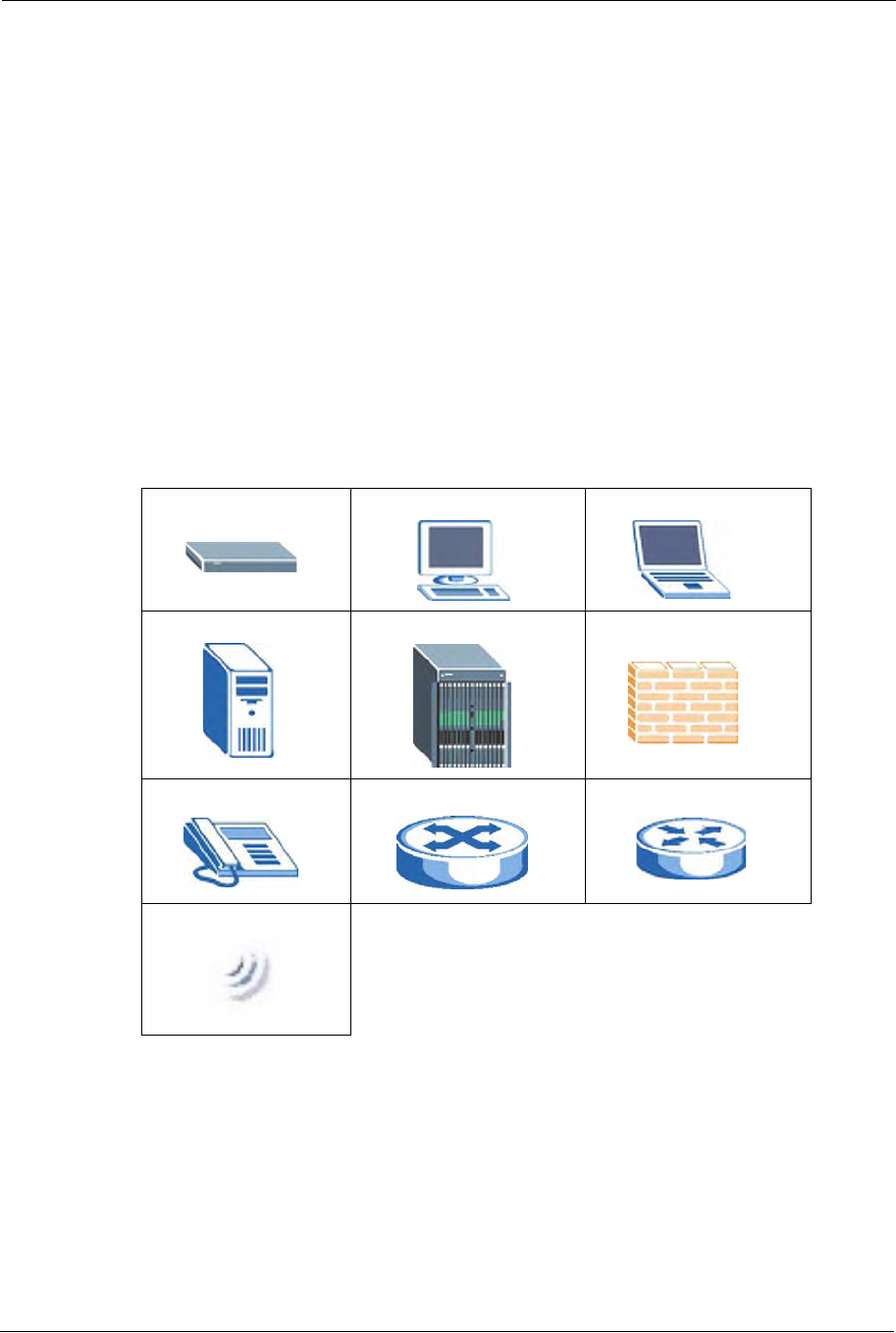
P-660H/HW/W-T Series User’ Guide
39 Preface
• Web Configurator Online Help
Embedded web help for descriptions of individual screens and supplementary
information.
• ZyXEL Glossary and Web Site
Please refer to www.zyxel.com for an online glossary of networking terms and additional
support documentation.
User Guide Feedback
Help us help you. E-mail all User Guide-related comments, questions or suggestions for
improvement to techwriters@zyxel.com.tw or send regular mail to The Technical Writing
Team, ZyXEL Communications Corp., 6 Innovation Road II, Science-Based Industrial Park,
Hsinchu, 300, Taiwan. Thank you.
Graphics Icons Key
Prestige Computer Notebook computer
Server DSLAM Firewall
Telephone Switch Router
Wireless Signal

P-660H/HW/W-T Series User’ Guide
Introduction to DSL 40
Introduction to DSL
DSL (Digital Subscriber Line) technology enhances the data capacity of the existing twisted-
pair wire that runs between the local telephone company switching offices and most homes
and offices. While the wire itself can handle higher frequencies, the telephone switching
equipment is designed to cut off signals above 4,000 Hz to filter noise off the voice line, but
now everybody is searching for ways to get more bandwidth to improve access to the Web -
hence DSL technologies.
There are actually seven types of DSL service, ranging in speeds from 16 Kbits/sec to 52
Mbits/sec. The services are either symmetrical (traffic flows at the same speed in both
directions), or asymmetrical (the downstream capacity is higher than the upstream capacity).
Asymmetrical services (ADSL) are suitable for Internet users because more information is
usually downloaded than uploaded. For example, a simple button click in a web browser can
start an extended download that includes graphics and text.
As data rates increase, the carrying distance decreases. That means that users who are beyond
a certain distance from the telephone company’s central office may not be able to obtain the
higher speeds.
A DSL connection is a point-to-point dedicated circuit, meaning that the link is always up and
there is no dialing required.
Introduction to ADSL
It is an asymmetrical technology, meaning that the downstream data rate is much higher than
the upstream data rate. As mentioned, this works well for a typical Internet session in which
more information is downloaded, for example, from Web servers, than is uploaded. ADSL
operates in a frequency range that is above the frequency range of voice services, so the two
systems can operate over the same cable.

P-660H/HW/W-T Series User’ Guide
41 Introduction to DSL

P-660H/HW/W-T Series User’ Guide
Chapter 1 Getting To Know Your Prestige 42
CHAPTER 1
Getting To Know Your Prestige
This chapter describes the key features and applications of your Prestige.
1.1 Introducing the Prestige
The Prestige is an ADSL2+ gateway that allows super-fast, secure Internet access over analog
(POTS) or digital (ISDN) telephone lines (depending on your model).
In the Prestige product name, “H” denotes an integrated 4-port switch (hub) and “W” denotes
an included wireless LAN card that provides wireless connectivity.
Models ending in “1”, for example P-660W-T1, denote a device that works over the analog
telephone system, POTS (Plain Old Telephone Service). Models ending in “3” denote a device
that works over ISDN (Integrated Services Digital Network). Models ending in “7” denote a
device that works over T-ISDN (UR-2).
Note: Only use firmware for your Prestige’s specific model. Refer to the label on the
bottom of your Prestige.
The DSL RJ-11 (ADSL over POTS models) or RJ-45 (ADSL over ISDN models) connects to
your ADSL-enabled telephone line. The Prestige is compatible with the ADSL/ADSL2/
ADSL2+ standards. Maximum data rates attainable by the Prestige for each standard are
shown in the next table.
Note: The standard your ISP supports determines the maximum upstream and
downstream speeds attainable. Actual speeds attained also depend on the
distance from your ISP, line quality, etc.
1.2 Features
The following sections describe the features of the Prestige.
Table 1 ADSL Standards
DATA RATE STANDARD UPSTREAM DOWNSTREAM
ADSL 832 kbps 8Mbps
ADSL2 3.5Mbps 12Mbps
ADSL2+ 3.5Mbps 24Mbps

P-660H/HW/W-T Series User’ Guide
43 Chapter 1 Getting To Know Your Prestige
Note: See the product specifications in the appendix for detailed features and
standards support.
High Speed Internet Access
Your Prestige ADSL/ADSL2/ADSL2+ router can support downstream transmission rates of
up to 24Mbps and upstream transmission rates of 3.5Mbps. Actual speeds attained depend on
the ADSL service you subscribed to, distance from your ISP, line quality, etc.
Zero Configuration Internet Access
Once you connect and turn on the Prestige, it automatically detects the Internet connection
settings (such as the VCI/VPI numbers and the encapsulation method) from the ISP and makes
the necessary configuration changes. In cases where additional account information (such as
an Internet account user name and password) is required or the Prestige cannot connect to the
ISP, you will be redirected to web screen(s) for information input or troubleshooting.
Any IP
The Any IP feature allows a computer to access the Internet and the Prestige without changing
the network settings (such as IP address and subnet mask) of the computer, when the IP
addresses of the computer and the Prestige are not in the same subnet.
Firewall
The Prestige is a stateful inspection firewall with DoS (Denial of Service) protection. By
default, when the firewall is activated, all incoming traffic from the WAN to the LAN is
blocked unless it is initiated from the LAN. The Prestige firewall supports TCP/UDP
inspection, DoS detection and prevention, real time alerts, reports and logs.
Content Filtering
Content filtering allows you to block access to forbidden Internet web sites, schedule when the
Prestige should perform the filtering and give trusted LAN IP addresses unfiltered Internet
access.
Traffic Redirect
Traffic redirect forwards WAN traffic to a backup gateway when the Prestige cannot connect
to the Internet, thus acting as an auxiliary if your regular WAN connection fails.
Media Bandwidth Management
ZyXEL’s Media Bandwidth Management allows you to specify bandwidth classes based on an
application and/or subnet. You can allocate specific amounts of bandwidth capacity
(bandwidth budgets) to different bandwidth classes.

P-660H/HW/W-T Series User’ Guide
Chapter 1 Getting To Know Your Prestige 44
Universal Plug and Play (UPnP)
Using the standard TCP/IP protocol, the Prestige and other UPnP enabled devices can
dynamically join a network, obtain an IP address and convey its capabilities to other devices
on the network.
PPPoE (RFC2516)
PPPoE (Point-to-Point Protocol over Ethernet) emulates a dial-up connection. It allows your
ISP to use their existing network configuration with newer broadband technologies such as
ADSL. The PPPoE driver on the Prestige is transparent to the computers on the LAN, which
see only Ethernet and are not aware of PPPoE thus saving you from having to manage PPPoE
clients on individual computers. The Prestige also includes PPPoE idle time-out (the PPPoE
connection terminates after a period of no traffic that you configure) and PPPoE Dial-on-
Demand (the PPPoE connection is brought up only when an Internet access request is made).
Network Address Translation (NAT)
Network Address Translation (NAT) allows the translation of an Internet protocol address
used within one network (for example a private IP address used in a local network) to a
different IP address known within another network (for example a public IP address used on
the Internet).
Dynamic DNS Support
With Dynamic DNS support, you can have a static hostname alias for a dynamic IP address,
allowing the host to be more easily accessible from various locations on the Internet. You must
register for this service with a Dynamic DNS service provider.
DHCP
DHCP (Dynamic Host Configuration Protocol) allows the individual clients (computers)
to obtain the TCP/IP configuration at start-up from a centralized DHCP server. The
Prestige has built-in DHCP server capability enabled by default. It can assign IP
addresses, an IP default gateway and DNS servers to DHCP clients. The Prestige can now
also act as a surrogate DHCP server (DHCP Relay) where it relays IP address assignment
from the actual real DHCP server to the clients.
IP Alias
IP Alias allows you to partition a physical network into logical networks over the same
Ethernet interface. The Prestige supports three logical LAN interfaces via its single
physical Ethernet interface with the Prestige itself as the gateway for each LAN network.
IP Policy Routing (IPPR)
Traditionally, routing is based on the destination address only and the router takes the
shortest path to forward a packet. IP Policy Routing (IPPR) provides a mechanism to
override the default routing behavior and alter the packet forwarding based on the policy
defined by the network administrator.

P-660H/HW/W-T Series User’ Guide
45 Chapter 1 Getting To Know Your Prestige
Packet Filters
The Prestige's packet filtering functions allows added network security and management.
Housing
Your Prestige's compact and ventilated housing minimizes space requirements making it easy
to position anywhere in your busy office.
4-Port Switch (P-660H/P-660HW)
A combination of switch and router makes your Prestige a cost-effective and viable network
solution. You can connect up to four computers to the Prestige without the cost of a hub. Use a
hub to add more than four computers to your LAN.
1.2.1 Wireless Features (P-660HW/P-660W)
Wireless LAN
The Prestige supports the IEEE 802.11g standard, which is fully compatible with the IEEE
802.11b standard, meaning that you can have both IEEE 802.11b and IEEE 802.11g wireless
clients in the same wireless network.
Note: The Prestige may be prone to RF (Radio Frequency) interference from other
2.4 GHz devices such as microwave ovens, wireless phones, Bluetooth
enabled devices, and other wireless LANs.
Wi-Fi Protected Access
Wi-Fi Protected Access (WPA) is a subset of the IEEE 802.11i security specification standard.
Key differences between WPA and WEP are user authentication and improved data
encryption.
Antenna
The Prestige is equipped with one 2dBi fixed antenna to provide clear radio signal between the
wireless stations and the access points.
Wireless LAN MAC Address Filtering
Your Prestige can check the MAC addresses of wireless stations against a list of allowed or
denied MAC addresses.
WEP Encryption
WEP (Wired Equivalent Privacy) encrypts data frames before transmitting over the wireless
network to help keep network communications private.
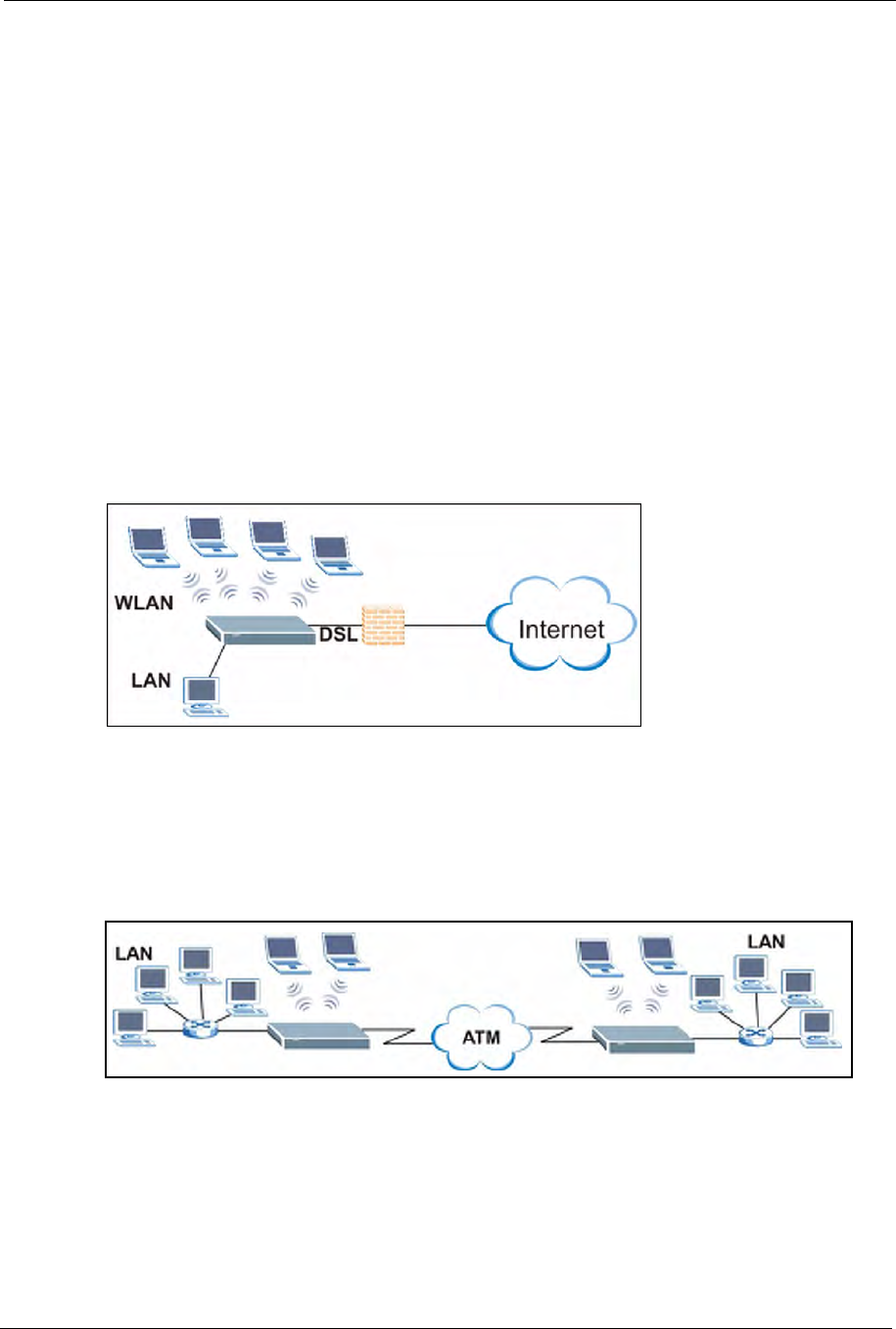
P-660H/HW/W-T Series User’ Guide
Chapter 1 Getting To Know Your Prestige 46
1.3 Applications for the Prestige
Here are some example uses for which the Prestige is well suited. Application graphics shown
are for the P-660W.
1.3.1 Protected Internet Access
The Prestige is the ideal high-speed Internet access solution. It is compatible with all major
ADSL DSLAM (Digital Subscriber Line Access Multiplexer) providers and supports the
ADSL standards as shown in Table 1 on page 42. In addition, the Prestige allows wireless
clients access to your network resources.
The Prestige provides protection from attacks by Internet hackers. By default, the firewall
blocks all incoming traffic from the WAN. The firewall supports TCP/UDP inspection and
DoS (Denial of Services) detection and prevention, as well as real time alerts, reports and logs.
Figure 1 Protected Internet Access Applications
ss
1.3.2 LAN to LAN Application
You can use the Prestige to connect two geographically dispersed networks over the ADSL
line. A typical LAN-to-LAN application example is shown as follows.
Figure 2 LAN-to-LAN Application Example
1.4 Front Panel LEDs
The following figure shows the front panel LEDs.

P-660H/HW/W-T Series User’ Guide
47 Chapter 1 Getting To Know Your Prestige
The following table describes the LEDs.
1.5 Hardware Connection
Refer to the Quick Start Guide for information on hardware connection.
Table 2 Front Panel LEDs
LED COLOR STATUS DESCRIPTION
PWR/SYS Green On The Prestige is receiving power and functioning properly.
Blinking The Prestige is rebooting or performing diagnostics.
Red On Power to the Prestige is too low.
Off The system is not ready or has malfunctioned.
LAN Green On The Prestige has a successful 10Mb Ethernet connection.
Blinking The Prestige is sending/receiving data.
Amber On The Prestige has a successful 100Mb Ethernet connection.
Blinking The Prestige is sending/receiving data.
Off The LAN is not connected.
WLAN (P-
660HW/ P-
660W)
Green On The Prestige is ready, but is not sending/receiving data
through the wireless LAN.
Blinking The Prestige is sending/receiving data through the wireless
LAN.
Off The wireless LAN is not ready or has failed.
DSL/PPP Green Fast
Blinking
The Prestige is sending/receiving non-PPP data.
Slow
Blinking
The Prestige is initializing the DSL line.
On The system is ready, but is not sending/receiving non-PPP
data.
Amber On The connection to the PPPoE server is up.
Blinking The Prestige is sending/receiving PPP data.
Off The DSL link is down.

P-660H/HW/W-T Series User’ Guide
Chapter 2 Introducing the Web Configurator 48
CHAPTER 2
Introducing the Web
Configurator
This chapter describes how to access and navigate the web configurator.
2.1 Web Configurator Overview
The web configurator is an HTML-based management interface that allows easy Prestige
setup and management via Internet browser. Use Internet Explorer 6.0 and later or Netscape
Navigator 7.0 and later versions. The recommended screen resolution is 1024 by 768 pixels.
In order to use the web configurator you need to allow:
• Web browser pop-up windows from your device. Web pop-up blocking is enabled by
default in Windows XP SP (Service Pack) 2.
• JavaScripts (enabled by default).
• Java permissions (enabled by default).
See the chapter on troubleshooting if you need to make sure these functions are allowed in
Internet Explorer.
2.1.1 Accessing the Web Configurator
Note: Even though you can connect to the Prestige wirelessly, it is recommended that
you connect your computer to a LAN port for initial configuration.
1Make sure your Prestige hardware is properly connected (refer to the Quick Start Guide).
2Prepare your computer/computer network to connect to the Prestige (refer to the Quick
Start Guide).
3Launch your web browser.
4Type "192.168.1.1" as the URL.
5A window displays as shown.The Password field already contains the default password
“1234”. Click Login to proceed to a screen asking you to change your password or click
Cancel to revert to the default password.
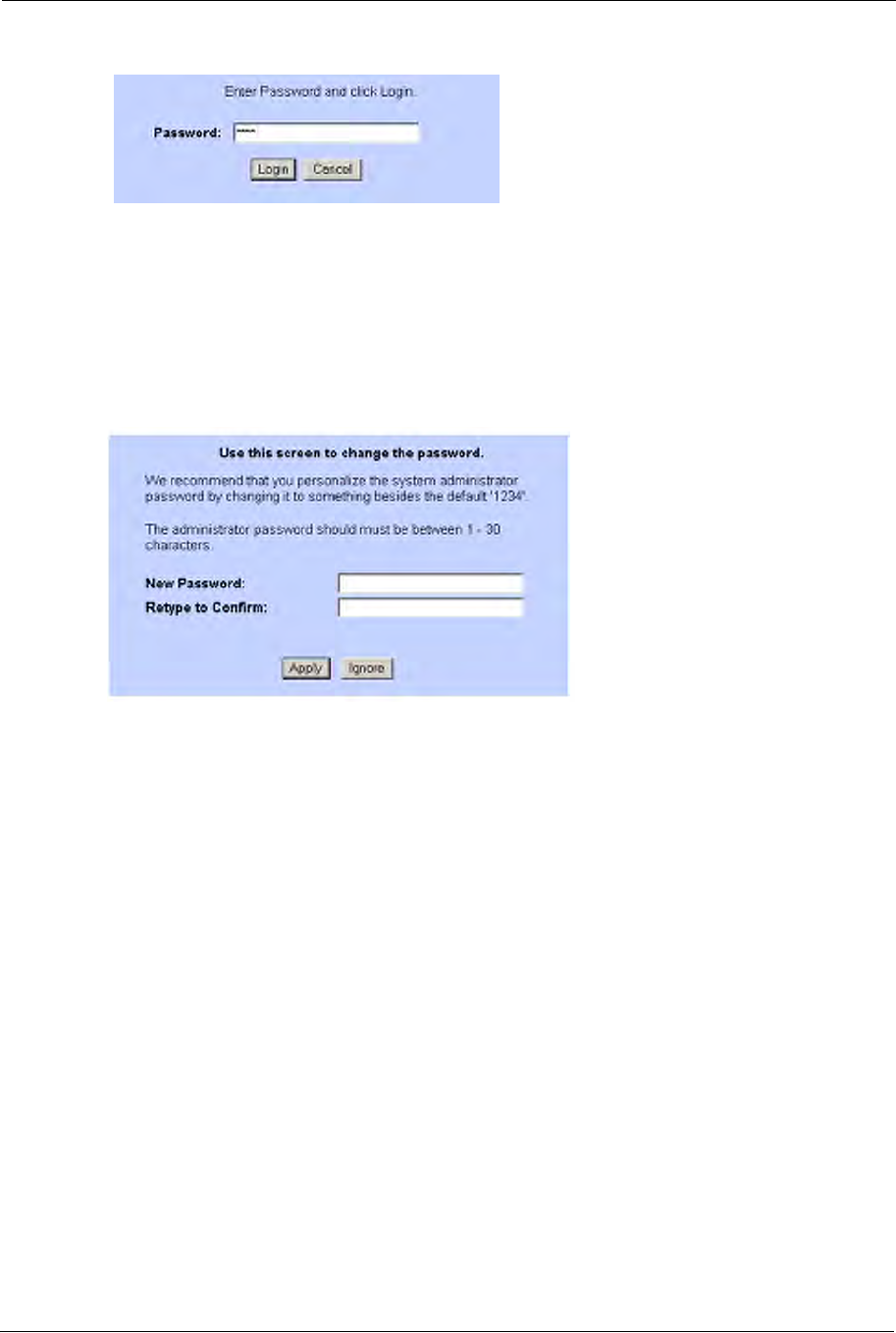
P-660H/HW/W-T Series User’ Guide
49 Chapter 2 Introducing the Web Configurator
Figure 3 Password Screen
6It is highly recommended you change the default password! Enter a new password
between 1 and 30 characters, retype it to confirm and click Apply; alternatively click
Ignore to proceed to the main menu if you do not want to change the password now.
Note: If you do not change the password at least once, the following screen appears
every time you log in.
Figure 4 Change Password at Login
7You should now see the SITE MAP screen.
Note: The Prestige automatically times out after five minutes of inactivity. Simply log
back into the Prestige if this happens to you.
2.1.2 Resetting the Prestige
If you forget your password or cannot access the web configurator, you will need to use the
RESET button at the back of the Prestige to reload the factory-default configuration file. This
means that you will lose all configurations that you had previously and the password will be
reset to “1234”.
2.1.2.1 Using the Reset Button
1Make sure the PWR/SYS LED is on (not blinking).
2Press the RESET button for ten seconds or until the PWR/SYS LED begins to blink and
then release it. When the PWR/SYS LED begins to blink, the defaults have been restored
and the Prestige restarts.
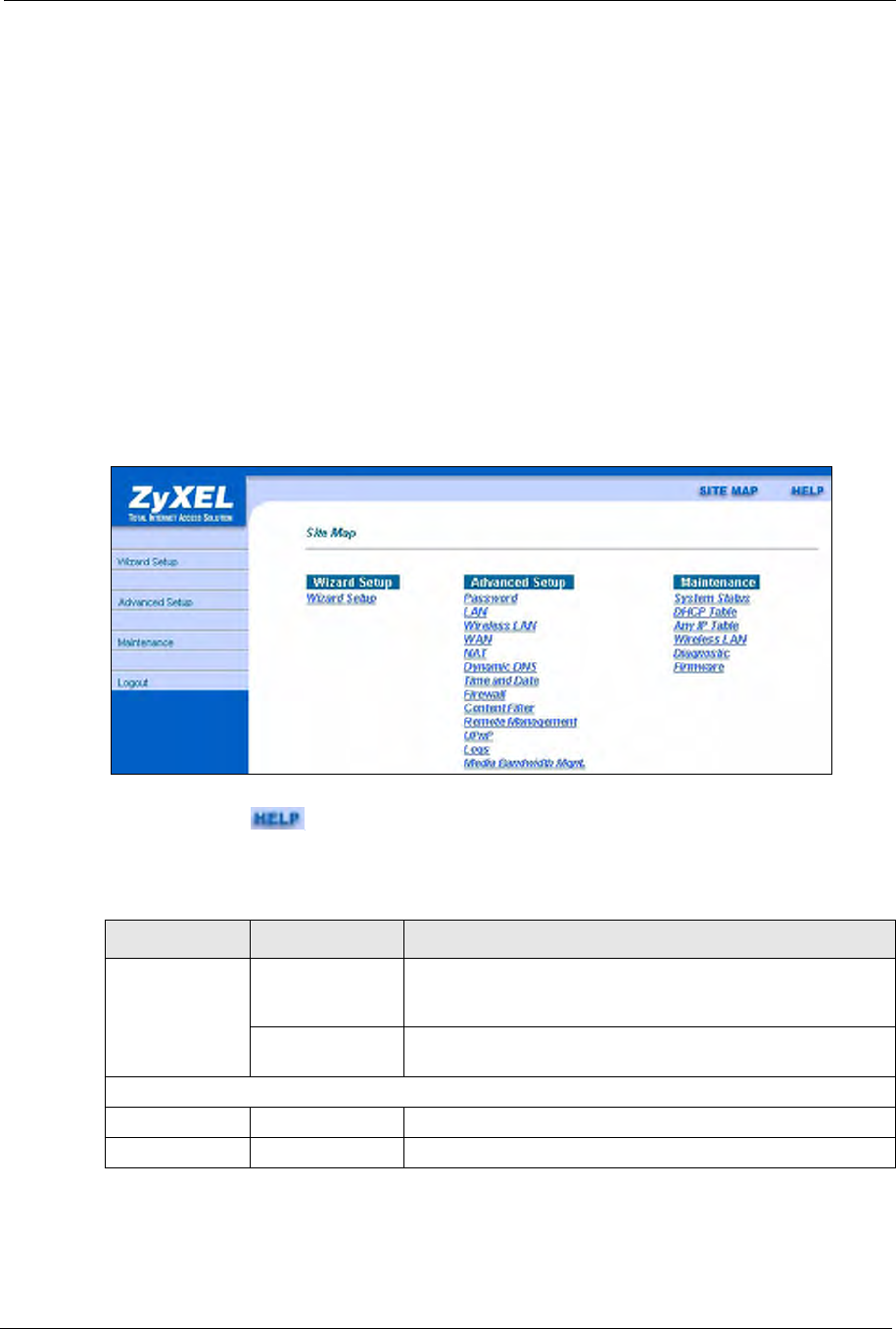
P-660H/HW/W-T Series User’ Guide
Chapter 2 Introducing the Web Configurator 50
2.1.3 Navigating the Web Configurator
The following summarizes how to navigate the web configurator from the SITE MAP screen.
We use the Prestige 660W-T1 web screens in this guide as an example. Screens vary slightly
for different Prestige models.
• Click Wizard Setup to begin a series of screens to configure your Prestige for the first
time.
• Click a link under Advanced Setup to configure advanced Prestige features.
• Click a link under Maintenance to see Prestige performance statistics, upload firmware
and back up, restore or upload a configuration file.
• Click Site Map to go to the Site Map screen.
• Click Logout in the navigation panel when you have finished a Prestige management
session.
Figure 5 Web Configurator: Site Map Screen
Note: Click the icon (located in the top right corner of most screens) to view
embedded help.
Table 3 Web Configurator Screens Summary
LINK SUB-LINK FUNCTION
Wizard Setup Connection Setup Use these screens for initial configuration including general
setup, ISP parameters for Internet Access and WAN IP/DNS
Server/MAC address assignment.
Media Bandwidth
Mgnt
Use these screens to limit bandwidth usage by application.
Advanced Setup
Password Use this screen to change your password.
LAN Use this screen to configure LAN DHCP and TCP/IP settings.

P-660H/HW/W-T Series User’ Guide
51 Chapter 2 Introducing the Web Configurator
Wireless LAN
(P-660W / P-
660HW only)
Wireless Use this screen to configure the wireless LAN settings.
MAC Filter Use this screen to change MAC filter settings on the Prestige.
802.1x/WPA Use this screen to configure WLAN authentication and security
settings.
Local User
Database
Use this screen to set up built-in user profiles for wireless
station authentication.
RADIUS Use this screen to specify the external RADIUS server for
wireless station authentication.
WAN WAN Setup Use this screen to change the Prestige’s WAN remote node
settings.
WAN Backup Use this screen to configure your traffic redirect properties and
WAN backup settings.
NAT SUA Only Use this screen to configure servers behind the Prestige.
Full Feature Use this screen to configure network address translation
mapping rules.
Dynamic DNS Use this screen to set up dynamic DNS.
Time and Date Use this screen to change your Prestige’s time and date.
Firewall Default Policy Use this screen to activate/deactivate the firewall and the
direction of network traffic to which to apply the rule.
Rule Summary This screen shows a summary of the firewall rules, and allows
you to edit/add a firewall rule.
Anti Probing Use this screen to change your anti-probing settings.
Threshold Use this screen to configure the threshold for DoS attacks.
Content Filter Keyword Use this screen to block sites containing certain keywords in the
URL.
Schedule Use this screen to set the days and times for the Prestige to
perform content filtering.
Trusted Use this screen to exclude a range of users on the LAN from
content filtering on your Prestige.
Remote
Management
Use this screen to configure through which interface(s) and
from which IP address(es) users can use Telnet/FTP/Web to
manage the Prestige.
UPnP Use this screen to enable UPnP on the Prestige.
Logs Log Settings Use this screen to change your Prestige’s log settings.
View Log Use this screen to view the logs for the categories that you
selected.
Media Bandwidth
Management
Summary Use this screen to assign bandwidth limits to specific types of
traffic.
Class Setup Use this screen to define a bandwidth class.
Monitor Use this screen to view bandwidth class statistics.
Maintenance
System Status This screen contains administrative and system-related
information.
Table 3 Web Configurator Screens Summary (continued)
LINK SUB-LINK FUNCTION
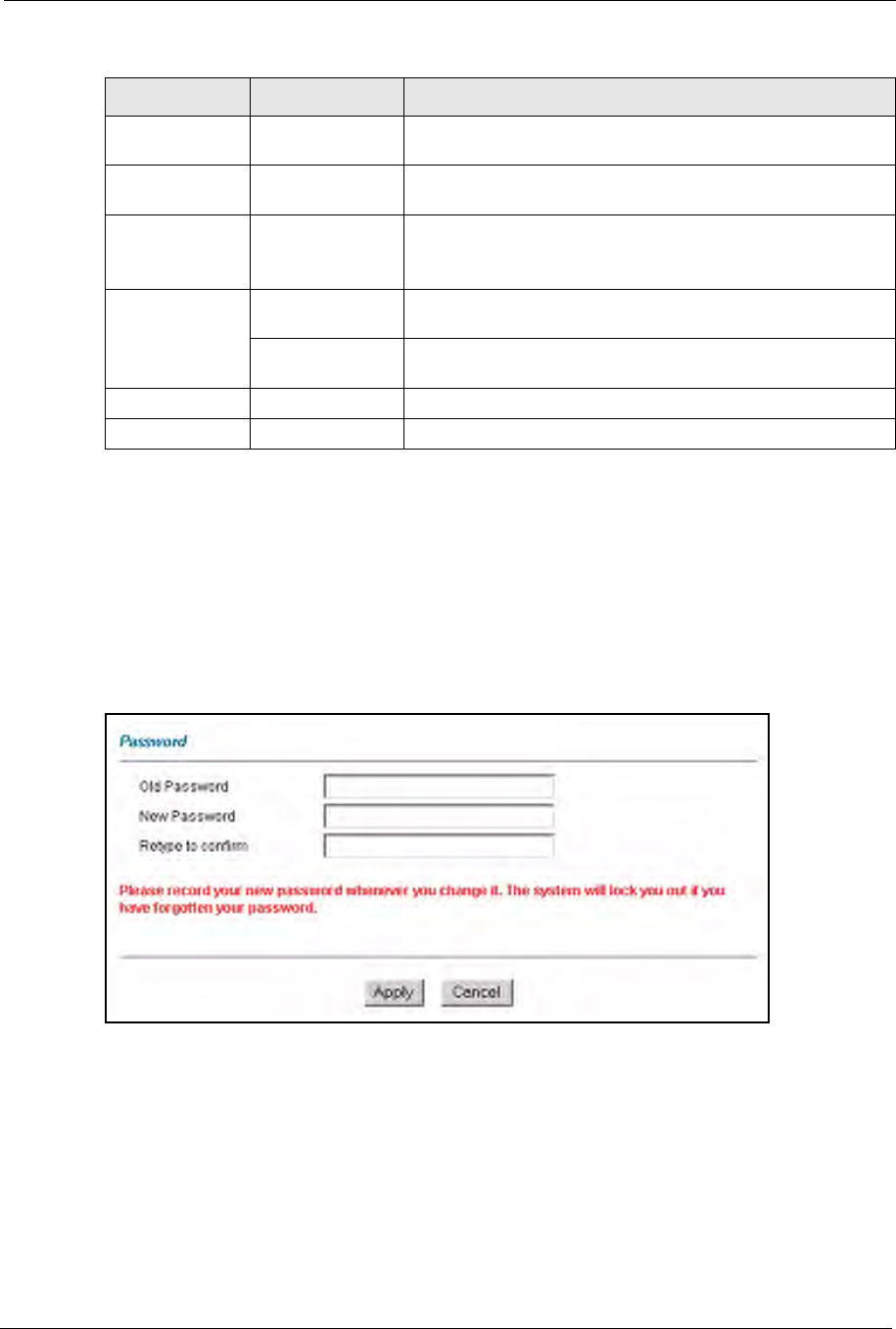
P-660H/HW/W-T Series User’ Guide
Chapter 2 Introducing the Web Configurator 52
2.2 Change Login Password
It is highly recommended that you periodically change the password for accessing the
Prestige. If you didn’t change the default one after you logged in or you want to change to a
new password again, then click Password in the Site Map screen to display the screen as
shown next.
Figure 6 Password
The following table describes the fields in this screen.
DHCP Table This screen displays DHCP (Dynamic Host Configuration
Protocol) related information and is READ-ONLY.
Any IP Table Use this screen to view the IP and MAC addresses of LAN
computers communicating with the Prestige.
Wireless LAN
(P-660W / P-
660HW only)
Association List This screen displays the MAC address(es) of the wireless
stations that are currently associating with the Prestige.
Diagnostic General These screens display information to help you identify problems
with the Prestige general connection.
DSL Line These screens display information to help you identify problems
with the DSL line.
Firmware Use this screen to upload firmware to your Prestige
LOGOUT Click Logout to exit the web configurator.
Table 3 Web Configurator Screens Summary (continued)
LINK SUB-LINK FUNCTION

P-660H/HW/W-T Series User’ Guide
53 Chapter 2 Introducing the Web Configurator
Table 4 Password
LABEL DESCRIPTION
Old Password Type the default password or the existing password you use to access the system
in this field.
New Password Type the new password in this field.
Retype to Confirm Type the new password again in this field.
Apply Click Apply to save your changes back to the Prestige.
Cancel Click Cancel to begin configuring this screen afresh.
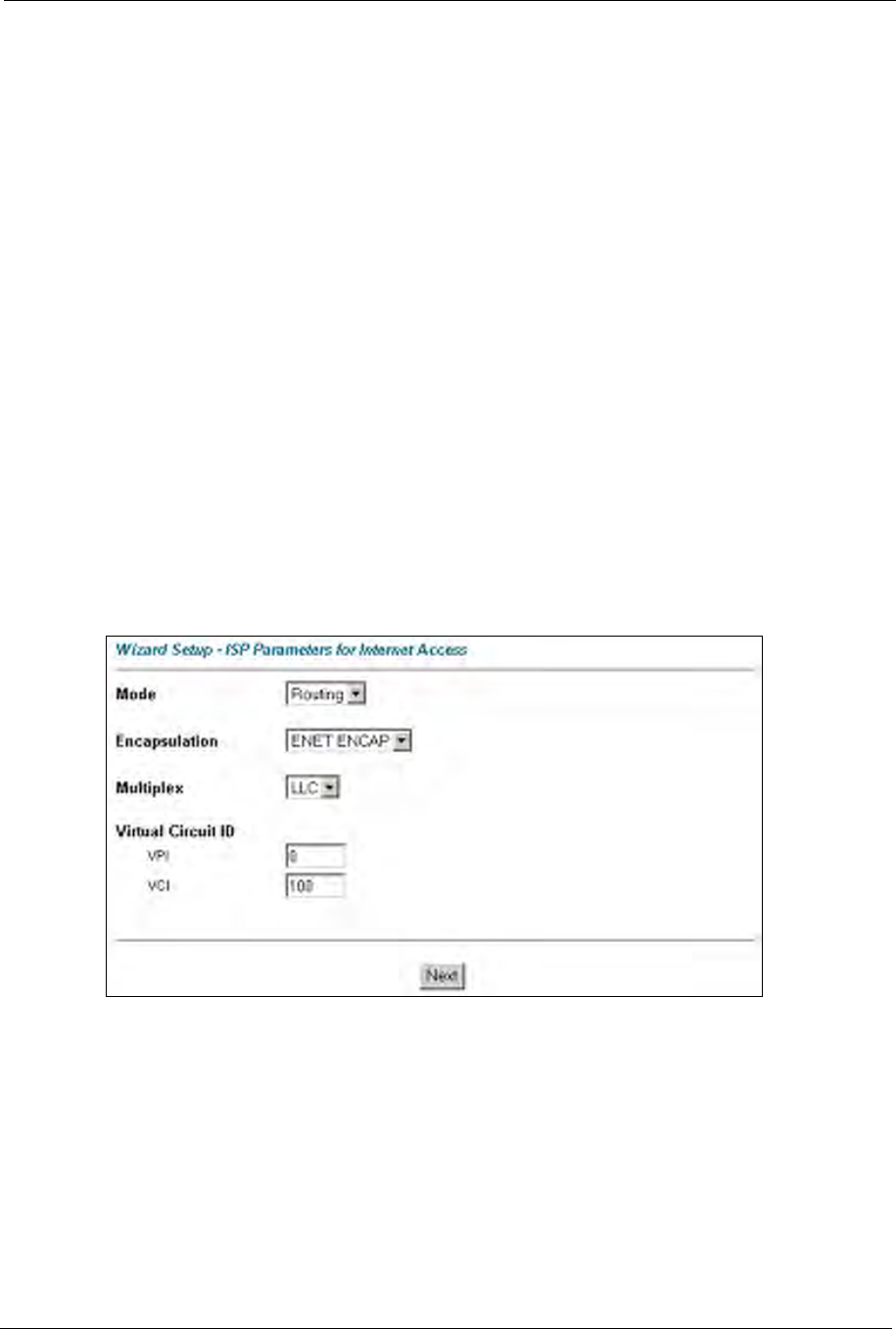
P-660H/HW/W-T Series User’ Guide
Chapter 3 Wizard Setup for Internet Access 54
CHAPTER 3
Wizard Setup for Internet Access
This chapter provides information on the Wizard Setup screens for Internet access in the web
configurator.
3.1 Introduction
Use the Wizard Setup screens to configure your system for Internet access with the
information given to you by your ISP.
Note: See the advanced menu chapters for background information on these fields.
3.1.1 Internet Access Wizard Setup
1 In the SITE MAP screen click Wizard Setup to display the first wizard screen.
Figure 7 Internet Access Wizard Setup: ISP Parameters
The following table describes the fields in this screen.
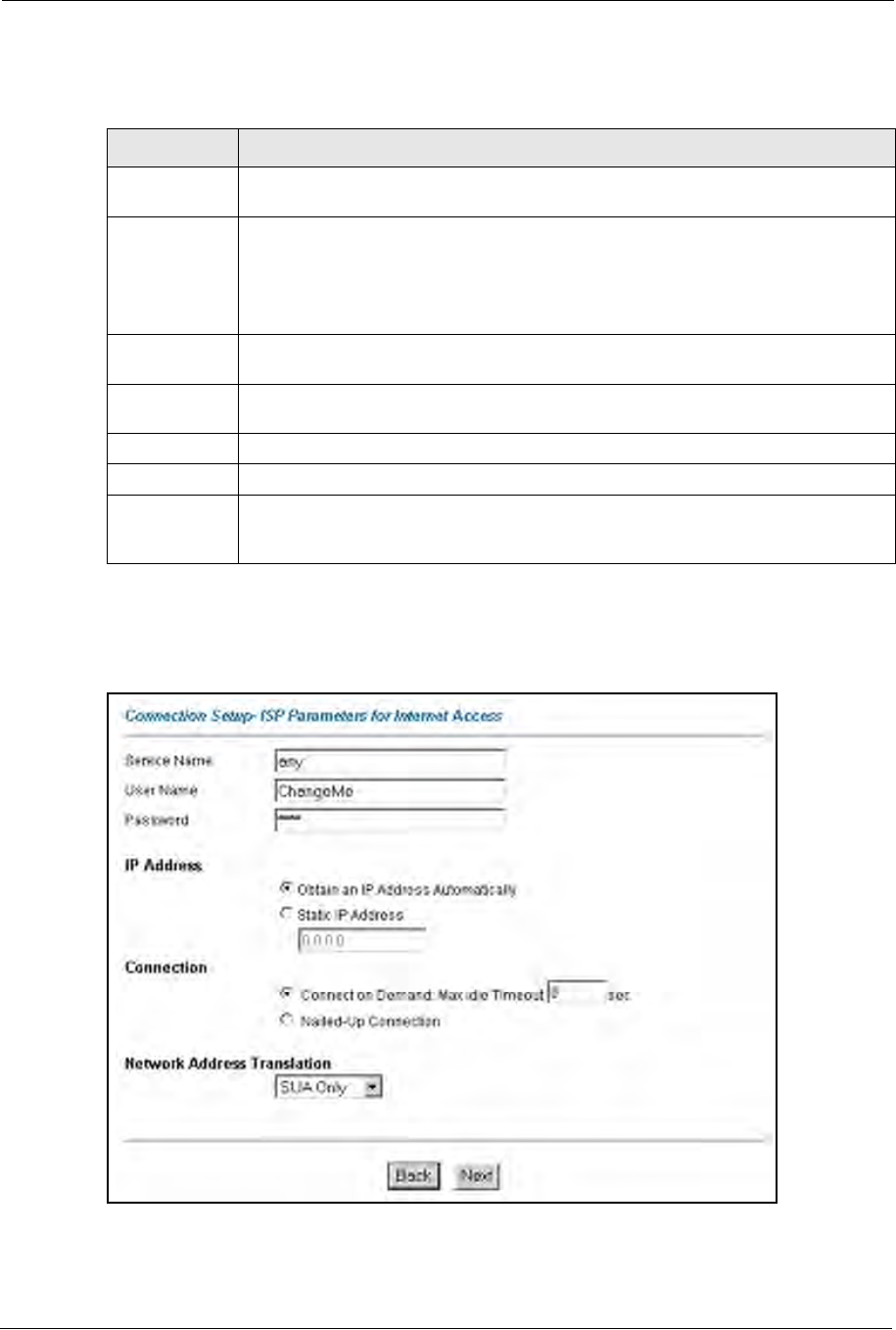
P-660H/HW/W-T Series User’ Guide
55 Chapter 3 Wizard Setup for Internet Access
2The next wizard screen varies depending on what mode and encapsulation type you use.
All screens shown are with routing mode. Configure the fields and click Next to continue.
Figure 8 Internet Connection with PPPoE
The following table describes the fields in this screen.
Table 5 Internet Access Wizard Setup: ISP Parameters
LABEL DESCRIPTION
Mode From the Mode drop-down list box, select Routing (default) if your ISP allows
multiple computers to share an Internet account. Otherwise select Bridge.
Encapsulation Select the encapsulation type your ISP uses from the Encapsulation drop-down list
box. Choices vary depending on what you select in the Mode field.
If you select Bridge in the Mode field, select either PPPoA or RFC 1483.
If you select Routing in the Mode field, select PPPoA,RFC 1483,ENET ENCAP or
PPPoE.
Multiplex Select the multiplexing method used by your ISP from the Multiplex drop-down list
box either VC-based or LLC-based.
Virtual Circuit
ID
VPI (Virtual Path Identifier) and VCI (Virtual Channel Identifier) define a virtual circuit.
Refer to the appendix for more information.
VPI Enter the VPI assigned to you. This field may already be configured.
VCI Enter the VCI assigned to you. This field may already be configured.
Next Click this button to go to the next wizard screen. The next wizard screen you see
depends on what protocol you chose above. Click on the protocol link to see the next
wizard screen for that protocol.
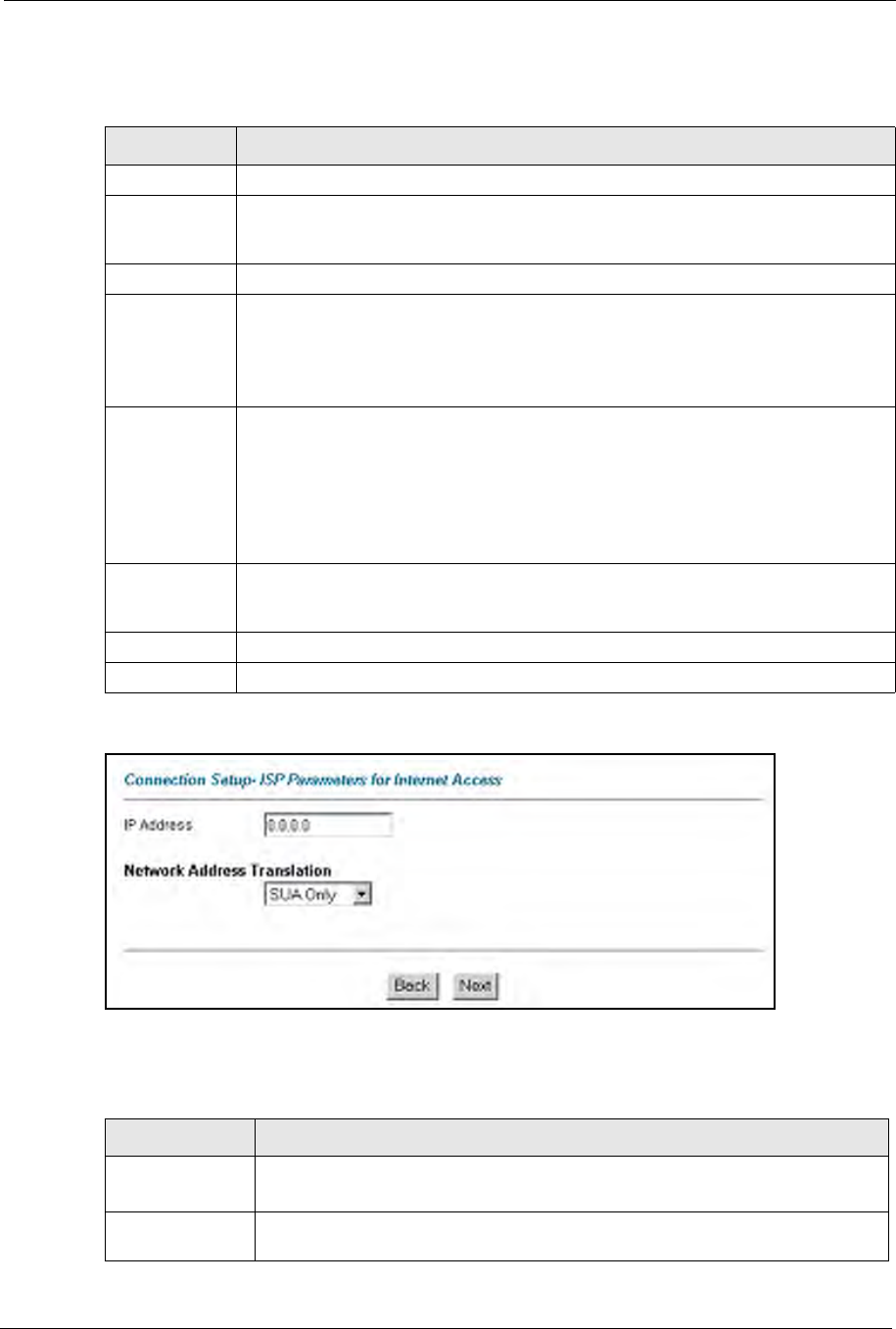
P-660H/HW/W-T Series User’ Guide
Chapter 3 Wizard Setup for Internet Access 56
Figure 9 Internet Connection with RFC 1483
The following table describes the fields in this screen.
Table 6 Internet Connection with PPPoE
LABEL DESCRIPTION
Service Name Type the name of your PPPoE service here.
User Name Enter the user name exactly as your ISP assigned. If assigned a name in the form
user@domain where domain identifies a service name, then enter both components
exactly as given.
Password Enter the password associated with the user name above.
IP Address A static IP address is a fixed IP that your ISP gives you. A dynamic IP address is not
fixed; the ISP assigns you a different one each time you connect to the Internet.
Select Obtain an IP Address Automatically if you have a dynamic IP address;
otherwise select Static IP Address and type your ISP assigned IP address in the text
box below.
Connection Select Connect on Demand when you don't want the connection up all the time and
specify an idle time-out (in seconds) in the Max. Idle Timeout field. The default
setting selects Connection on Demand with 0 as the idle time-out, which means the
Internet session will not timeout.
Select Nailed-Up Connection when you want your connection up all the time. The
Prestige will try to bring up the connection automatically if it is disconnected.
The schedule rule(s) in SMT menu 26 has priority over your Connection settings.
Network
Address
Translation
Select None,SUA Only or Full Feature from the drop-sown list box. Refer to the NAT
chapter for more details.
Back Click Back to go back to the first wizard screen.
Next Click Next to continue to the next wizard screen.
Table 7 Internet Connection with RFC 1483
LABEL DESCRIPTION
IP Address This field is available if you select Routing in the Mode field.
Type your ISP assigned IP address in this field.
Network Address
Translation
Select None,SUA Only or Full Feature from the drop-down list box. Refer to the
NAT chapter for more details.
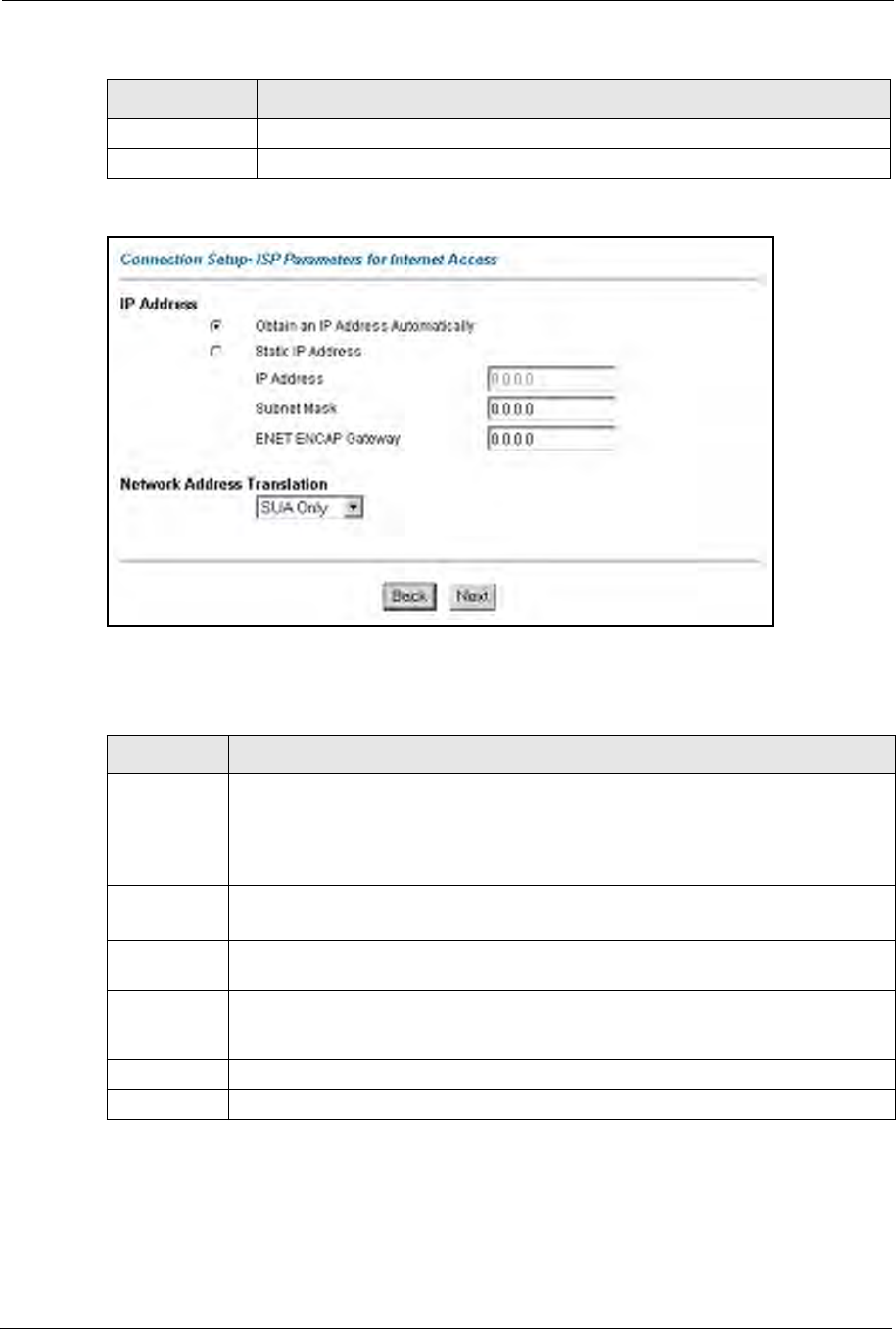
P-660H/HW/W-T Series User’ Guide
57 Chapter 3 Wizard Setup for Internet Access
Figure 10 Internet Connection with ENET ENCAP
The following table describes the fields in this screen.
Back Click Back to go back to the first wizard screen.
Next Click Next to continue to the next wizard screen.
Table 8 Internet Connection with ENET ENCAP
LABEL DESCRIPTION
IP Address A static IP address is a fixed IP that your ISP gives you. A dynamic IP address is not
fixed; the ISP assigns you a different one each time you connect to the Internet.
Select Obtain an IP Address Automatically if you have a dynamic IP address;
otherwise select Static IP Address and type your ISP assigned IP address in the IP
Address text box below.
Subnet Mask Enter a subnet mask in dotted decimal notation.
Refer to the appendices to calculate a subnet mask If you are implementing subnetting.
ENET ENCAP
Gateway
You must specify a gateway IP address (supplied by your ISP) when you use ENET
ENCAP in the Encapsulation field in the previous screen.
Network
Address
Translation
Select None,SUA Only or Full Feature from the drop-sown list box. Refer to the NAT
chapter for more details.
Back Click Back to go back to the first wizard screen.
Next Click Next to continue to the next wizard screen.
Table 7 Internet Connection with RFC 1483 (continued)
LABEL DESCRIPTION
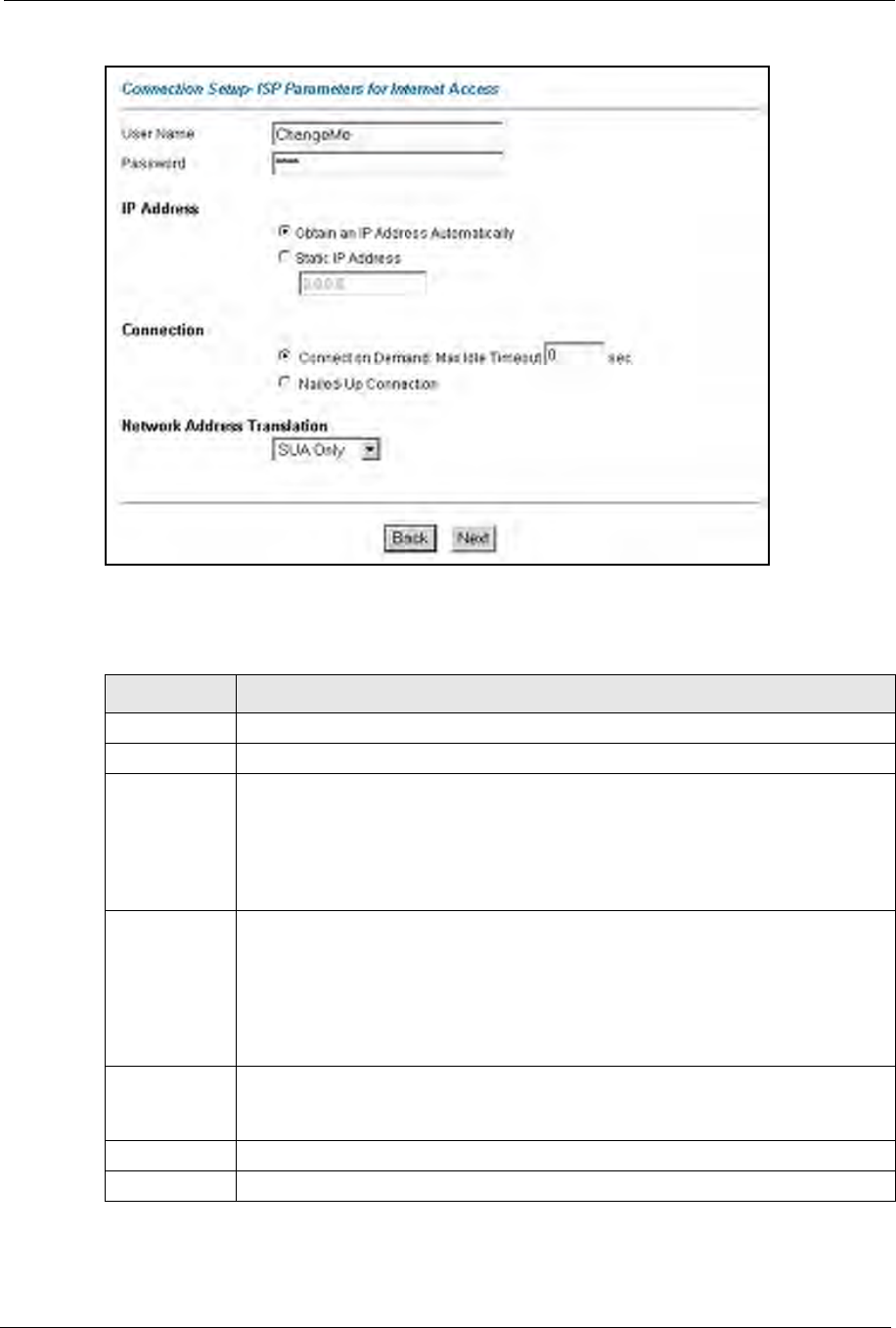
P-660H/HW/W-T Series User’ Guide
Chapter 3 Wizard Setup for Internet Access 58
Figure 11 Internet Connection with PPPoA
The following table describes the fields in this screen.
Table 9 Internet Connection with PPPoA
LABEL DESCRIPTION
User Name Enter the login name that your ISP gives you.
Password Enter the password associated with the user name above.
IP Address This option is available if you select Routing in the Mode field.
A static IP address is a fixed IP that your ISP gives you. A dynamic IP address is not
fixed; the ISP assigns you a different one each time you connect to the Internet.
Click Obtain an IP Address Automatically if you have a dynamic IP address;
otherwise click Static IP Address and type your ISP assigned IP address in the IP
Address text box below.
Connection Select Connect on Demand when you don't want the connection up all the time and
specify an idle time-out (in seconds) in the Max. Idle Timeout field. The default setting
selects Connection on Demand with 0 as the idle time-out, which means the Internet
session will not timeout.
Select Nailed-Up Connection when you want your connection up all the time. The
Prestige will try to bring up the connection automatically if it is disconnected.
The schedule rule(s) in SMT menu 26 has priority over your Connection settings.
Network
Address
Translation
This option is available if you select Routing in the Mode field.
Select None,SUA Only or Full Feature from the drop-sown list box. Refer to the NAT
chapter for more details.
Back Click Back to go back to the first wizard screen.
Next Click Next to continue to the next wizard screen.
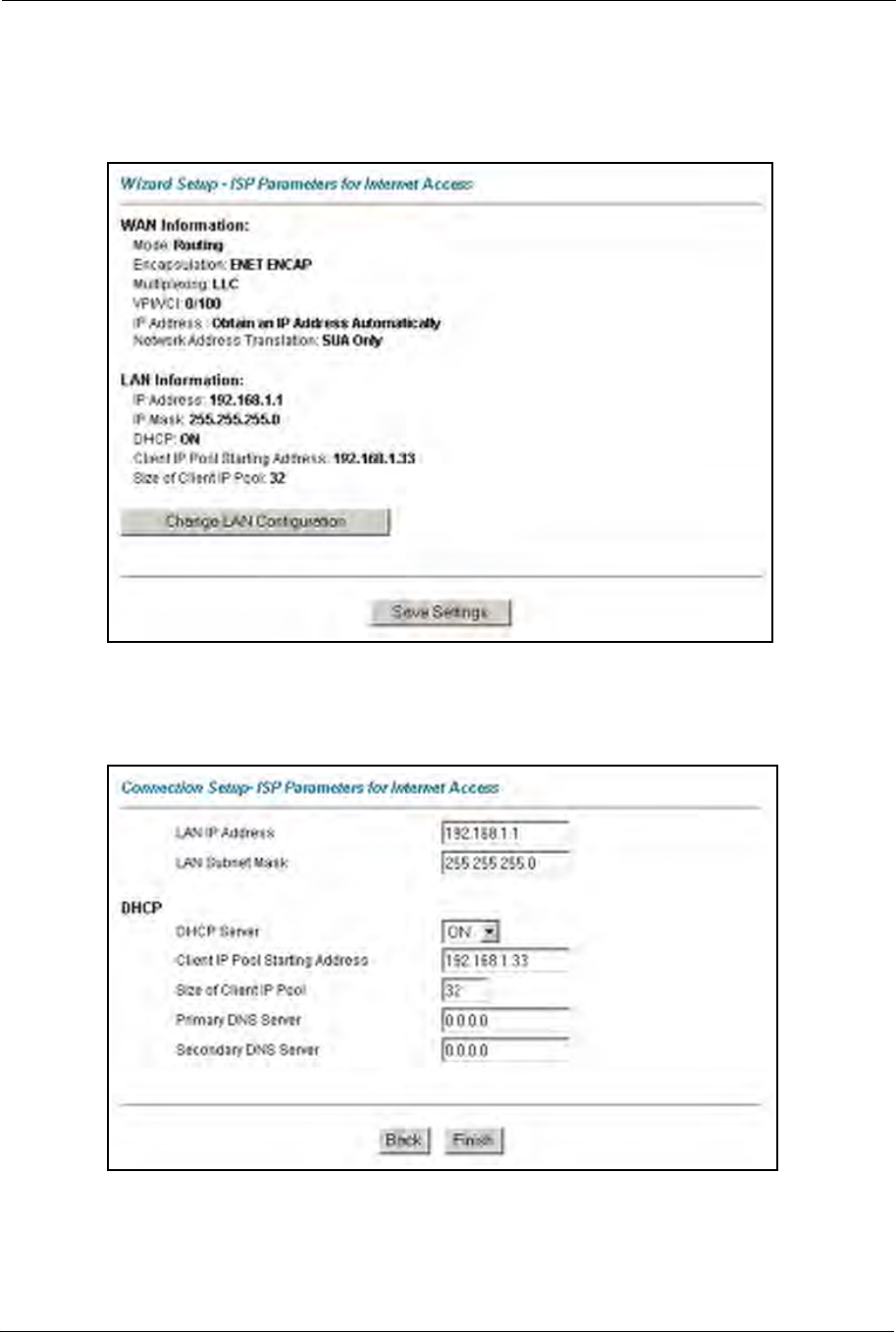
P-660H/HW/W-T Series User’ Guide
59 Chapter 3 Wizard Setup for Internet Access
3Verify the settings in the screen shown next. To change the LAN information on the
Prestige, click Change LAN Configurations. Otherwise click Save Settings to save the
configuration and skip to the section 3.13.
Figure 12 Internet Access Wizard Setup: Third Screen
If you want to change your Prestige LAN settings, click Change LAN Configuration to
display the screen as shown next.
Figure 13 Internet Access Wizard Setup: LAN Configuration
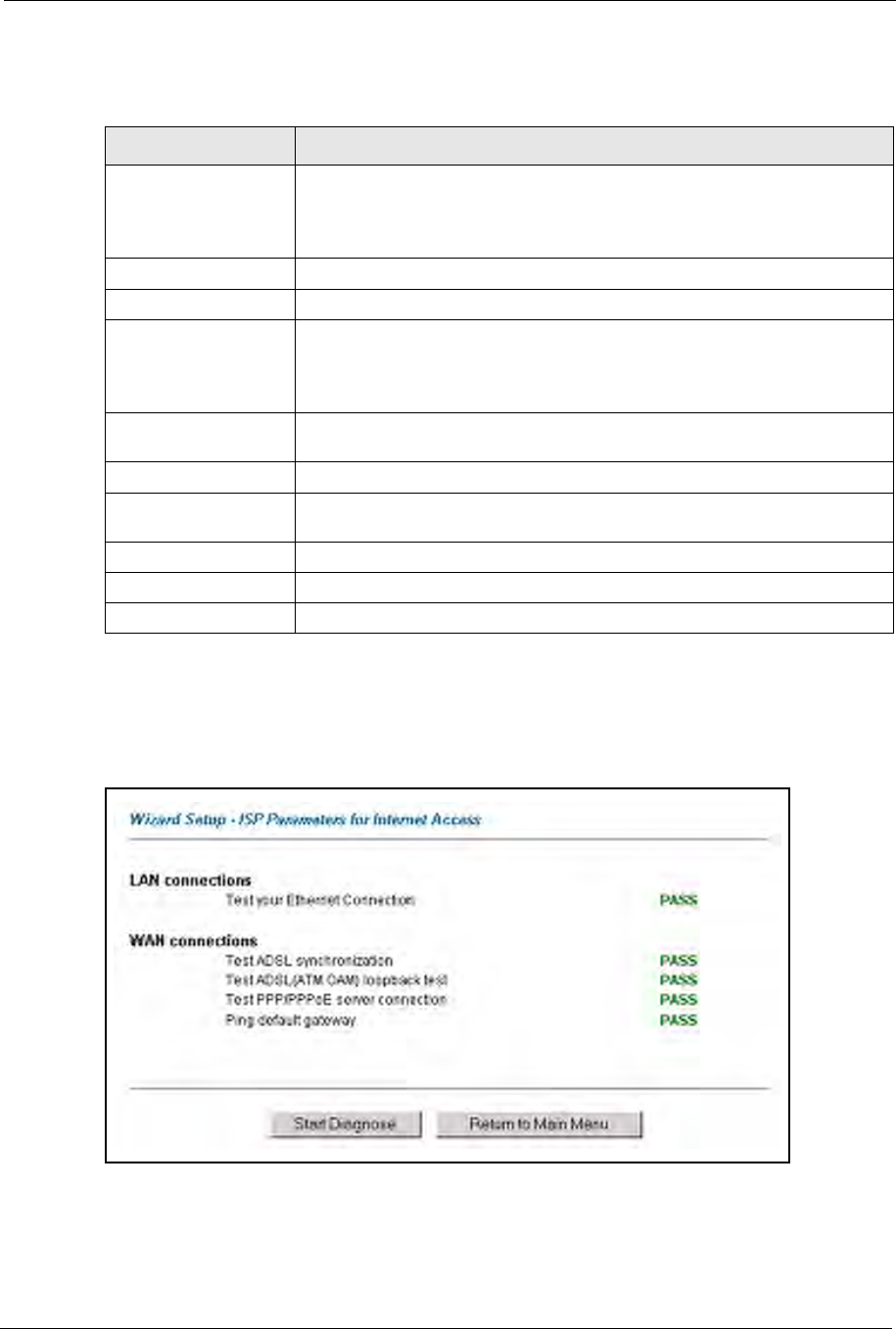
P-660H/HW/W-T Series User’ Guide
Chapter 3 Wizard Setup for Internet Access 60
The following table describes the fields in this screen.
4The Prestige automatically tests the connection to the computer(s) connected to the LAN
ports. To test the connection from the Prestige to the ISP, click Start Diagnose.
Otherwise click Return to Main Menu to go back to the Site Map screen.
Figure 14 Internet Access Wizard Setup: Connection Tests
5Launch your web browser and navigate to www.zyxel.com. Internet access is just the
beginning. Refer to the rest of this guide for more detailed information on the complete
range of Prestige features. If you cannot access the Internet, open the web configurator
again to confirm that the Internet settings you configured in the Wizard Setup are correct.
Table 10 Internet Access Wizard Setup: LAN Configuration
LABEL DESCRIPTION
LAN IP Address Enter the IP address of your Prestige in dotted decimal notation, for example,
192.168.1.1 (factory default).
If you changed the Prestige's LAN IP address, you must use the new IP
address if you want to access the web configurator again.
LAN Subnet Mask Enter a subnet mask in dotted decimal notation.
DHCP
DHCP Server From the DHCP Server drop-down list box, select On to allow your Prestige to
assign IP addresses, an IP default gateway and DNS servers to computer
systems that support the DHCP client. Select Off to disable DHCP server.
When DHCP server is used, set the following items:
Client IP Pool Starting
Address
This field specifies the first of the contiguous addresses in the IP address
pool.
Size of Client IP Pool This field specifies the size or count of the IP address pool.
Primary DNS Server Enter the IP addresses of the DNS servers. The DNS servers are passed to
the DHCP clients along with the IP address and the subnet mask.
Secondary DNS Server As above.
Back Click Back to go back to the previous screen.
Finish Click Finish to save the settings and proceed to the next wizard screen.

P-660H/HW/W-T Series User’ Guide
61 Chapter 3 Wizard Setup for Internet Access
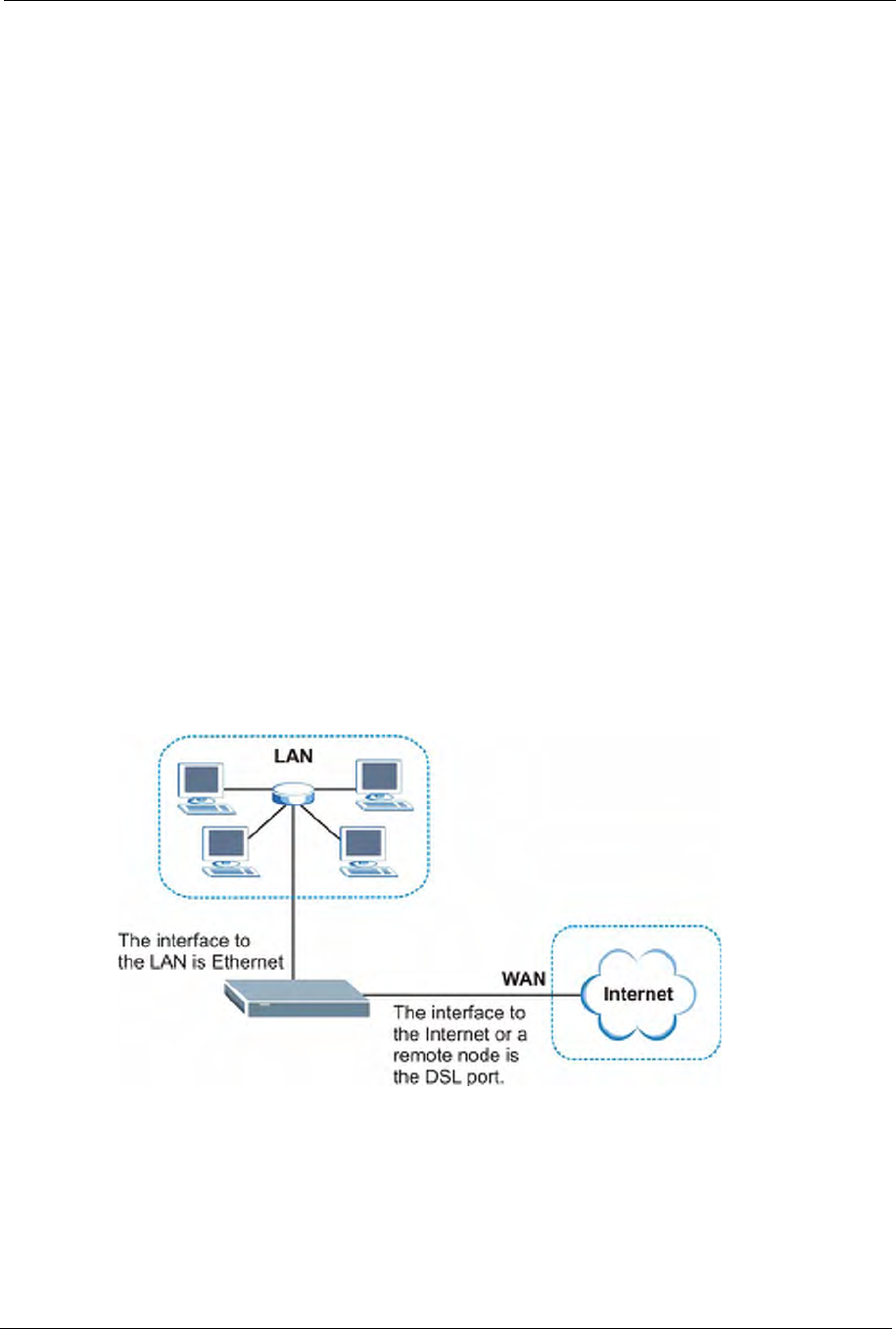
P-660H/HW/W-T Series User’ Guide
Chapter 4 LAN Setup 62
CHAPTER 4
LAN Setup
This chapter describes how to configure LAN settings.
4.1 LAN Overview
A Local Area Network (LAN) is a shared communication system to which many computers
are attached. A LAN is a computer network limited to the immediate area, usually the same
building or floor of a building. The LAN screens can help you configure a LAN DHCP server
and manage IP addresses.
See Section 4.3 on page 68 to configure the LAN screens.
4.1.1 LANs, WANs and the Prestige
The actual physical connection determines whether the Prestige ports are LAN or WAN ports.
There are two separate IP networks, one inside the LAN network and the other outside the
WAN network as shown next.
Figure 15 LAN and WAN IP Addresses

P-660H/HW/W-T Series User’ Guide
63 Chapter 4 LAN Setup
4.1.2 DHCP Setup
DHCP (Dynamic Host Configuration Protocol, RFC 2131 and RFC 2132) allows individual
clients to obtain TCP/IP configuration at start-up from a server. You can configure the Prestige
as a DHCP server or disable it. When configured as a server, the Prestige provides the TCP/IP
configuration for the clients. If you turn DHCP service off, you must have another DHCP
server on your LAN, or else the computer must be manually configured.
4.1.2.1 IP Pool Setup
The Prestige is pre-configured with a pool of IP addresses for the DHCP clients (DHCP Pool).
See the product specifications in the appendices. Do not assign static IP addresses from the
DHCP pool to your LAN computers.
4.1.3 DNS Server Address
DNS (Domain Name System) is for mapping a domain name to its corresponding IP address
and vice versa. The DNS server is extremely important because without it, you must know the
IP address of a machine before you can access it. The DNS server addresses that you enter in
the DHCP setup are passed to the client machines along with the assigned IP address and
subnet mask.
There are two ways that an ISP disseminates the DNS server addresses. The first is for an ISP
to tell a customer the DNS server addresses, usually in the form of an information sheet, when
s/he signs up. If your ISP gives you the DNS server addresses, enter them in the DNS Server
fields in DHCP Setup, otherwise, leave them blank.
Some ISP’s choose to pass the DNS servers using the DNS server extensions of PPP IPCP (IP
Control Protocol) after the connection is up. If your ISP did not give you explicit DNS
servers, chances are the DNS servers are conveyed through IPCP negotiation. The Prestige
supports the IPCP DNS server extensions through the DNS proxy feature.
If the Primary and Secondary DNS Server fields in the LAN Setup screen are not specified,
for instance, left as 0.0.0.0, the Prestige tells the DHCP clients that it itself is the DNS server.
When a computer sends a DNS query to the Prestige, the Prestige forwards the query to the
real DNS server learned through IPCP and relays the response back to the computer.
Please note that DNS proxy works only when the ISP uses the IPCP DNS server extensions. It
does not mean you can leave the DNS servers out of the DHCP setup under all circumstances.
If your ISP gives you explicit DNS servers, make sure that you enter their IP addresses in the
LAN Setup screen. This way, the Prestige can pass the DNS servers to the computers and the
computers can query the DNS server directly without the Prestige’s intervention.
4.1.4 DNS Server Address Assignment
Use DNS (Domain Name System) to map a domain name to its corresponding IP address and
vice versa. The DNS server is extremely important because without it, you must know the IP
address of a computer before you can access it.

P-660H/HW/W-T Series User’ Guide
Chapter 4 LAN Setup 64
There are two ways that an ISP disseminates the DNS server addresses.
• The ISP tells you the DNS server addresses, usually in the form of an information sheet,
when you sign up. If your ISP gives you DNS server addresses, enter them in the DNS
Server fields in the LAN Setup screen.
• The Prestige acts as a DNS proxy when the Primary and Secondary DNS Server fields
are left blank in the LAN Setup screen.
4.2 LAN TCP/IP
The Prestige has built-in DHCP server capability that assigns IP addresses and DNS servers to
systems that support DHCP client capability.
4.2.1 IP Address and Subnet Mask
Similar to the way houses on a street share a common street name, so too do computers on a
LAN share one common network number.
Where you obtain your network number depends on your particular situation. If the ISP or
your network administrator assigns you a block of registered IP addresses, follow their
instructions in selecting the IP addresses and the subnet mask.
If the ISP did not explicitly give you an IP network number, then most likely you have a single
user account and the ISP will assign you a dynamic IP address when the connection is
established. If this is the case, it is recommended that you select a network number from
192.168.0.0 to 192.168.255.0 and you must enable the Network Address Translation (NAT)
feature of the Prestige. The Internet Assigned Number Authority (IANA) reserved this block
of addresses specifically for private use; please do not use any other number unless you are
told otherwise. Let's say you select 192.168.1.0 as the network number; which covers 254
individual addresses, from 192.168.1.1 to 192.168.1.254 (zero and 255 are reserved). In other
words, the first three numbers specify the network number while the last number identifies an
individual computer on that network.
Once you have decided on the network number, pick an IP address that is easy to remember,
for instance, 192.168.1.1, for your Prestige, but make sure that no other device on your
network is using that IP address.
The subnet mask specifies the network number portion of an IP address. Your Prestige will
compute the subnet mask automatically based on the IP address that you entered. You don't
need to change the subnet mask computed by the Prestige unless you are instructed to do
otherwise.

P-660H/HW/W-T Series User’ Guide
65 Chapter 4 LAN Setup
4.2.1.1 Private IP Addresses
Every machine on the Internet must have a unique address. If your networks are isolated from
the Internet, for example, only between your two branch offices, you can assign any IP
addresses to the hosts without problems. However, the Internet Assigned Numbers Authority
(IANA) has reserved the following three blocks of IP addresses specifically for private
networks:
• 10.0.0.0 — 10.255.255.255
• 172.16.0.0 — 172.31.255.255
• 192.168.0.0 — 192.168.255.255
You can obtain your IP address from the IANA, from an ISP or it can be assigned from a
private network. If you belong to a small organization and your Internet access is through an
ISP, the ISP can provide you with the Internet addresses for your local networks. On the other
hand, if you are part of a much larger organization, you should consult your network
administrator for the appropriate IP addresses.
Note: Regardless of your particular situation, do not create an arbitrary IP address;
always follow the guidelines above. For more information on address
assignment, please refer to RFC 1597, Address Allocation for Private Internets
and RFC 1466, Guidelines for Management of IP Address Space.
4.2.2 RIP Setup
RIP (Routing Information Protocol) allows a router to exchange routing information with
other routers. The RIP Direction field controls the sending and receiving of RIP packets.
When set to:
•Both - the Prestige will broadcast its routing table periodically and incorporate the RIP
information that it receives.
•In Only - the Prestige will not send any RIP packets but will accept all RIP packets
received.
•Out Only - the Prestige will send out RIP packets but will not accept any RIP packets
received.
•None - the Prestige will not send any RIP packets and will ignore any RIP packets
received.
The Version field controls the format and the broadcasting method of the RIP packets that the
Prestige sends (it recognizes both formats when receiving). RIP-1 is universally supported;
but RIP-2 carries more information. RIP-1 is probably adequate for most networks, unless
you have an unusual network topology.
Both RIP-2B and RIP-2M sends the routing data in RIP-2 format; the difference being that
RIP-2B uses subnet broadcasting while RIP-2M uses multicasting.

P-660H/HW/W-T Series User’ Guide
Chapter 4 LAN Setup 66
4.2.3 Multicast
Traditionally, IP packets are transmitted in one of either two ways - Unicast (1 sender - 1
recipient) or Broadcast (1 sender - everybody on the network). Multicast delivers IP packets to
a group of hosts on the network - not everybody and not just 1.
IGMP (Internet Group Multicast Protocol) is a network-layer protocol used to establish
membership in a Multicast group - it is not used to carry user data. IGMP version 2 (RFC
2236) is an improvement over version 1 (RFC 1112) but IGMP version 1 is still in wide use. If
you would like to read more detailed information about interoperability between IGMP
version 2 and version 1, please see sections 4 and 5 of RFC 2236. The class D IP address is
used to identify host groups and can be in the range 224.0.0.0 to 239.255.255.255. The address
224.0.0.0 is not assigned to any group and is used by IP multicast computers. The address
224.0.0.1 is used for query messages and is assigned to the permanent group of all IP hosts
(including gateways). All hosts must join the 224.0.0.1 group in order to participate in IGMP.
The address 224.0.0.2 is assigned to the multicast routers group.
The Prestige supports both IGMP version 1 (IGMP-v1) and IGMP version 2 (IGMP-v2). At
start up, the Prestige queries all directly connected networks to gather group membership.
After that, the Prestige periodically updates this information. IP multicasting can be enabled/
disabled on the Prestige LAN and/or WAN interfaces in the web configurator (LAN; WAN ).
Select None to disable IP multicasting on these interfaces.
4.2.4 Any IP
Traditionally, you must set the IP addresses and the subnet masks of a computer and the
Prestige to be in the same subnet to allow the computer to access the Internet (through the
Prestige). In cases where your computer is required to use a static IP address in another
network, you may need to manually configure the network settings of the computer every time
you want to access the Internet via the Prestige.
With the Any IP feature and NAT enabled, the Prestige allows a computer to access the
Internet without changing the network settings (such as IP address and subnet mask) of the
computer, when the IP addresses of the computer and the Prestige are not in the same subnet.
Whether a computer is set to use a dynamic or static (fixed) IP address, you can simply
connect the computer to the Prestige and access the Internet.
The following figure depicts a scenario where a computer is set to use a static private IP
address in the corporate environment. In a residential house where a Prestige is installed, you
can still use the computer to access the Internet without changing the network settings, even
when the IP addresses of the computer and the Prestige are not in the same subnet.
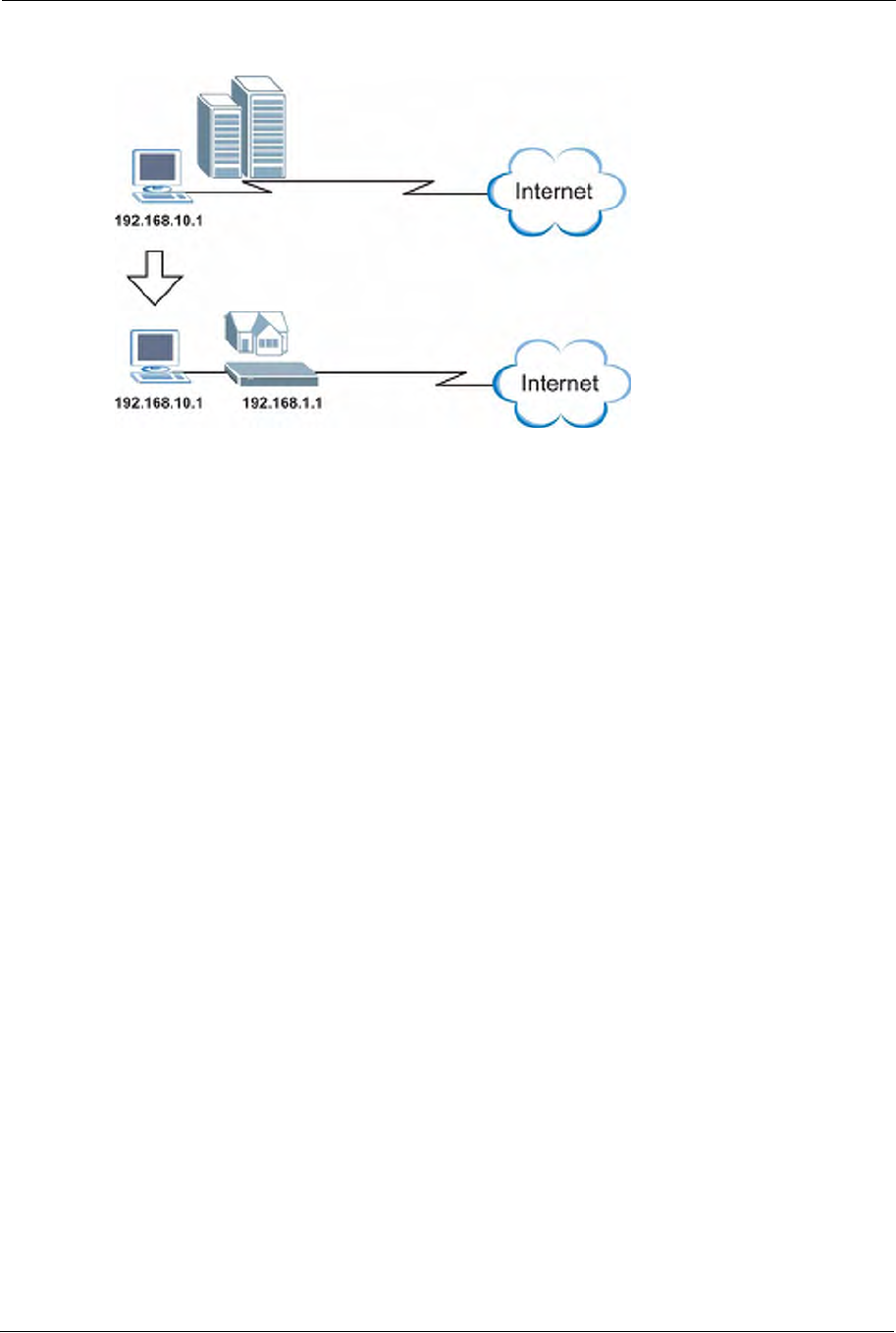
P-660H/HW/W-T Series User’ Guide
67 Chapter 4 LAN Setup
Figure 16 Any IP Example
The Any IP feature does not apply to a computer using either a dynamic IP address or a static
IP address that is in the same subnet as the Prestige’s IP address.
Note: You must enable NAT/SUA to use the Any IP feature on the Prestige.
4.2.4.1 How Any IP Works
Address Resolution Protocol (ARP) is a protocol for mapping an Internet Protocol address (IP
address) to a physical machine address, also known as a Media Access Control or MAC
address, on the local area network. IP routing table is defined on IP Ethernet devices (the
Prestige) to decide which hop to use, to help forward data along to its specified destination.
The following lists out the steps taken, when a computer tries to access the Internet for the first
time through the Prestige.
1When a computer (which is in a different subnet) first attempts to access the Internet, it
sends packets to its default gateway (which is not the Prestige) by looking at the MAC
address in its ARP table.
2When the computer cannot locate the default gateway, an ARP request is broadcast on the
LAN.
3The Prestige receives the ARP request and replies to the computer with its own MAC
address.
4The computer updates the MAC address for the default gateway to the ARP table. Once
the ARP table is updated, the computer is able to access the Internet through the Prestige.
5When the Prestige receives packets from the computer, it creates an entry in the IP
routing table so it can properly forward packets intended for the computer.
After all the routing information is updated, the computer can access the Prestige and the
Internet as if it is in the same subnet as the Prestige.
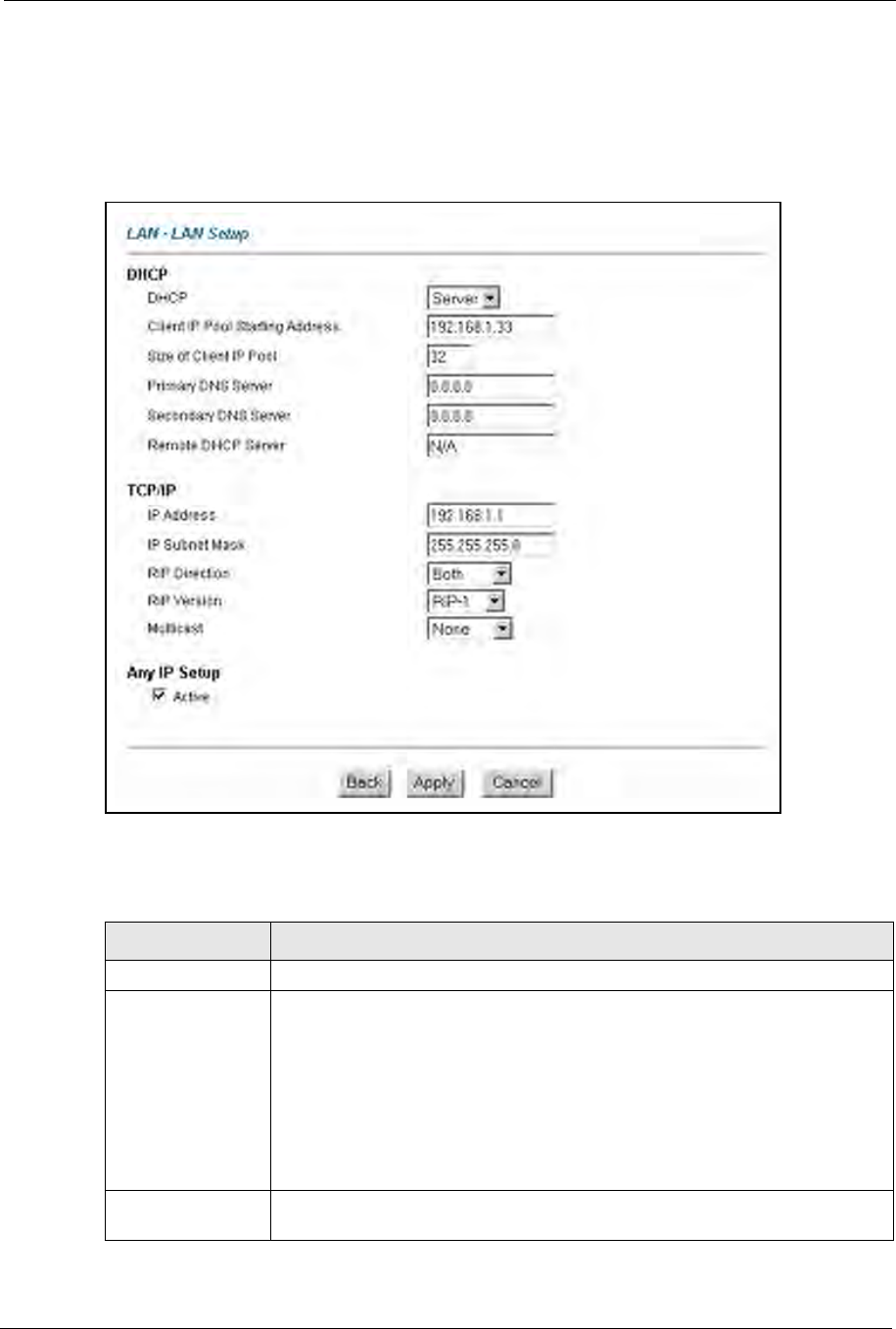
P-660H/HW/W-T Series User’ Guide
Chapter 4 LAN Setup 68
4.3 Configuring LAN
Click LAN to open the LAN Setup screen. See Section 4.1 on page 62 for background
information.
Figure 17 LAN Setup
The following table describes the fields in this screen.
Table 11 LAN Setup
LABEL DESCRIPTION
DHCP
DHCP If set to Server, your Prestige can assign IP addresses, an IP default gateway
and DNS servers to Windows 95, Windows NT and other systems that support
the DHCP client.
If set to None, the DHCP server will be disabled.
If set to Relay, the Prestige acts as a surrogate DHCP server and relays DHCP
requests and responses between the remote server and the clients. Enter the IP
address of the actual, remote DHCP server in the Remote DHCP Server field in
this case.
When DHCP is used, the following items need to be set:
Client IP Pool
Starting Address
This field specifies the first of the contiguous addresses in the IP address pool.

P-660H/HW/W-T Series User’ Guide
69 Chapter 4 LAN Setup
Size of Client IP
Pool
This field specifies the size or count of the IP address pool.
Primary DNS Server Enter the IP addresses of the DNS servers. The DNS servers are passed to the
DHCP clients along with the IP address and the subnet mask.
Secondary DNS
Server
As above.
Remote DHCP
Server
If Relay is selected in the DHCP field above then enter the IP address of the
actual remote DHCP server here.
TCP/IP
IP Address Enter the IP address of your Prestige in dotted decimal notation, for example,
192.168.1.1 (factory default).
IP Subnet Mask Type the subnet mask assigned to you by your ISP (if given).
RIP Direction Select the RIP direction from None,Both,In Only and Out Only.
RIP Version Select the RIP version from RIP-1,RIP-2B and RIP-2M.
Multicast IGMP (Internet Group Multicast Protocol) is a network-layer protocol used to
establish membership in a multicast group. The Prestige supports both IGMP
version 1 (IGMP-v1) and IGMP-v2. Select None to disable it.
Any IP Setup Select the Active check box to enable the Any IP feature. This allows a computer
to access the Internet without changing the network settings (such as IP address
and subnet mask) of the computer, even when the IP addresses of the computer
and the Prestige are not in the same subnet.
When you disable the Any IP feature, only computers with dynamic IP addresses
or static IP addresses in the same subnet as the Prestige’s LAN IP address can
connect to the Prestige or access the Internet through the Prestige.
Apply Click Apply to save your changes back to the Prestige.
Cancel Click Cancel to begin configuring this screen afresh.
Table 11 LAN Setup (continued)
LABEL DESCRIPTION

P-660H/HW/W-T Series User’ Guide
Chapter 5 Wireless LAN 70
CHAPTER 5
Wireless LAN
This chapter discusses how to configure the Wireless LAN screens for P-660HW or P-660W.
5.1 Wireless LAN Introduction
A wireless LAN can be as simple as two computers with wireless LAN adapters
communicating in a peer-to-peer network or as complex as a number of computers with
wireless LAN adapters communicating through access points which bridge network traffic to
the wired LAN.
Refer to Section 5.3 on page 71 to configure wireless LAN settings.
Note: See the WLAN appendix for more detailed information on WLANs.
5.2 Wireless Security Overview
Wireless security is vital to your network to protect wireless communication between wireless
stations, access points and the wired network.
Wireless security methods available on the Prestige are data encryption, wireless client
authentication, restricting access by device MAC address and hiding the Prestige identity.
5.2.1 Encryption
• Use WPA security if you have WPA-aware wireless clients and a RADIUS server. WPA
has user authentication and improved data encryption over WEP.
• Use WPA-PSK if you have WPA-aware wireless clients but no RADIUS server.
• If you don’t have WPA-aware wireless clients, then use WEP key encrypting. A higher
bit key offers better security at a throughput trade-off. You can use Passphrase to
automatically generate 64-bit or 128-bit WEP keys or manually enter 64-bit, 128-bit or
256-bit WEP keys.
5.2.2 Authentication
WPA has user authentication and you can also configure IEEE 802.1x to use the built-in
database (Local User Database) or a RADIUS server to authenticate wireless clients before
joining your network.

P-660H/HW/W-T Series User’ Guide
71 Chapter 5 Wireless LAN
• Use RADIUS authentication if you have a RADIUS server. See the appendices for
information on protocols used when a client authenticates with a RADIUS server via the
Prestige.
• Use the Local User Database if you have less than 32 wireless clients in your network.
The Prestige uses MD5 encryption when a client authenticates with the Local User
Database
5.2.3 Restricted Access
The MAC Filter screen allows you to configure the AP to give exclusive access to devices
(Allow Association) or exclude them from accessing the AP (Deny Association).
5.2.4 Hide Prestige Identity
If you hide the ESSID, then the Prestige cannot be seen when a wireless client scans for local
APs. The trade-off for the extra security of “hiding” the Prestige may be inconvenience for
some valid WLAN clients. If you don’t hide the ESSID, at least you should change the default
one.
5.3 The Main Wireless LAN Screen
Click Wireless LAN in the navigation panel to display the main Wireless LAN screen.
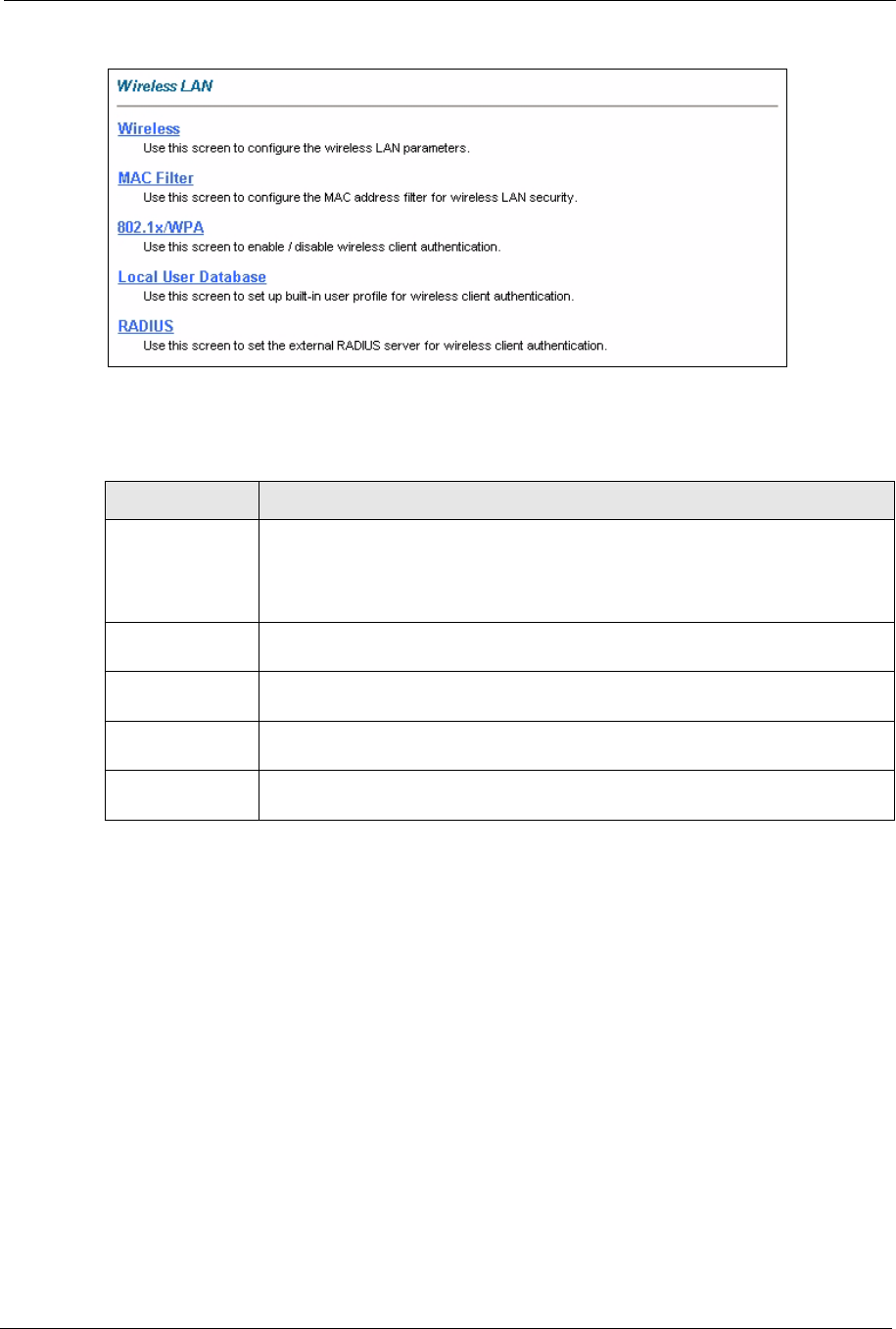
P-660H/HW/W-T Series User’ Guide
Chapter 5 Wireless LAN 72
Figure 18 Wireless LAN
The following table describes the links in this screen.
The following figure shows the relative effectiveness of these wireless security methods
available on your Prestige.
Table 12 Wireless LAN
LINK DESCRIPTION
Wireless Click this link to go to a screen where you can configure the ESSID and WEP.
Note: If you configure WEP, you can’t configure WPA or WPA-
PSK.
MAC Filter Click this link to go to a screen where you can restrict access to your wireless
network by MAC address.
802.1x/WPA Click this link to go to a screen where you can configure WPA or WPA-PSK. You
can also configure 802.1x wireless client authentication in this screen.
RADIUS Click this link to go to a screen where you can configure the RADIUS
authentication database settings.
Local User
Database
Click this link to go to a screen where you can configure the built-in authentication
database for user authentication.

P-660H/HW/W-T Series User’ Guide
73 Chapter 5 Wireless LAN
Figure 19 Wireless Security Methods
Note: You must enable the same wireless security settings on the Prestige and on all
wireless clients that you want to associate with it.
If you do not enable any wireless security on your Prestige, your network is
accessible to any wireless networking device that is within range.
5.4 Configuring the Wireless Screen
5.4.1 WEP Encryption
WEP encryption scrambles the data transmitted between the wireless stations and the access
points to keep network communications private. It encrypts unicast and multicast
communications in a network. Both the wireless stations and the access points must use the
same WEP key.
Your Prestige allows you to configure up to four 64-bit, 128-bit or 256-bit WEP keys but only
one key can be enabled at any one time.
In order to configure and enable WEP encryption; click Wireless LAN and Wireless to the
display the Wireless screen.
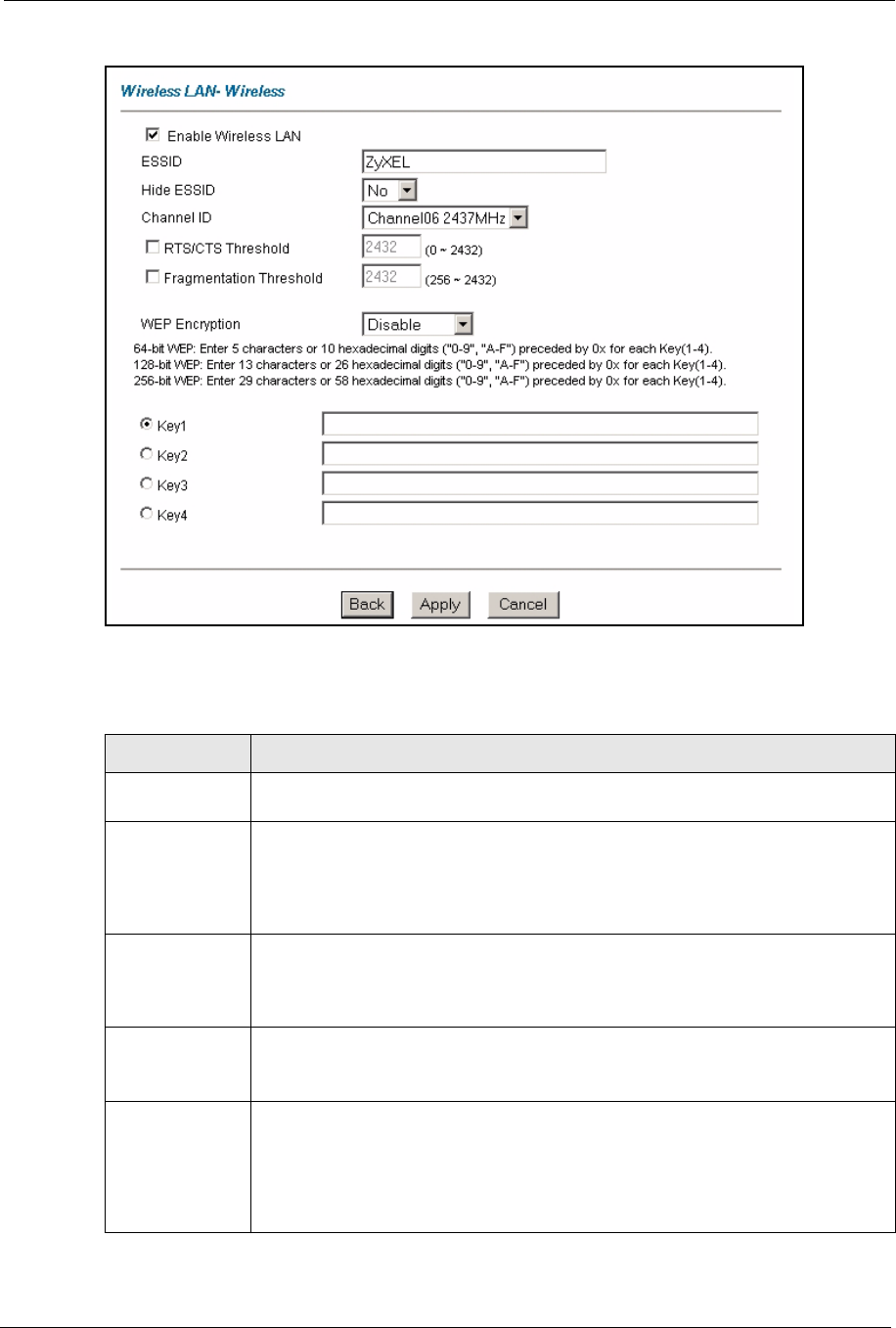
P-660H/HW/W-T Series User’ Guide
Chapter 5 Wireless LAN 74
Figure 20 Wireless Screen
The following table describes the labels in this screen.
Table 13 Wireless LAN
LABEL DESCRIPTION
Enable Wireless
LAN
You should configure some wireless security (see Figure 19 on page 73) when you
enable the wireless LAN. Select the check box to enable the wireless LAN.
ESSID The ESSID (Extended Service Set IDentification) is a unique name to identify the
Prestige in the wireless LAN. Wireless stations associating to the Prestige must
have the same ESSID.
Enter a descriptive name of up to 32 printable characters (including spaces;
alphabetic characters are case-sensitive).
Hide ESSID Select Yes to hide the ESSID in so a station cannot obtain the ESSID through AP
scanning.
Select No to make the ESSID visible so a station can obtain the ESSID through AP
scanning.
Channel ID The radio frequency used by IEEE 802.11a, b or g wireless devices is called a
channel.
Select a channel from the drop-down list box.
RTS/CTS
Threshold
The RTS (Request To Send) threshold (number of bytes) is for enabling RTS/CTS.
Data with its frame size larger than this value will perform the RTS/CTS handshake.
Setting this value to be larger than the maximum MSDU (MAC service data unit)
size turns off RTS/CTS. Setting this value to zero turns on RTS/CTS.
Select the check box to change the default value and enter a new value between 0
and 2432.

P-660H/HW/W-T Series User’ Guide
75 Chapter 5 Wireless LAN
Note: If you are configuring the Prestige from a computer connected to the wireless
LAN and you change the Prestige’s ESSID or security settings (see Figure 19
on page 73), you will lose your wireless connection when you press Apply to
confirm. You must then change the wireless settings of your computer to match
the Prestige’s new settings.
5.5 Configuring MAC Filters
Every Ethernet device has a unique MAC (Media Access Control) address. The MAC address
is assigned at the factory and consists of six pairs of hexadecimal characters, for example,
00:A0:C5:00:00:02. You need to know the MAC addresses of the devices to configure this
screen. To change your Prestige’s MAC filter settings, click Wireless LAN,MAC Filter to
open the MAC Filter screen. The screen appears as shown.
Fragmentation
Threshold
This is the threshold (number of bytes) for the fragmentation boundary for directed
messages. It is the maximum data fragment size that can be sent.
Select the check box to change the default value and enter a value between 256
and 2432.
You won’t see the following WEP-related fields if you have WPA or WPA-PSK enabled.
Passphrase Enter a "passphrase" (password phrase) of up to 63 case-sensitive printable
characters and click Generate to have the Prestige create four different WEP keys.
At the time of writing, you cannot use passphrase to generate 256-bit WEP keys.
Generate After you enter the passphrase, click Generate to have the Prestige generate four
different WEP keys automatically. The keys display in the fields below.
WEP Encryption WEP (Wired Equivalent Privacy) encrypts data frames before transmitting over the
wireless network.
Select Disable to allow all wireless stations to communicate with the access points
without any data encryption.
Select 64-bit WEP,128-bit WEP or 256-bit WEP to use data encryption.
Key 1 to Key 4 The WEP keys are used to encrypt data. Both the Prestige and the wireless stations
must use the same WEP key for data transmission.
If you want to manually set the WEP keys, enter the key in the field provided.
If you chose 64-bit WEP, then enter any 5 ASCII characters or 10 hexadecimal
characters ("0-9", "A-F").
If you chose 128-bit WEP, then enter 13 ASCII characters or 26 hexadecimal
characters ("0-9", "A-F").
If you chose 256-bit WEP, then enter 29 ASCII characters or 58 hexadecimal
characters ("0-9", "A-F").
The values for the WEP keys must be set up exactly the same on all wireless
devices in the same wireless LAN.
You must configure all four keys, but only one key can be used at any one time. The
default key is key 1.
Back Click Back to go to the main wireless LAN setup screen.
Apply Click Apply to save your changes back to the Prestige.
Cancel Click Cancel to begin configuring this screen afresh.
Table 13 Wireless LAN (continued)
LABEL DESCRIPTION
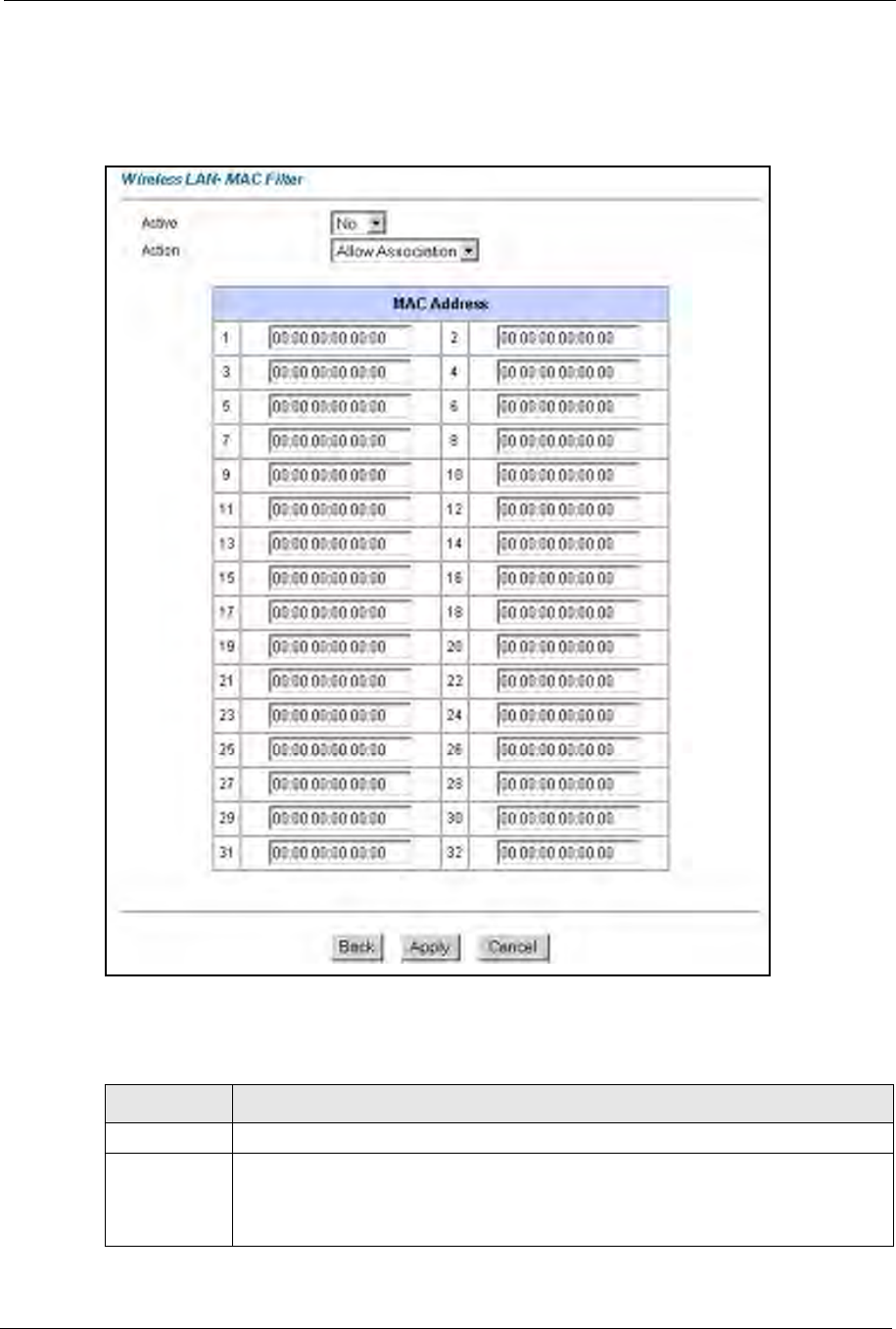
P-660H/HW/W-T Series User’ Guide
Chapter 5 Wireless LAN 76
Note: Be careful not to list your computer’s MAC address and set the Action field to
Deny Association when managing the Prestige via a wireless connection.
This would lock you out.
Figure 21 MAC Filter
The following table describes the fields in this menu.
Table 14 MAC Filter
LABEL DESCRIPTION
Active Select Yes from the drop down list box to enable MAC address filtering.
Action Define the filter action for the list of MAC addresses in the MAC Address table.
Select Deny Association to block access to the router, MAC addresses not listed will
be allowed to access the Prestige. Select Allow Association to permit access to the
router, MAC addresses not listed will be denied access to the Prestige.

P-660H/HW/W-T Series User’ Guide
77 Chapter 5 Wireless LAN
5.6 Introduction to WPA
Wi-Fi Protected Access (WPA) is a subset of the IEEE 802.11i standard. WPA is preferred to
WEP as WPA has user authentication and improved data encryption. See the appendix for
more information on WPA user authentication and WPA encryption.
If you don’t have an external RADIUS server, you should use WPA-PSK (WPA -Pre-Shared
Key). WPA-PSK only requires a single (identical) password entered into each WLAN
member. As long as the passwords match, a client will be granted access to a WLAN.
Note: You can’t use the Local User Database for authentication when you select
WPA.
5.6.1 WPA-PSK Application Example
A WPA-PSK application looks as follows.
1First enter identical passwords into the AP and all wireless clients. The Pre-Shared Key
(PSK) must be between 8 and 63 printable characters (including spaces; alphabetic
characters are case-sensitive).
2The AP checks each client’s password and (only) allows it to join the network if the
passwords match.
3The AP derives and distributes keys to the wireless clients.
4The AP and wireless clients use the TKIP encryption process to encrypt data exchanged
between them.
MAC Address Enter the MAC addresses in a valid MAC address format, that is, six hexadecimal
character pairs, for example, 12:34:56:78:9a:bc of the wireless stations that are
allowed or denied access to the Prestige in these address fields.
Back Click Back to go to the main wireless LAN setup screen.
Apply Click Apply to save your changes back to the Prestige.
Cancel Click Cancel to begin configuring this screen afresh.
Table 14 MAC Filter (continued)
LABEL DESCRIPTION
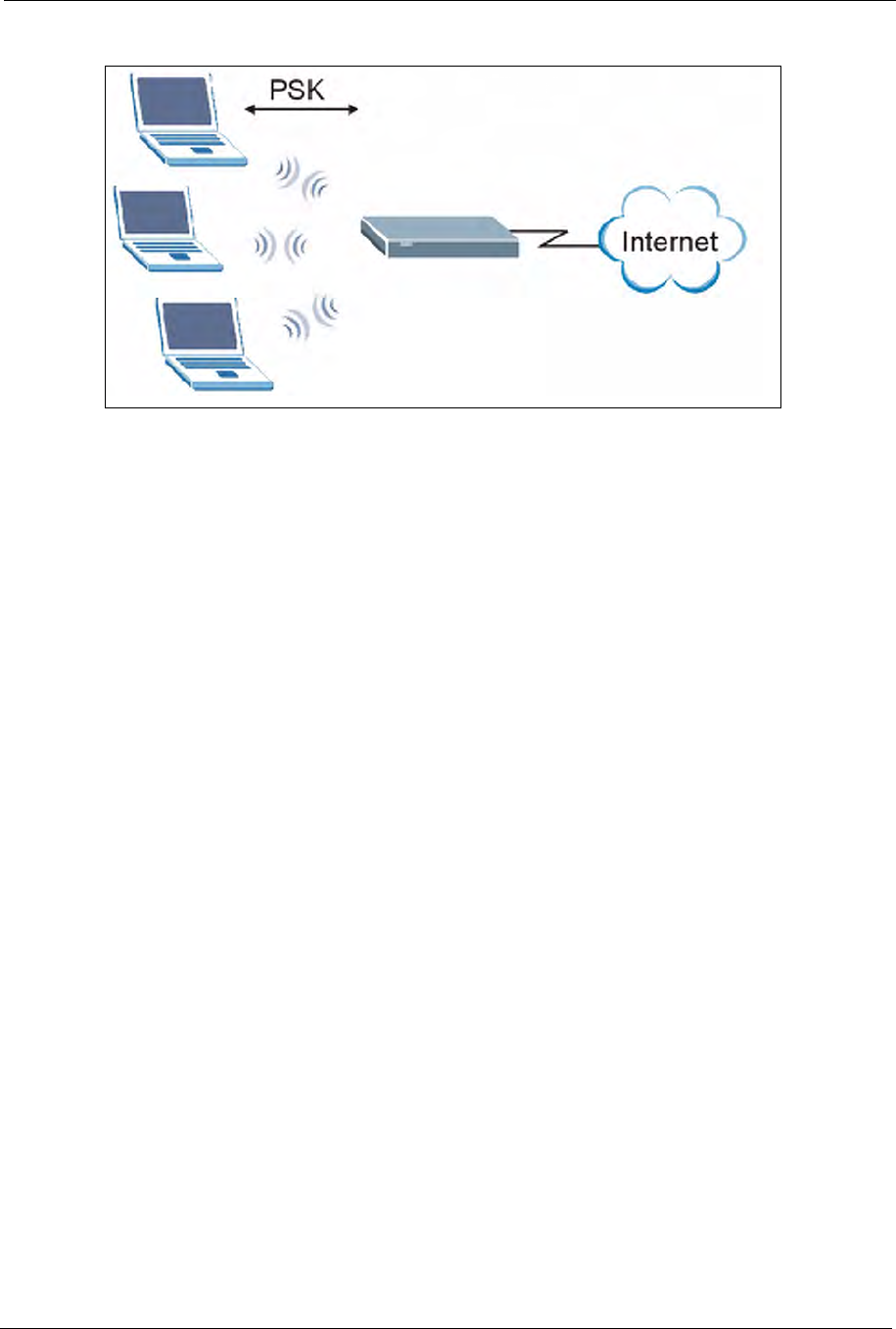
P-660H/HW/W-T Series User’ Guide
Chapter 5 Wireless LAN 78
Figure 22 WPA - PSK Authentication
5.6.2 WPA with RADIUS Application Example
You need the IP address, port number (default is 1812) and shared secret of a RADIUS server.
A WPA application example with an external RADIUS server looks as follows. "A" is the
RADIUS server. "DS" is the distribution system (wired link to the LAN).
1The AP passes the wireless client’s authentication request to the RADIUS server.
2The RADIUS server then checks the user's identification against its database and grants
or denies network access accordingly.
3The RADIUS server distributes a Pairwise Master Key (PMK) key to the AP that then
sets up a key hierarchy and management system, using the pair-wise key to dynamically
generate unique data encryption keys to encrypt every data packet that is wirelessly
transmitted between the AP and the wireless clients
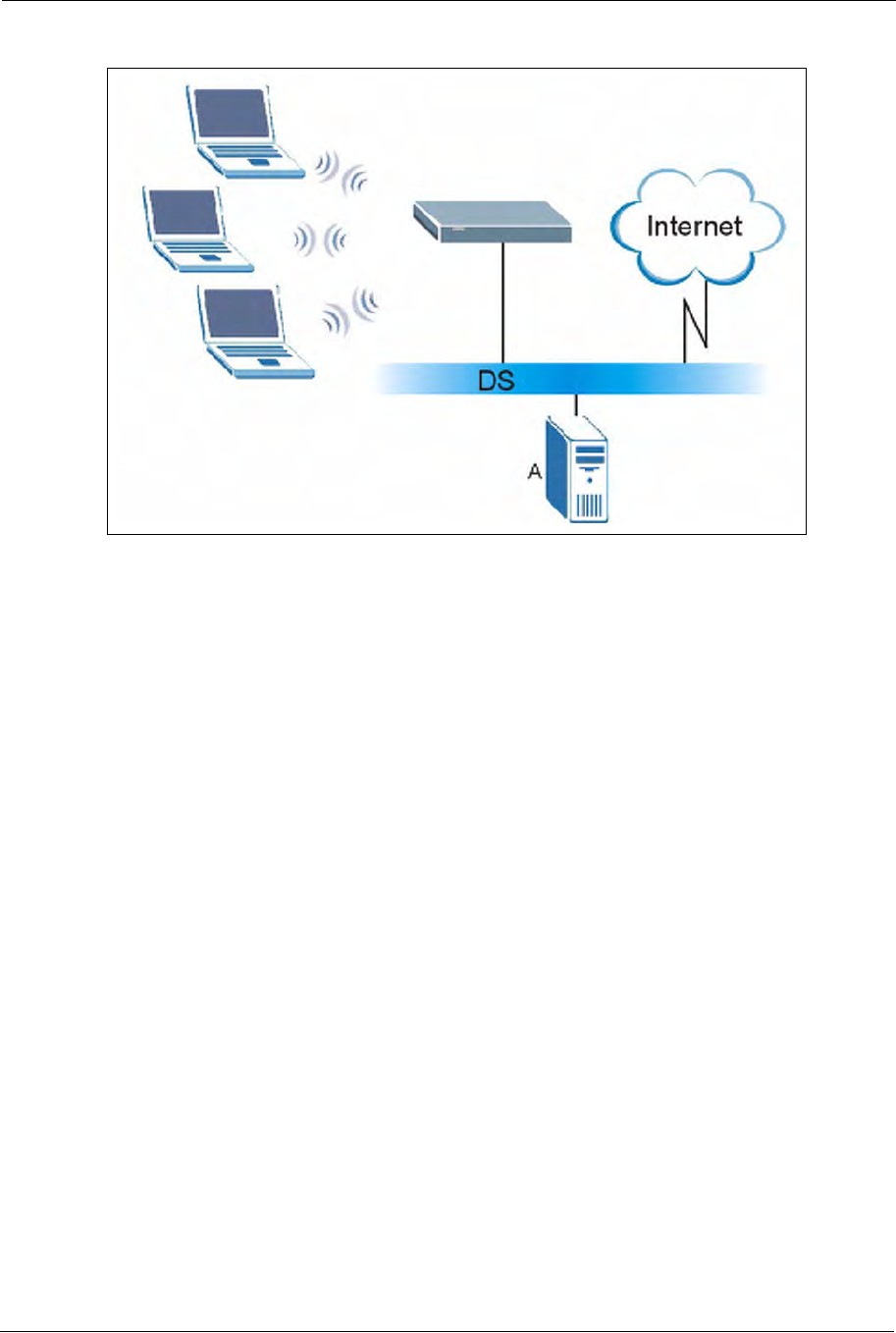
P-660H/HW/W-T Series User’ Guide
79 Chapter 5 Wireless LAN
Figure 23 WPA with RADIUS Application Example2
5.6.3 Wireless Client WPA Supplicants
A wireless client supplicant is the software that runs on an operating system instructing the
wireless client how to use WPA. At the time of writing, the most widely available supplicants
are the WPA patch for Windows XP, Funk Software's Odyssey client, and Meetinghouse Data
Communications' AEGIS client.
The Windows XP patch is a free download that adds WPA capability to Windows XP's built-
in "Zero Configuration" wireless client. However, you must run Windows XP to use it.
See Section 5.7.3 on page 82 and Section 5.7.4 on page 84 for configuration instruction.
5.7 Configuring IEEE 802.1x and WPA
To change your Prestige’s authentication settings, click the Wireless LAN link under
Advanced Setup and then the 802.1x/WPA tab. The screen varies by the key management
protocol you select.
• See Section 5.7.1 on page 80 if you want to allow unauthenticated wireless access or
block wireless access on the Prestige.
• See Section 5.7.2 on page 80 to configure IEEE 802.1x authentication.
• See Section 5.7.3 on page 82 to configure WPA.
• See Section 5.7.4 on page 84 to configure WPA-PSK.
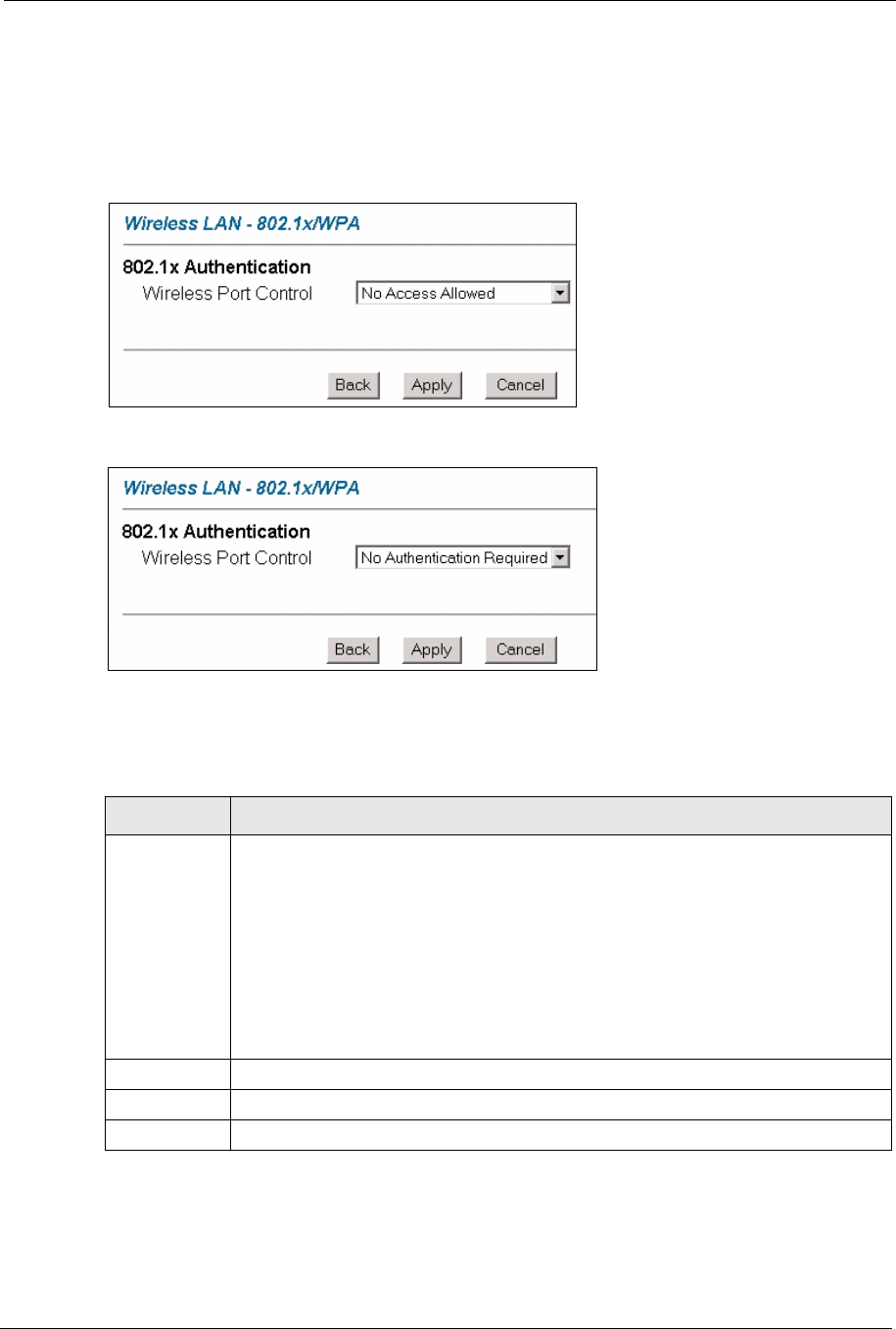
P-660H/HW/W-T Series User’ Guide
Chapter 5 Wireless LAN 80
5.7.1 No Access Allowed or Authentication
Select No Access Allowed or No Authentication Required in the Wireless Port
Control field.
Figure 24 Wireless LAN: 802.1x/WPA: No Access Allowed
Figure 25 Wireless LAN: 802.1x/WPA: No Authentication
The following table describes the label in these screens.
5.7.2 Authentication Required: 802.1x
You need the following for IEEE 802.1x authentication.
Table 15 Wireless LAN: 802.1x/WPA: No Access/Authentication
LABEL DESCRIPTION
Wireless Port
Control
To control wireless station access to the wired network, select a control method from
the drop-down list box. Choose from No Access Allowed, No Authentication
Required and Authentication Required.
No Access Allowed blocks all wireless stations access to the wired network.
No Authentication Required allows all wireless stations access to the wired network
without entering usernames and passwords. This is the default setting.
Authentication Required means that all wireless stations have to enter usernames
and passwords before access to the wired network is allowed.
Select Authentication Required to configure Key Management Protocol and other
related fields.
Back Click Back to go to the main wireless LAN setup screen.
Apply Click Apply to save your changes back to the Prestige.
Cancel Click Cancel to begin configuring this screen afresh.
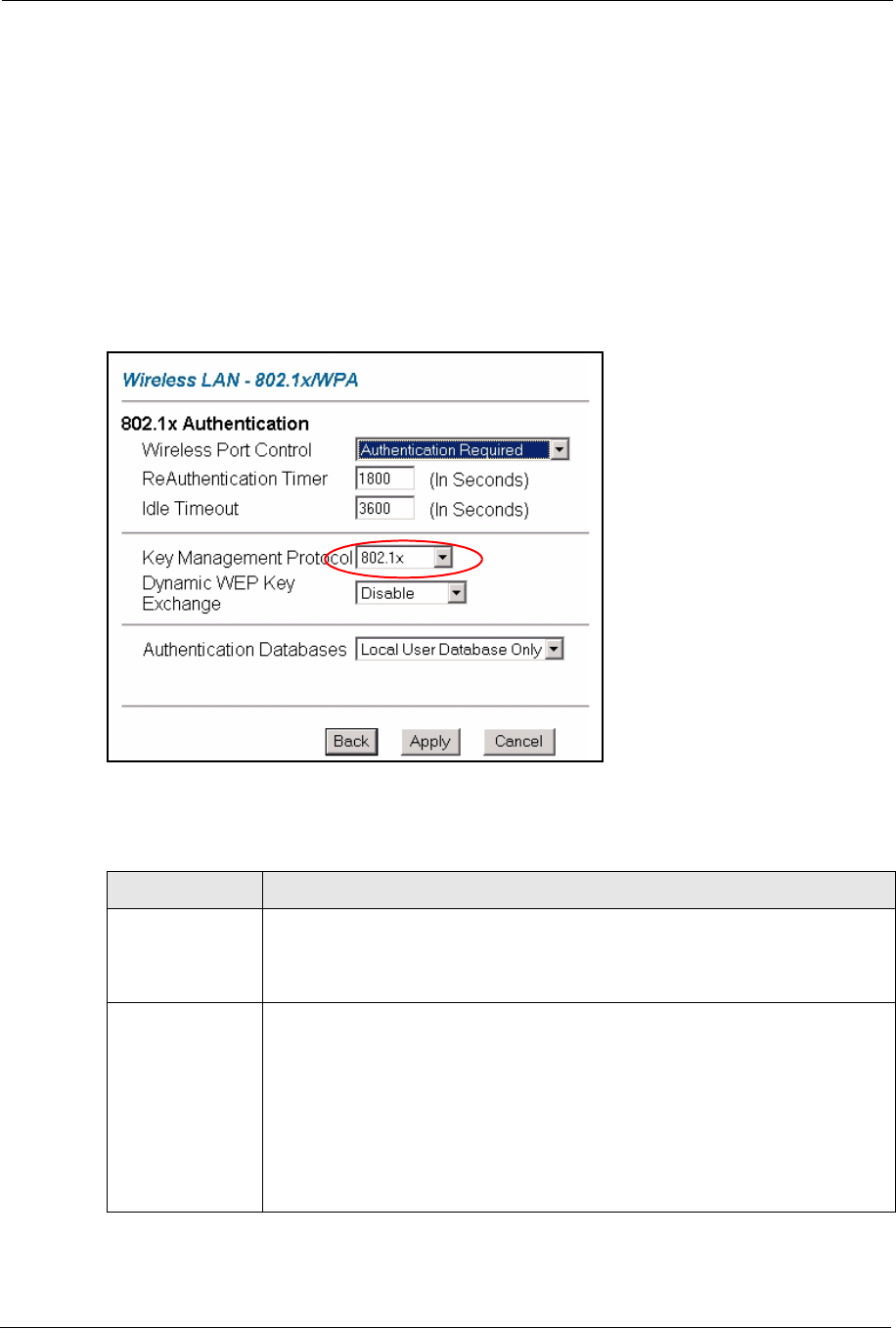
P-660H/HW/W-T Series User’ Guide
81 Chapter 5 Wireless LAN
• A computer with an IEEE 802.11 a/b/g wireless LAN adapter and equipped with a web
browser (with JavaScript enabled) and/or Telnet.
• A wireless station computer must be running IEEE 802.1x-compliant software. Not all
Windows operating systems support IEEE 802.1x (see the Microsoft web site for details).
For other operating systems, see their documentation. If your operating system does not
support IEEE 802.1x, then you may need to install IEEE 802.1x client software.
• An optional network RADIUS server for remote user authentication and accounting.
Select Authentication Required in the Wireless Port Control field and 802.1x in the Key
Management Protocol field to display the next screen.
Figure 26 Wireless LAN: 802.1x/WPA: 802.1xl
The following table describes the labels in this screen.
Table 16 Wireless LAN: 802.1x/WPA: 802.1x
LABEL DESCRIPTION
Wireless Port
Control
To control wireless station access to the wired network, select a control method
from the drop-down list box. Choose from No Authentication Required,
Authentication Required and No Access Allowed.
The following fields are only available when you select Authentication Required.
ReAuthentication
Timer
(in Seconds)
Specify how often wireless stations have to reenter usernames and passwords in
order to stay connected. This field is activated only when you select
Authentication Required in the Wireless Port Control field.
Enter a time interval between 10 and 9999 seconds. The default time interval is
1800 seconds (30 minutes).
Note: If wireless station authentication is done using a RADIUS
server, the reauthentication timer on the RADIUS server has
priority.

P-660H/HW/W-T Series User’ Guide
Chapter 5 Wireless LAN 82
Note: Once you enable user authentication, you need to specify an external RADIUS
server or create local user accounts on the Prestige for authentication.
5.7.3 Authentication Required: WPA
Select Authentication Required in the Wireless Port Control field and WPA in the Key
Management Protocol field to display the next screen.
Idle Timeout
(in Seconds)
The Prestige automatically disconnects a wireless station from the wired network
after a period of inactivity. The wireless station needs to enter the username and
password again before access to the wired network is allowed.
This field is activated only when you select Authentication Required in the
Wireless Port Control field. The default time interval is 3600 seconds (or 1 hour).
Key Management
Protocol
Choose 802.1x from the drop-down list.
Dynamic WEP Key
Exchange
This field is activated only when you select Authentication Required in the
Wireless Port Control field. Also set the Authentication Databases field to
RADIUS Only. Local user database may not be used.
Select Disable to allow wireless stations to communicate with the access points
without using dynamic WEP key exchange.
Select 64-bit WEP,128-bit WEP or 256-bit WEP to enable data encryption.
Up to 32 stations can access the Prestige when you configure dynamic WEP key
exchange.
This field is not available when you set Key Management Protocol to WPA or
WPA-PSK.
Authentication
Databases
The authentication database contains wireless station login information. The local
user database is the built-in database on the Prestige. The RADIUS is an external
server. Use this drop-down list box to select which database the Prestige should
use (first) to authenticate a wireless station.
Before you specify the priority, make sure you have set up the corresponding
database correctly first.
Select Local User Database Only to have the Prestige just check the built-in user
database on the Prestige for a wireless station's username and password.
Select RADIUS Only to have the Prestige just check the user database on the
specified RADIUS server for a wireless station's username and password.
Select Local first, then RADIUS to have the Prestige first check the user
database on the Prestige for a wireless station's username and password. If the
user name is not found, the Prestige then checks the user database on the
specified RADIUS server.
Select RADIUS first, then Local to have the Prestige first check the user
database on the specified RADIUS server for a wireless station's username and
password. If the Prestige cannot reach the RADIUS server, the Prestige then
checks the local user database on the Prestige. When the user name is not found
or password does not match in the RADIUS server, the Prestige will not check the
local user database and the authentication fails.
Back Click Back to go to the main wireless LAN setup screen.
Apply Click Apply to save your changes back to the Prestige.
Cancel Click Cancel to begin configuring this screen afresh.
Table 16 Wireless LAN: 802.1x/WPA: 802.1x (continued)
LABEL DESCRIPTION
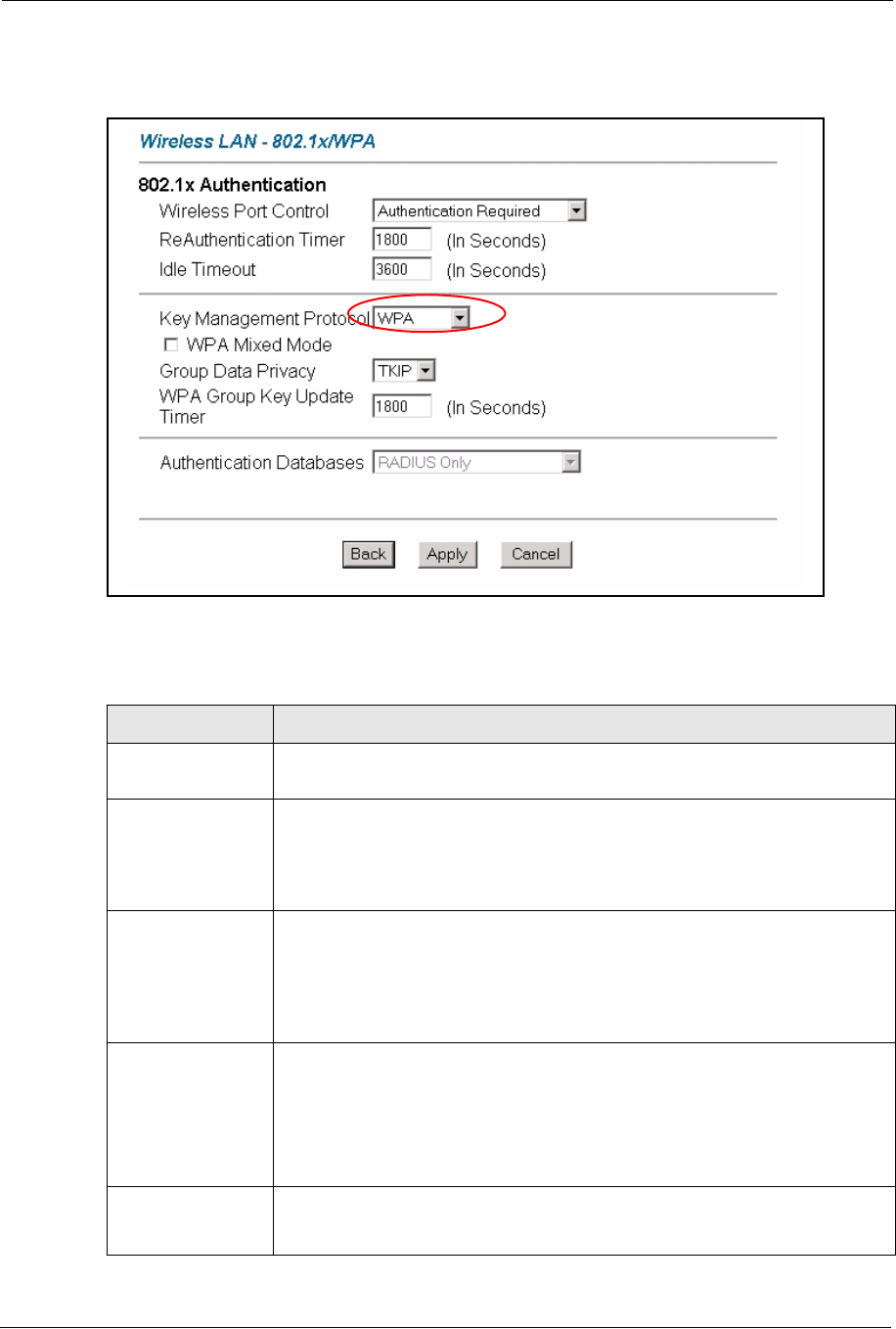
P-660H/HW/W-T Series User’ Guide
83 Chapter 5 Wireless LAN
See Section 5.6 on page 77 for more information.
Figure 27 Wireless LAN: 802.1x/WPA: WPA
The following table describes the labels not previously discussed.
Table 17 Wireless LAN: 802.1x/WPA: WPA
LABEL DESCRIPTION
Key Management
Protocol
Choose WPA in this field.
WPA Mixed Mode The Prestige can operate in WPA Mixed Mode, which supports both clients
running WPA and clients running dynamic WEP key exchange with 802.1x in the
same Wi-Fi network.
Select the check box to activate WPA mixed mode. Otherwise, clear the check
box and configure the Group Data Privacy field.
Group Data Privacy Group Data Privacy allows you to choose TKIP (recommended) or WEP for
broadcast and multicast ("group") traffic if the Key Management Protocol is
WPA and WPA Mixed Mode is disabled. WEP is used automatically if you have
enabled WPA Mixed Mode.
All unicast traffic is automatically encrypted by TKIP when WPA or WPA-PSK
Key Management Protocol is selected.
WPA Group Key
Update Timer
The WPA Group Key Update Timer is the rate at which the AP (if using WPA-
PSK key management) or RADIUS server (if using WPA key management)
sends a new group key out to all clients. The re-keying process is the WPA
equivalent of automatically changing the WEP key for an AP and all stations in a
WLAN on a periodic basis. Setting of the WPA Group Key Update Timer is also
supported in WPA-PSK mode. The Prestige default is 1800 seconds (30
minutes).
Authentication
Databases
When you configure Key Management Protocol to WPA, the Authentication
Databases must be RADIUS Only. You can only use the Local User Database
Only with 802.1x Key Management Protocol.
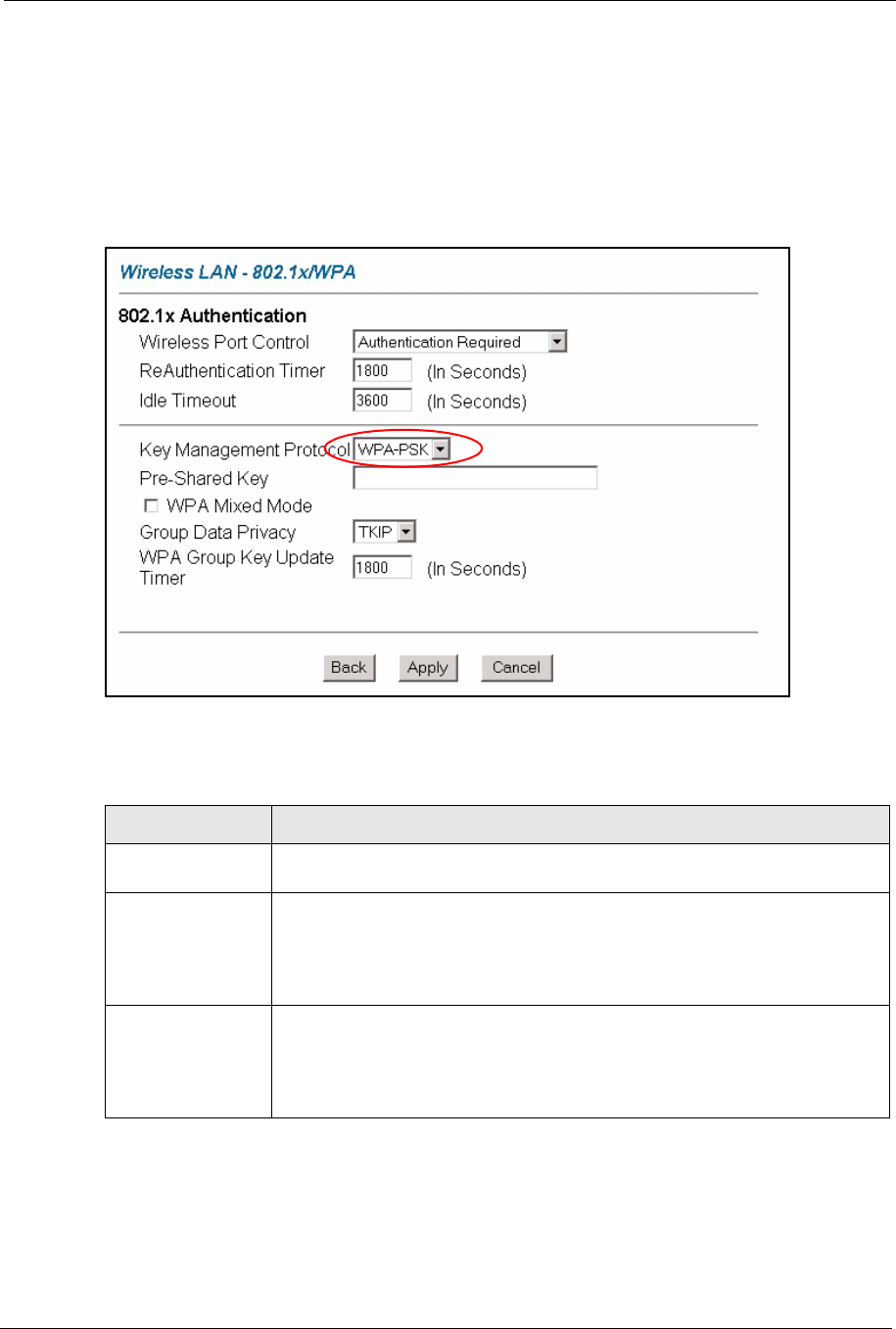
P-660H/HW/W-T Series User’ Guide
Chapter 5 Wireless LAN 84
5.7.4 Authentication Required: WPA-PSK
Select Authentication Required in the Wireless Port Control field and WPA-PSK in the
Key Management Protocol field to display the next screen.
See Section 5.6 on page 77 for more information.
Figure 28 Wireless LAN: 802.1x/WPA:WPA-PSK
The following table describes the labels not previously discussed.
Table 18 Wireless LAN: 802.1x/WPA: WPA-PSK
LABEL DESCRIPTION
Key Management
Protocol
Choose WPA-PSK in this field.
Pre-Shared Key The encryption mechanisms used for WPA and WPA-PSK are the same. The
only difference between the two is that WPA-PSK uses a simple common
password, instead of user-specific credentials.
Type a pre-shared key from 8 to 63 printable characters (including spaces;
alphabetic characters are case-sensitive).
WPA Mixed Mode The Prestige can operate in WPA Mixed Mode, which supports both clients
running WPA and clients running dynamic WEP key exchange with 802.1x in the
same Wi-Fi network.
Select the check box to activate WPA mixed mode. Otherwise, clear the check
box and configure the Group Data Privacy field.

P-660H/HW/W-T Series User’ Guide
85 Chapter 5 Wireless LAN
5.8 Configuring Local User Authentication
By storing user profiles locally, your Prestige is able to authenticate wireless users without
interacting with a network RADIUS server. However, there is a limit on the number of users
you may authenticate in this way.
To change your Prestige’s local user database, click Wireless LAN,Local User Database.
The screen appears as shown.
Group Data Privacy Group Data Privacy allows you to choose TKIP (recommended) or WEP for
broadcast and multicast ("group") traffic if the Key Management Protocol is
WPA and WPA Mixed Mode is disabled. WEP is used automatically if you have
enabled WPA Mixed Mode.
All unicast traffic is automatically encrypted by TKIP when WPA or WPA-PSK
Key Management Protocol is selected.
Authentication
Databases
This field is only visible when WPA Mixed Mode is enabled.
Table 18 Wireless LAN: 802.1x/WPA: WPA-PSK (continued)
LABEL DESCRIPTION
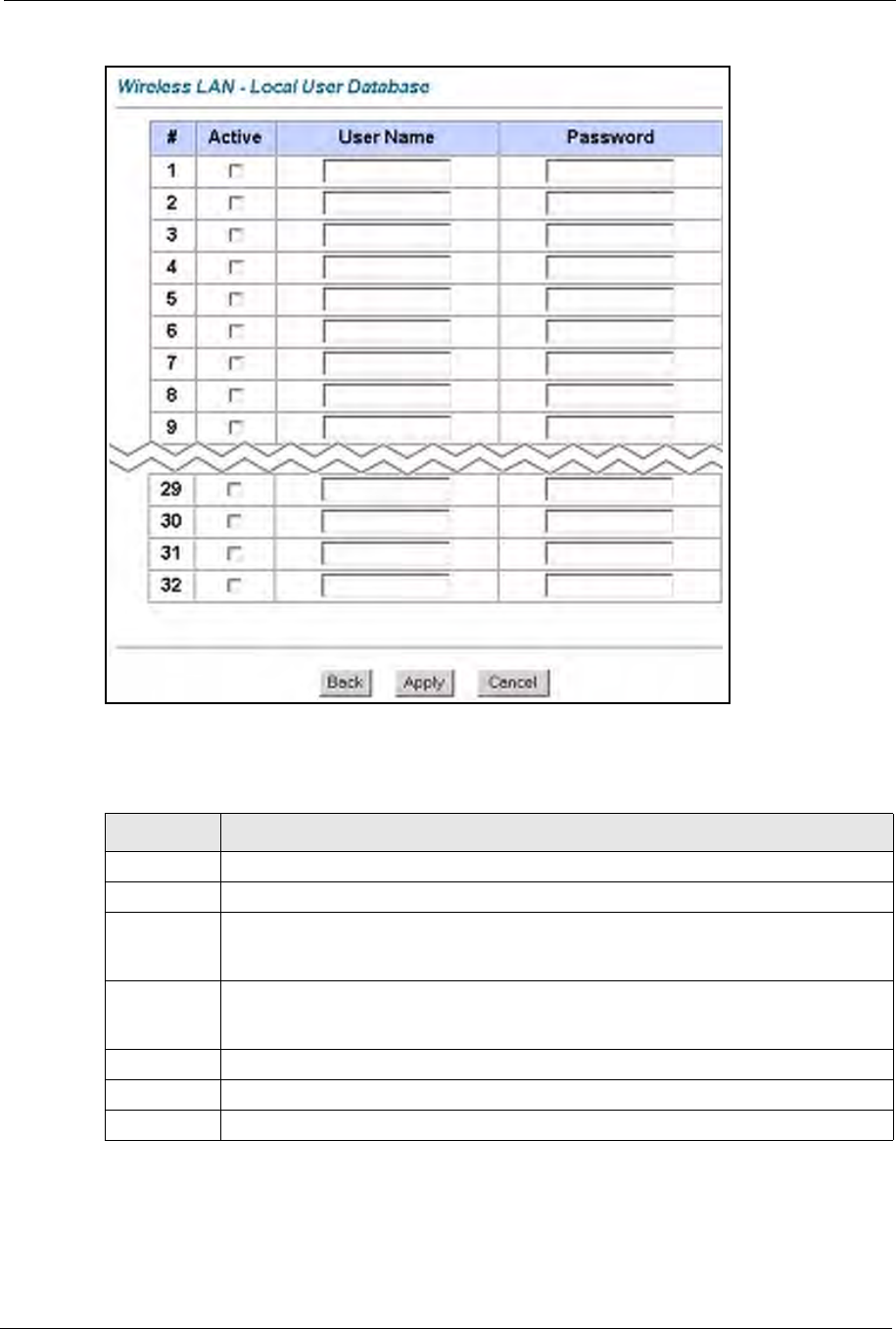
P-660H/HW/W-T Series User’ Guide
Chapter 5 Wireless LAN 86
Figure 29 Local User Database
The following table describes the fields in this screen.
Table 19 Local User Database
LABEL DESCRIPTION
# This is the index number of a local user account.
Active Select this check box to enable the user profile.
User Name Enter a user name of up to 31 alphanumeric characters (case-sensitive), hyphens ('-')
and underscores ('_') if you’re using MD5 encryption and maximum 14 if you’re using
PEAP.
Password Enter a password of up to 31 printable characters (including spaces; alphabetic
characters are case-sensitive) if you’re using MD5 encryption and maximum 14 if you’re
using PEAP.
Back Click Back to go to the main wireless LAN setup screen.
Apply Click Apply to save these settings back to the Prestige.
Cancel Click Cancel to begin configuring this screen again.
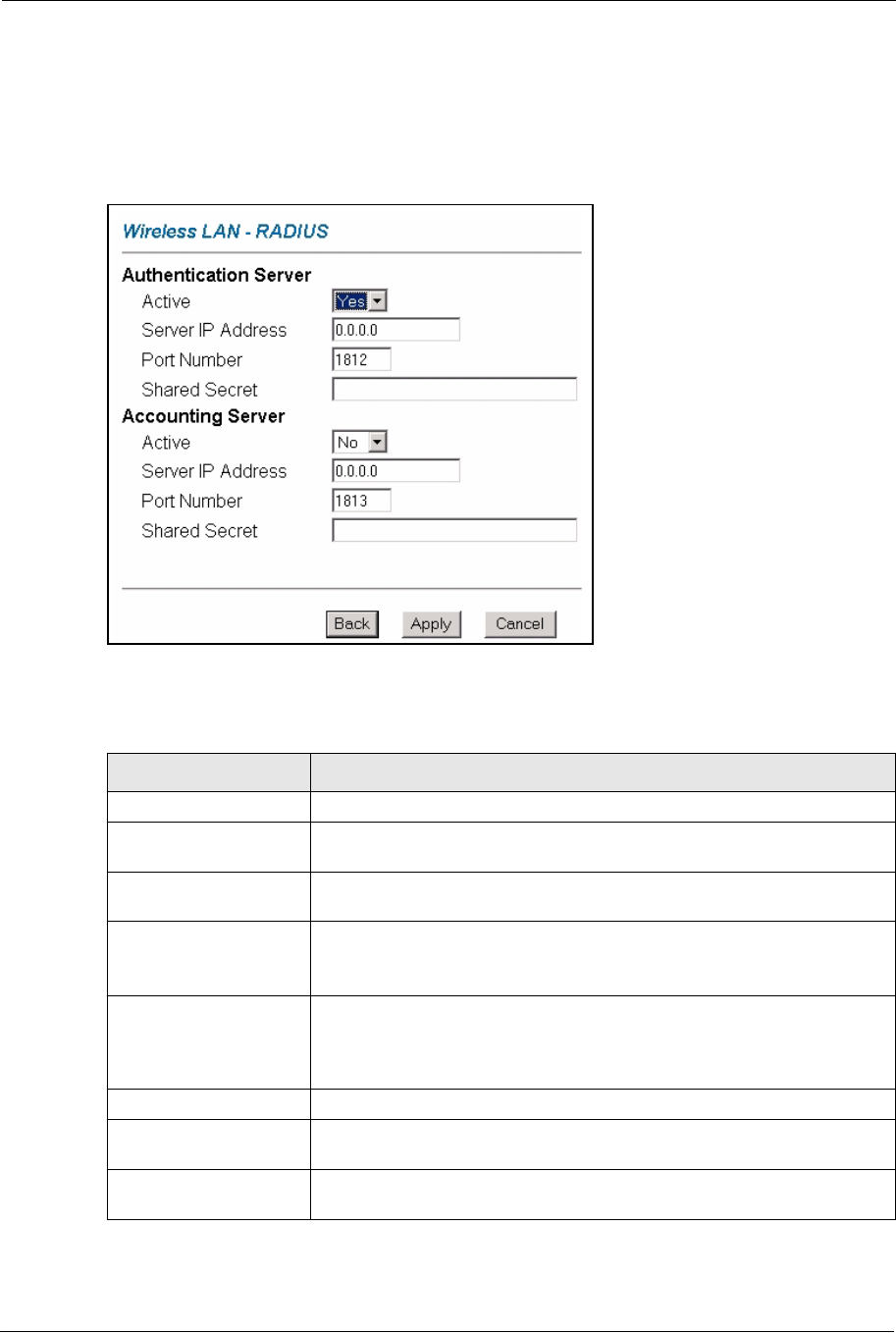
P-660H/HW/W-T Series User’ Guide
87 Chapter 5 Wireless LAN
5.9 Configuring RADIUS
To set up your Prestige’s RADIUS server settings, click WIRELESS LAN,RADIUS. The
screen appears as shown.
Figure 30 RADIUS
The following table describes the fields in this screen.
Table 20 RADIUS
LABEL DESCRIPTION
Authentication Server
Active Select Yes from the drop-down list box to enable user authentication
through an external authentication server.
Server IP Address Enter the IP address of the external authentication server in dotted decimal
notation.
Port Number The default port of the RADIUS server for authentication is 1812.
You need not change this value unless your network administrator instructs
you to do so with additional information.
Shared Secret Enter a password (up to 31 alphanumeric characters) as the key to be
shared between the external authentication server and the access points.
The key is not sent over the network. This key must be the same on the
external authentication server and Prestige.
Accounting Server
Active Select Yes from the drop-down list box to enable user authentication
through an external accounting server.
Server IP Address Enter the IP address of the external accounting server in dotted decimal
notation.

P-660H/HW/W-T Series User’ Guide
Chapter 5 Wireless LAN 88
Port Number The default port of the RADIUS server for accounting is 1813.
You need not change this value unless your network administrator instructs
you to do so with additional information.
Shared Secret Enter a password (up to 31 alphanumeric characters) as the key to be
shared between the external accounting server and the access points.
The key is not sent over the network. This key must be the same on the
external accounting server and the Prestige.
Back Click Back to go to the main wireless LAN setup screen.
Apply Click Apply to save these settings back to the Prestige.
Cancel Click Cancel to begin configuring this screen again.
Table 20 RADIUS (continued)
LABEL DESCRIPTION

P-660H/HW/W-T Series User’ Guide
89 Chapter 5 Wireless LAN

P-660H/HW/W-T Series User’ Guide
Chapter 6 WAN Setup 90
CHAPTER 6
WAN Setup
This chapter describes how to configure WAN settings.
6.1 WAN Overview
A WAN (Wide Area Network) is an outside connection to another network or the Internet.
6.1.1 Encapsulation
Be sure to use the encapsulation method required by your ISP. The Prestige supports the
following methods.
6.1.1.1 ENET ENCAP
The MAC Encapsulated Routing Link Protocol (ENET ENCAP) is only implemented with the
IP network protocol. IP packets are routed between the Ethernet interface and the WAN
interface and then formatted so that they can be understood in a bridged environment. For
instance, it encapsulates routed Ethernet frames into bridged ATM cells. ENET ENCAP
requires that you specify a gateway IP address in the ENET ENCAP Gateway field in the
second wizard screen. You can get this information from your ISP.
6.1.1.2 PPP over Ethernet
PPPoE provides access control and billing functionality in a manner similar to dial-up services
using PPP. The Prestige bridges a PPP session over Ethernet (PPP over Ethernet, RFC 2516)
from your computer to an ATM PVC (Permanent Virtual Circuit) which connects to ADSL
Access Concentrator where the PPP session terminates. One PVC can support any number of
PPP sessions from your LAN. For more information on PPPoE, see the appendices.
6.1.1.3 PPPoA
PPPoA stands for Point to Point Protocol over ATM Adaptation Layer 5 (AAL5). A PPPoA
connection functions like a dial-up Internet connection. The Prestige encapsulates the PPP
session based on RFC1483 and sends it through an ATM PVC (Permanent Virtual Circuit) to
the Internet Service Provider’s (ISP) DSLAM (digital access multiplexer). Please refer to RFC
2364 for more information on PPPoA. Refer to RFC 1661 for more information on PPP.

P-660H/HW/W-T Series User’ Guide
91 Chapter 6 WAN Setup
6.1.1.4 RFC 1483
RFC 1483 describes two methods for Multiprotocol Encapsulation over ATM Adaptation
Layer 5 (AAL5). The first method allows multiplexing of multiple protocols over a single
ATM virtual circuit (LLC-based multiplexing) and the second method assumes that each
protocol is carried over a separate ATM virtual circuit (VC-based multiplexing). Please refer
to the RFC for more detailed information.
6.1.2 Multiplexing
There are two conventions to identify what protocols the virtual circuit (VC) is carrying. Be
sure to use the multiplexing method required by your ISP.
6.1.2.1 VC-based Multiplexing
In this case, by prior mutual agreement, each protocol is assigned to a specific virtual circuit;
for example, VC1 carries IP, etc. VC-based multiplexing may be dominant in environments
where dynamic creation of large numbers of ATM VCs is fast and economical.
6.1.2.2 LLC-based Multiplexing
In this case one VC carries multiple protocols with protocol identifying information being
contained in each packet header. Despite the extra bandwidth and processing overhead, this
method may be advantageous if it is not practical to have a separate VC for each carried
protocol, for example, if charging heavily depends on the number of simultaneous VCs.
6.1.3 VPI and VCI
Be sure to use the correct Virtual Path Identifier (VPI) and Virtual Channel Identifier (VCI)
numbers assigned to you. The valid range for the VPI is 0 to 255 and for the VCI is 32 to
65535 (0 to 31 is reserved for local management of ATM traffic). Please see the appendix for
more information.
6.1.4 IP Address Assignment
A static IP is a fixed IP that your ISP gives you. A dynamic IP is not fixed; the ISP assigns you
a different one each time. The Single User Account feature can be enabled or disabled if you
have either a dynamic or static IP. However the encapsulation method assigned influences
your choices for IP address and ENET ENCAP gateway.
6.1.4.1 IP Assignment with PPPoA or PPPoE Encapsulation
If you have a dynamic IP, then the IP Address and ENET ENCAP Gateway fields are not
applicable (N/A). If you have a static IP, then you only need to fill in the IP Address field and
not the ENET ENCAP Gateway field.

P-660H/HW/W-T Series User’ Guide
Chapter 6 WAN Setup 92
6.1.4.2 IP Assignment with RFC 1483 Encapsulation
In this case the IP Address Assignment must be static with the same requirements for the IP
Address and ENET ENCAP Gateway fields as stated above.
6.1.4.3 IP Assignment with ENET ENCAP Encapsulation
In this case you can have either a static or dynamic IP. For a static IP you must fill in all the IP
Address and ENET ENCAP Gateway fields as supplied by your ISP. However for a
dynamic IP, the Prestige acts as a DHCP client on the WAN port and so the IP Address and
ENET ENCAP Gateway fields are not applicable (N/A) as the DHCP server assigns them to
the Prestige.
6.1.5 Nailed-Up Connection (PPP)
A nailed-up connection is a dial-up line where the connection is always up regardless of traffic
demand. The Prestige does two things when you specify a nailed-up connection. The first is
that idle timeout is disabled. The second is that the Prestige will try to bring up the connection
when turned on and whenever the connection is down. A nailed-up connection can be very
expensive for obvious reasons.
Do not specify a nailed-up connection unless your telephone company offers flat-rate service
or you need a constant connection and the cost is of no concern
6.1.6 NAT
NAT (Network Address Translation - NAT, RFC 1631) is the translation of the IP address of a
host in a packet, for example, the source address of an outgoing packet, used within one
network to a different IP address known within another network.
6.2 Metric
The metric represents the "cost of transmission". A router determines the best route for
transmission by choosing a path with the lowest "cost". RIP routing uses hop count as the
measurement of cost, with a minimum of "1" for directly connected networks. The number
must be between "1" and "15"; a number greater than "15" means the link is down. The
smaller the number, the lower the "cost".
The metric sets the priority for the Prestige’s routes to the Internet. If any two of the default
routes have the same metric, the Prestige uses the following pre-defined priorities:
• Normal route: designated by the ISP (see Section 6.7 on page 95)
• Traffic-redirect route (see Section 6.8 on page 98)
• WAN-backup route, also called dial-backup (see Section 6.9 on page 99)

P-660H/HW/W-T Series User’ Guide
93 Chapter 6 WAN Setup
For example, if the normal route has a metric of "1" and the traffic-redirect route has a metric
of "2" and dial-backup route has a metric of "3", then the normal route acts as the primary
default route. If the normal route fails to connect to the Internet, the Prestige tries the traffic-
redirect route next. In the same manner, the Prestige uses the dial-backup route if the traffic-
redirect route also fails.
If you want the dial-backup route to take first priority over the traffic-redirect route or even the
normal route, all you need to do is set the dial-backup route’s metric to "1" and the others to
"2" (or greater).
IP Policy Routing overrides the default routing behavior and takes priority over all of the
routes mentioned above.
6.3 PPPoE Encapsulation
The Prestige supports PPPoE (Point-to-Point Protocol over Ethernet). PPPoE is an IETF Draft
standard (RFC 2516) specifying how a personal computer (PC) interacts with a broadband
modem (DSL, cable, wireless, etc.) connection. The PPPoE option is for a dial-up connection
using PPPoE.
For the service provider, PPPoE offers an access and authentication method that works with
existing access control systems (for example Radius). PPPoE provides a login and
authentication method that the existing Microsoft Dial-Up Networking software can activate,
and therefore requires no new learning or procedures for Windows users.
One of the benefits of PPPoE is the ability to let you access one of multiple network services,
a function known as dynamic service selection. This enables the service provider to easily
create and offer new IP services for individuals.
Operationally, PPPoE saves significant effort for both you and the ISP or carrier, as it requires
no specific configuration of the broadband modem at the customer site.
By implementing PPPoE directly on the Prestige (rather than individual computers), the
computers on the LAN do not need PPPoE software installed, since the Prestige does that part
of the task. Furthermore, with NAT, all of the LANs’ computers will have access.
6.4 Traffic Shaping
Traffic Shaping is an agreement between the carrier and the subscriber to regulate the average
rate and fluctuations of data transmission over an ATM network. This agreement helps
eliminate congestion, which is important for transmission of real time data such as audio and
video connections.
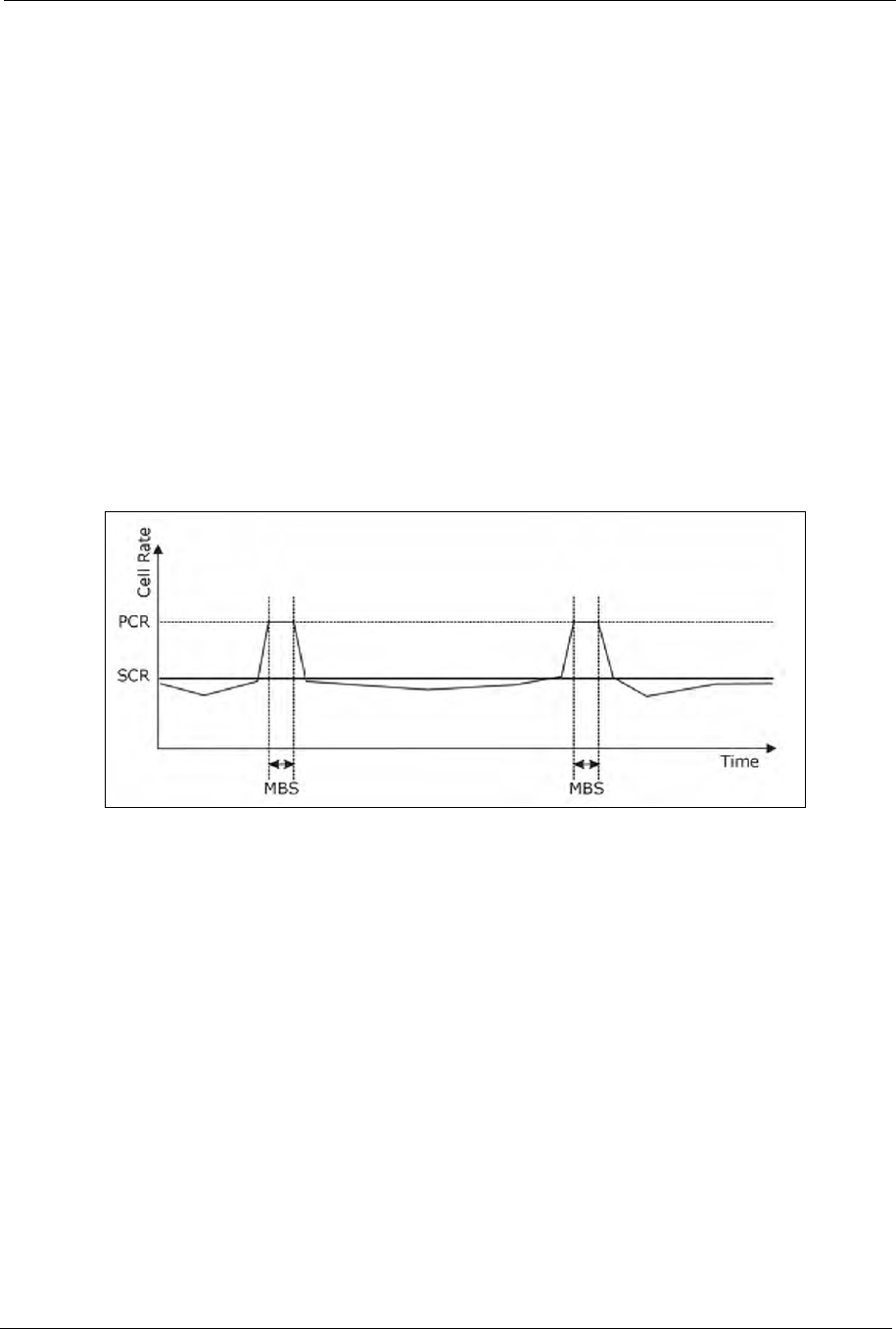
P-660H/HW/W-T Series User’ Guide
Chapter 6 WAN Setup 94
Peak Cell Rate (PCR) is the maximum rate at which the sender can send cells. This parameter
may be lower (but not higher) than the maximum line speed. 1 ATM cell is 53 bytes (424 bits),
so a maximum speed of 832Kbps gives a maximum PCR of 1962 cells/sec. This rate is not
guaranteed because it is dependent on the line speed.
Sustained Cell Rate (SCR) is the mean cell rate of each bursty traffic source. It specifies the
maximum average rate at which cells can be sent over the virtual connection. SCR may not be
greater than the PCR.
Maximum Burst Size (MBS) is the maximum number of cells that can be sent at the PCR.
After MBS is reached, cell rates fall below SCR until cell rate averages to the SCR again. At
this time, more cells (up to the MBS) can be sent at the PCR again.
If the PCR, SCR or MBS is set to the default of "0", the system will assign a maximum value
that correlates to your upstream line rate.
The following figure illustrates the relationship between PCR, SCR and MBS.
Figure 31 Example of Traffic Shaping
6.5 Zero Configuration Internet Access
Once you turn on and connect the Prestige to a telephone jack, it automatically detects the
Internet connection settings (such as the VCI/VPI numbers and the encapsulation method)
from the ISP and makes the necessary configuration changes. In cases where additional
account information (such as an Internet account user name and password) is required or the
Prestige cannot connect to the ISP, you will be redirected to web screen(s) for information
input or troubleshooting.
Zero configuration for Internet access is disable when
• the Prestige is in bridge mode
• you set the Prestige to use a static (fixed) WAN IP address.
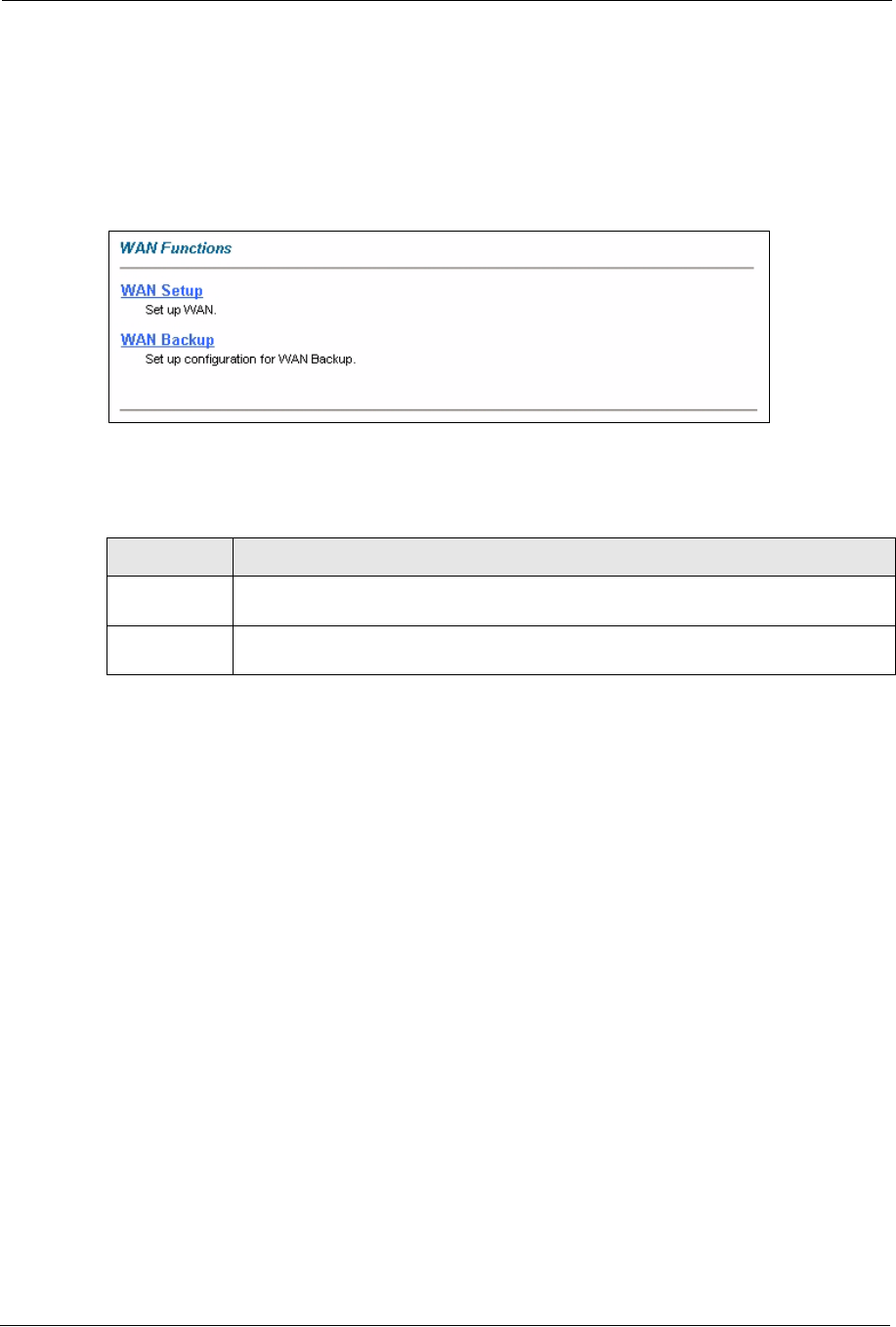
P-660H/HW/W-T Series User’ Guide
95 Chapter 6 WAN Setup
6.6 The Main WAN Screen
Click WA N in the navigation panel to display the man WAN screen.
See Section 6.1 on page 90 for more information.
Figure 32 WAN
The following table describes the links in this screen.
6.7 Configuring WAN Setup
To change your Prestige’s WAN remote node settings, click WA N and WAN Setup. The
screen differs by the encapsulation.
See Section 6.1 on page 90 for more information.
Table 21 WAN
LINK DESCRIPTION
WAN Setup Click this link to go to the screen where you can configure your Prestige for an Internet
connection.
WAN Backup Click this link to go to the screen where you can configure WAN backup connections
(traffic redirect and dial backup).
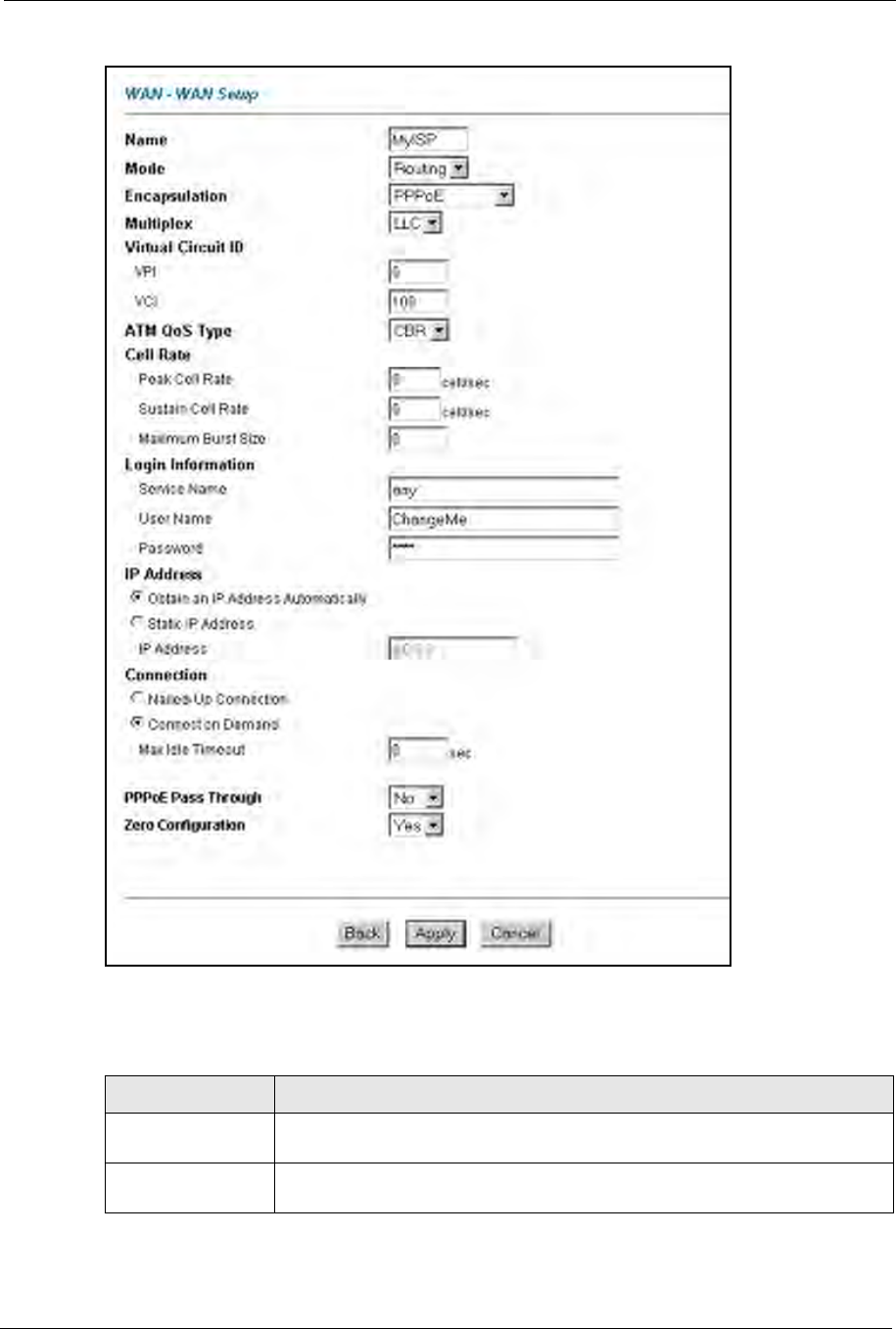
P-660H/HW/W-T Series User’ Guide
Chapter 6 WAN Setup 96
Figure 33 WAN Setup (PPPoE)
The following table describes the fields in this screen.
Table 22 WAN Setup
LABEL DESCRIPTION
Name Enter the name of your Internet Service Provider, e.g., MyISP. This information is
for identification purposes only.
Mode Select Routing (default) from the drop-down list box if your ISP allows multiple
computers to share an Internet account. Otherwise select Bridge.

P-660H/HW/W-T Series User’ Guide
97 Chapter 6 WAN Setup
Encapsulation Select the method of encapsulation used by your ISP from the drop-down list
box. Choices vary depending on the mode you select in the Mode field.
If you select Bridge in the Mode field, select either PPPoA or RFC 1483.
If you select Routing in the Mode field, select PPPoA,RFC 1483,ENET
ENCAP or PPPoE.
Multiplex Select the method of multiplexing used by your ISP from the drop-down list.
Choices are VC or LLC.
Virtual Circuit ID VPI (Virtual Path Identifier) and VCI (Virtual Channel Identifier) define a virtual
circuit. Refer to the appendix for more information.
VPI The valid range for the VPI is 0 to 255. Enter the VPI assigned to you.
VCI The valid range for the VCI is 32 to 65535 (0 to 31 is reserved for local
management of ATM traffic). Enter the VCI assigned to you.
ATM QoS Type Select CBR (Continuous Bit Rate) to specify fixed (always-on) bandwidth for
voice or data traffic. Select UBR (Unspecified Bit Rate) for applications that are
non-time sensitive, such as e-mail. Select VBR (Variable Bit Rate) for bursty
traffic and bandwidth sharing with other applications.
Cell Rate Cell rate configuration often helps eliminate traffic congestion that slows
transmission of real time data such as audio and video connections.
Peak Cell Rate Divide the DSL line rate (bps) by 424 (the size of an ATM cell) to find the Peak
Cell Rate (PCR). This is the maximum rate at which the sender can send cells.
Type the PCR here.
Sustain Cell Rate The Sustain Cell Rate (SCR) sets the average cell rate (long-term) that can be
transmitted. Type the SCR, which must be less than the PCR. Note that system
default is 0 cells/sec.
Maximum Burst Size Maximum Burst Size (MBS) refers to the maximum number of cells that can be
sent at the peak rate. Type the MBS, which is less than 65535.
Login Information (PPPoA and PPPoE encapsulation only)
Service Name (PPPoE only) Type the name of your PPPoE service here.
User Name Enter the user name exactly as your ISP assigned. If assigned a name in the
form user@domain where domain identifies a service name, then enter both
components exactly as given.
Password Enter the password associated with the user name above.
IP Address This option is available if you select Routing in the Mode field.
A static IP address is a fixed IP that your ISP gives you. A dynamic IP address is
not fixed; the ISP assigns you a different one each time you connect to the
Internet.
Select Obtain an IP Address Automatically if you have a dynamic IP address;
otherwise select Static IP Address and type your ISP assigned IP address in
the IP Address field below.
Connection
(PPPoA and PPPoE
encapsulation only)
The schedule rule(s) in SMT menu 26 have priority over your Connection
settings.
Nailed-Up
Connection
Select Nailed-Up Connection when you want your connection up all the time.
The Prestige will try to bring up the connection automatically if it is disconnected.
Table 22 WAN Setup (continued)
LABEL DESCRIPTION

P-660H/HW/W-T Series User’ Guide
Chapter 6 WAN Setup 98
6.8 Traffic Redirect
Traffic redirect forwards traffic to a backup gateway when the Prestige cannot connect to the
Internet. An example is shown in the figure below.
Connect on Demand Select Connect on Demand when you don't want the connection up all the time
and specify an idle time-out in the Max Idle Timeout field.
Max Idle Timeout Specify an idle time-out in the Max Idle Timeout field when you select Connect
on Demand. The default setting is 0, which means the Internet session will not
timeout.
PPPoE Passthrough
(PPPoE
encapsulation only)
This field is available when you select PPPoE encapsulation.
In addition to the Prestige's built-in PPPoE client, you can enable PPPoE pass
through to allow up to ten hosts on the LAN to use PPPoE client software on their
computers to connect to the ISP via the Prestige. Each host can have a separate
account and a public WAN IP address.
PPPoE pass through is an alternative to NAT for application where NAT is not
appropriate.
Disable PPPoE pass through if you do not need to allow hosts on the LAN to use
PPPoE client software on their computers to connect to the ISP.
Subnet Mask
(ENET ENCAP
encapsulation only)
Enter a subnet mask in dotted decimal notation.
Refer to the appendices to calculate a subnet mask If you are implementing
subnetting.
ENET ENCAP
Gateway
(ENET ENCAP
encapsulation only)
You must specify a gateway IP address (supplied by your ISP) when you select
ENET ENCAP in the Encapsulation field
Zero Configuration This feature is not applicable/available when you configure the Prestige to use a
static WAN IP address or in bridge mode.
Select Yes to set the Prestige to automatically detect the Internet connection
settings (such as the VCI/VPI numbers and the encapsulation method) from the
ISP and make the necessary configuration changes.
Select No to disable this feature. You must manually configure the Prestige for
Internet access.
Back Click Back to return to the previous screen.
Apply Click Apply to save the changes.
Cancel Click Cancel to begin configuring this screen afresh.
Table 22 WAN Setup (continued)
LABEL DESCRIPTION
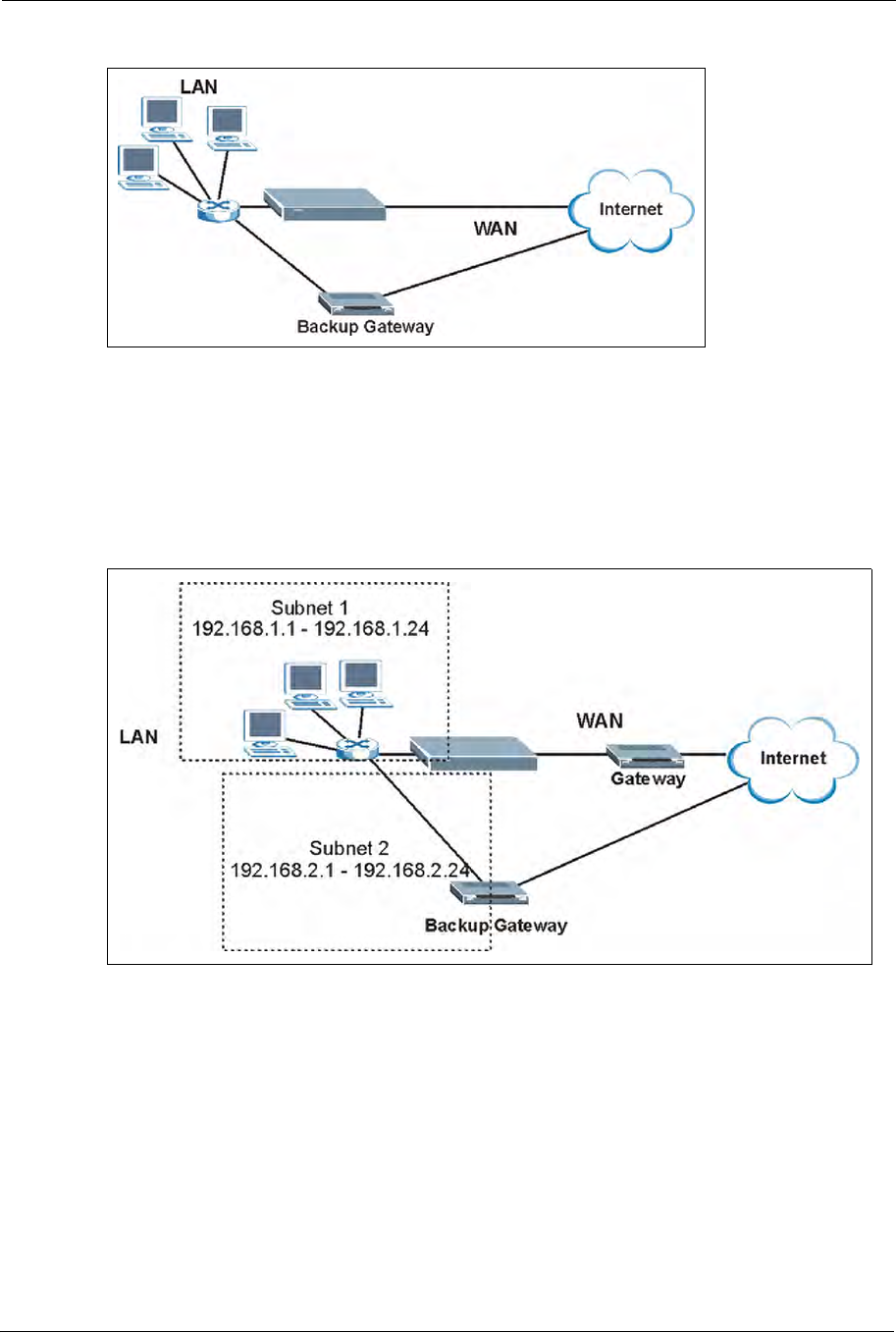
P-660H/HW/W-T Series User’ Guide
99 Chapter 6 WAN Setup
Figure 34 Traffic Redirect Example
The following network topology allows you to avoid triangle route security issues when the
backup gateway is connected to the LAN. Use IP alias to configure the LAN into two or three
logical networks with the Prestige itself as the gateway for each LAN network. Put the
protected LAN in one subnet (Subnet 1 in the following figure) and the backup gateway in
another subnet (Subnet 2). Configure filters that allow packets from the protected LAN
(Subnet 1) to the backup gateway (Subnet 2).
Figure 35 Traffic Redirect LAN Setup
6.9 Configuring WAN Backup
To change your Prestige’s WAN backup settings, click WA N , then WAN Backup. The screen
appears as shown.
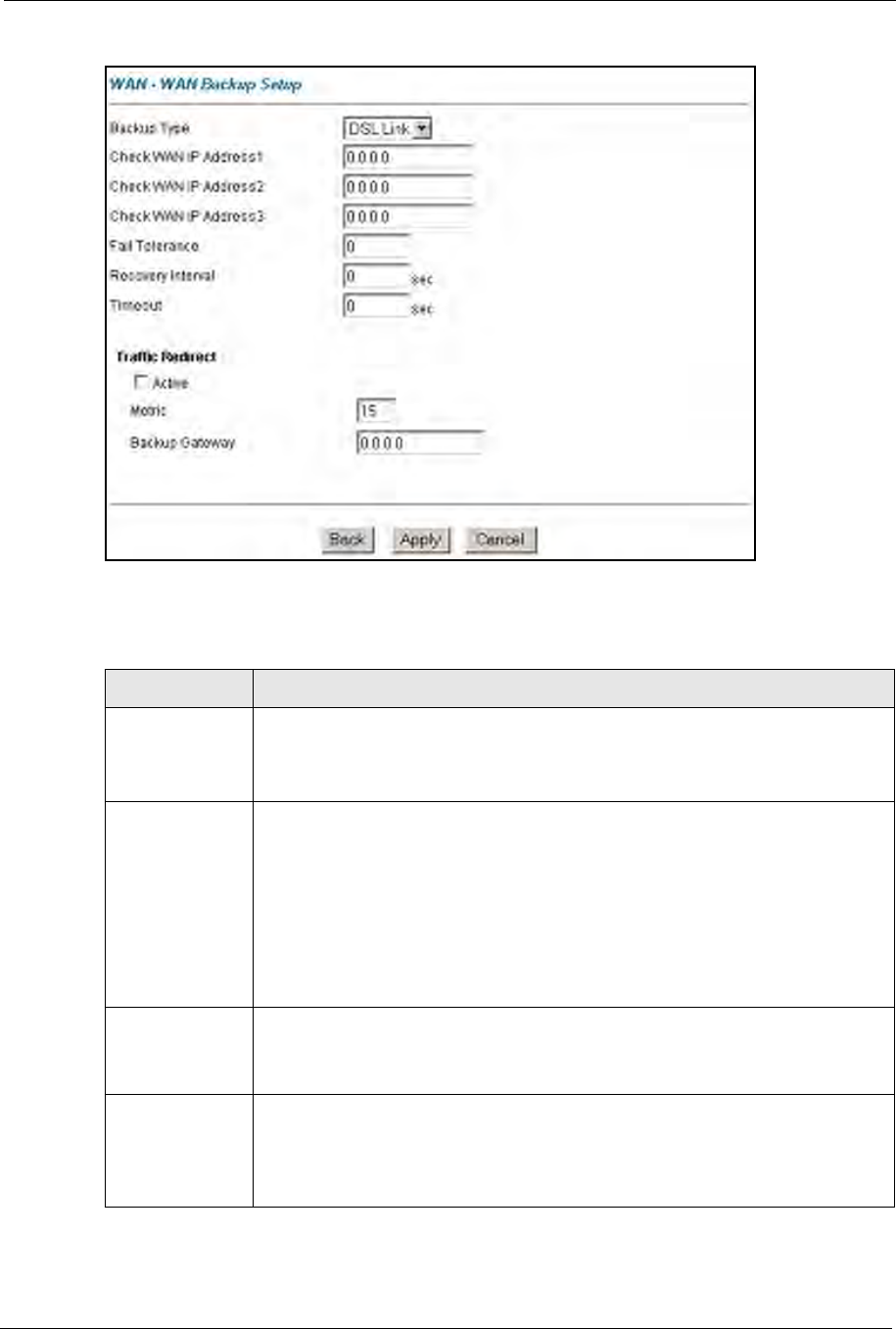
P-660H/HW/W-T Series User’ Guide
Chapter 6 WAN Setup 100
Figure 36 WAN Backup
The following table describes the fields in this screen.
Table 23 WAN Backup
LABEL DESCRIPTION
Backup Type Select the method that the Prestige uses to check the DSL connection.
Select DSL Link to have the Prestige check if the connection to the DSLAM is up.
Select ICMP to have the Prestige periodically ping the IP addresses configured in
the Check WAN IP Address fields.
Check WAN IP
Address1-3
Configure this field to test your Prestige's WAN accessibility. Type the IP address of
a reliable nearby computer (for example, your ISP's DNS server address).
Note: If you activate either traffic redirect or dial backup, you must
configure at least one IP address here.
When using a WAN backup connection, the Prestige periodically pings the
addresses configured here and uses the other WAN backup connection (if
configured) if there is no response.
Fail Tolerance Type the number of times (2 recommended) that your Prestige may ping the IP
addresses configured in the Check WAN IP Address field without getting a
response before switching to a WAN backup connection (or a different WAN
backup connection).
Recovery Interval When the Prestige is using a lower priority connection (usually a WAN backup
connection), it periodically checks to whether or not it can use a higher priority
connection.
Type the number of seconds (30 recommended) for the Prestige to wait between
checks. Allow more time if your destination IP address handles lots of traffic.

P-660H/HW/W-T Series User’ Guide
101 Chapter 6 WAN Setup
Timeout Type the number of seconds (3 recommended) for your Prestige to wait for a ping
response from one of the IP addresses in the Check WAN IP Address field before
timing out the request. The WAN connection is considered "down" after the Prestige
times out the number of times specified in the Fail Tolerance field. Use a higher
value in this field if your network is busy or congested.
Traffic Redirect Traffic redirect forwards traffic to a backup gateway when the Prestige cannot
connect to the Internet.
Active Select this check box to have the Prestige use traffic redirect if the normal WAN
connection goes down.
Note: If you activate traffic redirect, you must configure at least one
Check WAN IP Address.
Metric This field sets this route's priority among the routes the Prestige uses.
The metric represents the "cost of transmission". A router determines the best route
for transmission by choosing a path with the lowest "cost". RIP routing uses hop
count as the measurement of cost, with a minimum of "1" for directly connected
networks. The number must be between "1" and "15"; a number greater than "15"
means the link is down. The smaller the number, the lower the "cost".
Backup Gateway Type the IP address of your backup gateway in dotted decimal notation. The
Prestige automatically forwards traffic to this IP address if the Prestige's Internet
connection terminates.
Back Click Back to return to the previous screen.
Apply Click Apply to save the changes.
Cancel Click Cancel to begin configuring this screen afresh.
Table 23 WAN Backup (continued)
LABEL DESCRIPTION

P-660H/HW/W-T Series User’ Guide
Chapter 7 Network Address Translation (NAT) Screens 102
CHAPTER 7
Network Address Translation
(NAT) Screens
This chapter discusses how to configure NAT on the Prestige.
7.1 NAT Overview
NAT (Network Address Translation - NAT, RFC 1631) is the translation of the IP address of a
host in a packet, for example, the source address of an outgoing packet, used within one
network to a different IP address known within another network.
7.1.1 NAT Definitions
Inside/outside denotes where a host is located relative to the Prestige, for example, the
computers of your subscribers are the inside hosts, while the web servers on the Internet are
the outside hosts.
Global/local denotes the IP address of a host in a packet as the packet traverses a router, for
example, the local address refers to the IP address of a host when the packet is in the local
network, while the global address refers to the IP address of the host when the same packet is
traveling in the WAN side.
Note that inside/outside refers to the location of a host, while global/local refers to the IP
address of a host used in a packet. Thus, an inside local address (ILA) is the IP address of an
inside host in a packet when the packet is still in the local network, while an inside global
address (IGA) is the IP address of the same inside host when the packet is on the WAN side.
The following table summarizes this information.
NAT never changes the IP address (either local or global) of an outside host.
Table 24 NAT Definitions
ITEM DESCRIPTION
Inside This refers to the host on the LAN.
Outside This refers to the host on the WAN.
Local This refers to the packet address (source or destination) as the packet travels on the
LAN.
Global This refers to the packet address (source or destination) as the packet travels on the
WAN.

P-660H/HW/W-T Series User’ Guide
103 Chapter 7 Network Address Translation (NAT) Screens
7.1.2 What NAT Does
In the simplest form, NAT changes the source IP address in a packet received from a
subscriber (the inside local address) to another (the inside global address) before forwarding
the packet to the WAN side. When the response comes back, NAT translates the destination
address (the inside global address) back to the inside local address before forwarding it to the
original inside host. Note that the IP address (either local or global) of an outside host is never
changed.
The global IP addresses for the inside hosts can be either static or dynamically assigned by the
ISP. In addition, you can designate servers, for example, a web server and a telnet server, on
your local network and make them accessible to the outside world. If you do not define any
servers (for Many-to-One and Many-to-Many Overload mapping – see Table 25 on page 105),
NAT offers the additional benefit of firewall protection. With no servers defined, your Prestige
filters out all incoming inquiries, thus preventing intruders from probing your network. For
more information on IP address translation, refer to RFC 1631,The IP Network Address
Translator (NAT).
7.1.3 How NAT Works
Each packet has two addresses – a source address and a destination address. For outgoing
packets, the ILA (Inside Local Address) is the source address on the LAN, and the IGA (Inside
Global Address) is the source address on the WAN. For incoming packets, the ILA is the
destination address on the LAN, and the IGA is the destination address on the WAN. NAT
maps private (local) IP addresses to globally unique ones required for communication with
hosts on other networks. It replaces the original IP source address (and TCP or UDP source
port numbers for Many-to-One and Many-to-Many Overload NAT mapping) in each packet
and then forwards it to the Internet. The Prestige keeps track of the original addresses and port
numbers so incoming reply packets can have their original values restored. The following
figure illustrates this.
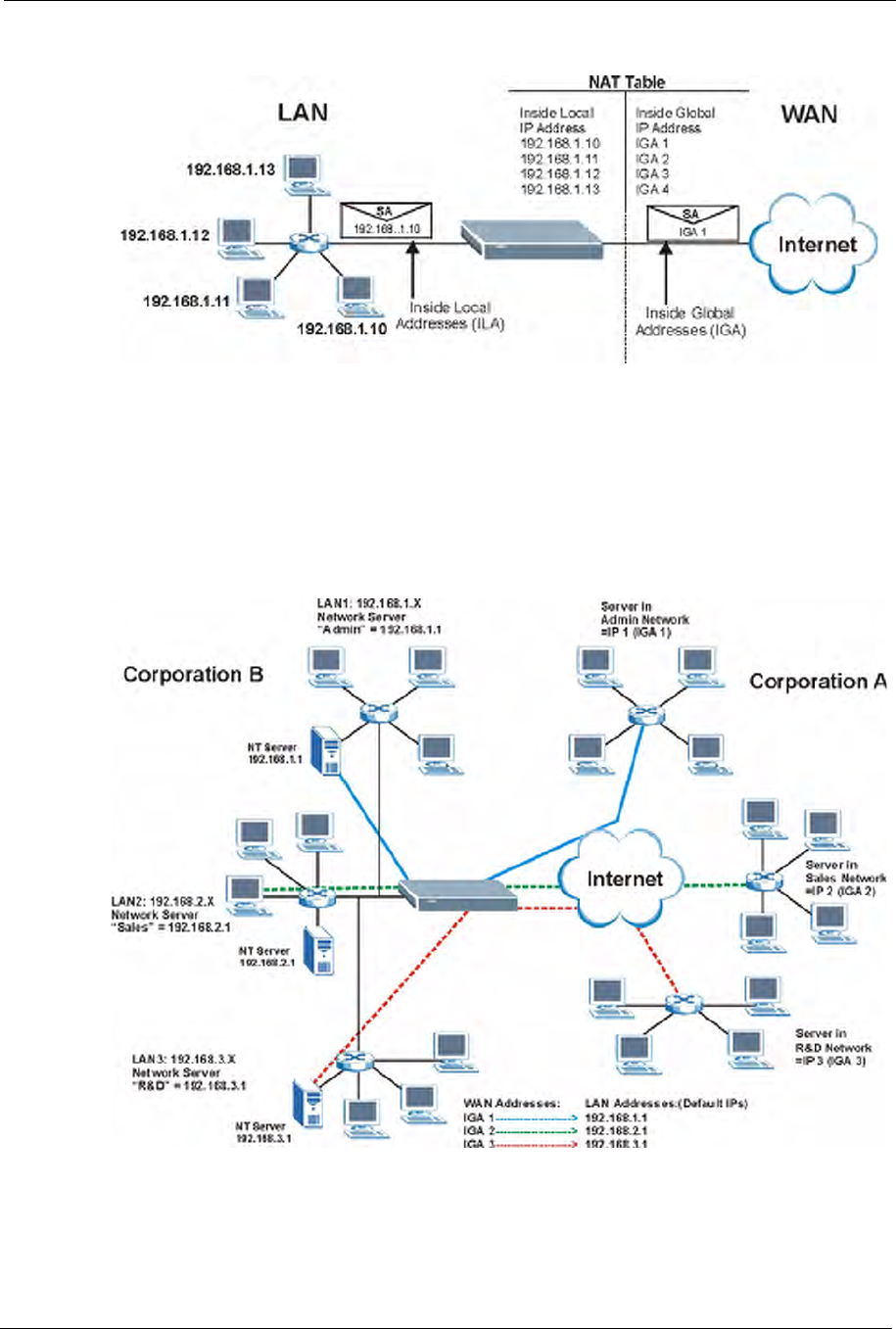
P-660H/HW/W-T Series User’ Guide
Chapter 7 Network Address Translation (NAT) Screens 104
Figure 37 How NAT Works
7.1.4 NAT Application
The following figure illustrates a possible NAT application, where three inside LANs (logical
LANs using IP Alias) behind the Prestige can communicate with three distinct WAN
networks. More examples follow at the end of this chapter.
Figure 38 NAT Application With IP Alias

P-660H/HW/W-T Series User’ Guide
105 Chapter 7 Network Address Translation (NAT) Screens
7.1.5 NAT Mapping Types
NAT supports five types of IP/port mapping. They are:
•One to One: In One-to-One mode, the Prestige maps one local IP address to one global
IP address.
•Many to One: In Many-to-One mode, the Prestige maps multiple local IP addresses to
one global IP address. This is equivalent to SUA (for instance, PAT, port address
translation), ZyXEL’s Single User Account feature that previous ZyXEL routers
supported (the SUA Only option in today’s routers).
•Many to Many Overload: In Many-to-Many Overload mode, the Prestige maps the
multiple local IP addresses to shared global IP addresses.
•Many-to-Many No Overload: In Many-to-Many No Overload mode, the Prestige maps
each local IP address to a unique global IP address.
•Server: This type allows you to specify inside servers of different services behind the
NAT to be accessible to the outside world.
Port numbers do NOT change for One-to-One and Many-to-Many No Overload NAT
mapping types.
The following table summarizes these types.
Table 25 NAT Mapping Types
TYPE IP MAPPING SMT ABBREVIATION
One-to-One ILA1ÅÆ IGA1 1:1
Many-to-One (SUA/PAT) ILA1ÅÆ IGA1
ILA2ÅÆ IGA1
…
M:1
Many-to-Many Overload ILA1ÅÆ IGA1
ILA2ÅÆ IGA2
ILA3ÅÆ IGA1
ILA4ÅÆ IGA2
…
M:M Ov
Many-to-Many No Overload ILA1ÅÆ IGA1
ILA2ÅÆ IGA2
ILA3ÅÆ IGA3
…
M:M No OV
Server Server 1 IPÅÆ IGA1
Server 2 IPÅÆ IGA1
Server 3 IPÅÆ IGA1
Server

P-660H/HW/W-T Series User’ Guide
Chapter 7 Network Address Translation (NAT) Screens 106
7.2 SUA (Single User Account) Versus NAT
SUA (Single User Account) is a ZyNOS implementation of a subset of NAT that supports two
types of mapping, Many-to-One and Server. The Prestige also supports Full Feature NAT
to map multiple global IP addresses to multiple private LAN IP addresses of clients or servers
using mapping types as outlined in Table 25 on page 105.
• Choose SUA Only if you have just one public WAN IP address for your Prestige.
• Choose Full Feature if you have multiple public WAN IP addresses for your Prestige.
7.3 SUA Server
A SUA server set is a list of inside (behind NAT on the LAN) servers, for example, web or
FTP, that you can make visible to the outside world even though SUA makes your whole
inside network appear as a single computer to the outside world.
You may enter a single port number or a range of port numbers to be forwarded, and the local
IP address of the desired server. The port number identifies a service; for example, web
service is on port 80 and FTP on port 21. In some cases, such as for unknown services or
where one server can support more than one service (for example both FTP and web service),
it might be better to specify a range of port numbers. You can allocate a server IP address that
corresponds to a port or a range of ports.
Many residential broadband ISP accounts do not allow you to run any server processes (such
as a Web or FTP server) from your location. Your ISP may periodically check for servers and
may suspend your account if it discovers any active services at your location. If you are
unsure, refer to your ISP.
7.3.1 Default Server IP Address
In addition to the servers for specified services, NAT supports a default server IP address. A
default server receives packets from ports that are not specified in this screen.
If you do not assign an IP address in Server Set 1 (default server) the Prestige discards all
packets received for ports that are not specified here or in the remote management setup.
7.3.2 Port Forwarding: Services and Port Numbers
The most often used port numbers are shown in the following table. Please refer to RFC 1700
for further information about port numbers.
Table 26 Services and Port Numbers
SERVICES PORT NUMBER
ECHO 7
FTP (File Transfer Protocol) 21
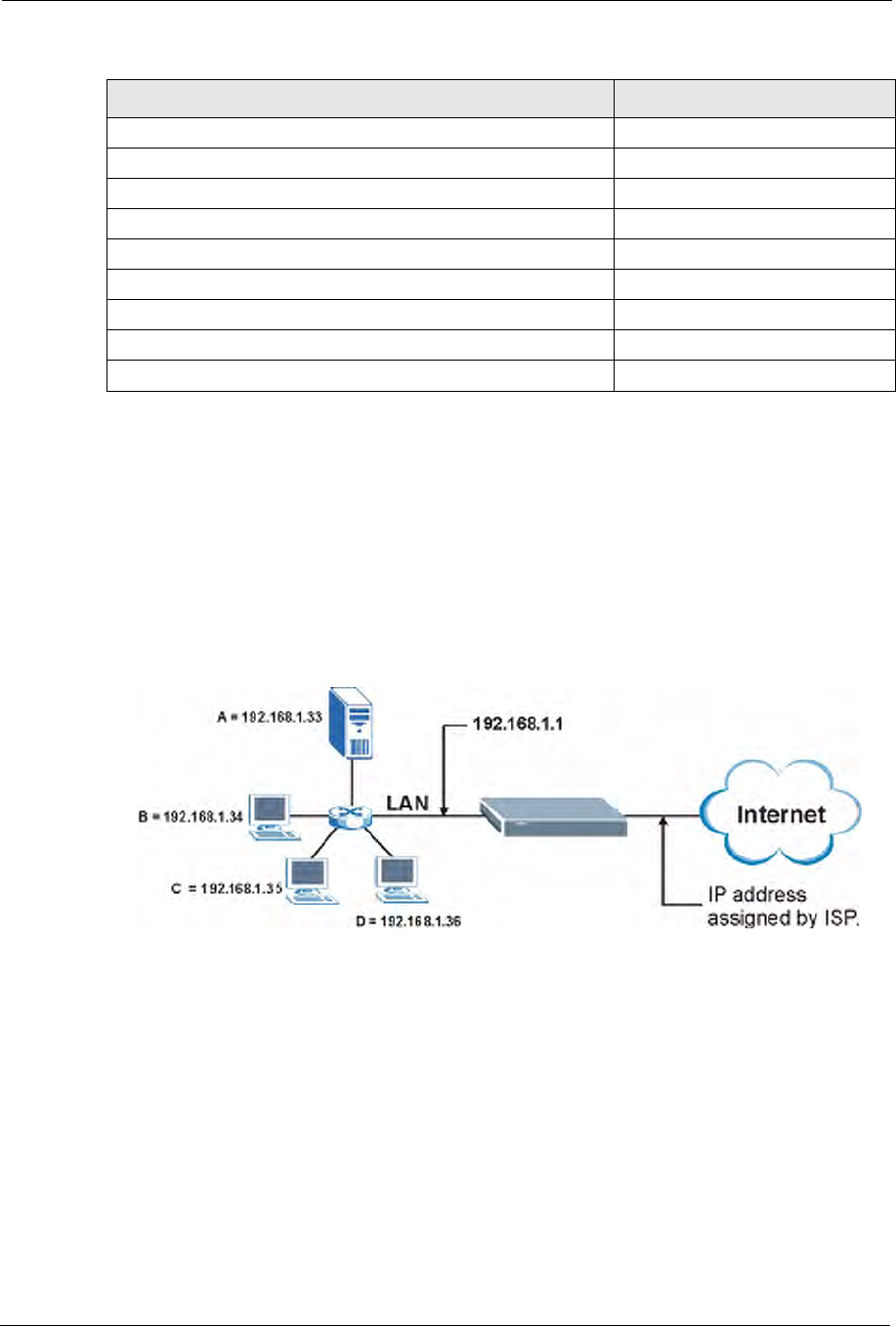
P-660H/HW/W-T Series User’ Guide
107 Chapter 7 Network Address Translation (NAT) Screens
7.3.3 Configuring Servers Behind SUA (Example)
Let's say you want to assign ports 21-25 to one FTP, Telnet and SMTP server (A in the
example), port 80 to another (B in the example) and assign a default server IP address of
192.168.1.35 to a third (C in the example). You assign the LAN IP addresses and the ISP
assigns the WAN IP address. The NAT network appears as a single host on the Internet.
IP address assigned by ISP.
Figure 39 Multiple Servers Behind NAT Example
7.4 Selecting the NAT Mode
You must create a firewall rule in addition to setting up SUA/NAT, to allow traffic from the
WAN to be forwarded through the Prestige. Click NAT to open the following screen.
SMTP (Simple Mail Transfer Protocol) 25
DNS (Domain Name System) 53
Finger 79
HTTP (Hyper Text Transfer protocol or WWW, Web) 80
POP3 (Post Office Protocol) 110
NNTP (Network News Transport Protocol) 119
SNMP (Simple Network Management Protocol) 161
SNMP trap 162
PPTP (Point-to-Point Tunneling Protocol) 1723
Table 26 Services and Port Numbers (continued)
SERVICES PORT NUMBER
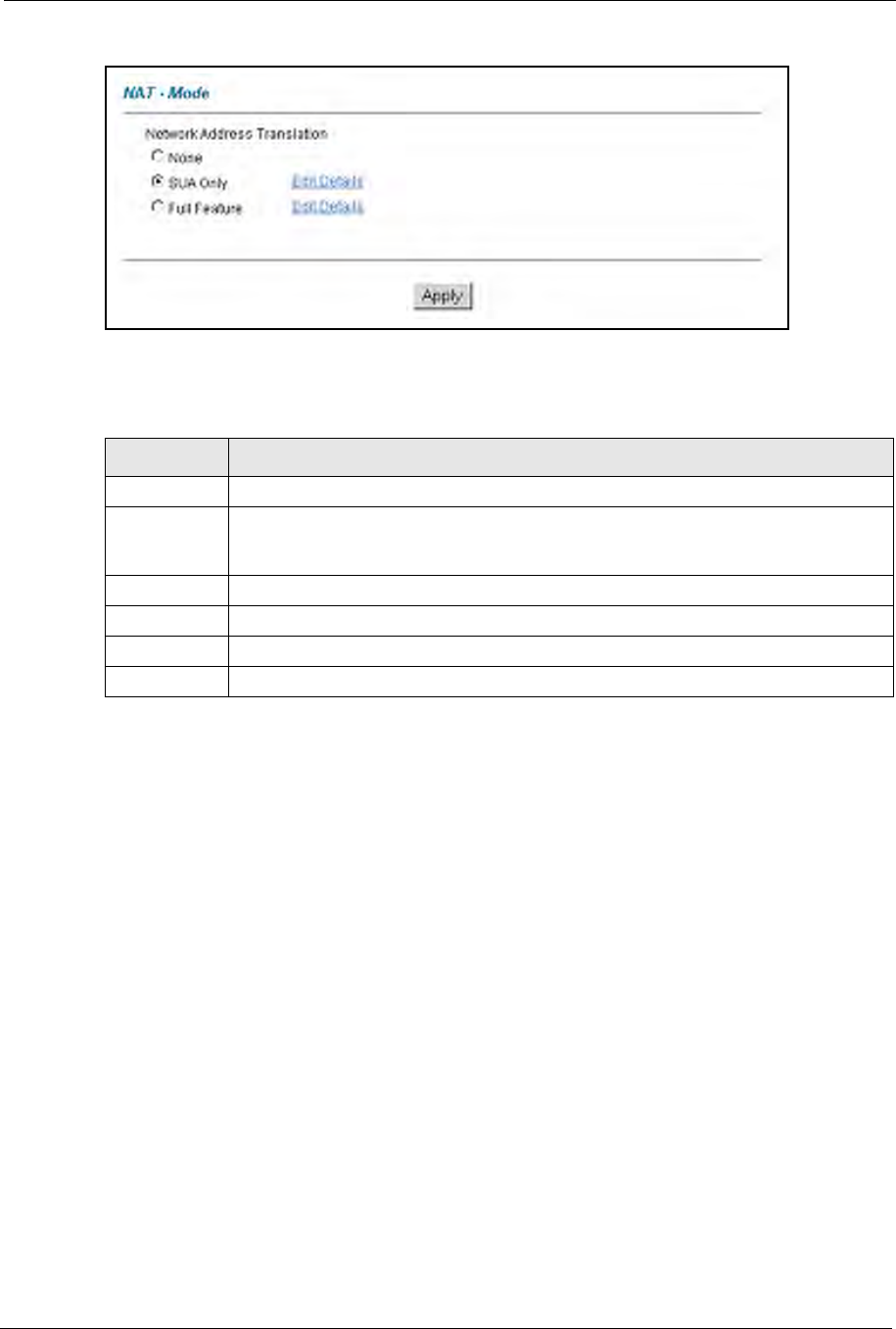
P-660H/HW/W-T Series User’ Guide
Chapter 7 Network Address Translation (NAT) Screens 108
Figure 40 NAT Mode
The following table describes the labels in this screen.
7.5 Configuring SUA Server Set
If you do not assign an IP address in Server Set 1 (default server) the Prestige discards all
packets received for ports that are not specified here or in the remote management setup.
Click NAT, select SUA Only and click Edit Details to open the following screen.
See Section 7.3 on page 106 for more information. See Table 26 on page 106 for port numbers
commonly used for particular services.
Table 27 NAT Mode
LABEL DESCRIPTION
None Select this radio button to disable NAT.
SUA Only Select this radio button if you have just one public WAN IP address for your Prestige.
The Prestige uses Address Mapping Set 1 in the NAT - Edit SUA/NAT Server Set
screen.
Edit Details Click this link to go to the NAT - Edit SUA/NAT Server Set screen.
Full Feature Select this radio button if you have multiple public WAN IP addresses for your Prestige.
Edit Details Click this link to go to the NAT - Address Mapping Rules screen.
Apply Click Apply to save your configuration.
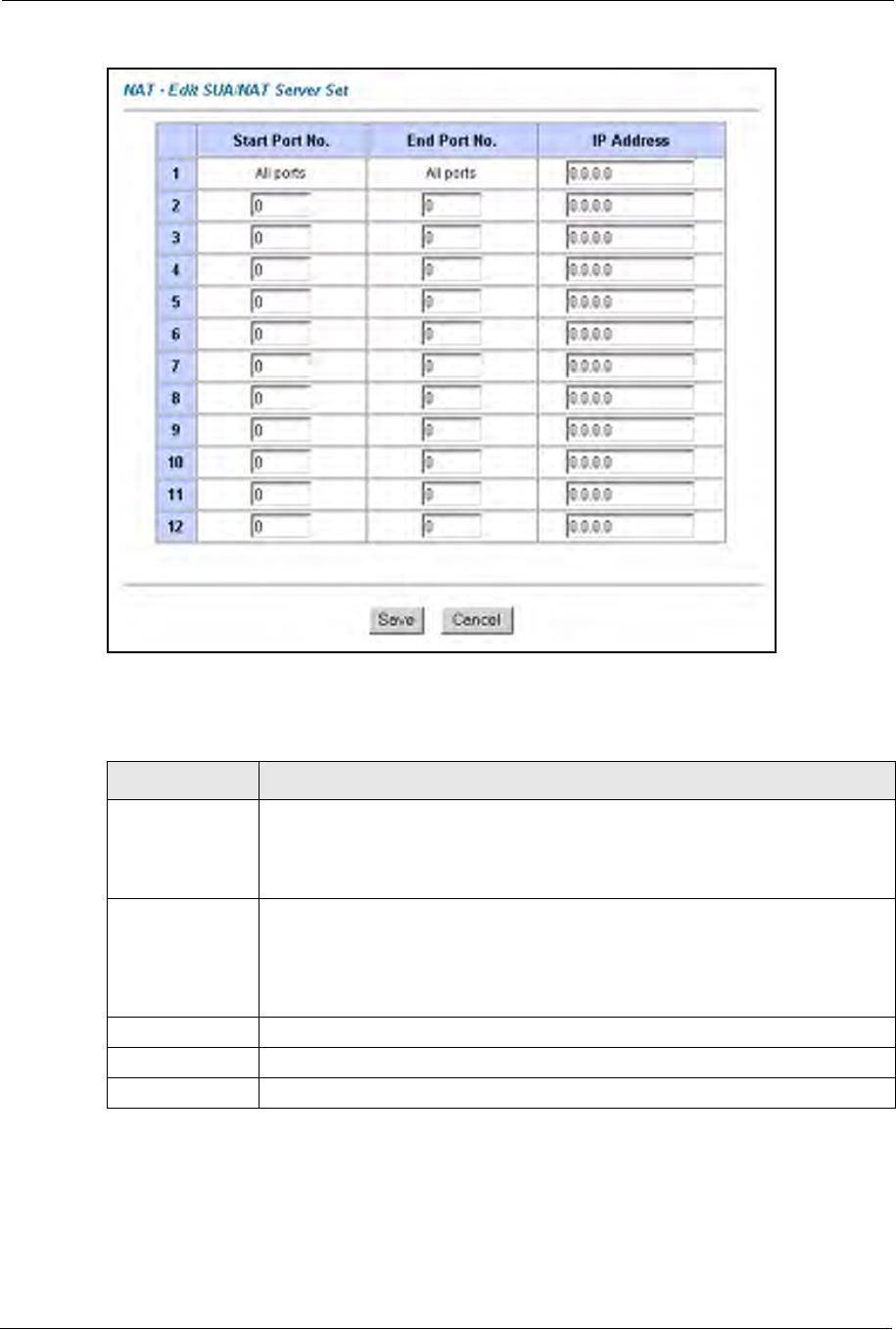
P-660H/HW/W-T Series User’ Guide
109 Chapter 7 Network Address Translation (NAT) Screens
Figure 41 Edit SUA/NAT Server Set
The following table describes the fields in this screen.
Table 28 Edit SUA/NAT Server Set
LABEL DESCRIPTION
Start Port No. Enter a port number in this field.
To forward only one port, enter the port number again in the End Port No. field.
To forward a series of ports, enter the start port number here and the end port
number in the End Port No. field.
End Port No. Enter a port number in this field.
To forward only one port, enter the port number again in the Start Port No. field
above and then enter it again in this field.
To forward a series of ports, enter the last port number in a series that begins with
the port number in the Start Port No. field above.
Server IP Address Enter your server IP address in this field.
Save Click Save to save your changes back to the Prestige.
Cancel Click Cancel to return to the previous configuration.
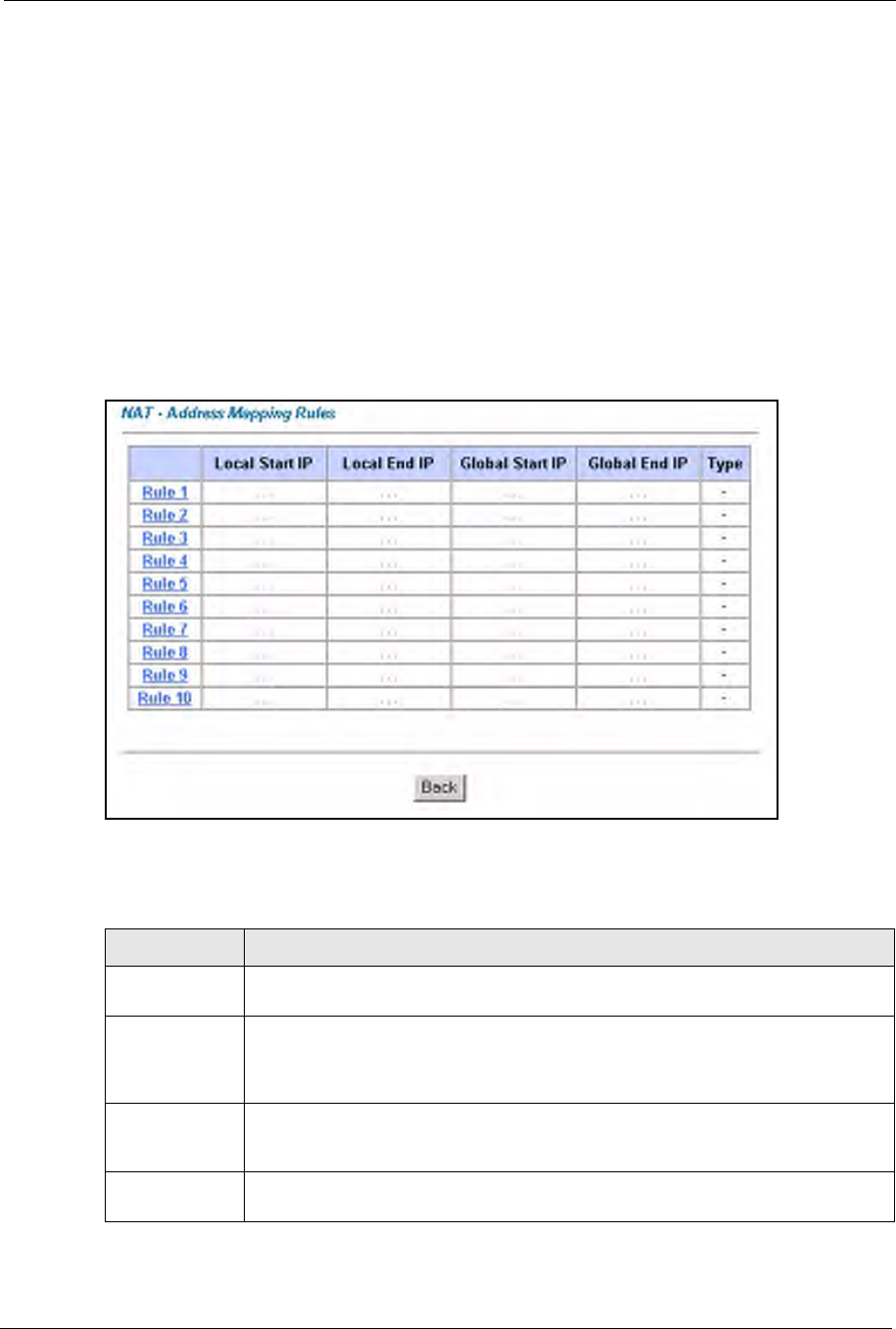
P-660H/HW/W-T Series User’ Guide
Chapter 7 Network Address Translation (NAT) Screens 110
7.6 Configuring Address Mapping Rules
Ordering your rules is important because the Prestige applies the rules in the order that you
specify. When a rule matches the current packet, the Prestige takes the corresponding action
and the remaining rules are ignored. If there are any empty rules before your new configured
rule, your configured rule will be pushed up by that number of empty rules. For example, if
you have already configured rules 1 to 6 in your current set and now you configure rule
number 9. In the set summary screen, the new rule will be rule 7, not 9. Now if you delete rule
4, rules 5 to 7 will be pushed up by 1 rule, so old rules 5, 6 and 7 become new rules 4, 5 and 6.
To change your Prestige’s address mapping settings, click NAT, Select Full Feature and click
Edit Details to open the following screen.
Figure 42 Address Mapping Rules
The following table describes the fields in this screen.
Table 29 Address Mapping Rules
LABEL DESCRIPTION
Local Start IP This is the starting Inside Local IP Address (ILA). Local IP addresses are N/A for
Server port mapping.
Local End IP This is the end Inside Local IP Address (ILA). If the rule is for all local IP addresses,
then this field displays 0.0.0.0 as the Local Start IP address and 255.255.255.255
as the Local End IP address. This field is N/A for One-to-one and Server mapping
types.
Global Start IP This is the starting Inside Global IP Address (IGA). Enter 0.0.0.0 here if you have a
dynamic IP address from your ISP. You can only do this for Many-to-One and
Server mapping types.
Global End IP This is the ending Inside Global IP Address (IGA). This field is N/A for One-to-one,
Many-to-One and Server mapping types.

P-660H/HW/W-T Series User’ Guide
111 Chapter 7 Network Address Translation (NAT) Screens
7.7 Editing an Address Mapping Rule
To edit an address mapping rule, click the rule’s link in the NAT Address Mapping Rules
screen to display the screen shown next.
Type 1-1: One-to-one mode maps one local IP address to one global IP address. Note that
port numbers do not change for the One-to-one NAT mapping type.
M-1: Many-to-One mode maps multiple local IP addresses to one global IP address.
This is equivalent to SUA (i.e., PAT, port address translation), ZyXEL's Single User
Account feature that previous ZyXEL routers supported only.
M-M Ov (Overload): Many-to-Many Overload mode maps multiple local IP addresses
to shared global IP addresses.
MM No (No Overload): Many-to-Many No Overload mode maps each local IP
address to unique global IP addresses.
Server: This type allows you to specify inside servers of different services behind the
NAT to be accessible to the outside world.
Back Click Back to return to the NAT Mode screen.
Table 29 Address Mapping Rules (continued)
LABEL DESCRIPTION
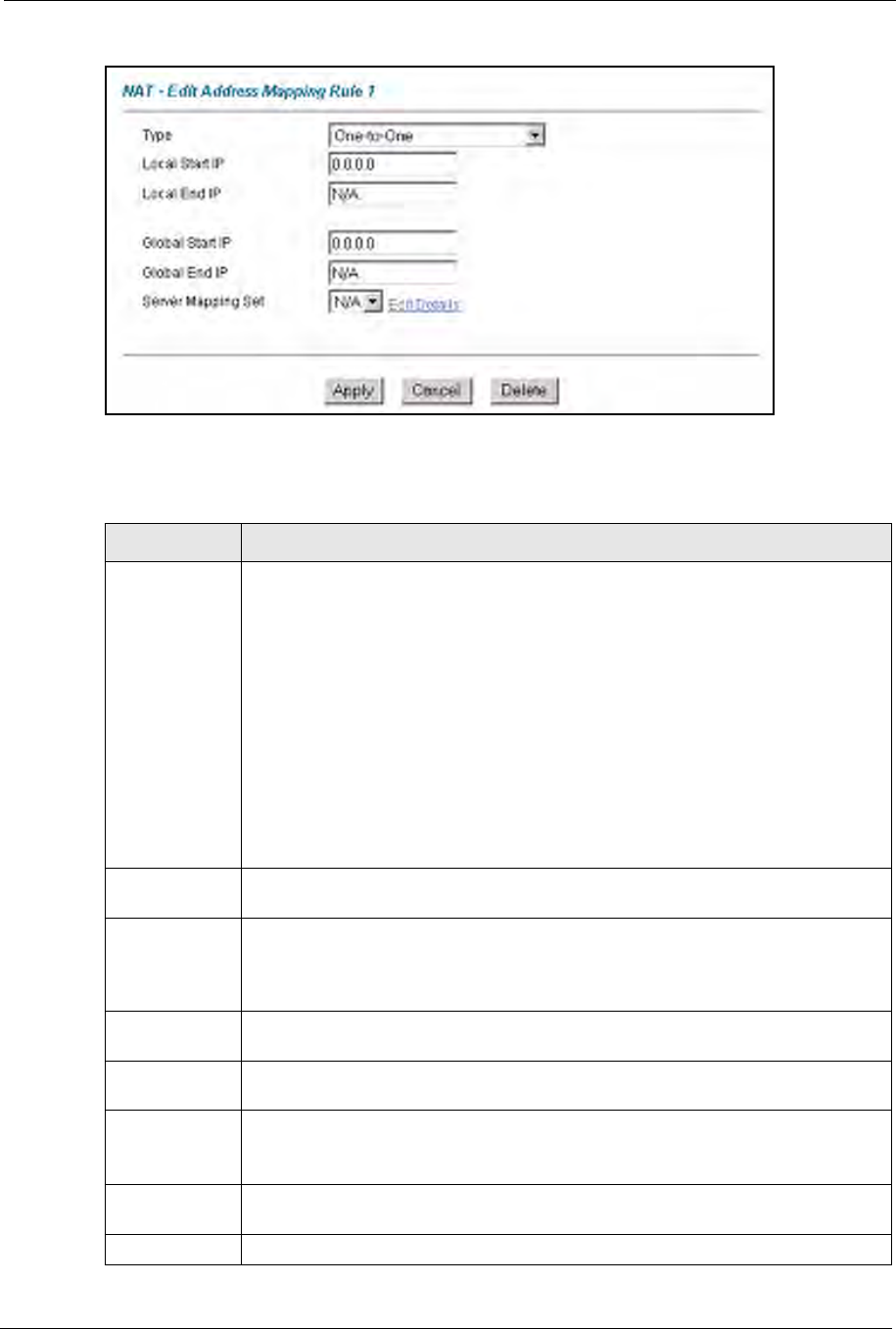
P-660H/HW/W-T Series User’ Guide
Chapter 7 Network Address Translation (NAT) Screens 112
Figure 43 Edit Address Mapping Rule
The following table describes the fields in this screen.
Table 30 Edit Address Mapping Rule
LABEL DESCRIPTION
Type Choose the port mapping type from one of the following.
•One-to-One: One-to-One mode maps one local IP address to one global IP
address. Note that port numbers do not change for One-to-one NAT mapping
type.
•Many-to-One: Many-to-One mode maps multiple local IP addresses to one
global IP address. This is equivalent to SUA (i.e., PAT, port address translation),
ZyXEL's Single User Account feature that previous ZyXEL routers supported
only.
•Many-to-Many Overload: Many-to-Many Overload mode maps multiple local IP
addresses to shared global IP addresses.
•Many-to-Many No Overload: Many-to-Many No Overload mode maps each
local IP address to unique global IP addresses.
•Server: This type allows you to specify inside servers of different services behind
the NAT to be accessible to the outside world.
Local Start IP This is the starting local IP address (ILA). Local IP addresses are N/A for Server port
mapping.
Local End IP This is the end local IP address (ILA). If your rule is for all local IP addresses, then
enter 0.0.0.0 as the Local Start IP address and 255.255.255.255 as the Local End
IP address.
This field is N/A for One-to-One and Server mapping types.
Global Start IP This is the starting global IP address (IGA). Enter 0.0.0.0 here if you have a dynamic
IP address from your ISP.
Global End IP This is the ending global IP address (IGA). This field is N/A for One-to-One,Many-
to-One and Server mapping types.
Server Mapping
Set
Only available when Type is set to Server.
Select a number from the drop-down menu to choose a server set from the NAT -
Address Mapping Rules screen.
Edit Details Click this link to go to the NAT - Edit SUA/NAT Server Set screen to edit a server
set that you have selected in the Server Mapping Set field.
Apply Click Apply to save your changes back to the Prestige.

P-660H/HW/W-T Series User’ Guide
113 Chapter 7 Network Address Translation (NAT) Screens
Cancel Click Cancel to return to the previously saved settings.
Delete Click Delete to exit this screen without saving.
Table 30 Edit Address Mapping Rule (continued)
LABEL DESCRIPTION

P-660H/HW/W-T Series User’ Guide
Chapter 8 Dynamic DNS Setup 114
CHAPTER 8
Dynamic DNS Setup
This chapter discusses how to configure your Prestige to use Dynamic DNS.
8.1 Dynamic DNS Overview
Dynamic DNS allows you to update your current dynamic IP address with one or many
dynamic DNS services so that anyone can contact you (in NetMeeting, CU-SeeMe, etc.). You
can also access your FTP server or Web site on your own computer using a domain name (for
instance myhost.dhs.org, where myhost is a name of your choice) that will never change
instead of using an IP address that changes each time you reconnect. Your friends or relatives
will always be able to call you even if they don't know your IP address.
First of all, you need to have registered a dynamic DNS account with www.dyndns.org. This is
for people with a dynamic IP from their ISP or DHCP server that would still like to have a
domain name. The Dynamic DNS service provider will give you a password or key.
8.1.1 DYNDNS Wildcard
Enabling the wildcard feature for your host causes *.yourhost.dyndns.org to be aliased to the
same IP address as yourhost.dyndns.org. This feature is useful if you want to be able to use,
for example, www.yourhost.dyndns.org and still reach your hostname.
If you have a private WAN IP address, then you cannot use Dynamic DNS.
See Section 8.2 on page 114 for configuration instruction.
8.2 Configuring Dynamic DNS
To change your Prestige’s DDNS, click Dynamic DNS. The screen appears as shown.
See Section 8.1 on page 114 for more information.
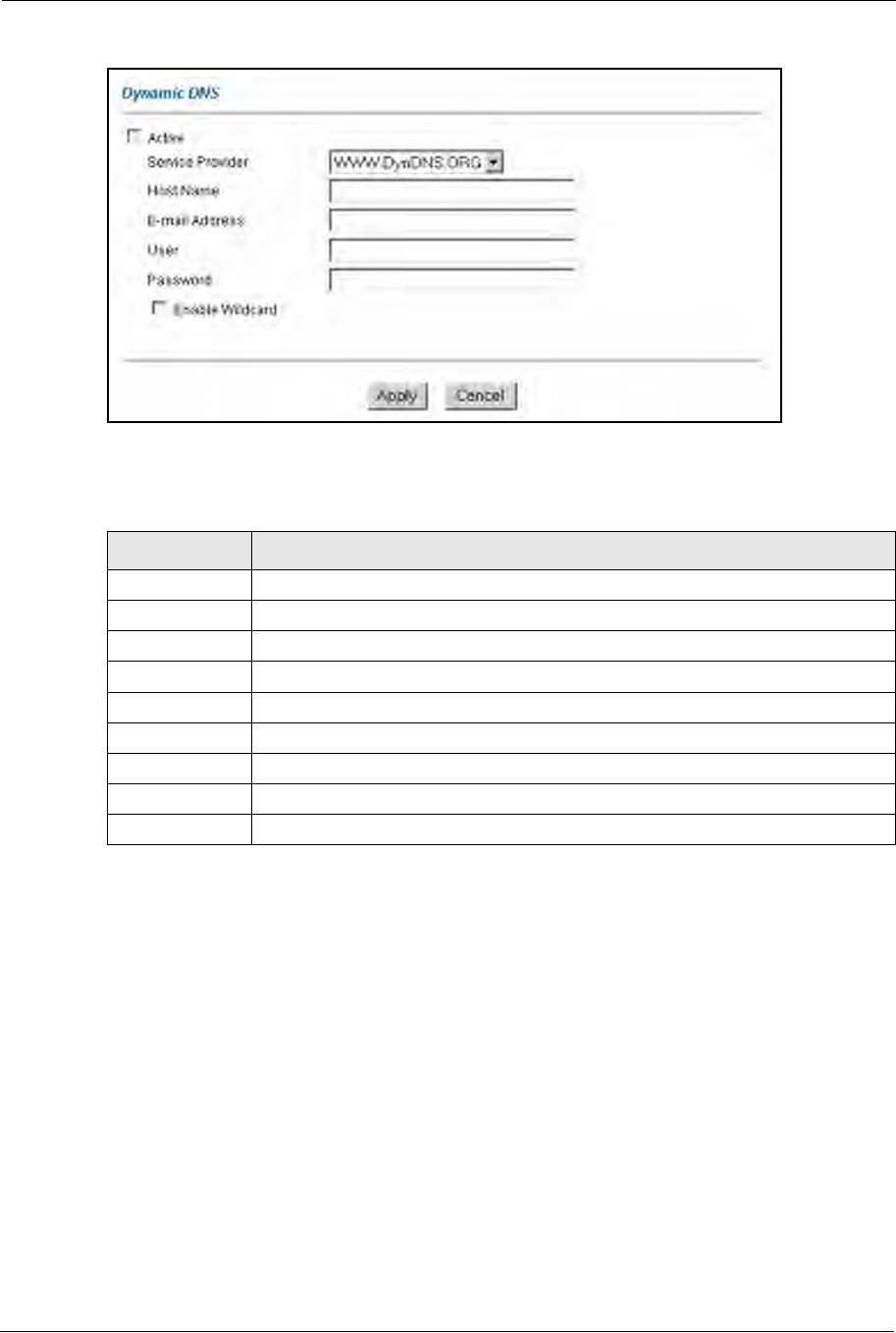
P-660H/HW/W-T Series User’ Guide
115 Chapter 8 Dynamic DNS Setup
Figure 44 Dynamic DNS
The following table describes the fields in this screen.
Table 31 Dynamic DNS
LABEL DESCRIPTION
Active Select this check box to use dynamic DNS.
Service Provider This is the name of your Dynamic DNS service provider.
Host Names Type the domain name assigned to your Prestige by your Dynamic DNS provider.
E-mail Address Type your e-mail address.
User Type your user name.
Password Type the password assigned to you.
Enable Wildcard Select the check box to enable DYNDNS Wildcard.
Apply Click Apply to save your changes back to the Prestige.
Cancel Click Cancel to begin configuring this screen afresh.
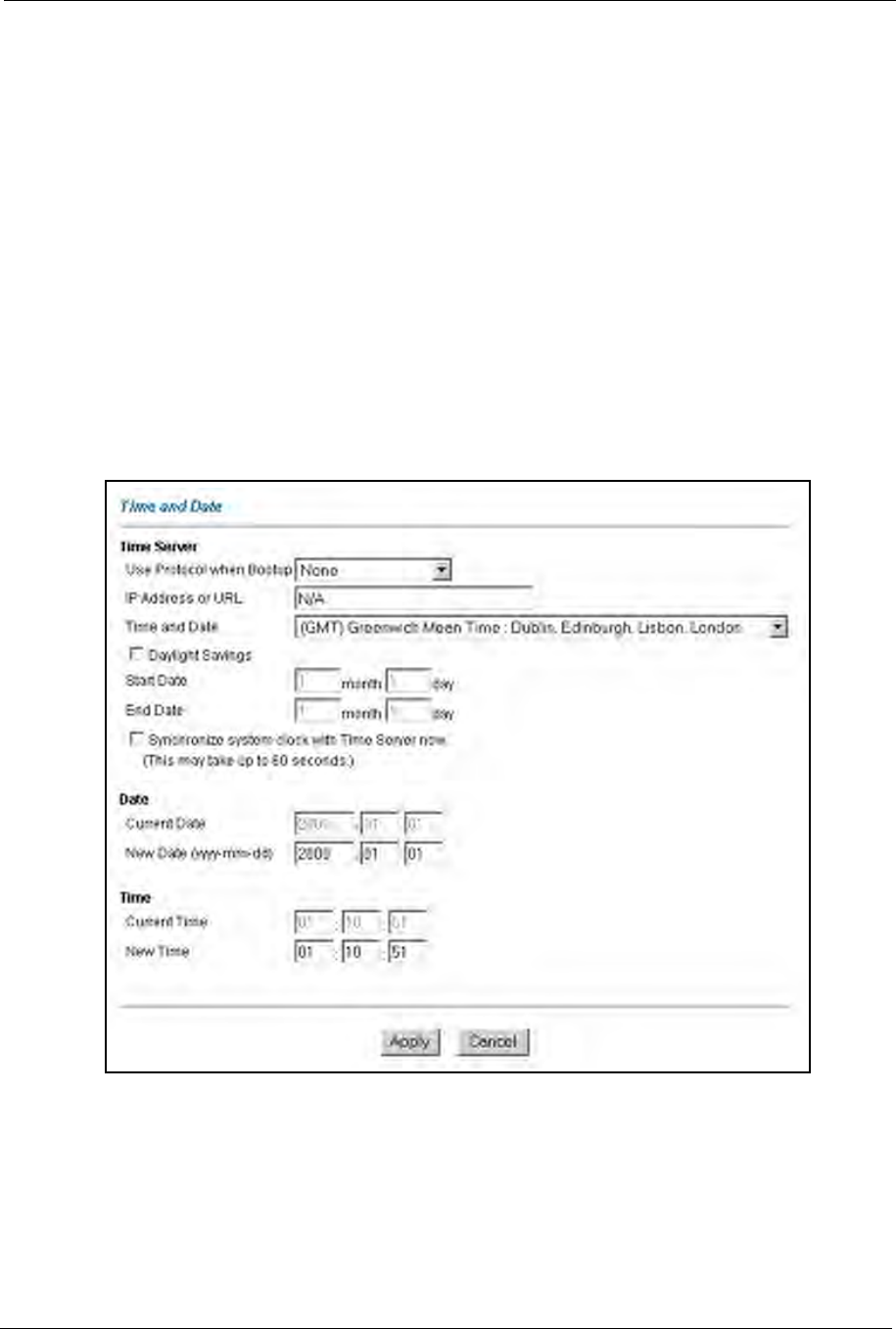
P-660H/HW/W-T Series User’ Guide
Chapter 9 Time and Date 116
CHAPTER 9
Time and Date
This screen is not available on all models. Use this screen to configure the Prestige’s time and
date settings.
9.1 Configuring Time and Date
To change your Prestige’s time and date, click Time And Date. The screen appears as shown.
Use this screen to configure the Prestige’s time based on your local time zone.
Figure 45 Time and Date
The following table describes the fields in this screen.

P-660H/HW/W-T Series User’ Guide
117 Chapter 9 Time and Date
Table 32 Time and Date
LABEL DESCRIPTION
Time Server
Use Protocol when
Bootup
Select the time service protocol that your time server sends when you turn on the
Prestige. Not all time servers support all protocols, so you may have to check with
your ISP/network administrator or use trial and error to find a protocol that works.
The main difference between them is the format.
Daytime (RFC 867) format is day/month/year/time zone of the server.
Time (RFC 868) format displays a 4-byte integer giving the total number of
seconds since 1970/1/1 at 0:0:0.
NTP (RFC 1305) is similar to Time (RFC 868).
Select None to enter the time and date manually.
IP Address or URL Enter the IP address or URL of your time server. Check with your ISP/network
administrator if you are unsure of this information.
Time and Date Choose the time zone of your location. This will set the time difference between
your time zone and Greenwich Mean Time (GMT).
Daylight Savings Select this option if you use daylight savings time. Daylight saving is a period from
late spring to early fall when many countries set their clocks ahead of normal local
time by one hour to give more daytime light in the evening.
Start Date Enter the month and day that your daylight-savings time starts on if you selected
Daylight Savings.
End Date Enter the month and day that your daylight-savings time ends on if you selected
Daylight Savings.
Synchronize
system clock with
Time Server now.
Select this option to have your Prestige use the time server (that you configured
above) to set its internal system clock.
Please wait for up to 60 seconds while the Prestige locates the time server. If the
Prestige cannot find the time server, please check the time server protocol and its
IP address. If the IP address was entered correctly, try pinging it for example to
test the connection.
Date
Current Date This field displays the date of your Prestige.
Each time you reload this page, the Prestige synchronizes the time with the time
server.
New Date (yyyy-
mm-dd)
This field displays the last updated date from the time server.
When you select None in the Use Protocol when Bootup field, enter the new
date in this field and then click Apply.
Time
Current Time This field displays the time of your Prestige.
Each time you reload this page, the Prestige synchronizes the time with the time
server.
New Time This field displays the last updated time from the time server.
When you select None in the Use Protocol when Bootup field, enter the new
time in this field and then click Apply.
Apply Click Apply to save your changes back to the Prestige.
Cancel Click Cancel to begin configuring this screen afresh.

P-660H/HW/W-T Series User’ Guide
Chapter 10 Firewalls 118
CHAPTER 10
Firewalls
This chapter gives some background information on firewalls and introduces the Prestige
firewall.
10.1 Firewall Overview
Originally, the term firewall referred to a construction technique designed to prevent the
spread of fire from one room to another. The networking term “firewall” is a system or group
of systems that enforces an access-control policy between two networks. It may also be
defined as a mechanism used to protect a trusted network from an untrusted network. Of
course, firewalls cannot solve every security problem. A firewall is one of the mechanisms
used to establish a network security perimeter in support of a network security policy. It
should never be the only mechanism or method employed. For a firewall to guard effectively,
you must design and deploy it appropriately. This requires integrating the firewall into a broad
information-security policy. In addition, specific policies must be implemented within the
firewall itself.
Refer to Section 11.5 on page 135 to configure default firewall settings.
Refer to Section 11.6 on page 136 to view firewall rules.
Refer to Section 11.6.1 on page 138 to configure firewall rules.
Refer to Section 11.7 on page 141 to configure a custom service.
Refer to Section 11.12.3 on page 151 to configure firewall thresholds.
10.2 Types of Firewalls
There are three main types of firewalls:
• Packet Filtering Firewalls
• Application-level Firewalls
• Stateful Inspection Firewalls
10.2.1 Packet Filtering Firewalls
Packet filtering firewalls restrict access based on the source/destination computer network
address of a packet and the type of application.

P-660H/HW/W-T Series User’ Guide
119 Chapter 10 Firewalls
10.2.2 Application-level Firewalls
Application-level firewalls restrict access by serving as proxies for external servers. Since they
use programs written for specific Internet services, such as HTTP, FTP and telnet, they can
evaluate network packets for valid application-specific data. Application-level gateways have
a number of general advantages over the default mode of permitting application traffic directly
to internal hosts:
Information hiding prevents the names of internal systems from being made known via DNS
to outside systems, since the application gateway is the only host whose name must be made
known to outside systems.
Robust authentication and logging pre-authenticates application traffic before it reaches
internal hosts and causes it to be logged more effectively than if it were logged with standard
host logging. Filtering rules at the packet filtering router can be less complex than they would
be if the router needed to filter application traffic and direct it to a number of specific systems.
The router need only allow application traffic destined for the application gateway and reject
the rest.
10.2.3 Stateful Inspection Firewalls
Stateful inspection firewalls restrict access by screening data packets against defined access
rules. They make access control decisions based on IP address and protocol. They also
"inspect" the session data to assure the integrity of the connection and to adapt to dynamic
protocols. These firewalls generally provide the best speed and transparency, however, they
may lack the granular application level access control or caching that some proxies support.
See Section 10.5 on page 124 for more information on stateful inspection.
Firewalls, of one type or another, have become an integral part of standard security solutions
for enterprises.
10.3 Introduction to ZyXEL’s Firewall
The Prestige firewall is a stateful inspection firewall and is designed to protect against Denial
of Service attacks when activated (in SMT menu 21.2 or in the web configurator). The
Prestige’s purpose is to allow a private Local Area Network (LAN) to be securely connected
to the Internet. The Prestige can be used to prevent theft, destruction and modification of data,
as well as log events, which may be important to the security of your network. The Prestige
also has packet filtering capabilities.
The Prestige is installed between the LAN and the Internet. This allows it to act as a secure
gateway for all data passing between the Internet and the LAN.
The Prestige has one DSL/ISDN port and one Ethernet LAN port, which physically separate
the network into two areas.
• The DSL/ISDN port connects to the Internet.
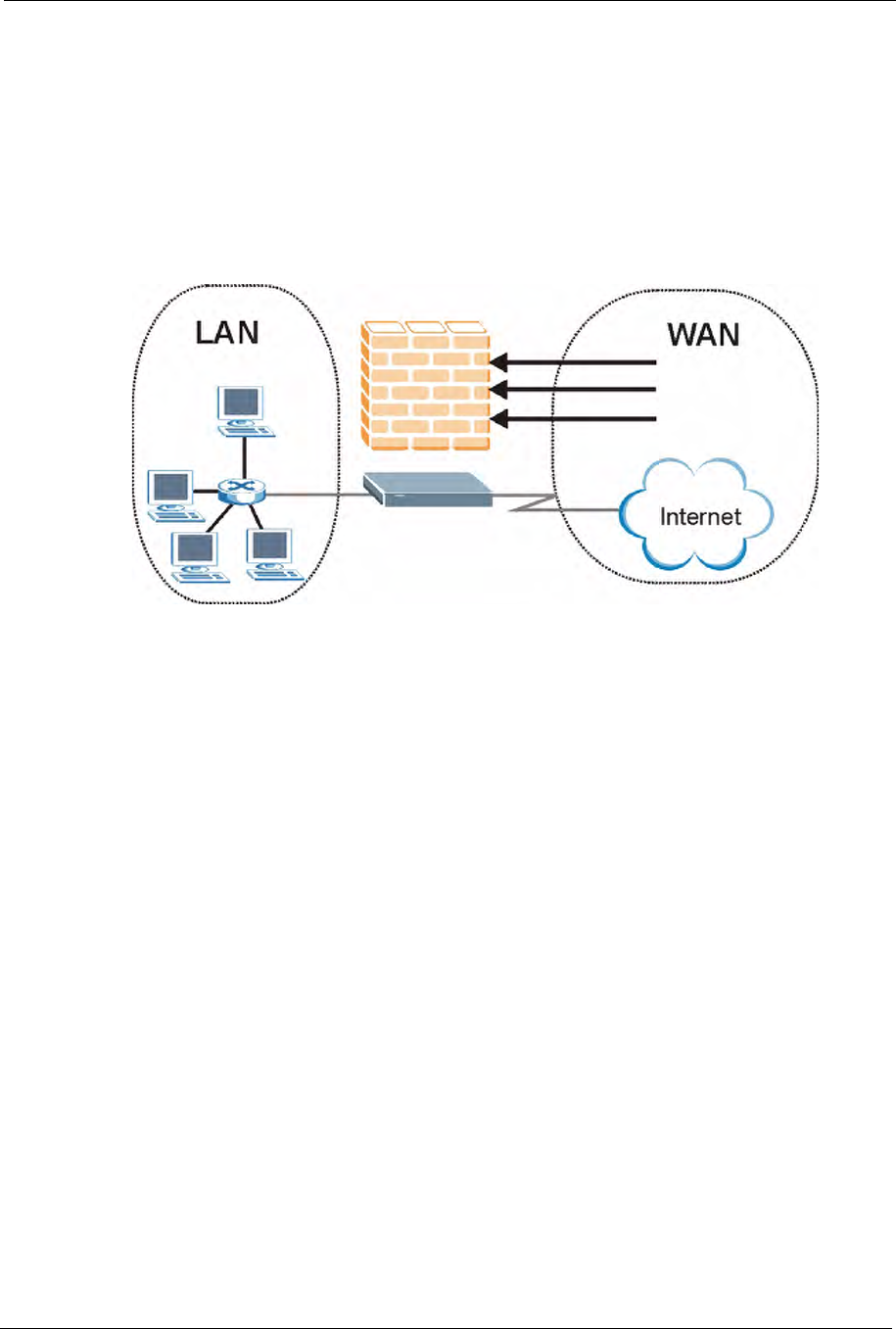
P-660H/HW/W-T Series User’ Guide
Chapter 10 Firewalls 120
• The LAN (Local Area Network) port attaches to a network of computers, which needs
security from the outside world. These computers will have access to Internet services
such as e-mail, FTP, and the World Wide Web. However, “inbound access” will not be
allowed unless you configure remote management or create a firewall rule to allow a
remote host to use a specific service.
10.3.1 Denial of Service Attacks
Figure 46 Prestige Firewall Application
10.4 Denial of Service
Denials of Service (DoS) attacks are aimed at devices and networks with a connection to the
Internet. Their goal is not to steal information, but to disable a device or network so users no
longer have access to network resources. The Prestige is pre-configured to automatically
detect and thwart all known DoS attacks.
10.4.1 Basics
Computers share information over the Internet using a common language called TCP/IP. TCP/
IP, in turn, is a set of application protocols that perform specific functions. An “extension
number”, called the "TCP port" or "UDP port" identifies these protocols, such as HTTP
(Web), FTP (File Transfer Protocol), POP3 (E-mail), etc. For example, Web traffic by default
uses TCP port 80.
When computers communicate on the Internet, they are using the client/server model, where
the server "listens" on a specific TCP/UDP port for information requests from remote client
computers on the network. For example, a Web server typically listens on port 80. Please note
that while a computer may be intended for use over a single port, such as Web on port 80,
other ports are also active. If the person configuring or managing the computer is not careful, a
hacker could attack it over an unprotected port.
Some of the most common IP ports are:

P-660H/HW/W-T Series User’ Guide
121 Chapter 10 Firewalls
10.4.2 Types of DoS Attacks
There are four types of DoS attacks:
1Those that exploit bugs in a TCP/IP implementation.
2Those that exploit weaknesses in the TCP/IP specification.
3Brute-force attacks that flood a network with useless data.
4IP Spoofing.
5"Ping of Death" and "Teardro p " attacks exploit bugs in the TCP/IP implementations of
various computer and host systems.
• Ping of Death uses a "ping" utility to create an IP packet that exceeds the maximum
65,536 bytes of data allowed by the IP specification. The oversize packet is then sent to
an unsuspecting system. Systems may crash, hang or reboot.
• Teardrop attack exploits weaknesses in the re-assembly of IP packet fragments. As data is
transmitted through a network, IP packets are often broken up into smaller chunks. Each
fragment looks like the original IP packet except that it contains an offset field that says,
for instance, "This fragment is carrying bytes 200 through 400 of the original (non
fragmented) IP packet." The Teardrop program creates a series of IP fragments with
overlapping offset fields. When these fragments are reassembled at the destination, some
systems will crash, hang, or reboot.
6Weaknesses in the TCP/IP specification leave it open to "SYN Flood" and "LAND"
attacks. These attacks are executed during the handshake that initiates a communication
session between two applications.
Table 33 Common IP Ports
21 FTP 53 DNS
23 Telnet 80 HTTP
25 SMTP 110 POP3
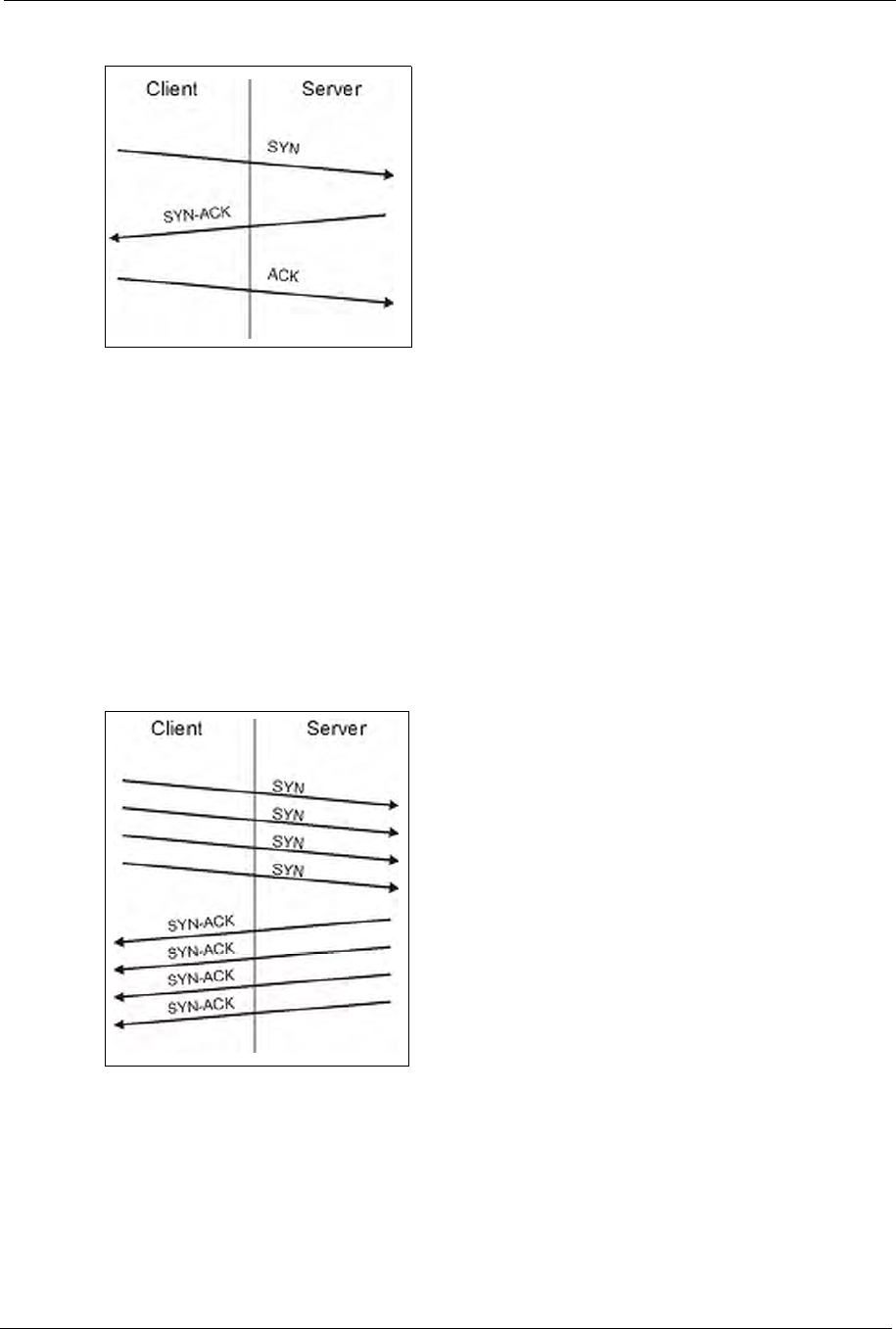
P-660H/HW/W-T Series User’ Guide
Chapter 10 Firewalls 122
Figure 47 Three-Way Handshake
Under normal circumstances, the application that initiates a session sends a SYN
(synchronize) packet to the receiving server. The receiver sends back an ACK
(acknowledgment) packet and its own SYN, and then the initiator responds with an ACK
(acknowledgment). After this handshake, a connection is established.
•SYN Attack floods a targeted system with a series of SYN packets. Each packet causes
the targeted system to issue a SYN-ACK response. While the targeted system waits for
the ACK that follows the SYN-ACK, it queues up all outstanding SYN-ACK responses
on what is known as a backlog queue. SYN-ACKs are moved off the queue only when an
ACK comes back or when an internal timer (which is set at relatively long intervals)
terminates the three-way handshake. Once the queue is full, the system will ignore all
incoming SYN requests, making the system unavailable for legitimate users.
Figure 48 SYN Flood
•In a LAND Attack, hackers flood SYN packets into the network with a spoofed source
IP address of the targeted system. This makes it appear as if the host computer sent the
packets to itself, making the system unavailable while the target system tries to respond
to itself.
7Abrute-force attack, such as a "Smurf" attack, targets a feature in the IP specification
known as directed or subnet broadcasting, to quickly flood the target network with
useless data. A Smurf hacker floods a router with Internet Control Message Protocol
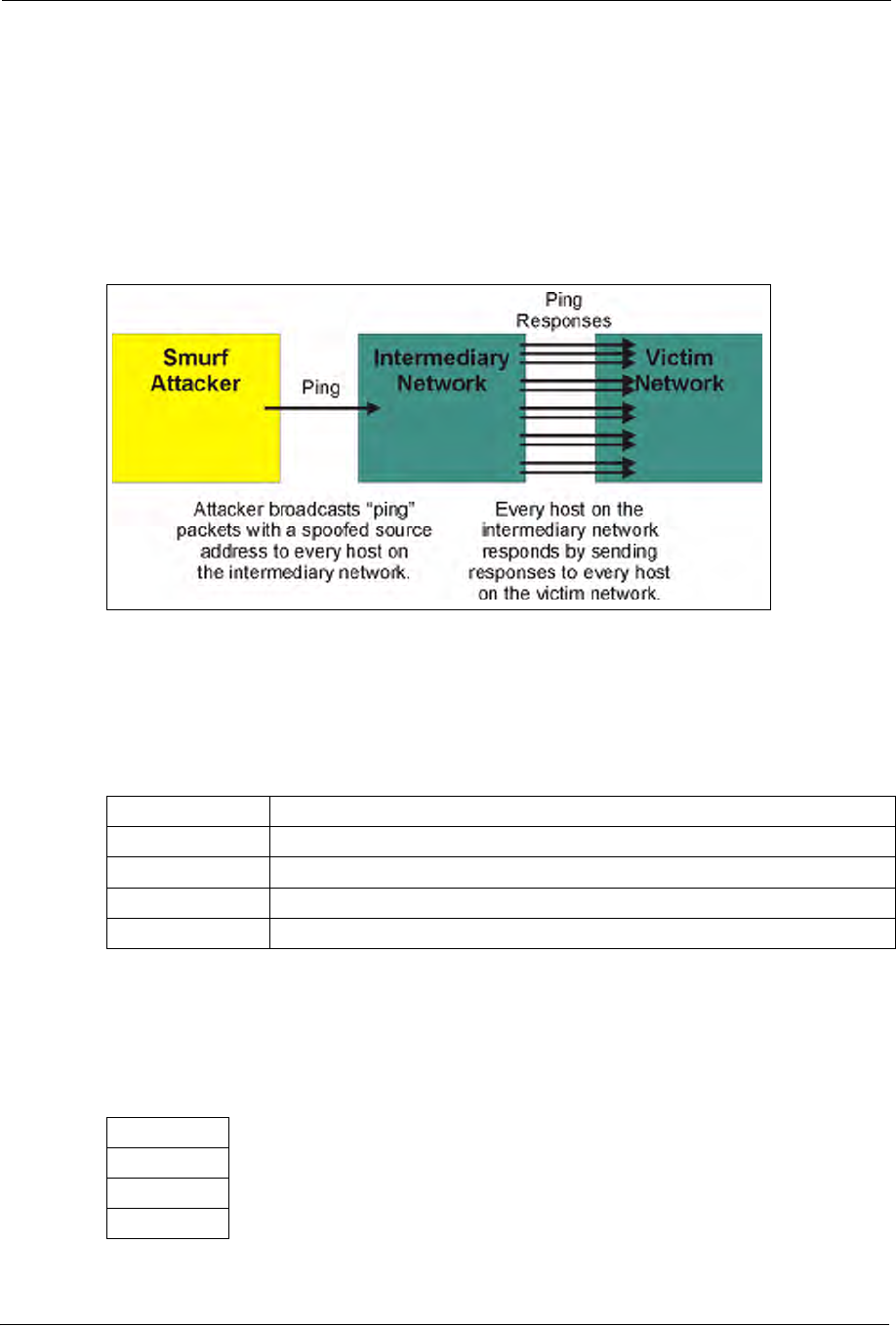
P-660H/HW/W-T Series User’ Guide
123 Chapter 10 Firewalls
(ICMP) echo request packets (pings). Since the destination IP address of each packet is
the broadcast address of the network, the router will broadcast the ICMP echo request
packet to all hosts on the network. If there are numerous hosts, this will create a large
amount of ICMP echo request and response traffic. If a hacker chooses to spoof the
source IP address of the ICMP echo request packet, the resulting ICMP traffic will not
only clog up the "intermediary" network, but will also congest the network of the spoofed
source IP address, known as the "victim" network. This flood of broadcast traffic
consumes all available bandwidth, making communications impossible.
Figure 49 Smurf Attack
10.4.2.1 ICMP Vulnerability
ICMP is an error-reporting protocol that works in concert with IP. The following ICMP types
trigger an alert:
10.4.2.2 Illegal Commands (NetBIOS and SMTP)
The only legal NetBIOS commands are the following - all others are illegal.
Table 34 ICMP Commands That Trigger Alerts
5REDIRECT
13 TIMESTAMP_REQUEST
14 TIMESTAMP_REPLY
17 ADDRESS_MASK_REQUEST
18 ADDRESS_MASK_REPLY
Table 35 Legal NetBIOS Commands
MESSAGE:
REQUEST:
POSITIVE:
VE:

P-660H/HW/W-T Series User’ Guide
Chapter 10 Firewalls 124
All SMTP commands are illegal except for those displayed in the following tables.
10.4.2.3 Traceroute
Traceroute is a utility used to determine the path a packet takes between two endpoints.
Sometimes when a packet filter firewall is configured incorrectly an attacker can traceroute
the firewall gaining knowledge of the network topology inside the firewall.
Often, many DoS attacks also employ a technique known as "IP Spoofing" as part of their
attack. IP Spoofing may be used to break into systems, to hide the hacker's identity, or to
magnify the effect of the DoS attack. IP Spoofing is a technique used to gain unauthorized
access to computers by tricking a router or firewall into thinking that the communications are
coming from within the trusted network. To engage in IP spoofing, a hacker must modify the
packet headers so that it appears that the packets originate from a trusted host and should be
allowed through the router or firewall. The Prestige blocks all IP Spoofing attempts.
10.5 Stateful Inspection
With stateful inspection, fields of the packets are compared to packets that are already known
to be trusted. For example, if you access some outside service, the proxy server remembers
things about your original request, like the port number and source and destination addresses.
This “remembering” is called saving the state. When the outside system responds to your
request, the firewall compares the received packets with the saved state to determine if they
are allowed in. The Prestige uses stateful packet inspection to protect the private LAN from
hackers and vandals on the Internet. By default, the Prestige’s stateful inspection allows all
communications to the Internet that originate from the LAN, and blocks all traffic to the LAN
that originates from the Internet. In summary, stateful inspection:
• Allows all sessions originating from the LAN (local network) to the WAN (Internet).
• Denies all sessions originating from the WAN to the LAN.
RETARGET:
KEEPALIVE:
Table 36 Legal SMTP Commands
AUTH DATA EHLO ETRN EXPN HELO HELP MAIL NOOP
QUIT RCPT RSET SAML SEND SOML TURN VRFY
Table 35 Legal NetBIOS Commands
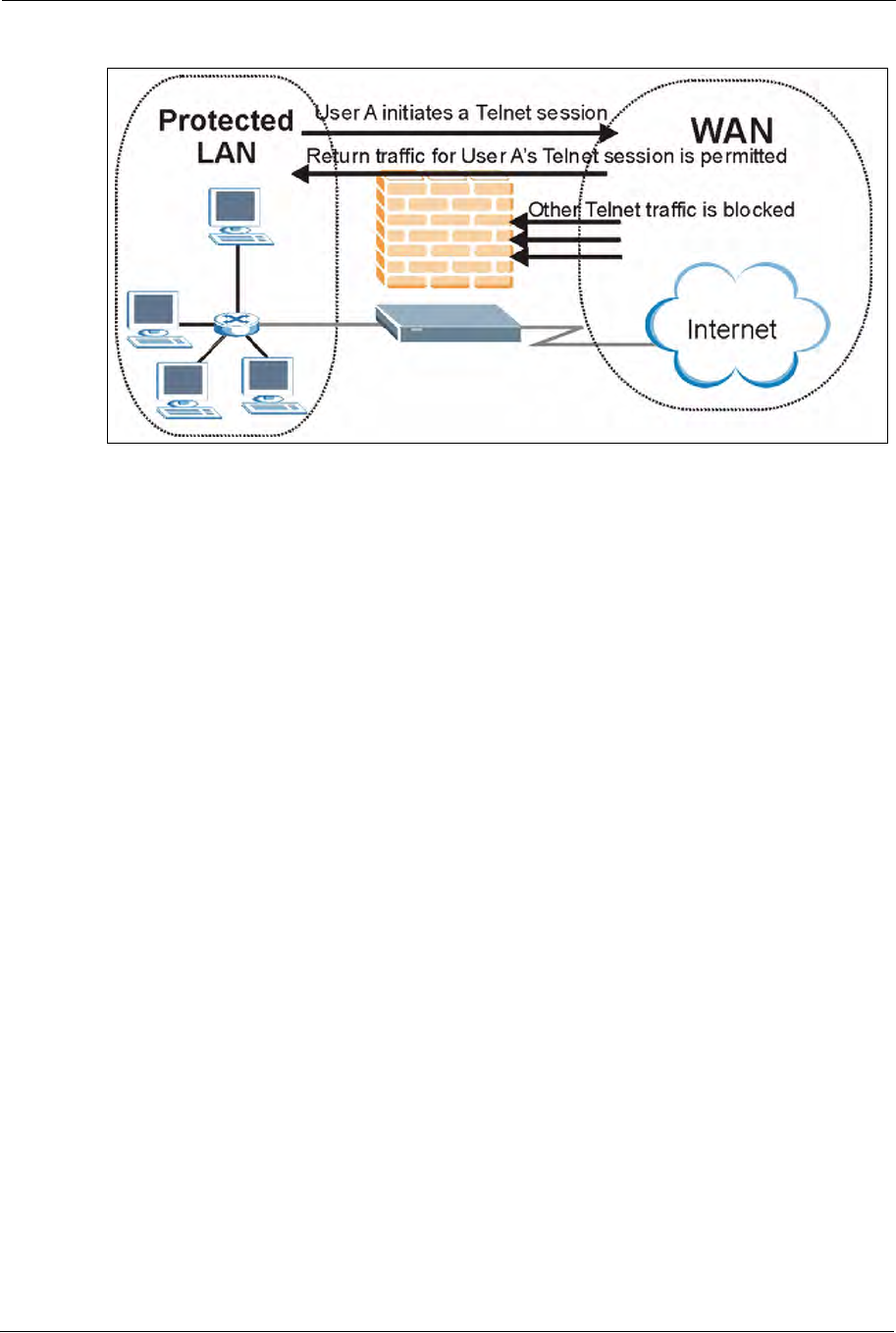
P-660H/HW/W-T Series User’ Guide
125 Chapter 10 Firewalls
Figure 50 Stateful Inspection
The previous figure shows the Prestige’s default firewall rules in action as well as
demonstrates how stateful inspection works. User A can initiate a Telnet session from within
the LAN and responses to this request are allowed. However other Telnet traffic initiated from
the WAN is blocked.
10.5.1 Stateful Inspection Process
In this example, the following sequence of events occurs when a TCP packet leaves the LAN
network through the firewall's WAN interface. The TCP packet is the first in a session, and the
packet's application layer protocol is configured for a firewall rule inspection:
1The packet travels from the firewall's LAN to the WAN.
2The packet is evaluated against the interface's existing outbound access list, and the
packet is permitted (a denied packet would simply be dropped at this point).
3The packet is inspected by a firewall rule to determine and record information about the
state of the packet's connection. This information is recorded in a new state table entry
created for the new connection. If there is not a firewall rule for this packet and it is not an
attack, then the settings in the Default Policy screen determine the action for this packet.
4Based on the obtained state information, a firewall rule creates a temporary access list
entry that is inserted at the beginning of the WAN interface's inbound extended access
list. This temporary access list entry is designed to permit inbound packets of the same
connection as the outbound packet just inspected.
5The outbound packet is forwarded out through the interface.
6Later, an inbound packet reaches the interface. This packet is part of the connection
previously established with the outbound packet. The inbound packet is evaluated against
the inbound access list, and is permitted because of the temporary access list entry
previously created.
7The packet is inspected by a firewall rule, and the connection's state table entry is updated
as necessary. Based on the updated state information, the inbound extended access list

P-660H/HW/W-T Series User’ Guide
Chapter 10 Firewalls 126
temporary entries might be modified, in order to permit only packets that are valid for the
current state of the connection.
8Any additional inbound or outbound packets that belong to the connection are inspected
to update the state table entry and to modify the temporary inbound access list entries as
required, and are forwarded through the interface.
9When the connection terminates or times out, the connection's state table entry is deleted
and the connection's temporary inbound access list entries are deleted.
10.5.2 Stateful Inspection and the Prestige
Additional rules may be defined to extend or override the default rules. For example, a rule
may be created which will:
• Block all traffic of a certain type, such as IRC (Internet Relay Chat), from the LAN to the
Internet.
• Allow certain types of traffic from the Internet to specific hosts on the LAN.
• Allow access to a Web server to everyone but competitors.
• Restrict use of certain protocols, such as Telnet, to authorized users on the LAN.
These custom rules work by evaluating the network traffic’s Source IP address, Destination IP
address, IP protocol type, and comparing these to rules set by the administrator.
Note: The ability to define firewall rules is a very powerful tool. Using custom rules, it
is possible to disable all firewall protection or block all access to the Internet.
Use extreme caution when creating or deleting firewall rules. Test changes
after creating them to make sure they work correctly.
Below is a brief technical description of how these connections are tracked. Connections may
either be defined by the upper protocols (for instance, TCP), or by the Prestige itself (as with
the "virtual connections" created for UDP and ICMP).
10.5.3 TCP Security
The Prestige uses state information embedded in TCP packets. The first packet of any new
connection has its SYN flag set and its ACK flag cleared; these are "initiation" packets. All
packets that do not have this flag structure are called "subsequent" packets, since they
represent data that occurs later in the TCP stream.
If an initiation packet originates on the WAN, this means that someone is trying to make a
connection from the Internet into the LAN. Except in a few special cases (see "Upper Layer
Protocols" shown next), these packets are dropped and logged.
If an initiation packet originates on the LAN, this means that someone is trying to make a
connection from the LAN to the Internet. Assuming that this is an acceptable part of the
security policy (as is the case with the default policy), the connection will be allowed. A cache
entry is added which includes connection information such as IP addresses, TCP ports,
sequence numbers, etc.

P-660H/HW/W-T Series User’ Guide
127 Chapter 10 Firewalls
When the Prestige receives any subsequent packet (from the Internet or from the LAN), its
connection information is extracted and checked against the cache. A packet is only allowed to
pass through if it corresponds to a valid connection (that is, if it is a response to a connection
which originated on the LAN).
10.5.4 UDP/ICMP Security
UDP and ICMP do not themselves contain any connection information (such as sequence
numbers). However, at the very minimum, they contain an IP address pair (source and
destination). UDP also contains port pairs, and ICMP has type and code information. All of
this data can be analyzed in order to build "virtual connections" in the cache.
For instance, any UDP packet that originates on the LAN will create a cache entry. Its IP
address and port pairs will be stored. For a short period of time, UDP packets from the WAN
that have matching IP and UDP information will be allowed back in through the firewall.
A similar situation exists for ICMP, except that the Prestige is even more restrictive.
Specifically, only outgoing echoes will allow incoming echo replies, outgoing address mask
requests will allow incoming address mask replies, and outgoing timestamp requests will
allow incoming timestamp replies. No other ICMP packets are allowed in through the firewall,
simply because they are too dangerous and contain too little tracking information. For
instance, ICMP redirect packets are never allowed in, since they could be used to reroute
traffic through attacking machines.
10.5.5 Upper Layer Protocols
Some higher layer protocols (such as FTP and RealAudio) utilize multiple network
connections simultaneously. In general terms, they usually have a "control connection" which
is used for sending commands between endpoints, and then "data connections" which are used
for transmitting bulk information.
Consider the FTP protocol. A user on the LAN opens a control connection to a server on the
Internet and requests a file. At this point, the remote server will open a data connection from
the Internet. For FTP to work properly, this connection must be allowed to pass through even
though a connection from the Internet would normally be rejected.
In order to achieve this, the Prestige inspects the application-level FTP data. Specifically, it
searches for outgoing "PORT" commands, and when it sees these, it adds a cache entry for the
anticipated data connection. This can be done safely, since the PORT command contains
address and port information, which can be used to uniquely identify the connection.
Any protocol that operates in this way must be supported on a case-by-case basis. You can use
the web configurator’s Custom Ports feature to do this.
10.6 Guidelines for Enhancing Security with Your Firewall
• Change the default password via SMT or web configurator.

P-660H/HW/W-T Series User’ Guide
Chapter 10 Firewalls 128
• Limit who can telnet into your router.
• Don't enable any local service (such as SNMP or NTP) that you don't use. Any enabled
service could present a potential security risk. A determined hacker might be able to find
creative ways to misuse the enabled services to access the firewall or the network.
• For local services that are enabled, protect against misuse. Protect by configuring the
services to communicate only with specific peers, and protect by configuring rules to
block packets for the services at specific interfaces.
• Protect against IP spoofing by making sure the firewall is active.
• Keep the firewall in a secured (locked) room.
10.6.1 Security In General
You can never be too careful! Factors outside your firewall, filtering or NAT can cause
security breaches. Below are some generalizations about what you can do to minimize them.
• Encourage your company or organization to develop a comprehensive security plan.
Good network administration takes into account what hackers can do and prepares
against attacks. The best defense against hackers and crackers is information. Educate all
employees about the importance of security and how to minimize risk. Produce lists like
this one!
• DSL or cable modem connections are “always-on” connections and are particularly
vulnerable because they provide more opportunities for hackers to crack your system.
Turn your computer off when not in use.
• Never give out a password or any sensitive information to an unsolicited telephone call or
e-mail.
• Never e-mail sensitive information such as passwords, credit card information, etc.,
without encrypting the information first.
• Never submit sensitive information via a web page unless the web site uses secure
connections. You can identify a secure connection by looking for a small “key” icon on
the bottom of your browser (Internet Explorer 3.02 or better or Netscape 3.0 or better). If
a web site uses a secure connection, it is safe to submit information. Secure web
transactions are quite difficult to crack.
• Never reveal your IP address or other system networking information to people outside
your company. Be careful of files e-mailed to you from strangers. One common way of
getting BackOrifice on a system is to include it as a Trojan horse with other files.
• Change your passwords regularly. Also, use passwords that are not easy to figure out.
The most difficult passwords to crack are those with upper and lower case letters,
numbers and a symbol such as % or #.
• Upgrade your software regularly. Many older versions of software, especially web
browsers, have well known security deficiencies. When you upgrade to the latest
versions, you get the latest patches and fixes.
• If you use “chat rooms” or IRC sessions, be careful with any information you reveal to
strangers.
• If your system starts exhibiting odd behavior, contact your ISP. Some hackers will set off
hacks that cause your system to slowly become unstable or unusable.

P-660H/HW/W-T Series User’ Guide
129 Chapter 10 Firewalls
• Always shred confidential information, particularly about your computer, before
throwing it away. Some hackers dig through the trash of companies or individuals for
information that might help them in an attack.
10.7 Packet Filtering Vs Firewall
Below are some comparisons between the Prestige’s filtering and firewall functions.
10.7.1 Packet Filtering:
• The router filters packets as they pass through the router’s interface according to the filter
rules you designed.
• Packet filtering is a powerful tool, yet can be complex to configure and maintain,
especially if you need a chain of rules to filter a service.
• Packet filtering only checks the header portion of an IP packet.
10.7.1.1 When To Use Filtering
• To block/allow LAN packets by their MAC addresses.
• To block/allow special IP packets which are neither TCP nor UDP, nor ICMP packets.
• To block/allow both inbound (WAN to LAN) and outbound (LAN to WAN) traffic
between the specific inside host/network "A" and outside host/network "B". If the filter
blocks the traffic from A to B, it also blocks the traffic from B to A. Filters can not
distinguish traffic originating from an inside host or an outside host by IP address.
• To block/allow IP trace route.
10.7.2 Firewall
• The firewall inspects packet contents as well as their source and destination addresses.
Firewalls of this type employ an inspection module, applicable to all protocols, that
understands data in the packet is intended for other layers, from the network layer (IP
headers) up to the application layer.
• The firewall performs stateful inspection. It takes into account the state of connections it
handles so that, for example, a legitimate incoming packet can be matched with the
outbound request for that packet and allowed in. Conversely, an incoming packet
masquerading as a response to a nonexistent outbound request can be blocked.
• The firewall uses session filtering, i.e., smart rules, that enhance the filtering process and
control the network session rather than control individual packets in a session.
• The firewall provides e-mail service to notify you of routine reports and when alerts
occur.
10.7.2.1 When To Use The Firewall
• To prevent DoS attacks and prevent hackers cracking your network.

P-660H/HW/W-T Series User’ Guide
Chapter 10 Firewalls 130
• A range of source and destination IP addresses as well as port numbers can be specified
within one firewall rule making the firewall a better choice when complex rules are
required.
• To selectively block/allow inbound or outbound traffic between inside host/networks and
outside host/networks. Remember that filters can not distinguish traffic originating from
an inside host or an outside host by IP address.
• The firewall performs better than filtering if you need to check many rules.
• Use the firewall if you need routine e-mail reports about your system or need to be alerted
when attacks occur.
• The firewall can block specific URL traffic that might occur in the future. The URL can
be saved in an Access Control List (ACL) database.

P-660H/HW/W-T Series User’ Guide
131 Chapter 10 Firewalls

P-660H/HW/W-T Series User’ Guide
Chapter 11 Firewall Configuration 132
CHAPTER 11
Firewall Configuration
This chapter shows you how to enable and configure the Prestige firewall.
11.1 Access Methods
The web configurator is, by far, the most comprehensive firewall configuration tool your
Prestige has to offer. For this reason, it is recommended that you configure your firewall using
the web configurator. SMT screens allow you to activate the firewall. CLI commands provide
limited configuration options and are only recommended for advanced users.
11.2 Firewall Policies Overview
Firewall rules are grouped based on the direction of travel of packets to which they apply:
Note: The LAN includes both the LAN port and the WLAN.
By default, the Prestige’s stateful packet inspection allows packets traveling in the following
directions:
• LAN to LAN/ Router
This allows computers on the LAN to manage the Prestige and communicate between
networks or subnets connected to the LAN interface.
• LAN to WAN
By default, the Prestige’s stateful packet inspection blocks packets traveling in the following
directions:
•WAN to LAN
•WAN to WAN/ Router
This prevents computers on the WAN from using the Prestige as a gateway to
communicate with other computers on the WAN and/or managing the Prestige.
You may define additional rules and sets or modify existing ones but please exercise
extreme caution in doing so.
• LAN to LAN/ Router • WAN to LAN
• LAN to WAN • WAN to WAN/ Router

P-660H/HW/W-T Series User’ Guide
133 Chapter 11 Firewall Configuration
Note: If you configure firewall rules without a good understanding of how they work,
you might inadvertently introduce security risks to the firewall and to the
protected network. Make sure you test your rules after you configure them.
For example, you may create rules to:
• Block certain types of traffic, such as IRC (Internet Relay Chat), from the LAN to the
Internet.
• Allow certain types of traffic, such as Lotus Notes database synchronization, from
specific hosts on the Internet to specific hosts on the LAN.
• Allow everyone except your competitors to access a Web server.
• Restrict use of certain protocols, such as Telnet, to authorized users on the LAN.
These custom rules work by comparing the Source IP address, Destination IP address and IP
protocol type of network traffic to rules set by the administrator. Your customized rules take
precedence and override the Prestige’s default rules.
11.3 Rule Logic Overview
Note: Study these points carefully before configuring rules.
11.3.1 Rule Checklist
State the intent of the rule. For example, “This restricts all IRC access from the LAN to the
Internet.” Or, “This allows a remote Lotus Notes server to synchronize over the Internet to an
inside Notes server.”
1Is the intent of the rule to forward or block traffic?
2What direction of traffic does the rule apply to?
3What IP services will be affected?
4What computers on the LAN are to be affected (if any)?
5What computers on the Internet will be affected? The more specific, the better. For
example, if traffic is being allowed from the Internet to the LAN, it is better to allow only
certain machines on the Internet to access the LAN.
11.3.2 Security Ramifications
1Once the logic of the rule has been defined, it is critical to consider the security
ramifications created by the rule:
2Does this rule stop LAN users from accessing critical resources on the Internet? For
example, if IRC is blocked, are there users that require this service?
3Is it possible to modify the rule to be more specific? For example, if IRC is blocked for all
users, will a rule that blocks just certain users be more effective?

P-660H/HW/W-T Series User’ Guide
Chapter 11 Firewall Configuration 134
4Does a rule that allows Internet users access to resources on the LAN create a security
vulnerability? For example, if FTP ports (TCP 20, 21) are allowed from the Internet to the
LAN, Internet users may be able to connect to computers with running FTP servers.
5Does this rule conflict with any existing rules?
6Once these questions have been answered, adding rules is simply a matter of plugging the
information into the correct fields in the web configurator screens.
11.3.3 Key Fields For Configuring Rules
11.3.3.1 Action
Should the action be to Block or Forward? “Block” means the firewall silently discards the
packet.
11.3.3.2 Service
Select the service from the Service scrolling list box. If the service is not listed, it is necessary
to first define it. See Section 11.10 on page 146 for more information on predefined services.
11.3.3.3 Source Address
What is the connection’s source address; is it on the LAN, WAN? Is it a single IP, a range of
IPs or a subnet?
11.3.3.4 Destination Address
What is the connection’s destination address; is it on the LAN, WAN? Is it a single IP, a range
of IPs or a subnet?
11.4 Connection Direction
This section describes examples for firewall rules for connections going from LAN to WAN
and from WAN to LAN.
LAN to LAN/ Router, WAN to WAN/ Router rules apply to packets coming in on the
associated interface (LAN, WAN respectively). LAN to LAN/ Router means policies for
LAN-to-Prestige (the policies for managing the Prestige through the LAN interface) and
policies for LAN-to-LAN (the policies that control routing between two subnets on the LAN).
Similarly, WAN to WAN/ Router polices apply in the same way to the WAN ports.
11.4.1 LAN to WAN Rules
The default rule for LAN to WAN traffic is that all users on the LAN are allowed non-
restricted access to the WAN. When you configure a LAN to WAN rule, you in essence want
to limit some or all users from accessing certain services on the WAN. WAN to LAN Rules
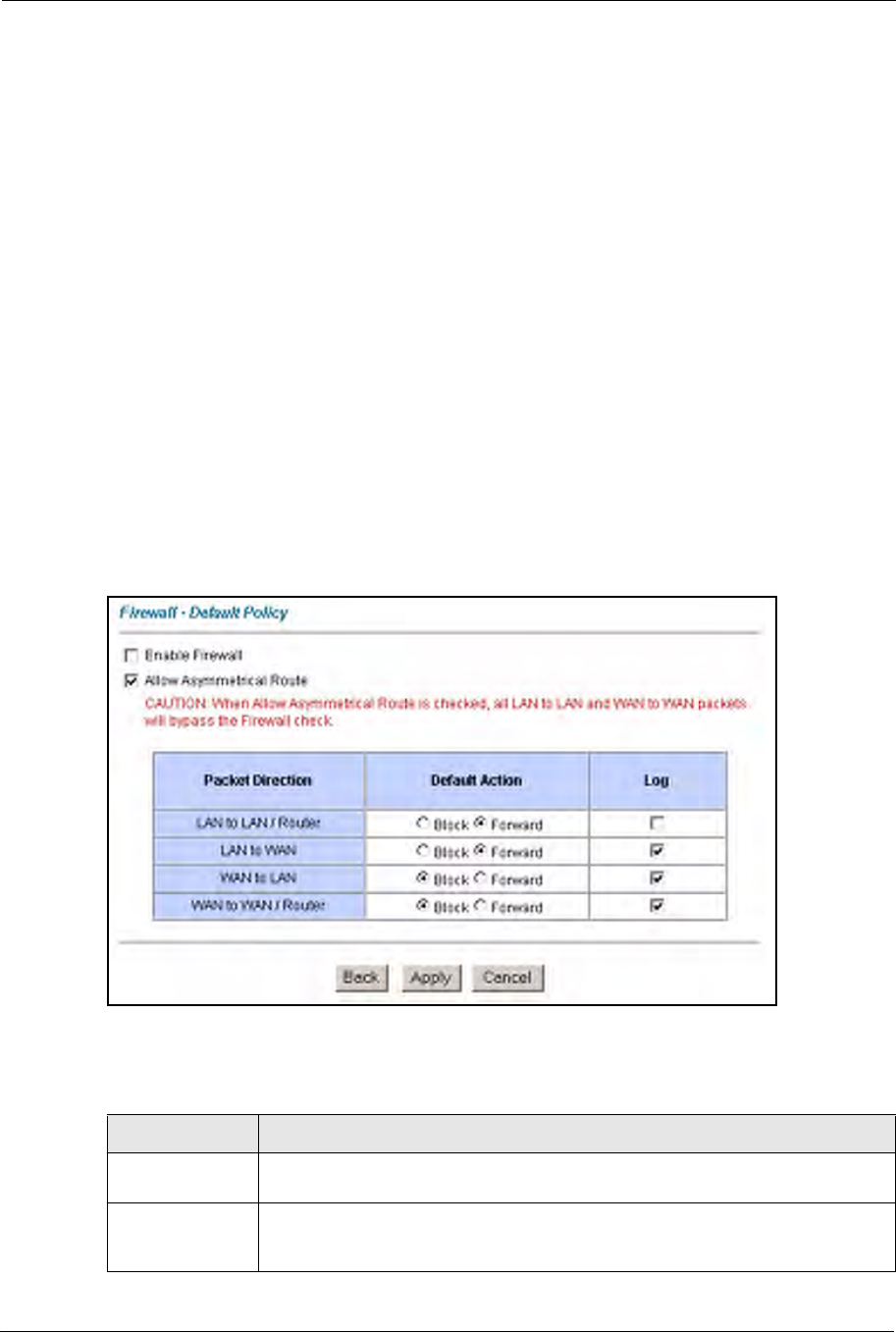
P-660H/HW/W-T Series User’ Guide
135 Chapter 11 Firewall Configuration
The default rule for WAN to LAN traffic blocks all incoming connections (WAN to LAN). If
you wish to allow certain WAN users to have access to your LAN, you will need to create
custom rules to allow it.
11.4.2 Alerts
Alerts are reports on events, such as attacks, that you may want to know about right away. You
can choose to generate an alert when an attack is detected in the Edit Rule screen (select the
Send Alert Message to Administrator When Matched check box) or when a rule is matched
in the Edit Rule screen. When an event generates an alert, a message can be immediately sent
to an e-mail account that you specify in the Log Settings screen (see the chapter on logs).
11.5 Configuring Default Firewall Policy
Click Firewall and then Default Policy to display the following screen. Activate the firewall
by selecting the Firewall Enabled check box as seen in the following screen.
Refer to Section 10.1 on page 118 for more information.
Figure 51 Firewall: Default Policy
The following table describes the labels in this screen.
Table 37 Firewall: Default Policy
LABEL DESCRIPTION
Firewall Enabled Select this check box to activate the firewall. The Prestige performs access control
and protects against Denial of Service (DoS) attacks when the firewall is activated.
Allow
Asymmetrical
Route
Select this check box to have the Prestige firewall permit the use of triangle route
topology on the network. See the appendix for more on triangle route topology.

P-660H/HW/W-T Series User’ Guide
Chapter 11 Firewall Configuration 136
11.6 Rule Summary
Note: The ordering of your rules is very important as rules are applied in turn.
Refer to Section 10.1 on page 118 for more information.
Click on Firewall, then Rule Summary to bring up the following screen. This screen is a
summary of the existing rules. Note the order in which the rules are listed.
Packet Direction This is the direction of travel of packets (LAN to LAN/Router, LAN to WAN,WAN
to WAN/Router,WAN to LAN).
Firewall rules are grouped based on the direction of travel of packets to which they
apply. For example, LAN to LAN/Router means packets traveling from a
computer/subnet on the LAN to either another computer/subnet on the LAN
interface of the Prestige or the Prestige itself.
Default Action Use the radio buttons to select whether to Block (silently discard) or Forward
(allow the passage of) packets that are traveling in the selected direction.
Log Select the check box to create a log (when the above action is taken) for packets
that are traveling in the selected direction and do not match any of the rules below.
Back Click Back to return to the previous screen.
Apply Click Apply to save your changes back to the Prestige.
Cancel Click Cancel to begin configuring this screen afresh.
Table 37 Firewall: Default Policy (continued)
LABEL DESCRIPTION
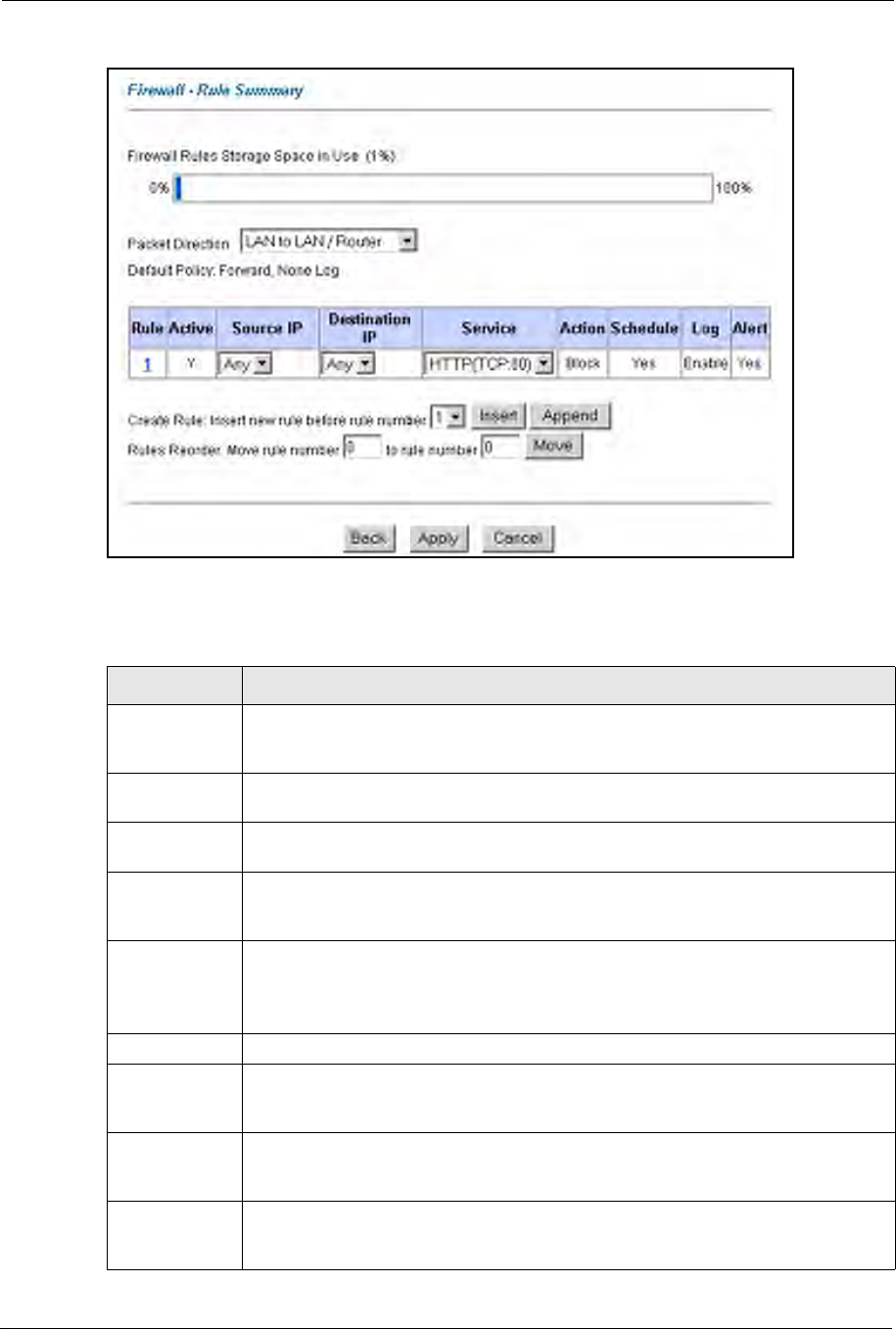
P-660H/HW/W-T Series User’ Guide
137 Chapter 11 Firewall Configuration
Figure 52 Firewall: Rule Summary
The following table describes the labels in this screen.
Table 38 Rule Summary
LABEL DESCRIPTION
Firewall Rules
Storage Space
in Use
This read-only bar shows how much of the Prestige's memory for recording firewall
rules it is currently using. When you are using 80% or less of the storage space, the
bar is green. When the amount of space used is over 80%, the bar is red.
Packet Direction Use the drop-down list box to select a direction of travel of packets for which you
want to configure firewall rules.
Default Policy This field displays the default action and log policy you selected in the Default Rule
screen for the packet direction shown in the field above.
The following read-only fields summarize the rules you have created that apply to
traffic traveling in the selected packet direction. The firewall rules that you configure
(summarized below) take priority over the general firewall action settings above.
Rule This is your firewall rule number. The ordering of your rules is important as rules are
applied in turn.
Click a rule’s number to go to the Firewall Edit Rule screen to configure or edit a
firewall rule.
Active This field displays whether a firewall is turned on (Y) or not (N).
Source IP This drop-down list box displays the source addresses or ranges of addresses to
which this firewall rule applies. Please note that a blank source or destination
address is equivalent to Any.
Destination IP This drop-down list box displays the destination addresses or ranges of addresses to
which this firewall rule applies. Please note that a blank source or destination
address is equivalent to Any.
Service This drop-down list box displays the services to which this firewall rule applies.
Please note that a blank service type is equivalent to Any. See Section 11.10 on
page 146 for more information.

P-660H/HW/W-T Series User’ Guide
Chapter 11 Firewall Configuration 138
11.6.1 Configuring Firewall Rules
Refer to Section 10.1 on page 118 for more information.
Follow these directions to create a new rule.
1In the Rule Summary screen, type the index number for where you want to put the rule.
For example, if you type “6”, your new rule becomes number 6 and the previous rule 6 (if
there is one) becomes rule 7.
2Click Insert to display this screen and refer to the following table for information on the
labels.
Action This is the specified action for that rule, either Block or Forward. Note that Block
means the firewall silently discards the packet.
Schedule This field tells you whether a schedule is specified (Yes) or not (No).
Log This field shows you whether a log is created when packets match this rule
(Enabled) or not (Disable).
Alert This field tells you whether this rule generates an alert (Yes) or not (No) when the
rule is matched.
Insert/Append Type the index number for where you want to put a rule. For example, if you type “6”,
your new rule becomes number 6 and the previous rule 6 (if there is one) becomes
rule 7.
Click Insert to add a new firewall rule before the specified index number.
Click Append to add a new firewall rule after the specified index number.
Move Type a rule’s index number and the number for where you want to put that rule. Click
Move to move the rule to the number that you typed. The ordering of your rules is
important as they are applied in order of their numbering.
Back Click Back to return to the previous screen.
Apply Click Apply to save your changes back to the Prestige.
Cancel Click Cancel to begin configuring this screen afresh.
Table 38 Rule Summary (continued)
LABEL DESCRIPTION
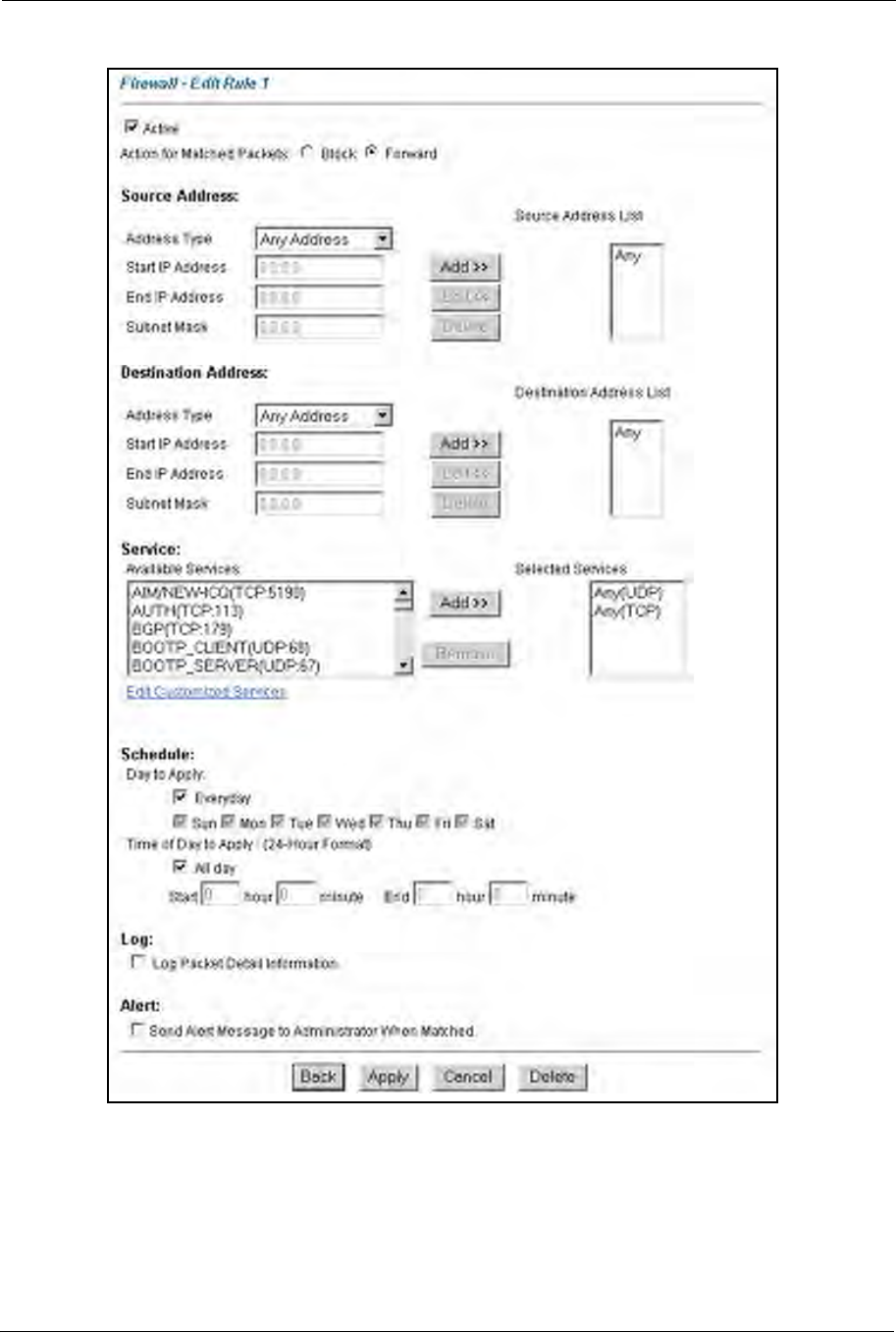
P-660H/HW/W-T Series User’ Guide
139 Chapter 11 Firewall Configuration
Figure 53 Firewall: Edit Rule
The following table describes the labels in this screen.

P-660H/HW/W-T Series User’ Guide
Chapter 11 Firewall Configuration 140
Table 39 Firewall: Edit Rule
LABEL DESCRIPTION
Active Select this option to enable this firewall rule.
Action for Matched
Packet
Use the radio button to select whether to discard (Block) or allow the passage of
(Forward) packets that match this rule.
Source/Destination
Address
Address Type Do you want your rule to apply to packets with a particular (single) IP, a range of
IP addresses (e.g., 192.168.1.10 to 192.169.1.50), a subnet or any IP address?
Select an option from the drop-down list box that includes: Single Address,
Range Address,Subnet Address and Any Address.
Start IP Address Enter the single IP address or the starting IP address in a range here.
End IP Address Enter the ending IP address in a range here.
Subnet Mask Enter the subnet mask here, if applicable.
Add Click Add to add a new address to the Source or Destination Address box.
You can add multiple addresses, ranges of addresses, and/or subnets.
Edit To edit an existing source or destination address, select it from the box and click
Edit.
Delete Highlight an existing source or destination address from the Source or
Destination Address box above and click Delete to remove it.
Services
Available/ Selected
Services
Please see Section 11.10 on page 146 for more information on services
available. Highlight a service from the Available Services box on the left, then
click Add>> to add it to the Selected Services box on the right. To remove a
service, highlight it in the Selected Services box on the right, then click
Remove.
Edit Customized
Service
Click the Edit Customized Services link to bring up the screen that you use to
configure a new custom service that is not in the predefined list of services.
Schedule
Day to Apply Select everyday or the day(s) of the week to apply the rule.
Time of Day to
Apply (24-Hour
Format)
Select All Day or enter the start and end times in the hour-minute format to
apply the rule.
Log
Log Packet Detail
Information
This field determines if a log for packets that match the rule is created (Enable)
or not (Disable). Go to the Log Settings page and select the Access Control
logs category to have the Prestige record these logs.
Alert
Send Alert Message
to Administrator
When Matched
Select the check box to have the Prestige generate an alert when the rule is
matched.
Back Click Back to return to the previous screen.
Apply Click Apply to save your customized settings and exit this screen.
Cancel Click Cancel to exit this screen without saving.
Delete Click Delete to remove this firewall rule and return to the Firewall Rule
Summary screen.
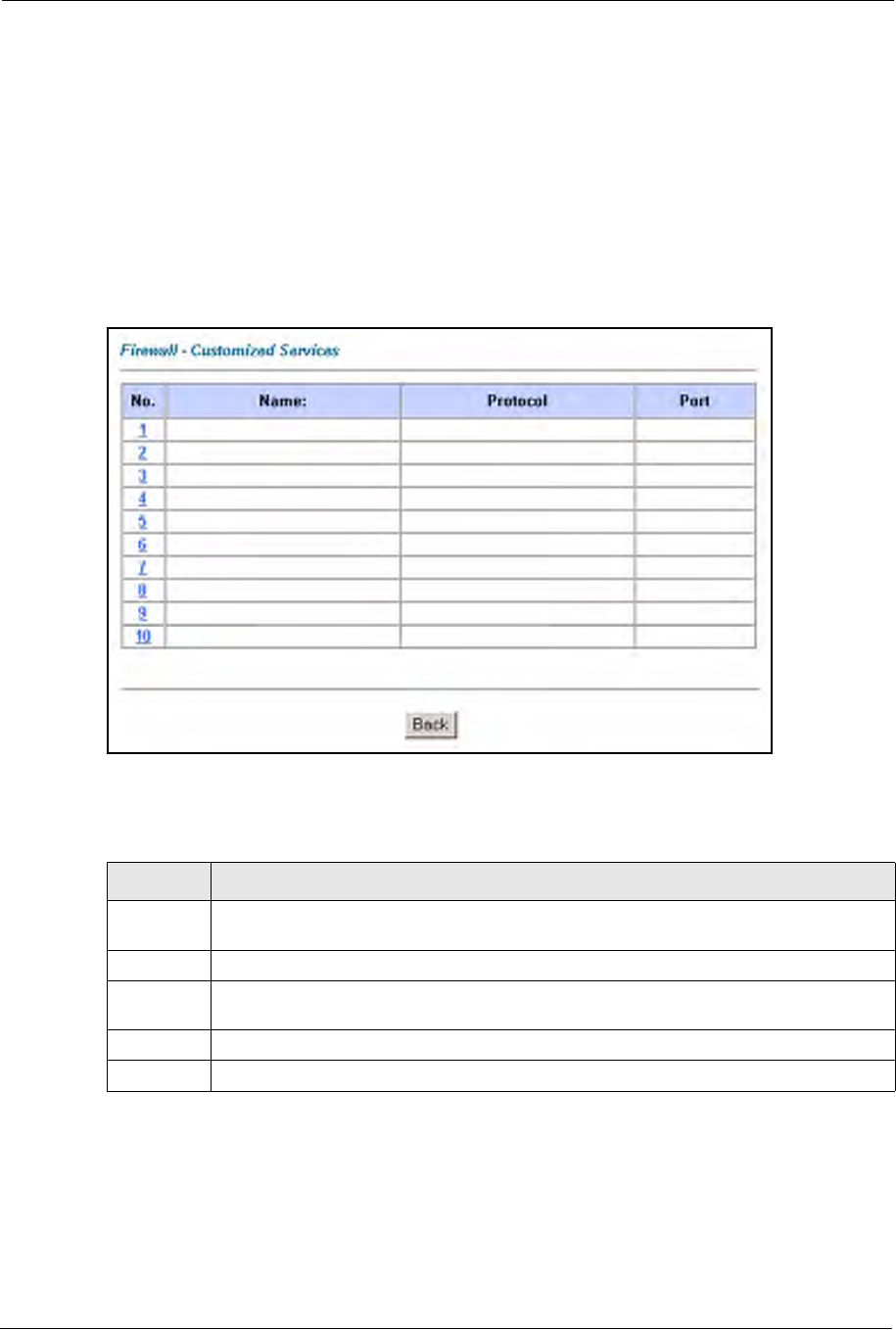
P-660H/HW/W-T Series User’ Guide
141 Chapter 11 Firewall Configuration
11.7 Customized Services
Configure customized services and port numbers not predefined by the Prestige. For a
comprehensive list of port numbers and services, visit the IANA (Internet Assigned Number
Authority) website. For further information on these services, please read Section 11.10 on
page 146. Click the Customized Services link while editing a firewall rule to configure a
custom service port. This displays the following screen.
Refer to Section 10.1 on page 118 for more information.
Figure 54 Firewall: Customized Services
The following table describes the labels in this screen.
11.8 Configuring A Customized Service
Click a rule number in the Firewall Customized Services screen to create a new custom port
or edit an existing one. This action displays the following screen.
Table 40 Customized Services
LABEL DESCRIPTION
No. This is the number of your customized port. Click a rule’s number of a service to go to the
Firewall Customized Services Config screen to configure or edit a customized service.
Name This is the name of your customized service.
Protocol This shows the IP protocol (TCP,UDP or TCP/UDP) that defines your customized
service.
Port This is the port number or range that defines your customized service.
Back Click Back to return the Firewall Edit Rule screen.
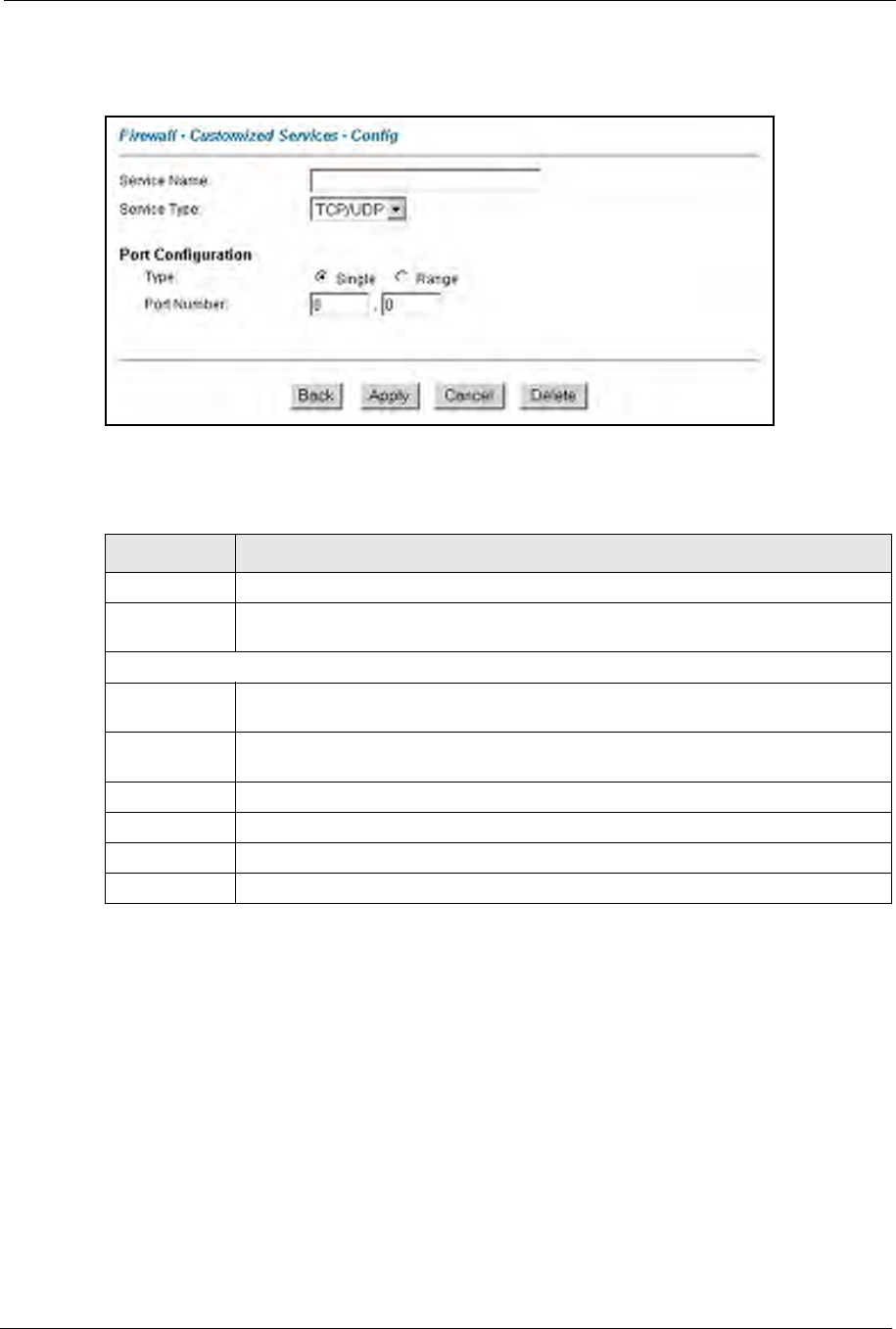
P-660H/HW/W-T Series User’ Guide
Chapter 11 Firewall Configuration 142
Refer to Section 10.1 on page 118 for more information.
Figure 55 Firewall: Configure Customized Services
The following table describes the labels in this screen.
11.9 Example Firewall Rule
The following Internet firewall rule example allows a hypothetical “My Service” connection
from the Internet.
1Click Firewall in the navigation panel and click Rule Summary.
2Select WAN to LAN in the Packet Direction field.
Table 41 Firewall: Configure Customized Services
LABEL DESCRIPTION
Service Name Type a unique name for your custom port.
Service Type Choose the IP port (TCP,UDP or TCP/UDP) that defines your customized port from
the drop down list box.
Port Configuration
Type Click Single to specify one port only or Range to specify a span of ports that define
your customized service.
Port Number Type a single port number or the range of port numbers that define your customized
service.
Back Click Back to return to the Firewall Customized Services screen.
Apply Click Apply to save your customized settings and exit this screen.
Cancel Click Cancel to return to the previously saved settings.
Delete Click Delete to delete the current rule.
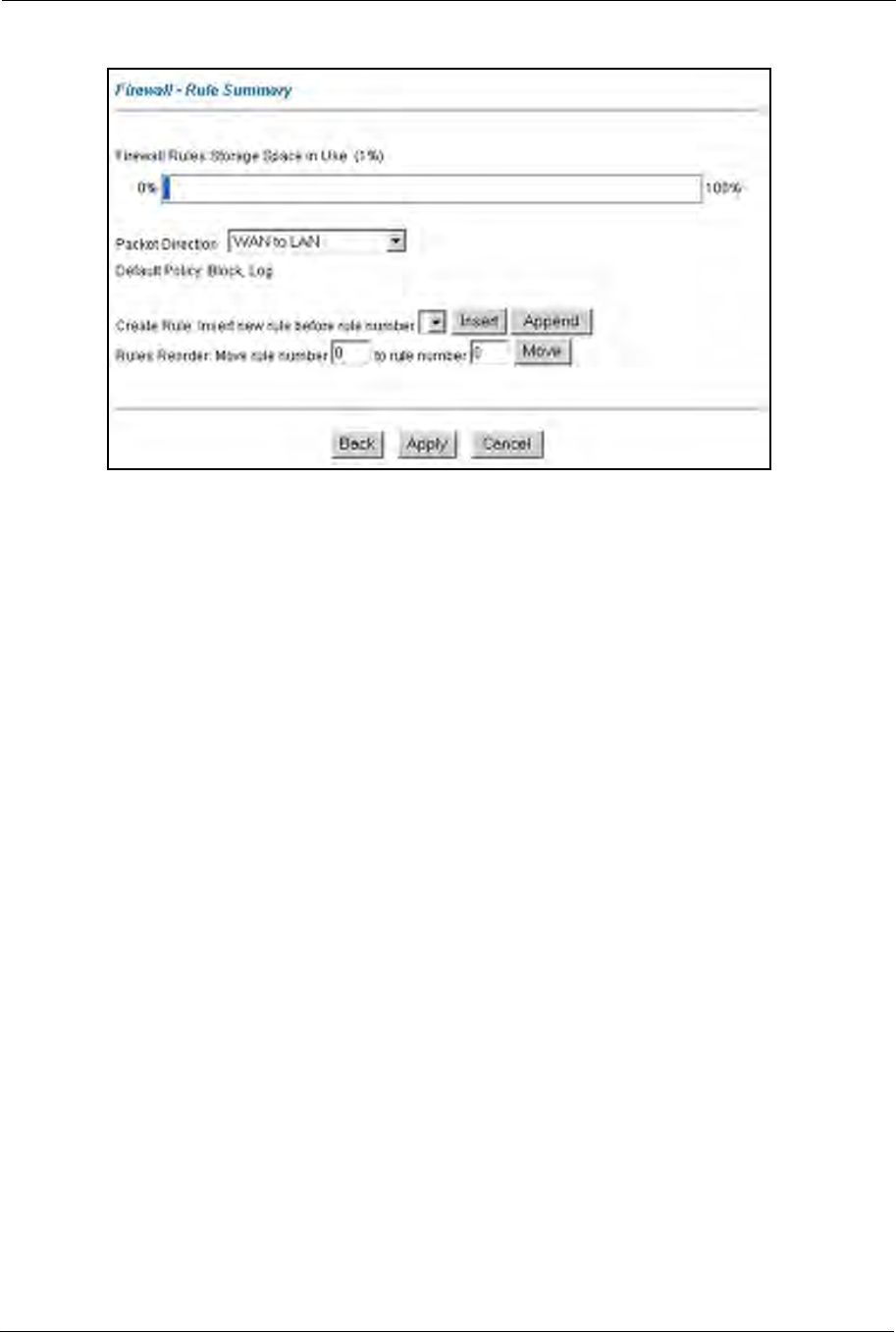
P-660H/HW/W-T Series User’ Guide
143 Chapter 11 Firewall Configuration
Figure 56 Firewall Example: Rule Summary
3In the Rule Summary screen, type the index number for where you want to put the rule.
For example, if you type “6”, your new rule becomes number 6 and the previous rule 6 (if
there is one) becomes rule 7.
4Click Insert to display the firewall rule configuration screen.
5Select Any in the Destination Address box and then click Delete.
6Configure the destination address screen as follows and click Add.
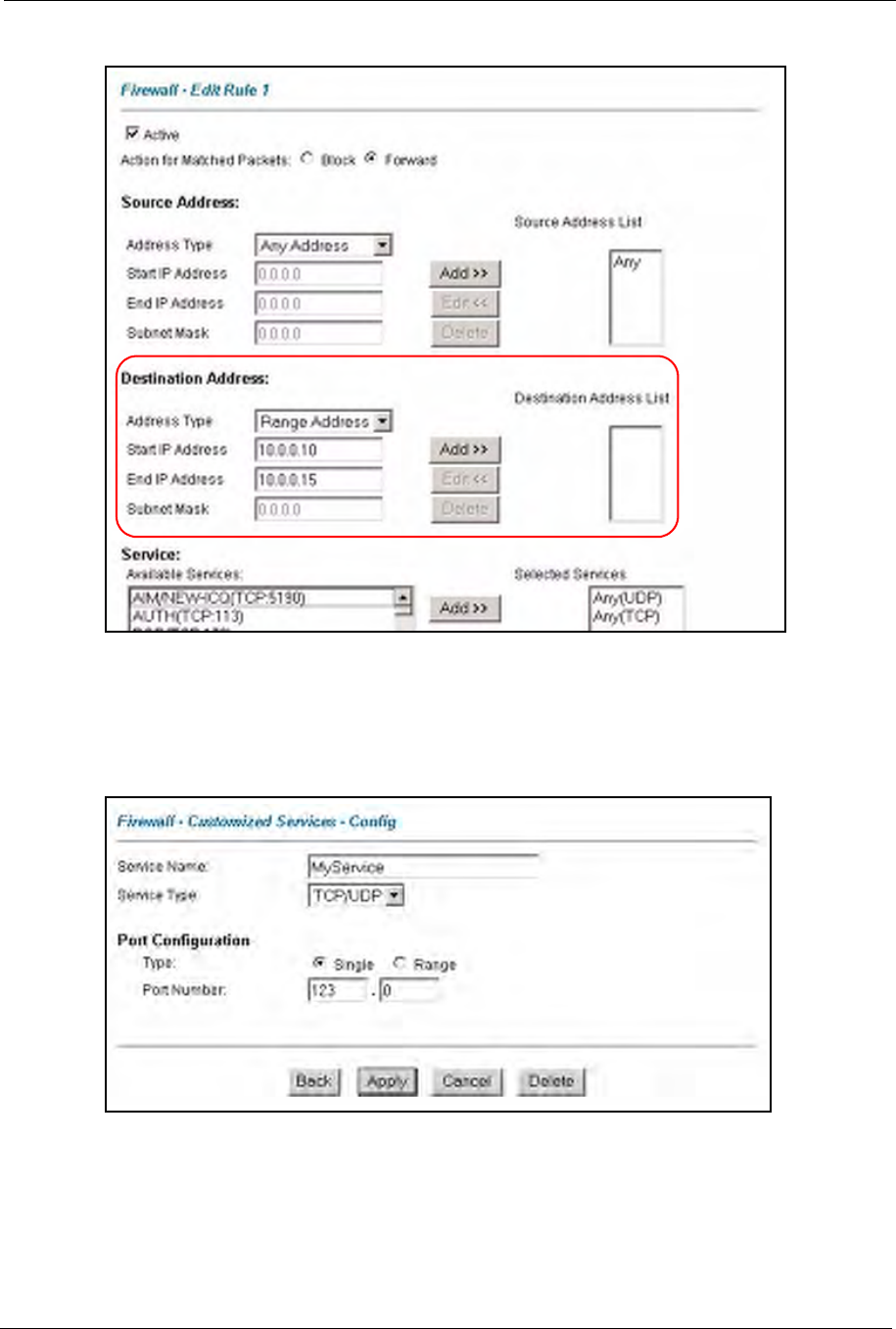
P-660H/HW/W-T Series User’ Guide
Chapter 11 Firewall Configuration 144
Figure 57 Firewall Example: Edit Rule: Destination Address
7In the Edit Rule screen, click the Customized Services link to open the Customized
Service screen.
8Click an index number to display the Customized Services -Config screen and configure
the screen as follows and click Apply.
Figure 58 Edit Custom Port Example
9In the Edit Rule screen, use the Add>> and Remove buttons between Available
Services and Selected Services list boxes to configure it as follows. Click Apply when
you are done.
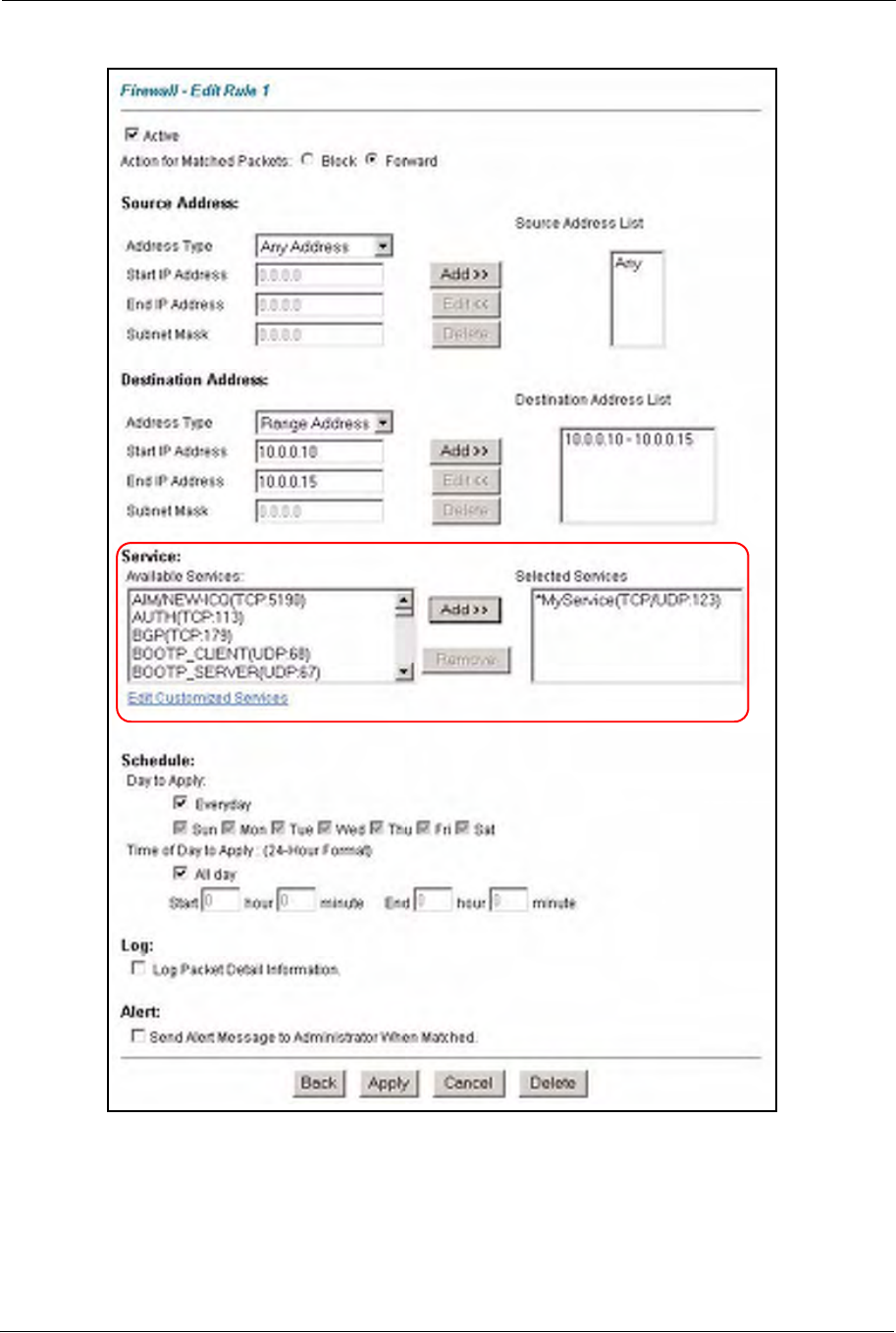
P-660H/HW/W-T Series User’ Guide
145 Chapter 11 Firewall Configuration
Figure 59 Firewall Example: Edit Rule: Select Customized Services
Note: Custom ports show up with an “*” before their names in the Services list box
and the Rule Summary list box. Click Apply after you’ve created your custom
port.
On completing the configuration procedure for this Internet firewall rule, the Rule Summary
screen should look like the following.
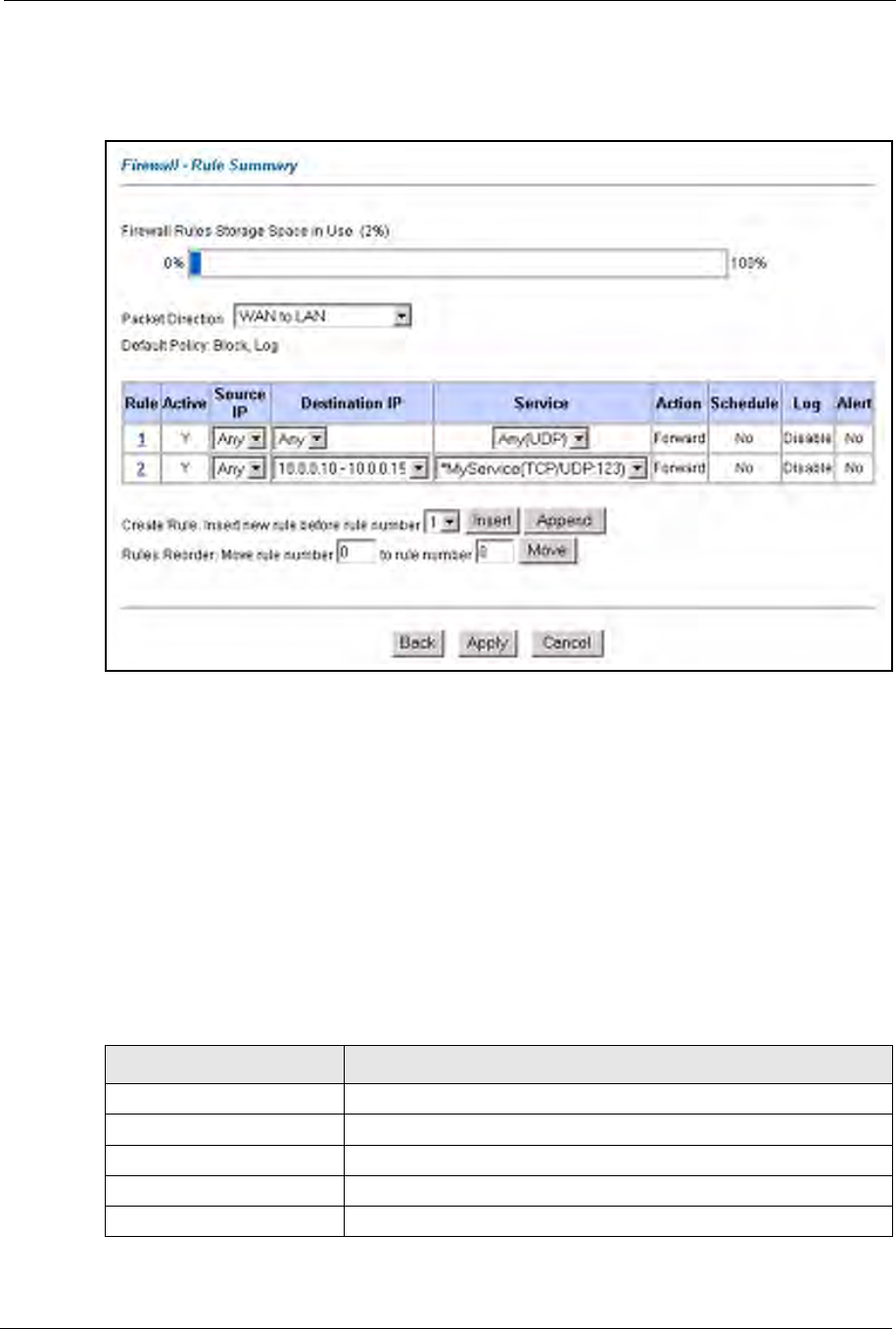
P-660H/HW/W-T Series User’ Guide
Chapter 11 Firewall Configuration 146
Rule 2 allows a “My Service” connection from the WAN to IP addresses 10.0.0.10 through
10.0.0.15 on the LAN.
Figure 60 Firewall Example: Rule Summary: My Service
11.10 Predefined Services
The Available Services list box in the Edit Rule screen (see Section 11.6.1 on page 138)
displays all predefined services that the Prestige already supports. Next to the name of the
service, two fields appear in brackets. The first field indicates the IP protocol type (TCP, UDP,
or ICMP). The second field indicates the IP port number that defines the service. (Note that
there may be more than one IP protocol type. For example, look at the default configuration
labeled “(DNS)”. (UDP/TCP:53) means UDP port 53 and TCP port 53. Up to 128 entries are
supported. Custom service ports may also be configured using the Edit Customized Services
function discussed previously.
Table 42 Predefined Services
SERVICE DESCRIPTION
AIM/NEW_ICQ(TCP:5190) AOL’s Internet Messenger service, used as a listening port by ICQ.
AUTH(TCP:113) Authentication protocol used by some servers.
BGP(TCP:179) Border Gateway Protocol.
BOOTP_CLIENT(UDP:68) DHCP Client.
BOOTP_SERVER(UDP:67) DHCP Server.

P-660H/HW/W-T Series User’ Guide
147 Chapter 11 Firewall Configuration
CU-SEEME(TCP/UDP:7648,
24032)
A popular videoconferencing solution from White Pines Software.
DNS(UDP/TCP:53) Domain Name Server, a service that matches web names (e.g.
www.zyxel.com) to IP numbers.
FINGER(TCP:79) Finger is a UNIX or Internet related command that can be used to find
out if a user is logged on.
FTP(TCP:20.21) File Transfer Program, a program to enable fast transfer of files,
including large files that may not be possible by e-mail.
H.323(TCP:1720) Net Meeting uses this protocol.
HTTP(TCP:80) Hyper Text Transfer Protocol - a client/server protocol for the world
wide web.
HTTPS HTTPS is a secured http session often used in e-commerce.
ICQ(UDP:4000) This is a popular Internet chat program.
IPSEC_TRANSPORT/
TUNNEL(AH:0)
The IPSEC AH (Authentication Header) tunneling protocol uses this
service.
IPSEC_TUNNEL(ESP:0) The IPSEC ESP (Encapsulation Security Protocol) tunneling protocol
uses this service.
IRC(TCP/UDP:6667) This is another popular Internet chat program.
MSN Messenger(TCP:1863) Microsoft Networks’ messenger service uses this protocol.
MULTICAST(IGMP:0) Internet Group Multicast Protocol is used when sending packets to a
specific group of hosts.
NEWS(TCP:144) A protocol for news groups.
NFS(UDP:2049) Network File System - NFS is a client/server distributed file service that
provides transparent file-sharing for network environments.
NNTP(TCP:119) Network News Transport Protocol is the delivery mechanism for the
USENET newsgroup service.
PING(ICMP:0) Packet INternet Groper is a protocol that sends out ICMP echo
requests to test whether or not a remote host is reachable.
POP3(TCP:110) Post Office Protocol version 3 lets a client computer get e-mail from a
POP3 server through a temporary connection (TCP/IP or other).
PPTP(TCP:1723) Point-to-Point Tunneling Protocol enables secure transfer of data over
public networks. This is the control channel.
PPTP_TUNNEL(GRE:0) Point-to-Point Tunneling Protocol enables secure transfer of data over
public networks. This is the data channel.
RCMD(TCP:512) Remote Command Service.
REAL_AUDIO(TCP:7070) A streaming audio service that enables real time sound over the web.
REXEC(TCP:514) Remote Execution Daemon.
RLOGIN(TCP:513) Remote Login.
RTELNET(TCP:107) Remote Telnet.
RTSP(TCP/UDP:554) The Real Time Streaming (media control) Protocol (RTSP) is a remote
control for multimedia on the Internet.
SFTP(TCP:115) Simple File Transfer Protocol.
Table 42 Predefined Services (continued)
SERVICE DESCRIPTION

P-660H/HW/W-T Series User’ Guide
Chapter 11 Firewall Configuration 148
11.11 Anti-Probing
If an outside user attempts to probe an unsupported port on your Prestige, an ICMP response
packet is automatically returned. This allows the outside user to know the Prestige exists. The
Prestige supports anti-probing, which prevents the ICMP response packet from being sent.
This keeps outsiders from discovering your Prestige when unsupported ports are probed.
Internet Control Message Protocol (ICMP) is a message control and error-reporting protocol
between a host server and a gateway to the Internet. ICMP uses Internet Protocol (IP)
datagrams, but the messages are processed by the TCP/IP software and directly apparent to the
application user.
Refer to Section 10.1 on page 118 for more information.
Click Firewall in the navigation panel and click Anti Probing to display the screen as shown.
SMTP(TCP:25) Simple Mail Transfer Protocol is the message-exchange standard for
the Internet. SMTP enables you to move messages from one e-mail
server to another.
SNMP(TCP/UDP:161) Simple Network Management Program.
SNMP-TRAPS (TCP/
UDP:162)
Traps for use with the SNMP (RFC:1215).
SQL-NET(TCP:1521) Structured Query Language is an interface to access data on many
different types of database systems, including mainframes, midrange
systems, UNIX systems and network servers.
SSDP(UDP:1900) Simole Service Discovery Protocol (SSDP) is a discovery service
searching for Universal Plug and Play devices on your home network
or upstream Internet gateways using DUDP port 1900.
SSH(TCP/UDP:22) Secure Shell Remote Login Program.
STRMWORKS(UDP:1558) Stream Works Protocol.
SYSLOG(UDP:514) Syslog allows you to send system logs to a UNIX server.
TACACS(UDP:49) Login Host Protocol used for (Terminal Access Controller Access
Control System).
TELNET(TCP:23) Telnet is the login and terminal emulation protocol common on the
Internet and in UNIX environments. It operates over TCP/IP networks.
Its primary function is to allow users to log into remote host systems.
TFTP(UDP:69) Trivial File Transfer Protocol is an Internet file transfer protocol similar
to FTP, but uses the UDP (User Datagram Protocol) rather than TCP
(Transmission Control Protocol).
VDOLIVE(TCP:7000) Another videoconferencing solution.
Table 42 Predefined Services (continued)
SERVICE DESCRIPTION
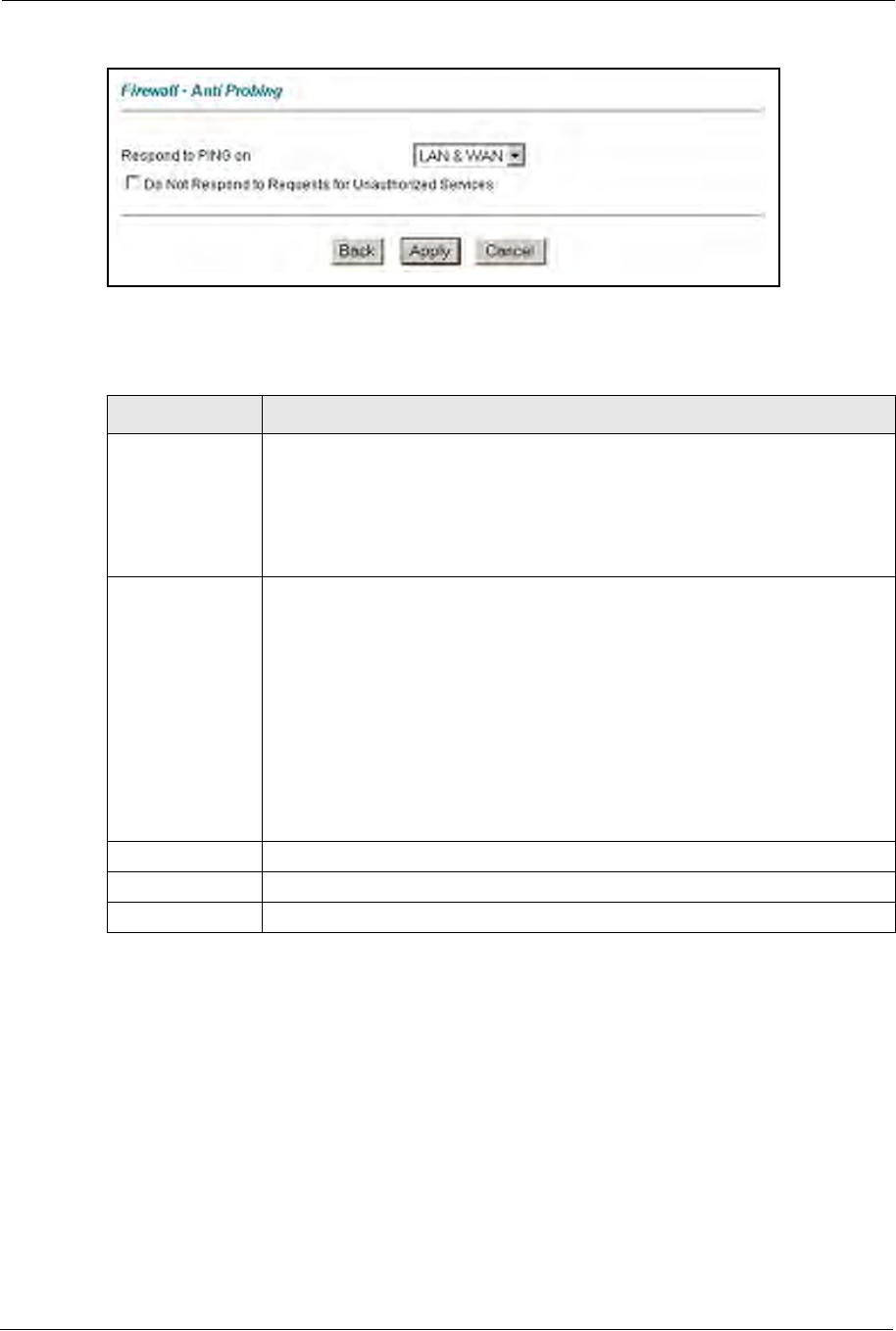
P-660H/HW/W-T Series User’ Guide
149 Chapter 11 Firewall Configuration
Figure 61 Firewall: Anti Probing
The following table describes the labels in this screen.
11.12 DoS Thresholds
For DoS attacks, the Prestige uses thresholds to determine when to drop sessions that do not
become fully established. These thresholds apply globally to all sessions.
You can use the default threshold values, or you can change them to values more suitable to
your security requirements.
Refer to Section 11.12.3 on page 151 to configure thresholds.
Table 43 Firewall: Anti Probing
LABEL DESCRIPTION
Respond to PING
on
The Prestige does not respond to any incoming Ping requests when Disable is
selected.
Select LAN to reply to incoming LAN Ping requests.
Select WAN to reply to incoming WAN Ping requests.
Otherwise select LAN & WAN to reply to both incoming LAN and WAN Ping
requests.
Do not respond to
requests for
unauthorized
services.
Select this option to prevent hackers from finding the Prestige by probing for
unused ports. If you select this option, the Prestige will not respond to port
request(s) for unused ports, thus leaving the unused ports and the Prestige
unseen. By default this option is not selected and the Prestige will reply with an
ICMP Port Unreachable packet for a port probe on its unused UDP ports, and a
TCP Reset packet for a port probe on its unused TCP ports.
Note that the probing packets must first traverse the Prestige 's firewall
mechanism before reaching this anti-probing mechanism. Therefore if the firewall
mechanism blocks a probing packet, the Prestige reacts based on the firewall
policy, which by default, is to send a TCP reset packet for a blocked TCP packet.
You can use the command "sys firewall tcprst rst [on|off]" to change this policy.
When the firewall mechanism blocks a UDP packet, it drops the packet without
sending a response packet.
Back Click Back to return to the previous screen.
Apply Click Apply to save your changes back to the Prestige.
Reset Click Reset to begin configuring this screen afresh.

P-660H/HW/W-T Series User’ Guide
Chapter 11 Firewall Configuration 150
11.12.1 Threshold Values
Tune these parameters when something is not working and after you have checked the firewall
counters. These default values should work fine for most small offices. Factors influencing
choices for threshold values are:
• The maximum number of opened sessions.
• The minimum capacity of server backlog in your LAN network.
• The CPU power of servers in your LAN network.
• Network bandwidth.
• Type of traffic for certain servers.
If your network is slower than average for any of these factors (especially if you have servers
that are slow or handle many tasks and are often busy), then the default values should be
reduced.
You should make any changes to the threshold values before you continue configuring
firewall rules.
11.12.2 Half-Open Sessions
An unusually high number of half-open sessions (either an absolute number or measured as
the arrival rate) could indicate that a Denial of Service attack is occurring. For TCP, "half-
open" means that the session has not reached the established state-the TCP three-way
handshake has not yet been completed (see Figure 47 on page 122). For UDP, "half-open"
means that the firewall has detected no return traffic.
The Prestige measures both the total number of existing half-open sessions and the rate of
session establishment attempts. Both TCP and UDP half-open sessions are counted in the total
number and rate measurements. Measurements are made once a minute.
When the number of existing half-open sessions rises above a threshold (max-incomplete
high), the Prestige starts deleting half-open sessions as required to accommodate new
connection requests. The Prestige continues to delete half-open requests as necessary, until the
number of existing half-open sessions drops below another threshold (max-incomplete low).
When the rate of new connection attempts rises above a threshold (one-minute high), the
Prestige starts deleting half-open sessions as required to accommodate new connection
requests. The Prestige continues to delete half-open sessions as necessary, until the rate of new
connection attempts drops below another threshold (one-minute low). The rate is the number
of new attempts detected in the last one-minute sample period.
11.12.2.1 TCP Maximum Incomplete and Blocking Time
An unusually high number of half-open sessions with the same destination host address could
indicate that a Denial of Service attack is being launched against the host.
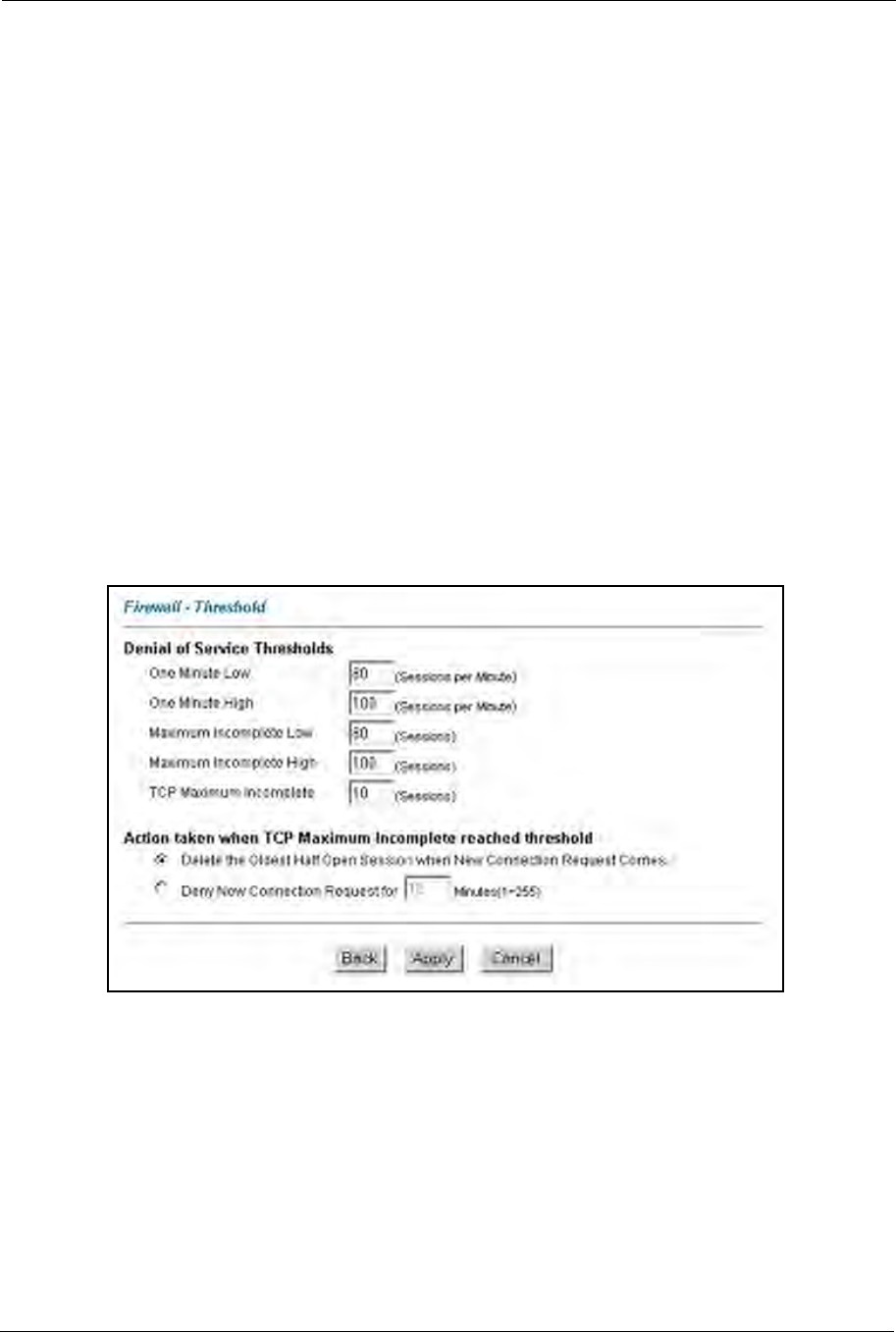
P-660H/HW/W-T Series User’ Guide
151 Chapter 11 Firewall Configuration
Whenever the number of half-open sessions with the same destination host address rises above
a threshold (TCP Maximum Incomplete), the Prestige starts deleting half-open sessions
according to one of the following methods:
• If the Blocking Time timeout is 0 (the default), then the Prestige deletes the oldest
existing half-open session for the host for every new connection request to the host. This
ensures that the number of half-open sessions to a given host will never exceed the
threshold.
• If the Blocking Time timeout is greater than 0, then the Prestige blocks all new
connection requests to the host giving the server time to handle the present connections.
The Prestige continues to block all new connection requests until the Blocking Time
expires.
11.12.3 Configuring Firewall Thresholds
The Prestige also sends alerts whenever TCP Maximum Incomplete is exceeded. The global
values specified for the threshold and timeout apply to all TCP connections.
Click Firewall, and Threshold to bring up the next screen.
Figure 62 Firewall: Threshold
The following table describes the labels in this screen.

P-660H/HW/W-T Series User’ Guide
Chapter 11 Firewall Configuration 152
Table 44 Firewall: Threshold
LABEL DESCRIPTION DEFAULT VALUES
Denial of Service
Thresholds
One Minute Low This is the rate of new half-open sessions that
causes the firewall to stop deleting half-open
sessions. The Prestige continues to delete
half-open sessions as necessary, until the
rate of new connection attempts drops below
this number.
80 existing half-open sessions.
One Minute High This is the rate of new half-open sessions that
causes the firewall to start deleting half-open
sessions. When the rate of new connection
attempts rises above this number, the
Prestige deletes half-open sessions as
required to accommodate new connection
attempts.
100 half-open sessions per minute.
The above numbers cause the
Prestige to start deleting half-open
sessions when more than 100
session establishment attempts
have been detected in the last
minute, and to stop deleting half-
open sessions when fewer than 80
session establishment attempts
have been detected in the last
minute.
Maximum
Incomplete Low
This is the number of existing half-open
sessions that causes the firewall to stop
deleting half-open sessions. The Prestige
continues to delete half-open requests as
necessary, until the number of existing half-
open sessions drops below this number.
80 existing half-open sessions.
Maximum
Incomplete High
This is the number of existing half-open
sessions that causes the firewall to start
deleting half-open sessions. When the
number of existing half-open sessions rises
above this number, the Prestige deletes half-
open sessions as required to accommodate
new connection requests. Do not set
Maximum Incomplete High to lower than the
current Maximum Incomplete Low number.
100 existing half-open sessions.
The above values causes the
Prestige to start deleting half-open
sessions when the number of
existing half-open sessions rises
above 100, and to stop deleting
half-open sessions with the
number of existing half-open
sessions drops below 80.
TCP Maximum
Incomplete
This is the number of existing half-open TCP
sessions with the same destination host IP
address that causes the firewall to start
dropping half-open sessions to that same
destination host IP address. Enter a number
between 1 and 256. As a general rule, you
should choose a smaller number for a smaller
network, a slower system or limited
bandwidth.
30 existing half-open TCP
sessions.
Action taken when the TCP Maximum Incomplete threshold is reached.
Delete the oldest
half open session
when new
connection
request comes
Select this radio button to clear the oldest half
open session when a new connection request
comes.

P-660H/HW/W-T Series User’ Guide
153 Chapter 11 Firewall Configuration
Deny new
connection
request for
Select this radio button and specify for how
long the Prestige should block new
connection requests when TCP Maximum
Incomplete is reached.
Enter the length of blocking time in minutes
(between 1 and 256).
Back Click Back to return to the previous screen.
Apply Click Apply to save your changes back to the Prestige.
Cancel Click Cancel to begin configuring this screen afresh.
Table 44 Firewall: Threshold (continued)
LABEL DESCRIPTION DEFAULT VALUES
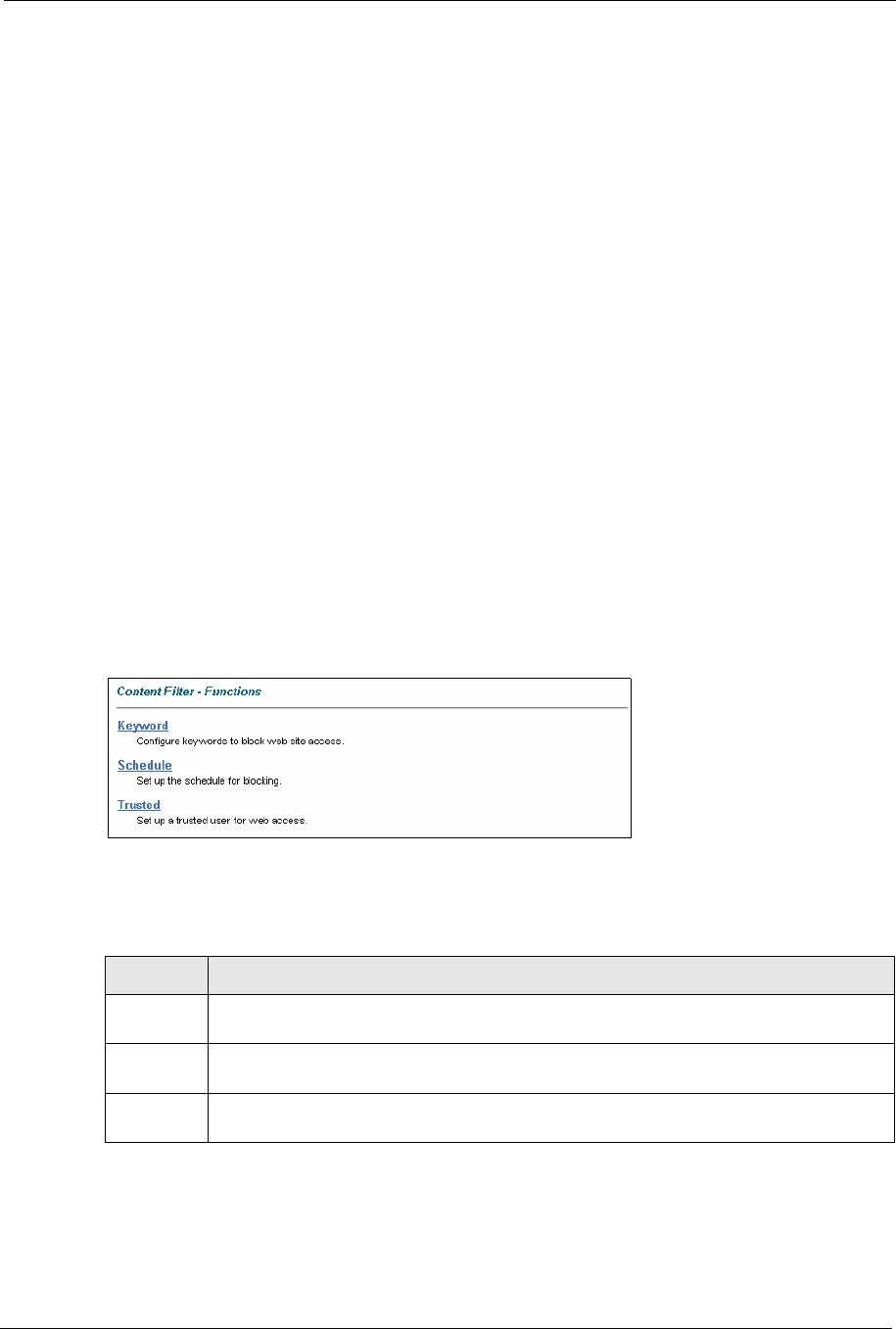
P-660H/HW/W-T Series User’ Guide
Chapter 12 Content Filtering 154
CHAPTER 12
Content Filtering
This chapter covers how to configure content filtering.
12.1 Content Filtering Overview
Internet content filtering allows you to create and enforce Internet access policies tailored to
your needs. Content filtering gives you the ability to block web sites that contain key words
(that you specify) in the URL. You can set a schedule for when the Prestige performs content
filtering. You can also specify trusted IP addresses on the LAN for which the Prestige will not
perform content filtering.
12.2 The Main Content Filter Screen
Click Content Filter to display the main Content Filtering screen.
Figure 63 Content Filtering
The following table describes the links in this screen.
Table 45
LINK DESCRIPTION
Keyword Click this link to display a screen where you can configure your Prestige to block Web
sites containing keywords in their URLs,
Schedule Click this link to display a screen where you can set the days and times for the Prestige to
perform content filtering,
Trusted Click this link to display a screen where you can exclude a range of users on the LAN
from content filtering on your Prestige
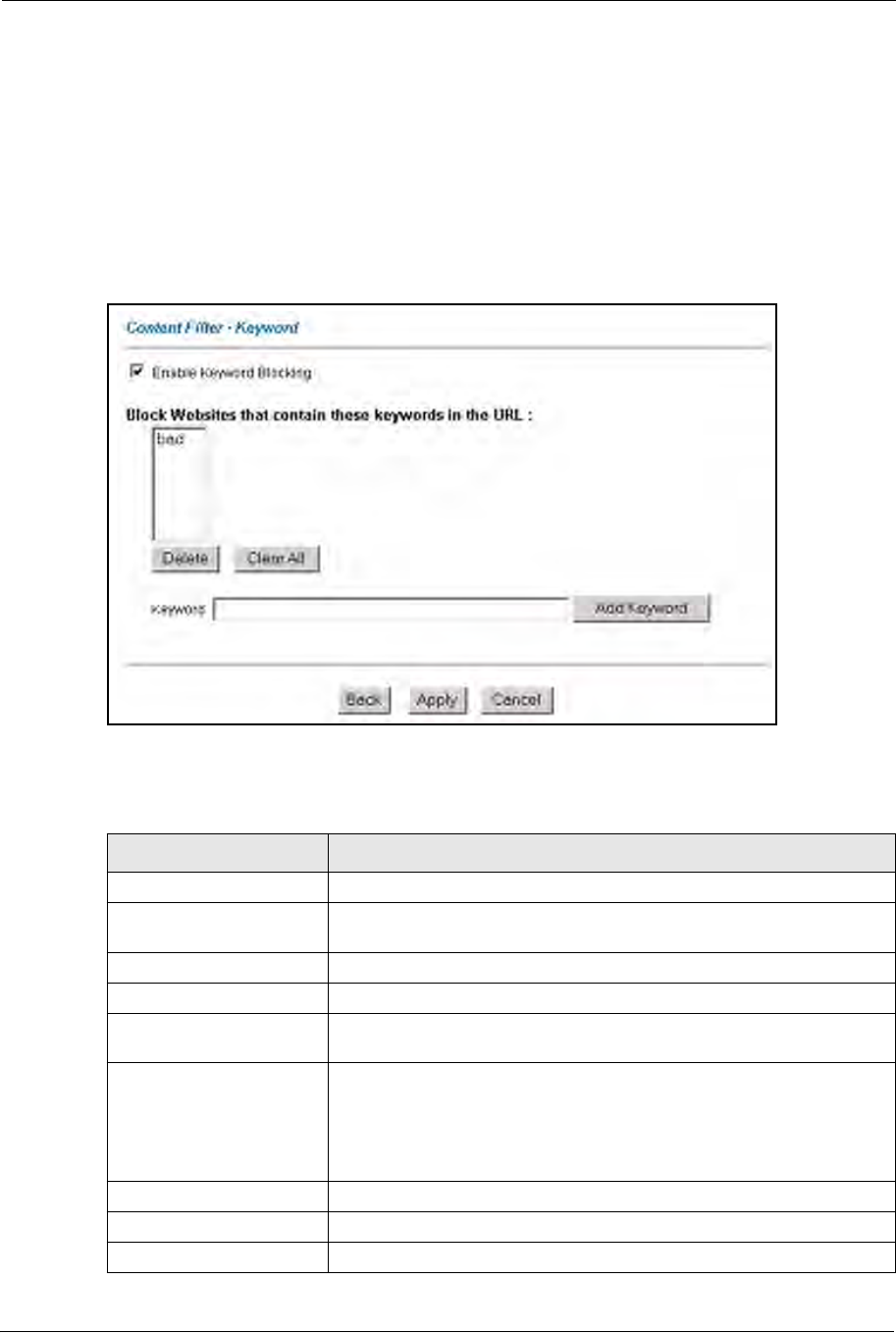
P-660H/HW/W-T Series User’ Guide
155 Chapter 12 Content Filtering
12.3 Configuring Keyword Blocking
Use this screen to block sites containing certain keywords in the URL. For example, if you
enable the keyword "bad", the Prestige blocks all sites containing this keyword including the
URL http://www.website.com/bad.html, even if it is not included in the Filter List.
To have your Prestige block Web sites containing keywords in their URLs, click Content
Filter and Keyword. The screen appears as shown.
Figure 64 Content Filter: Keyword
The following table describes the labels in this screen.
Table 46 Content Filter: Keyword
LABEL DESCRIPTION
Enable Keyword Blocking Select this check box to enable this feature.
Block Websites that contain
these keywords in the URL:
This box contains the list of all the keywords that you have configured the
Prestige to block.
Delete Highlight a keyword in the box and click Delete to remove it.
Clear All Click Clear All to remove all of the keywords from the list.
Keyword Type a keyword in this field. You may use any character (up to 127
characters). Wildcards are not allowed.
Add Keyword Click Add Keyword after you have typed a keyword.
Repeat this procedure to add other keywords. Up to 64 keywords are
allowed.
When you try to access a web page containing a keyword, you will get a
message telling you that the content filter is blocking this request.
Back Click Back to return to the previous screen.
Apply Click Apply to save your changes back to the Prestige.
Cancel Click Cancel to return to the previously saved settings.
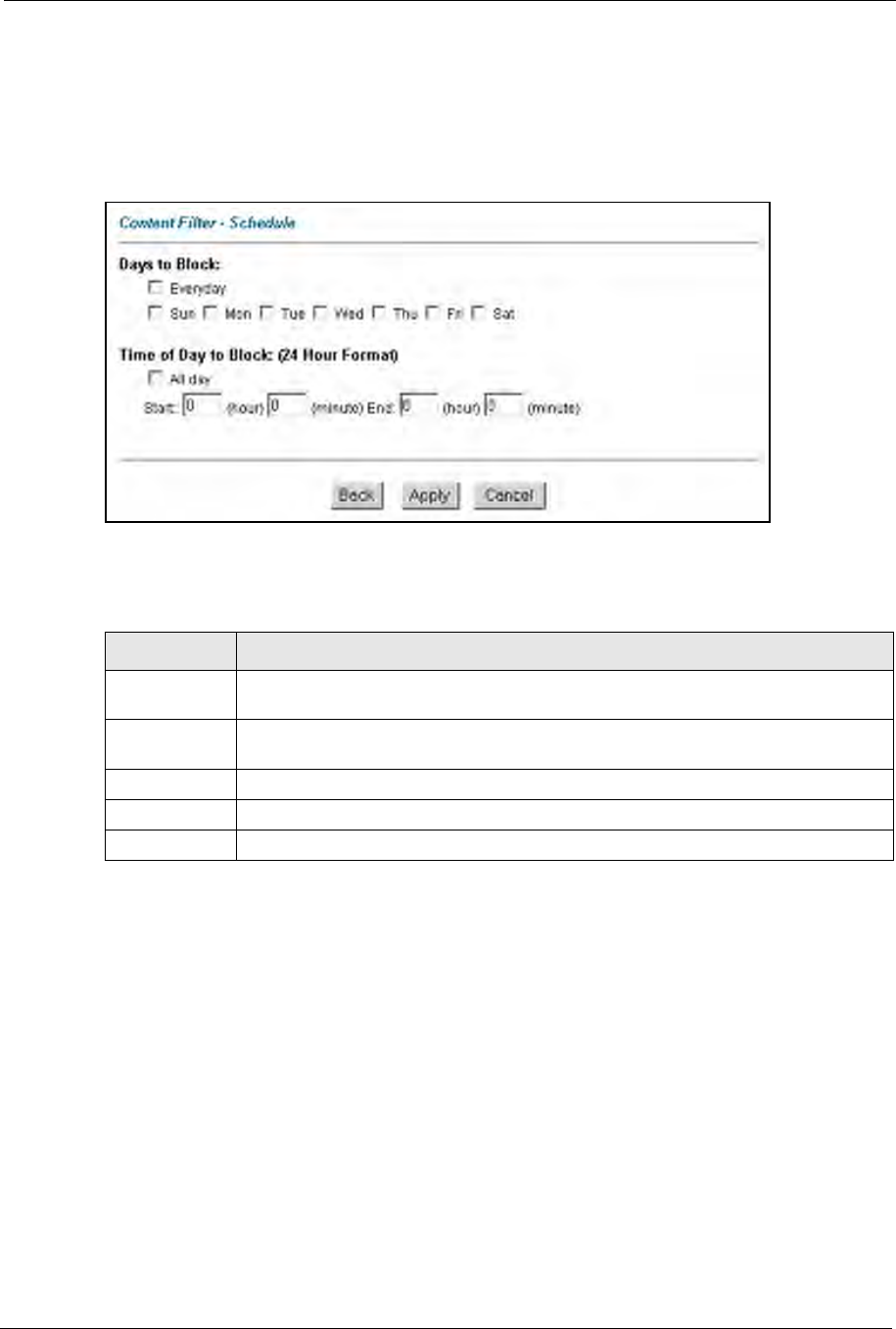
P-660H/HW/W-T Series User’ Guide
Chapter 12 Content Filtering 156
12.4 Configuring the Schedule
To set the days and times for the Prestige to perform content filtering, click Content Filter
and Schedule. The screen appears as shown.
Figure 65 Content Filter: Schedule
The following table describes the labels in this screen.
12.5 Configuring Trusted Computers
To exclude a range of users on the LAN from content filtering on your Prestige, click Content
Filter and Trusted. The screen appears as shown.
Table 47 Content Filter: Schedule
LABEL DESCRIPTION
Days to Block: Select a check box to configure which days of the week (or everyday) you want the
content filtering to be active.
Time of Day to
Block:
Use the 24 hour format to configure which time of the day (or select the All day check
box) you want the content filtering to be active.
Back Click Back to return to the previous screen.
Apply Click Apply to save your changes.
Cancel Click Cancel to return to the previously saved settings.
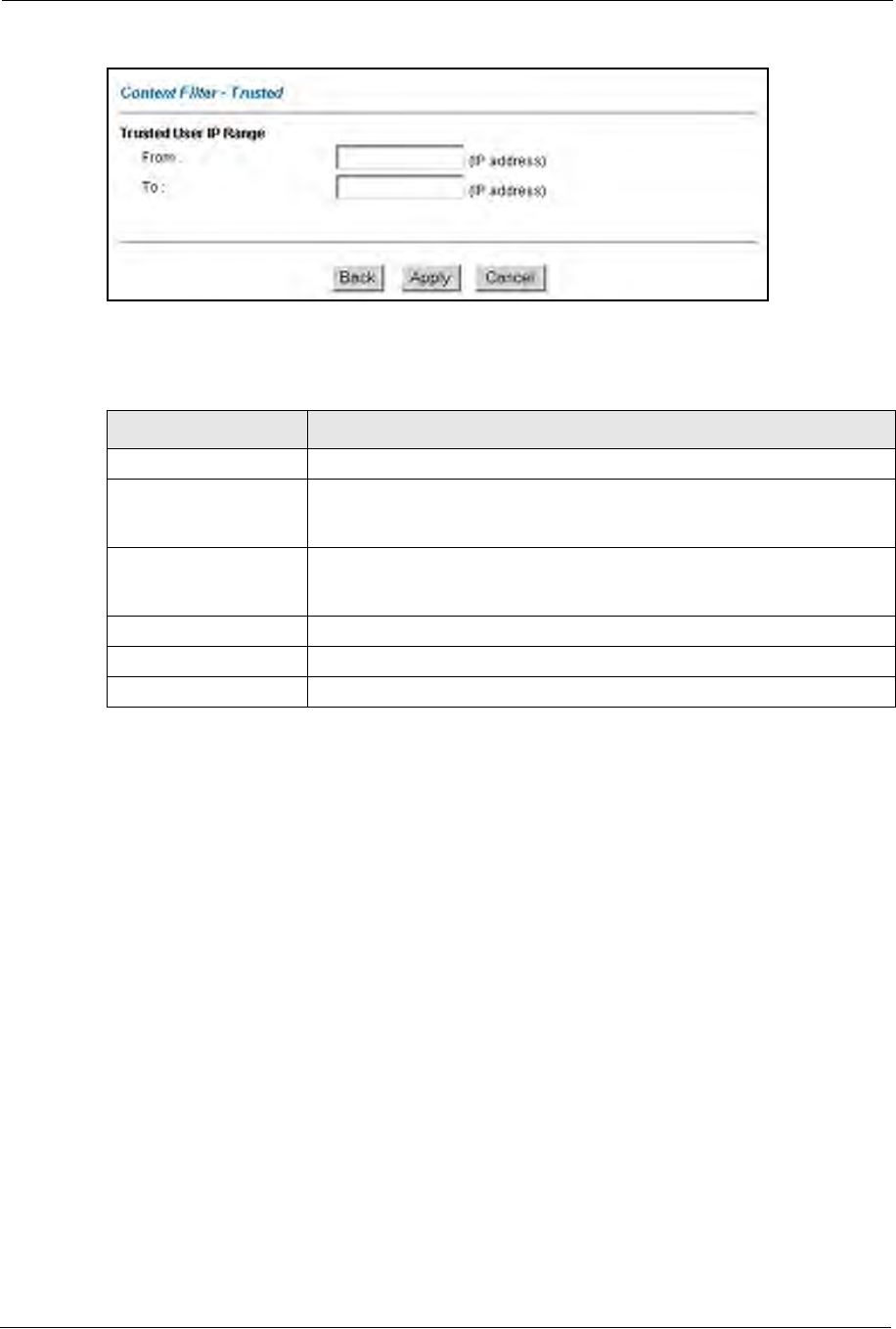
P-660H/HW/W-T Series User’ Guide
157 Chapter 12 Content Filtering
Figure 66 Content Filter: Trusted
The following table describes the labels in this screen.
Table 48 Content Filter: Trusted
LABEL DESCRIPTION
Trusted User IP Range
From Type the IP address of a computer (or the beginning IP address of a specific
range of computers) on the LAN that you want to exclude from content
filtering.
To Type the ending IP address of a specific range of users on your LAN that
you want to exclude from content filtering. Leave this field blank if you want
to exclude an individual computer.
Back Click Back to return to the previous screen.
Apply Click Apply to save your changes back to the Prestige.
Cancel Click Cancel to return to the previously saved settings.

P-660H/HW/W-T Series User’ Guide
Chapter 13 Remote Management Configuration 158
CHAPTER 13
Remote Management
Configuration
This chapter provides information on configuring remote management.
13.1 Remote Management Overview
Remote management allows you to determine which services/protocols can access which
Prestige interface (if any) from which computers.
When you configure remote management to allow management from the WAN, you still need
to configure a firewall rule to allow access.
You may manage your Prestige from a remote location via:
• Internet (WAN only)
• ALL (LAN and WAN)
• LAN only,
• Neither (Disable).
When you Choose WAN o n ly or ALL (LAN & WAN), you still need to configure a firewall
rule to allow access.
To disable remote management of a service, select Disable in the corresponding Server
Access field.
You may only have one remote management session running at a time. The Prestige
automatically disconnects a remote management session of lower priority when another
remote management session of higher priority starts. The priorities for the different types of
remote management sessions are as follows.
1Telnet
2HTTP
13.1.1 Remote Management Limitations
Remote management over LAN or WAN will not work when:
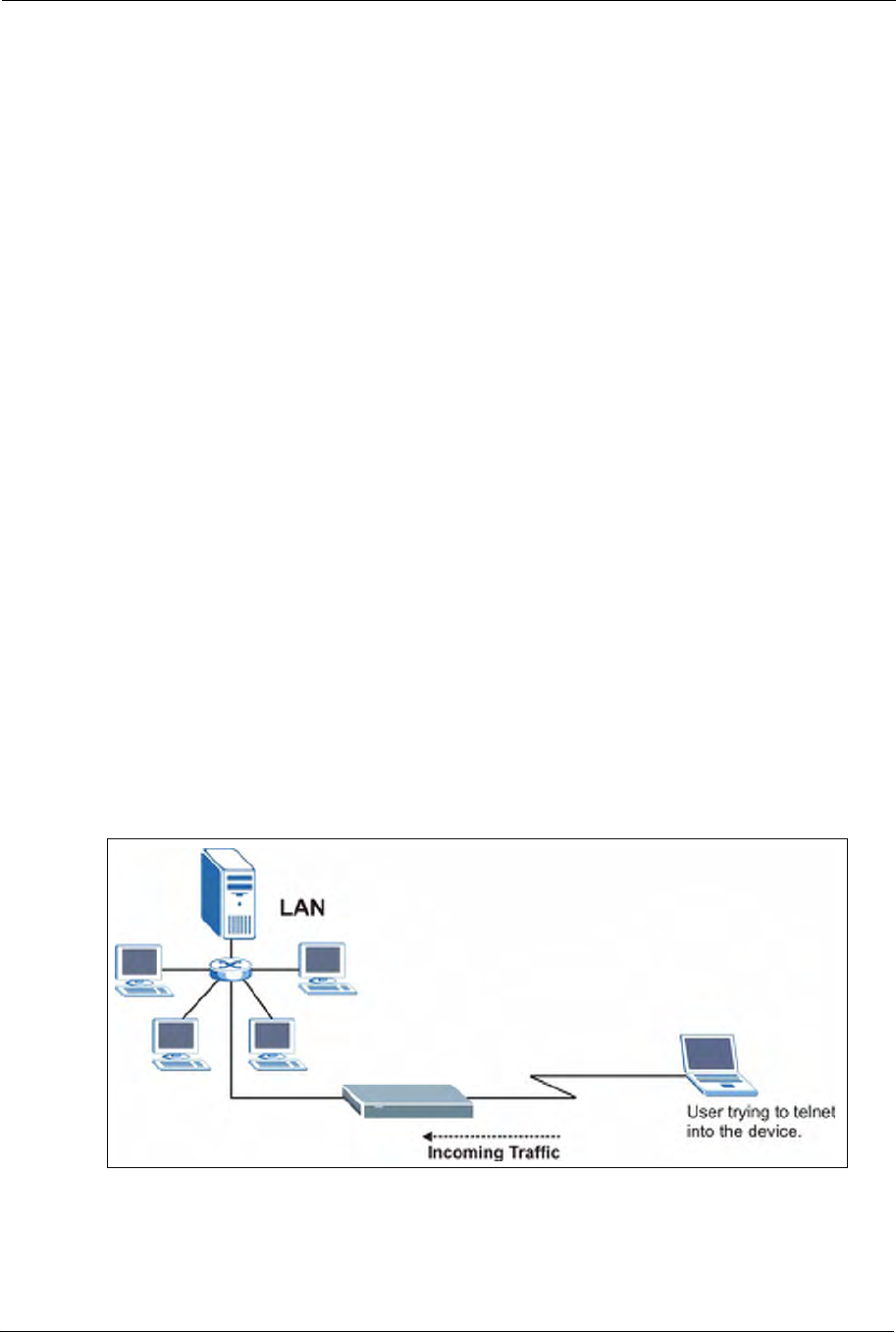
P-660H/HW/W-T Series User’ Guide
159 Chapter 13 Remote Management Configuration
• A filter in SMT menu 3.1 (LAN) or in menu 11.5 (WAN) is applied to block a Telnet,
FTP or Web service.
• You have disabled that service in one of the remote management screens.
• The IP address in the Secured Client IP field does not match the client IP address. If it
does not match, the Prestige will disconnect the session immediately.
• There is already another remote management session with an equal or higher priority
running. You may only have one remote management session running at one time.
• There is a firewall rule that blocks it.
13.1.2 Remote Management and NAT
When NAT is enabled:
• Use the Prestige’s WAN IP address when configuring from the WAN.
• Use the Prestige’s LAN IP address when configuring from the LAN.
13.1.3 System Timeout
There is a default system management idle timeout of five minutes (three hundred seconds).
The Prestige automatically logs you out if the management session remains idle for longer
than this timeout period. The management session does not time out when a statistics screen is
polling.
13.2 Telnet
You can configure your Prestige for remote Telnet access as shown next.
Figure 67 Telnet Configuration on a TCP/IP Network
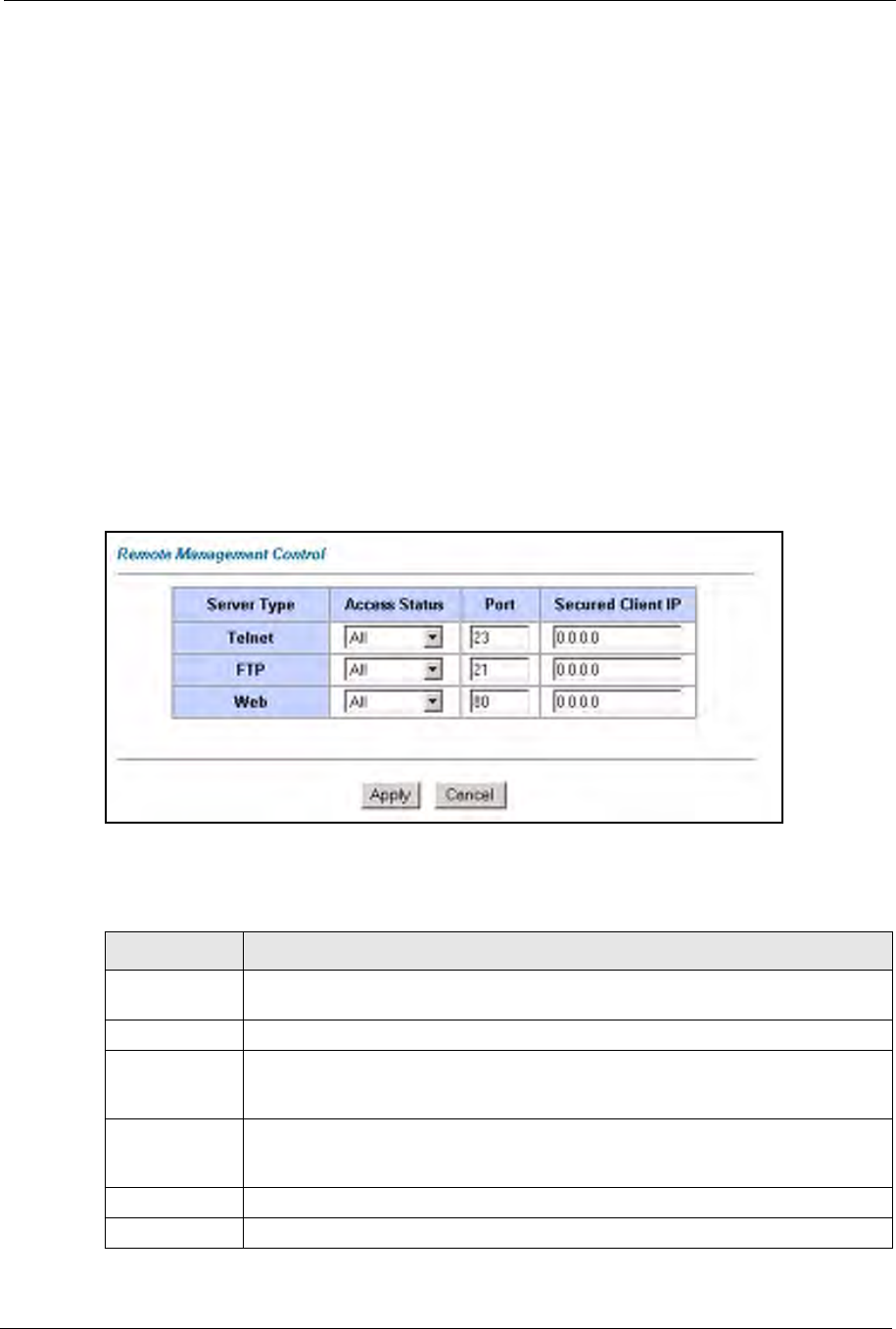
P-660H/HW/W-T Series User’ Guide
Chapter 13 Remote Management Configuration 160
13.3 FTP
You can upload and download Prestige firmware and configuration files using FTP. To use this
feature, your computer must have an FTP client.
13.4 Web
You can use the Prestige’s embedded web configurator for configuration and file
management. See the online help for details.
13.5 Configuring Remote Management
Click Remote Management to open the following screen. See Section 13.1 on page 158 for
more information.
Figure 68 Remote Management
The following table describes the fields in this screen.
Table 49 Remote Management
LABEL DESCRIPTION
Server Type Each of these labels denotes a service that you may use to remotely manage the
Prestige.
Access Status Select the access interface. Choices are All,LAN Only,WAN Only and Disable.
Port This field shows the port number for the remote management service. You may
change the port number for a service in this field, but you must use the same port
number to use that service for remote management.
Secured Client
IP
The default 0.0.0.0 allows any client to use this service to remotely manage the
Prestige. Type an IP address to restrict access to a client with a matching IP
address.
Apply Click Apply to save your settings back to the Prestige.
Cancel Click Cancel to begin configuring this screen afresh.

P-660H/HW/W-T Series User’ Guide
161 Chapter 13 Remote Management Configuration

P-660H/HW/W-T Series User’ Guide
Chapter 14 Universal Plug-and-Play (UPnP) 162
CHAPTER 14
Universal Plug-and-Play (UPnP)
This chapter introduces the UPnP feature in the web configurator.
14.1 Introducing Universal Plug and Play
Universal Plug and Play (UPnP) is a distributed, open networking standard that uses TCP/IP
for simple peer-to-peer network connectivity between devices. A UPnP device can
dynamically join a network, obtain an IP address, convey its capabilities and learn about other
devices on the network. In turn, a device can leave a network smoothly and automatically
when it is no longer in use.
See Section 14.2.1 on page 163 for configuration instructions.
14.1.1 How do I know if I'm using UPnP?
UPnP hardware is identified as an icon in the Network Connections folder (Windows XP).
Each UPnP compatible device installed on your network will appear as a separate icon.
Selecting the icon of a UPnP device will allow you to access the information and properties of
that device.
14.1.2 NAT Traversal
UPnP NAT traversal automates the process of allowing an application to operate through
NAT. UPnP network devices can automatically configure network addressing, announce their
presence in the network to other UPnP devices and enable exchange of simple product and
service descriptions. NAT traversal allows the following:
• Dynamic port mapping
• Learning public IP addresses
• Assigning lease times to mappings
Windows Messenger is an example of an application that supports NAT traversal and UPnP.
See the NAT chapter for more information on NAT.
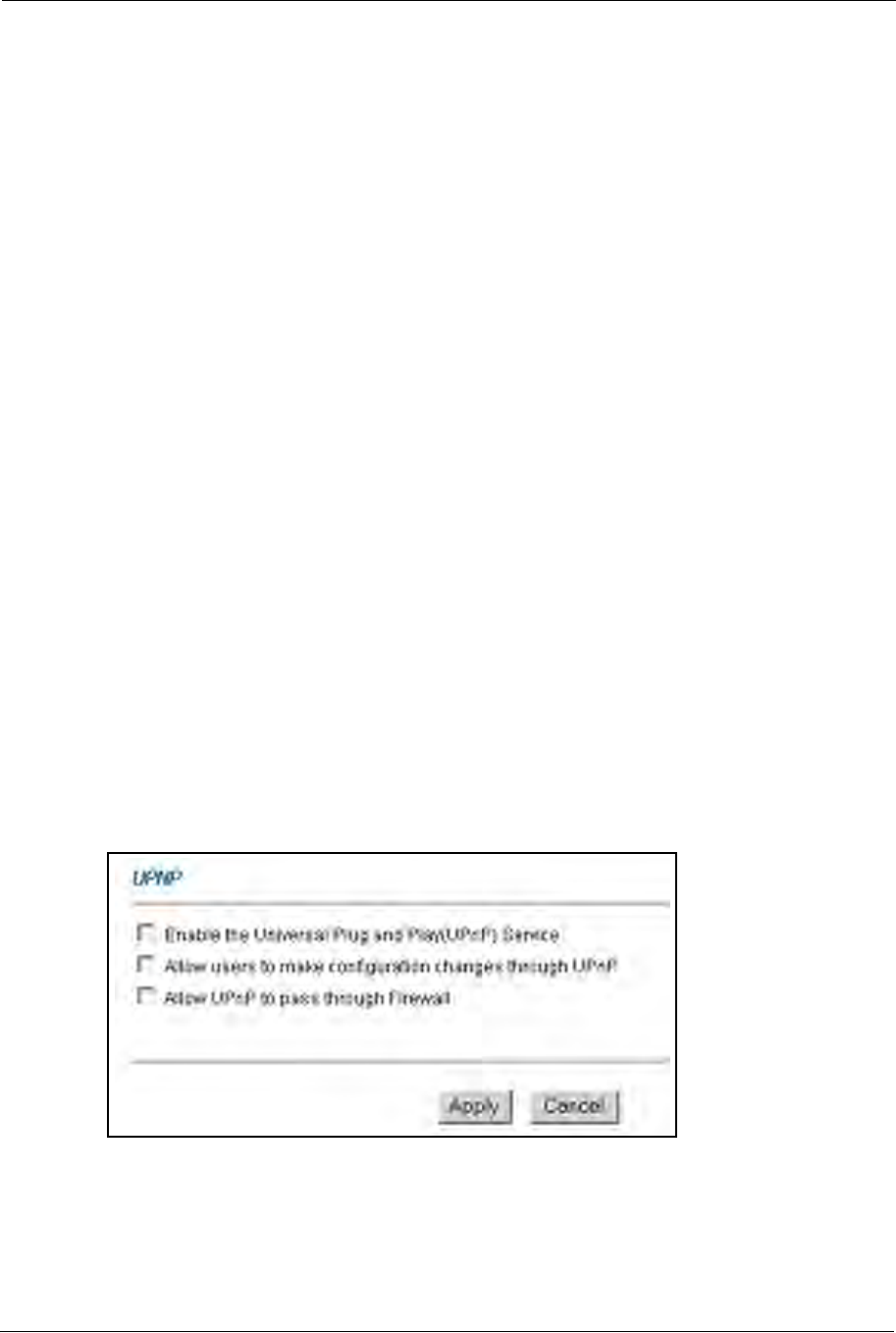
P-660H/HW/W-T Series User’ Guide
163 Chapter 14 Universal Plug-and-Play (UPnP)
14.1.3 Cautions with UPnP
The automated nature of NAT traversal applications in establishing their own services and
opening firewall ports may present network security issues. Network information and
configuration may also be obtained and modified by users in some network environments.
All UPnP-enabled devices may communicate freely with each other without additional
configuration. Disable UPnP if this is not your intention.
14.2 UPnP and ZyXEL
ZyXEL has achieved UPnP certification from the Universal Plug and Play Forum Creates
UPnP™ Implementers Corp. (UIC). ZyXEL's UPnP implementation supports IGD 1.0
(Internet Gateway Device). At the time of writing ZyXEL's UPnP implementation supports
Windows Messenger 4.6 and 4.7 while Windows Messenger 5.0 and Xbox are still being
tested.
UPnP broadcasts are only allowed on the LAN.
See later sections for examples of installing UPnP in Windows XP and Windows Me as well
as an example of using UPnP in Windows.
14.2.1 Configuring UPnP
From the Site Map in the main menu, click UPnP under Advanced Setup to display the
screen shown next.
See Section 14.1 on page 162 for more information.
Figure 69 Configuring UPnP
The following table describes the fields in this screen.

P-660H/HW/W-T Series User’ Guide
Chapter 14 Universal Plug-and-Play (UPnP) 164
14.3 Installing UPnP in Windows Example
This section shows how to install UPnP in Windows Me and Windows XP.
Installing UPnP in Windows Me
Follow the steps below to install the UPnP in Windows Me.
1Click Start and Control Panel. Double-click Add/Remove Programs.
2Click on the Windows Setup tab and select Communication in the Components
selection box. Click Details.
Table 50 Configuring UPnP
LABEL DESCRIPTION
Enable the Universal Plug
and Play (UPnP) Service
Select this check box to activate UPnP. Be aware that anyone could use
a UPnP application to open the web configurator's login screen without
entering the Prestige's IP address (although you must still enter the
password to access the web configurator).
Allow users to make
configuration changes
through UPnP
Select this check box to allow UPnP-enabled applications to
automatically configure the Prestige so that they can communicate
through the Prestige, for example by using NAT traversal, UPnP
applications automatically reserve a NAT forwarding port in order to
communicate with another UPnP enabled device; this eliminates the
need to manually configure port forwarding for the UPnP enabled
application.
Allow UPnP to pass through
Firewall
Select this check box to allow traffic from UPnP-enabled applications to
bypass the firewall.
Clear this check box to have the firewall block all UPnP application
packets (for example, MSN packets).
Apply Click Apply to save the setting to the Prestige.
Cancel Click Cancel to return to the previously saved settings.
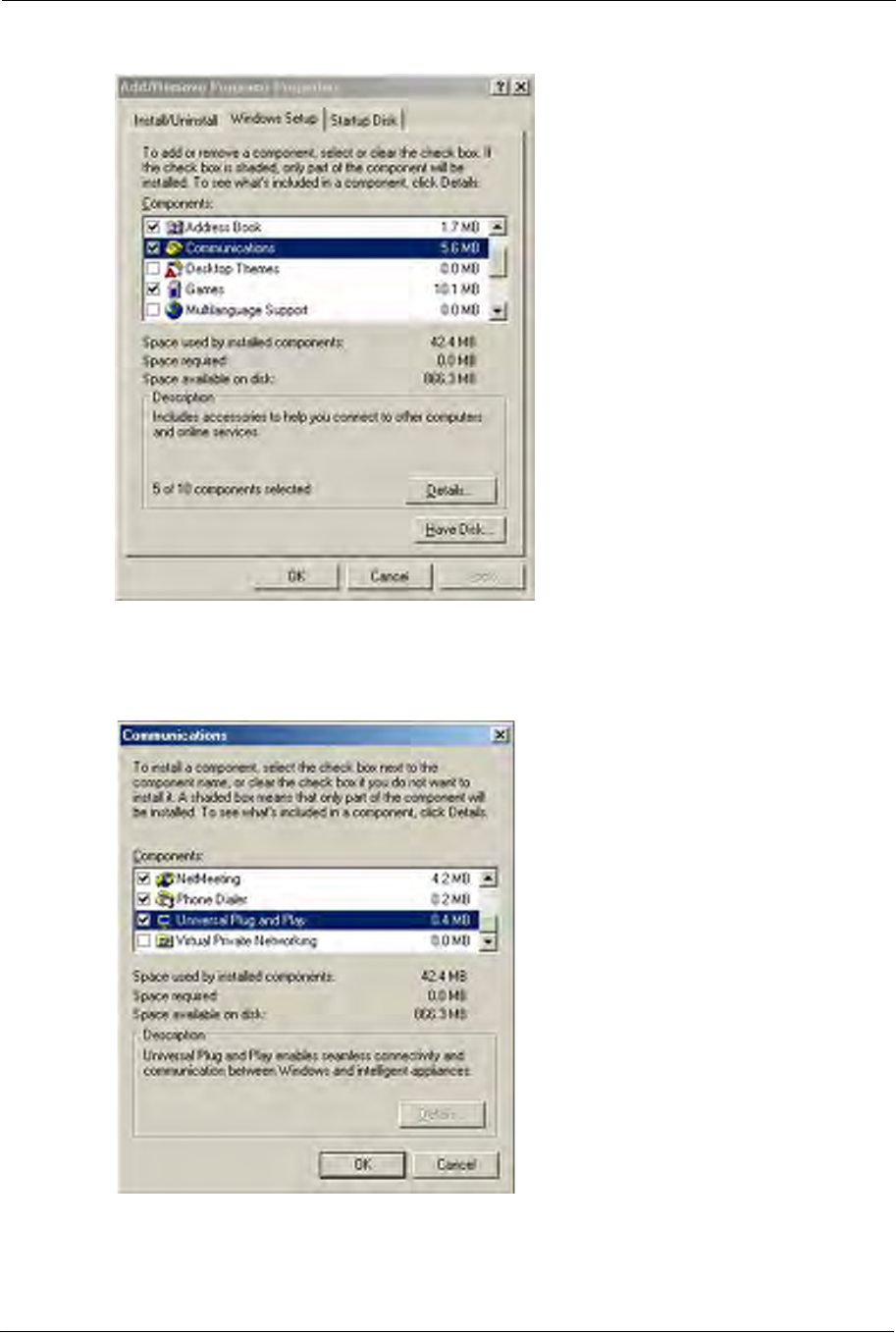
P-660H/HW/W-T Series User’ Guide
165 Chapter 14 Universal Plug-and-Play (UPnP)
Figure 70 Add/Remove Programs: Windows Setup: Communication
3In the Communications window, select the Universal Plug and Play check box in the
Components selection box.
Figure 71 Add/Remove Programs: Windows Setup: Communication: Components
4Click OK to go back to the Add/Remove Programs Properties window and click Next.
5Restart the computer when prompted.
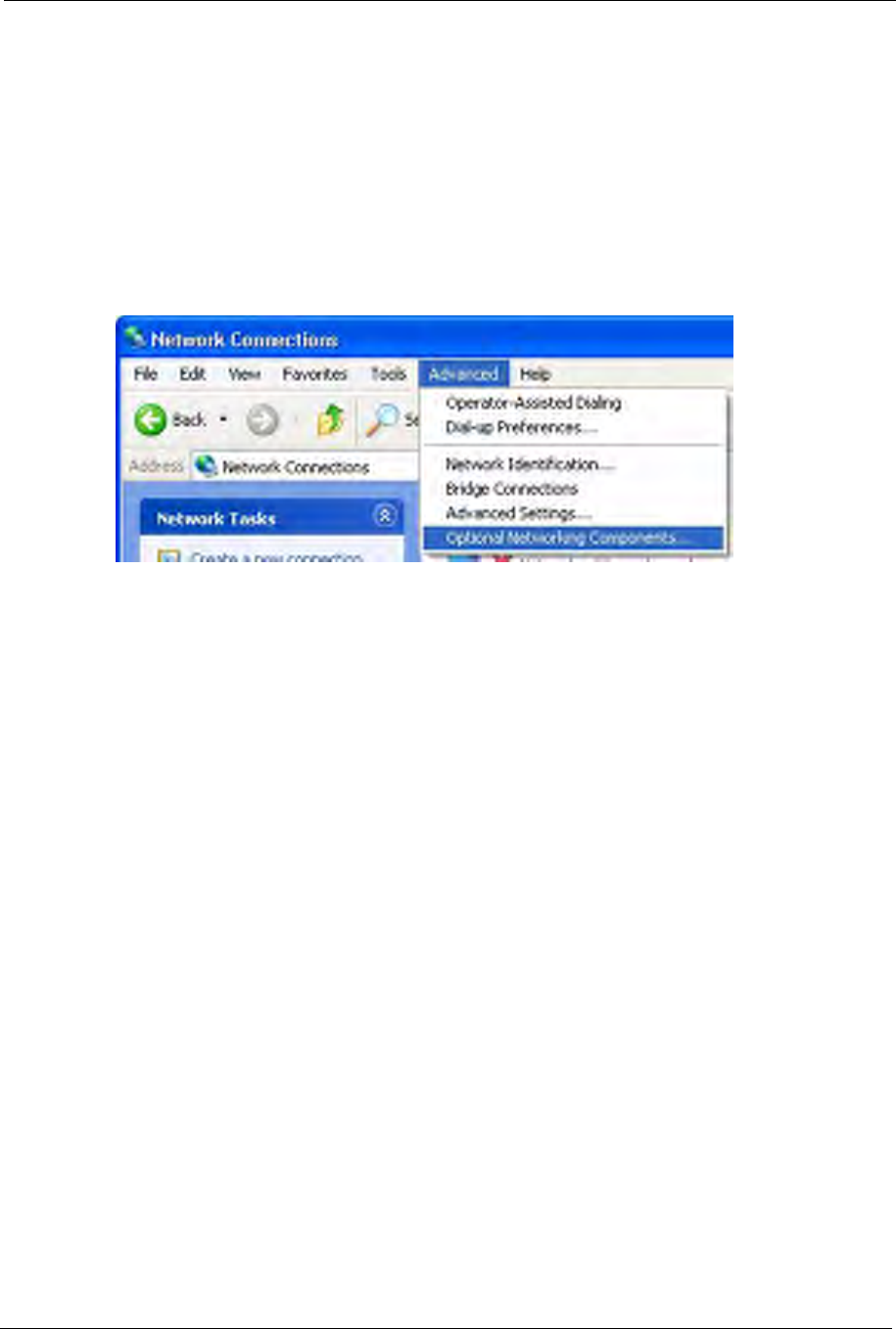
P-660H/HW/W-T Series User’ Guide
Chapter 14 Universal Plug-and-Play (UPnP) 166
Installing UPnP in Windows XP
Follow the steps below to install the UPnP in Windows XP.
1Click Start and Control Panel.
2Double-click Network Connections.
3In the Network Connections window, click Advanced in the main menu and select
Optional Networking Components ….
Figure 72 Network Connections
4The Windows Optional Networking Components Wizard window displays. Select
Networking Service in the Components selection box and click Details.
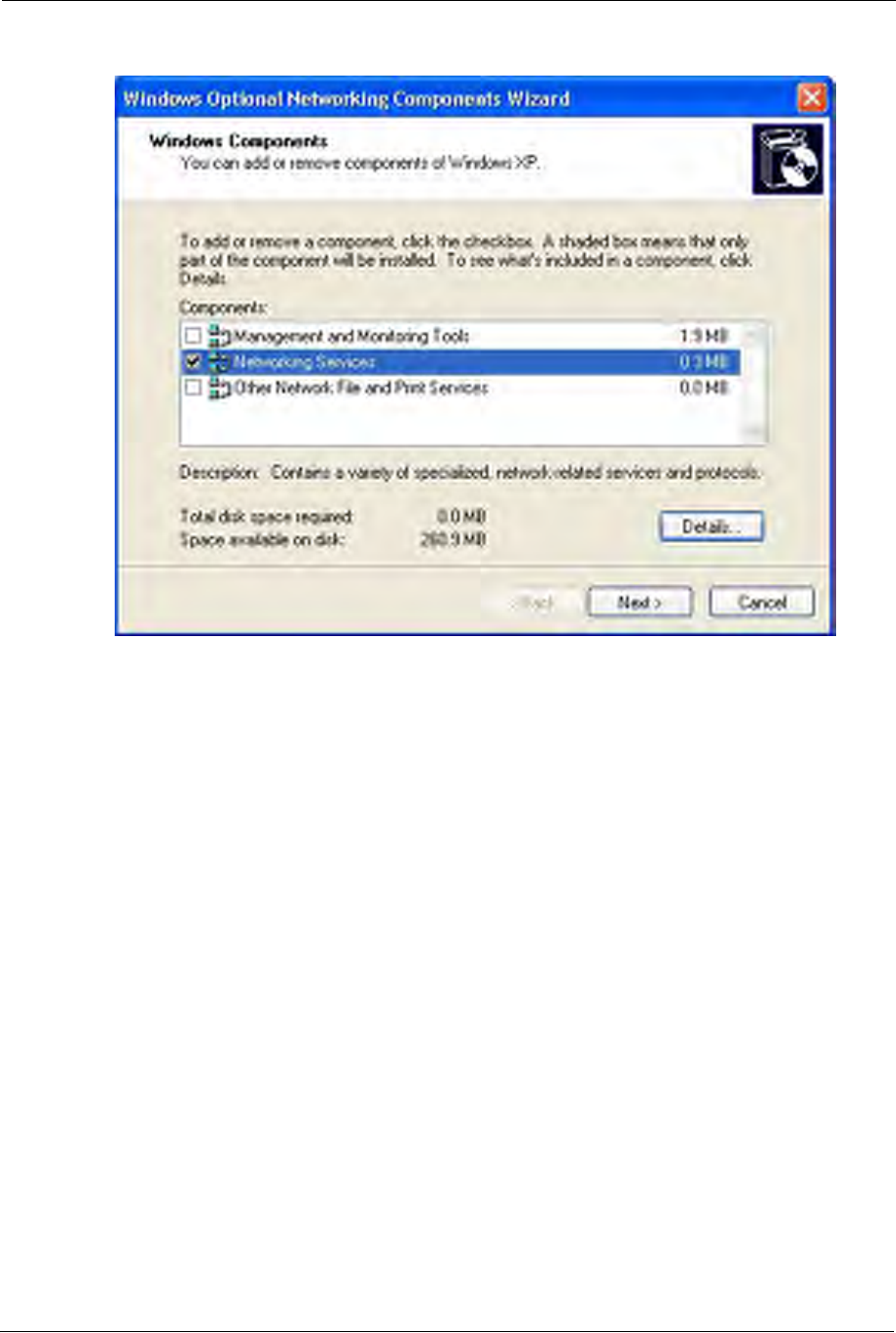
P-660H/HW/W-T Series User’ Guide
167 Chapter 14 Universal Plug-and-Play (UPnP)
Figure 73 Windows Optional Networking Components Wizard
5In the Networking Services window, select the Universal Plug and Play check box.
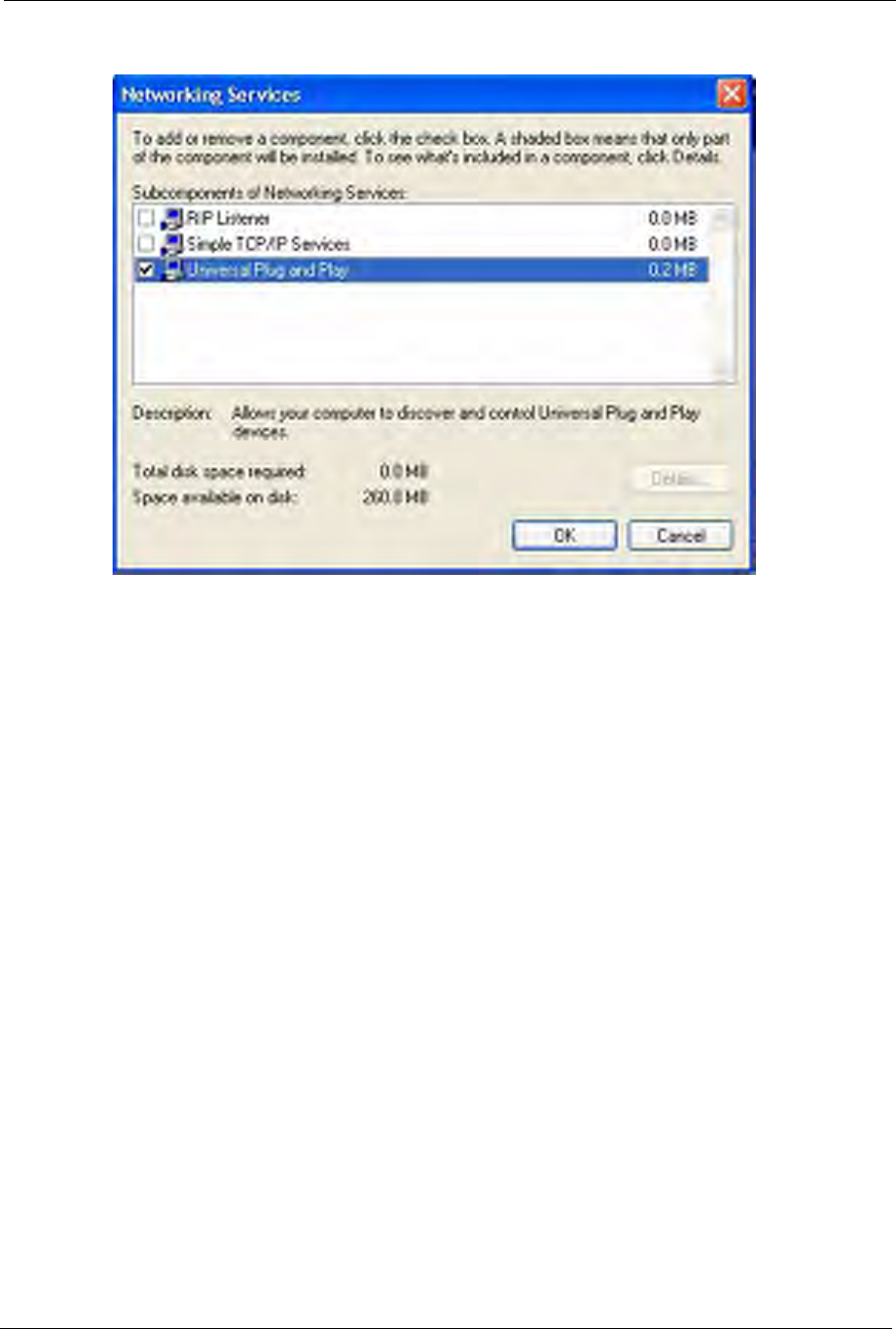
P-660H/HW/W-T Series User’ Guide
Chapter 14 Universal Plug-and-Play (UPnP) 168
Figure 74 Networking Services
6Click OK to go back to the Windows Optional Networking Component Wizard
window and click Next.
14.4 Using UPnP in Windows XP Example
This section shows you how to use the UPnP feature in Windows XP. You must already have
UPnP installed in Windows XP and UPnP activated on the Prestige.
Make sure the computer is connected to a LAN port of the Prestige. Turn on your computer
and the Prestige.
Auto-discover Your UPnP-enabled Network Device
1Click Start and Control Panel. Double-click Network Connections. An icon displays
under Internet Gateway.
2Right-click the icon and select Properties.
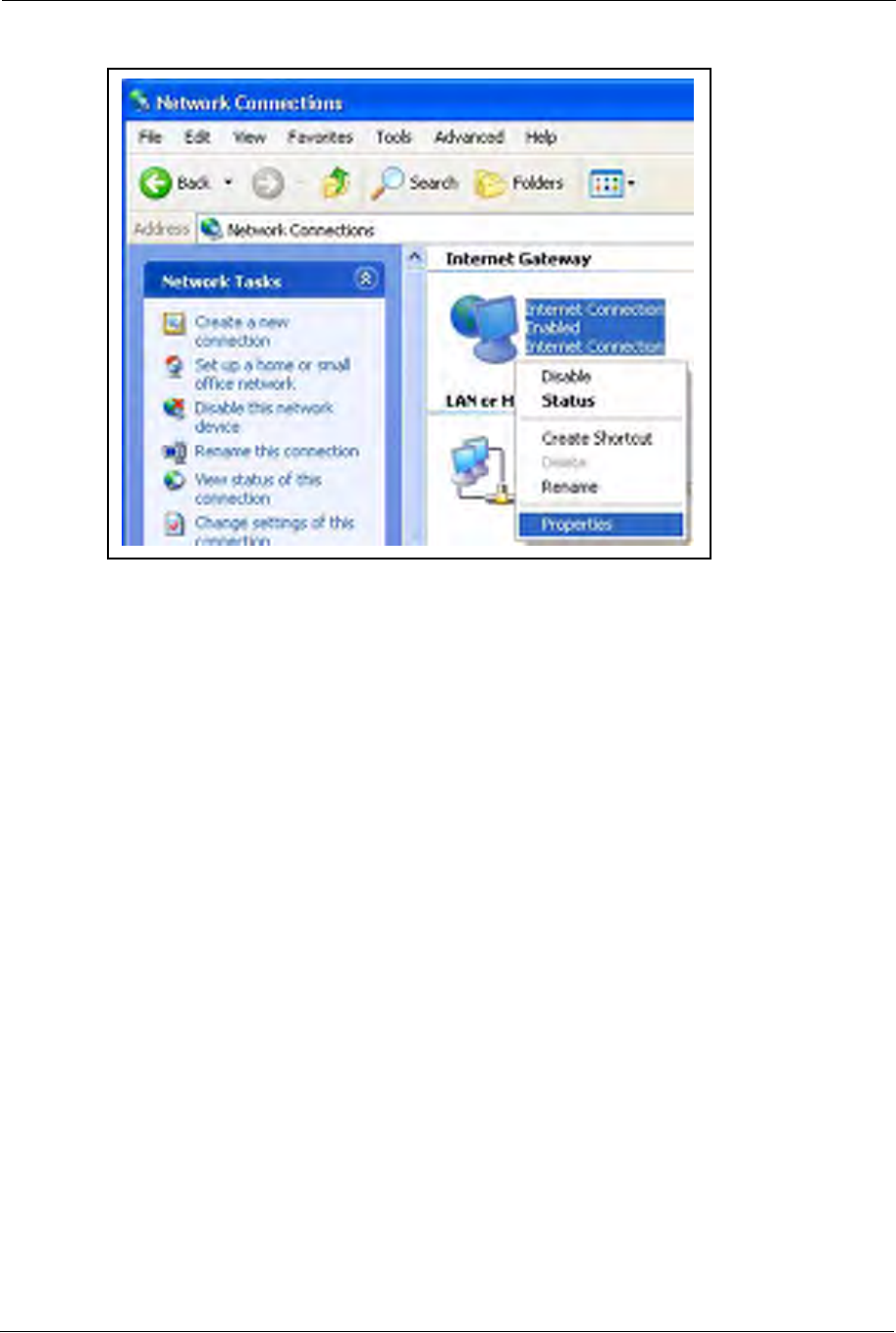
P-660H/HW/W-T Series User’ Guide
169 Chapter 14 Universal Plug-and-Play (UPnP)
Figure 75 Network Connections
3In the Internet Connection Properties window, click Settings to see the port mappings
there were automatically created.
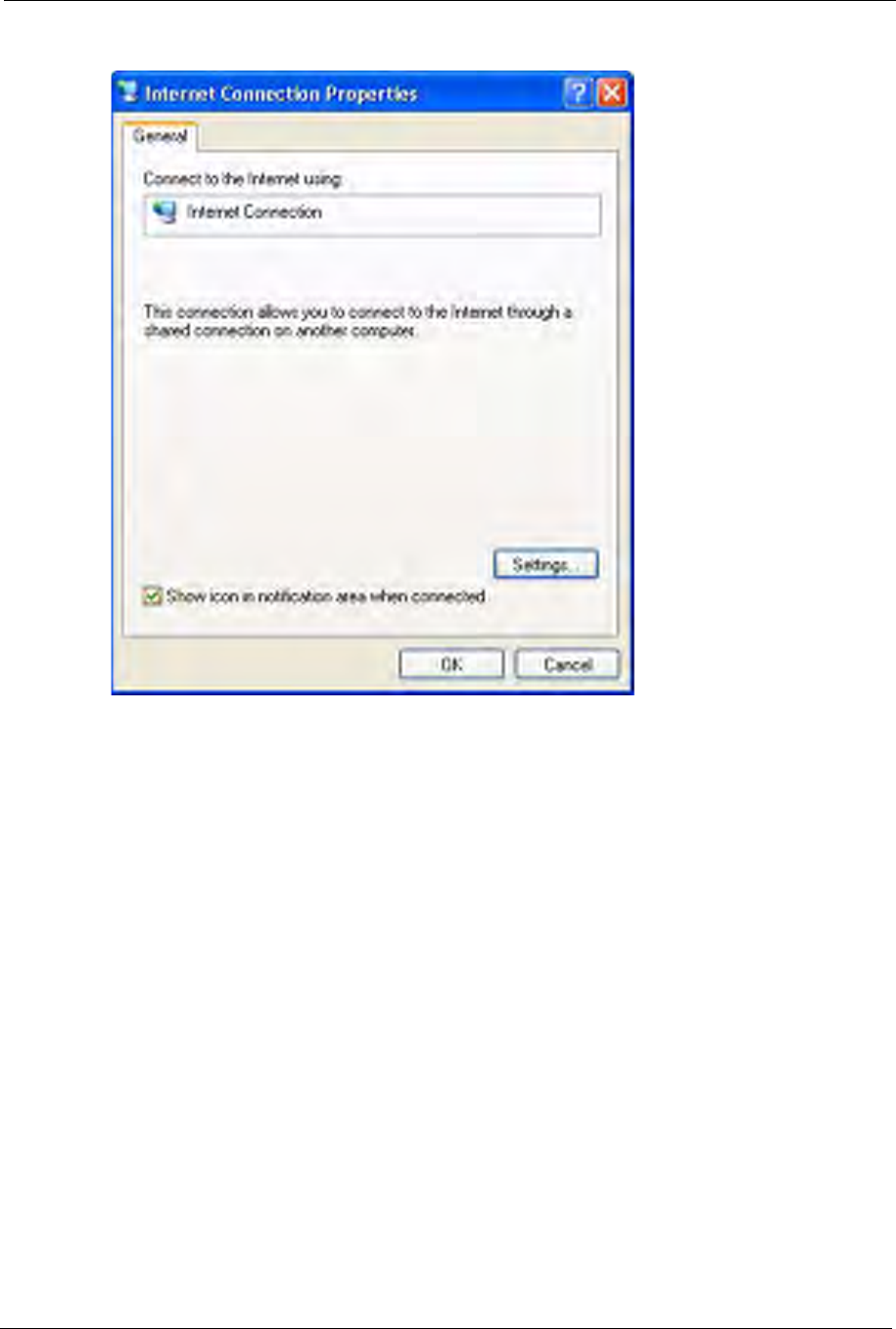
P-660H/HW/W-T Series User’ Guide
Chapter 14 Universal Plug-and-Play (UPnP) 170
Figure 76 Internet Connection Properties
4You may edit or delete the port mappings or click Add to manually add port mappings.
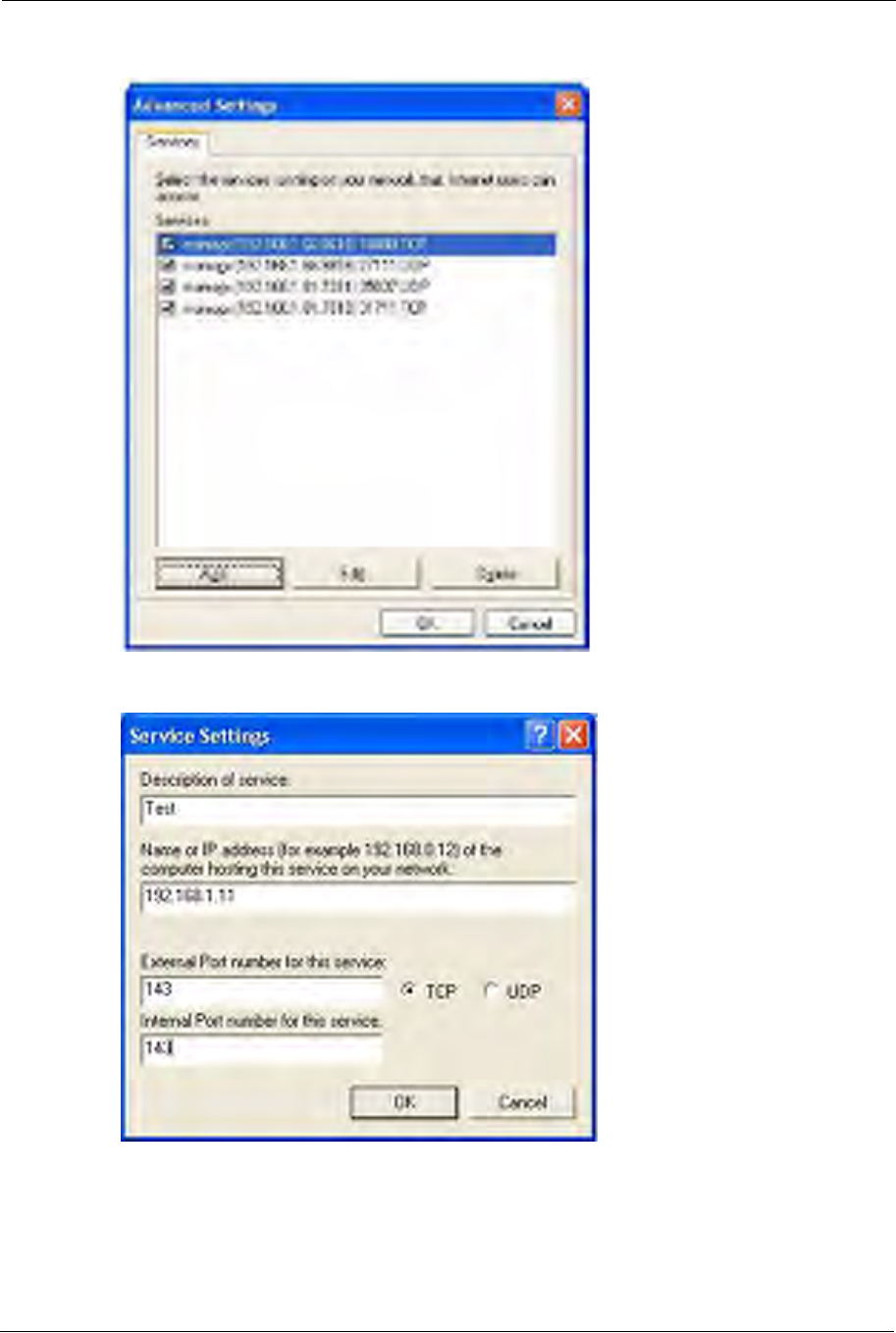
P-660H/HW/W-T Series User’ Guide
171 Chapter 14 Universal Plug-and-Play (UPnP)
Figure 77 Internet Connection Properties: Advanced Settings
Figure 78 Internet Connection Properties: Advanced Settings: Add
5When the UPnP-enabled device is disconnected from your computer, all port mappings
will be deleted automatically.
6Select Show icon in notification area when connected option and click OK. An icon
displays in the system tray.
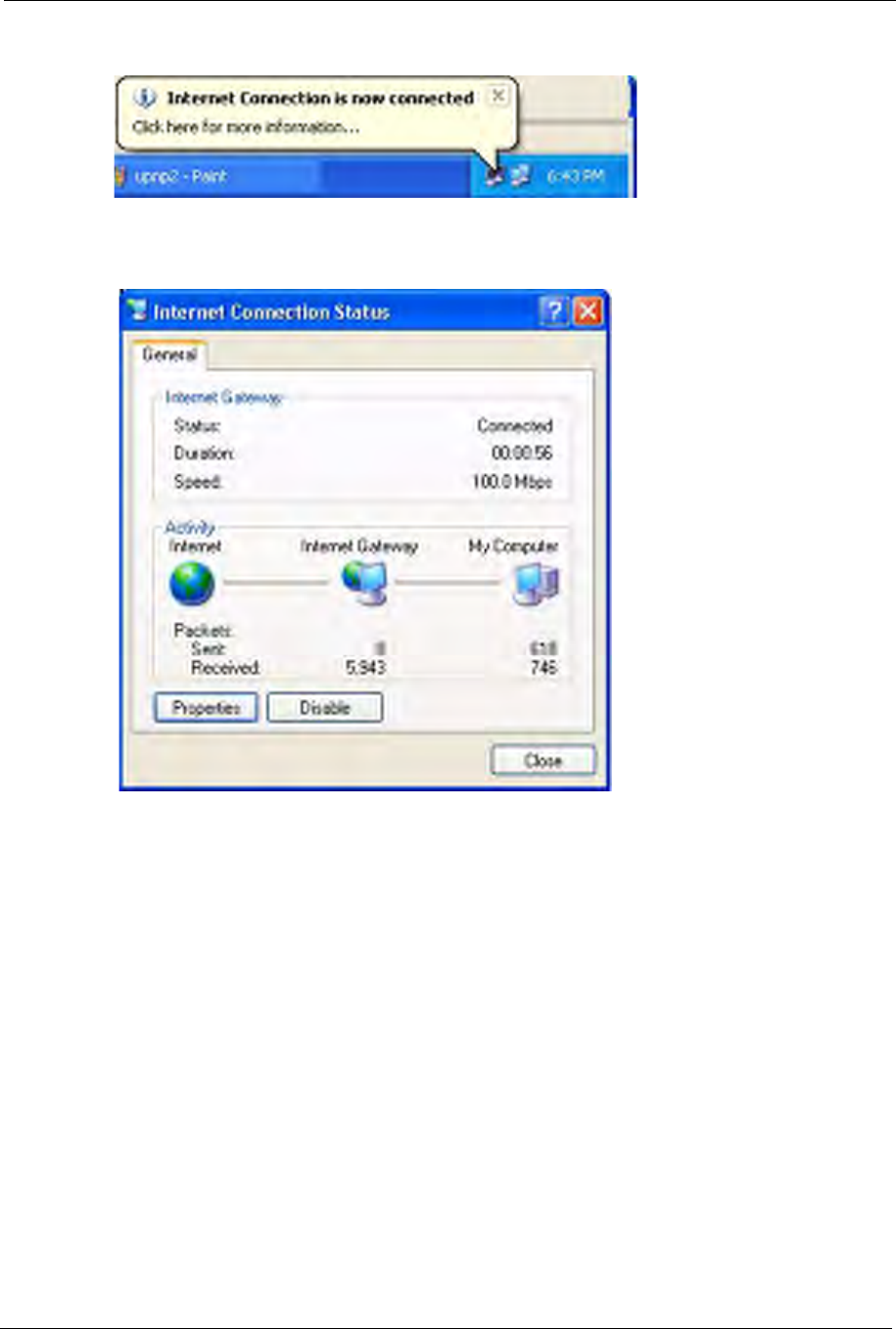
P-660H/HW/W-T Series User’ Guide
Chapter 14 Universal Plug-and-Play (UPnP) 172
Figure 79 System Tray Icon
7Double-click on the icon to display your current Internet connection status.
Figure 80 Internet Connection Status
Web Configurator Easy Access
With UPnP, you can access the web-based configurator on the Prestige without finding out the
IP address of the Prestige first. This comes helpful if you do not know the IP address of the
Prestige.
Follow the steps below to access the web configurator.
1Click Start and then Control Panel.
2Double-click Network Connections.
3Select My Network Places under Other Places.
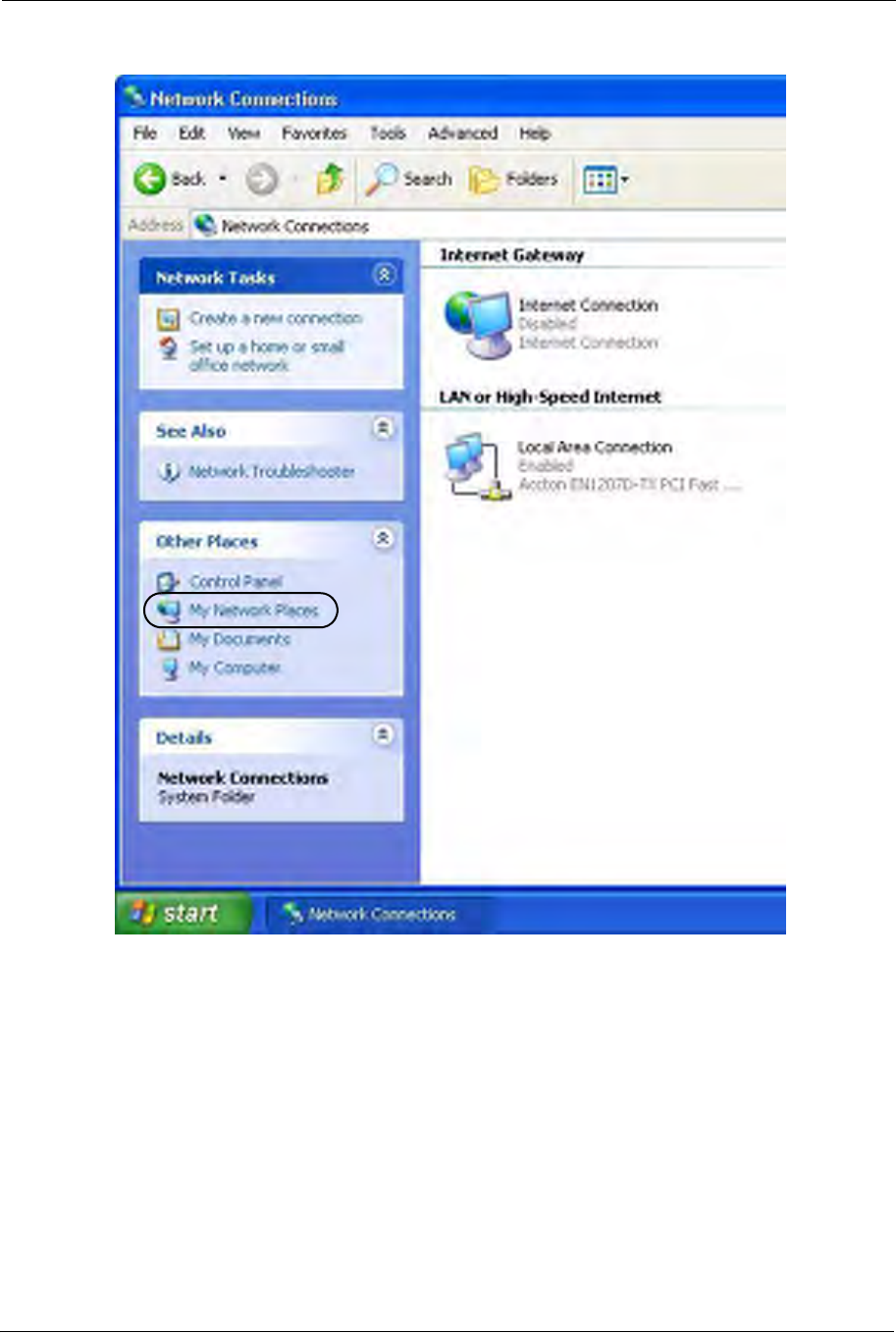
P-660H/HW/W-T Series User’ Guide
173 Chapter 14 Universal Plug-and-Play (UPnP)
Figure 81 Network Connections
4An icon with the description for each UPnP-enabled device displays under Local
Network.
5Right-click on the icon for your Prestige and select Invoke. The web configurator login
screen displays.
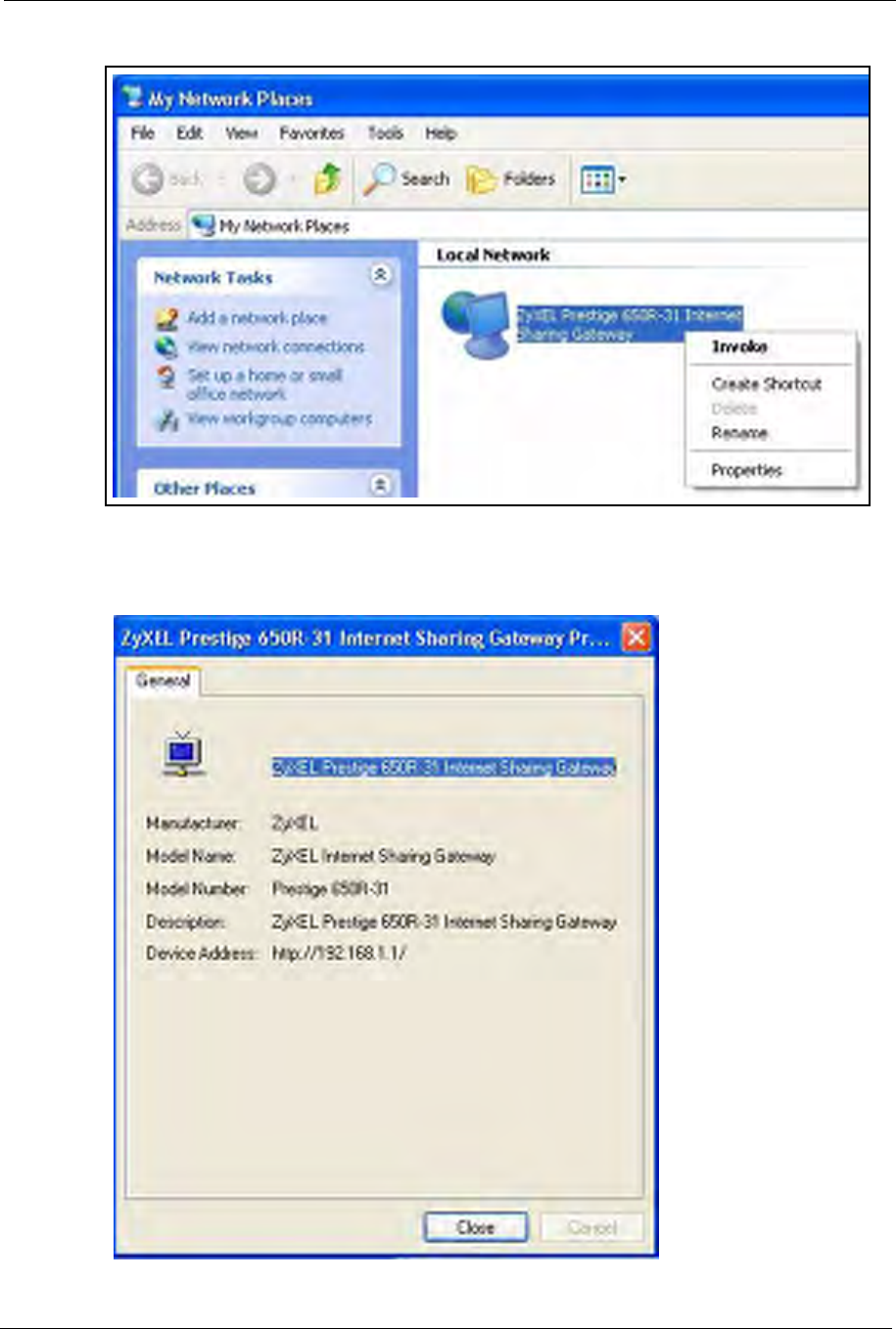
P-660H/HW/W-T Series User’ Guide
Chapter 14 Universal Plug-and-Play (UPnP) 174
Figure 82 Network Connections: My Network Places
6Right-click on the icon for your Prestige and select Properties. A properties window
displays with basic information about the Prestige.
Figure 83 Network Connections: My Network Places: Properties: Example

P-660H/HW/W-T Series User’ Guide
175 Chapter 14 Universal Plug-and-Play (UPnP)

P-660H/HW/W-T Series User’ Guide
Chapter 15 Logs Screens 176
CHAPTER 15
Logs Screens
This chapter contains information about configuring general log settings and viewing the
Prestige’s logs. Refer to the appendix for example log message explanations.
15.1 Logs Overview
The web configurator allows you to choose which categories of events and/or alerts to have
the Prestige log and then display the logs or have the Prestige send them to an administrator
(as e-mail) or to a syslog server.
15.1.1 Alerts and Logs
An alert is a type of log that warrants more serious attention. They include system errors,
attacks (access control) and attempted access to blocked web sites. Some categories such as
System Errors consist of both logs and alerts. You may differentiate them by their color in the
View Log screen. Alerts display in red and logs display in black.
15.2 Configuring Log Settings
Use the Log Settings screen to configure to where the Prestige is to send logs; the schedule for
when the Prestige is to send the logs and which logs and/or immediate alerts the Prestige is to
record. See Section 15.1 on page 176 for more information.
To change your Prestige’s log settings, click Logs, then the Log Settings. The screen appears
as shown.
Alerts are e-mailed as soon as they happen. Logs may be e-mailed as soon as the log is full.
Selecting many alert and/or log categories (especially Access Control) may result in many e-
mails being sent.
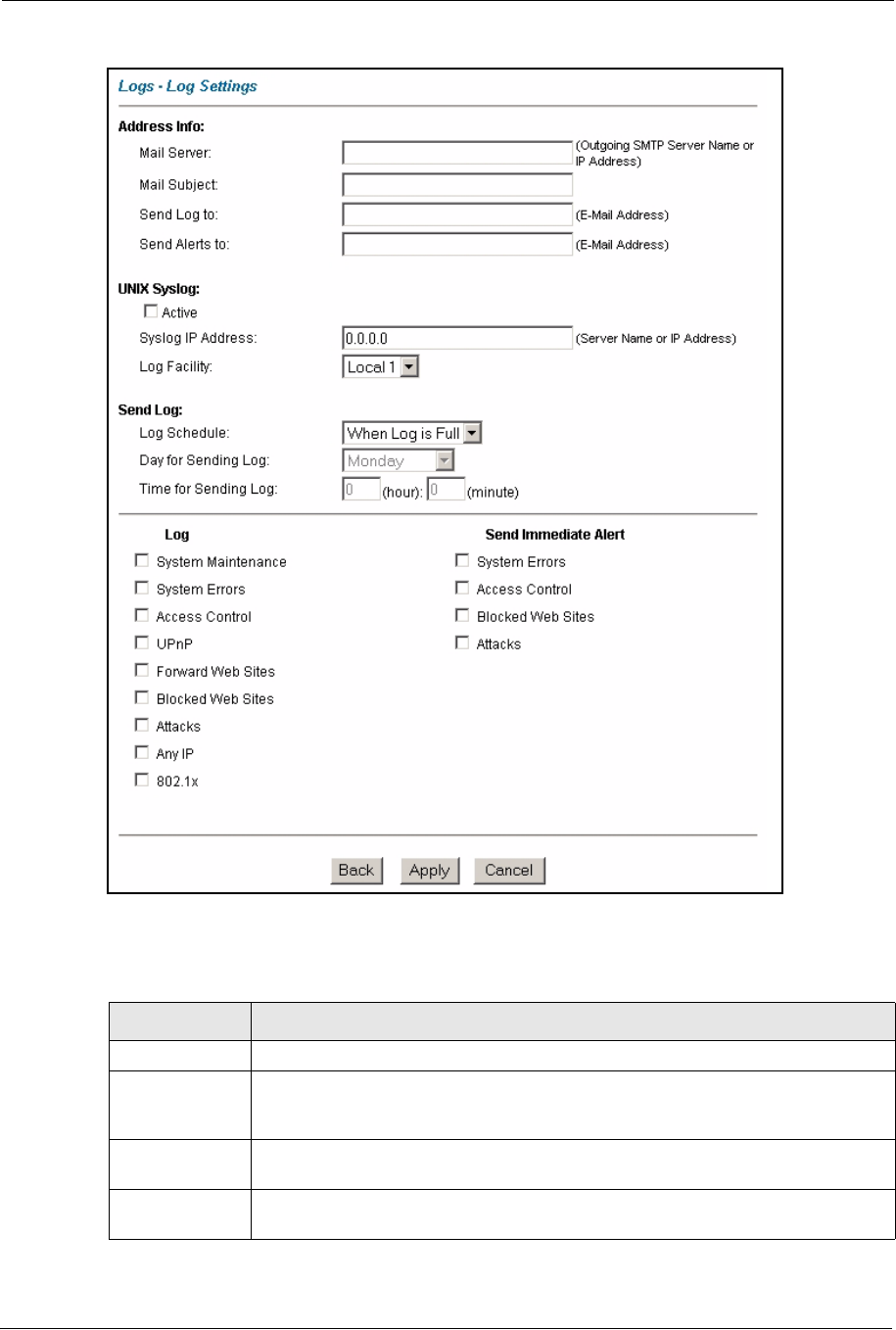
P-660H/HW/W-T Series User’ Guide
177 Chapter 15 Logs Screens
Figure 84 Log Settings
The following table describes the fields in this screen.
Table 51 Log Settings
LABEL DESCRIPTION
Address Info
Mail Server Enter the server name or the IP address of the mail server for the e-mail addresses
specified below. If this field is left blank, logs and alert messages will not be sent via
e-mail.
Mail Subject Type a title that you want to be in the subject line of the log e-mail message that the
Prestige sends.
Send log to Logs are sent to the e-mail address specified in this field. If this field is left blank,
logs will not be sent via e-mail.

P-660H/HW/W-T Series User’ Guide
Chapter 15 Logs Screens 178
15.3 Displaying the Logs
Click Logs and then View Log to open the View Logs screen. Use the View Logs screen to
see the logs for the categories that you selected in the Log Settings screen (see Section 15.2 on
page 176).
Log entries in red indicate alerts. The log wraps around and deletes the old entries after it fills.
Click a column heading to sort the entries. A triangle indicates ascending or descending sort
order.
Send alerts to Alerts are sent to the e-mail address specified in this field. If this field is left blank,
alerts will not be sent via e-mail.
UNIX Syslog Syslog logging sends a log to an external syslog server used to store logs.
Active Click Active to enable syslog logging.
Syslog IP
Address
Enter the server name or IP address of the syslog server that will log the selected
categories of logs.
Log Facility Select a location from the drop down list box. The log facility allows you to log the
messages to different files in the syslog server. Refer to the documentation of your
syslog program for more details.
Send Log
Log Schedule This drop-down menu is used to configure the frequency of log messages being
sent as E-mail:
• Daily
• Weekly
• Hourly
• When Log is Full
• None.
If you select Weekly or Daily, specify a time of day when the E-mail should be sent.
If you select Weekly, then also specify which day of the week the E-mail should be
sent. If you select When Log is Full, an alert is sent when the log fills up. If you
select None, no log messages are sent
Day for Sending
Log
Use the drop down list box to select which day of the week to send the logs.
Time for Sending
Log
Enter the time of the day in 24-hour format (for example 23:00 equals 11:00 pm) to
send the logs.
Log Select the categories of logs that you want to record. Logs include alerts.
Send Immediate
Alert
Select the categories of alerts for which you want the Prestige to instantly e-mail
alerts to the e-mail address specified in the Send Alerts To field.
Back Click Back to return to the previous screen.
Apply Click Apply to save your customized settings and exit this screen.
Cancel Click Cancel to return to the previously saved settings.
Table 51 Log Settings
LABEL DESCRIPTION
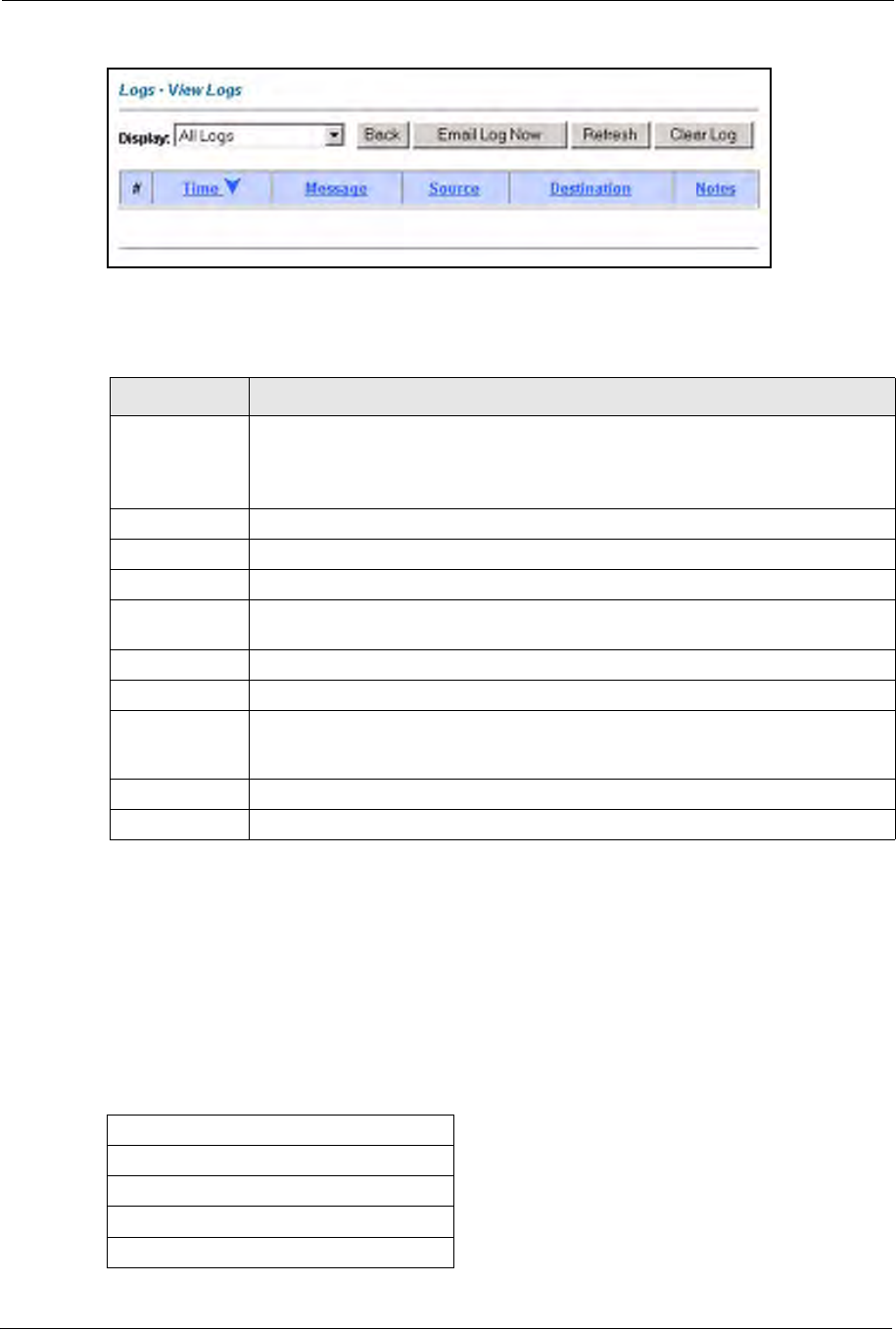
P-660H/HW/W-T Series User’ Guide
179 Chapter 15 Logs Screens
Figure 85 View Logs
The following table describes the fields in this screen.
15.4 SMTP Error Messages
If there are difficulties in sending e-mail the following error messages appear.
E-mail error messages appear in SMT menu 24.3.1 as "SMTP action request failed. ret= ??".
The “??"are described in the following table.
Table 52 View Logs
LABEL DESCRIPTION
Display The categories that you select in the Log Settings screen display in the drop-down
list box.
Select a category of logs to view; select All Logs to view logs from all of the log
categories that you selected in the Log Settings page.
Time This field displays the time the log was recorded.
Message This field states the reason for the log.
Source This field lists the source IP address and the port number of the incoming packet.
Destination This field lists the destination IP address and the port number of the incoming
packet.
Notes This field displays additional information about the log entry.
Back Click Back to return to the previous screen
Email Log Now Click Email Log Now to send the log screen to the e-mail address specified in the
Log Settings page (make sure that you have first filled in the Address Info fields in
Log Settings).
Refresh Click Refresh to renew the log screen.
Clear Log Click Clear Log to delete all the logs.
Table 53 SMTP Error Messages
-1 means Prestige out of socket
-2 means tcp SYN fail
-3 means smtp server OK fail
-4 means HELO fail
-5 means MAIL FROM fail

P-660H/HW/W-T Series User’ Guide
Chapter 15 Logs Screens 180
15.4.1 Example E-mail Log
An "End of Log" message displays for each mail in which a complete log has been sent. The
following is an example of a log sent by e-mail.
• You may edit the subject title.
• The date format here is Day-Month-Year.
• The date format here is Month-Day-Year. The time format is Hour-Minute-Second.
•"
End of Log" message shows that a complete log has been sent.
Figure 86 E-mail Log Example
-6 means RCPT TO fail
-7 means DATA fail
-8 means mail data send fail
Table 53 SMTP Error Messages
Subject:
Firewall Alert From Prestige
Date:
Fri, 07 Apr 2000 10:05:42
From:
user@zyxel.com
To:
user@zyxel.com
1|Apr 7 00 |From:192.168.1.1 To:192.168.1.255 |default policy |forward
| 09:54:03 |UDP src port:00520 dest port:00520 |<1,00> |
2|Apr 7 00 |From:192.168.1.131 To:192.168.1.255 |default policy |forward
| 09:54:17 |UDP src port:00520 dest port:00520 |<1,00> |
3|Apr 7 00 |From:192.168.1.6 To:10.10.10.10 |match |forward
| 09:54:19 |UDP src port:03516 dest port:00053 |<1,01> |
……………………………..{snip}…………………………………..
……………………………..{snip}…………………………………..
126|Apr 7 00 |From:192.168.1.1 To:192.168.1.255 |match |forward
| 10:05:00 |UDP src port:00520 dest port:00520 |<1,02> |
127|Apr 7 00 |From:192.168.1.131 To:192.168.1.255 |match |forward
| 10:05:17 |UDP src port:00520 dest port:00520 |<1,02> |
128|Apr 7 00 |From:192.168.1.1 To:192.168.1.255 |match |forward
| 10:05:30 |UDP src port:00520 dest port:00520 |<1,02> |
End of Firewall Log

P-660H/HW/W-T Series User’ Guide
181 Chapter 15 Logs Screens

P-660H/HW/W-T Series User’ Guide
Chapter 16 Media Bandwidth Management Advanced Setup 182
CHAPTER 16
Media Bandwidth Management
Advanced Setup
This chapter describes bandwidth management with one level of child class.
16.1 Media Bandwidth Management Overview
Bandwidth management allows you to allocate an interface’s outgoing capacity to specific
types of traffic. It can also help you make sure that the Prestige forwards certain types of
traffic (especially real-time applications) with minimum delay. With the use of real-time
applications such as Voice-over-IP (VoIP) increasing, the requirement for bandwidth
allocation is also increasing.
Bandwidth management addresses questions such as:
• Who gets how much access to specific applications?
• What priority level should you give to each type of traffic?
• Which traffic must have guaranteed delivery?
• How much bandwidth should be allotted to guarantee delivery?
Bandwidth management also allows you to configure the allowed output for an interface to
match what the network can handle. This helps reduce delays and dropped packets at the next
routing device. For example, you can set the WAN interface speed to 1000kbps if the ADSL
connection has an upstream speed of 1Mbps. All configuration screens display measurements
in kbps (kilobits per second), but this User’s Guide also uses Mbps (megabits per second) for
brevity’s sake.
Refer to Section 16.9 on page 188 to enable and configure bandwidth on the interfaces.
Refer to Section 16.10 on page 190 to configure bandwidth classes.
Refer to Section 16.11 on page 194 to view bandwidth usage information.
16.2 Bandwidth Classes and Filters
Use bandwidth classes and child-classes to allocate specific amounts of bandwidth capacity
(bandwidth budgets). Configure a bandwidth filter to define a bandwidth class (or child-class)
based on a specific application and/or subnet. Use the Class Configuration screen (see
Section 16.10 on page 190) to set up a bandwidth class’s name, bandwidth allotment, and
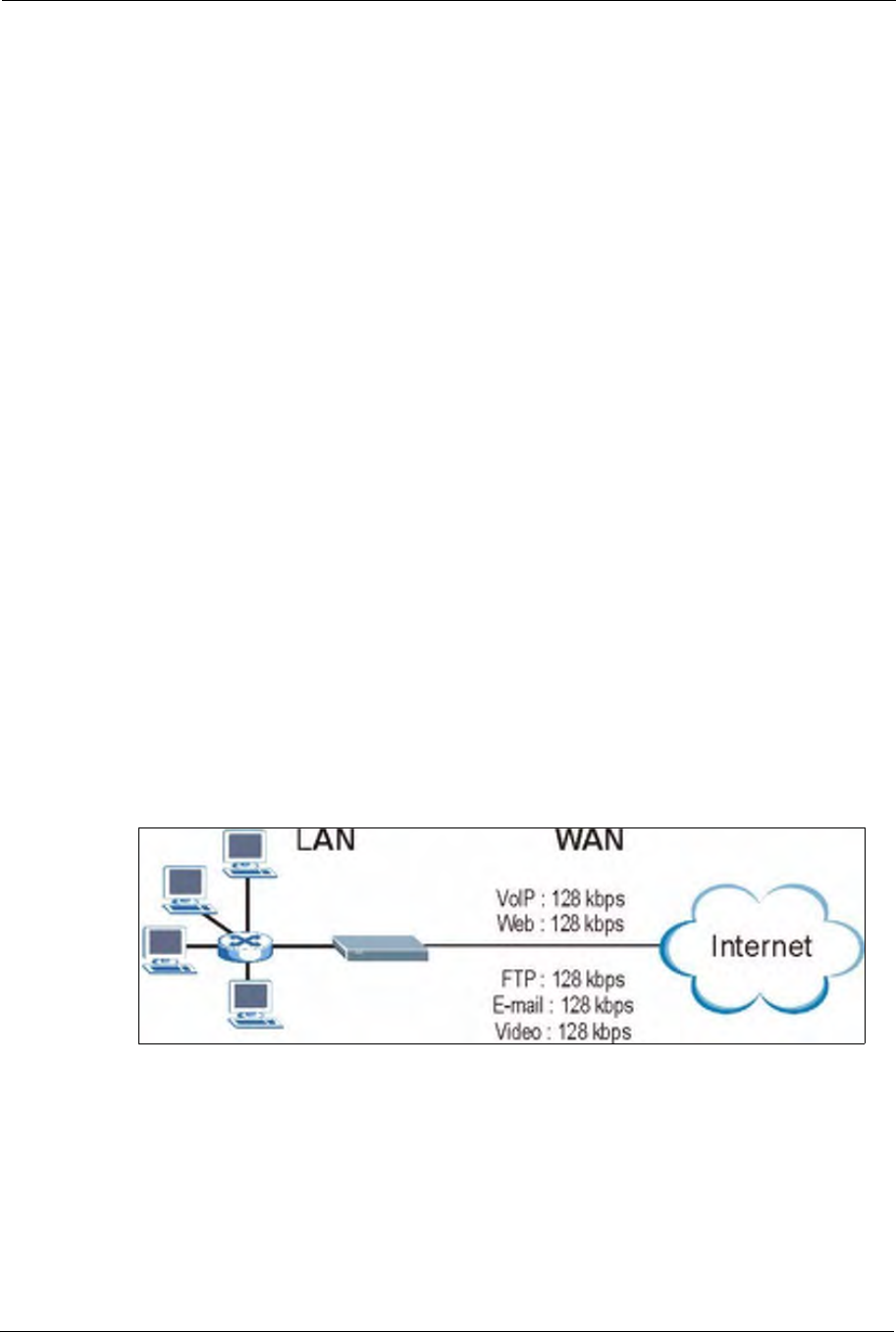
P-660H/HW/W-T Series User’ Guide
183 Chapter 16 Media Bandwidth Management Advanced Setup
bandwidth filter. You can configure up to one bandwidth filter per bandwidth class. You can
also configure bandwidth classes without bandwidth filters. However, it is recommended that
you configure child-classes with filters for any classes that you configure without filters. The
Prestige leaves the bandwidth budget allocated and unused for a class that does not have a
filter itself or child-classes with filters. View your configured bandwidth classes and child-
classes in the Class Setup screen (see Section 16.10 on page 190 for details).
The total of the configured bandwidth budgets for child-classes cannot exceed the configured
bandwidth budget speed of the parent class.
16.3 Proportional Bandwidth Allocation
Bandwidth management allows you to define how much bandwidth each class gets; however,
the actual bandwidth allotted to each class decreases or increases in proportion to actual
available bandwidth.
16.4 Bandwidth Management Usage Examples
These examples show bandwidth management allotments on a WAN interface that is
configured for 640Kbps.
16.4.1 Application-based Bandwidth Management Example
The bandwidth classes in the following example are based solely on application. Each
bandwidth class (VoIP, Web, FTP, E-mail and Video) is allotted 128kbps.
Figure 87 Application-based Bandwidth Management Example
16.4.2 Subnet-based Bandwidth Management Example
The following example uses bandwidth classes based solely on LAN subnets. Each bandwidth
class (Subnet A and Subnet B) is allotted 320kbps.
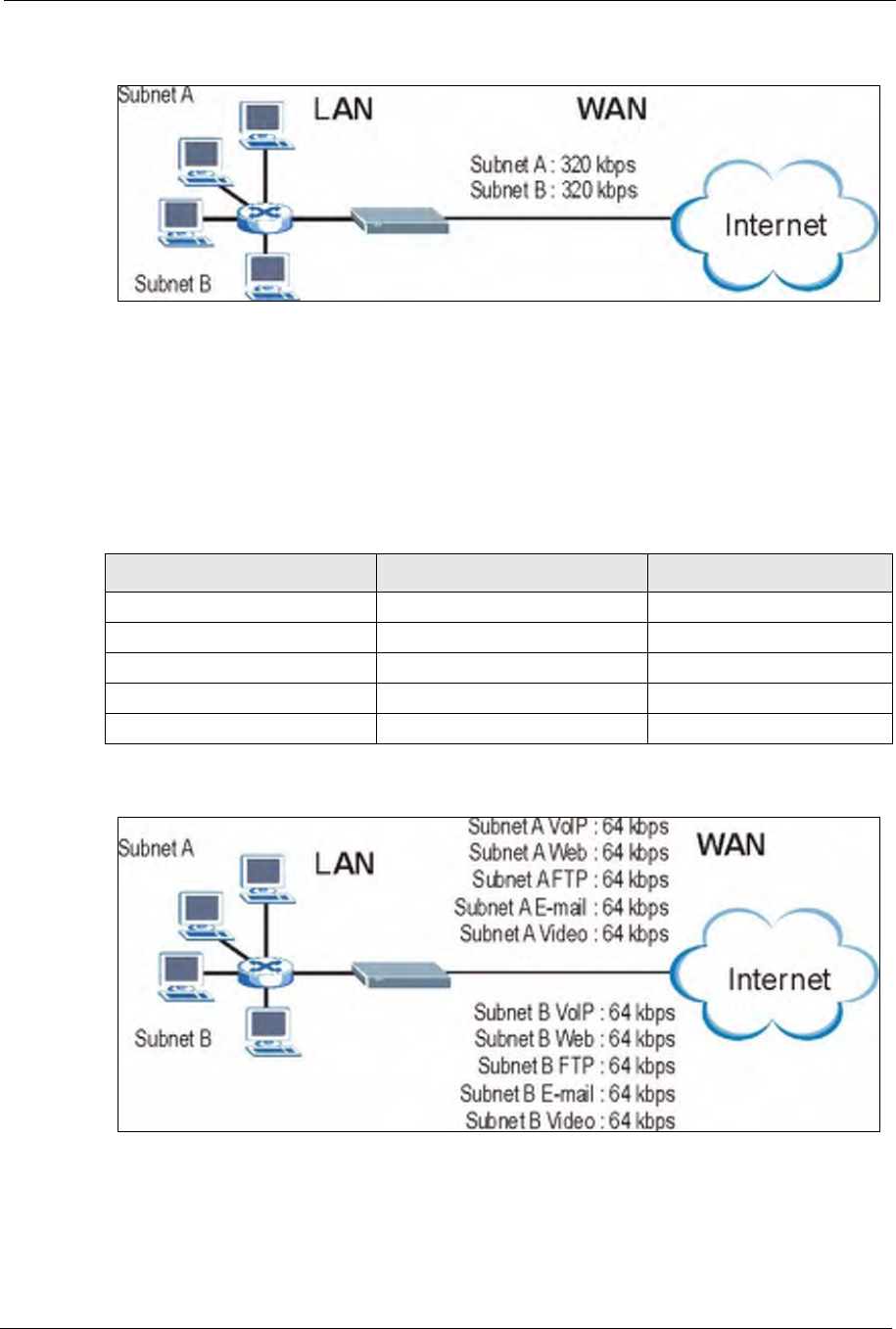
P-660H/HW/W-T Series User’ Guide
Chapter 16 Media Bandwidth Management Advanced Setup 184
Figure 88 Subnet-based Bandwidth Management Example
16.4.3 Application and Subnet-based Bandwidth Management
Example
The following example uses bandwidth classes based on LAN subnets and applications
(specific applications in each subnet are allotted bandwidth).
Figure 89 Application and Subnet-based Bandwidth Management Example
Table 54 Application and Subnet-based Bandwidth Management Example
TRAFFIC TYPE FROM SUBNET A FROM SUBNET B
VoIP 64 kbps 64 kbps
Web 64 kbps 64 kbps
FTP 64 kbps 64 kbps
E-mail 64 kbps 64 kbps
Video 64 kbps 64 kbps

P-660H/HW/W-T Series User’ Guide
185 Chapter 16 Media Bandwidth Management Advanced Setup
16.5 Scheduler
The scheduler divides up an interface’s bandwidth among the bandwidth classes. The Prestige
has two types of scheduler: fairness-based and priority-based.
16.5.1 Priority-based Scheduler
With the priority-based scheduler, the Prestige forwards traffic from bandwidth classes
according to the priorities that you assign to the bandwidth classes. The larger a bandwidth
class’s priority number is, the higher the priority. Assign real-time applications (like those
using audio or video) a higher priority number to provide smoother operation.
16.5.2 Fairness-based Scheduler
The Prestige divides bandwidth equally among bandwidth classes when using the fairness-
based scheduler; thus preventing one bandwidth class from using all of the interface’s
bandwidth.
16.6 Maximize Bandwidth Usage
The maximize bandwidth usage option (see Section 16.7.1 on page 187) allows the Prestige to
divide up any available bandwidth on the interface (including unallocated bandwidth and any
allocated bandwidth that a class is not using) among the bandwidth classes that require more
bandwidth.
When you enable maximize bandwidth usage, the Prestige first makes sure that each
bandwidth class gets up to its bandwidth allotment. Next, the Prestige divides up an interface’s
available bandwidth (bandwidth that is unbudgeted or unused by the classes) depending on
how many bandwidth classes require more bandwidth and on their priority levels. When only
one class requires more bandwidth, the Prestige gives extra bandwidth to that class.
When multiple classes require more bandwidth, the Prestige gives the highest priority classes
the available bandwidth first (as much as they require, if there is enough available bandwidth),
and then to lower priority classes if there is still bandwidth available. The Prestige distributes
the available bandwidth equally among classes with the same priority level.
16.6.1 Reserving Bandwidth for Non-Bandwidth Class Traffic
Do the following three steps to configure the Prestige to allow bandwidth for traffic that is not
defined in a bandwidth filter.
1Leave some of the interface’s bandwidth unbudgeted.
2Do not enable the interface’s Maximize Bandwidth Usage option.
3Do not enable bandwidth borrowing on the child-classes that have the root class as their
parent (see Section 16.7 on page 187).
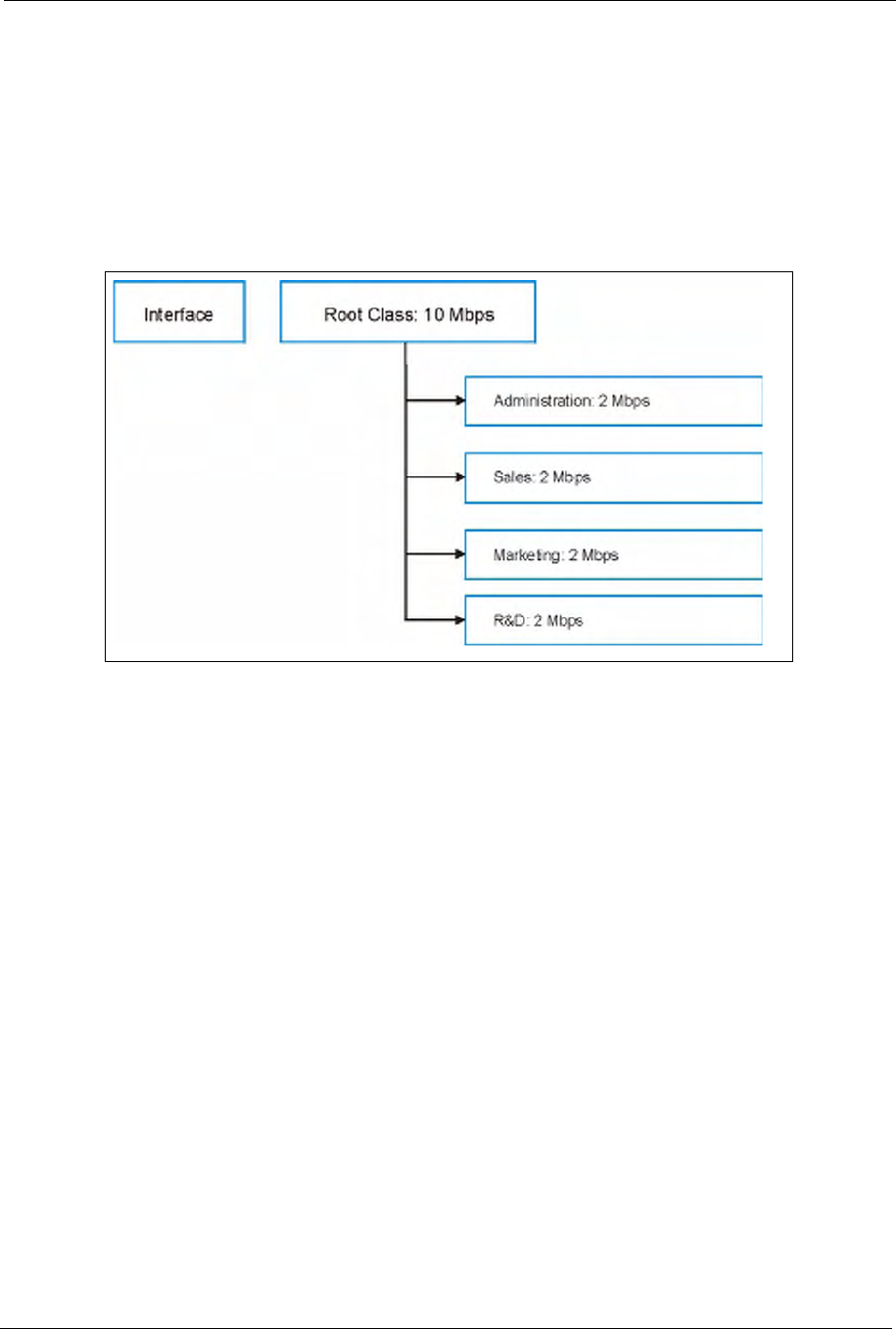
P-660H/HW/W-T Series User’ Guide
Chapter 16 Media Bandwidth Management Advanced Setup 186
16.6.2 Maximize Bandwidth Usage Example
Here is an example of a Prestige that has maximized bandwidth usage enabled on an interface.
The first figure shows each bandwidth class’s bandwidth budget and priority. The classes are
set up based on subnets. The interface is set to 10 Mbps. Each subnet is allocated 2 Mbps. The
unbudgeted 2 Mbps allows traffic not defined in one of the bandwidth filters to go out when
you do not select the maximize bandwidth option.
Figure 90 Bandwidth Allotment Example
The following figure shows the bandwidth usage with the maximize bandwidth usage option
enabled. The Prestige divides up the unbudgeted 2 Mbps among the classes that require more
bandwidth. If the administration department only uses 1 Mbps of the budgeted 2 Mbps, the
Prestige also divides the remaining 1 Mbps among the classes that require more bandwidth.
Therefore, the Prestige divides a total of 3 Mbps total of unbudgeted and unused bandwidth
among the classes that require more bandwidth.
In this case, suppose that all of the classes except for the administration class need more
bandwidth.
• Each class gets up to its budgeted bandwidth. The administration class only uses 1 Mbps
of its budgeted 2 Mbps.
• Sales and Marketing are first to get extra bandwidth because they have the highest
priority (6). If they each require 1.5 Mbps or more of extra bandwidth, the Prestige
divides the total 3 Mbps total of unbudgeted and unused bandwidth equally between the
sales and marketing departments (1.5 Mbps extra to each for a total of 3.5 Mbps for each)
because they both have the highest priority level.
• R&D requires more bandwidth but only gets its budgeted 2 Mbps because all of the
unbudgeted and unused bandwidth goes to the higher priority sales and marketing
classes.
• The Prestige does not send any traffic that is not defined in the bandwidth filters because
all of the unbudgeted bandwidth goes to the classes that need it.
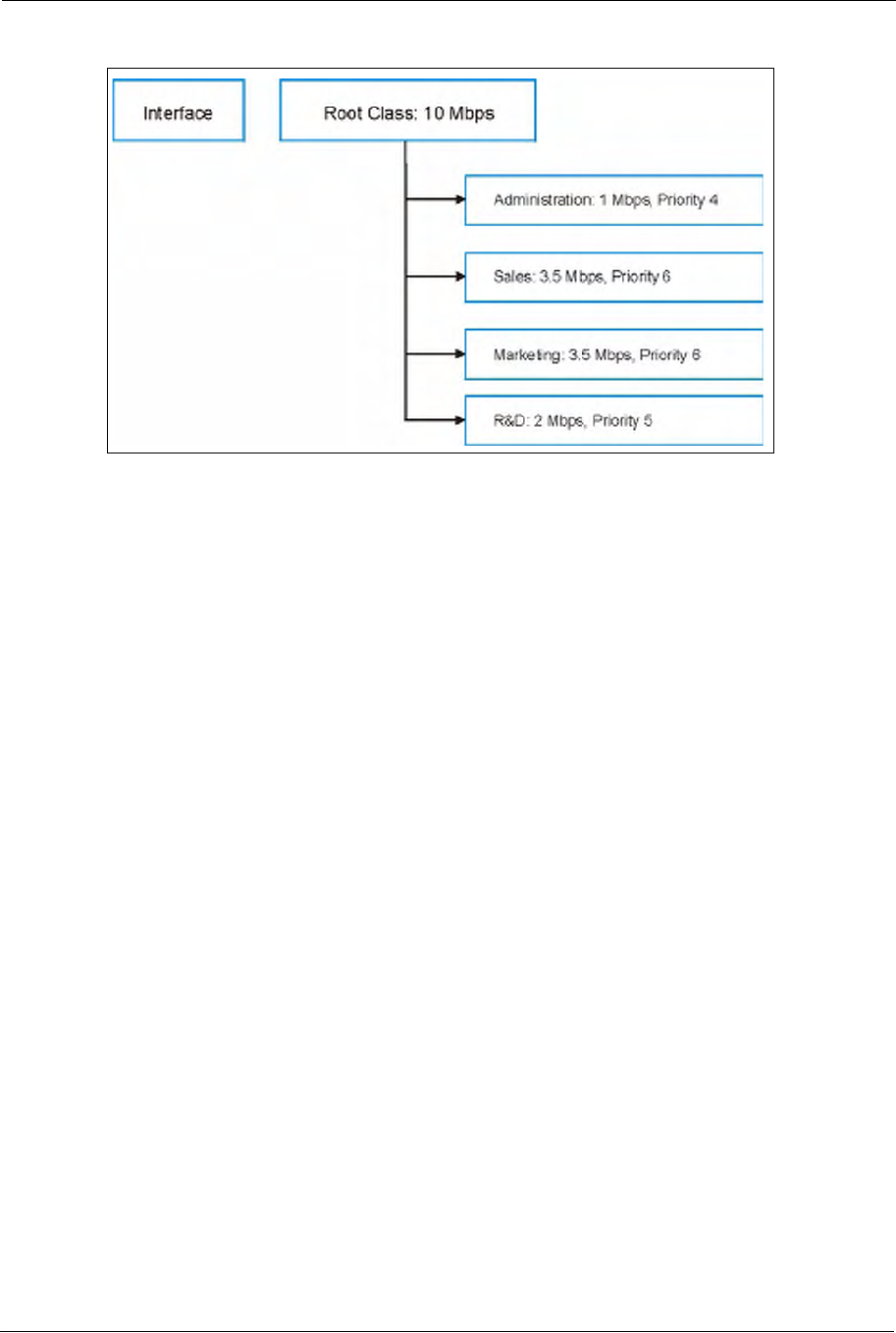
P-660H/HW/W-T Series User’ Guide
187 Chapter 16 Media Bandwidth Management Advanced Setup
Figure 91 Maximize Bandwidth Usage Example
16.7 Bandwidth Borrowing
Bandwidth borrowing allows a child-class to borrow unused bandwidth from its parent class,
whereas maximize bandwidth usage allows bandwidth classes to borrow any unused or
unbudgeted bandwidth on the whole interface.
Enable bandwidth borrowing on a child-class to allow the child-class to use its parent class’s
unused bandwidth. A parent class’s unused bandwidth is given to the highest-priority child-
class that has bandwidth borrowing configured, first.
The total of the bandwidth allotments for child-classes cannot exceed the bandwidth allotment
of their parent class. The Prestige uses the scheduler to divide a parent class’s unused
bandwidth among the child-classes.
16.7.1 Maximize Bandwidth Usage With Bandwidth Borrowing
If you configure both maximize bandwidth usage (on the interface) and bandwidth borrowing
(on individual child-classes), the Prestige functions as follows.
1The Prestige sends traffic according to each bandwidth class’s bandwidth budget.
2The Prestige assigns a parent class’s unused bandwidth to its child-classes that have more
traffic than their budgets and have bandwidth borrowing enabled. The Prestige gives
priority to bandwidth child-classes of higher priority and treats bandwidth classes of the
same priority equally.
3The Prestige assigns any remaining unused or unbudgeted bandwidth on the interface to
any bandwidth class that requires it. The Prestige gives priority to bandwidth classes of
higher priority and treats bandwidth classes of the same level equally.
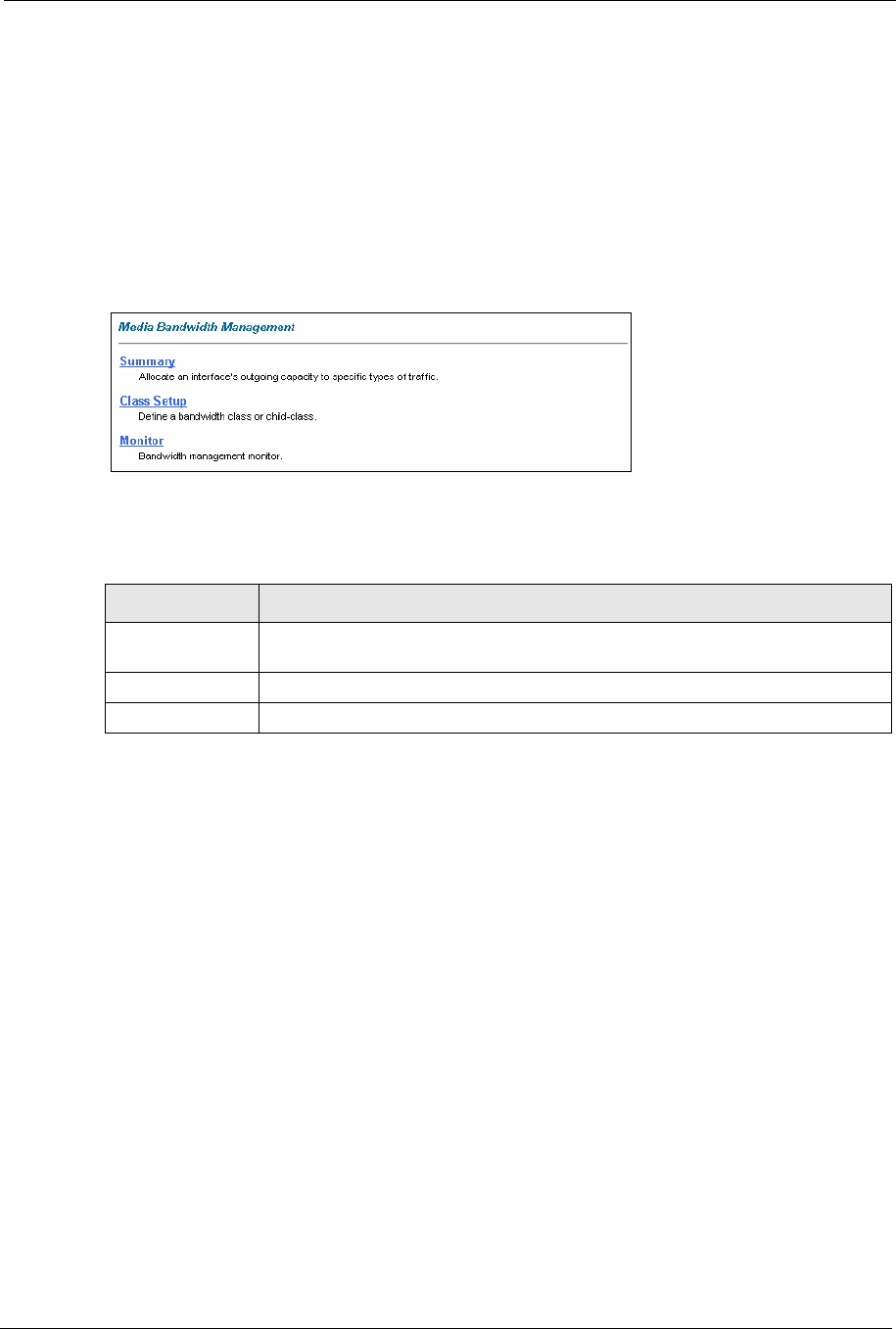
P-660H/HW/W-T Series User’ Guide
Chapter 16 Media Bandwidth Management Advanced Setup 188
4The Prestige assigns any remaining unbudgeted bandwidth to traffic that does not match
any of the bandwidth classes.
16.8 The Main Media Bandwidth Management Screen
Click Media Bandwidth Mgnt. to display the main Media Bandwidth Management screen
as shown.
Figure 92 Media Bandwidth Mgnt.
The following table describes the links in this screen.
16.9 Configuring Summary
Click Media Bandwidth Management, Summary to open the screen as shown next.
Enable bandwidth management on an interface and set the maximum allowed bandwidth for
that interface.
Refer to Section 16.1 on page 182 for more information.
Table 55 Media Bandwidth Mgnt.
LINK DESCRIPTION
Summary Click this link to display a screen where you can enable bandwidth management
on an interface and set the maximum allowed bandwidth for that interface.
Class Setup Click this link to display a screen thwere you can configure bandwidth classes.
Monitor Click this link to display a screen wehre you can view bandwidth usage.
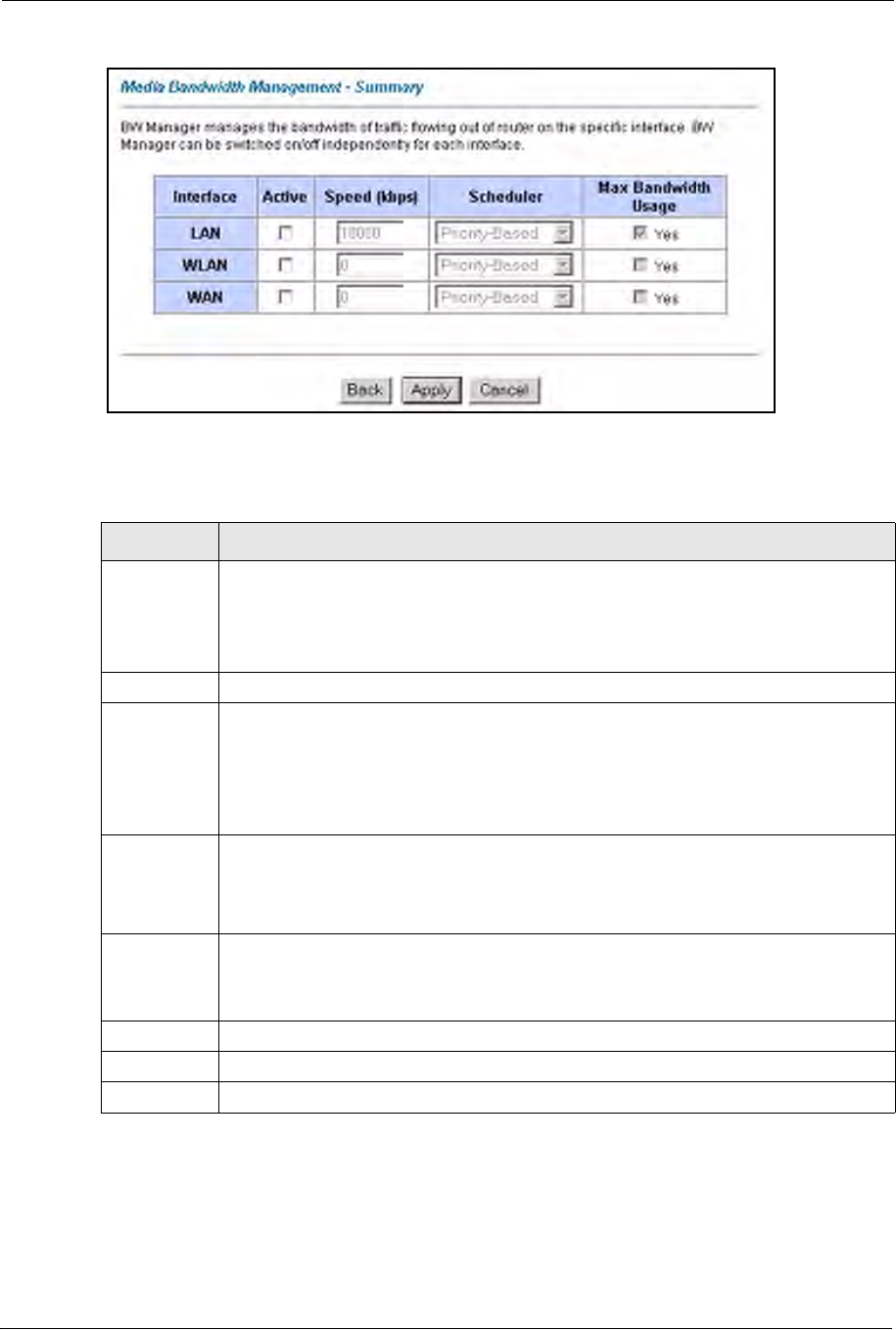
P-660H/HW/W-T Series User’ Guide
189 Chapter 16 Media Bandwidth Management Advanced Setup
Figure 93 Media Bandwidth Management: Summary
The following table describes the labels in this screen.
Table 56 Media Bandwidth Management: Summary
LABEL DESCRIPTION
LAN
WLAN
WAN
These read-only labels represent the physical interfaces. Select an interface’s check box
to enable bandwidth management on that interface. Bandwidth management applies to
all traffic flowing out of the router through the interface, regardless of the traffic’s source.
Traffic redirect or IP alias may cause LAN-to-LAN traffic to pass through the Prestige
and be managed by bandwidth management.
Active Select an interface’s check box to enable bandwidth management on that interface.
Speed (kbps) Enter the amount of bandwidth for this interface that you want to allocate using
bandwidth management.
This appears as the bandwidth budget of the interface’s root class. The recommendation
is to set this speed to match what the interface’s connection can handle. For example,
set the WAN interface speed to 10000 kbps if the ADSL connection has an upstream
speed of 10Mbps.
Scheduler Select either Priority-Based or Fairness-Based from the drop-down menu to control
the traffic flow.
Select Priority-Based to give preference to bandwidth classes with higher priorities.
Select Fairness-Based to treat all bandwidth classes equally.
Maximize
Bandwidth
Usage
Select this check box to have the Prestige divide up all of the interface’s unallocated
and/or unused bandwidth among the bandwidth classes that require bandwidth. Do not
select this if you want to reserve bandwidth for traffic that does not match a bandwidth
class or you want to limit the speed of this interface (see the Speed field description).
Back Click Back to go to the main Media Bandwidth Management screen.
Apply Click Apply to save your settings back to the Prestige.
Cancel Click Cancel to begin configuring this screen afresh.
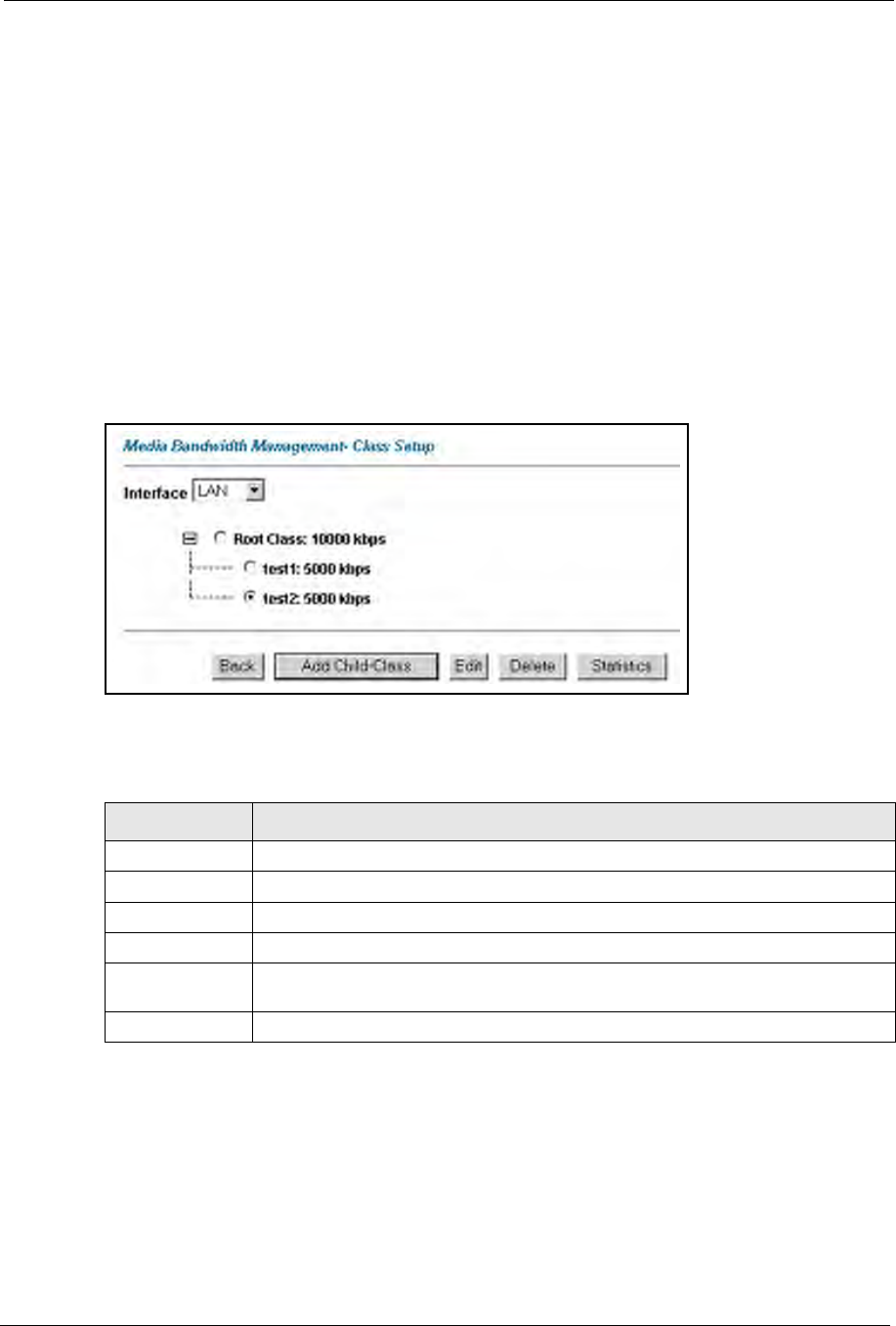
P-660H/HW/W-T Series User’ Guide
Chapter 16 Media Bandwidth Management Advanced Setup 190
16.10 Configuring Class Setup
The class setup screen displays the configured bandwidth classes by individual interface.
Select an interface and click the buttons to perform the actions described next. Click “+” to
expand the class tree or click “-“to collapse the class tree. Each interface has a permanent root
class. The bandwidth budget of the root class is equal to the speed you configured on the
interface (see Section 16.9 on page 188 to configure the speed of the interface). Configure
child-class layers for the root class.
Refer to Section 16.1 on page 182 for more information.
To add or delete child classes on an interface, click Media Bandwidth Management, then
Class Setup. The screen appears as shown (with example classes).
Figure 94 Media Bandwidth Management: Class Setup
The following table describes the labels in this screen.
16.10.1 Media Bandwidth Management Class Configuration
Configure a bandwidth management class in the Class Configuration screen. You must use
the Media Bandwidth Management - Summary screen to enable bandwidth management on
an interface before you can configure classes for that interface.
Refer to Section 16.1 on page 182 for more information.
Table 57 Media Bandwidth Management: Class Setup
LABEL DESCRIPTION
Interface Select an interface from the drop-down list box for which you wish to set up classes.
Back Click Back to go to the main Media Bandwidth Management screen.
Add Child-Class Click Add Child-class to add a sub-class.
Edit Click Edit to configure the selected class. You cannot edit the root class.
Delete Click Delete to delete the class and all its child-classes. You cannot delete the root
class.
Statistics Click Statistics to display the status of the selected class.
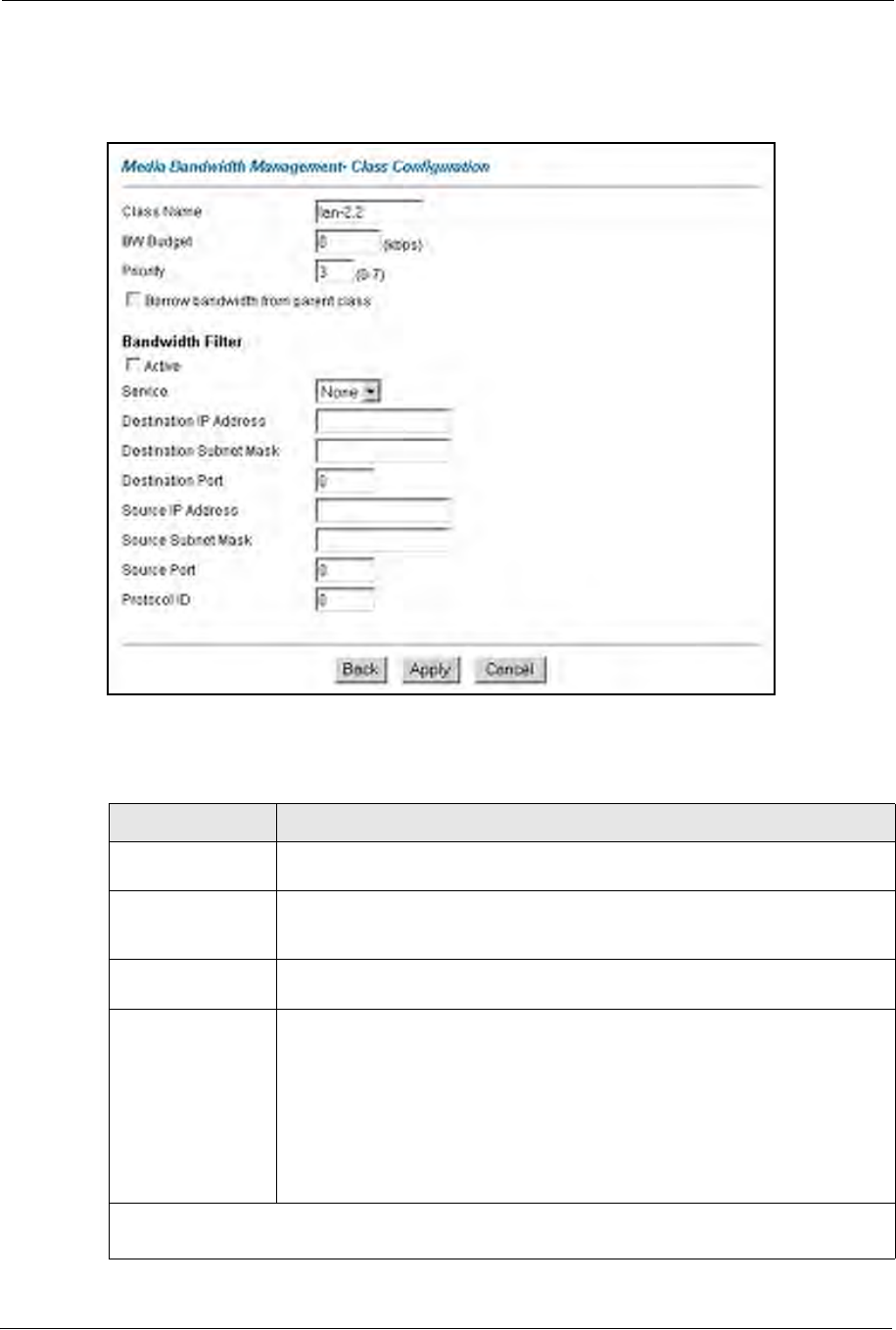
P-660H/HW/W-T Series User’ Guide
191 Chapter 16 Media Bandwidth Management Advanced Setup
To add a child class, click Media Bandwidth Management, then Class Setup. Click the Add
Child-Class button to open the following screen.
Figure 95 Media Bandwidth Management: Class Configuration
The following table describes the labels in this screen.
Table 58 Media Bandwidth Management: Class Configuration
LABEL DESCRIPTION
Class Name Use the auto-generated name or enter a descriptive name of up to 20
alphanumeric characters, including spaces.
BW Budget (kbps) Specify the maximum bandwidth allowed for the class in kbps. The
recommendation is a setting between 20 kbps and 20000 kbps for an individual
class.
Priority Enter a number between 0 and 7 to set the priority of this class. The higher the
number, the higher the priority. The default setting is 3.
Borrow bandwidth
from parent class
Select this option to allow a child-class to borrow bandwidth from its parent class
if the parent class is not using up its bandwidth budget.
Bandwidth borrowing is governed by the priority of the child-classes. That is, a
child-class with the highest priority (7) is the first to borrow bandwidth from its
parent class.
Do not select this for the classes directly below the root class if you want to leave
bandwidth available for other traffic types or you want to set the interface’s
speed to match what the next device in network can handle (see the Speed field
description in the Summary screen).
Bandwidth Filter
The Prestige uses a bandwidth filter to identify the traffic that belongs to a bandwidth class.

P-660H/HW/W-T Series User’ Guide
Chapter 16 Media Bandwidth Management Advanced Setup 192
Active Select the check box to have the Prestige use this bandwidth filter when it
performs bandwidth management.
Service You can select a predefined service instead of configuring the Destination Port,
Source Port and Protocol ID fields.
SIP (Session Initiation Protocol) is a signaling protocol used in Internet
telephony, instant messaging and other VoIP (Voice over IP) applications. Select
SIP from the drop-down list box to configure this bandwidth filter for traffic that
uses SIP.
File Transfer Protocol (FTP) is an Internet file transfer service that operates on
the Internet and over TCP/IP networks. A system running the FTP server
accepts commands from a system running an FTP client. The service allows
users to send commands to the server for uploading and downloading files.
Select FTP from the drop-down list box to configure this bandwidth filter for FTP
traffic.
H.323 is a standard teleconferencing protocol suite that provides audio, data and
video conferencing. It allows for real-time point-to-point and multipoint
communication between client computers over a packet-based network that
does not provide a guaranteed quality of service. Select H.323 from the drop-
down list box to configure this bandwidth filter for traffic that uses H.323.
When you select None, the bandwidth class applies to all services unless you
specify one by configuring the Destination Port,Source Port and Protocol ID
fields.
Destination IP
Address
Enter the destination IP address in dotted decimal notation. A blank destination
IP address means any destination IP address.
Destination Subnet
Mask
Enter the destination subnet mask. This field is N/A if you do not specify a
Destination IP Address. Refer to the appendix for more information on IP
subnetting.
Destination Port Enter the port number of the destination. A blank destination port means any
destination port.
Source IP Address Enter the source IP address. A blank source IP address means any source IP
address.
Source Subnet
Mask
Enter the source subnet mask. This field is N/A if you do not specify a Source IP
Address. Refer to the appendix for more information on IP subnetting.
Source Port Enter the port number of the source. See the following table for some common
services and port numbers. A blank source port means any source port number.
Protocol ID Enter the protocol ID (service type) number, for example: 1 for ICMP, 6 for TCP
or 17 for UDP. A blank protocol ID means any protocol number.
Back Click Back to go to the main Media Bandwidth Management screen.
Apply Click Apply to save your changes back to the Prestige.
Cancel Click Cancel to begin configuring this screen afresh.
Table 59 Services and Port Numbers
SERVICES PORT NUMBER
ECHO 7
FTP (File Transfer Protocol) 21
Table 58 Media Bandwidth Management: Class Configuration (continued)
LABEL DESCRIPTION
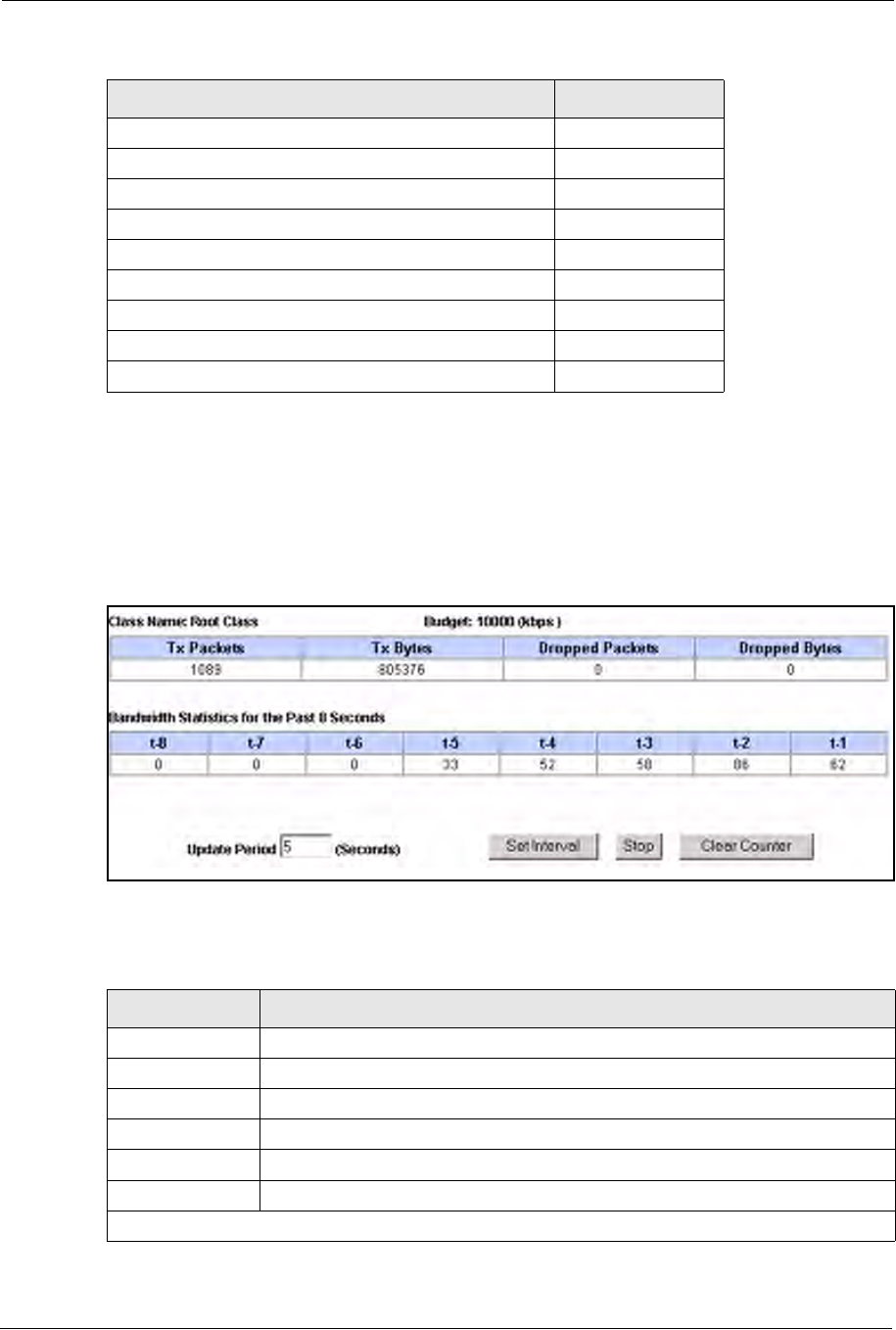
P-660H/HW/W-T Series User’ Guide
193 Chapter 16 Media Bandwidth Management Advanced Setup
16.10.2 Media Bandwidth Management Statistics
Use the Media Bandwidth Management Statistics screen to view network performance
information. Click the Statistics button in the Class Setup screen to open the Statistics
screen.
Figure 96 Media Bandwidth Management Statistics
The following table describes the labels in this screen.
SMTP (Simple Mail Transfer Protocol) 25
DNS (Domain Name System) 53
Finger 79
HTTP (Hyper Text Transfer protocol or WWW, Web) 80
POP3 (Post Office Protocol) 110
NNTP (Network News Transport Protocol) 119
SNMP (Simple Network Management Protocol) 161
SNMP trap 162
PPTP (Point-to-Point Tunneling Protocol) 1723
Table 59 Services and Port Numbers
SERVICES PORT NUMBER
Table 60 Media Bandwidth Management Statistics
LABEL DESCRIPTION
Class Name This field displays the name of the class the statistics page is showing.
Budget (kbps) This field displays the amount of bandwidth allocated to the class.
Tx Packets This field displays the total number of packets transmitted.
Tx Bytes This field displays the total number of bytes transmitted.
Dropped Packets This field displays the total number of packets dropped.
Dropped Bytes This field displays the total number of bytes dropped.
Bandwidth Statistics for the Past 8 Seconds (t-8 to t-1)
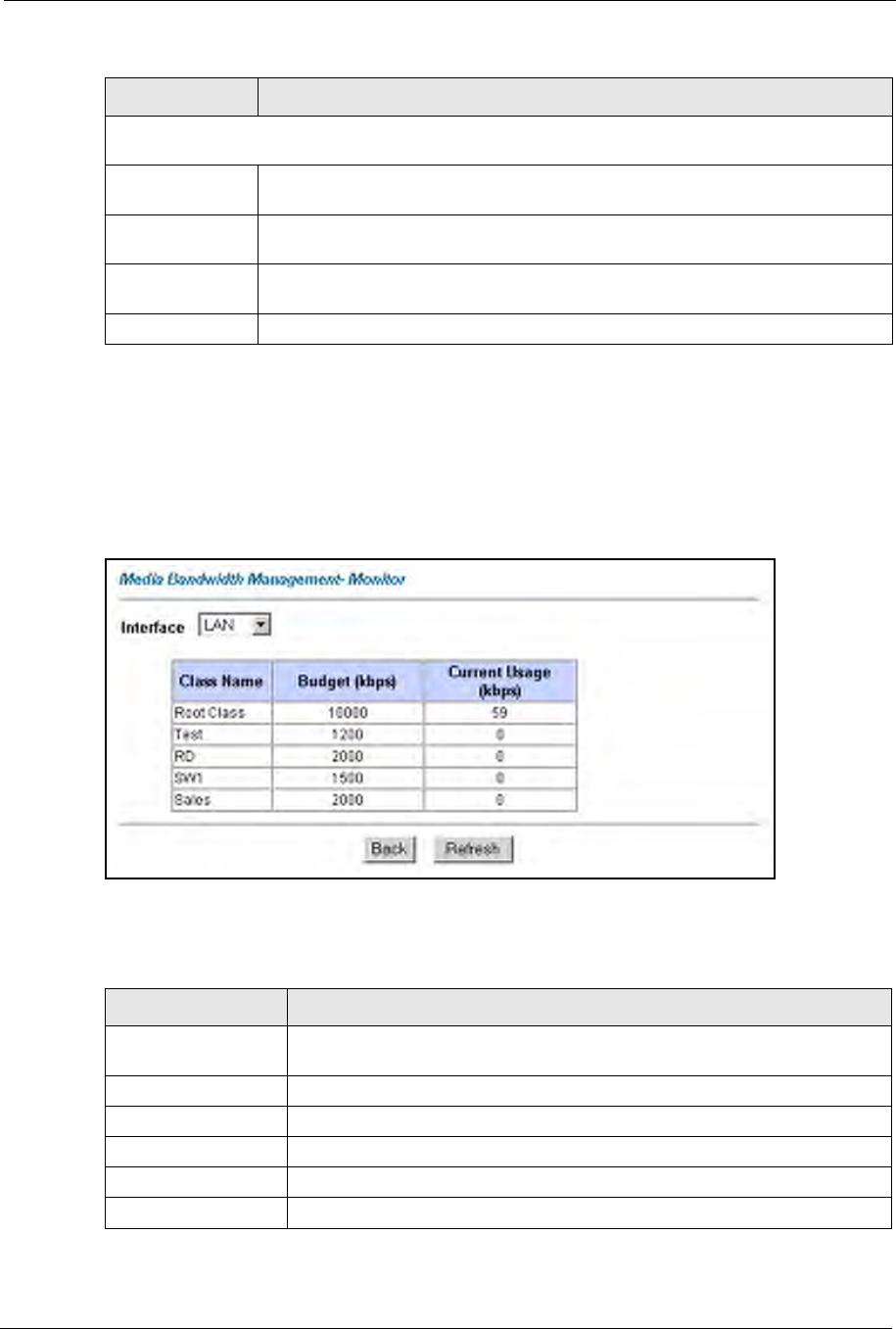
P-660H/HW/W-T Series User’ Guide
Chapter 16 Media Bandwidth Management Advanced Setup 194
16.11 Bandwidth Monitor
To view the Prestige’s bandwidth usage and allotments, click Media Bandwidth
Management, then Monitor. The screen appears as shown.
Figure 97 Media Bandwidth Management: Monitor
The following table describes the labels in this screen.
This field displays the bandwidth statistics (in bps) for the past one to eight seconds. For example, t-1
means one second ago.
Update Period
(seconds)
Enter the time interval in seconds to define how often the information should be
refreshed.
Set Interval Click Set Interval to apply the new update period you entered in the Update
Period field above.
Stop Update Click Stop Update to stop the browser from refreshing bandwidth management
statistics.
Clear Counter Click Clear Counter to clear all of the bandwidth management statistics.
Table 60 Media Bandwidth Management Statistics
LABEL DESCRIPTION
Table 61 Media Bandwidth Management: Monitor
LABEL DESCRIPTION
Interface Select an interface from the drop-down list box to view the bandwidth usage of
its bandwidth classes.
Class Name This field displays the name of the class.
Budget (kbps) This field displays the amount of bandwidth allocated to the class.
Current Usage (kbps) This field displays the amount of bandwidth that each class is using.
Back Click Back to go to the main Media Bandwidth Management screen.
Refresh Click Refresh to update the page.

P-660H/HW/W-T Series User’ Guide
195 Chapter 16 Media Bandwidth Management Advanced Setup

P-660H/HW/W-T Series User’ Guide
Chapter 17 Maintenance 196
CHAPTER 17
Maintenance
This chapter displays system information such as ZyNOS firmware, port IP addresses and port
traffic statistics.
17.1 Maintenance Overview
The maintenance screens can help you view system information, upload new firmware,
manage configuration and restart your Prestige.
17.2 System Status Screen
Click System Status under Maintenance to open the following screen, where you can use to
monitor your Prestige. Note that these fields are READ-ONLY and only for diagnostic
purposes.
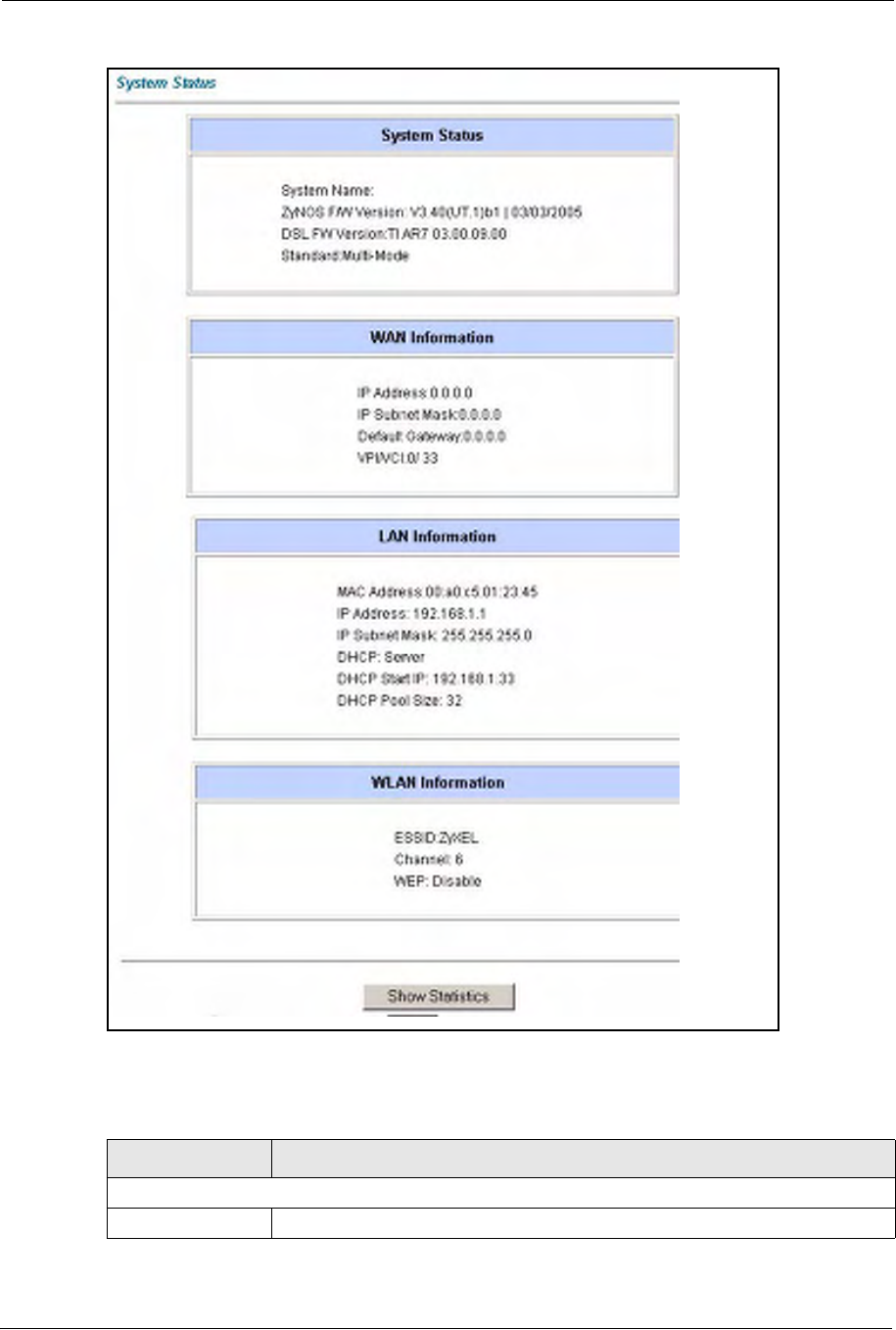
P-660H/HW/W-T Series User’ Guide
197 Chapter 17 Maintenance
Figure 98 System Status
The following table describes the fields in this screen.
Table 62 System Status
LABEL DESCRIPTION
System Status
System Name This is the name of your Prestige. It is for identification purposes.

P-660H/HW/W-T Series User’ Guide
Chapter 17 Maintenance 198
17.2.1 System Statistics
Click Show Statistics in the System Status screen to open the following screen. Read-only
information here includes port status and packet specific statistics. Also provided are "system
up time" and "poll interval(s)". The Poll Interval(s) field is configurable.
ZyNOS Firmware
Version
This is the ZyNOS firmware version and the date created. ZyNOS is ZyXEL's
proprietary Network Operating System design.
DSL FW Version This is the DSL firmware version associated with your Prestige.
Standard This is the standard that your Prestige is using.
WAN Information
IP Address This is the WAN port IP address.
IP Subnet Mask This is the WAN port IP subnet mask.
Default Gateway This is the IP address of the default gateway, if applicable.
VPI/VCI This is the Virtual Path Identifier and Virtual Channel Identifier that you entered in
the first Wizard screen.
LAN Information
MAC Address This is the MAC (Media Access Control) or Ethernet address unique to your
Prestige.
IP Address This is the LAN port IP address.
IP Subnet Mask This is the LAN port IP subnet mask.
DHCP This is the WAN port DHCP role - Server,Relay (not all Prestige models) or
None.
DHCP Start IP This is the first of the contiguous addresses in the IP address pool.
DHCP Pool Size This is the number of IP addresses in the IP address pool.
WLAN Information
ESSID This is the descriptive name used to identify the Prestige in the wireless LAN.
Channel This is the channel number used by the Prestige now.
WEP This displays the status of WEP data encryption.
Show Statistics Click Show Statistics to see the performance statistics such as number of
packets sent and number of packets received for each port.
Table 62 System Status (continued)
LABEL DESCRIPTION
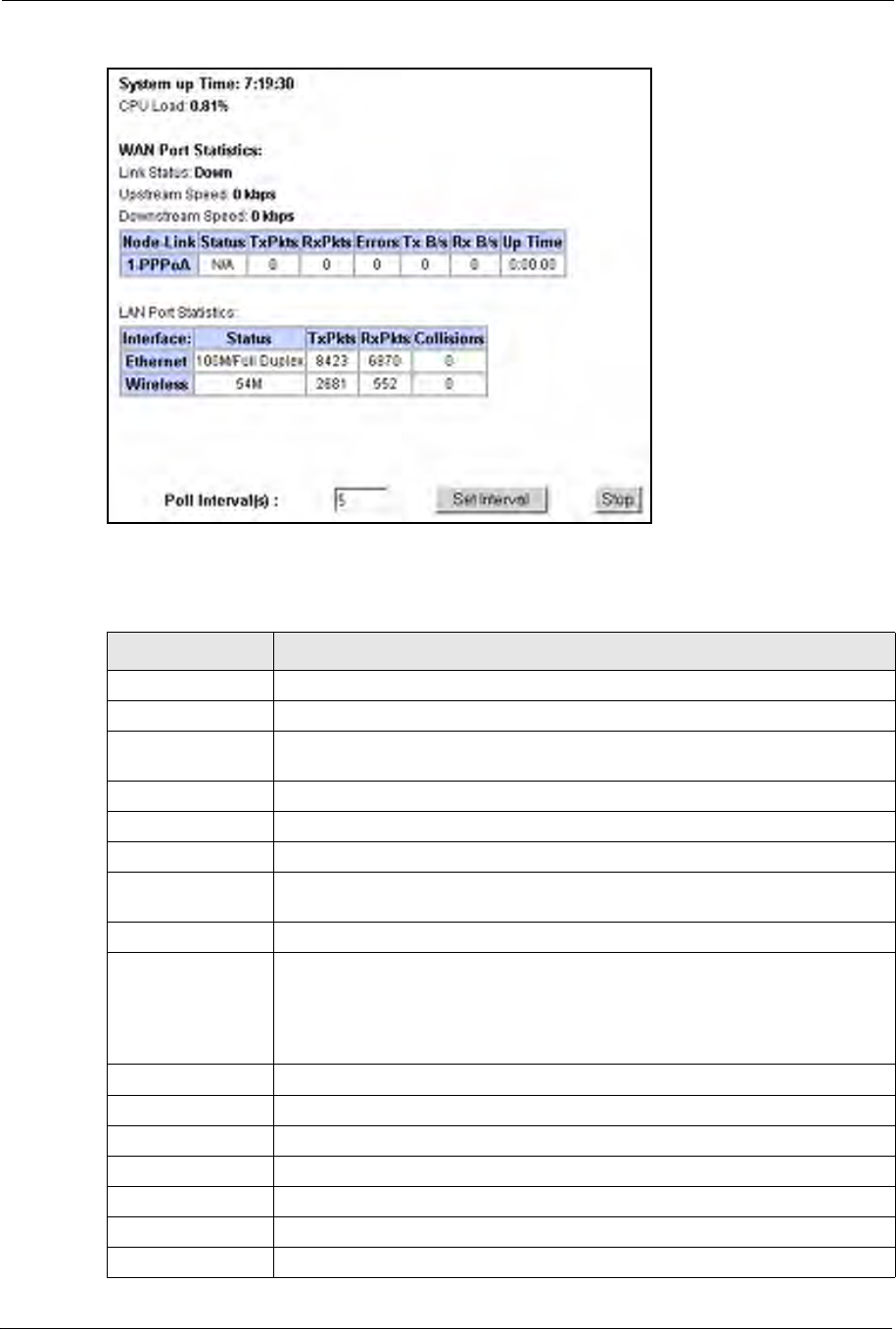
P-660H/HW/W-T Series User’ Guide
199 Chapter 17 Maintenance
Figure 99 System Status: Show Statistics
The following table describes the fields in this screen.
Table 63 System Status: Show Statistics
LABEL DESCRIPTION
System up Time This is the elapsed time the system has been up.
CPU Load This field specifies the percentage of CPU utilization.
LAN or WAN Port
Statistics
This is the WAN or LAN port.
Link Status This is the status of your WAN link.
Upstream Speed This is the upstream speed of your Prestige.
Downstream Speed This is the downstream speed of your Prestige.
Node-Link This field displays the remote node index number and link type. Link types are
PPPoA, ENET, RFC 1483 and PPPoE.
Interface This field displays the type of port.
Status For the WAN port, this displays the port speed and duplex setting if you're using
Ethernet encapsulation and down (line is down), idle (line (ppp) idle), dial
(starting to trigger a call) and drop (dropping a call) if you're using PPPoE
encapsulation.
For a LAN port, this shows the port speed and duplex setting.
TxPkts This field displays the number of packets transmitted on this port.
RxPkts This field displays the number of packets received on this port.
Errors This field displays the number of error packets on this port.
Tx B/s This field displays the number of bytes transmitted in the last second.
Rx B/s This field displays the number of bytes received in the last second.
Up Time This field displays the elapsed time this port has been up.
Collisions This is the number of collisions on this port.
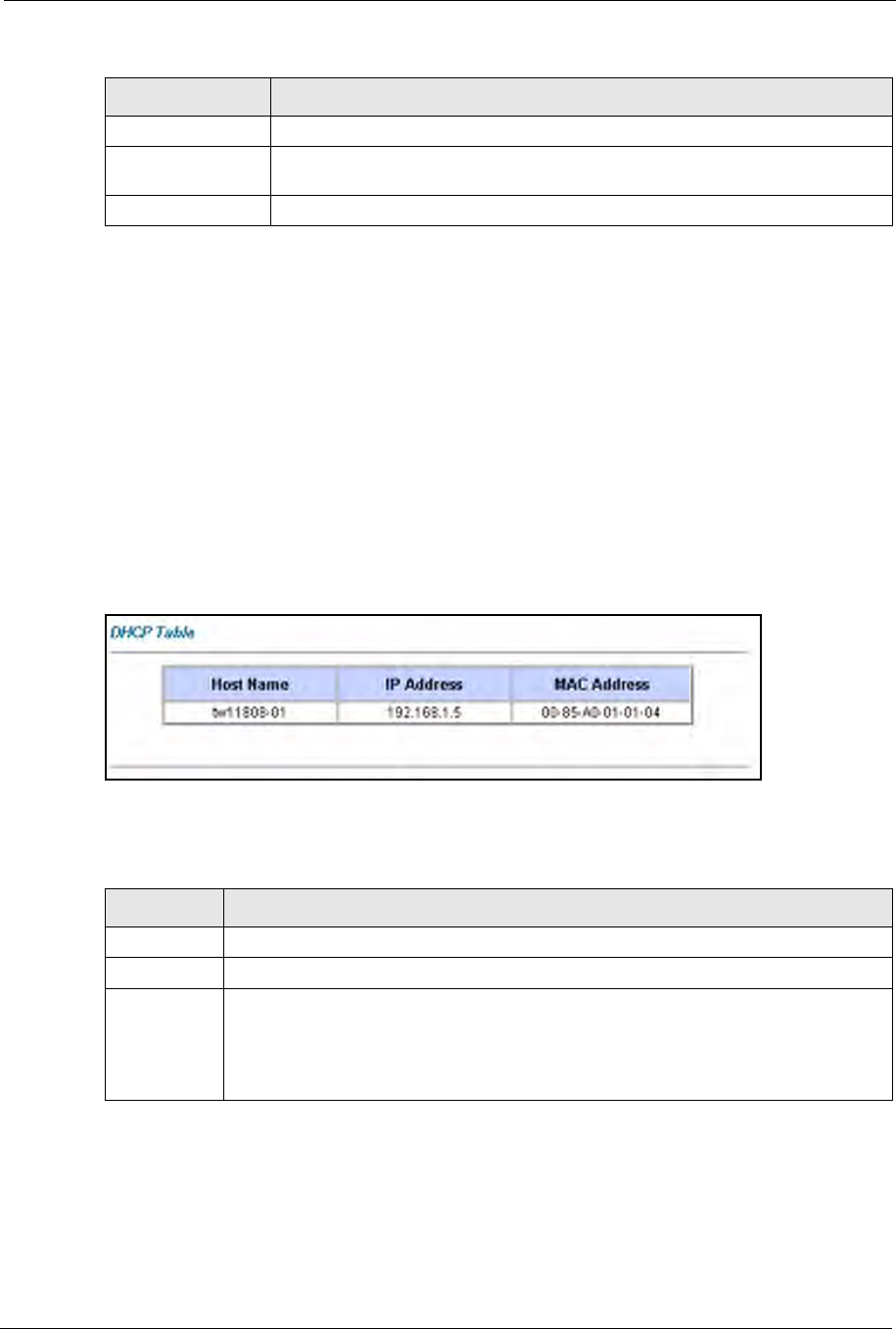
P-660H/HW/W-T Series User’ Guide
Chapter 17 Maintenance 200
17.3 DHCP Table Screen
DHCP (Dynamic Host Configuration Protocol, RFC 2131 and RFC 2132) allows individual
clients to obtain TCP/IP configuration at start-up from a server. You can configure the Prestige
as a DHCP server or disable it. When configured as a server, the Prestige provides the TCP/IP
configuration for the clients. If set to None, DHCP service will be disabled and you must have
another DHCP server on your LAN, or else the computer must be manually configured.
Click Maintenance, and then the DHCP Table tab. Read-only information here relates to
your DHCP status. The DHCP table shows current DHCP Client information (including IP
Address,Host Name and MAC Address) of all network clients using the DHCP server.
Figure 100 DHCP Table
The following table describes the fields in this screen.
Poll Interval(s) Type the time interval for the browser to refresh system statistics.
Set Interval Click this button to apply the new poll interval you entered in the Poll Interval
field above.
Stop Click this button to halt the refreshing of the system statistics.
Table 63 System Status: Show Statistics (continued)
LABEL DESCRIPTION
Table 64 DHCP Table
LABEL DESCRIPTION
Host Name This is the name of the host computer.
IP Address This field displays the IP address relative to the Host Name field.
MAC Address This field displays the MAC (Media Access Control) address of the computer with the
displayed host name.
Every Ethernet device has a unique MAC address. The MAC address is assigned at
the factory and consists of six pairs of hexadecimal characters, for example,
00:A0:C5:00:00:02.
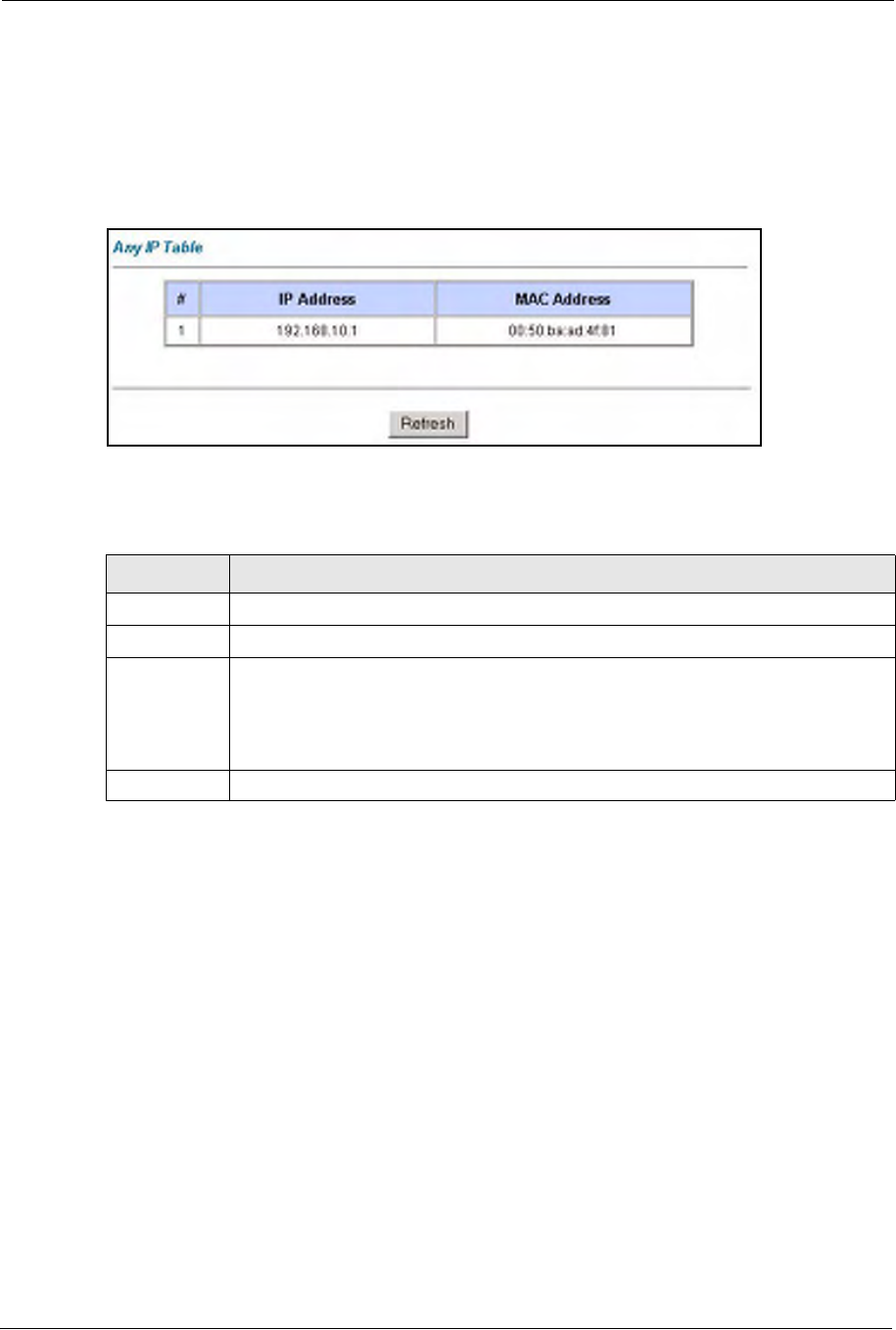
P-660H/HW/W-T Series User’ Guide
201 Chapter 17 Maintenance
17.4 Any IP Table Screen
Click Maintenance,Any IP. The Any IP table shows current read-only information
(including the IP address and the MAC address) of all network devices that use the Any IP
feature to communicate with the Prestige.
Figure 101 Any IP Table
The following table describes the labels in this screen.
17.5 Wireless Screen
The read-only screen displays information about the Prestige’s wireless LAN.
17.5.1 Association List
This screen displays the MAC address(es) of the wireless stations that are currently logged in
to the network. Click Wireless LAN and then Association List to open the screen shown next.
Table 65 Any IP Table
LABEL DESCRIPTION
#This field displays the index number.
IP Address This field displays the IP address of the network device.
MAC Address This field displays the MAC (Media Access Control) address of the computer with the
displayed IP address.
Every Ethernet device has a unique MAC address. The MAC address is assigned at
the factory and consists of six pairs of hexadecimal characters, for example,
00:A0:C5:00:00:02.
Refresh Click Refresh to update this screen.
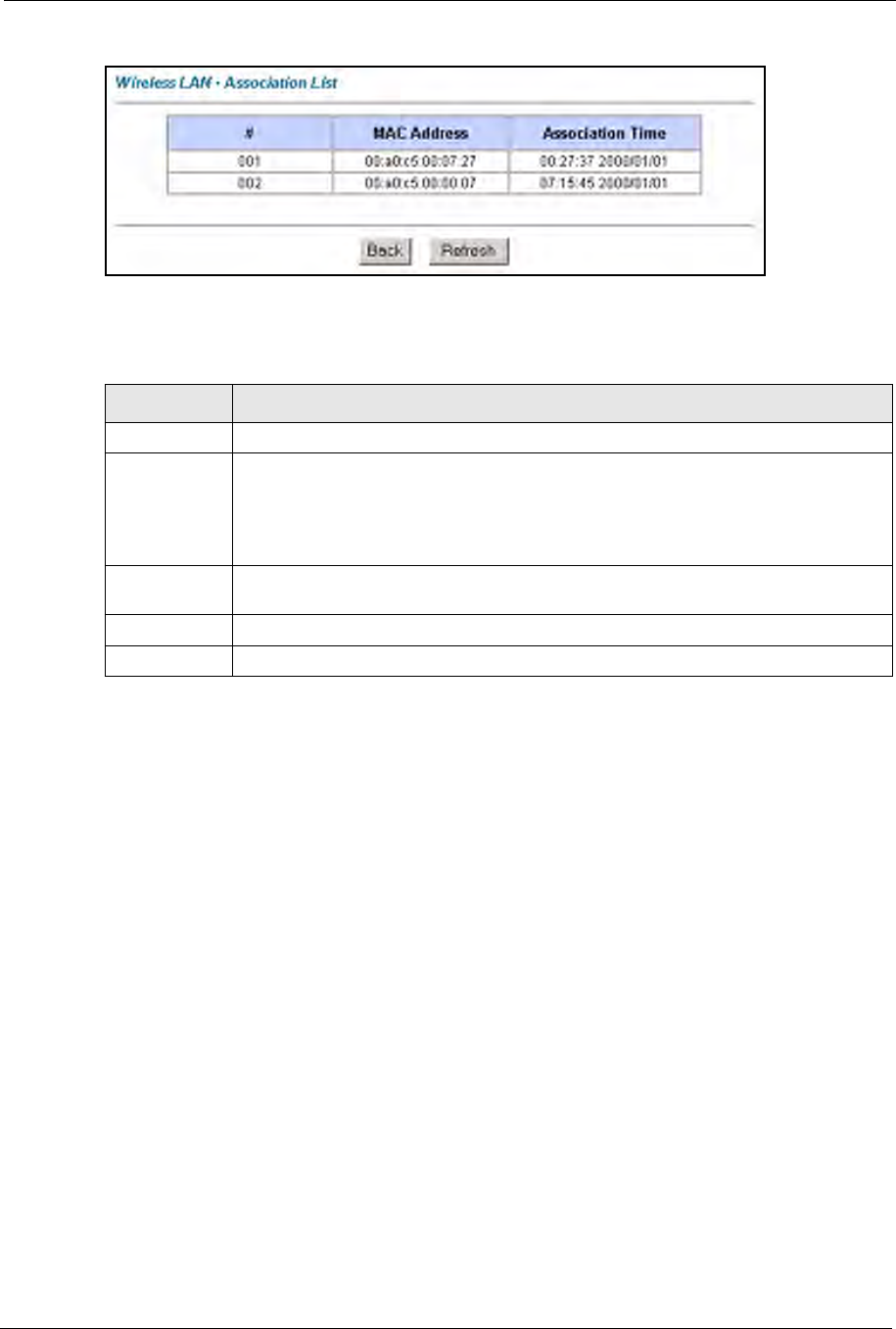
P-660H/HW/W-T Series User’ Guide
Chapter 17 Maintenance 202
Figure 102 Association List
The following table describes the fields in this screen.
17.6 Diagnostic Screens
These read-only screens display information to help you identify problems with the Prestige.
17.6.1 General Diagnostic
Click Diagnostic and then General to open the screen shown next.
Table 66 Association List
LABEL DESCRIPTION
#This is the index number of an associated wireless station.
MAC Address This field displays the MAC (Media Access Control) address of an associated wireless
station.
Every Ethernet device has a unique MAC address. The MAC address is assigned at
the factory and consists of six pairs of hexadecimal characters, for example,
00:A0:C5:00:00:02.
Association
Time
This field displays the time a wireless station is associated to the Prestige.
Back Click Back to return to the previous screen.
Refresh Click Refresh to renew the information in the table.
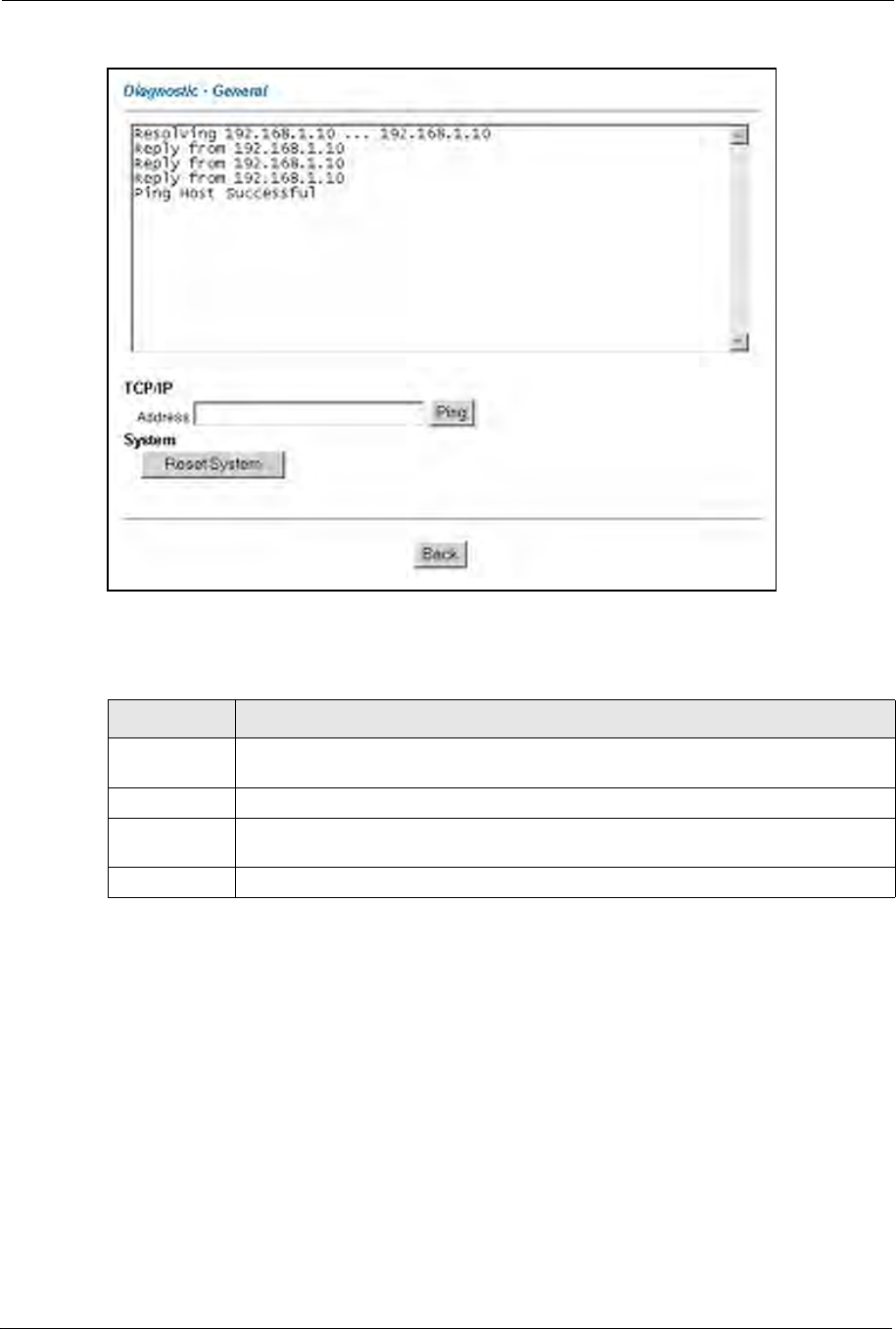
P-660H/HW/W-T Series User’ Guide
203 Chapter 17 Maintenance
Figure 103 Diagnostic: General
The following table describes the fields in this screen.
17.6.2 DSL Line Diagnostic
Click Diagnostic and then DSL Line to open the screen shown next.
Table 67 Diagnostic: General
LABEL DESCRIPTION
TCP/IP
Address
Type the IP address of a computer that you want to ping in order to test a connection.
Ping Click this button to ping the IP address that you entered.
Reset System Click this button to reboot the Prestige. A warning dialog box is then displayed asking
you if you're sure you want to reboot the system. Click OK to proceed.
Back Click this button to go back to the main Diagnostic screen.
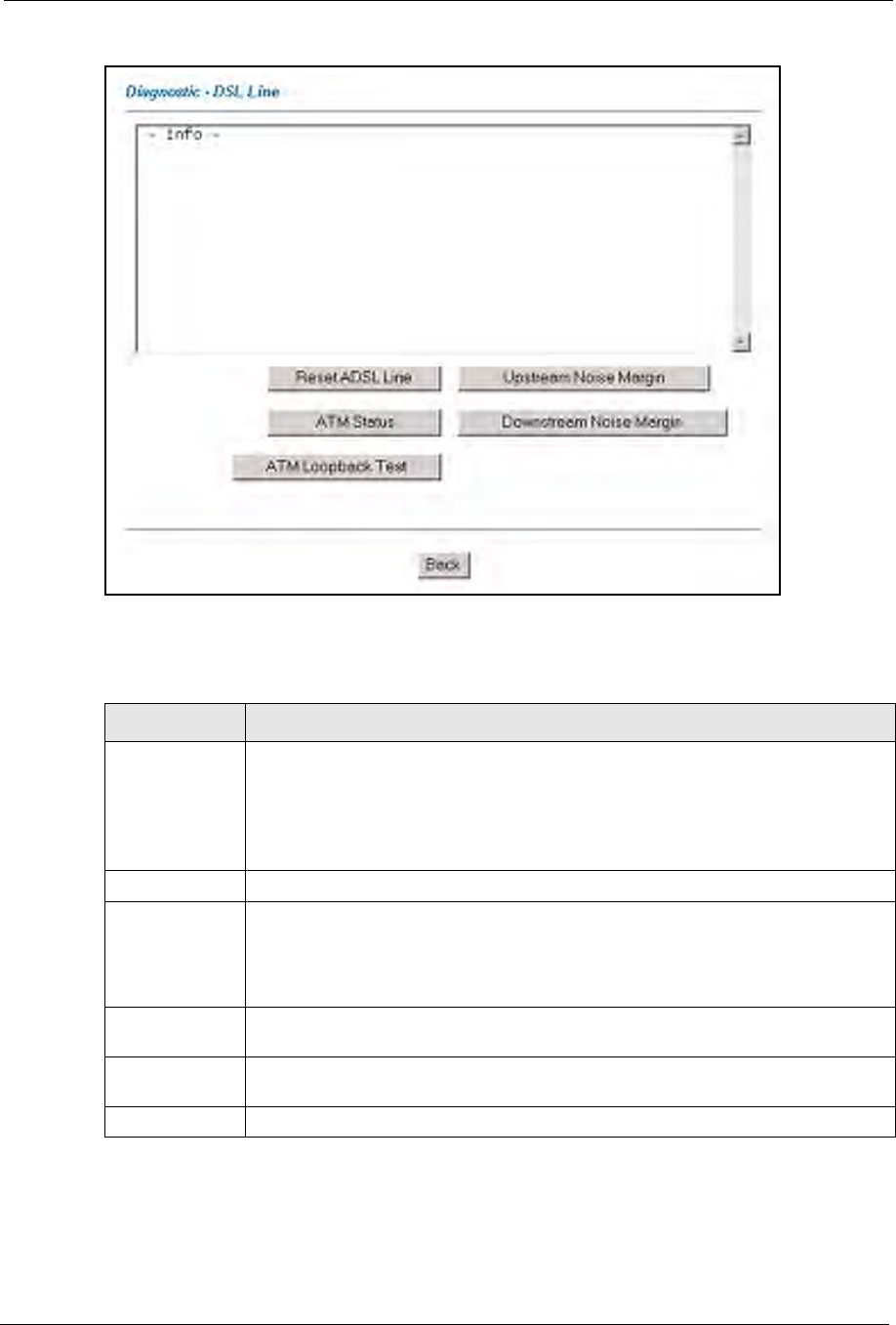
P-660H/HW/W-T Series User’ Guide
Chapter 17 Maintenance 204
Figure 104 Diagnostic: DSL Line
The following table describes the fields in this screen.
Table 68 Diagnostic: DSL Line
LABEL DESCRIPTION
Reset ADSL
Line
Click this button to reinitialize the ADSL line. The large text box above then displays
the progress and results of this operation, for example:
"Start to reset ADSL
Loading ADSL modem F/W...
Reset ADSL Line Successfully!"
ATM Status Click this button to view ATM status.
ATM Loopback
Tes t
Click this button to start the ATM loopback test. Make sure you have configured at
least one PVC with proper VPIs/VCIs before you begin this test. The Prestige sends
an OAM F5 packet to the DSLAM/ATM switch and then returns it (loops it back) to the
Prestige. The ATM loopback test is useful for troubleshooting problems with the
DSLAM and ATM network.
Upstream Noise
Margin
Click this button to display the upstream noise margin.
Downstream
Noise Margin
Click this button to display the downstream noise margin.
Back Click this button to go back to the main Diagnostic screen.
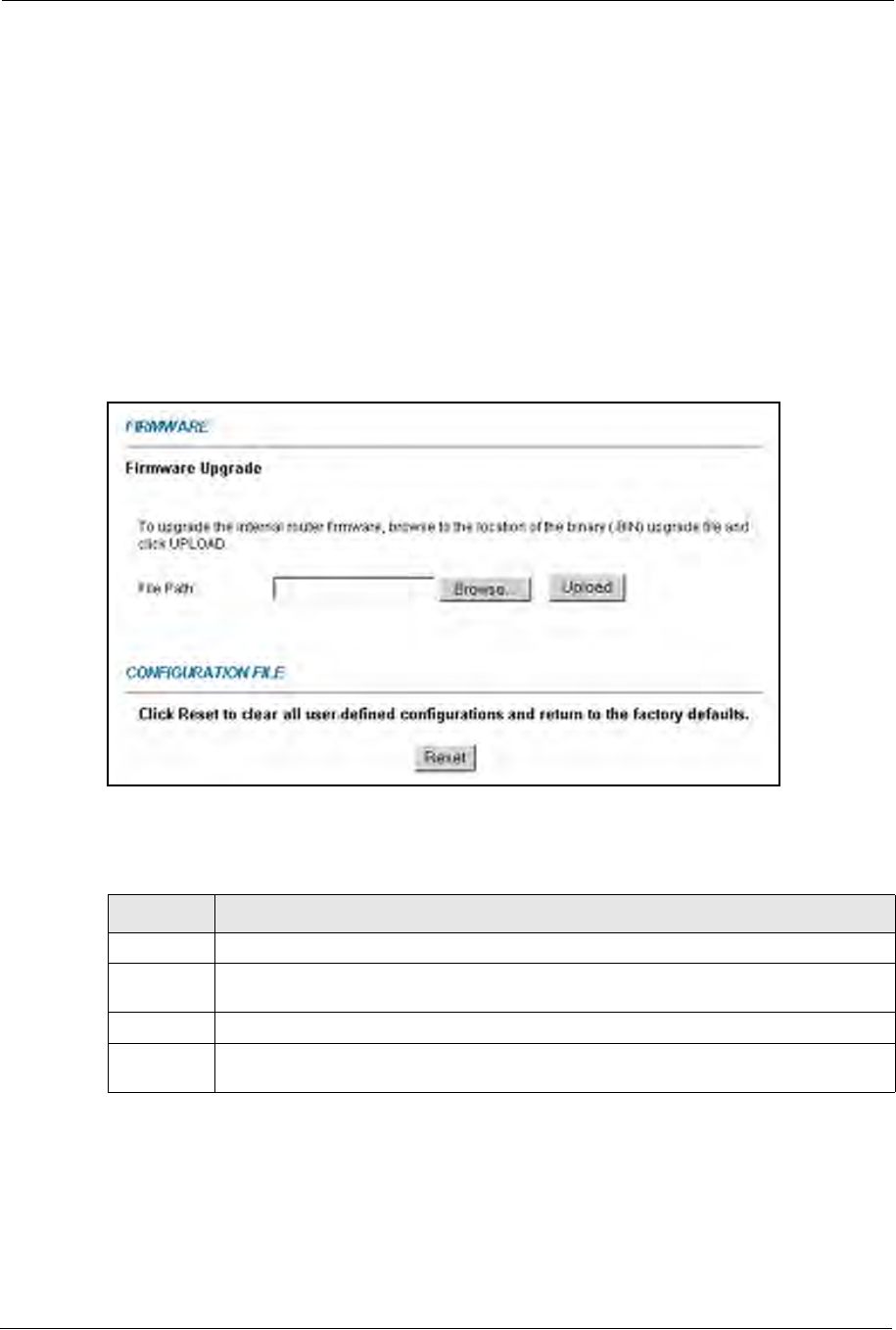
P-660H/HW/W-T Series User’ Guide
205 Chapter 17 Maintenance
17.7 Firmware Upgrade
Find firmware at www.zyxel.com in a file that (usually) uses the system model name with
a.bin extension, for example, "Prestige.bin". The upload process uses HTTP (Hypertext
Transfer Protocol) and may take up to two minutes. After a successful upload, the system will
reboot. See Chapter 33 on page 306 for upgrading firmware using FTP/TFTP commands.
Only use firmware for your device’s specific model. Refer to the label on the bottom of your
device.
Click Firmware to open the following screen. Follow the instructions in this screen to upload
firmware to your Prestige.
Figure 105 Firmware Upgrade
The following table describes the labels in this screen.
Note: Do NOT turn off the Prestige while firmware upload is in progress!
After you see the Firmware Upload in Process screen, wait two minutes before logging into
the Prestige again.
Table 69 Firmware Upgrade
LABEL DESCRIPTION
File Path Type in the location of the file you want to upload in this field or click Browse ... to find it.
Browse... Click Browse... to find the .bin file you want to upload. Remember that you must
decompress compressed (.zip) files before you can upload them.
Upload Click Upload to begin the upload process. This process may take up to two minutes.
Reset Click this button to clear all user-entered configuration information and return the
Prestige to its factory defaults.
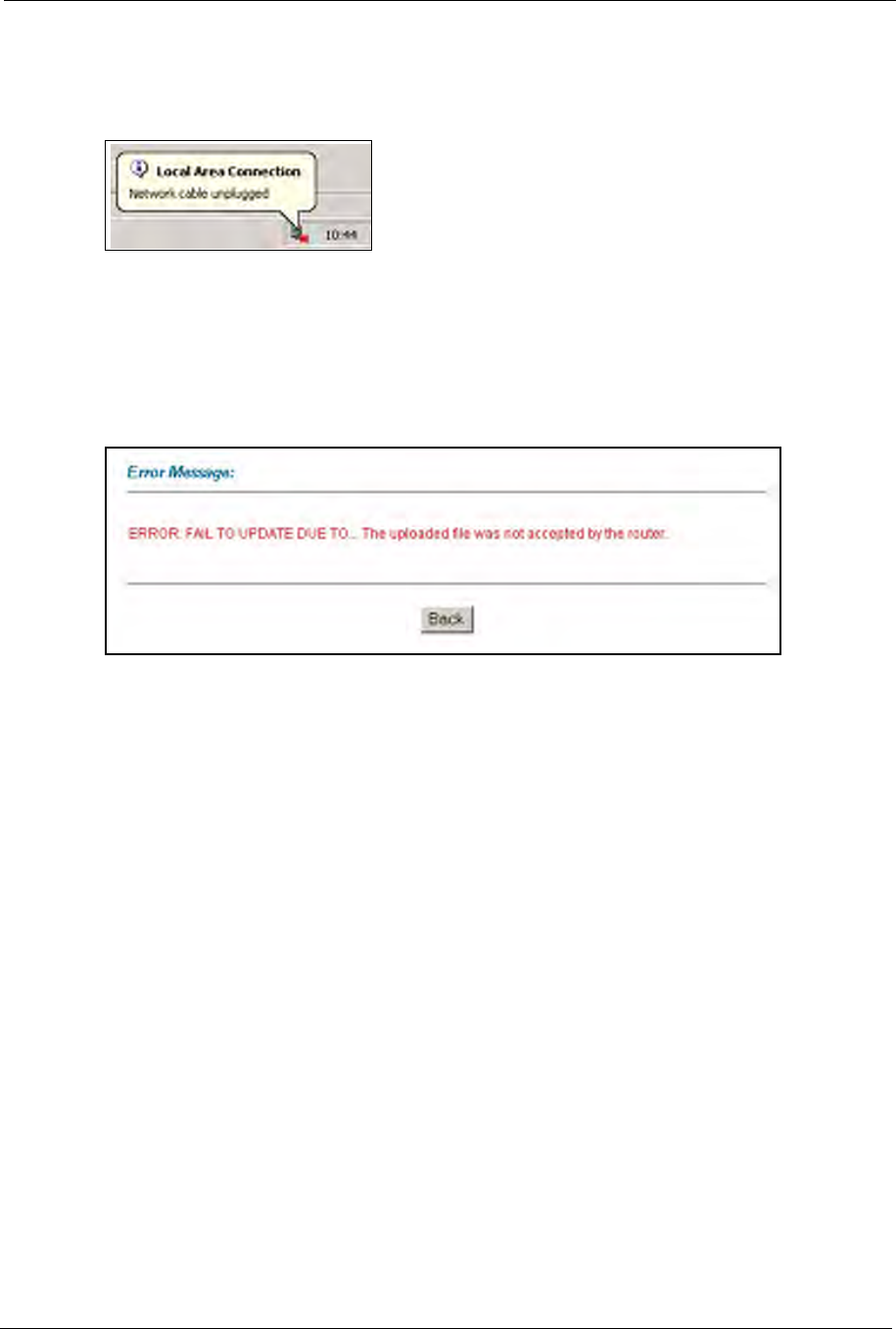
P-660H/HW/W-T Series User’ Guide
Chapter 17 Maintenance 206
The Prestige automatically restarts in this time causing a temporary network disconnect. In
some operating systems, you may see the following icon on your desktop.
Figure 106 Network Temporarily Disconnected
After two minutes, log in again and check your new firmware version in the System Status
screen.
If the upload was not successful, the following screen will appear. Click Back to go back to
the Firmware screen.
Figure 107 Error Message

P-660H/HW/W-T Series User’ Guide
207 Chapter 17 Maintenance

P-660H/HW/W-T Series User’ Guide
Chapter 18 Introducing the SMT 208
CHAPTER 18
Introducing the SMT
This chapter explains how to access and navigate the System Management Terminal and gives
an overview of its menus.
18.1 SMT Introduction
The Prestige’s SMT (System Management Terminal) is a menu-driven interface that you can
access from a terminal emulator over a telnet connection. This chapter shows you how to
access the SMT (System Management Terminal) menus via Telnet, how to navigate the SMT
and how to configure SMT menus.
18.1.1 Procedure for SMT Configuration via Telnet
The following procedure details how to telnet into your Prestige.
1In Windows, click Start (usually in the bottom left corner), Run and then type "telnet
192.168.1.1" (the default IP address) and click OK.
2Enter “1234” in the Password field.
3After entering the password you will see the main menu.
Please note that if there is no activity for longer than five minutes (default timeout period)
after you log in, your Prestige will automatically log you out. You will then have to telnet into
the Prestige again.
18.1.2 Entering Password
The login screen appears after you press [ENTER], prompting you to enter the password, as
shown next.
For your first login, enter the default password "1234". As you type the password, the screen
displays an asterisk "*" for each character you type.
Please note that if there is no activity for longer than five minutes after you log in, your
Prestige will automatically log you out.

P-660H/HW/W-T Series User’ Guide
209 Chapter 18 Introducing the SMT
Figure 108 Login Screen
18.1.3 Prestige SMT Menus Overview
The following table gives you an overview of your Prestige’s various SMT menus.
Enter Password: ****
Table 70 SMT Menus Overview
MENUS SUB MENUS
1 General Setup 1.1 Configure Dynamic DNS
2 WAN Backup Setup
3 LAN Setup 3.1 LAN Port Filter Setup
3.2 TCP/IP and DHCP Setup 3.2.1 IP Alias Setup
3.5 Wireless LAN Setup 3.5.1 WLAN MAC Address
Filter
4 Internet Access Setup
11 Remote Node Setup 11.1 Remote Node Profile
11.3 Remote Node Network Layer
Options
11.5 Remote Node Filter
11.6 Remote Node ATM Layer
Options
11.8 Advance Setup Options (PPPoE
passthrough)
12 Static Routing Setup 12.1 Edit Static Route Setup 12.1.1 Edit IP Static Route
12.3 Bridge Static Route Setup 12.3.1 Edit Bridge Static Route
14 Dial-in User Setup 14.1 Edit Dial-in User
15 NAT Setup 15.1 Address Mapping Sets 15.1.x Address Mapping Rules 15.1.x.x Address
Mapping Rule
15.2 NAT Server Sets 15.2.x NAT Server Setup
21 Filter and Firewall
Rule Setup
21.1 Filter Setup 21.1 Filter Rules Summary 21.1.x.1 Generic
Filter Rule
21.1.x.1 TCP/IP
Filter Rule
21.2 Firewall Setup
22 SNMP Configuration
23 System Security 23.1 Change Password
23.2 RADIUS Server
23.4 IEEE 802.1X

P-660H/HW/W-T Series User’ Guide
Chapter 18 Introducing the SMT 210
18.2 Navigating the SMT Interface
The SMT (System Management Terminal) is the interface that you use to configure your
Prestige.
Several operations that you should be familiar with before you attempt to modify the
configuration are listed in the table below.
24 System Maintenance 24.1 Status
24.2 System Information and Console
Port Speed
24.2.1 Information
24.2.2 Change Console Port
Speed
24.3 Log and Trace 24.3.1 View Error Log
24.3.2 UNIX Syslog
24.4 Diagnostic
24.5 Backup Configuration
24.6 Restore Configuration
24.7 Upload Firmware 24.7.1 Upload System
Firmware
24.7.2 Upload System
Configuration File
24.8 Command Interpreter Mode
24.9 Call Control 24.9.1 Budget Management
24.10 Time and Date Setting
24.11 Remote Management Control
25 IP Routing Policy
Setup
25.1 IP Routing Policy Setup 25.1.1 IP Routing Policy
26 Schedule Setup 26.1 Schedule Set Setup
Table 70 SMT Menus Overview (continued)
MENUS SUB MENUS
Table 71 Navigating the SMT Interface
OPERATION KEY STROKE DESCRIPTION
Move down to
another menu
[ENTER] To move forward to a submenu, type in the number of the
desired submenu and press [ENTER].
Move up to a
previous menu
[ESC] Press [ESC] to move back to the previous menu.
Move to a hidden
menu
Press [SPACE
BAR] to change
No to Yes then
press [ENTER].
Fields beginning with "Edit" lead to hidden menus and have a
default setting of No. Press [SPACE BAR] once to change No
to Yes, then press [ENTER] to go to the "hidden" menu.
Move the cursor [ENTER] or [UP]/
[DOWN] arrow
keys.
Within a menu, press [ENTER] to move to the next field. You
can also use the [UP]/[DOWN] arrow keys to move to the
previous and the next field, respectively.

P-660H/HW/W-T Series User’ Guide
211 Chapter 18 Introducing the SMT
After you enter the password, the SMT displays the main menu, as shown next.
18.2.1 System Management Terminal Interface Summary
Entering
information
Type in or press
[SPACE BAR],
then press
[ENTER].
You need to fill in two types of fields. The first requires you to
type in the appropriate information. The second allows you to
cycle through the available choices by pressing [SPACE BAR].
Required fields <? > or
ChangeMe
All fields with the symbol <?> must be filled in order to be able
to save the new configuration.
All fields with ChangeMe must not be left blank in order to be
able to save the new configuration.
N/A fields <N/A> Some of the fields in the SMT will show a <N/A>. This symbol
refers to an option that is Not Applicable.
Save your
configuration
[ENTER] Save your configuration by pressing [ENTER] at the message
"Press ENTER to confirm or ESC to cancel". Saving the data on
the screen will take you, in most cases to the previous menu.
Exit the SMT Type 99, then press [ENTER].Type 99 at the main menu prompt
and press [ENTER] to exit the SMT interface.
Table 72 SMT Main Menu
Copyright (c) 1994 - 2004 ZyXEL Communications Corp.
Prestige 660W-T1 Main Menu
Getting Started Advanced Management
1. General Setup 21. Filter and Firewall Setup
2. WAN Backup Setup 22. SNMP Configuration
3. LAN Setup 23. System Security
4. Internet Access Setup 24. System Maintenance
25. IP Routing Policy Setup
Advanced Applications 26. Schedule Setup
11. Remote Node Setup
12. Static Routing Setup
14. Dial-in User Setup 99. Exit
15. NAT Setup
Enter Menu Selection Number:
Table 71 Navigating the SMT Interface
OPERATION KEY STROKE DESCRIPTION
Table 73 Main Menu Summary
#MENU TITLE DESCRIPTION
1 General Setup Use this menu to set up your general information.
2 WAN Backup Setup Use this menu to setup traffic redirect and dial-back up.

P-660H/HW/W-T Series User’ Guide
Chapter 18 Introducing the SMT 212
18.3 Changing the System Password
Change the Prestige default password by following the steps shown next.
1Enter 23 in the main menu to display Menu 23 - System Security.
2Enter 1 to display Menu 23.1 - System Security - Change Password as shown next.
3Type your existing system password in the Old Password field, for example “1234", and
press [ENTER].
Figure 109 Menu 23.1 Change Password
4Type your new system password in the New Password field (up to 30 characters), and
press [ENTER].
5Re-type your new system password in the Retype to confirm field for confirmation and
press [ENTER].
3 LAN Setup Use this menu to set up your wireless LAN and LAN connection.
4 Internet Access Setup A quick and easy way to set up an Internet connection.
11 Remote Node Setup Use this menu to set up the Remote Node for LAN-to-LAN
connection, including Internet connection.
12 Static Routing Setup Use this menu to set up static routes.
14 Dial-in User Setup Use this menu to set up local user profiles on the Prestige.
15 NAT Setup Use this menu to specify inside servers when NAT is enabled.
21 Filter and Firewall Setup Use this menu to configure filters, activate/deactivate the firewall
and view the firewall log.
22 SNMP Configuration Use this menu to set up SNMP related parameters.
23 System Security Use this menu to set up wireless security and change your
password.
24 System Maintenance This menu provides system status, diagnostics, software upload,
etc.
25 IP Routing Policy Setup Use this menu to configure your IP routing policy.
26 Schedule Setup Use this menu to schedule outgoing calls.
99 Exit Use this to exit from SMT and return to a blank screen.
Table 73 Main Menu Summary
#MENU TITLE DESCRIPTION
Menu 23.1 - System Security - Change Password
Old Password= ?
New Password= ?
Retype to confirm=?
Enter here to CONFIRM or ESC to CANCEL:

P-660H/HW/W-T Series User’ Guide
213 Chapter 18 Introducing the SMT
Note: Note that as you type a password, the screen displays an “*” for each character
you type.

P-660H/HW/W-T Series User’ Guide
Chapter 19 Menu 1 General Setup 214
CHAPTER 19
Menu 1 General Setup
Menu 1 - General Setup contains administrative and system-related information.
19.1 General Setup
Menu 1 — General Setup contains administrative and system-related information (shown
next). The System Name field is for identification purposes. However, because some ISPs
check this name you should enter your computer's "Computer Name".
• In Windows 95/98 click Start,Settings,Control Panel,Network. Click the
Identification tab, note the entry for the Computer name field and enter it as the
Prestige System Name.
• In Windows 2000 click Start,Settings,Control Panel and then double-click System.
Click the Network Identification tab and then the Properties button. Note the entry for
the Computer name field and enter it as the Prestige System Name.
• In Windows XP, click start,My Computer,View system information and then click
the Computer Name tab. Note the entry in the Full computer name field and enter it as
the Prestige System Name.
The Domain Name entry is what is propagated to the DHCP clients on the LAN. If you leave
this blank, the domain name obtained by DHCP from the ISP is used. While you must enter
the host name (System Name) on each individual computer, the domain name can be assigned
from the Prestige via DHCP.
19.2 Procedure To Configure Menu 1
Enter 1 in the Main Menu to open Menu 1 — General Setup (shown next).

P-660H/HW/W-T Series User’ Guide
215 Chapter 19 Menu 1 General Setup
Figure 110 Menu 1 General Setup
Fill in the required fields. Refer to the table shown next for more information about these
fields.
19.2.1 Procedure to Configure Dynamic DNS
Note: If you have a private WAN IP address, then you cannot use dynamic DNS.
To configure dynamic DNS, go to Menu 1 — General Setup and select Yes in the Edit
Dynamic DNS field. Press [ENTER] to display Menu 1.1— Configure Dynamic DNS as
shown next.
Menu 1 General Setup
System Name= ?
Location=
Contact Person's Name=
Domain Name=
Edit Dynamic DNS= No
Route IP= Yes
Bridge= No
Press ENTER to Confirm or ESC to Cancel:
Table 74 Menu 1 General Setup
FIELD DESCRIPTION
System Name Choose a descriptive name for identification purposes. This name can be up to
30 alphanumeric characters long. Spaces are not allowed, but dashes “-” and
underscores "_" are accepted.
Location (optional) Enter the geographic location (up to 31 characters) of your Prestige.
Contact Person's
Name (optional)
Enter the name (up to 30 characters) of the person in charge of this Prestige.
Domain Name Enter the domain name (if you know it) here. If you leave this field blank, the ISP
may assign a domain name via DHCP. You can go to menu 24.8 and type "sys
domainname" to see the current domain name used by your gateway.
If you want to clear this field just press the [SPACE BAR]. The domain name
entered by you is given priority over the ISP assigned domain name.
Edit Dynamic DNS Press the [SPACE BAR] to select Yes or No (default). Select Yes to configure
Menu 1.1 — Configure Dynamic DNS (discussed next).
Route IP Set this field to Yes to enable or No to disable IP routing. You must enable IP
routing for Internet access.
Bridge Turn on/off bridging for protocols not supported (for example, SNA) or not turned
on in the previous Route IP field.
Select Yes to turn bridging on; select No to turn bridging off.
When you have completed this menu, press [ENTER] at the prompt “Press ENTER to Confirm
or ESC to Cancel:” to save your configuration, or press [ESC] at any time to cancel.

P-660H/HW/W-T Series User’ Guide
Chapter 19 Menu 1 General Setup 216
Figure 111 Menu 1.1 Configure Dynamic DNS
Follow the instructions in the next table to configure dynamic DNS parameters.
Menu 1.1 - Configure Dynamic DNS
Service Provider= WWW.DynDNS.ORG
Active= No
Host=
EMAIL=
USER=
Password= ********
Enable Wildcard= No
Press ENTER to Confirm or ESC to Cancel:
Table 75 Menu 1.1 Configure Dynamic DNS
FIELD DESCRIPTION
Service Provider This is the name of your dynamic DNS service provider.
Active Press [SPACE BAR] to select Yes and then press [ENTER] to make dynamic DNS
active.
Host Enter the domain name assigned to your Prestige by your dynamic DNS provider.
EMAIL Enter your e-mail address.
User Enter your user name.
Password Enter the password assigned to you.
Enable Wildcard Your Prestige supports DYNDNS Wildcard. Press [SPACE BAR] and then [ENTER]
to select Yes or No This field is N/A when you choose DDNS client as your service
provider.
When you have completed this menu, press [ENTER] at the prompt “Press ENTER to Confirm
or ESC to Cancel:” to save your configuration, or press [ESC] at any time to cancel.

P-660H/HW/W-T Series User’ Guide
217 Chapter 19 Menu 1 General Setup

P-660H/HW/W-T Series User’ Guide
Chapter 20 Menu 2 WAN Backup Setup 218
CHAPTER 20
Menu 2 WAN Backup Setup
This chapter describes how to configure traffic redirect and dial-backup using menu 2 and 2.1.
20.1 Introduction to WAN Backup Setup
This chapter explains how to configure the Prestige for traffic redirect and dial backup
connections.
20.2 Configuring Dial Backup in Menu 2
From the main menu, enter 2 to open menu 2.
Figure 112 Menu 2 WAN Backup Setup
The following table describes the fields in this menu.
Menu 2 - Wan Backup Setup
Check Mechanism = DSL Link
Check WAN IP Address1 = 0.0.0.0
Check WAN IP Address2 = 0.0.0.0
Check WAN IP Address3 = 0.0.0.0
KeepAlive Fail Tolerance = 0
Recovery Interval(sec) = 0
ICMP Timeout(sec) = 0
Traffic Redirect = No
Press ENTER to Confirm or ESC to Cancel:
Table 76 Menu 2 WAN Backup Setup
FIELD DESCRIPTION
Check Mechanism Press [SPACE BAR] and then press [ENTER] to select the method that the
Prestige uses to check the DSL connection.
Select DSL Link to have the Prestige check the DSL connection’s physical
layer. Select ICMP to have the Prestige periodically ping the IP addresses
configured in the Check WAN IP Address fields.
Check WAN IP
Address1-3
Configure this field to test your Prestige's WAN accessibility. Type the IP
address of a reliable nearby computer (for example, your ISP's DNS server
address). When using a WAN backup connection, the Prestige periodically
pings the addresses configured here and uses the other WAN backup
connection (if configured) if there is no response.
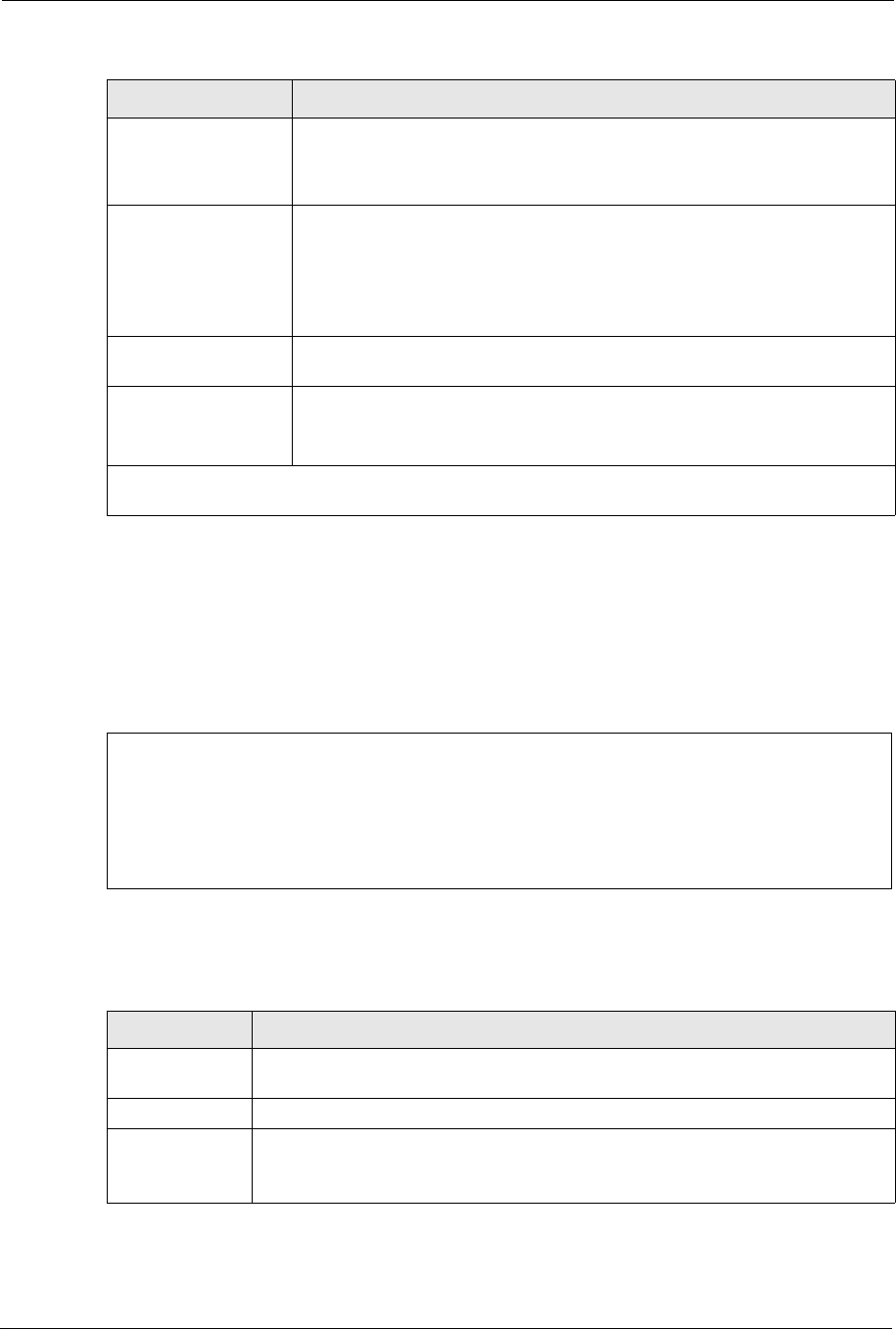
P-660H/HW/W-T Series User’ Guide
219 Chapter 20 Menu 2 WAN Backup Setup
20.2.1 Traffic Redirect Setup
Configure parameters that determine when the Prestige will forward WAN traffic to the
backup gateway using Menu 2.1 — Traffic Redirect Setup.
Figure 113 Menu 2.1Traffic Redirect Setup
The following table describes the fields in this menu.
KeepAlive Fail
Tolerance
Type the number of times (2 recommended) that your Prestige may ping the IP
addresses configured in the Check WAN IP Address field without getting a
response before switching to a WAN backup connection (or a different WAN
backup connection).
Recovery Interval(sec) When the Prestige is using a lower priority connection (usually a WAN backup
connection), it periodically checks to whether or not it can use a higher priority
connection.
Type the number of seconds (30 recommended) for the Prestige to wait
between checks. Allow more time if your destination IP address handles lots of
traffic.
ICMP Timeout Type the number of seconds for an ICMP session to wait for the ICMP
response
Traffic Redirect Press [SPACE BAR] to select Yes or No.
Select Yes and press [ENTER] to configure Menu 2.1 Traffic Redirect Setup.
Select No (default) if you do not want to configure this feature.
When you have completed this menu, press [ENTER] at the prompt “Press ENTER to Confirm
or ESC to Cancel:” to save your configuration, or press [ESC] at any time to cancel.
Table 76 Menu 2 WAN Backup Setup (continued)
FIELD DESCRIPTION
Menu 2.1 - Traffic Redirect Setup
Active= No
Configuration:
Backup Gateway IP Address= 0.0.0.0
Metric= 15
Press ENTER to Confirm or ESC to Cancel:
Table 77 Menu 2.1Traffic Redirect Setup
FIELD DESCRIPTION
Active. Press [SPACE BAR] and select Yes (to enable) or No (to disable) traffic redirect
setup. The default is No
Configuration
Backup Gateway
IP Address
Enter the IP address of your backup gateway in dotted decimal notation.
The Prestige automatically forwards traffic to this IP address if the Prestige’s
Internet connection terminates.

P-660H/HW/W-T Series User’ Guide
Chapter 20 Menu 2 WAN Backup Setup 220
Metric This field sets this route's priority among the routes the Prestige uses.
The metric represents the "cost of transmission". A router determines the best route
for transmission by choosing a path with the lowest "cost". RIP routing uses hop
count as the measurement of cost, with a minimum of "1" for directly connected
networks. The number must be between "1" and "15"; a number greater than "15"
means the link is down. The smaller the number, the lower the "cost"
When you have completed this menu, press [ENTER] at the prompt “Press ENTER to Confirm
or ESC to Cancel:” to save your configuration, or press [ESC] at any time to cancel.
Table 77 Menu 2.1Traffic Redirect Setup
FIELD DESCRIPTION

P-660H/HW/W-T Series User’ Guide
221 Chapter 20 Menu 2 WAN Backup Setup

P-660H/HW/W-T Series User’ Guide
Chapter 21 Menu 3 LAN Setup 222
CHAPTER 21
Menu 3 LAN Setup
This chapter covers how to configure your wired Local Area Network (LAN) settings.
21.1 LAN Setup
This section describes how to configure the Ethernet using Menu 3 — LAN Setup. From the
main menu, enter 3 to display menu 3.
Figure 114 Menu 3 LAN Setup
21.1.1 General Ethernet Setup
This menu allows you to specify filter set(s) that you wish to apply to the Ethernet traffic. You
seldom need to filter Ethernet traffic; however, the filter sets may be useful to block certain
packets, reduce traffic and prevent security breaches.
Figure 115 Menu 3.1 LAN Port Filter Setup
If you need to define filters, please read Chapter 29 on page 272 first, then return to this menu
to define the filter sets.
Menu 3 - LAN Setup
1. LAN Port Filter Setup
2. TCP/IP and DHCP Setup
5. Wireless LAN Setup
Enter Menu Selection Number:
Menu 3.1 - LAN Port Filter Setup
Input Filter Sets:
protocol filters=
device filters=
Output Filter Sets:
protocol filters=
device filters=
Press ENTER to Confirm or ESC to Cancel:

P-660H/HW/W-T Series User’ Guide
223 Chapter 21 Menu 3 LAN Setup
21.2 Protocol Dependent Ethernet Setup
Depending on the protocols for your applications, you need to configure the respective
Ethernet Setup, as outlined below.
• TCP/IP Ethernet setup
• Bridging Ethernet setup
21.3 TCP/IP Ethernet Setup and DHCP
Use menu 3.2 to configure your Prestige for TCP/IP.
To edit menu 3.2, enter 3 from the main menu to display Menu 3 — LAN Setup. When menu
3 appears, press 2 and press [ENTER] to display Menu 3.2 — TCP/IP and DHCP Ethernet
Setup, as shown next:
Figure 116 Menu 3.2 TCP/IP and DHCP Ethernet Setup
Menu 3.2 - TCP/IP and DHCP Setup
DHCP Setup
DHCP= Server
Client IP Pool Starting Address= 192.168.1.33
Size of Client IP Pool= 32
Primary DNS Server= 0.0.0.0
Secondary DNS Server= 0.0.0.0
Remote DHCP Server= N/A
TCP/IP Setup:
IP Address= 192.168.1.1
IP Subnet Mask= 255.255.255.0
RIP Direction= None
Version= N/A
Multicast= None
IP Policies=
Edit IP Alias= No
Press ENTER to Confirm or ESC to Cancel:

P-660H/HW/W-T Series User’ Guide
Chapter 21 Menu 3 LAN Setup 224
Follow the instructions in the following table on how to configure the DHCP fields.
Follow the instructions in the following table to configure TCP/IP parameters for the Ethernet port.
Table 78 DHCP Ethernet Setup
FIELD DESCRIPTION
DHCP Setup
DHCP If set to Server, your Prestige can assign IP addresses, an IP default
gateway and DNS servers to Windows 95, Windows NT and other systems
that support the DHCP client.
If set to None, the DHCP server will be disabled.
If set to Relay, the Prestige acts as a surrogate DHCP server and relays
DHCP requests and responses between the remote server and the clients.
Enter the IP address of the actual, remote DHCP server in the Remote
DHCP Server in this case.
When DHCP server is used, the following items need to be set:
Client IP Pool Starting
Address
This field specifies the first of the contiguous addresses in the IP address
pool.
Size of Client IP Pool This field specifies the size or count of the IP address pool.
Primary DNS Server
Secondary DNS Server
Enter the IP addresses of the DNS servers. The DNS servers are passed to
the DHCP clients along with the IP address and the subnet mask.
Remote DHCP Serve If Relay is selected in the DHCP field above then enter the IP address of the
actual remote DHCP server here.
Table 79 TCP/IP Ethernet Setup
FIELD DESCRIPTION
TCP/IP Setup
IP Address Enter the (LAN) IP address of your Prestige in dotted decimal notation
IP Subnet Mask Your Prestige will automatically calculate the subnet mask based on the IP address
that you assign. Unless you are implementing subnetting, use the subnet mask
computed by the Prestige (refer to the appendices for more information).
RIP Direction Press [SPACE BAR] to select the RIP direction. Choices are Both, In Only, Out
Only or None.
Version Press [SPACE BAR] to select the RIP version. Choices are RIP-1, RIP-2B or RIP-
2M.
Multicast IGMP (Internet Group Multicast Protocol) is a network-layer protocol used to
establish membership in a Multicast group. The Prestige supports both IGMP
version 1 (IGMP-v1) and version 2 (IGMP-v2). Press the [SPACE BAR] to enable
IP Multicasting or select None to disable it.
IP Policies Create policies using SMT menu 25 and apply them on the Prestige LAN interface
here. You can apply up to four IP Policy sets (from twelve) by entering their numbers
separated by commas.
Edit IP Alias The Prestige supports three logical LAN interfaces via its single physical Ethernet
interface with the Prestige itself as the gateway for each LAN network. Press
[SPACE BAR] to change No to Yes and press [ENTER] to display Menu 3.2.1.

P-660H/HW/W-T Series User’ Guide
225 Chapter 21 Menu 3 LAN Setup

P-660H/HW/W-T Series User’ Guide
Chapter 22 Wireless LAN Setup 226
CHAPTER 22
Wireless LAN Setup
This chapter covers how to configure wireless LAN settings in SMT menu 3.5 for P-660HW
and P-660W.
22.1 Wireless LAN Overview
Refer to the chapter on the wireless LAN screens for wireless LAN background information.
22.2 Wireless LAN Setup
Use menu 3.5 to set up your Prestige as the wireless access point. To edit menu 3.5, enter 3
from the main menu to display Menu 3 – LAN Setup. When menu 3 appears, press 5 and then
press [ENTER] to display Menu 3.5 – Wireless LAN Setup as shown next.
Figure 117 Menu 3.5 - Wireless LAN Setup
The following table describes the fields in this menu.
Menu 3.5- Wireless LAN Setup
ESSID= Wireless
Hide ESSID= No
Channel ID= CH06 2437MHz
RTS Threshold= 2432
Frag. Threshold= 2432
WEP= Disable
Default Key= N/A
Key1= N/A
Key2= N/A
Key3= N/A
Key4= N/A
Edit MAC Address Filter= No
Press ENTER to Confirm or ESC to Cancel:
Table 80 Menu 3.5 - Wireless LAN Setup
FIELD DESCRIPTION
ESSID The ESSID (Extended Service Set IDentifier) identifies the AP to which the wireless
stations associate. Wireless stations associating to the Access Point must have the
same ESSID. Enter a descriptive name of up to 32 printable 7-bit ASCII characters.
Hide ESSID Press [SPACE BAR] and select Yes to hide the ESSID in the outgoing beacon frame so
a station cannot obtain the ESSID through passive scanning.

P-660H/HW/W-T Series User’ Guide
227 Chapter 22 Wireless LAN Setup
22.2.1 Wireless LAN MAC Address Filter
The next layer of security is MAC address filter. To allow a wireless station to associate with
the Prestige, enter the MAC address of the wireless LAN adapter on that wireless station in the
MAC address table.
Channel ID Press [SPACE BAR] to select a channel. This allows you to set the operating frequency/
channel depending on your particular region.
RTS
Threshold
RTS(Request To Send) threshold (number of bytes) enables RTS/CTS handshake. Data
with its frame size larger than this value will perform the RTS/CTS handshake. Setting
this attribute to be larger than the maximum MSDU (MAC Service Data Unit) size turns
off the RTS/CTS handshake. Setting this attribute to zero turns on the RTS/CTS
handshake. Enter a value between 0 and 2432.
Frag.
Threshold
The threshold (number of bytes) for the fragmentation boundary for directed messages.
It is the maximum data fragment size that can be sent. Enter a value between 256 and
2432.
WEP WEP (Wired Equivalent Privacy) provides data encryption to prevent wireless stations
from accessing data transmitted over the wireless network.
Select Disable allows wireless stations to communicate with the access points without
any data encryption.
Select 64-bit WEP or 128-bit WEP to for the type of data encryption. WEP causes
performance degradation.
Default Key Enter the number of the key as an active key.
Key 1 to Key
4
If you chose 64-bit WEP in the WEP Encryption field, then enter 5 characters or 10
hexadecimal characters ("0-9", "A-F") preceded by 0x for each key (1-4).
If you chose 128-bit WEP in the WEP Encryption field, then enter 13 characters or 26
hexadecimal characters ("0-9", "A-F") preceded by 0x for each key (1-4).
There are four data encryption keys to secure your data from eavesdropping by
unauthorized wireless users. The values for the keys must be set up exactly the same on
the access points as they are on the wireless stations.
Edit MAC
Address
Filter
To edit MAC address filtering table, press [SPACE BAR] to select Yes and press
[ENTER] to open menu 3.5.1.
When you have completed this menu, press [ENTER] at the prompt “Press ENTER to Confirm
or ESC to Cancel:” to save your configuration, or press [ESC] at any time to cancel.
Table 80 Menu 3.5 - Wireless LAN Setup (continued)
FIELD DESCRIPTION
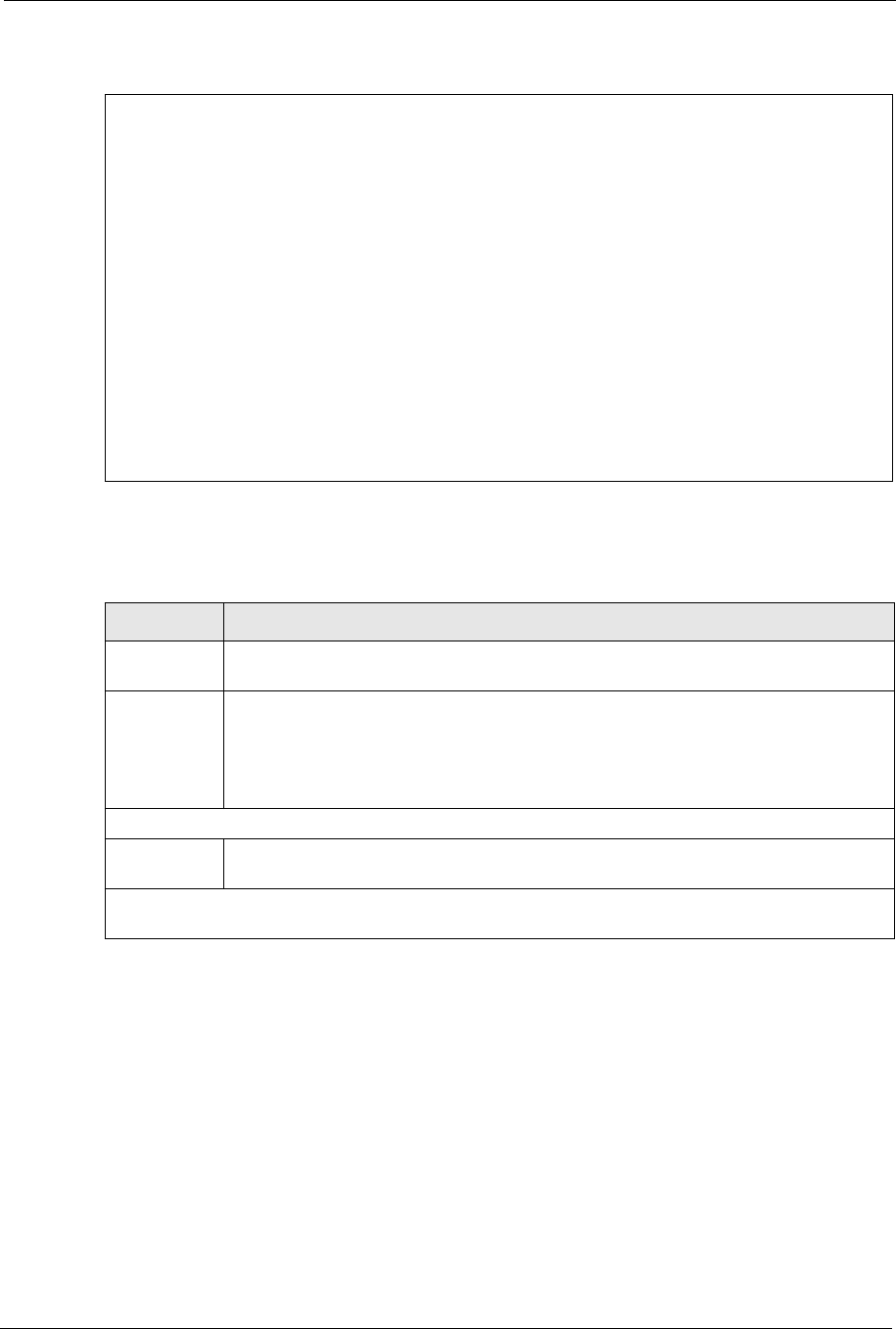
P-660H/HW/W-T Series User’ Guide
Chapter 22 Wireless LAN Setup 228
Figure 118 Menu 3.5.1 WLAN MAC Address Filtering
The following table describes the fields in this menu.
Menu 3.5.1 - WLAN MAC Address Filter
Active= No
Filter Action= Allowed Association
--------------------------------------------------------------------------
1= 00:00:00:00:00:00 13= 00:00:00:00:00:00 25= 00:00:00:00:00:00
2= 00:00:00:00:00:00 14= 00:00:00:00:00:00 26= 00:00:00:00:00:00
3= 00:00:00:00:00:00 15= 00:00:00:00:00:00 27= 00:00:00:00:00:00
4= 00:00:00:00:00:00 16= 00:00:00:00:00:00 28= 00:00:00:00:00:00
5= 00:00:00:00:00:00 17= 00:00:00:00:00:00 29= 00:00:00:00:00:00
6= 00:00:00:00:00:00 18= 00:00:00:00:00:00 30= 00:00:00:00:00:00
7= 00:00:00:00:00:00 19= 00:00:00:00:00:00 31= 00:00:00:00:00:00
8= 00:00:00:00:00:00 20= 00:00:00:00:00:00 32= 00:00:00:00:00:00
9= 00:00:00:00:00:00 21= 00:00:00:00:00:00
10= 00:00:00:00:00:00 22= 00:00:00:00:00:00
11= 00:00:00:00:00:00 23= 00:00:00:00:00:00
12= 00:00:00:00:00:00 24= 00:00:00:00:00:00
--------------------------------------------------------------------------
Enter here to CONFIRM or ESC to CANCEL:
Table 81 Menu 3.5.1 WLAN MAC Address Filtering
FIELD DESCRIPTION
Active To enable MAC address filtering, press [SPACE BAR] to select Yes and press
[ENTER].
Filter Action Define the filter action for the list of MAC addresses in the MAC address filter table.
To deny access to the Prestige, press [SPACE BAR] to select Deny Association and
press [ENTER]. MAC addresses not listed will be allowed to access the router.
The default action, Allowed Association, permits association with the Prestige. MAC
addresses not listed will be denied access to the router.
MAC Address Filter
Address 1. Enter the MAC addresses (in XX:XX:XX:XX:XX:XX format) of the wireless stations that
are allowed or denied access to the Prestige in these address fields.
When you have completed this menu, press [ENTER] at the prompt “Press ENTER to Confirm
or ESC to Cancel:” to save your configuration, or press [ESC] at any time to cancel.

P-660H/HW/W-T Series User’ Guide
229 Chapter 22 Wireless LAN Setup

P-660H/HW/W-T Series User’ Guide
Chapter 23 Internet Access 230
CHAPTER 23
Internet Access
This chapter shows you how to configure the LAN and WAN of your Prestige for Internet
access.
23.1 Internet Access Overview
Refer to the chapters on the web configurator’s wizard, LAN and WAN screens for more
background information on fields in the SMT screens covered in this chapter.
23.2 IP Policies
Traditionally, routing is based on the destination address only and the router takes the shortest
path to forward a packet. IP Policy Routing (IPPR) provides a mechanism to override the
default routing behavior and alter the packet forwarding based on the policy defined by the
network administrator. Policy-based routing is applied to incoming packets on a per interface
basis, prior to the normal routing. Create policies using SMT menu 25 and apply them on the
Prestige LAN and/or WAN interfaces using menus 3.2 (LAN) and 11.3 (WAN).
23.3 IP Alias
IP alias allows you to partition a physical network into different logical networks over the
same Ethernet interface. The Prestige supports three logical LAN interfaces via its single
physical Ethernet interface with the Prestige itself as the gateway for each LAN network.
When you use IP alias, you can also configure firewall rules to control access between the
LAN's logical networks (subnets).
Note: Make sure that the subnets of the logical networks do not overlap.
The following figure shows a LAN divided into subnets A, B, and C.
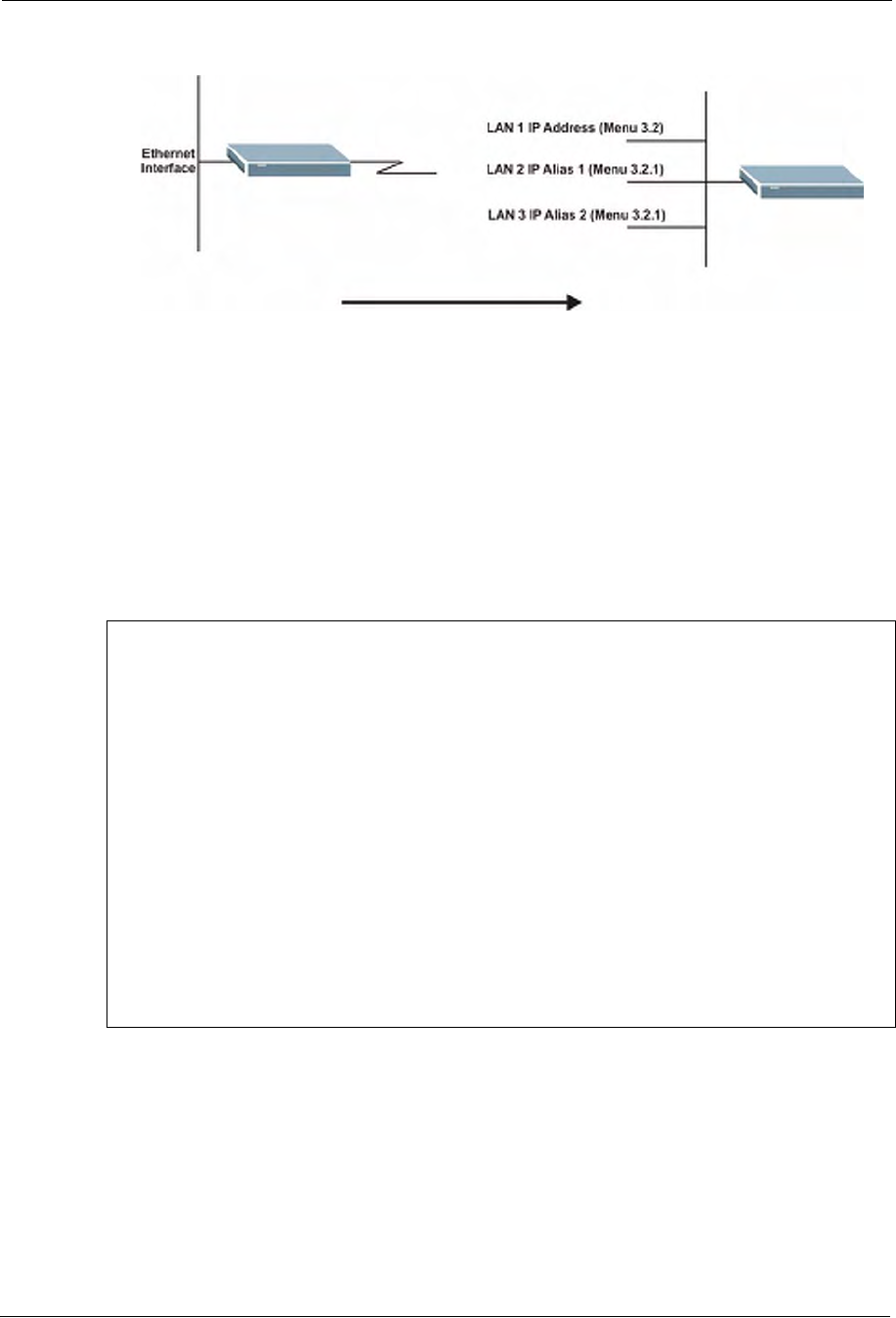
P-660H/HW/W-T Series User’ Guide
231 Chapter 23 Internet Access
Figure 119 IP Alias Network Example
Use menu 3.2.1 to configure IP Alias on your Prestige.
23.4 IP Alias Setup
Use menu 3.2 to configure the first network. Move the cursor to Edit IP Alias field and press
[SPACEBAR] to choose Ye s and press [ENTER] to configure the second and third network.
Figure 120 Menu 3.2 TCP/IP and DHCP Setup
Pressing [ENTER] displays Menu 3.2.1 — IP Alias Setup, as shown next.
Menu 3.2 - TCP/IP and DHCP Setup
DHCP Setup
DHCP= Server
Client IP Pool Starting Address= 192.168.1.33
Size of Client IP Pool= 32
Primary DNS Server= 0.0.0.0
Secondary DNS Server= 0.0.0.0
Remote DHCP Server= N/A
TCP/IP Setup:
IP Address= 192.168.1.1
IP Subnet Mask= 255.255.255.0
RIP Direction= None
Version= N/A
Multicast= None
IP Policies=
Edit IP Alias= No
Press ENTER to Confirm or ESC to Cancel:
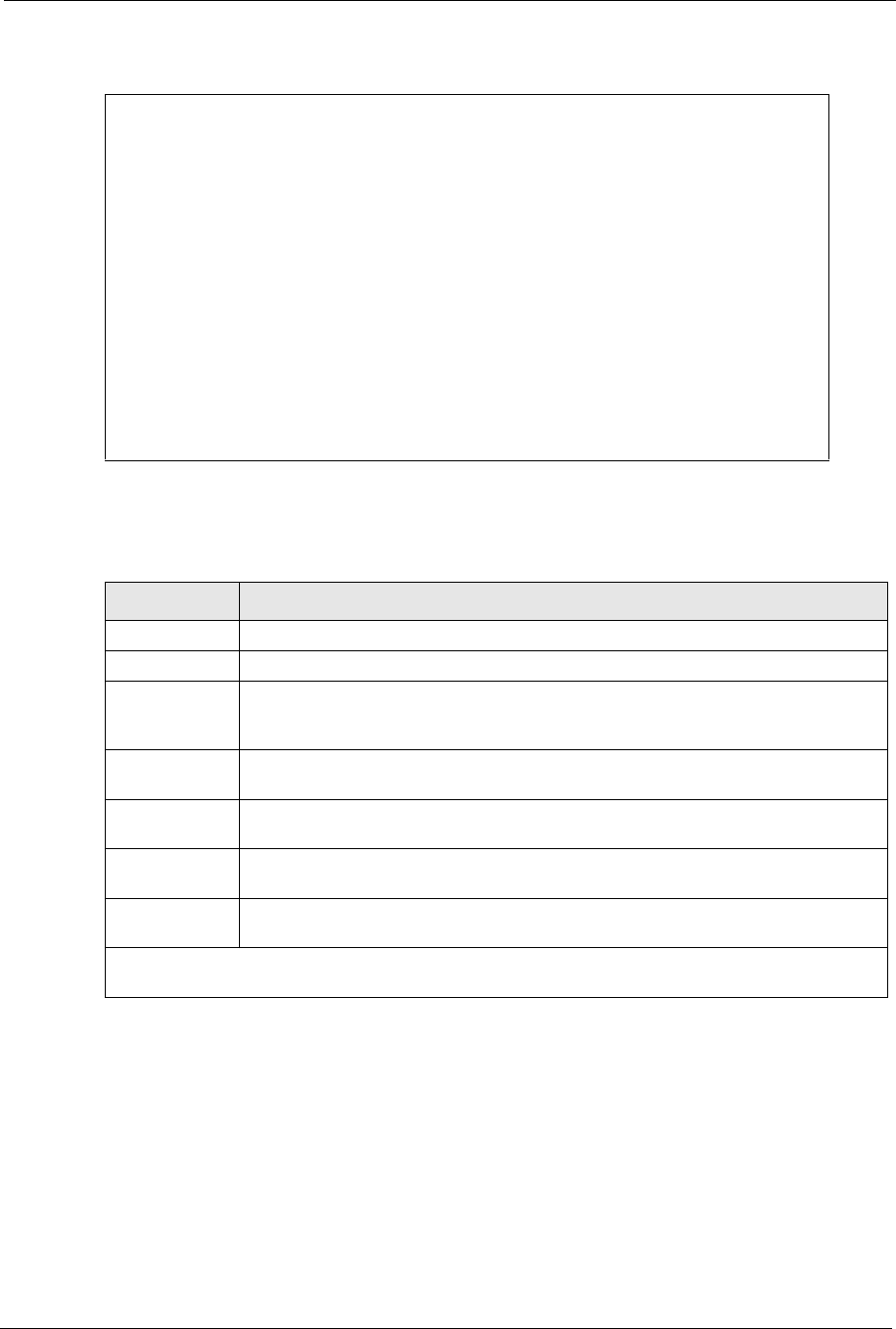
P-660H/HW/W-T Series User’ Guide
Chapter 23 Internet Access 232
Figure 121 Menu 3.2.1 IP Alias Setup
Follow the instructions in the following table to configure IP Alias parameters.
23.5 Route IP Setup
The first step is to enable the IP routing in Menu 1 — General Setup.
To edit menu 1, type 1 in the main menu and press [ENTER]. Set the Route IP field to Yes
by pressing [SPACE BAR].
Menu 3.2.1 - IP Alias Setup
IP Alias 1= No
IP Address= N/A
IP Subnet Mask= N/A
RIP Direction= N/A
Version= N/A
Incoming protocol filters= N/A
Outgoing protocol filters= N/A
IP Alias 2= No
IP Address= N/A
IP Subnet Mask= N/A
RIP Direction= N/A
Version= N/A
Incoming protocol filters= N/A
Outgoing protocol filters= N/A
Enter here to CONFIRM or ESC to CANCEL:
Table 82 Menu 3.2.1 IP Alias Setup
FIELD DESCRIPTION
IP Alias Choose Yes to configure the LAN network for the Prestige.
IP Address Enter the IP address of your Prestige in dotted decimal notation
IP Subnet Mask Your Prestige will automatically calculate the subnet mask based on the IP address
that you assign. Unless you are implementing subnetting, use the subnet mask
computed by the Prestige
RIP Direction Press [SPACE BAR] to select the RIP direction. Choices are None,Both,In Only
or Out Only.
Version Press [SPACE BAR] to select the RIP version. Choices are RIP-1,RIP-2B or RIP-
2M.
Incoming
Protocol Filters
Enter the filter set(s) you wish to apply to the incoming traffic between this node and
the Prestige.
Outgoing
Protocol Filters
Enter the filter set(s) you wish to apply to the outgoing traffic between this node and
the Prestige.
When you have completed this menu, press [ENTER] at the prompt “Press ENTER to Confirm
or ESC to Cancel:” to save your configuration, or press [ESC] at any time to cancel.

P-660H/HW/W-T Series User’ Guide
233 Chapter 23 Internet Access
Figure 122 Menu 1 General Setup
23.6 Internet Access Configuration
Menu 4 allows you to enter the Internet Access information in one screen. Menu 4 is actually
a simplified setup for one of the remote nodes that you can access in menu 11. Before you
configure your Prestige for Internet access, you need to collect your Internet account
information.
Use the Internet Account Information table in the Quick Start Guide to record your. Note that
if you are using PPPoA or PPPoE encapsulation, then the only ISP information you need is a
login name and password. You only need to know the Ethernet Encapsulation Gateway IP
address if you are using ENET ENCAP encapsulation.
From the main menu, type 4 to display Menu 4 - Internet Access Setup, as shown next.
Figure 123 Menu 4 Internet Access Setup
The following table contains instructions on how to configure your Prestige for Internet access
Menu 1 - General Setup
System Name= ?
Location= location
Contact Person's Name=
Domain Name=
Edit Dynamic DNS= No
Route IP= Yes
Bridge= No
Press ENTER to Confirm or ESC to Cancel:
Menu 4 - Internet Access Setup
ISP's Name= MyISP
Encapsulation= RFC 1483
Multiplexing= LLC-based
VPI #= 8
VCI #= 35
ATM QoS Type= CBR
Peak Cell Rate (PCR)= 0
Sustain Cell Rate (SCR)= 0
Maximum Burst Size (MBS)= 0
My Login= N/A
My Password= N/A
ENET ENCAP Gateway= N/A
IP Address Assignment= Static
IP Address= 0.0.0.0
Network Address Translation= SUA Only
Address Mapping Set= N/A
Press ENTER to Confirm or ESC to Cancel:

P-660H/HW/W-T Series User’ Guide
Chapter 23 Internet Access 234
.
If all your settings are correct your Prestige should connect automatically to the Internet. If the
connection fails, note the error message that you receive on the screen and take the appropriate
troubleshooting steps.
Table 83 Menu 4 Internet Access Setup
FIELD DESCRIPTION
ISP’s Name Enter the name of your Internet Service Provider (ISP). This information is for
identification purposes only.
Encapsulation Press [SPACE BAR] to select the method of encapsulation used by your ISP.
Choices are PPPoE,PPPoA,RFC 1483 or ENET ENCAP.
Multiplexing Press [SPACE BAR] to select the method of multiplexing used by your ISP.
Choices are VC-based or LLC-based.
VPI # Enter the Virtual Path Identifier (VPI) assigned to you.
VCI # Enter the Virtual Channel Identifier (VCI) assigned to you.
ATM QoS Type Press [SPACE BAR] and select CBR (Continuous Bit Rate) to specify fixed
(always-on) bandwidth. Select UBR (Unspecified Bit Rate) for applications that are
non-time sensitive, such as e-mail. Select VBR (Variable Bit Rate) for bursty traffic
and bandwidth sharing with other applications.
Peak Cell Rate
(PCR)
This is the maximum rate at which the sender can send cells. Type the PCR.
Sustain Cell Rate
(SCR)= 0
Sustained Cell Rate is the mean cell rate of a bursty, on-off traffic source that can
be sent at the peak rate, and a parameter for burst-traffic. Type the SCR; it must
be less than the PCR.
Maximum Burst
Size (MBS)= 0
Refers to the maximum number of cells that can be sent at the peak rate. Type the
MBS. The MBS must be less than 65535.
My Login Configure the My Login and My Password fields for PPPoA and PPPoE
encapsulation only. Enter the login name that your ISP gives you. If you are using
PPPoE encapsulation,then this field must be of the form user@domain where
domain identifies your PPPoE service name.
My Password Enter the password associated with the login name above.
ENET ENCAP
Gateway
Enter the gateway IP address supplied by your ISP when you are using ENET
ENCAP encapsulation.
Idle Timeout This value specifies the number of idle seconds that elapse before the Prestige
automatically disconnects the PPPoE session.
IP Address
Assignment
Press [SPACE BAR] to select Static or Dynamic address assignment.
IP Address Enter the IP address supplied by your ISP if applicable.
Network Address
Translation
Press [SPACE BAR] to select None,SUA Only or Full Feature. Please see the
NAT chapter for more details on the SUA (Single User Account) feature.
Address Mapping
Set
Type the numbers of mapping sets (1-8) to use with NAT.
When you have completed this menu, press [ENTER] at the prompt “Press ENTER to Confirm
or ESC to Cancel:” to save your configuration, or press [ESC] at any time to cancel.

P-660H/HW/W-T Series User’ Guide
235 Chapter 23 Internet Access

P-660H/HW/W-T Series User’ Guide
Chapter 24 Remote Node Configuration 236
CHAPTER 24
Remote Node Configuration
This chapter covers remote node configuration.
24.1 Remote Node Setup Overview
This section describes the protocol-independent parameters for a remote node. A remote node
is required for placing calls to a remote gateway. A remote node represents both the remote
gateway and the network behind it across a WAN connection. When you use menu 4 to set up
Internet access, you are configuring one of the remote nodes.
You first choose a remote node in Menu 11- Remote Node Setup. You can then edit that
node’s profile in menu 11.1, as well as configure specific settings in three submenus: edit IP
and bridge options in menu 11.3; edit ATM options in menu 11.6; and edit filter sets in menu
11.5.
24.2 Remote Node Setup
This section describes the protocol-independent parameters for a remote node.
24.2.1 Remote Node Profile
To configure a remote node, follow these steps:
1From the main menu, enter 11 to display Menu 11 - Remote Node Setup.
2When menu 11 appears, as shown in the following figure, type the number of the remote
node that you want to configure.

P-660H/HW/W-T Series User’ Guide
237 Chapter 24 Remote Node Configuration
Figure 124 Menu 11 Remote Node Setup
24.2.2 Encapsulation and Multiplexing Scenarios
For Internet access you should use the encapsulation and multiplexing methods used by your
ISP. Consult your telephone company for information on encapsulation and multiplexing
methods for LAN-to-LAN applications, for example between a branch office and corporate
headquarters. There must be prior agreement on encapsulation and multiplexing methods
because they cannot be automatically determined. What method(s) you use also depends on
how many VCs you have and how many different network protocols you need. The extra
overhead that ENET ENCAP encapsulation entails makes it a poor choice in a LAN-to-LAN
application. Here are some examples of more suitable combinations in such an application.
24.2.2.1 Scenario 1: One VC, Multiple Protocols
PPPoA (RFC-2364) encapsulation with VC-based multiplexing is the best combination
because no extra protocol identifying headers are needed. The PPP protocol already contains
this information.
24.2.2.2 Scenario 2: One VC, One Protocol (IP)
Selecting RFC-1483 encapsulation with VC-based multiplexing requires the least amount of
overhead (0 octets). However, if there is a potential need for multiple protocol support in the
future, it may be safer to select PPPoA encapsulation instead of RFC-1483, so you do not
need to reconfigure either computer later.
24.2.2.3 Scenario 3: Multiple VCs
If you have an equal number (or more) of VCs than the number of protocols, then select RFC-
1483 encapsulation and VC-based multiplexing.
Menu 11 - Remote Node Setup
1. MyISP (ISP, SUA)
2. ________
3. ________
4. ________
5. ________
6. ________
7. ________
8. ________
Enter Node # to Edit:

P-660H/HW/W-T Series User’ Guide
Chapter 24 Remote Node Configuration 238
Figure 125 Menu 11.1 Remote Node Profile
In Menu 11.1 – Remote Node Profile, fill in the fields as described in the following table.
Menu 11.1 - Remote Node Profile
Rem Node Name= MyISP Route= IP
Active= Yes Bridge= No
Encapsulation= RFC 1483 Edit IP/Bridge= No
Multiplexing= LLC-based Edit ATM Options= No
Service Name= N/A Edit Advance Options= N/A
Incoming: Telco Option:
Rem Login= N/A Allocated Budget(min)= N/A
Rem Password= N/A Period(hr)= N/A
Outgoing: Schedule Sets= N/A
My Login= N/A Nailed-Up Connection= N/A
My Password= N/A Session Options:
Authen= N/A Edit Filter Sets= No
Idle Timeout(sec)= N/A
Press ENTER to Confirm or ESC to Cancel:
Table 84 Menu 11.1 Remote Node Profile
FIELD DESCRIPTION
Rem Node Name Type a unique, descriptive name of up to eight characters for this node.
Active Press [SPACE BAR] and then [ENTER] to select Yes to activate or No to
deactivate this node. Inactive nodes are displayed with a minus sign –“ in SMT
menu 11.
Encapsulation PPPoA refers to RFC-2364 (PPP Encapsulation over ATM Adaptation Layer 5).
If RFC-1483 (Multiprotocol Encapsulation over ATM Adaptation Layer 5) of ENET
ENCAP are selected,
then the Rem Login,Rem Password,My Login,My Password and Authen
fields are not applicable (N/A).
Multiplexing Press [SPACE BAR] and then [ENTER] to select the method of multiplexing that
your ISP uses, either VC-based or LLC-based.
Service Name When using PPPoE encapsulation, type the name of your PPPoE service here.
Incoming:
Rem Login Type the login name that this remote node will use to call your Prestige. The login
name and the Rem Password will be used to authenticate this node.
Rem Password Type the password used when this remote node calls your Prestige.
Outgoing:
My Login Type the login name assigned by your ISP when the Prestige calls this remote
node.
My Password Type the password assigned by your ISP when the Prestige calls this remote
node.
Authen This field sets the authentication protocol used for outgoing calls. Options for this
field are:
CHAP/PAP – Your Prestige will accept either CHAP or PAP when requested by
this remote node.
CHAP – accept CHAP (Challenge Handshake Authentication Protocol) only.

P-660H/HW/W-T Series User’ Guide
239 Chapter 24 Remote Node Configuration
24.2.3 Outgoing Authentication Protocol
For obvious reasons, you should employ the strongest authentication protocol possible.
However, some vendors’ implementation includes specific authentication protocol in the user
profile. It will disconnect if the negotiated protocol is different from that in the user profile,
even when the negotiated protocol is stronger than specified. If the peer disconnects right after
a successful authentication, make sure that you specify the correct authentication protocol
when connecting to such an implementation.
PAP – accept PAP (Password Authentication Protocol) only.
Route This field determines the protocol used in routing. Options are IP and None.
Bridge When bridging is enabled, your Prestige will forward any packet that it does not
route to this remote node; otherwise, the packets are discarded. Select Yes to
enable and No to disable.
Edit IP/Bridge Press [SPACE BAR] to select Yes and press [ENTER] to display Menu 11.3 –
Remote Node Network Layer Options.
Edit ATM Options Press [SPACE BAR] to select Yes and press [ENTER] to display Menu 11.6 –
Remote Node ATM Layer Options.
Edit Advance
Options
This field is only available when you select PPPoE in the Encapsulation field.
Press [SPACE BAR] to select Yes and press [ENTER] to display Menu 11.8 –
Advance Setup Options.
Telco Option
Allocated Budget
(min)
This sets a ceiling for outgoing call time for this remote node. The default for this
field is 0 meaning no budget control.
Period (hr) This field is the time period that the budget should be reset. For example, if we
are allowed to call this remote node for a maximum of 10 minutes every hour,
then the Allocated Budget is (10 minutes) and the Period (hr) is 1 (hour).
Schedule Sets This field is only applicable for PPPoE and PPPoA encapsulation. You can apply
up to four schedule sets here. For more details please refer to Chapter 37 on
page 338.
Nailed up
Connection
This field is only applicable for PPPoE and PPPoA encapsulation. This field
specifies if you want to make the connection to this remote node a nailed-up
connection. More details are given earlier in this section.
Session Options
Edit Filter Sets Use [SPACE BAR] to choose Yes and press [ENTER] to open menu 11.5 to edit
the filter sets. See Chapter 29 on page 272 for more details.
Idle Timeout (sec) Type the number of seconds (0-9999) that can elapse when the Prestige is idle
(there is no traffic going to the remote node), before the Prestige automatically
disconnects the remote node. 0 means that the session will not timeout.
When you have completed this menu, press [ENTER] at the prompt “Press ENTER to Confirm
or ESC to Cancel:” to save your configuration, or press [ESC] at any time to cancel.
Table 84 Menu 11.1 Remote Node Profile (continued)
FIELD DESCRIPTION

P-660H/HW/W-T Series User’ Guide
Chapter 24 Remote Node Configuration 240
24.3 Remote Node Network Layer Options
For the TCP/IP parameters, perform the following steps to edit Menu 11.3 – Remote Node
Network Layer Options as shown next.
1In menu 11.1, make sure IP is among the protocols in the Route field.
2Move the cursor to the Edit IP/Bridge field, press [SPACE BAR] to select Yes, then
press [ENTER] to display Menu 11.3 – Remote Node Network Layer Options.
Figure 126 Menu 11.3 Remote Node Network Layer Options
The next table explains fields in Menu 11.3 – Remote Node Network Layer Options.
Menu 11.3 - Remote Node Network Layer Options
IP Options: Bridge Options:
IP Address Assignment = Static Ethernet Addr Timeout(min)= N/A
Rem IP Addr = 0.0.0.0
Rem Subnet Mask= 0.0.0.0
My WAN Addr= 0.0.0.0
NAT= SUA Only
Address Mapping Set= N/A
Metric= 2
Private= No
RIP Direction= None
Version= RIP-1
Multicast= None
IP Policies=
Enter here to CONFIRM or ESC to CANCEL:
Table 85 Menu 11.3 Remote Node Network Layer Options
FIELD DESCRIPTION
IP Address
Assignment
Press [SPACE BAR] and then [ENTER] to select Dynamic if the remote node is using
a dynamically assigned IP address or Static if it is using a static (fixed) IP address.
You will only be able to configure this in the ISP node (also the one you configure in
menu 4), all other nodes are set to Static.
Rem IP Addr This is the IP address you entered in the previous menu.
Rem Subnet
Mask
Type the subnet mask assigned to the remote node.
My WAN Addr Some implementations, especially UNIX derivatives, require separate IP network
numbers for the WAN and LAN links and each end to have a unique address within
the WAN network number. In that case, type the IP address assigned to the WAN port
of your Prestige.
NOTE: Refers to local Prestige address, not the remote router address.
NAT Press [SPACE BAR] and then [ENTER] to select Full Feature if you have multiple
public WAN IP addresses for your Prestige.
Select SUA Only if you have just one public WAN IP address for your Prestige. The
SMT uses Address Mapping Set 255 (seeFigure 144 on page 257).
Select None to disable NAT.
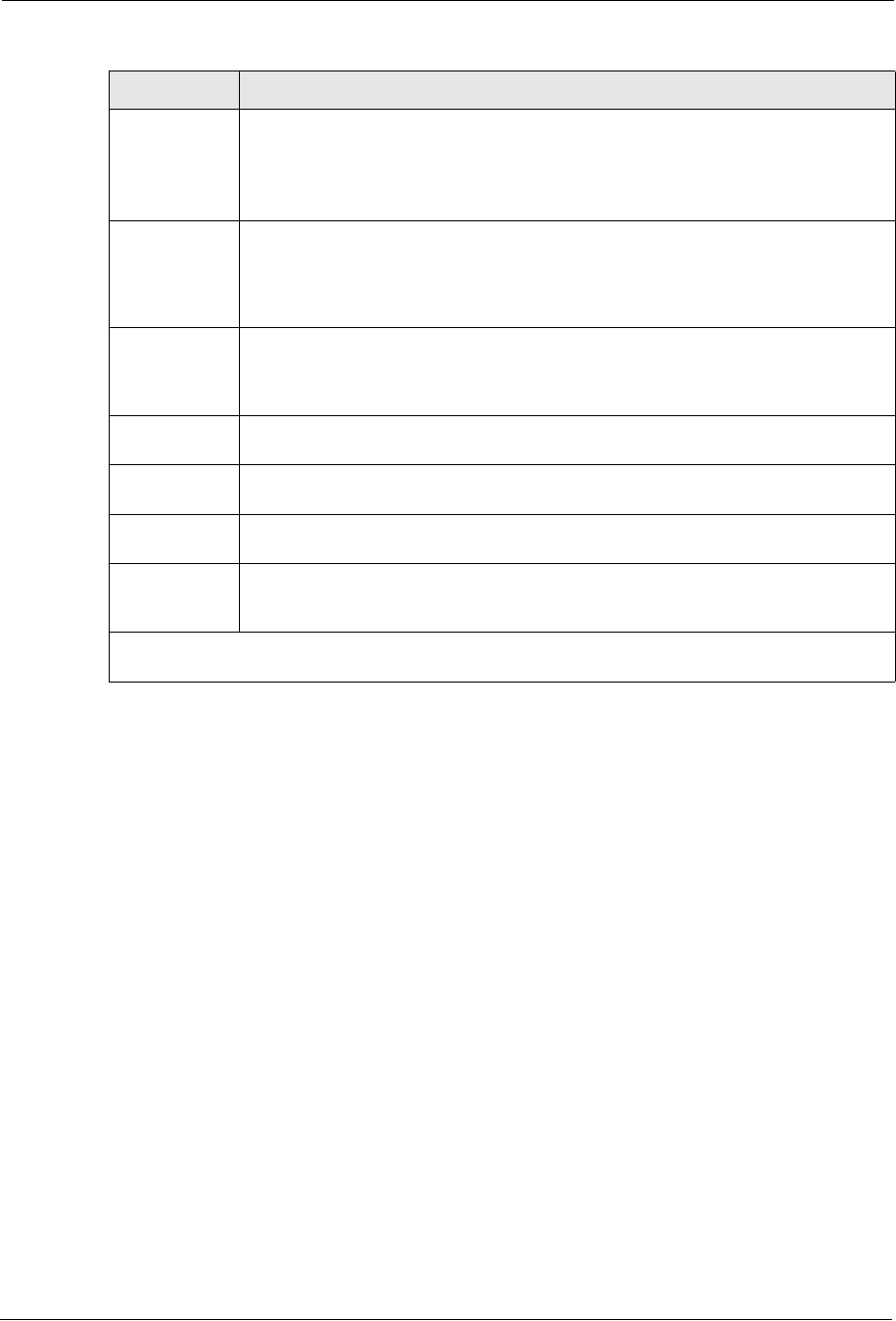
P-660H/HW/W-T Series User’ Guide
241 Chapter 24 Remote Node Configuration
24.3.1 My WAN Addr Sample IP Addresses
The following figure uses sample IP addresses to help you understand the field of My WAN
Addr in menu 11.3. My WAN Addr indicates the local Prestige WAN IP (172.16.0.1 in the
following figure) while Rem IP Addr indicates the peer WAN IP (172.16.0.2 in the following
figure).
Address
Mapping Set
When Full Feature is selected in the NAT field, configure address mapping sets in
menu 15.1. Select one of the NAT server sets (2-10) in menu 15.2 (see Chapter 27 on
page 254 for details) and type that number here.
When SUA Only is selected in the NAT field, the SMT uses NAT server set 1 in menu
15.2 (see Chapter 27 on page 254 for details).
Metric The metric represents the cost of transmission for routing purposes. IP routing uses
hop count as the cost measurement, with a minimum of 1 for directly connected
networks. Type a number that approximates the cost for this link. The number need
not be precise, but it must be between 1 and 15. In practice, 2 or 3 is usually a good
number.
Private This determines if the Prestige will include the route to this remote node in its RIP
broadcasts. If set to Yes, this route is kept private and not included in RIP broadcast.
If No, the route to this remote node will be propagated to other hosts through RIP
broadcasts.
RIP Direction Press [SPACE BAR] and then [ENTER] to select the RIP Direction. Options are
Both,In Only,Out Only or None.
Version Press [SPACE BAR] and then [ENTER] to select the RIP version. Options are RIP-1,
RIP-2B or RIP-2M.
Multicast IGMP-v1 sets IGMP to version 1, IGMP-v2 sets IGMP to version 2 and None disables
IGMP.
IP Policies You can apply up to four IP Policy sets (from 12) by typing in their numbers separated
by commas. Configure the filter sets in menu 25 first (see Chapter 36 on page 328)
and then apply them here.
When you have completed this menu, press [ENTER] at the prompt “Press ENTER to Confirm
or ESC to Cancel:” to save your configuration, or press [ESC] at any time to cancel.
Table 85 Menu 11.3 Remote Node Network Layer Options (continued)
FIELD DESCRIPTION
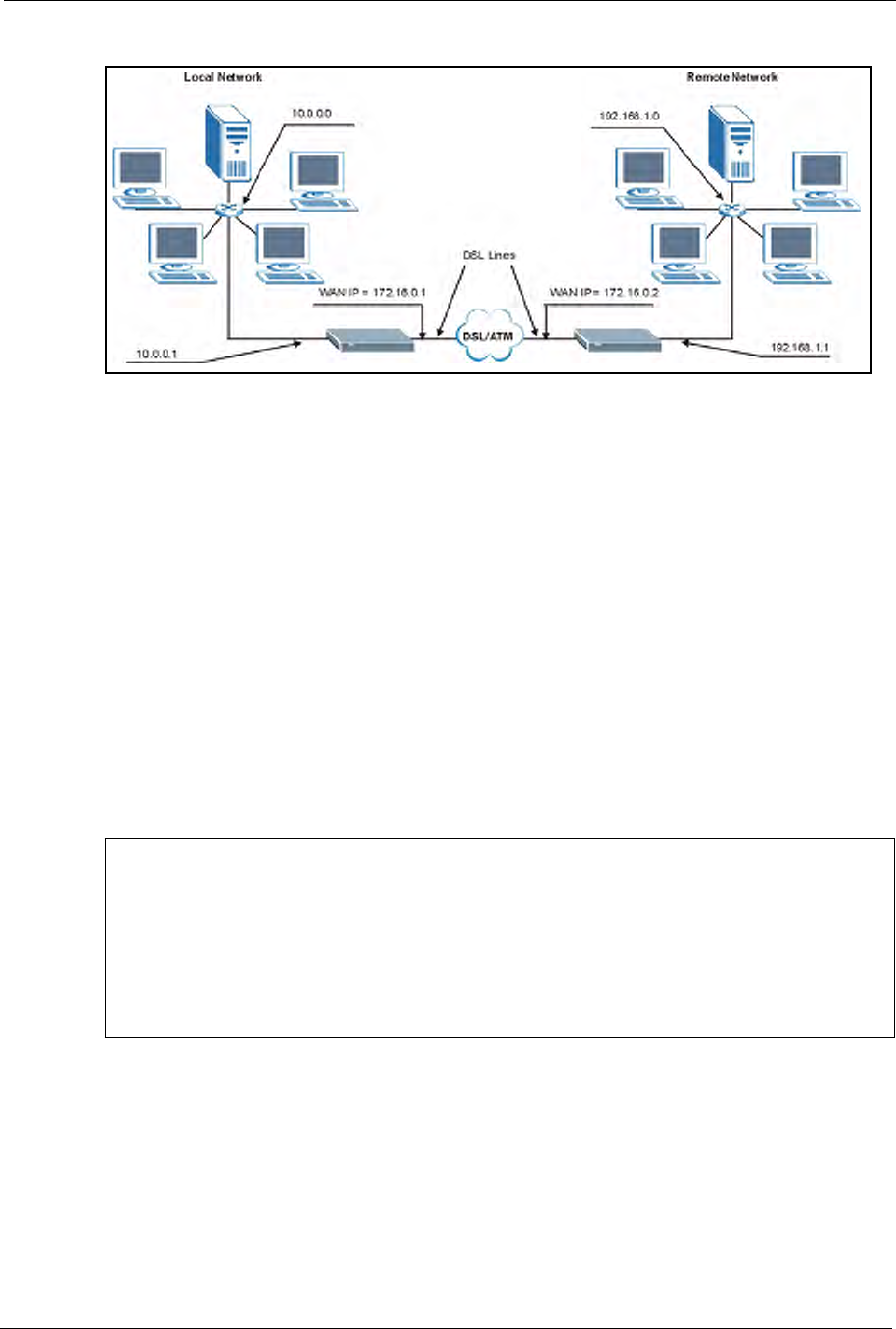
P-660H/HW/W-T Series User’ Guide
Chapter 24 Remote Node Configuration 242
Figure 127 Sample IP Addresses for a TCP/IP LAN-to-LAN Connection
24.4 Remote Node Filter
Move the cursor to the Edit Filter Sets field in menu 11.1, then press [SPACE BAR] to select
Yes. Press [ENTER] to display Menu 11.5 – Remote Node Filter.
Use Menu 11.5 – Remote Node Filter to specify the filter set(s) to apply to the incoming and
outgoing traffic between this remote node and the Prestige and also to prevent certain packets
from triggering calls. You can specify up to 4 filter sets separated by comma, for example, 1,
5, 9, 12, in each filter field.
Note that spaces are accepted in this field. The Prestige has a prepackaged filter set,
NetBIOS_WAN, that blocks NetBIOS packets. Include this in the call filter sets if you want to
prevent NetBIOS packets from triggering calls to a remote node.
Figure 128 Menu 11.5 Remote Node Filter (RFC 1483 or ENET Encapsulation)
Menu 11.5 - Remote Node Filter
Input Filter Sets:
protocol filters=
device filters=
Output Filter Sets:
protocol filters=
device filters=
Enter here to CONFIRM or ESC to CANCEL:

P-660H/HW/W-T Series User’ Guide
243 Chapter 24 Remote Node Configuration
Figure 129 Menu 11.5 Remote Node Filter (PPPoA or PPPoE Encapsulation)
24.5 Editing ATM Layer Options
Follow the steps shown next to edit Menu 11.6 – Remote Node ATM Layer Options.
In menu 11.1, move the cursor to the Edit ATM Options field and then press [SPACE BAR]
to select Yes. Press [ENTER] to display Menu 11.6 – Remote Node ATM Layer Options.
There are two versions of menu 11.6 for the Prestige, depending on whether you chose VC-
based/LLC-based multiplexing and PPP encapsulation in menu 11.1.
24.5.1 VC-based Multiplexing (non-PPP Encapsulation)
For VC-based multiplexing, by prior agreement, a protocol is assigned a specific virtual
circuit, for example, VC1 will carry IP. Separate VPI and VCI numbers must be specified for
each protocol.
Figure 130 Menu 11.6 for VC-based Multiplexing
24.5.2 LLC-based Multiplexing or PPP Encapsulation
For LLC-based multiplexing or PPP encapsulation, one VC carries multiple protocols with
protocol identifying information being contained in each packet header.
Menu 11.5 - Remote Node Filter
Input Filter Sets:
protocol filters=
device filters=
Output Filter Sets:
protocol filters=
device filters=
Call Filter Sets:
protocol filters=
device filters=
Enter here to CONFIRM or ESC to CANCEL:
Menu 11.6 - Remote Node ATM Layer Options
VPI/VCI (VC-Multiplexing)
VC Options for IP:
VPI #= 8
VCI #= 35
ATM QoS Type= UBR
Peak Cell Rate (PCR)= 0
Sustain Cell Rate (SCR)= 0
Maximum Burst Size (MBS)= 0
VC Options for Bridge:
VPI #= 1
VCI #= 36
ATM QoS Type= N/A
Peak Cell Rate (PCR)= N/A
Sustain Cell Rate (SCR)= N/A
Maximum Burst Size (MBR)= N/A
Enter here to CONFIRM or ESC to CANCEL:

P-660H/HW/W-T Series User’ Guide
Chapter 24 Remote Node Configuration 244
Figure 131 Menu 11.6 for LLC-based Multiplexing or PPP Encapsulation
In this case, only one set of VPI and VCI numbers need be specified for all protocols. The
valid range for the VPI is 0 to 255 and for the VCI is 32 to 65535 (1 to 31 is reserved for local
management of ATM traffic).
24.5.3 Advance Setup Options
In menu 11.1, select PPPoE in the Encapsulation field.
Figure 132 Menu 11.1 Remote Node Profile
Move the cursor to the Edit Advance Options field, press [SPACE BAR] to select Yes, then
press [ENTER] to display Menu 11.8 – Advance Setup Options.
Menu 11.6 - Remote Node ATM Layer Options
VPI/VCI (LLC-Multiplexing or PPP-Encapsulation)
VPI #= 0
VCI #= 38
ATM QoS Type= UBR
Peak Cell Rate (PCR)= 0
Sustain Cell Rate (SCR)= 0
Maximum Burst Size (MBS)= 0
ENTER here to CONFIRM or ESC to CANCEL:
Menu 11.1 - Remote Node Profile
Rem Node Name= MyISP Route= IP
Active= Yes Bridge= No
Encapsulation= PPPoE Edit IP/Bridge= No
Multiplexing= LLC-based Edit ATM Options= No
Service Name= Edit Advance Options= Yes
Incoming: Telco Option:
Rem Login= Allocated Budget(min)= 0
Rem Password= ******** Period(hr)= 0
Outgoing: Schedule Sets=
My Login= ? Nailed-Up Connection= No
My Password= ? Session Options:
Authen= CHAP/PAP Edit Filter Sets= No
Idle Timeout(sec)= 0
Press ENTER to Confirm or ESC to Cancel:

P-660H/HW/W-T Series User’ Guide
245 Chapter 24 Remote Node Configuration
Figure 133 Menu 11.8 Advance Setup Options
The following table describes the fields in this menu.
Menu 11.8 - Advance Setup Options
PPPoE pass-through= No
Press ENTER to Confirm or ESC to Cancel:
Table 86 Menu 11.8 Advance Setup Options
FIELD DESCRIPTION
PPPoE pass-through Press [SPACE BAR] to select Yes and press [ENTER] to enable PPPoE pass
through. In addition to the Prestige's built-in PPPoE client, you can enable
PPPoE pass through to allow up to ten hosts on the LAN to use PPPoE client
software on their computers to connect to the ISP via the Prestige. Each host
can have a separate account and a public WAN IP address.
PPPoE pass through is an alternative to NAT for applications where NAT is
not appropriate.
Press [SPACE BAR] to select No and press [ENTER] to disable PPPoE pass
through if you do not need to allow hosts on the LAN to use PPPoE client
software on their computers to connect to the ISP.
When you have completed this menu, press [ENTER] at the prompt “Press ENTER to Confirm
or ESC to Cancel:” to save your configuration, or press [ESC] at any time to cancel.
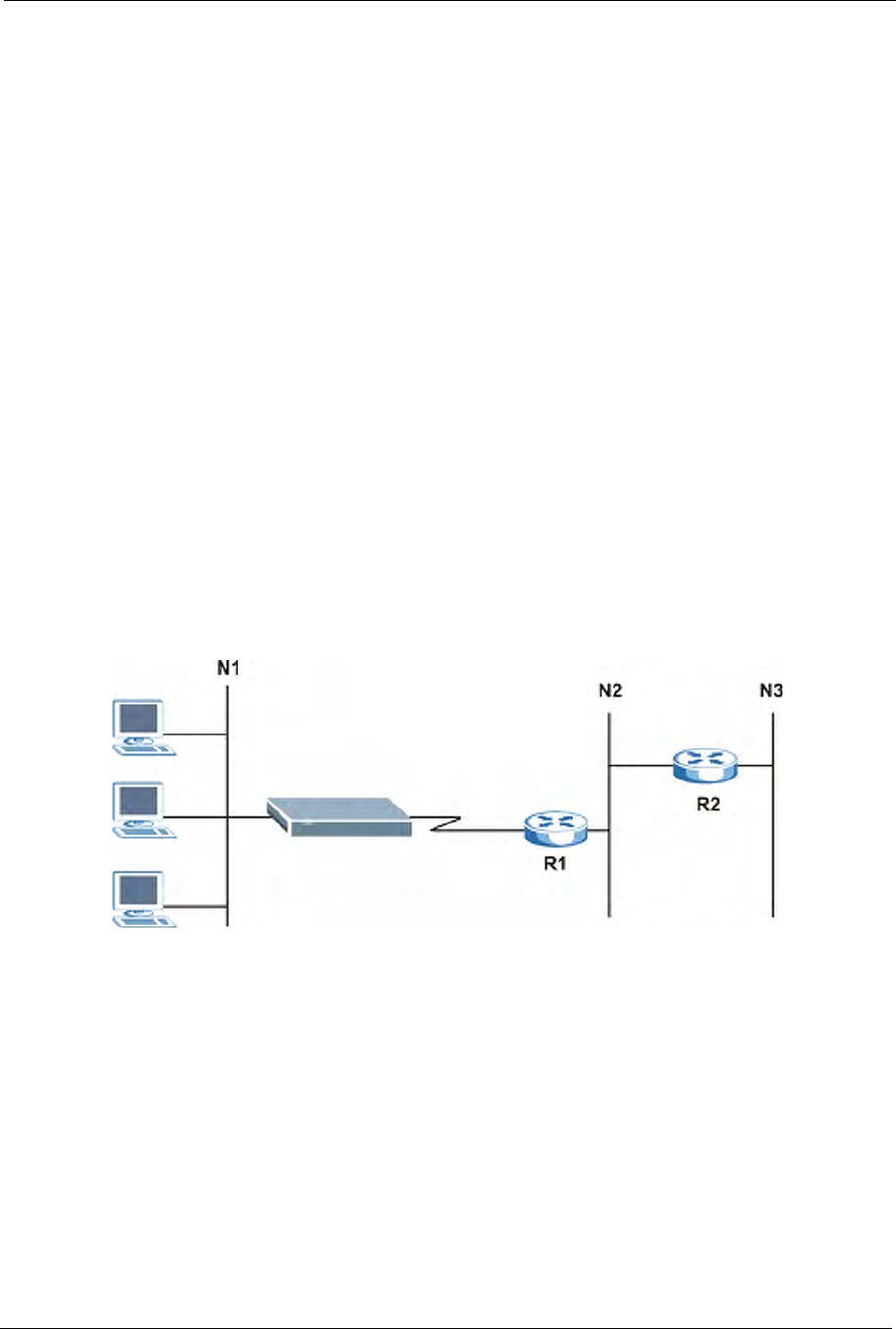
P-660H/HW/W-T Series User’ Guide
Chapter 25 Static Route Setup 246
CHAPTER 25
Static Route Setup
This chapter shows how to setup IP static routes.
25.1 IP Static Route Overview
Static routes tell the Prestige routing information that it cannot learn automatically through
other means. This can arise in cases where RIP is disabled on the LAN or a remote network is
beyond the one that is directly connected to a remote node.
Each remote node specifies only the network to which the gateway is directly connected and
the Prestige has no knowledge of the networks beyond. For instance, the Prestige knows about
network N2 in the following figure through remote node Router 1. However, the Prestige is
unable to route a packet to network N3 because it does not know that there is a route through
remote node Router 1 (via Router 2). The static routes allow you to tell the Prestige about the
networks beyond the remote nodes.
Figure 134 Sample Static Routing Topology
25.2 Configuration
To configure an IP static route, use Menu 12 – Static Route Setup (shown next).

P-660H/HW/W-T Series User’ Guide
247 Chapter 25 Static Route Setup
Figure 135 Menu 12 Static Route Setup
From menu 12, select 1 to open Menu 12.1 — IP Static Route Setup (shown next).
Figure 136 Menu 12.1 IP Static Route Setup
Now, type the route number of a static route you want to configure.
Figure 137 Menu12.1.1 Edit IP Static Route
Menu 12 - Static Route Setup
1. IP Static Route
3. Bridge Static Route
Please enter selection:
Menu 12.1 - IP Static Route Setup
1. ________
2. ________
3. ________
4. ________
5. ________
6. ________
7. ________
8. ________
9. ________
10. ________
11. ________
12. ________
13. ________
14. ________
15. ________
16. ________
Enter selection number:
Menu 12.1.1 - Edit IP Static Route
Route #: 1
Route Name= ?
Active= No
Destination IP Address= ?
IP Subnet Mask= ?
Gateway IP Address= ?
Metric= 2
Private= No
Press ENTER to Confirm or ESC to Cancel:

P-660H/HW/W-T Series User’ Guide
Chapter 25 Static Route Setup 248
The following table describes the fields for Menu 12.1.1 – Edit IP Static Route Setup.
Table 87 Menu12.1.1 Edit IP Static Route
FIELD DESCRIPTION
Route # This is the index number of the static route that you chose in menu 12.1.
Route Name Type a descriptive name for this route. This is for identification purpose only.
Active This field allows you to activate/deactivate this static route.
Destination IP Address This parameter specifies the IP network address of the final destination.
Routing is always based on network number. If you need to specify a route to
a single host, use a subnet mask of 255.255.255.255 in the subnet mask
field to force the network number to be identical to the host ID.
IP Subnet Mask Type the subnet mask for this destination.
Gateway IP Address Type the IP address of the gateway. The gateway is a router or switch on the
same network segment as the device’s LAN or WAN port. The gateway
helps forward packets to their destinations.
Metric Metric represents the cost of transmission for routing purposes. IP routing
uses hop count as the measurement of cost, with a minimum of 1 for directly
connected networks. Type a number that approximates the cost for this link.
The number need not be precise, but it must be between 1 and 15. In
practice, 2 or 3 is usually a good number.
Private This parameter determines if the Prestige will include the route to this remote
node in its RIP broadcasts. If set to Yes, this route is kept private and is not
included in RIP broadcasts. If No, the route to this remote node will be
propagated to other hosts through RIP broadcasts.
When you have completed this menu, press [ENTER] at the prompt “Press ENTER to Confirm
or ESC to Cancel:” to save your configuration, or press [ESC] at any time to cancel.

P-660H/HW/W-T Series User’ Guide
249 Chapter 25 Static Route Setup

P-660H/HW/W-T Series User’ Guide
Chapter 26 Bridging Setup 250
CHAPTER 26
Bridging Setup
This chapter shows you how to configure the bridging parameters of your Prestige.
26.1 Bridging in General
Bridging bases the forwarding decision on the MAC (Media Access Control), or hardware
address, while routing does it on the network layer (IP) address. Bridging allows the Prestige
to transport packets of network layer protocols that it does not route, for example, SNA, from
one network to another. The caveat is that, compared to routing, bridging generates more
traffic for the same network layer protocol, and it also demands more CPU cycles and
memory.
For efficiency reasons, do not turn on bridging unless you need to support protocols other than
IP on your network. For IP, enable the routing if you need it; do not bridge what the Prestige
can route.
26.2 Bridge Ethernet Setup
Basically, all non-local packets are bridged to the WAN. Your Prestige does not support IPX.
26.2.1 Remote Node Bridging Setup
Follow the procedure in another section to configure the protocol-independent parameters in
Menu 11.1 – Remote Node Profile. For bridging-related parameters, you need to configure
Menu 11.3 – Remote Node Network Layer Options.
1To setup Menu 11.3 – Remote Node Network Layer Options shown in the next figure,
follow these steps:
2In menu 11.1, make sure the Bridge field is set to Yes.

P-660H/HW/W-T Series User’ Guide
251 Chapter 26 Bridging Setup
Figure 138 Menu 11.1 Remote Node Profile
3Move the cursor to the Edit IP/Bridge field, then press [SPACE BAR] to set the value to
Yes and press [ENTER] to edit Menu 11.3 – Remote Node Network Layer Options.
Figure 139 Menu 11.3 Remote Node Network Layer Options
The following table describes the fields in this menu.
Menu 11.1 - Remote Node Profile
Rem Node Name= ? Route= IP
Active= Yes Bridge= Yes
Encapsulation= ENET ENCAP Edit IP/Bridge= No
Multiplexing= VC-based Edit ATM Options= No
Service Name= N/A Edit Advance Options= N/A
Incoming: Telco Option:
Rem Login= N/A Allocated Budget(min)= N/A
Rem Password= N/A Period(hr)= N/A
Outgoing: Schedule Sets= N/A
My Login= N/A Nailed-Up Connection= N/A
My Password= N/A Session Options:
Authen= N/A Edit Filter Sets= No
Idle Timeout(sec)= N/A
Press ENTER to Confirm or ESC to Cancel:
Menu 11.3 - Remote Node Network Layer Options
IP Options: Bridge Options:
IP Address Assignment= Static Ethernet Addr Timeout (min)= 0
Rem IP Addr: 0.0.0.0
Rem Subnet Mask= 0.0.0.0
My WAN Addr= 0.0.0.0
NAT= Full Feature
Address Mapping Set=2
Metric= 2
Private= No
RIP Direction= Both
Version= RIP-2B
Multicast= IGMP-v2
IP Policies=
Press ENTER to Confirm or ESC to Cancel:
Table 88 Remote Node Network Layer Options: Bridge Fields
FIELD DESCRIPTION
Bridge (menu 11.1) Make sure this field is set to Yes.
Edit IP/Bridge (menu 11.1) Press [SPACE BAR] to select Yes and press [ENTER] to display menu
11.3.
Ethernet Addr Timeout
(min.) (menu 11.3)
Type the time (in minutes) for the Prestige to retain the Ethernet Address
information in its internal tables while the line is down. If this information is
retained, your Prestige will not have to recompile the tables when the line
comes back up.
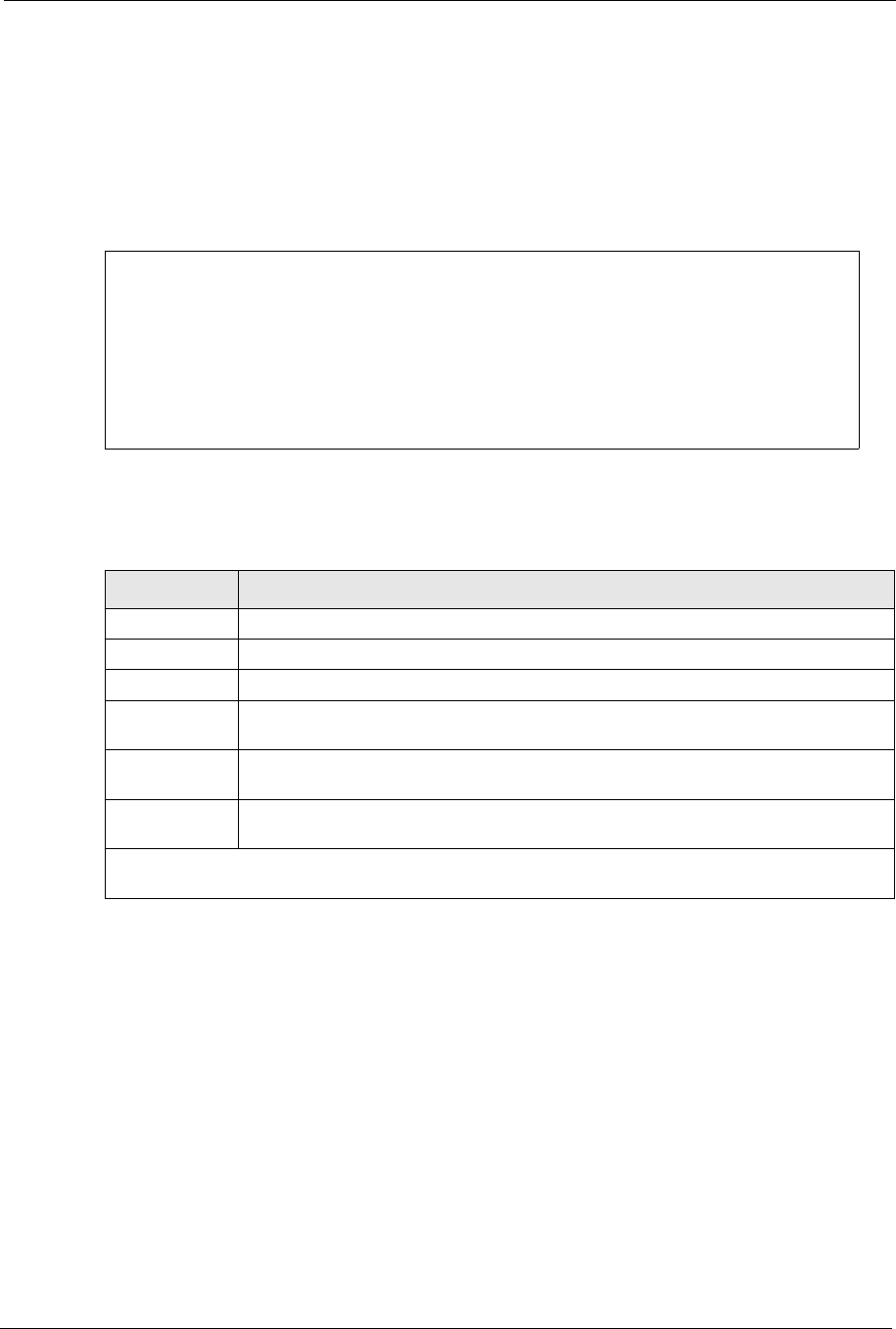
P-660H/HW/W-T Series User’ Guide
Chapter 26 Bridging Setup 252
26.2.2 Bridge Static Route Setup
Similar to network layer static routes, a bridging static route tells the Prestige the route to a
node before a connection is established. You configure bridge static routes in menu 12.3.1 (go
to menu 12, choose option 3, then choose a static route to edit) as shown next.
Figure 140 Menu 12.3.1 Edit Bridge Static Route
The following table describes the Edit Bridge Static Route menu.
Menu 12.3.1 - Edit Bridge Static Route
Route #: 1
Route Name=
Active= No
Ether Address= ?
IP Address=
Gateway Node= 1
Press ENTER to Confirm or ESC to Cancel:
Table 89 Menu 12.3.1 Edit Bridge Static Route
FIELD DESCRIPTION
Route # This is the route index number you typed in Menu 12.3 – Bridge Static Route Setup.
Route Name Type a name for the bridge static route for identification purposes.
Active Indicates whether the static route is active (Yes) or not (No).
Ether Address Type the MAC address of the destination computer that you want to bridge the
packets to.
IP Address If available, type the IP address of the destination computer that you want to bridge
the packets to.
Gateway Node Press [SPACE BAR] and then [ENTER] to select the number of the remote node (one
to eight) that is the gateway of this static route.
When you have completed this menu, press [ENTER] at the prompt “Press ENTER to Confirm
or ESC to Cancel:” to save your configuration, or press [ESC] at any time to cancel.

P-660H/HW/W-T Series User’ Guide
253 Chapter 26 Bridging Setup

P-660H/HW/W-T Series User’ Guide
Chapter 27 Network Address Translation (NAT) 254
CHAPTER 27
Network Address Translation
(NAT)
This chapter discusses how to configure NAT on the Prestige.
27.1 Using NAT
You must create a firewall rule in addition to setting up SUA/NAT, to allow traffic from the
WAN to be forwarded through the Prestige.
27.1.1 SUA (Single User Account) Versus NAT
SUA (Single User Account) is a ZyNOS implementation of a subset of NAT that supports two
types of mapping, Many-to-One and Server. See Section 27.3 on page 256 or a detailed
description of the NAT set for SUA. The Prestige also supports Full Feature NAT to map
multiple global IP addresses to multiple private LAN IP addresses of clients or servers using
mapping types.
• Choose SUA Only if you have just one public WAN IP address for your Prestige.
• Choose Full Feature if you have multiple public WAN IP addresses for your Prestige.
27.2 Applying NAT
You apply NAT via menus 4 or 11.3 as displayed next. The next figure shows you how to
apply NAT for Internet access in menu 4. Enter 4 from the main menu to go to Menu 4 -
Internet Access Setup.

P-660H/HW/W-T Series User’ Guide
255 Chapter 27 Network Address Translation (NAT)
Figure 141 Menu 4 Applying NAT for Internet Access
The following figure shows how you apply NAT to the remote node in menu 11.1.
1Enter 11 from the main menu.
2When menu 11 appears, as shown in the following figure, type the number of the remote
node that you want to configure.
3Move the cursor to the Edit IP/Bridge field, press [SPACE BAR] to select Yes and then
press [ENTER] to bring up Menu 11.3 - Remote Node Network Layer Options.
Figure 142 Applying NAT in Menus 4 & 11.3
The following table describes the options for Network Address Translation.
Menu 4 - Internet Access Setup
ISP's Name= MyISP
Encapsulation= RFC 1483
Multiplexing= LLC-based
VPI #= 8
VCI #= 35
ATM QoS Type= UBR
Peak Cell Rate (PCR)= 0
Sustain Cell Rate (SCR)= 0
Maximum Burst Size (MBS)= 0
My Login= N/A
My Password= N/A
ENET ENCAP Gateway= N/A
IP Address Assignment= Static
IP Address= 0.0.0.0
Network Address Translation= SUA Only
Address Mapping Set= N/A
Press ENTER to Confirm or ESC to Cancel:
Menu 11.3 - Remote Node Network Layer Options
IP Options: Bridge Options:
IP Address Assignment = Static Ethernet Addr Timeout(min)= N/A
Rem IP Addr = 0.0.0.0
Rem Subnet Mask= 0.0.0.0
My WAN Addr= 0.0.0.0
NAT= SUA Only
Address Mapping Set= N/A
Metric= 2
Private= No
RIP Direction= Both
Version= RIP-2B
Multicast= None
IP Policies=
Enter here to CONFIRM or ESC to CANCEL:

P-660H/HW/W-T Series User’ Guide
Chapter 27 Network Address Translation (NAT) 256
27.3 NAT Setup
Use the address mapping sets menus and submenus to create the mapping table used to assign
global addresses to computers on the LAN. Set 255 is used for SUA. When you select Full
Feature in menu 4 or 11.3, the SMT will use Set 1. When you select SUA Only, the SMT
will use the pre-configured Set 255 (read only).
The server set is a list of LAN servers mapped to external ports. To use this set, a server rule
must be set up inside the NAT address mapping set. Please see the web configurator NAT
chapter for further information on these menus. To configure NAT, enter 15 from the main
menu to bring up the following screen.
Figure 143 Menu 15 NAT Setup
27.3.1 Address Mapping Sets
Enter 1 to bring up Menu 15.1 — Address Mapping Sets.
Table 90 Applying NAT in Menus 4 & 11.3
FIELD DESCRIPTION
NAT Press [SPACE BAR] and then [ENTER] to select Full Feature if you have multiple public
WAN IP addresses for your Prestige. The SMT uses the address mapping set that you
configure and enter in the Address Mapping Set field (seeFigure 144 on page 257).
Select None to disable NAT.
When you select SUA Only, the SMT uses Address Mapping Set 255 (seeFigure 145 on
page 257). Choose SUA Only if you have just one public WAN IP address for your
Prestige.
Menu 15 - NAT Setup
1. Address Mapping Sets
2. NAT Server Sets
Enter Menu Selection Number:

P-660H/HW/W-T Series User’ Guide
257 Chapter 27 Network Address Translation (NAT)
Figure 144 Menu 15.1 Address Mapping Sets
27.3.1.1 SUA Address Mapping Set
Enter 255 to display the next screen (see also Section 27.1.1 on page 254). The fields in this
menu cannot be changed.
Figure 145 Menu 15.1.255 SUA Address Mapping Rules
The following table explains the fields in this menu.
Menu 15.1.255 is read-only.
Menu 15.1 - Address Mapping Sets
1.
2.
3.
4.
5.
6.
7.
8.
255. SUA (read only)
Enter Menu Selection Number:
Menu 15.1.255 - Address Mapping Rules
Set Name=
Idx Local Start IP Local End IP Global Start IP Global End IP Type
--- --------------- --------------- --------------- ------------- ----
1. 0.0.0.0 255.255.255.255 0.0.0.0 M-1
2. 0.0.0.0 Server
3.
4.
5.
6.
7.
8.
9.
10.
Press ENTER to Confirm or ESC to Cancel:
Table 91 SUA Address Mapping Rules
FIELD DESCRIPTION
Set Name This is the name of the set you selected in menu 15.1 or enter the name of a new set
you want to create.
Idx This is the index or rule number.
Local Start IP Local Start IP is the starting local IP address (ILA).

P-660H/HW/W-T Series User’ Guide
Chapter 27 Network Address Translation (NAT) 258
27.3.1.2 User-Defined Address Mapping Sets
Now let’s look at option 1 in menu 15.1. Enter 1 to bring up this menu. We’ll just look at the
differences from the previous menu. Note the extra Action and Select Rule fields mean you
can configure rules in this screen. Note also that the [?] in the Set Name field means that this
is a required field and you must enter a name for the set.
Figure 146 Menu 15.1.1 First Set
If the Set Name field is left blank, the entire set will be deleted.
The Type, Local and Global Start/End IPs are configured in menu 15.1.1.1 (described later)
and the values are displayed here.
Local End IP Local End IP is the ending local IP address (ILA). If the rule is for all local IPs, then
the Start IP is 0.0.0.0 and the End IP is 255.255.255.255.
Global Start IP This is the starting global IP address (IGA). If you have a dynamic IP, enter 0.0.0.0 as
the Global Start IP.
Global End IP This is the ending global IP address (IGA).
Type These are the mapping types. Server allows us to specify multiple servers of different
types behind NAT to this machine. See later for some examples.
When you have completed this menu, press [ENTER] at the prompt “Press ENTER to Confirm
or ESC to Cancel:” to save your configuration, or press [ESC] at any time to cancel.
Table 91 SUA Address Mapping Rules (continued)
FIELD DESCRIPTION
Menu 15.1.1 - Address Mapping Rules
Set Name= NAT_SET
Idx Local Start IP Local End IP Global Start IP Global End IP Type
--- --------------- --------------- --------------- --------=----- ---
1.
2
3.
4.
5.
6.
7.
8.
9.
10.
Action= Edit Select Rule=
Press ENTER to Confirm or ESC to Cancel:

P-660H/HW/W-T Series User’ Guide
259 Chapter 27 Network Address Translation (NAT)
27.3.1.3 Ordering Your Rules
Ordering your rules is important because the Prestige applies the rules in the order that you
specify. When a rule matches the current packet, the Prestige takes the corresponding action
and the remaining rules are ignored. If there are any empty rules before your new configured
rule, your configured rule will be pushed up by that number of empty rules. For example, if
you have already configured rules 1 to 6 in your current set and now you configure rule
number 9. In the set summary screen, the new rule will be rule 7, not 9.
Now if you delete rule 4, rules 5 to 7 will be pushed up by 1 rule, so as old rule 5 becomes rule
4, old rule 6 becomes rule 5 and old rule 7 becomes rule 6.
You must press [ENTER] at the bottom of the screen to save the whole set. You must do this
again if you make any changes to the set – including deleting a rule. No changes to the set take
place until this action is taken.
Selecting Edit in the Action field and then selecting a rule brings up the following menu,
Menu 15.1.1.1 - Address Mapping Rule in which you can edit an individual rule and
configure the Type,Local and Global Start/End IPs.
An End IP address must be numerically greater than its corresponding IP Start address.
Figure 147 Menu 15.1.1.1 Editing/Configuring an Individual Rule in a Set
Table 92 Menu 15.1.1 First Set
FIELD DESCRIPTION
Set Name Enter a name for this set of rules. This is a required field. If this field is left blank, the
entire set will be deleted.
Action The default is Edit.Edit means you want to edit a selected rule (see following field).
Insert Before means to insert a rule before the rule selected. The rules after the
selected rule will then be moved down by one rule. Delete means to delete the
selected rule and then all the rules after the selected one will be advanced one rule.
None disables the Select Rule item.
Select Rule When you choose Edit,Insert Before or Delete in the previous field the cursor
jumps to this field to allow you to select the rule to apply the action in question.
Menu 15.1.1.1 Address Mapping Rule
Type= One-to-One
Local IP:
Start=
End = N/A
Global IP:
Start=
End = N/A
Server Mapping Set= N/A
Press ENTER to Confirm or ESC to Cancel:

P-660H/HW/W-T Series User’ Guide
Chapter 27 Network Address Translation (NAT) 260
The following table explains the fields in this menu.
27.4 Configuring a Server behind NAT
Follow these steps to configure a server behind NAT:
1Enter 15 in the main menu to go to Menu 15 - NAT Setup.
2Enter 2 to display Menu 15.2 - NAT Server Sets as shown next.
Figure 148 Menu 15.2 NAT Server Setup
3Enter 1 to go to Menu 15.2.1 NAT Server Setup as follows.
Table 93 Menu 15.1.1.1 Editing/Configuring an Individual Rule in a Set
FIELD DESCRIPTION
Type Press [SPACE BAR] and then [ENTER] to select from a total of five types. These are
the mapping types discussed in the web configurator NAT chapter. Server allows you
to specify multiple servers of different types behind NAT to this computer.
Local IP Only local IP fields are N/A for server; Global IP fields MUST be set for Server.
Start This is the starting local IP address (ILA).
End This is the ending local IP address (ILA). If the rule is for all local IPs, then put the Start
IP as 0.0.0.0 and the End IP as 255.255.255.255. This field is N/A for One-to-One and
Server types.
Global IP
Start This is the starting inside global IP address (IGA). If you have a dynamic IP, enter
0.0.0.0 as the Global IP Start. Note that Global IP Start can be set to 0.0.0.0 only if
the types are Many-to-One or Server.
End This is the ending inside global IP address (IGA). This field is N/A for One-to-One,
Many-to-One and Server types.
Server
Mapping Set
Only available when Type is set to Server. Type a number from 1 to 10 to choose a
server set from menu 15.2.
When you have completed this menu, press [ENTER] at the prompt “Press ENTER to Confirm
or ESC to Cancel:” to save your configuration, or press [ESC] at any time to cancel.
Menu 15.2 - NAT Server Sets
1. Server Set 1 (Used for SUA Only)
2. Server Set 2
3. Server Set 3
4. Server Set 4
5. Server Set 5
6. Server Set 6
7. Server Set 7
8. Server Set 8
9. Server Set 9
10. Server Set 10
Enter Set Number to Edit:
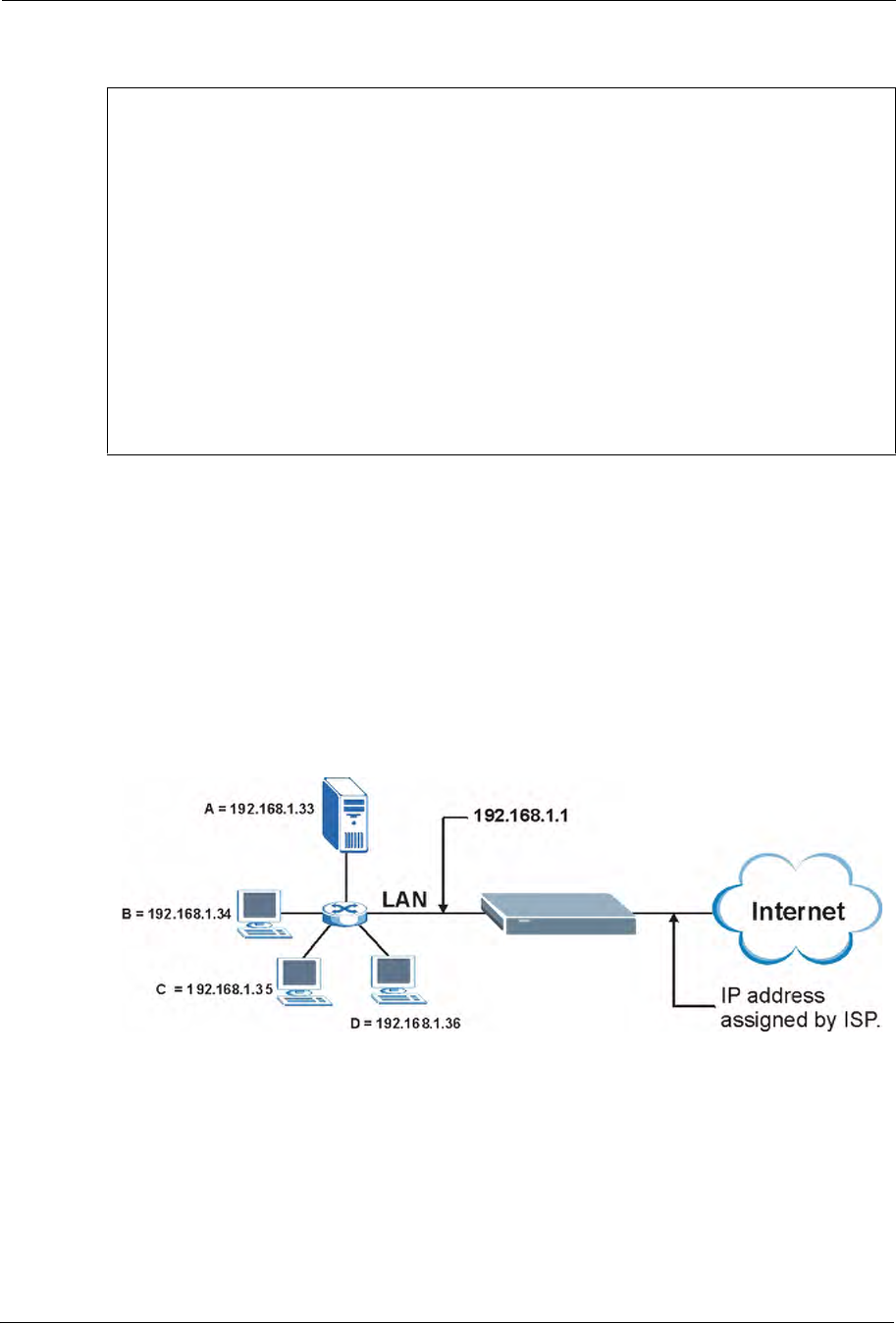
P-660H/HW/W-T Series User’ Guide
261 Chapter 27 Network Address Translation (NAT)
Figure 149 Menu 15.2.1 NAT Server Setup
4Enter a port number in an unused Start Port No field. To forward only one port, enter it
again in the End Port No field. To specify a range of ports, enter the last port to be
forwarded in the End Port No field.
5Enter the inside IP address of the server in the IP Address field. In the following figure,
you have a computer acting as an FTP, Telnet and SMTP server (ports 21, 23 and 25) at
192.168.1.33.
6Press [ENTER] at the “Press ENTER to confirm ...” prompt to save your
configuration after you define all the servers or press [ESC] at any time to cancel.
Figure 150 Multiple Servers Behind NAT Example
27.5 General NAT Examples
The following are some examples of NAT configuration.
Menu 15.2 - NAT Server Setup
Rule Start Port No. End Port No. IP Address
---------------------------------------------------
1. Default Default 0.0.0.0
2. 21 21 192.168.1.33
3. 0 0 0.0.0.0
4. 0 0 0.0.0.0
5. 0 0 0.0.0.0
6. 0 0 0.0.0.0
7. 0 0 0.0.0.0
8. 0 0 0.0.0.0
9. 0 0 0.0.0.0
10. 0 0 0.0.0.0
11. 0 0 0.0.0.0
12. 0 0 0.0.0.0
Press ENTER to Confirm or ESC to Cancel:
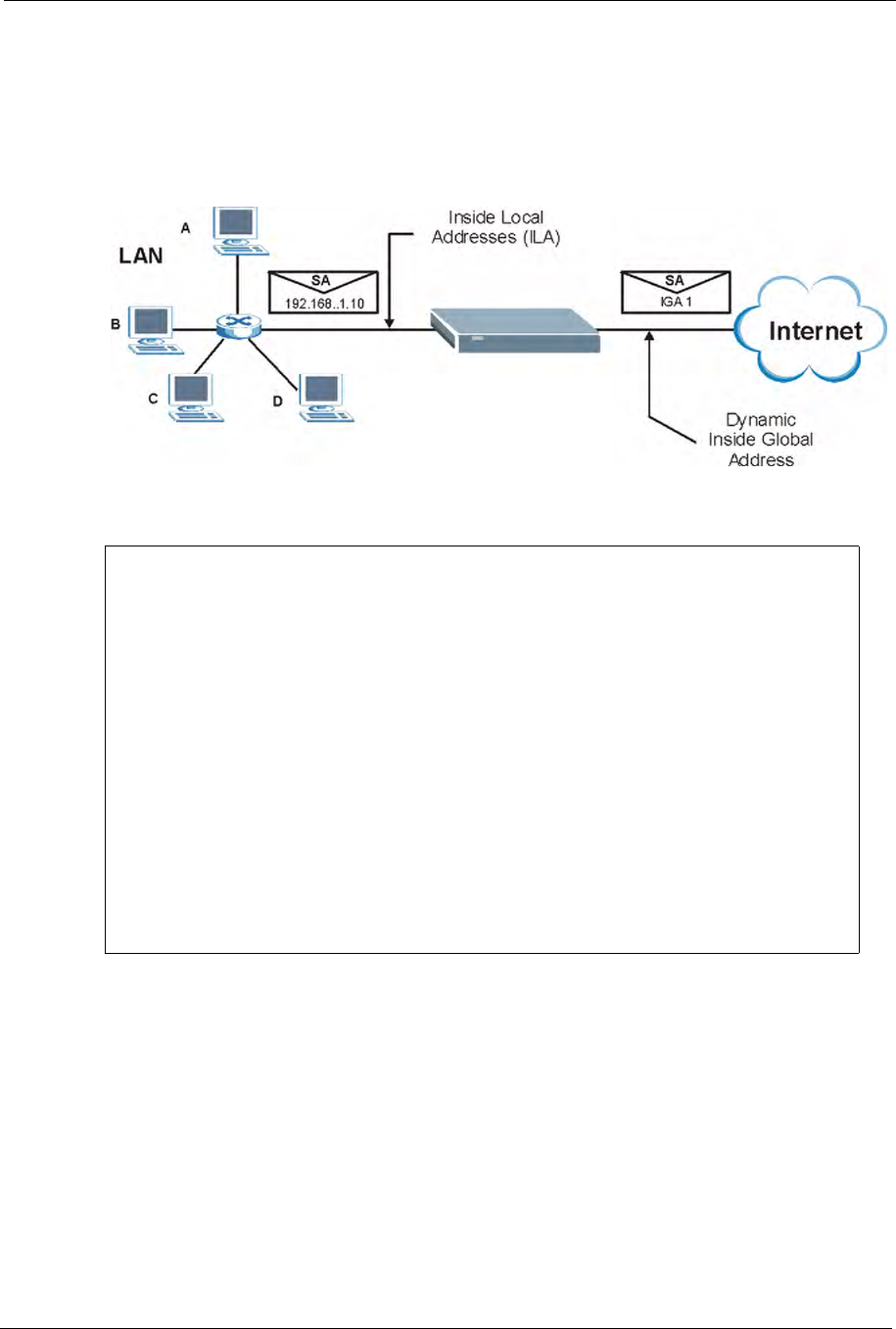
P-660H/HW/W-T Series User’ Guide
Chapter 27 Network Address Translation (NAT) 262
27.5.1 Example 1: Internet Access Only
In the following Internet access example, you only need one rule where your ILAs (Inside
Local addresses) all map to one dynamic IGA (Inside Global Address) assigned by your ISP.
Figure 151 NAT Example 1
Figure 152 Menu 4 Internet Access & NAT Example
From menu 4, choose the SUA Only option from the Network Address Translation field.
This is the Many-to-One mapping discussed in Section 27.5 on page 261.The SUA Only
read-only option from the Network Address Translation field in menus 4 and 11.3 is
specifically pre-configured to handle this case.
27.5.2 Example 2: Internet Access with an Inside Server
Menu 4 - Internet Access Setup
ISP's Name= MyISP
Encapsulation= RFC 1483
Multiplexing= LLC-based
VPI #= 8
VCI #= 35
ATM QoS Type= UBR
Peak Cell Rate (PCR)= 0
Sustain Cell Rate (SCR)= 0
Maximum Burst Size (MBS)= 0
My Login= N/A
My Password= N/A
ENET ENCAP Gateway= N/A
IP Address Assignment= Static
IP Address= 0.0.0.0
Network Address Translation= SUA Only
Address Mapping Set= N/A
Press ENTER to Confirm or ESC to Cancel:
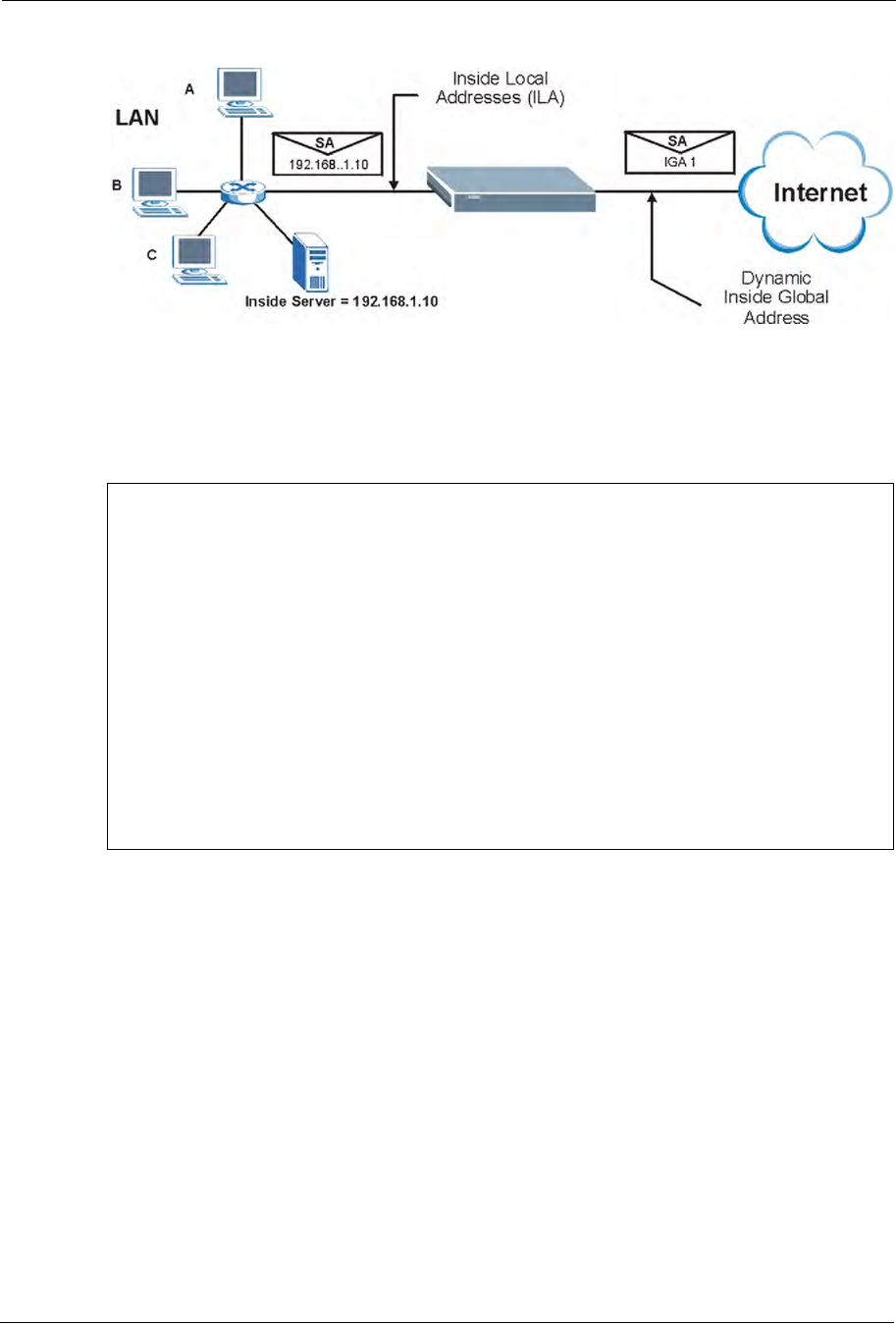
P-660H/HW/W-T Series User’ Guide
263 Chapter 27 Network Address Translation (NAT)
Figure 153 NAT Example 2
In this case, you do exactly as above (use the convenient pre-configured SUA Only set) and
also go to menu 15.2 to specify the Inside Server behind the NAT as shown in the next figure.
Figure 154 Menu 15.2.1 Specifying an Inside Server
27.5.3 Example 3: Multiple Public IP Addresses With Inside Servers
In this example, there are 3 IGAs from our ISP. There are many departments but two have
their own FTP server. All departments share the same router. The example will reserve one
IGA for each department with an FTP server and all departments use the other IGA. Map the
FTP servers to the first two IGAs and the other LAN traffic to the remaining IGA. Map the
third IGA to an inside web server and mail server. Four rules need to be configured, two bi-
directional and two unidirectional as follows.
Map the first IGA to the first inside FTP server for FTP traffic in both directions (1 : 1
mapping, giving both local and global IP addresses).
Map the second IGA to our second inside FTP server for FTP traffic in both directions (1 : 1
mapping, giving both local and global IP addresses).
Menu 15.2.1 - NAT Server Setup (Used for SUA Only)
Rule Start Port No. End Port No. IP Address
---------------------------------------------------
1. Default Default 192.168.1.10
2. 0 0 0.0.0.0
3. 0 0 0.0.0.0
4. 0 0 0.0.0.0
5. 0 0 0.0.0.0
6. 0 0 0.0.0.0
7. 0 0 0.0.0.0
8. 0 0 0.0.0.0
9. 0 0 0.0.0.0
10. 0 0 0.0.0.0
11. 0 0 0.0.0.0
12. 0 0 0.0.0.0
Press ENTER to Confirm or ESC to Cancel:
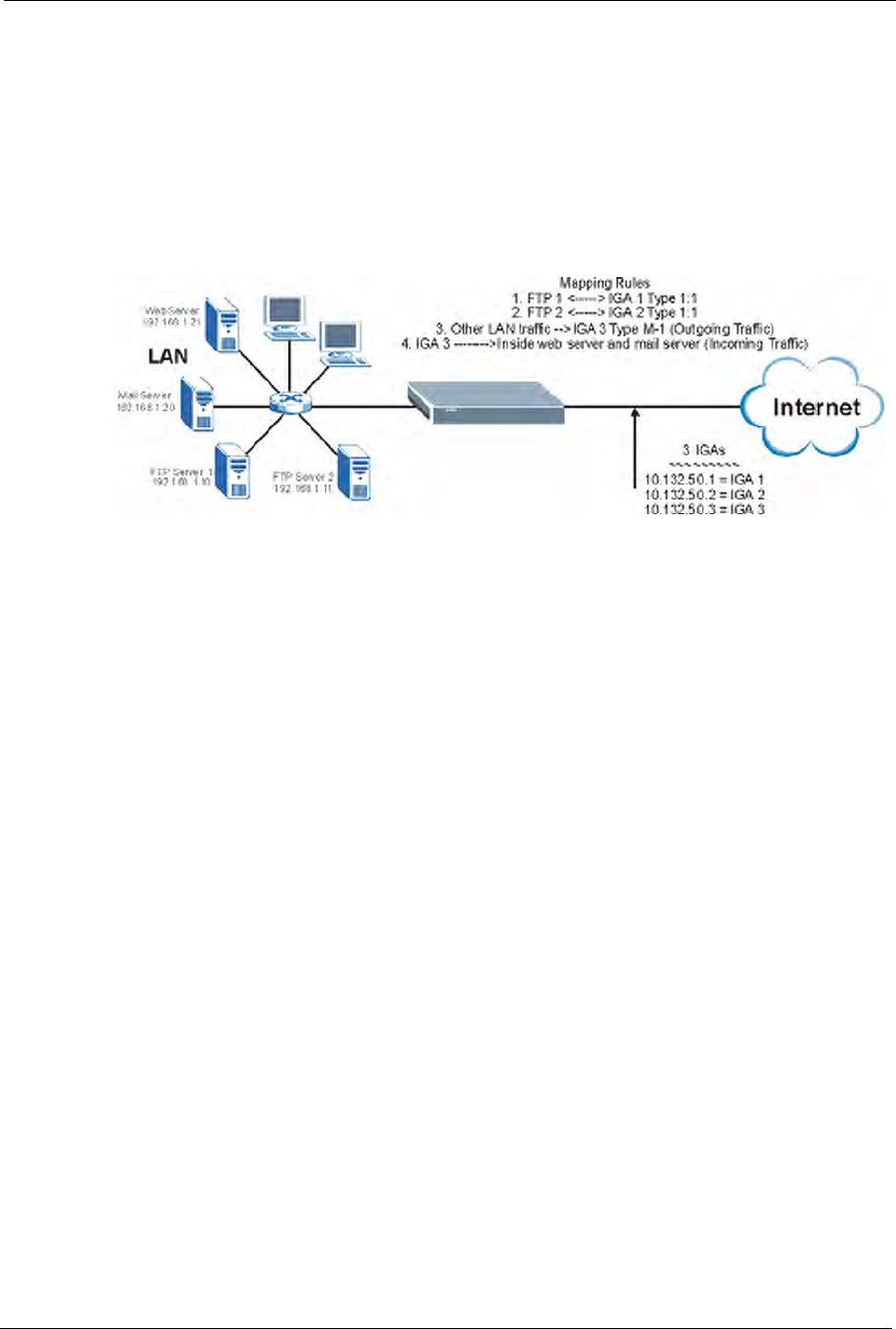
P-660H/HW/W-T Series User’ Guide
Chapter 27 Network Address Translation (NAT) 264
Map the other outgoing LAN traffic to IGA3 (Many : 1 mapping).
You also map your third IGA to the web server and mail server on the LAN. Type Server
allows you to specify multiple servers, of different types, to other computers behind NAT on
the LAN.
The example situation looks somewhat like this:
Figure 155 NAT Example 3
In this case you need to configure Address Mapping Set 1 from Menu 15.1 - Address
Mapping Sets. Therefore you must choose the Full Feature option from the Network
Address Translation field (in menu 4 or menu 11.3) inFigure 156 on page 265.
1Enter 15 from the main menu.
2Enter 1 to configure the Address Mapping Sets.
3Enter 1 to begin configuring this new set. Enter a Set Name, choose the Edit Action and
then enter 1 for the Select Rule field. Press [ENTER] to confirm.
4Select Type as One-to-One (direct mapping for packets going both ways),and enter the
local Start IP as 192.168.1.10 (the IP address of FTP Server 1), the global Start IP as
10.132.50.1 (our first IGA). (SeeFigure 157 on page 265).
5Repeat the previous step for rules 2 to 4 as outlined above.
When finished, menu 15.1.1 should look like as shown inFigure 158 on page 266.

P-660H/HW/W-T Series User’ Guide
265 Chapter 27 Network Address Translation (NAT)
Figure 156 Example 3: Menu 11.3
The following figures show how to configure the first rule
Figure 157 Example 3: Menu 15.1.1.1
Menu 11.3 - Remote Node Network Layer Options
IP Options: Bridge Options:
IP Address Assignment= Static Ethernet Addr Timeout (min)= 0
Rem IP Addr: 0.0.0.0
Rem Subnet Mask= 0.0.0.0
My WAN Addr= 0.0.0.0
NAT= Full Feature
Address Mapping Set= 2
Metric= 2
Private= No
RIP Direction= Both
Version= RIP-2B
Multicast= IGMP-v2
IP Policies=
Press ENTER to Confirm or ESC to Cancel:
Menu 15.1.1.1 Address Mapping Rule
Type= One-to-One
Local IP:
Start= 192.168.1.10
End = N/A
Global IP:
Start= 10.132.50.1
End = N/A
Server Mapping Set= N/A
Press ENTER to Confirm or ESC to Cancel:

P-660H/HW/W-T Series User’ Guide
Chapter 27 Network Address Translation (NAT) 266
Figure 158 Example 3: Final Menu 15.1.1
Now configure the IGA3 to map to our web server and mail server on the LAN.
1Enter 15 from the main menu.
2Enter 2 in Menu 15 - NAT Setup.
3Enter 1 in Menu 15.2 - NAT Server Sets to see the following menu. Configure it as
shown.
Figure 159 Example 3: Menu 15.2.1
Menu 15.1.1 - Address Mapping Rules
Set Name= Example3
Idx Local Start IP Local End IP Global Start IP Global End IP Type
--- --------------- ------------- --------------- -------------- ----
1. 192.168.1.10 10.132.50.1 1-1
2 192.168.1.11 10.132.50.2 1-1
3. 0.0.0.0 255.255.255.255 10.132.50.3 M-1
4. 10.132.50.3 Server
5.
6.
7.
8.
9.
10.
Action= Edit Select Rule=
Press ENTER to Confirm or ESC to Cancel:
Menu 15.2.1 - NAT Server Setup
Rule Start Port No. End Port No. IP Address
---------------------------------------------------
1. Default Default 0.0.0.0
2. 80 80 192.168.1.21
3. 25 25 192.168.1.20
4. 0 0 0.0.0.0
5. 0 0 0.0.0.0
6. 0 0 0.0.0.0
7. 0 0 0.0.0.0
8. 0 0 0.0.0.0
9. 0 0 0.0.0.0
10. 0 0 0.0.0.0
11. 0 0 0.0.0.0
12. 0 0 0.0.0.0
Press ENTER to Confirm or ESC to Cancel:
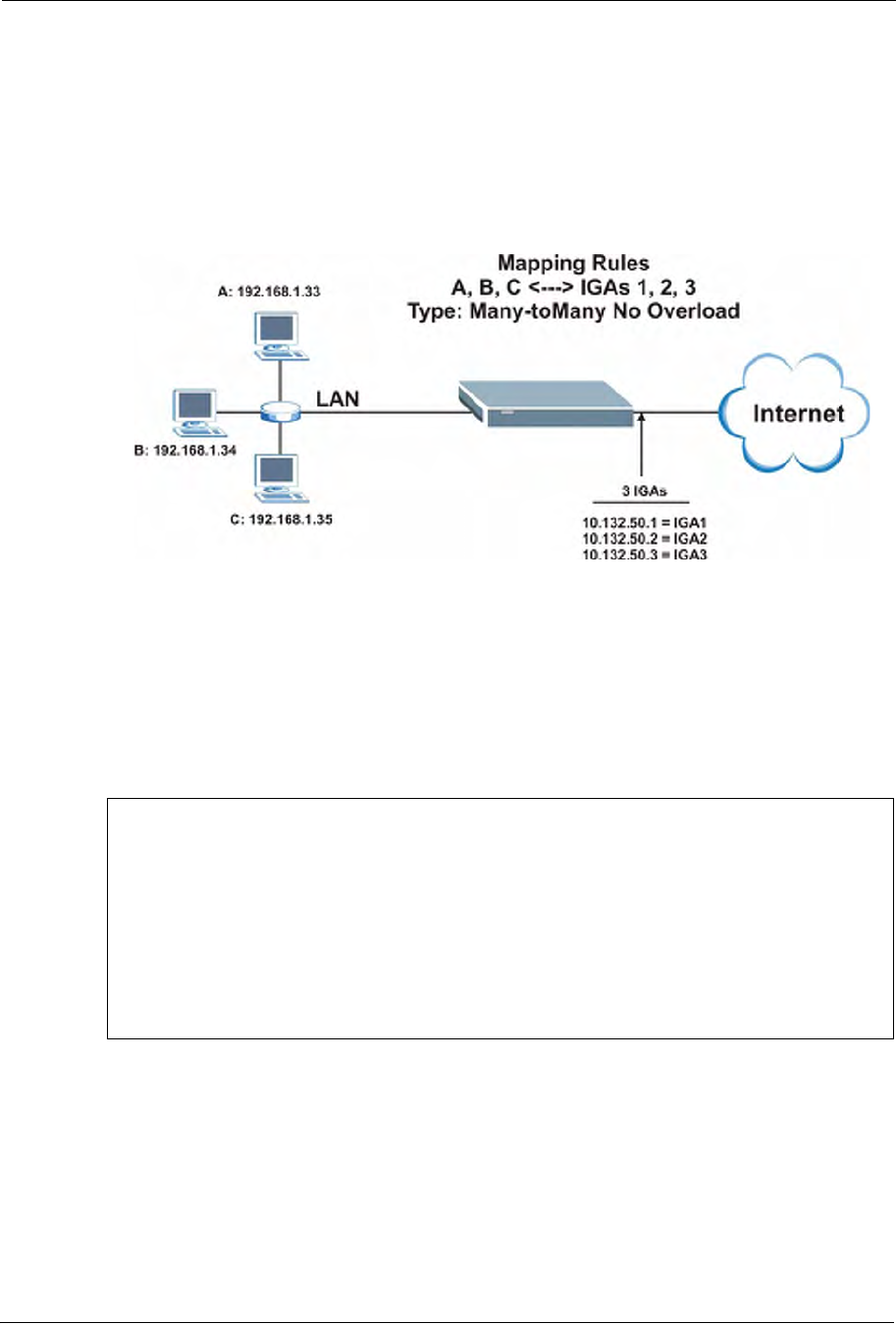
P-660H/HW/W-T Series User’ Guide
267 Chapter 27 Network Address Translation (NAT)
27.5.4 Example 4: NAT Unfriendly Application Programs
Some applications do not support NAT Mapping using TCP or UDP port address translation.
In this case it is better to use Many-to-Many No Overload mapping as port numbers do not
change for Many-to-Many No Overload (and One-to-One) NAT mapping types. The
following figure illustrates this.
Figure 160 NAT Example 4
Other applications such as some gaming programs are NAT unfriendly because they embed
addressing information in the data stream. These applications won’t work through NAT even
when using One-to-One and Many-to-Many No Overload mapping types.
Follow the steps outlined in example 3 to configure these two menus as follows.
Figure 161 Example 4: Menu 15.1.1.1 Address Mapping Rule
After you’ve configured your rule, you should be able to check the settings in menu 15.1.1 as
shown next.
Menu 15.1.1.1 Address Mapping Rule
Type= Many-to-Many No Overload
Local IP:
Start= 192.168.1.10
End = 192.168.1.12
Global IP:
Start= 10.132.50.1
End = 10.132.50.3
Server Mapping Set= N/A
Press ENTER to Confirm or ESC to Cancel:

P-660H/HW/W-T Series User’ Guide
Chapter 27 Network Address Translation (NAT) 268
Figure 162 Example 4: Menu 15.1.1 Address Mapping Rules
Menu 15.1.1 - Address Mapping Rules
Set Name= Example4
Idx Local Start IP Local End IP Global Start IP Global End IP Type
--- --------------- ------------ --------------- --------------- ----
1. 192.168.1.10 192.168.1.12 10.132.50.1 10.132.50.3 M:M
NO OV
2.
3.
4.
5.
6.
7.
8.
9.
10.
Action= Edit Select Rule=
Press ENTER to Confirm or ESC to Cancel:

P-660H/HW/W-T Series User’ Guide
269 Chapter 27 Network Address Translation (NAT)

P-660H/HW/W-T Series User’ Guide
Chapter 28 Enabling the Firewall 270
CHAPTER 28
Enabling the Firewall
This chapter shows you how to get started with the Prestige firewall.
28.1 Remote Management and the Firewall
When SMT menu 24.11 is configured to allow management and the firewall is enabled:
• The firewall blocks remote management from the WAN unless you configure a firewall
rule to allow it.
• The firewall allows remote management from the LAN.
28.2 Access Methods
The web configurator is, by far, the most comprehensive firewall configuration tool your
Prestige has to offer. For this reason, it is recommended that you configure your firewall using
the web configurator, see the following chapters for instructions. SMT screens allow you to
activate the firewall and view firewall logs.
28.3 Enabling the Firewall
From the main menu enter 21 to go to Menu 21 - Filter Set and Firewall Configuration to
display the screen shown next.
Enter option 2 in this menu to bring up the following screen. Press [SPACE BAR] and then
[ENTER] to select Yes in the Active field to activate the firewall. The firewall must be active
to protect against Denial of Service (DoS) attacks. Additional rules may be configured using
the web configurator.

P-660H/HW/W-T Series User’ Guide
271 Chapter 28 Enabling the Firewall
Figure 163 Menu 21.2 Firewall Setup
Use the web configurator or the command interpreter to configure the firewall rules
Menu 21.2 - Firewall Setup
The firewall protects against Denial of Service (DOS) attacks when
it is active. The default Policy sets
1. allow all sessions originating from the LAN to the WAN and
2. deny all sessions originating from the WAN to the LAN
You may define additional Policy rules or modify existing ones but
please exercise extreme caution in doing so
Active: Yes
LAN-to-WAN Set Name: ACL Default Set
WAN-to-LAN Set Name: ACL Default Set
Please configure the Firewall function through Web Configurator.
Press ENTER to Confirm or ESC to Cancel:
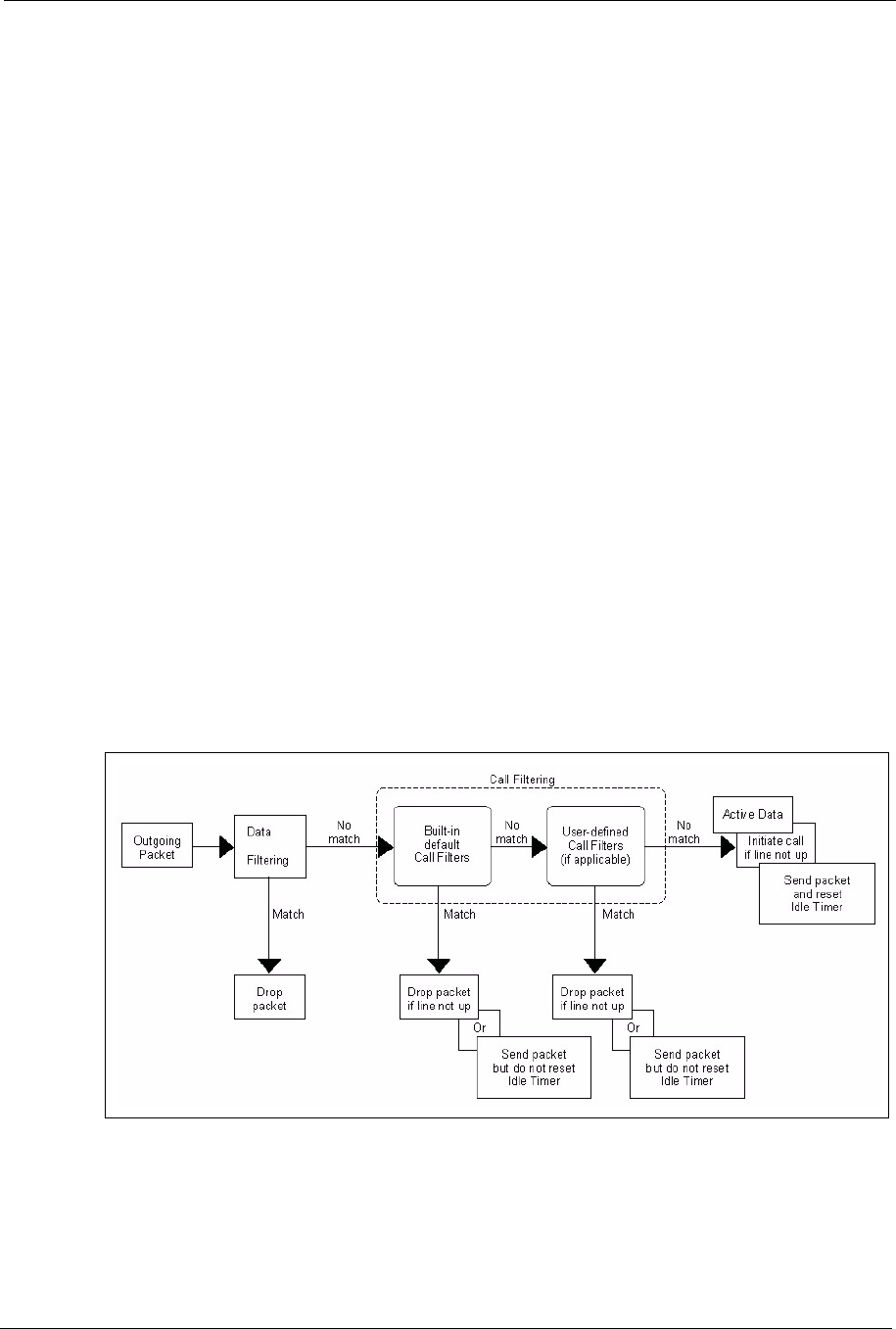
P-660H/HW/W-T Series User’ Guide
Chapter 29 Filter Configuration 272
CHAPTER 29
Filter Configuration
This chapter shows you how to create and apply filters.
29.1 About Filtering
Your Prestige uses filters to decide whether or not to allow passage of a data packet and/or to
make a call. There are two types of filter applications: data filtering and call filtering. Filters
are subdivided into device and protocol filters, which are discussed later.
Data filtering screens data to determine if the packet should be allowed to pass. Data filters are
divided into incoming and outgoing filters, depending on the direction of the packet relative to
a port. Data filtering can be applied on either the WAN side or the Ethernet side. Call filtering
is used to determine if a packet should be allowed to trigger a call.
Outgoing packets must undergo data filtering before they encounter call filtering. Call filters
are divided into two groups, the built-in call filters and user-defined call filters. Your Prestige
has built-in call filters that prevent administrative, for example, RIP packets from triggering
calls. These filters are always enabled and not accessible to you. Your Prestige applies the
built-in filters first and then the user-defined call filters, if applicable, as shown next.
Figure 164 Outgoing Packet Filtering Process
Two sets of factory filter rules have been configured in menu 21 to prevent NetBIOS traffic
from triggering calls. A summary of their filter rules is shown in the figures that follow.
The following figure illustrates the logic flow when executing a filter rule.
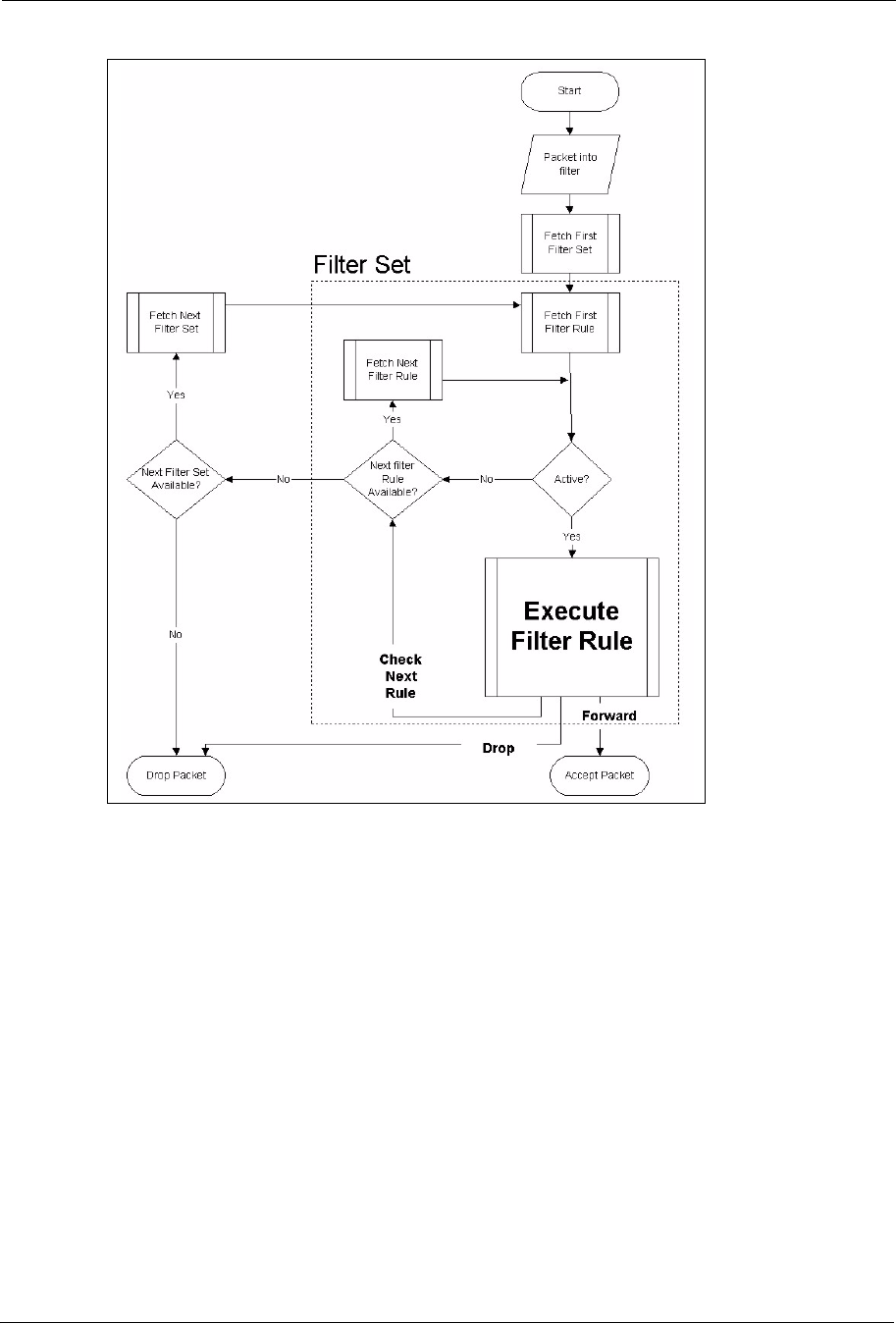
P-660H/HW/W-T Series User’ Guide
273 Chapter 29 Filter Configuration
Figure 165 Filter Rule Process
You can apply up to four filter sets to a particular port to block various types of packets.
Because each filter set can have up to six rules, you can have a maximum of 24 rules active for
a single port.
For incoming packets, your Prestige applies data filters only. Packets are processed depending
on whether a match is found. The following sections describe how to configure filter sets.
29.1.1 The Filter Structure of the Prestige
A filter set consists of one or more filter rules. Usually, you would group related rules, for
example, all the rules for NetBIOS, into a single set and give it a descriptive name. You can
configure up to twelve filter sets with six rules in each set, for a total of 72 filter rules in the
system.

P-660H/HW/W-T Series User’ Guide
Chapter 29 Filter Configuration 274
29.2 Configuring a Filter Set for the Prestige
To configure a filter set, follow the steps shown next.
1Enter 21 in the main menu to display Menu 21 – Filter and Firewall Setup.
2Enter 1 to display Menu 21.1 – Filter Set Configuration as shown next.
Figure 166 Menu 21 Filter Set Configuration
3Type the filter set to configure (no. 1 to 12) and press [ENTER].
4Type a descriptive name or comment in the Edit Comments field and press [ENTER].
5Press [ENTER] at the message “Press ENTER to confirm…” to display Menu 21.1.1 –
Filter Rules Summary (that is, if you selected filter set 1 in menu 21.1).
Figure 167 NetBIOS_WAN Filter Rules Summary
Menu 21.1 - Filter Set Configuration
Filter
Set # Comments Set # Comments
------ ----------------- ------ -----------------
1 _______________ 7 _______________
2 _______________ 8 _______________
3 _______________ 9 _______________
4 _______________ 10 _______________
5 _______________ 11 _______________
6 _______________ 12 _______________
Enter Filter Set Number to Configure= 0
Edit Comments= N/A
Press ENTER to Confirm or ESC to Cancel:
Menu 21.1.2 - Filter Rules Summary
# A Type Filter Rules M m n
- - ---- --------------------------------------------------------------- -
- -
1 Y IP Pr=6, SA=0.0.0.0, DA=0.0.0.0, DP=137 N D N
2 Y IP Pr=6, SA=0.0.0.0, DA=0.0.0.0, DP=138 N D N
3 Y IP Pr=6, SA=0.0.0.0, DA=0.0.0.0, DP=139 N D N
4 Y IP Pr=17, SA=0.0.0.0, DA=0.0.0.0, DP=137 N D N
5 Y IP Pr=17, SA=0.0.0.0, DA=0.0.0.0, DP=138 N D N
6 Y IP Pr=17, SA=0.0.0.0, DA=0.0.0.0, DP=139 N D F
Enter Filter Rule Number (1-6) to Configure:

P-660H/HW/W-T Series User’ Guide
275 Chapter 29 Filter Configuration
Figure 168 NetBIOS_LAN Filter Rules Summary
Figure 169 IGMP Filter Rules Summary
29.3 Filter Rules Summary Menus
The following tables briefly describe the abbreviations used in menus 21.1.1 and 21.1.2.
Menu 21.1.3 - Filter Rules Summary
# A Type Filter Rules M m n
- - ---- ------------------------------------------------------------ - - -
1 Y IP Pr=17, SA=0.0.0.0, SP=137, DA=0.0.0.0, DP=53 N D F
2 N
3 N
4 N
5 N
6 N
Enter Filter Rule Number (1-6) to Configure:
Menu 21.1.4 - Filter Rules Summary
# A Type Filter Rules M m n
- - ---- ------------------------------------------------------------ - - -
1 Y Gen Off=0, Len=3, Mask=ffffff, Value=01005e N D F
2 N
3 N
4 N
5 N
6 N
Enter Filter Rule Number (1-6) to Configure:
Table 94 Abbreviations Used in the Filter Rules Summary Menu
FIELD DESCRIPTION
#The filter rule number: 1 to 6.
AActive: “Y” means the rule is active. “N” means the rule is inactive.
Type The type of filter rule: “GEN” for Generic, “IP” for TCP/IP.
Filter Rules These parameters are displayed here.
MMore.
“Y” means there are more rules to check which form a rule chain with the present rule.
An action cannot be taken until the rule chain is complete.
“N” means there are no more rules to check. You can specify an action to be taken for
instance, forward the packet, drop the packet or check the next rule. For the latter, the
next rule is independent of the rule just checked.

P-660H/HW/W-T Series User’ Guide
Chapter 29 Filter Configuration 276
The protocol dependent filter rules abbreviation are listed as follows:
29.4 Configuring a Filter Rule
To configure a filter rule, type its number in Menu 21.1.x – Filter Rules Summary and press
[ENTER] to open menu 21.1.x.1 for the rule.
There are two types of filter rules: TCP/IP and Generic. Depending on the type of rule, the
parameters for each type will be different. Use [SPACE BAR] to select the type of rule that
you want to create in the Filter Type field and press [ENTER] to open the respective menu.
To speed up filtering, all rules in a filter set must be of the same class, for instance, protocol
filters or generic filters. The class of a filter set is determined by the first rule that you create.
When applying the filter sets to a port, separate menu fields are provided for protocol and
device filter sets. If you include a protocol filter set in a device filters field or vice versa, the
Prestige will warn you and will not allow you to save.
mAction Matched.
“F” means to forward the packet immediately and skip checking the remaining rules.
“D” means to drop the packet.
“N“means to check the next rule.
nAction Not Matched.
“F” means to forward the packet immediately and skip checking the remaining rules.
“D” means to drop the packet.
“N” means to check the next rule.
Table 95 Rule Abbreviations Used
FILTER TYPE DESCRIPTION
IP
Pr Protocol
SA Source Address
SP Source Port Number
DA Destination Address
DP Destination Port Number
GEN
Off Offset
Len Length
Table 94 Abbreviations Used in the Filter Rules Summary Menu (continued)
FIELD DESCRIPTION

P-660H/HW/W-T Series User’ Guide
277 Chapter 29 Filter Configuration
29.4.1 TCP/IP Filter Rule
This section shows you how to configure a TCP/IP filter rule. TCP/IP rules allow you to base
the rule on the fields in the IP and the upper layer protocol, for example, UDP and TCP
headers.
To configure TCP/IP rules, select TCP/IP Filter Rule from the Filter Type field and press
[ENTER] to open Menu 21.1.x.1 – TCP/IP Filter Rule, as shown next.
Figure 170 Menu 21.1.x.1 TCP/IP Filter Rule
The following table describes how to configure your TCP/IP filter rule.
Menu 21.1.1.1 - TCP/IP Filter Rule
Filter #: 1,1
Filter Type= TCP/IP Filter Rule
Active= No
IP Protocol= 0 IP Source Route= No
Destination: IP Addr=
IP Mask=
Port #=
Port # Comp= None
Source: IP Addr=
IP Mask=
Port #=
Port # Comp= None
TCP Estab= N/A
More= No Log= None
Action Matched= Check Next Rule
Action Not Matched= Check Next Rule
Press ENTER to Confirm or ESC to Cancel:
Table 96 Menu 21.1.x.1 TCP/IP Filter Rule
FIELD DESCRIPTION
Filter # This is the filter set, filter rule coordinates, for instance, 2, 3 refers to the second filter
set and the third filter rule of that set.
Filter Type Use [SPACE BAR] and then [ENTER] to choose a rule. Parameters displayed for
each type will be different. Choices are TCP/IP Filter Rule or Generic Filter Rule.
Active Select Yes to activate or No to deactivate the filter rule.
IP Protocol This is the upper layer protocol, for example, TCP is 6, UDP is 17 and ICMP is 1.
The value must be between 0 and 255. A value of 0 matches ANY protocol.
IP Source Route IP Source Route is an optional header that dictates the route an IP packet takes
from its source to its destination. If Yes, the rule applies to any packet with an IP
source route. The majority of IP packets do not have source route.
Destination:
IP Addr Type the destination IP address of the packet you want to filter. This field is ignored
if it is 0.0.0.0.
IP Mask Type the IP mask to apply to the Destination: IP Addr field.

P-660H/HW/W-T Series User’ Guide
Chapter 29 Filter Configuration 278
The following figure illustrates the logic flow of an IP filter.
Port # Type the destination port of the packets you want to filter. The field range is 0 to
65535. A 0 field is ignored.
Port # Comp Select the comparison to apply to the destination port in the packet against the value
given in Destination: Port #. Choices are None,Less,Greater,Equal or Not
Equal.
Source:
IP Addr Type the source IP Address of the packet you want to filter. A 0.0.0.0 field is ignored.
IP Mask Type the IP mask to apply to the Source: IP Addr field.
Port # Type the source port of the packets you want to filter. The range of this field is 0 to
65535. A 0 field is ignored.
Port # Comp Select the comparison to apply to the source port in the packet against the value
given in Source: Port # field. Choices are None,Less,Greater,Equal or Not
Equal.
TCP Estab This applies only when the IP Protocol field is 6, TCP. If Yes, the rule matches
packets that want to establish TCP connection(s) (SYN=1 and ACK=0); else it is
ignored.
More If Yes, a matching packet is passed to the next filter rule before an action is taken or
else the packet is disposed of according to the action fields.
If More is Yes, then Action Matched and Action Not Matched will be N/A.
Log Select the logging option from the following:
None – No packets will be logged.
Action Matched – Only packets that match the rule parameters will be logged.
Action Not Matched – Only packets that do not match the rule parameters will be
logged.
Both – All packets will be logged.
Action Matched Select the action for a matching packet. Choices are Check Next Rule,Forward or
Drop.
Action Not
Matched
Select the action for a packet not matching the rule. Choices are Check Next Rule,
Forward or Drop.
When you have completed this menu, press [ENTER] at the prompt “Press ENTER to Confirm
or ESC to Cancel:” to save your configuration, or press [ESC] at any time to cancel.
Table 96 Menu 21.1.x.1 TCP/IP Filter Rule (continued)
FIELD DESCRIPTION
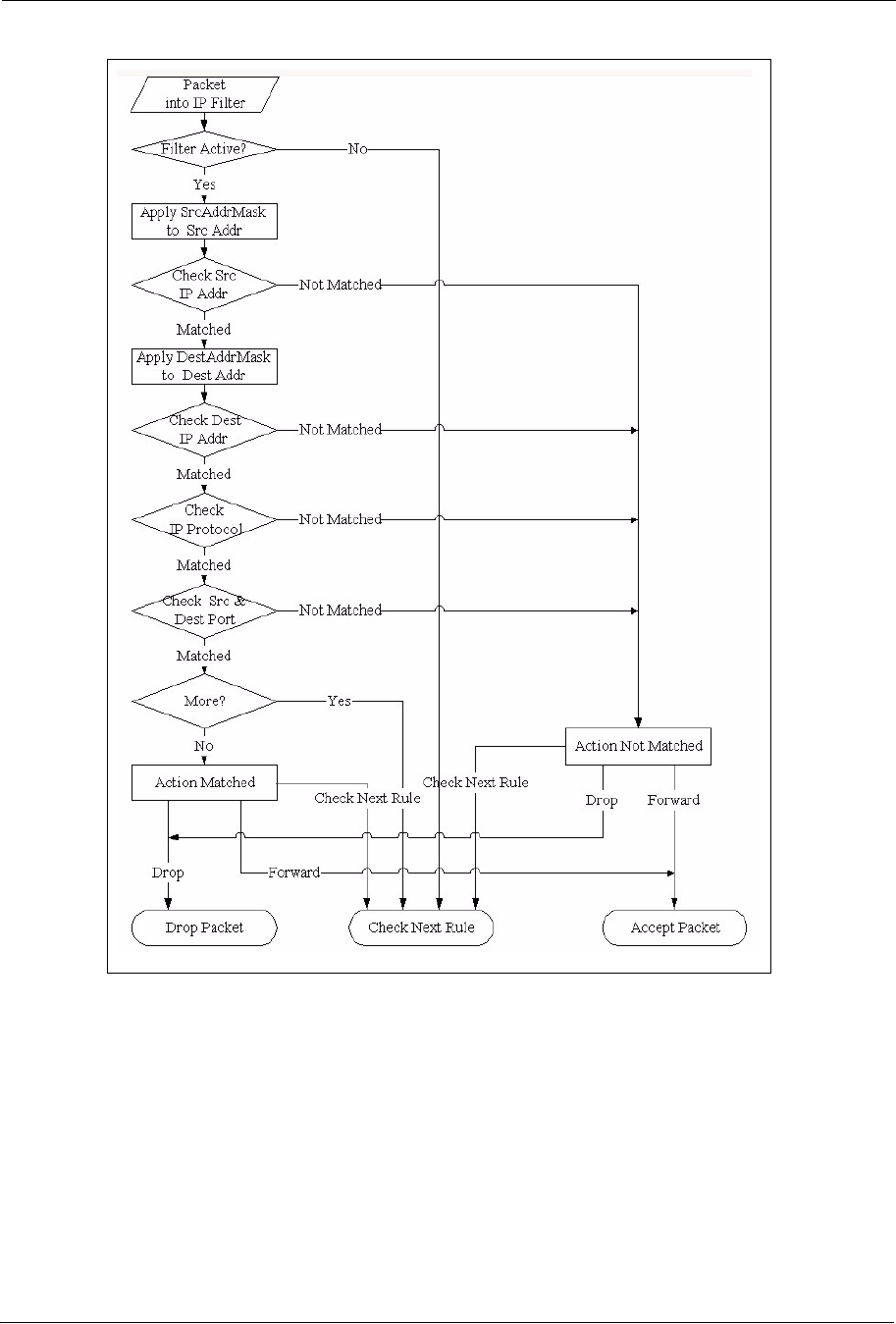
P-660H/HW/W-T Series User’ Guide
279 Chapter 29 Filter Configuration
Figure 171 Executing an IP Filter
29.4.2 Generic Filter Rule
This section shows you how to configure a generic filter rule. The purpose of generic rules is
to allow you to filter non-IP packets. For IP, it is generally easier to use the IP rules directly.
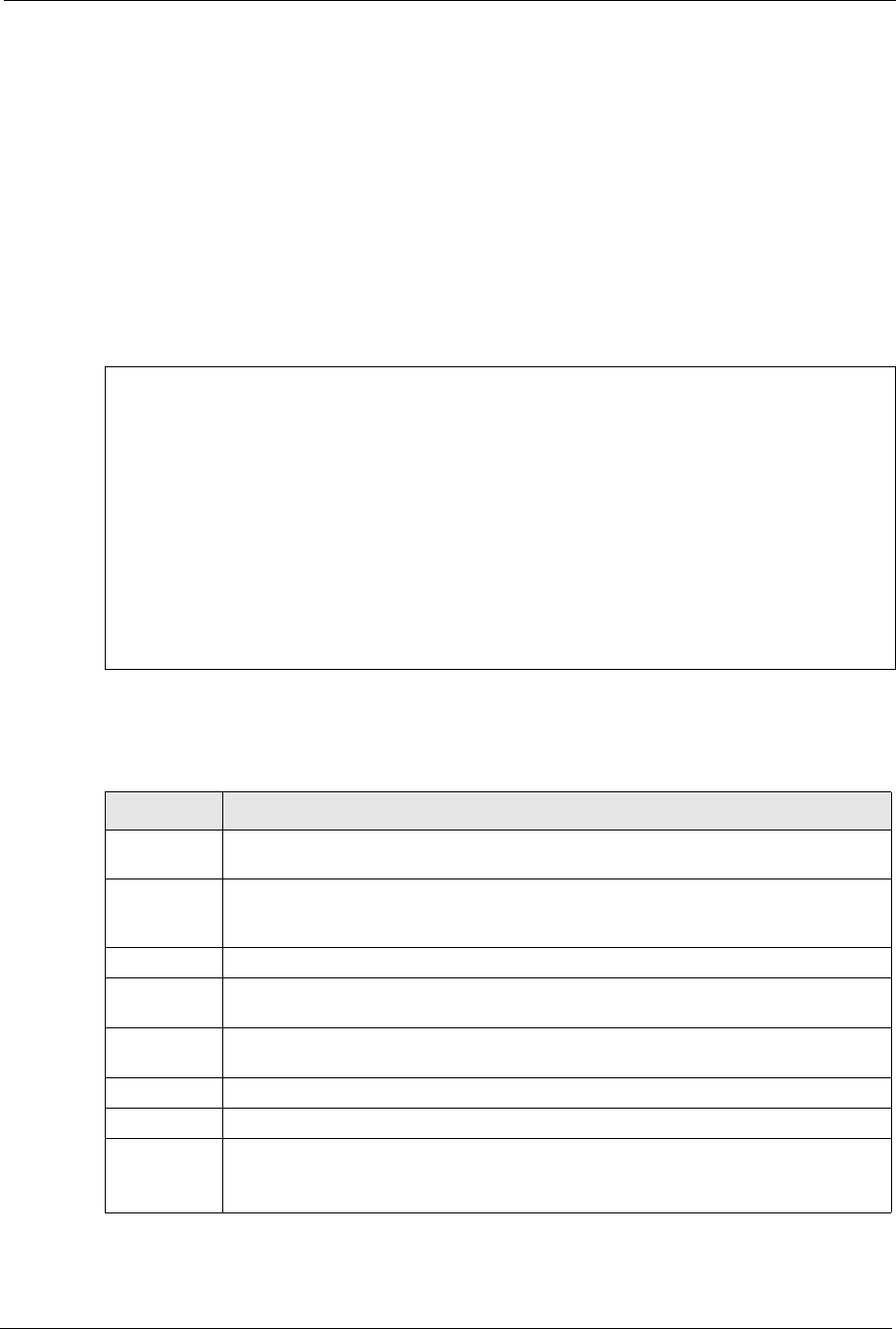
P-660H/HW/W-T Series User’ Guide
Chapter 29 Filter Configuration 280
For generic rules, the Prestige treats a packet as a byte stream as opposed to an IP packet. You
specify the portion of the packet to check with the Offset (from 0) and the Length fields, both
in bytes. The Prestige applies the Mask (bit-wise ANDing) to the data portion before
comparing the result against the Value to determine a match. The Mask and Value fields are
specified in hexadecimal numbers. Note that it takes two hexadecimal digits to represent a
byte, so if the length is 4, the value in either field will take 8 digits, for example, FFFFFFFF.
To configure a generic rule select an empty filter set in menu 21, for example 5. Select
Generic Filter Rule in the Filter Type field and press [ENTER] to open Menu 21.1.5.1 –
Generic Filter Rule, as shown in the following figure.
Figure 172 Menu 21.1.5.1 Generic Filter Rule
The next table describes the fields in the Generic Filter Rule menu.
Menu 21.1.5.1 - Generic Filter Rule
Filter #: 5,1
Filter Type= Generic Filter Rule
Active= No
Offset= 0
Length= 0
Mask= N/A
Value= N/A
More= No Log= None
Action Matched= Check Next Rule
Action Not Matched= Check Next Rule
Press ENTER to Confirm or ESC to Cancel:
Table 97 Menu 21.1.5.1 Generic Filter Rule
FIELD DESCRIPTION
Filter # This is the filter set, filter rule coordinates, for instance, 2, 3 refers to the second filter
set and the third rule of that set.
Filter Type Press [SPACE BAR] and then [ENTER] to select a type of rule. Parameters displayed
below each type will be different. Choices are Generic Filter Rule or TCP/IP Filter
Rule.
Active Select Yes to turn on or No to turn off the filter rule.
Offset Type the starting byte of the data portion in the packet that you want to compare. The
range for this field is from 0 to 255.
Length Type the byte count of the data portion in the packet that you want to compare. The
range for this field is 0 to 8.
Mask Type the mask (in Hexadecimal) to apply to the data portion before comparison.
Value Type the value (in Hexadecimal) to compare with the data portion.
More If Yes, a matching packet is passed to the next filter rule before an action is taken or
else the packet is disposed of according to the action fields.
If More is Yes, then Action Matched and Action Not Matched will be N/A.
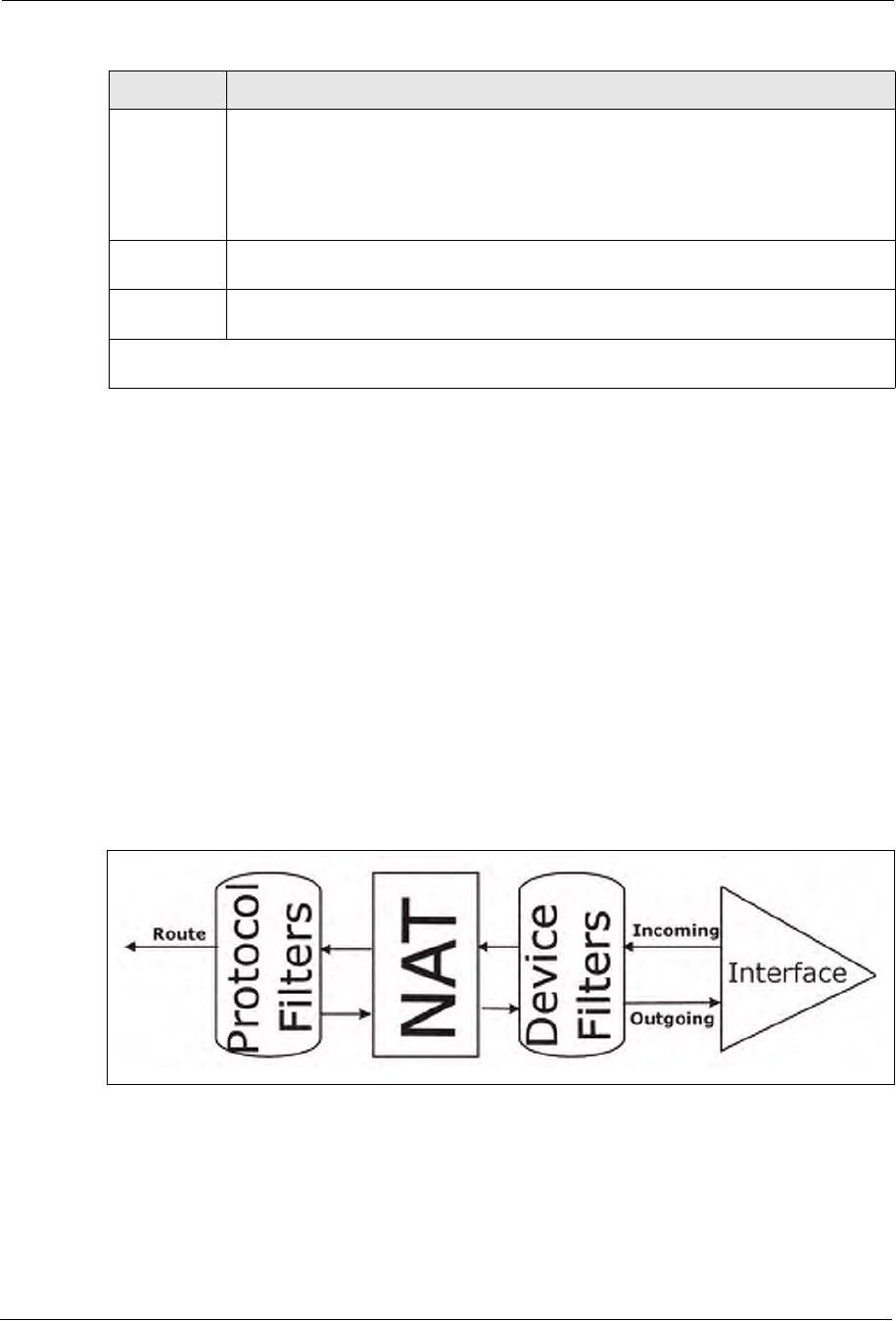
P-660H/HW/W-T Series User’ Guide
281 Chapter 29 Filter Configuration
29.5 Filter Types and NAT
There are two classes of filter rules, Generic Filter Device rules and Protocol Filter (TCP/IP)
rules. Generic Filter rules act on the raw data from/to LAN and WAN. Protocol Filter rules act
on IP packets.
When NAT (Network Address Translation) is enabled, the inside IP address and port number
are replaced on a connection-by-connection basis, which makes it impossible to know the
exact address and port on the wire. Therefore, the Prestige applies the protocol filters to the
“native” IP address and port number before NAT for outgoing packets and after NAT for
incoming packets. On the other hand, the generic (or device) filters are applied to the raw
packets that appear on the wire. They are applied at the point where the Prestige is receiving
and sending the packets; for instance, the interface. The interface can be an Ethernet, or any
other hardware port. The following figure illustrates this.
Figure 173 Protocol and Device Filter Sets
29.6 Example Filter
Let’s look at an example to block outside users from telnetting into the Prestige.
Log Select the logging option from the following:
None – No packets will be logged.
Action Matched – Only matching packets and rules will be logged.
Action Not Matched – Only packets that do not match the rule parameters will be
logged.
Both – All packets will be logged.
Action
Matched
Select the action for a matching packet. Choices are Check Next Rule,Forward or
Drop.
Action Not
Matched
Select the action for a packet not matching the rule. Choices are Check Next Rule,
Forward or Drop.
When you have completed this menu, press [ENTER] at the prompt “Press ENTER to Confirm
or ESC to Cancel:” to save your configuration, or press [ESC] at any time to cancel.
Table 97 Menu 21.1.5.1 Generic Filter Rule (continued)
FIELD DESCRIPTION
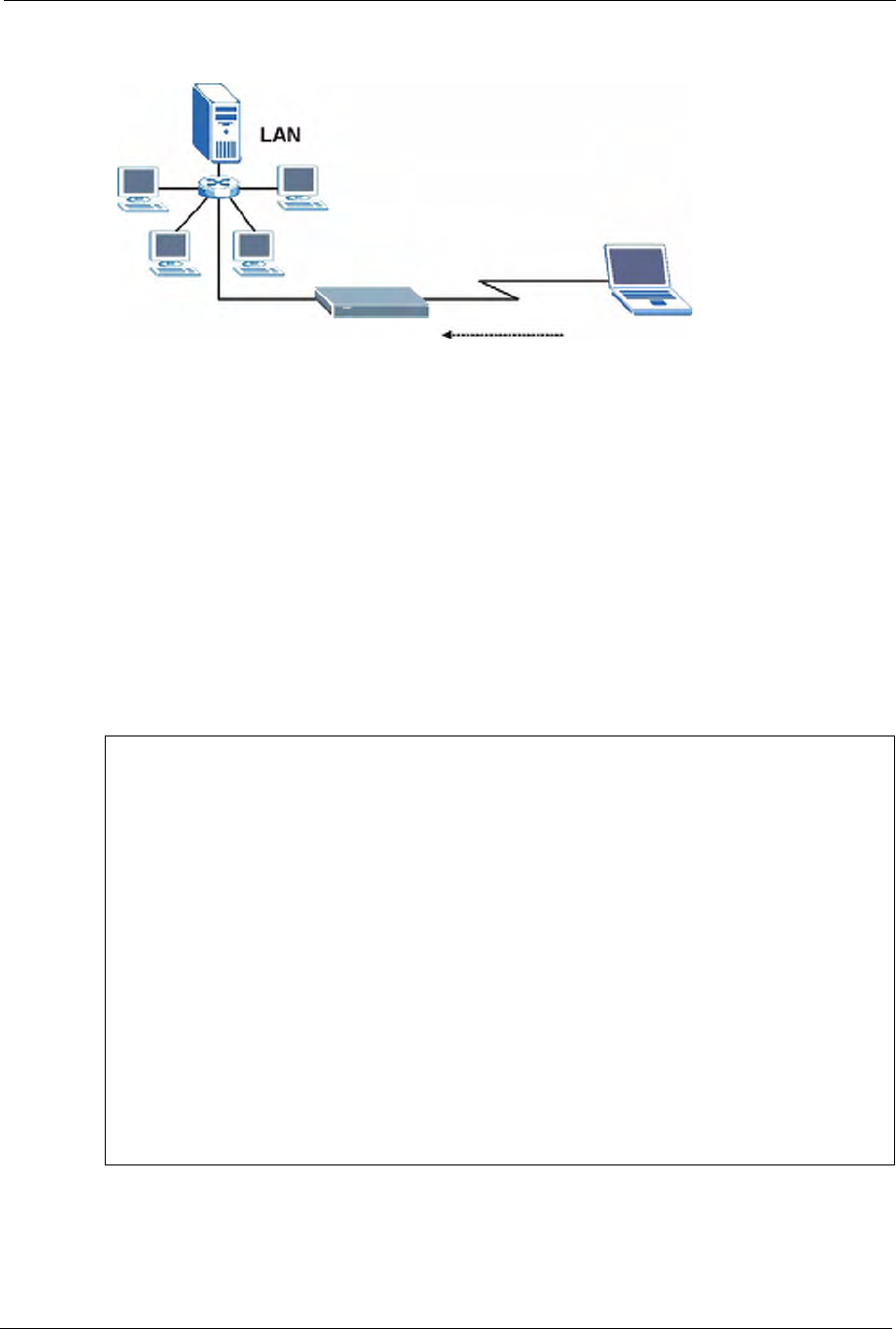
P-660H/HW/W-T Series User’ Guide
Chapter 29 Filter Configuration 282
Figure 174 Sample Telnet Filter
1Enter 1 in the menu 21 to display Menu 21.1 — Filter Set Configuration.
2Enter the index number of the filter set you want to configure (in this case 6).
3Type a descriptive name or comment in the Edit Comments field (for example,
TELNET_WAN) and press [ENTER].
4Press [ENTER] at the message “Press [ENTER] to confirm or [ESC] to
cancel...” to open Menu 21.1.6 — Filter Rules Summary.
5Type 1 to configure the first filter rule. Make the entries in this menu as shown next.
When you press [ENTER] to confirm, the following screen appears. Note that there is only
one filter rule in this set.
Figure 175 Menu 21.1.6.1 Sample Filter
After you have created the filter set, you must apply it.
1Enter 11 in the main menu to display menu 11 and type the remote node number to edit.
Menu 21.1.6.1 - TCP/IP Filter Rule
Filter #: 6,1
Filter Type= TCP/IP Filter Rule
Active= Yes
IP Protocol= 6 IP Source Route= No
Destination: IP Addr= 0.0.0.0
IP Mask= 0.0.0.0
Port #= 23
Port # Comp= Equal
Source: IP Addr= 0.0.0.0
IP Mask= 0.0.0.0
Port #=
Port # Comp= Equal
TCP Estab= No
More= No Log= None
Action Matched= Drop
Action Not Matched= Forward
Press ENTER to Confirm or ESC to Cancel:

P-660H/HW/W-T Series User’ Guide
283 Chapter 29 Filter Configuration
2Go to the Edit Filter Sets field, press [SPACE BAR] to choose Yes and press [ENTER].
This brings you to menu 11.5. Apply the example filter set (for example, filter set 3) in this
menu as shown in the next section.
This shows you that you have configured and activated (A = Y) a TCP/IP filter rule (Type =
IP,Pr = 6) for destination telnet ports (DP = 23).
M = N means an action can be taken immediately. The action is to drop the packet (m = D) if
the action is matched and to forward the packet immediately (n = F) if the action is not
matched no matter whether there are more rules to be checked (there aren’t in this example).
Figure 176 Menu 21.1.6.1 Sample Filter Rules Summary
29.7 Applying Filters and Factory Defaults
This section shows you where to apply the filter(s) after you design it (them). Sets of factory
default filter rules have been configured in menu 21 (but have not been applied) to filter
traffic.
Menu 21.1.6 - Filter Rules Summary
# A Type Filter Rules M m n
- - ---- --------------------------------------------------------------- -
- -
1 Y IP Pr=6, SA=0.0.0.0, DA=0.0.0.0, DP=23 N D F
2 N
3 N
4 N
5 N
6 N
Enter Filter Rule Number (1-6) to Configure: 1
Table 98 Filter Sets Table
FILTER SETS DESCRIPTION
Input Filter Sets: Apply filters for incoming traffic. You may apply protocol or device filter rules. See
earlier in this chapter for information on filters.
Output Filter Sets: Apply filters for traffic leaving the Prestige. You may apply filter rules for protocol
or device filters. See earlier in this section for information on types of filters.
Call Filter Sets: Apply filters to decide if a packet should be allowed to trigger a call.

P-660H/HW/W-T Series User’ Guide
Chapter 29 Filter Configuration 284
29.7.1 Ethernet Traffic
You seldom need to filter Ethernet traffic; however, the filter sets may be useful to block
certain packets, reduce traffic and prevent security breaches. Go to menu 3.1 (shown next) and
type the number(s) of the filter set(s) that you want to apply as appropriate. You can choose up
to four filter sets (from twelve) by typing their numbers separated by commas, for example, 3,
4, 6, 11. The factory default filter set, NetBIOS_LAN, is inserted in the protocol filters field
under Input Filter Sets in menu 3.1 in order to prevent local NetBIOS messages from
triggering calls to the DNS server.
Figure 177 Filtering Ethernet Traffic
29.7.2 Remote Node Filters
Go to menu 11.5 (shown next) and type the number(s) of the filter set(s) as appropriate. You
can cascade up to four filter sets by typing their numbers separated by commas. The factory
default filter set, NetBIOS_WAN, is inserted in the protocol filters field under Call Filter Sets
in menu 11.5 to block local NetBIOS traffic from triggering calls to the ISP.
Figure 178 Filtering Remote Node Traffic
Note that call filter sets are visible when you select PPPoA or PPPoE encapsulation.
Menu 3.1 – LAN Port Filter Setup
Input Filter Sets:
protocol filters= 3
device filters=
Output Filter Sets:
protocol filters=
device filters=
Press ENTER to Confirm or ESC to Cancel:
Menu 11.5 - Remote Node Filter
Input Filter Sets:
protocol filters= 6
device filters=
Output Filter Sets:
protocol filters= 2
device filters=
Call Filter Sets:
Protocol filters=
Device filters=
Enter here to CONFIRM or ESC to CANCEL:

P-660H/HW/W-T Series User’ Guide
285 Chapter 29 Filter Configuration
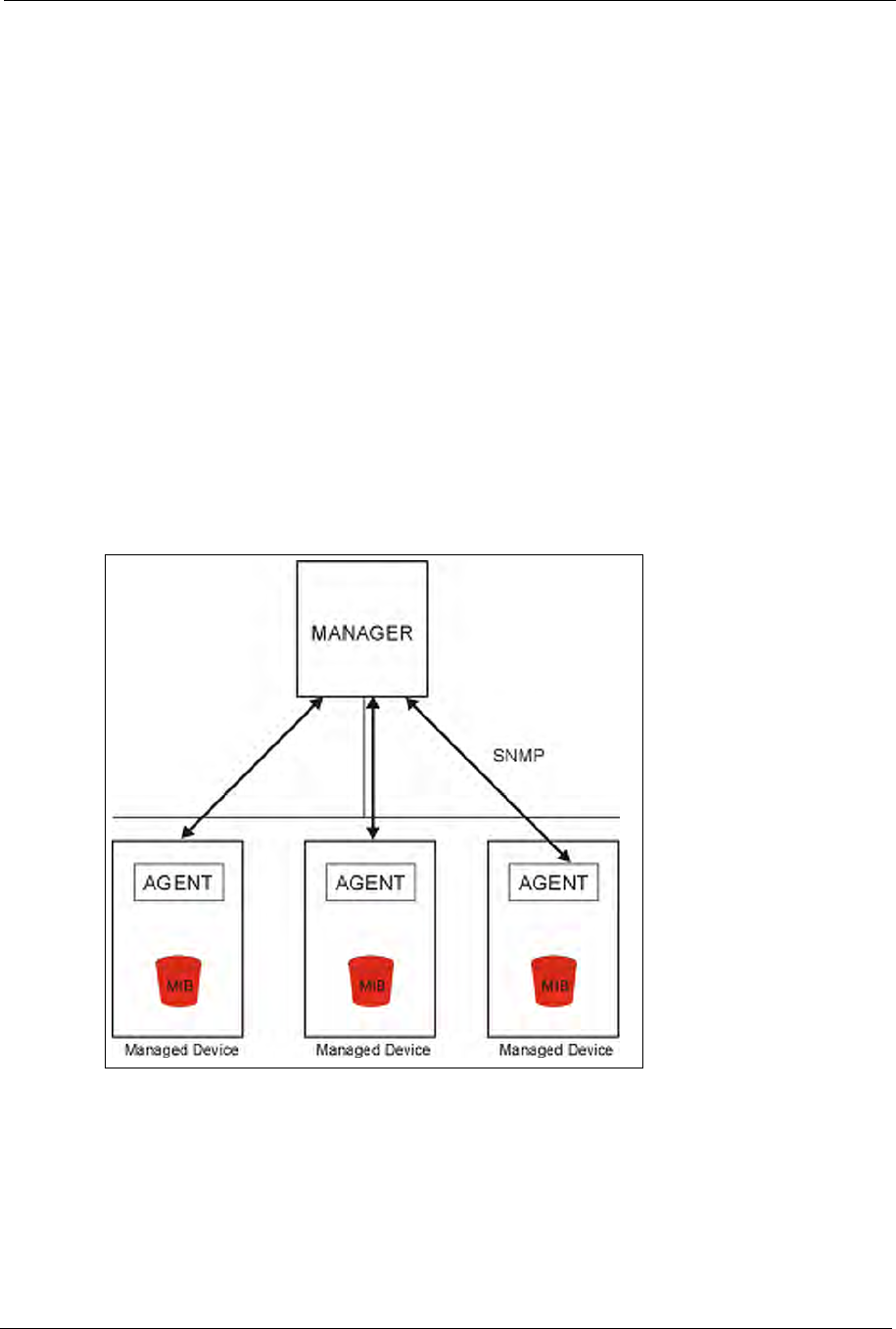
P-660H/HW/W-T Series User’ Guide
Chapter 30 SNMP Configuration 286
CHAPTER 30
SNMP Configuration
This chapter explains SNMP Configuration menu 22.
30.1 About SNMP
Simple Network Management Protocol (SNMP) is a protocol used for exchanging
management information between network devices. SNMP is a member of the TCP/IP
protocol suite. Your Prestige supports SNMP agent functionality, which allows a manager
station to manage and monitor the Prestige through the network. The Prestige supports SNMP
version one (SNMPv1) and version two c (SNMPv2c). The next figure illustrates an SNMP
management operation. SNMP is only available if TCP/IP is configured.
Figure 179 SNMP Management Model
An SNMP managed network consists of two main components: agents and a manager.
An agent is a management software module that resides in a managed device (the Prestige).
An agent translates the local management information from the managed device into a form
compatible with SNMP. The manager is the console through which network administrators
perform network management functions. It executes applications that control and monitor
managed devices.

P-660H/HW/W-T Series User’ Guide
287 Chapter 30 SNMP Configuration
The managed devices contain object variables/managed objects that define each piece of
information to be collected about a device. Examples of variables include the number of
packets received, node port status etc. A Management Information Base (MIB) is a collection
of managed objects. SNMP allows a manager and agents to communicate for the purpose of
accessing these objects.
SNMP itself is a simple request/response protocol based on the manager/agent model. The
manager issues a request and the agent returns responses using the following protocol
operations:
• Get - Allows the manager to retrieve an object variable from the agent.
• GetNext - Allows the manager to retrieve the next object variable from a table or list
within an agent. In SNMPv1, when a manager wants to retrieve all elements of a table
from an agent, it initiates a Get operation, followed by a series of GetNext operations.
• Set - Allows the manager to set values for object variables within an agent.
• Trap - Used by the agent to inform the manager of some events.
30.2 Supported MIBs
The Prestige supports RFC-1215 and MIB II as defined in RFC-1213 as well as ZyXEL
private MIBs. The focus of the MIBs is to let administrators collect statistic data and monitor
status and performance.
30.3 SNMP Configuration
To configure SNMP, select option 22 from the main menu to open Menu 22 — SNMP
Configuration as shown next. The “community” for Get, Set and Trap fields is SNMP
terminology for password.

P-660H/HW/W-T Series User’ Guide
Chapter 30 SNMP Configuration 288
Figure 180 Menu 22 SNMP Configuration
The following table describes the SNMP configuration parameters.
30.4 SNMP Traps
The Prestige will send traps to the SNMP manager when any one of the following events
occurs:
Menu 22 - SNMP Configuration
SNMP:
Get Community= public
Set Community= public
Trusted Host= 0.0.0.0
Trap:
Community= public
Destination= 0.0.0.0
Press ENTER to Confirm or ESC to Cancel:
Table 99 Menu 22 SNMP Configuration
FIELD DESCRIPTION
SNMP:
Get Community Type the Get Community, which is the password for the incoming Get- and
GetNext requests from the management station.
Set Community Type the Set community, which is the password for incoming Set requests from
the management station.
Trusted Host If you enter a trusted host, your Prestige will only respond to SNMP messages
from this address. A blank (default) field means your Prestige will respond to all
SNMP messages it receives, regardless of source.
Trap:
Community Type the trap community, which is the password sent with each trap to the
SNMP manager.
Destination Type the IP address of the station to send your SNMP traps to.
When you have completed this menu, press [ENTER] at the prompt “Press ENTER to Confirm
or ESC to Cancel:” to save your configuration, or press [ESC] at any time to cancel.
Table 100 SNMP Traps
TRAP # TRAP NAME DESCRIPTION
1coldStart (defined in RFC-1215)A trap is sent after booting (power on).
2warmStart (defined in RFC-1215)A trap is sent after booting (software reboot).
3linkDown (defined in RFC-1215)A trap is sent with the port number when any of the
links are down. See the following table.
4linkUp (defined in RFC-1215)A trap is sent with the port number.

P-660H/HW/W-T Series User’ Guide
289 Chapter 30 SNMP Configuration
The port number is its interface index under the interface group.
5authenticationFailure (defined in
RFC-1215)
A trap is sent to the manager when receiving any
SNMP gets or sets requirements with wrong
community (password).
6whyReboot (defined in ZYXEL-MIB) A trap is sent with the reason of restart before
rebooting when the system is going to restart (warm
start).
6a For intentional reboot : A trap is sent with the message "System reboot by
user!" if reboot is done intentionally, (for example,
download new files, CI command "sys reboot", etc.).
Table 101 Ports and Permanent Virtual Circuits
PORT PVC (PERMANENT VIRTUAL CIRCUIT)
1Ethernet LAN
2 1
3 2
… …
13 12
14 xDSL
Table 100 SNMP Traps (continued)
TRAP # TRAP NAME DESCRIPTION

P-660H/HW/W-T Series User’ Guide
Chapter 31 System Security 290
CHAPTER 31
System Security
This chapter describes how to configure the system security on the Prestige.
31.1 System Security
You can configure the system password.
31.1.1 System Password
Enter 23 in the main menu to display Menu 23 – System Security.
You should change the default password. If you forget your password you have to restore the
default configuration file.
Figure 181 Menu 23 – System Security
31.1.2 Configuring External RADIUS Server
From Menu 23- System Security, enter 2 to display Menu 23.2 - System Security-RADIAS
Server.
Menu 23 - System Security
1. Change Password
2. RADIUS Server
4. IEEE802.1x
Enter Menu Selection Number:

P-660H/HW/W-T Series User’ Guide
291 Chapter 31 System Security
Figure 182 Menu 23.2 System Security: RADIUS Server
The following table describes the fields in this menu.
Menu 23.2 - System Security - RADIUS Server
Authentication Server:
Active= No
Server Address= 10.11.12.13
Port #= 1812
Shared Secret= ********
Accounting Server:
Active= No
Server Address= 10.11.12.13
Port #= 1813
Shared Secret= ********
Press ENTER to Confirm or ESC to Cancel:
Table 102 Menu 23.2 System Security: RADIUS Server
FIELD DESCRIPTION
Authentication Server
Active Press [SPACE BAR] to select Yes and press [ENTER] to enable user
authentication through an external authentication server.
Server Address Enter the IP address of the external authentication server in dotted decimal
notation.
Port The default port of the RADIUS server for authentication is 1812.
You need not change this value unless your network administrator instructs
you to do so with additional information.
Shared Secret Specify a password (up to 31 alphanumeric characters) as the key to be
shared between the external authentication server and the access points.
The key is not sent over the network. This key must be the same on the
external authentication server and Prestige.
Accounting Server
Active Press [SPACE BAR] to select Yes and press [ENTER] to enable user
authentication through an external accounting server.
Server Address Enter the IP address of the external accounting server in dotted decimal
notation.
Port The default port of the RADIUS server for accounting is 1813.
You need not change this value unless your network administrator instructs
you to do so with additional information.
Shared Secret Specify a password (up to 31 alphanumeric characters) as the key to be
shared between the external accounting server and the access points.
The key is not sent over the network. This key must be the same on the
external accounting server and Prestige.
When you have completed this menu, press [ENTER] at the prompt “Press ENTER to Confirm
or ESC to Cancel:” to save your configuration, or press [ESC] at any time to cancel.

P-660H/HW/W-T Series User’ Guide
Chapter 31 System Security 292
31.1.3 IEEE 802.1x
The IEEE 802.1x standards outline enhanced security methods for both the authentication of
wireless stations and encryption key management.
Follow the steps below to enable EAP authentication on your Prestige.
1From the main menu, enter 23 to display Menu23 – System Security.
Figure 183 Menu 23 System Security
2Enter 4 to display Menu 23.4 – System Security – IEEE 802.1x.
Figure 184 Menu 23.4 System Security: IEEE 802.1x
The following table describes the fields in this menu.
Menu 23 - System Security
1. Change Password
2. RADIUS Server
4. IEEE802.1x
Enter Menu Selection Number:
Menu 23.4 - System Security - IEEE 802.1x
Wireless Port Control= No Authentication Required
ReAuthentication Timer (in second)= N/A
Idle Timeout (in second)= N/A
Key Management Protocol= N/A
Dynamic WEP Key Exchange= N/A
PSK= N/A
WPA Mixed Mode= N/A
Data Privacy for Broadcast/Multicast packets= N/A
WPA Broadcast/Multicast Key Update Timer= N/A
Authentication Databases= N/A
Press ENTER to Confirm or ESC to Cancel:

P-660H/HW/W-T Series User’ Guide
293 Chapter 31 System Security
Table 103 Menu 23.4 System Security: IEEE 802.1x
FIELD DESCRIPTION
Wireless Port
Control
Press [SPACE BAR] and select a security mode for the wireless LAN access.
Select No Authentication Required to allow any wireless stations access to your
wired network without entering usernames and passwords. This is the default
setting.
Selecting Authentication Required means wireless stations have to enter
usernames and passwords before access to the wired network is allowed.
Select No Access Allowed to block all wireless stations access to the wired
network.
The following fields are not available when you select No Authentication Required
or No Access Allowed.
ReAuthentica-
tion Timer
(in second)
Specify how often a client has to re-enter username and password to stay
connected to the wired network.
This field is activated only when you select Authentication Required in the
Wireless Port Control field. Enter a time interval between 10 and 9999 (in
seconds). The default time interval is 1800 seconds (or 30 minutes).
Idle Timeout (in
second)
The Prestige automatically disconnects a client from the wired network after a
period of inactivity. The client needs to enter the username and password again
before access to the wired network is allowed.
This field is activated only when you select Authentication Required in the
Wireless Port Control field. The default time interval is 3600 seconds (or 1 hour).
Key Management
Protocol
Press [SPACE BAR] to select 802.1x,WPA or WPA-PSK and press [ENTER].
Dynamic WEP
Key Exchange
This field is activated only when you select Authentication Required in the
Wireless Port Control field. Also set the Authentication Databases field to
RADIUS Only. Local user database may not be used.
Select Disable to allow wireless stations to communicate with the access points
without using Dynamic WEP Key Exchange.
Select 64-bit WEP or 128-bit WEP to enable data encryption.
Up to 32 stations can access the Prestige when you configure Dynamic WEP Key
Exchange. This field is not available when you set Key Management Protocol to
WPA or WPA-PSK.
PSK Type a pre-shared key from 8 to 63 case-sensitive ASCII characters (including
spaces and symbols) when you select WPA-PSK in the Key Management
Protocol field.
WPA Mixed
Mode
Select Enable to activate WPA mixed mode. Otherwise, select Disable and
configure Group Data Privacy field.
Data Privacy for
Broadcast/
Multicast packets
This field allows you to choose TKIP (recommended) or WEP for broadcast and
multicast (“group”) traffic if the Key Management Protocol is WPA and WPA
Mixed Mode is disabled. WEP is used automatically if you have enabled WPA
Mixed Mode.
All unicast traffic is automatically encrypted by TKIP when WPA or WPA-PSK Key
Management Protocol is selected.
WPA Broadcast/
Multicast Key
Update Timer
The WPA Broadcast/Multicast Key Update Timer is the rate at which the AP (if
using WPA-PSK key management) or RADIUS server (if using WPA key
management) sends a new group key out to all clients. The re-keying process is the
WPA equivalent of automatically changing the WEP key for an AP and all stations in
a WLAN on a periodic basis. Setting of the WPA Broadcast/Multicast Key Update
Timer is also supported in WPA-PSK mode. The Prestige default is 1800 seconds
(30 minutes).

P-660H/HW/W-T Series User’ Guide
Chapter 31 System Security 294
Once you enable user authentication, you need to specify an external RADIUS server or create
local user accounts on the Prestige for authentication.
31.2 Creating User Accounts on the Prestige
By storing user profiles locally, your Prestige is able to authenticate wireless users without
interacting with a network RADIUS server.
Follow the steps below to set up user profiles on your Prestige.
1From the main menu, enter 14 to display Menu 14 - Dial-in User Setup.
Authentication
Databases
The authentication database contains wireless station login information. The local
user database is the built-in database on the Prestige. The RADIUS is an external
server. Use this field to decide which database the Prestige should use (first) to
authenticate a wireless station.
Before you specify the priority, make sure you have set up the corresponding
database correctly first.
When you configure Key Management Protocol to WPA, the Authentication
Databases must be RADIUS Only. You can only use the Local User Database
with 802.1x Key Management Protocol.
Select Local User Database Only to have the Prestige just check the built-in user
database on the Prestige for a wireless station's username and password.
Select RADIUS Only to have the Prestige just check the user database on the
specified RADIUS server for a wireless station's username and password.
Select Local first, then RADIUS to have the Prestige first check the user database
on the Prestige for a wireless station's username and password. If the user name is
not found, the Prestige then checks the user database on the specified RADIUS
server.
Select RADIUS first, then Local to have the Prestige first check the user database
on the specified RADIUS server for a wireless station's username and password. If
the Prestige cannot reach the RADIUS server, the Prestige then checks the local
user database on the Prestige. When the user name is not found or password does
not match in the RADIUS server, the Prestige will not check the local user database
and the authentication fails.
When you have completed this menu, press [ENTER] at the prompt “Press ENTER to Confirm
or ESC to Cancel:” to save your configuration, or press [ESC] at any time to cancel.
Table 103 Menu 23.4 System Security: IEEE 802.1x (continued)
FIELD DESCRIPTION
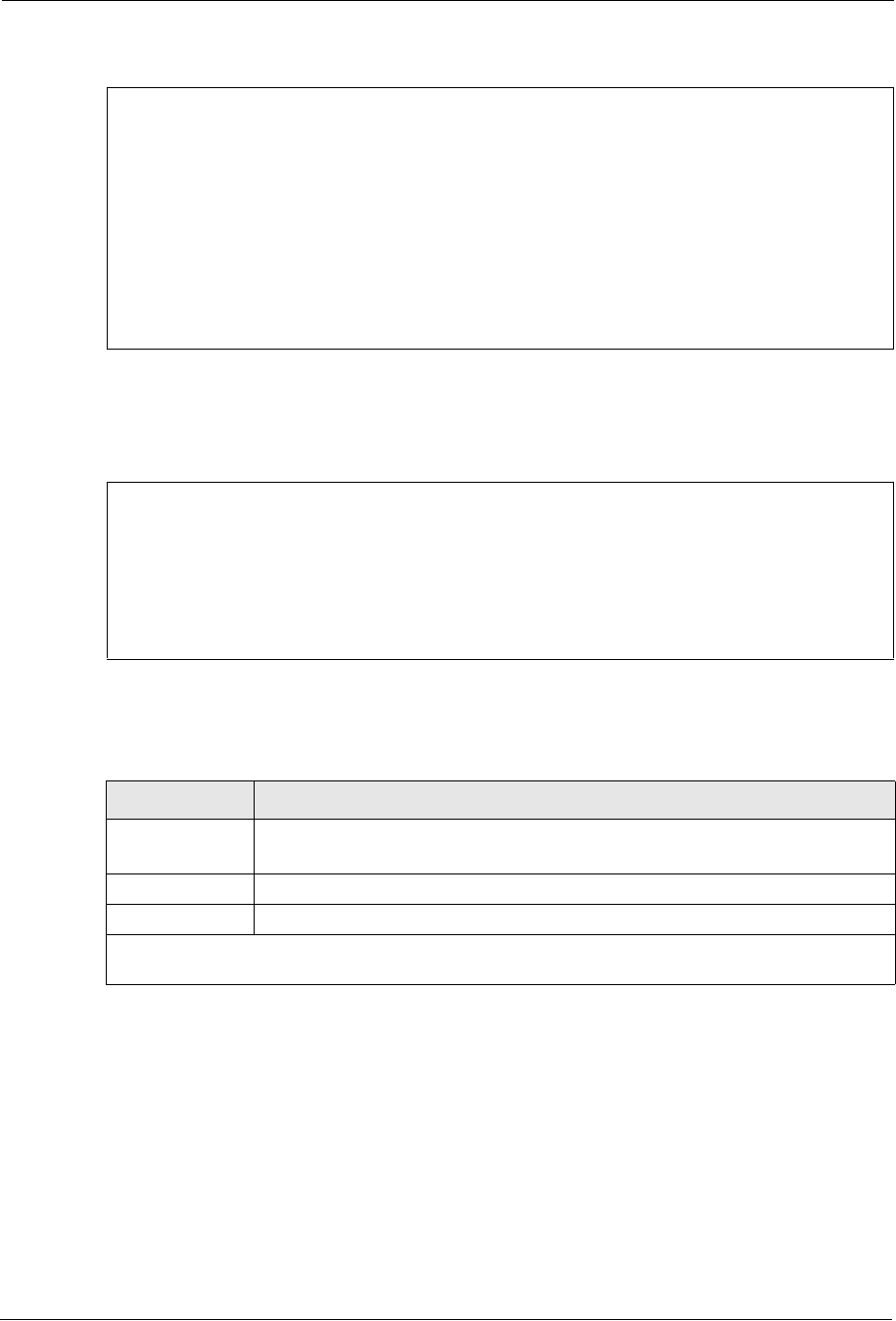
P-660H/HW/W-T Series User’ Guide
295 Chapter 31 System Security
Figure 185 Menu 14 Dial-in User Setup
2Type a number and press [ENTER] to edit the user profile.
Figure 186 Menu 14.1 Edit Dial-in User
The following table describes the fields in this menu.
Menu 14 - Dial-in User Setup
1. ________ 9. ________ 17. ________ 25. ________
2. ________ 10. ________ 18. ________ 26. ________
3. ________ 11. ________ 19. ________ 27. ________
4. ________ 12. ________ 20. ________ 28. ________
5. ________ 13. ________ 21. ________ 29. ________
6. ________ 14. ________ 22. ________ 30. ________
7. ________ 15. ________ 23. ________ 31. ________
8. ________ 16. ________ 24. ________ 32. ________
Enter Menu Selection Number:
Menu 14.1 - Edit Dial-in User
User Name= test
Active= Yes
Password= ********
Press ENTER to Confirm or ESC to Cancel:
Table 104 Menu 14.1 Edit Dial-in User
FIELD DESCRIPTION
User Name Enter a username up to 31 alphanumeric characters long for this user profile.
This field is case sensitive.
Active Press [SPACE BAR] to select Yes and press [ENTER] to enable the user profile.
Password Enter a password up to 31 characters long for this user profile.
When you have completed this menu, press [ENTER] at the prompt “Press ENTER to Confirm
or ESC to Cancel:” to save your configuration, or press [ESC] at any time to cancel.

P-660H/HW/W-T Series User’ Guide
Chapter 32 System Information and Diagnosis 296
CHAPTER 32
System Information and
Diagnosis
This chapter covers the information and diagnostic tools in SMT menus 24.1 to 24.4.
32.1 Overview
These tools include updates on system status, port status, log and trace capabilities and
upgrades for the system software. This chapter describes how to use these tools in detail.
Type 24 in the main menu to open Menu 24 – System Maintenance, as shown in the
following figure.
Figure 187 Menu 24 System Maintenance
32.2 System Status
The first selection, System Status gives you information on the status and statistics of the
ports, as shown next. System Status is a tool that can be used to monitor your Prestige.
Specifically, it gives you information on your DSL telephone line status, number of packets
sent and received.
To get to System Status, type 24 to go to Menu 24 — System Maintenance. From this menu,
type 1.System Status. There are two commands in Menu 24.1 — System Maintenance —
Status. Entering 1 resets the counters; [ESC] takes you back to the previous screen.
Menu 24 - System Maintenance
1. System Status
2. System Information and Console Port Speed
3. Log and Trace
4. Diagnostic
5. Backup Configuration
6. Restore Configuration
7. Upload Firmware
8. Command Interpreter Mode
9. Call Control
10. Time and Date Setting
11. Remote Management
Enter Menu Selection Number:

P-660H/HW/W-T Series User’ Guide
297 Chapter 32 System Information and Diagnosis
The following table describes the fields present in Menu 24.1 — System Maintenance —
Status which are read-only and meant for diagnostic purposes.
Figure 188 Menu 24.1 System Maintenance : Status
The following table describes the fields present in Menu 24.1 — System Maintenance —
Status.
Menu 24.1 - System Maintenance - Status 23:08:47
Sat. Jan. 01, 2000
Node-Lnk Status TxPkts RxPkts Errors Tx B/s Rx B/s Up
Time
1-ENET N/A 0 0 0 0 0 0:00:00
2 N/A 0 0 0 0 0 0:00:00
3 N/A 0 0 0 0 0 0:00:00
4 N/A 0 0 0 0 0 0:00:00
5 N/A 0 0 0 0 0 0:00:00
6 N/A 0 0 0 0 0 0:00:00
7 N/A 0 0 0 0 0 0:00:00
8 N/A 0 0 0 0 0 0:00:00
My WAN IP (from ISP): 0.0.0.0
Ethernet: WAN:
Status: 100M/Full Duplex Tx Pkts: 5731 Line Status: Down
Collisions: 0 Rx Pkts: 8314 Upstream Speed: 0 kbps
CPU Load = 25.52% Downstream Speed: 0 kbps
Press Command:
COMMANDS: 1-Reset Counters TAB-Next Page ESC-Exit
Table 105 Menu 24.1 System Maintenance: Status
FIELD DESCRIPTION
Node-Lnk This is the node index number and link type. Link types are: PPP, ENET, 1483.
Status This shows the status of the remote node.
TxPkts The number of transmitted packets to this remote node.
RxPkts The number of received packets from this remote node.
Errors The number of error packets on this connection.
Tx B/s This shows the transmission rate in bytes per second.
Rx B/s This shows the receiving rate in bytes per second.
Up Time This is the time this channel has been connected to the current remote node.
My WAN IP
(from ISP)
This is the IP address of the ISP remote node.
Ethernet This shows statistics for the LAN.
Status This shows the current status of the LAN.
Tx Pkts This is the number of transmitted packets to the LAN.
Rx Pkts This is the number of received packets from the LAN.
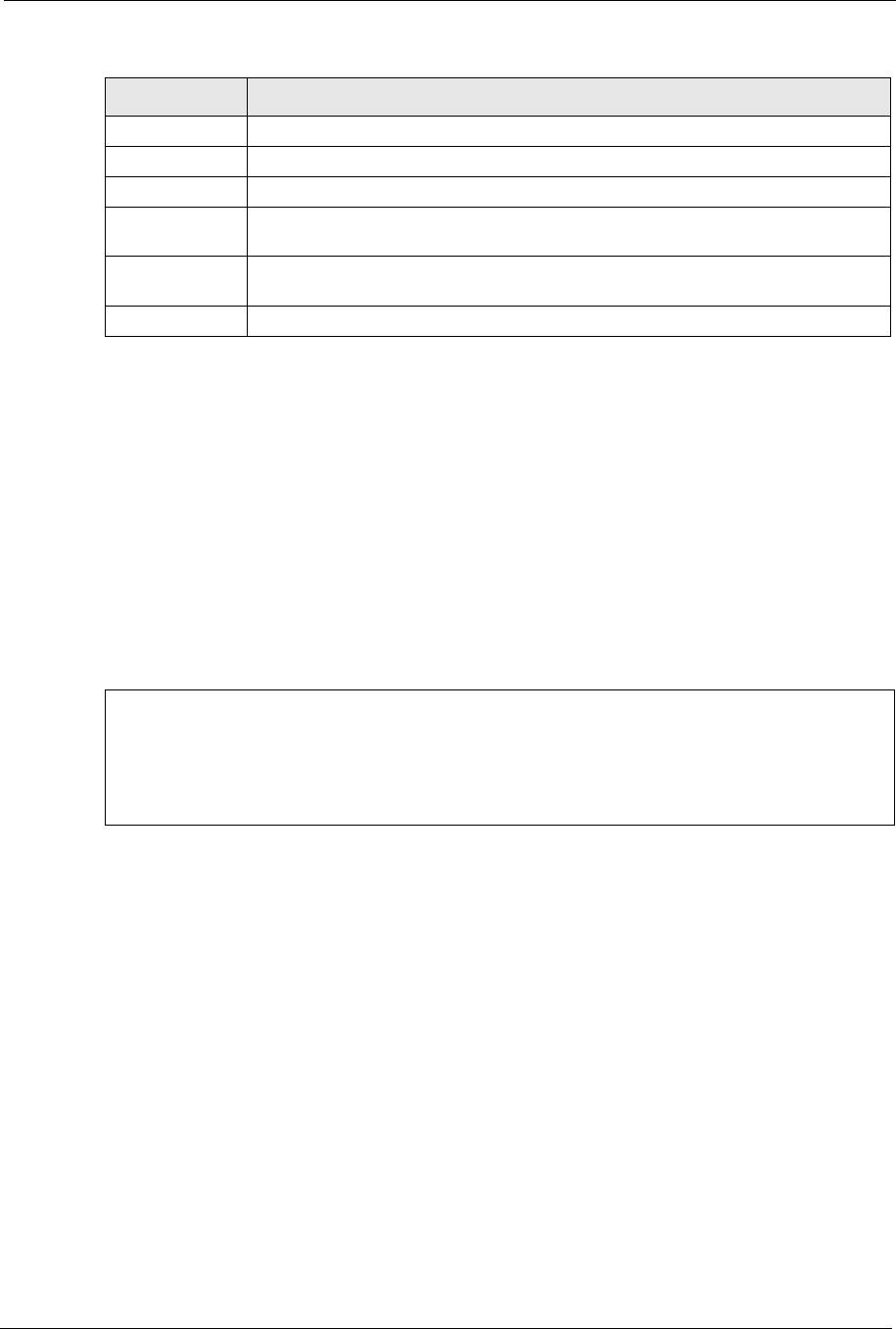
P-660H/HW/W-T Series User’ Guide
Chapter 32 System Information and Diagnosis 298
32.3 System Information
To get to the System Information:
1Enter 24 to display Menu 24 — System Maintenance.
2Enter 2 to display Menu 24.2 — System Information and Console Port Speed.
From this menu you have two choices as shown in the next figure:
Figure 189 Menu 24.2 System Information and Console Port Speed
32.3.1 System Information
Enter 1 in menu 24.2 to display the screen shown next.
Collision This is the number of collisions.
WAN This shows statistics for the WAN.
Line Status This shows the current status of the xDSL line, which can be Up or Down.
Upstream
Speed
This shows the upstream transfer rate in kbps.
Downstream
Speed
This shows the downstream transfer rate in kbps.
CPU Load This specifies the percentage of CPU utilization.
Table 105 Menu 24.1 System Maintenance: Status (continued)
FIELD DESCRIPTION
Menu 24.2 - System Information and Console Port Speed
1. System Information
2. Console Port Speed
Please enter selection:
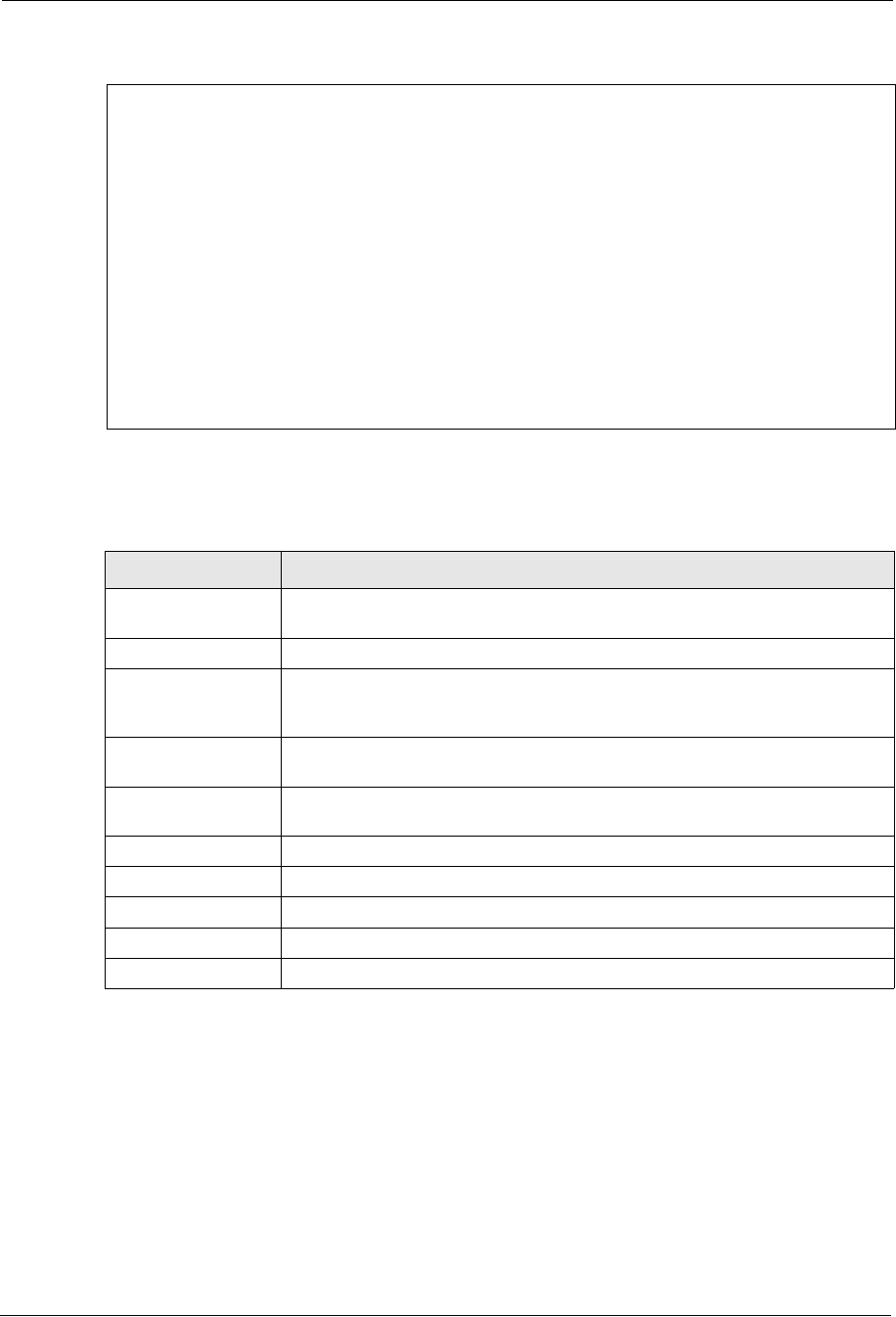
P-660H/HW/W-T Series User’ Guide
299 Chapter 32 System Information and Diagnosis
Figure 190 Menu 24.2.1 System Maintenance: Information
The following table describes the fields in this menu.
32.3.2 Console Port Speed
Note: The console port is internal and reserved for technician use only.
You can set up different port speeds for the console port through Menu 24.2.2 – System
Maintenance – Console Port Speed. Your Prestige supports 9600 (default), 19200, 38400,
57600 and 115200 bps. Press [SPACE BAR] and then [ENTER] to select the desired speed in
menu 24.2.2, as shown in the following figure.
Menu 24.2.1 - System Maintenance - Information
Name:
Routing: IP
ZyNOS F/W Version: V3.40(ACC.0)| 04/26/2005
ADSL Chipset Vendor: DMT FwVer: 3.0.11.11_A_TC, HwVer: T14F+
Standard: Multi-Mode
LAN
Ethernet Address: 00:13:49:11:11:35
IP Address: 192.168.1.1
IP Mask: 255.255.255.0
DHCP: Server
Press ESC or RETURN to Exit:
Table 106 Menu 24.2.1 System Maintenance: Information
FIELD DESCRIPTION
Name Displays the system name of your Prestige. This information can be changed in
Menu 1 – General Setup.
Routing Refers to the routing protocol used.
ZyNOS F/W Version Refers to the ZyNOS (ZyXEL Network Operating System) system firmware
version. ZyNOS is a registered trademark of ZyXEL Communications
Corporation.
ADSL Chipset
Vendor
Displays the vendor of the ADSL chipset and DSL version.
Standard This refers to the operational protocol the Prestige and the DSLAM (Digital
Subscriber Line Access Multiplexer) are using.
LAN
Ethernet Address Refers to the Ethernet MAC (Media Access Control) of your Prestige.
IP Address This is the IP address of the Prestige in dotted decimal notation.
IP Mask This shows the subnet mask of the Prestige.
DHCP This field shows the DHCP setting (None, Relay or Server) of the Prestige.

P-660H/HW/W-T Series User’ Guide
Chapter 32 System Information and Diagnosis 300
Figure 191 Menu 24.2.2 System Maintenance : Change Console Port Speed
Once you change the Prestige console port speed, you must also set the speed parameter for
the communication software you are using to connect to the Prestige.
32.4 Log and Trace
There are two logging facilities in the Prestige. The first is the error logs and trace records that
are stored locally. The second is the syslog facility for message logging.
32.4.1 Viewing Error Log
The first place you should look for clues when something goes wrong is the error log. Follow
the procedures to view the local error/trace log:
1Type 24 in the main menu to display Menu 24 – System Maintenance.
2From menu 24, type 3 to display Menu 24.3 – System Maintenance – Log and Trace.
Figure 192 Menu 24.3 System Maintenance: Log and Trace
3Enter 1 from Menu 24.3 — System Maintenance — Log and Trace to display the error
log in the system.
After the Prestige finishes displaying the error log, you will have the option to clear it.
Samples of typical error and information messages are presented in the next figure.
Menu 24.2.2 – System Maintenance – Change Console Port Speed
Console Port Speed: 9600
Press ENTER to Confirm or ESC to Cancel:
Menu 24.3 - System Maintenance - Log and Trace
1. View Error Log
2. UNIX Syslog
Please enter selection

P-660H/HW/W-T Series User’ Guide
301 Chapter 32 System Information and Diagnosis
Figure 193 Sample Error and Information Messages
32.4.2 Syslog and Accounting
The Prestige uses the syslog facility to log the CDR (Call Detail Record) and system messages
to a syslog server. Syslog and accounting can be configured in Menu 24.3.2 — System
Maintenance — UNIX Syslog, as shown next.
Figure 194 Menu 24.3.2 System Maintenance: Syslog and Accounting
You need to configure the UNIX syslog parameters described in the following table to activate
syslog then choose what you want to log.
The following are examples of the four types of syslog messages sent by the Prestige:
53 Sat Jan 01 00:00:03 2000 PP01 -WARN SNMP TRAP 0: cold start
54 Sat Jan 01 00:00:03 2000 PP01 INFO main: init completed
55 Sat Jan 01 00:00:03 2000 PP01 INFO Starting Connectivity Monitor
56 Sat Jan 01 00:00:03 2000 PP20 INFO adjtime task pause 1 day
57 Sat Jan 01 00:00:03 2000 PP21 INFO monitoring WAN connectivity
58 Sat Jan 01 00:03:06 2000 PP19 INFO SMT Password pass
59 Sat Jan 01 00:03:06 2000 PP01 INFO SMT Session Begin
60 Sat Jan 01 00:23:21 2000 PP01 INFO SMT Session End
62 Sat Jan 01 00:23:38 2000 PP19 INFO SMT Password pass
63 Sat Jan 01 00:23:38 2000 PP01 INFO SMT Session Begin
Clear Error Log (y/n):
Menu 24.3.2 - System Maintenance - UNIX Syslog
UNIX Syslog:
Active= No
Syslog IP Address= ?
Log Facility= Local 1
Press ENTER to Confirm or ESC to Cancel:
Table 107 Menu 24.3.2 System Maintenance : Syslog and Accounting
PARAMETER DESCRIPTION
UNIX Syslog:
Active Use [SPACE BAR] and then [ENTER] to turn syslog on or off.
Syslog IP Address Type the IP address of your syslog server.
Log Facility Use [SPACE BAR] and then [ENTER] to select one of seven different local
options. The log facility lets you log the message in different server files. Refer to
your UNIX manual.
When you have completed this menu, press [ENTER] at the prompt “Press ENTER to Confirm
or ESC to Cancel:” to save your configuration, or press [ESC] at any time to cancel.

P-660H/HW/W-T Series User’ Guide
Chapter 32 System Information and Diagnosis 302
Figure 195 Syslog Example
1 - CDR
SdcmdSyslogSend ( SYSLOG_CDR, SYSLOG_INFO, String);
String = board xx line xx channel xx, call xx, str
board = the hardware board ID
line = the WAN ID in a board
Channel = channel ID within the WAN
call = the call reference number which starts from 1 and increments by 1 for each new
call
str = C01 Outgoing Call dev xx ch xx (dev:device No. ch:channel No.)
C01 Incoming Call xxxxBps xxxxx (L2TP, xxxxx = Remote Call ID)
C01 Incoming Call xxxx (= connected speed) xxxxx (= Remote Call ID)
L02 Tunnel Connected (L2TP)
C02 OutCall Connected xxxx (= connected speed) xxxxx (= Remote Call ID)
C02 CLID call refused
L02 Call Terminated
C02 Call Terminated
Jul 19 11:19:27 192.168.102.2 ZYXEL: board 0 line 0 channel 0, call 1, C01 Outgoing
Call dev=2 ch=0 40002
Jul 19 11:19:32 192.168.102.2 ZYXEL: board 0 line 0 channel 0, call 1, C02 OutCall
Connected 64000 40002
Jul 19 11:20:06 192.168.102.2 ZYXEL: board 0 line 0 channel 0, call 1, C02 Call
Terminated
2 - Packet Triggered
SdcmdSyslogSend (SYSLOG_PKTTRI, SYSLOG_NOTICE, String);
String = Packet trigger: Protocol=xx Data=xxxxxxxxxx…..x
Protocol: (1:IP 2:IPX 3:IPXHC 4:BPDU 5:ATALK 6:IPNG)
Data: We will send forty-eight Hex characters to the server
Jul 19 11:28:39 192.168.102.2 ZYXEL: Packet Trigger: Protocol=1,
Data=4500003c100100001f010004c0a86614ca849a7b08004a5c020001006162636465666768696a6b6c
6d6e6f7071727374
Jul 19 11:28:56 192.168.102.2 ZYXEL: Packet Trigger: Protocol=1,
Data=4500002c1b0140001f06b50ec0a86614ca849a7b0427001700195b3e00000000600220008cd40000
020405b4
Jul 19 11:29:06 192.168.102.2 ZYXEL: Packet Trigger: Protocol=1,
Data=45000028240140001f06ac12c0a86614ca849a7b0427001700195b451d1430135004000077600000
3 - Filter Log
SdcmdSyslogSend (SYSLOG_FILLOG, SYSLOG_NOTICE, String);
String = IP[Src=xx.xx.xx.xx Dst=xx.xx.xx.xx prot spo=xxxx dpo=xxxx] S04>R01mD
IP[…] is the packet header and S04>R01mD means filter set 4 (S) and rule 1 (R), match
(m), drop (D).
Src: Source Address
Dst: Destination Address

P-660H/HW/W-T Series User’ Guide
303 Chapter 32 System Information and Diagnosis
32.5 Diagnostic
The diagnostic facility allows you to test the different aspects of your Prestige to determine if
it is working properly. Menu 24.4 allows you to choose among various types of diagnostic
tests to evaluate your system, as shown in the following figure.
Follow the procedure next to get to Diagnostic:
1From the main menu, type 24 to open Menu 24 – System Maintenance.
2From this menu, type 4. Diagnostic to open Menu 24.4 – System Maintenance –
Diagnostic.
Figure 196 Menu 24.4 System Maintenance : Diagnostic
prot: Protocol (“TCP”, ”UDP”, ”ICMP”)
spo: Source port
dpo: Destination port
Jul 19 14:43:55 192.168.102.2 ZYXEL: IP [Src=202.132.154.123 Dst=255.255.255.255 UDP
spo=0208 dpo=0208]} S03>R01mF
Jul 19 14:44:00 192.168.102.2 ZYXEL: IP [Src=192.168.102.20 Dst=202.132.154.1 UDP
spo=05d4 dpo=0035]} S03>R01mF
Jul 19 14:44:04 192.168.102.2 ZYXEL: IP [Src=192.168.102.20 Dst=202.132.154.1 UDP
spo=05d4 dpo=0035]} S03>R01mF
4 - PPP Log
SdcmdSyslogSend (SYSLOG_PPPLOG, SYSLOG_NOTICE, String);
String = ppp:Proto Starting / ppp:Proto Opening / ppp:Proto Closing / ppp:Proto
Shutdown
Proto = LCP / ATCP / BACP / BCP / CBCP / CCP / CHAP/ PAP / IPCP / IPXCP
Jul 19 11:42:44 192.168.102.2 ZYXEL: ppp:LCP Closing
Jul 19 11:42:49 192.168.102.2 ZYXEL: ppp:IPCP Closing
Jul 19 11:42:54 192.168.102.2 ZYXEL: ppp:CCP Closing
Figure 195 Syslog Example (continued)
Menu 24.4 - System Maintenance - Diagnostic
xDSL System
1. Reset xDSL 21. Reboot System
22. Command Mode
TCP/IP
12. Ping Host
Enter Menu Selection Number:
Host IP Address= N/A

P-660H/HW/W-T Series User’ Guide
Chapter 32 System Information and Diagnosis 304
The following table describes the diagnostic tests available in menu 24.4 for and the
connections.
Table 108 Menu 24.4 System Maintenance Menu: Diagnostic
FIELD DESCRIPTION
Reset xDSL Re-initialize the xDSL link to the telephone company.
Ping Host Ping the host to see if the links and TCP/IP protocol on both systems are working.
Reboot System Reboot the Prestige.
Command Mode Type the mode to test and diagnose your Prestige using specified commands.
Host IP Address If you typed 12 to Ping Host, now type the address of the computer you want to
ping.

P-660H/HW/W-T Series User’ Guide
305 Chapter 32 System Information and Diagnosis

P-660H/HW/W-T Series User’ Guide
Chapter 33 Firmware and Configuration File Maintenance 306
CHAPTER 33
Firmware and Configuration File
Maintenance
This chapter tells you how to backup and restore your configuration file as well as upload new
firmware and configuration files.
33.1 Filename Conventions
The configuration file (often called the romfile or rom-0) contains the factory default settings
in the menus such as password, DHCP Setup, TCP/IP Setup, etc. It arrives from ZyXEL with a
“rom” filename extension. Once you have customized the Prestige's settings, they can be
saved back to your computer under a filename of your choosing.
ZyNOS (ZyXEL Network Operating System sometimes referred to as the “ras” file) is the
system firmware and has a “bin” filename extension. With many FTP and TFTP clients, the
filenames are similar to those seen next.
Note: Only use firmware for your Prestige’s specific model. Refer to the label on the
bottom of your Prestige.
ftp> put firmware.bin ras
This is a sample FTP session showing the transfer of the computer file "firmware.bin" to the
Prestige.
ftp> get rom-0 config.cfg
This is a sample FTP session saving the current configuration to the computer file
“config.cfg”.
If your (T)FTP client does not allow you to have a destination filename different than the
source, you will need to rename them as the Prestige only recognizes “rom-0” and “ras”. Be
sure you keep unaltered copies of both files for later use.

P-660H/HW/W-T Series User’ Guide
307 Chapter 33 Firmware and Configuration File Maintenance
The following table is a summary. Please note that the internal filename refers to the filename
on the Prestige and the external filename refers to the filename not on the Prestige, that is, on
your computer, local network or FTP site and so the name (but not the extension) may vary.
After uploading new firmware, see the ZyNOS F/W Version field in Menu 24.2.1 – System
Maintenance – Information to confirm that you have uploaded the correct firmware version.
The AT command is the command you enter after you press “y” when prompted in the SMT
menu to go into debug mode.
33.2 Backup Configuration
Option 5 from Menu 24 – System Maintenance allows you to backup the current Prestige
configuration to your computer. Backup is highly recommended once your Prestige is
functioning properly. FTP is the preferred methods for backing up your current configuration
to your computer since they are faster. Any serial communications program should work fine;
however, you must use Xmodem protocol to perform the download/upload and you don’t have
to rename the files.
Please note that terms “download” and “upload” are relative to the computer. Download
means to transfer from the Prestige to the computer, while upload means from your computer
to the Prestige.
33.2.1 Backup Configuration
Follow the instructions as shown in the next screen.
Table 109 Filename Conventions
FILE TYPE INTERNAL NAME EXTERNAL NAME DESCRIPTION
Configuration
File
Rom-0 This is the configuration filename on the
Prestige. Uploading the rom-0 file replaces the
entire ROM file system, including your Prestige
configurations, system-related data (including
the default password), the error log and the
trace log.
*.rom
Firmware Ras This is the generic name for the ZyNOS
firmware on the Prestige.
*.bin

P-660H/HW/W-T Series User’ Guide
Chapter 33 Firmware and Configuration File Maintenance 308
Figure 197 Telnet in Menu 24.5
33.2.2 Using the FTP Command from the Command Line
1Launch the FTP client on your computer.
2Enter “open”, followed by a space and the IP address of your Prestige.
3Press [ENTER] when prompted for a username.
4Enter your password as requested (the default is “1234”).
5Enter “bin” to set transfer mode to binary.
6Use “get” to transfer files from the Prestige to the computer, for example, “get rom-0
config.rom” transfers the configuration file on the Prestige to your computer and
renames it “config.rom”. See earlier in this chapter for more information on filename
conventions.
7Enter “quit” to exit the ftp prompt.
33.2.3 Example of FTP Commands from the Command Line
Menu 24.5 - System Maintenance - Backup Configuration
To transfer the configuration file to your workstation, follow the procedure
below:
1. Launch the FTP client on your workstation.
2. Type "open" and the IP address of your Prestige. Then type "root" and SMT
password as requested.
3. Locate the 'rom-0' file.
4. Type 'get rom-0' to back up the current Prestige configuration to
your workstation.
For details on FTP commands, please consult the documentation of your FTP
client program. For details on backup using TFTP (note that you must remain
in this menu to back up using TFTP), please see your Prestige manual.
Press ENTER to Exit:

P-660H/HW/W-T Series User’ Guide
309 Chapter 33 Firmware and Configuration File Maintenance
Figure 198 FTP Session Example
33.2.4 GUI-based FTP Clients
The following table describes some of the commands that you may see in GUI-based FTP
clients.
33.2.5 TFTP and FTP over WAN Management Limitations
TFTP, FTP and Telnet over WAN will not work when:
• You have disabled Telnet service in menu 24.11.
• You have applied a filter in menu 3.1 (LAN) or in menu 11.5 (WAN) to block Telnet
service.
• The IP address in the Secured Client IP field in menu 24.11 does not match the client IP.
If it does not match, the Prestige will disconnect the Telnet session immediately.
• You have an SMT console session running.
331 Enter PASS command
Password:
230 Logged in
ftp> bin
200 Type I OK
ftp> get rom-0 zyxel.rom
200 Port command okay
150 Opening data connection for STOR ras
226 File received OK
ftp: 16384 bytes sent in 1.10Seconds 297.89Kbytes/sec.
ftp> quit
Table 110 General Commands for GUI-based FTP Clients
COMMAND DESCRIPTION
Host Address Enter the address of the host server.
Login Type Anonymous.
This is when a user I.D. and password is automatically supplied to the
server for anonymous access. Anonymous logins will work only if your ISP
or service administrator has enabled this option.
Normal.
The server requires a unique User ID and Password to login.
Transfer Type Transfer files in either ASCII (plain text format) or in binary mode.
Initial Remote Directory Specify the default remote directory (path).
Initial Local Directory Specify the default local directory (path).

P-660H/HW/W-T Series User’ Guide
Chapter 33 Firmware and Configuration File Maintenance 310
33.2.6 Backup Configuration Using TFTP
The Prestige supports the up/downloading of the firmware and the configuration file using
TFTP (Trivial File Transfer Protocol) over LAN. Although TFTP should work over WAN as
well, it is not recommended.
To use TFTP, your computer must have both telnet and TFTP clients. To backup the
configuration file, follow the procedure shown next.
1Use telnet from your computer to connect to the Prestige and log in. Because TFTP does
not have any security checks, the Prestige records the IP address of the telnet client and
accepts TFTP requests only from this address.
2Put the SMT in command interpreter (CI) mode by entering 8 in Menu 24 – System
Maintenance.
3Enter command “sys stdio 0” to disable the SMT timeout, so the TFTP transfer will
not be interrupted. Enter command “sys stdio 5” to restore the five-minute SMT
timeout (default) when the file transfer is complete.
4Launch the TFTP client on your computer and connect to the Prestige. Set the transfer
mode to binary before starting data transfer.
5Use the TFTP client (see the example below) to transfer files between the Prestige and the
computer. The file name for the configuration file is “rom-0” (rom-zero, not capital o).
Note that the telnet connection must be active and the SMT in CI mode before and during the
TFTP transfer. For details on TFTP commands (see following example), please consult the
documentation of your TFTP client program. For UNIX, use “get” to transfer from the
Prestige to the computer and “binary” to set binary transfer mode.
33.2.7 TFTP Command Example
The following is an example TFTP command:
tftp [-i] host get rom-0 config.rom
where “i” specifies binary image transfer mode (use this mode when transferring binary files),
“host” is the Prestige IP address, “get” transfers the file source on the Prestige (rom-0,
name of the configuration file on the Prestige) to the file destination on the computer and
renames it config.rom.
33.2.8 GUI-based TFTP Clients
The following table describes some of the fields that you may see in GUI-based TFTP clients.

P-660H/HW/W-T Series User’ Guide
311 Chapter 33 Firmware and Configuration File Maintenance
Refer to Section 33.2.5 on page 309 to read about configurations that disallow TFTP and FTP
over WAN.
33.3 Restore Configuration
This section shows you how to restore a previously saved configuration. Note that this
function erases the current configuration before restoring a previous back up configuration;
please do not attempt to restore unless you have a backup configuration file stored on disk.
FTP is the preferred method for restoring your current computer configuration to your Prestige
since FTP is faster. Please note that you must wait for the system to automatically restart after
the file transfer is complete.
Note: Do not interrupt the file transfer process as this may PERMANENTLY
DAMAGE YOUR Prestige.
33.3.1 Restore Using FTP
For details about backup using (T)FTP please refer to earlier sections on FTP and TFTP file
upload in this chapter.
Table 111 General Commands for GUI-based TFTP Clients
COMMAND DESCRIPTION
Host Enter the IP address of the Prestige. 192.168.1.1 is the Prestige’s default IP address
when shipped.
Send/Fetch Use “Send” to upload the file to the Prestige and “Fetch” to back up the file on your
computer.
Local File Enter the path and name of the firmware file (*.bin extension) or configuration file (*.rom
extension) on your computer.
Remote File This is the filename on the Prestige. The filename for the firmware is “ras” and for the
configuration file, is “rom-0”.
Binary Transfer the file in binary mode.
Abort Stop transfer of the file.

P-660H/HW/W-T Series User’ Guide
Chapter 33 Firmware and Configuration File Maintenance 312
Figure 199 Telnet into Menu 24.6
1Launch the FTP client on your computer.
2Enter “open”, followed by a space and the IP address of your Prestige.
3Press [ENTER] when prompted for a username.
4Enter your password as requested (the default is “1234”).
5Enter “bin” to set transfer mode to binary.
6Find the “rom” file (on your computer) that you want to restore to your Prestige.
7Use “put” to transfer files from the Prestige to the computer, for example, “put
config.rom rom-0” transfers the configuration file “config.rom” on your computer
to the Prestige. See earlier in this chapter for more information on filename conventions.
8Enter “quit” to exit the ftp prompt. The Prestige will automatically restart after a
successful restore process.
33.3.2 Restore Using FTP Session Example
Figure 200 Restore Using FTP Session Example
Refer to Section 33.2.5 on page 309 to read about configurations that disallow TFTP and FTP
over WAN.
Menu 24.6 -- System Maintenance - Restore Configuration
To transfer the firmware and configuration file to your workstation, follow
the procedure below:
1. Launch the FTP client on your workstation.
2. Type "open" and the IP address of your Prestige. Then type "root" and SMT
password as requested.
3. Type "put backupfilename rom-0" where backupfilename is the name of
your backup configuration file on your workstation and rom-0 is the
remote file name on the Prestige. This restores the configuration to
your Prestige.
4. The system reboots automatically after a successful file transfer
For details on FTP commands, please consult the documentation of your FTP
client program. For details on backup using TFTP (note that you must remain
in this menu to back up using TFTP), please see your Prestige manual.
Press ENTER to Exit:
ftp> put config.rom rom-0
200 Port command okay
150 Opening data connection for STOR rom-0
226 File received OK
221 Goodbye for writing flash
ftp: 16384 bytes sent in 0.06Seconds 273.07Kbytes/sec.
ftp>quit

P-660H/HW/W-T Series User’ Guide
313 Chapter 33 Firmware and Configuration File Maintenance
33.4 Uploading Firmware and Configuration Files
This section shows you how to upload firmware and configuration files. You can upload
configuration files by following the procedure in Section 33.2 on page 307 or by following the
instructions in Menu 24.7.2 – System Maintenance – Upload System Configuration File.
Note: Do not interrupt the file transfer process as this may PERMANENTLY
DAMAGE YOUR Prestige.
33.4.1 Firmware File Upload
FTP is the preferred method for uploading the firmware and configuration. To use this feature,
your computer must have an FTP client.
When you telnet into the Prestige, you will see the following screens for uploading firmware
and the configuration file using FTP.
Figure 201 Telnet Into Menu 24.7.1 Upload System Firmware
33.4.2 Configuration File Upload
You see the following screen when you telnet into menu 24.7.2.
Menu 24.7.1 - System Maintenance - Upload System Firmware
To upload the system firmware, follow the procedure below:
1. Launch the FTP client on your workstation.
2. Type "open" and the IP address of your system. Then type "root" and
SMT password as requested.
3. Type "put firmware filename ras" where "firmwarefilename" is the name
of your firmware upgrade file on your workstation and "ras" is the
remote file name on the system.
4. The system reboots automatically after a successful firmware upload.
For details on FTP commands, please consult the documentation of your FTP
client program. For details on uploading system firmware using TFTP (note
that you must remain on this menu to upload system firmware using TFTP),
please see your manual.
Press ENTER to Exit:

P-660H/HW/W-T Series User’ Guide
Chapter 33 Firmware and Configuration File Maintenance 314
Figure 202 Telnet Into Menu 24.7.2 System Maintenance
To upload the firmware and the configuration file, follow these examples
33.4.3 FTP File Upload Command from the DOS Prompt Example
1Launch the FTP client on your computer.
2Enter “open”, followed by a space and the IP address of your Prestige.
3Press [ENTER] when prompted for a username.
4Enter your password as requested (the default is “1234”).
5Enter “bin” to set transfer mode to binary.
6Use “put” to transfer files from the computer to the Prestige, for example, “put
firmware.bin ras” transfers the firmware on your computer (firmware.bin) to the
Prestige and renames it “ras”. Similarly, “put config.rom rom-0” transfers the
configuration file on your computer (config.rom) to the Prestige and renames it “rom-0”.
Likewise “get rom-0 config.rom” transfers the configuration file on the Prestige to
your computer and renames it “config.rom.” See earlier in this chapter for more
information on filename conventions.
7Enter “quit” to exit the ftp prompt.
The Prestige automatically restarts after a successful file upload.
Menu 24.7.2 - System Maintenance - Upload System Configuration File
To upload the system configuration file, follow the procedure below:
1. Launch the FTP client on your workstation.
2. Type "open" and the IP address of your system. Then type "root" and
SMT password as requested.
3. Type "put configuration filename rom-0" where "configurationfilename"
is the name of your system configuration file on your workstation, which
will be transferred to the "rom-0" file on the system.
4. The system reboots automatically after the upload system configuration
file process is complete.
For details on FTP commands, please consult the documentation of your FTP
client program. For details on uploading system firmware using TFTP (note
that you must remain on this menu to upload system firmware using TFTP),
please see your manual.
Press ENTER to Exit:

P-660H/HW/W-T Series User’ Guide
315 Chapter 33 Firmware and Configuration File Maintenance
33.4.4 FTP Session Example of Firmware File Upload
Figure 203 FTP Session Example of Firmware File Upload
More commands (found in GUI-based FTP clients) are listed earlier in this chapter.
Refer to Section 33.2.5 on page 309 to read about configurations that disallow TFTP and FTP
over WAN.
33.4.5 TFTP File Upload
The Prestige also supports the uploading of firmware files using TFTP (Trivial File Transfer
Protocol) over LAN. Although TFTP should work over WAN as well, it is not recommended.
To use TFTP, your computer must have both telnet and TFTP clients. To transfer the firmware
and the configuration file, follow the procedure shown next.
1Use telnet from your computer to connect to the Prestige and log in. Because TFTP does
not have any security checks, the Prestige records the IP address of the telnet client and
accepts TFTP requests only from this address.
2Put the SMT in command interpreter (CI) mode by entering 8 in Menu 24 – System
Maintenance.
3Enter the command “sys stdio 0” to disable the console timeout, so the TFTP transfer
will not be interrupted. Enter “sys stdio 5” to restore the five-minute console timeout
(default) when the file transfer is complete.
4Launch the TFTP client on your computer and connect to the Prestige. Set the transfer
mode to binary before starting data transfer.
5Use the TFTP client (see the example below) to transfer files between the Prestige and the
computer. The file name for the firmware is “ras”.
Note that the telnet connection must be active and the Prestige in CI mode before and during
the TFTP transfer. For details on TFTP commands (see following example), please consult the
documentation of your TFTP client program. For UNIX, use “get” to transfer from the
Prestige to the computer, “put” the other way around, and “binary” to set binary transfer
mode.
331 Enter PASS command
Password:
230 Logged in
ftp> bin
200 Type I OK
ftp> put firmware.bin ras
200 Port command okay
150 Opening data connection for STOR ras
226 File received OK
ftp: 1103936 bytes sent in 1.10Seconds 297.89Kbytes/sec.
ftp> quit

P-660H/HW/W-T Series User’ Guide
Chapter 33 Firmware and Configuration File Maintenance 316
33.4.6 TFTP Upload Command Example
The following is an example TFTP command:
tftp [-i] host put firmware.bin ras
where “i” specifies binary image transfer mode (use this mode when transferring binary files),
“host” is the Prestige’s IP address and “put” transfers the file source on the computer
(firmware.bin – name of the firmware on the computer) to the file destination on the
remote host (ras - name of the firmware on the Prestige).
Commands that you may see in GUI-based TFTP clients are listed earlier in this chapter.

P-660H/HW/W-T Series User’ Guide
317 Chapter 33 Firmware and Configuration File Maintenance

P-660H/HW/W-T Series User’ Guide
Chapter 34 System Maintenance 318
CHAPTER 34
System Maintenance
This chapter leads you through SMT menus 24.8 to 24.10.
34.1 Command Interpreter Mode
The Command Interpreter (CI) is a part of the main system firmware. The CI provides much of
the same functionality as the SMT, while adding some low-level setup and diagnostic
functions. Enter the CI from the SMT by selecting menu 24.8. See the included disk or the
zyxel.com web site for more detailed information on CI commands. Enter 8 from Menu 24 —
System Maintenance. A list of valid commands can be found by typing help or ? at the
command prompt. Type “exit” to return to the SMT main menu when finished.
Figure 204 Command Mode in Menu 24
Figure 205 Valid Commands
Menu 24 - System Maintenance
1. System Status
2. System Information and Console Port Speed
3. Log and Trace
4. Diagnostic
5. Backup Configuration
6. Restore Configuration
7. Upload Firmware
8. Command Interpreter Mode
9. Call Control
10. Time and Date Setting
11. Remote Management
Enter Menu Selection Number:
Copyright (c) 1994 - 2004 ZyXEL Communications Corp.
ras> ?
Valid commands are:
sys exit device ether
wan poe config pci
wlan ip ppp bridge
hdap bm lan radius
8021x
ras>

P-660H/HW/W-T Series User’ Guide
319 Chapter 34 System Maintenance
34.2 Call Control Support
Call Control Support is only applicable when Encapsulation is set to PPPoE in menu 4 or
menu 11.1.
The budget management function allows you to set a limit on the total outgoing call time of
the Prestige within certain times. When the total outgoing call time exceeds the limit, the
current call will be dropped and any future outgoing calls will be blocked.
To access the call control menu, select option 9 in menu 24 to go to Menu 24.9 — System
Maintenance — Call Control, as shown in the next table.
Figure 206 Menu 24.9 System Maintenance: Call Control
34.2.1 Budget Management
Menu 24.9.1 shows the budget management statistics for outgoing calls. Enter 1 from Menu
24.9 — System Maintenance — Call Control to bring up the following menu.
Menu 24.9 - System Maintenance - Call Control
1. Budget Management
Enter Menu Selection Number:
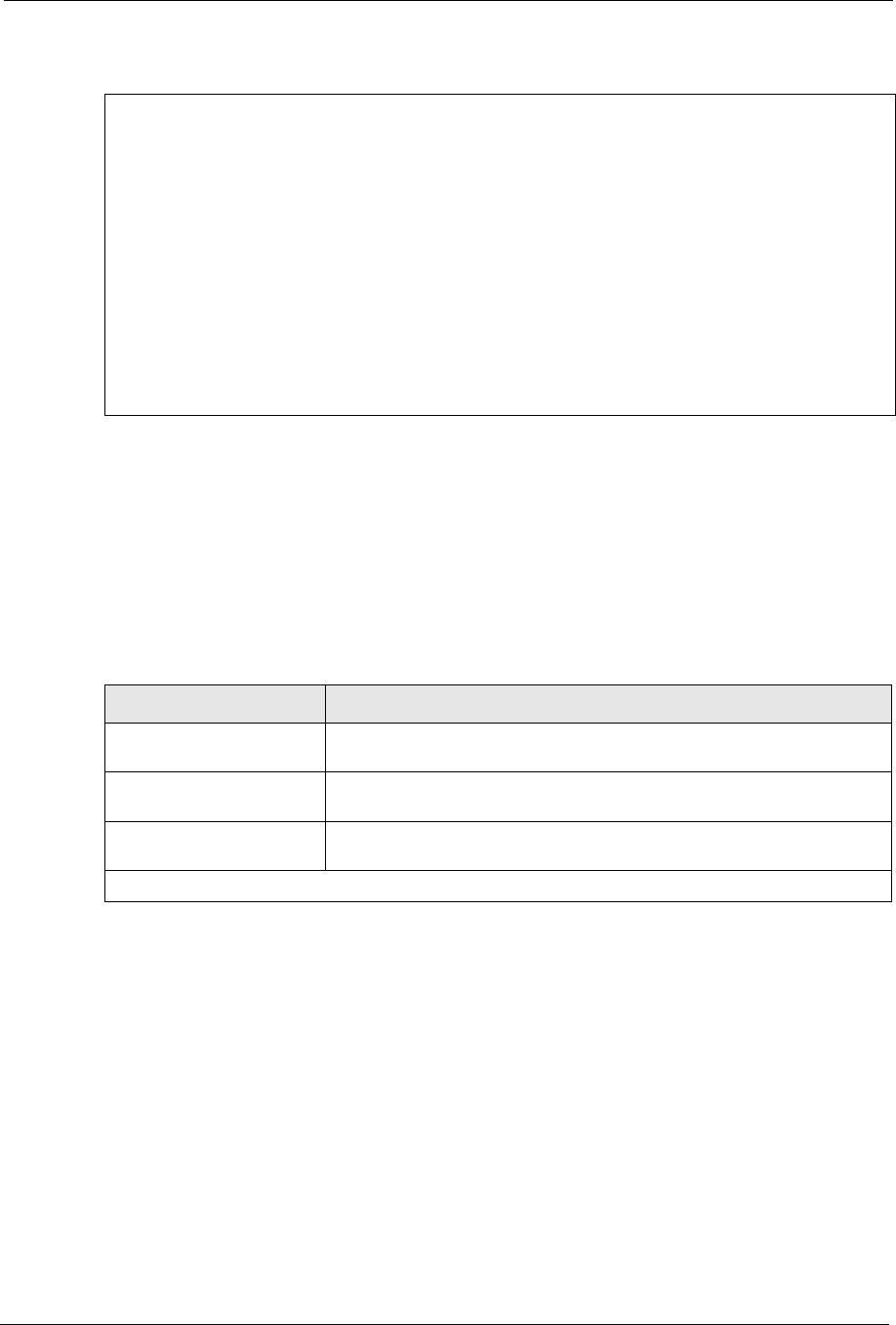
P-660H/HW/W-T Series User’ Guide
Chapter 34 System Maintenance 320
Figure 207 Menu 24.9.1 System Maintenance: Budget Management
The total budget is the time limit on the accumulated time for outgoing calls to a remote node.
When this limit is reached, the call will be dropped and further outgoing calls to that remote
node will be blocked. After each period, the total budget is reset. The default for the total
budget is 0 minutes and the period is 0 hours, meaning no budget control. You can reset the
accumulated connection time in this menu by entering the index of a remote node. Enter 0 to
update the screen. The budget and the reset period can be configured in menu 11.1 for the
remote node when PPPoE encapsulation is selected.
34.3 Time and Date Setting
The Prestige keeps track of the time and date. There is also a software mechanism to set the
time manually or get the current time and date from an external server when you turn on your
Prestige. Menu 24.10 allows you to update the time and date settings of your Prestige. The real
time is then displayed in the Prestige error logs and firewall logs.
Select menu 24 in the main menu to open Menu 24 System Maintenance, as shown next.
Menu 24.9.1 - System Maintenance - Budget Management
Remote Node
1.MyIsp
2.--------
3.--------
4.--------
5.--------
6.--------
7.--------
8.--------
Connection Time/Total Budget
No Budget
---
---
---
---
---
---
---
Elapsed Time/Total Period
No Budget
---
---
---
---
---
---
---
Reset Node (0 to update screen):
Table 112 Menu 24.9.1 System Maintenance: Budget Management
FIELD DESCRIPTION
Remote Node Enter the index number of the remote node you want to reset (just one in
this case)
Connection Time/Total
Budget
This is the total connection time that has gone by (within the allocated
budget that you set in menu 11.1.
Elapsed Time/Total Period The period is the time cycle in hours that the allocation budget is reset
(see menu 11.1.) The elapsed time is the time used up within this period.
Enter “0” to update the screen or press [ESC] to return to the previous screen.

P-660H/HW/W-T Series User’ Guide
321 Chapter 34 System Maintenance
Figure 208 Menu 24 System Maintenance
Then enter 10 to go to Menu 24.10 System Maintenance Time and Date Setting to update
the time and date settings of your Prestige as shown in the following screen.
Figure 209 Menu 24.10 System Maintenance: Time and Date Setting
Menu 24 - System Maintenance
1. System Status
2. System Information and Console Port Speed
3. Log and Trace
4. Diagnostic
5. Backup Configuration
6. Restore Configuration
7. Upload Firmware
8. Command Interpreter Mode
9. Call Control
10. Time and Date Setting
11. Remote Management
Enter Menu Selection Number:
Menu 24.10 - System Maintenance - Time and Date Setting
Use Time Server when Bootup= None
Time Server Address= N/A
Current Time: 00 : 51 : 24
New Time (hh:mm:ss): 00 : 51 : 19
Current Date: 2000 - 01 - 01
New Date (yyyy-mm-dd): 2000 - 01 - 01
Time Zone= GMT
Daylight Saving= No
Start Date (mm-dd): 01 - 00
End Date (mm-dd): 01 - 00
Press ENTER to Confirm or ESC to Cancel:
Table 113 Menu 24.10 System Maintenance: Time and Date Setting
FIELD DESCRIPTION
Use Time Server
when Bootup
Enter the time service protocol that your time server sends when you turn on
the Prestige. Not all time servers support all protocols, so you may have to
check with your ISP/network administrator or use trial and error to find a
protocol that works. The main differences between them are the format.
Daytime (RFC 867) format is day/month/year/time zone of the server.
Time (RFC-868) format displays a 4-byte integer giving the total number of
seconds since 1970/1/1 at 0:0:0.
NTP (RFC-1305) is similar to Time (RFC-868).
None. The default, enter the time manually.
Time Server Address Enter the IP address or domain name of your time server. Check with your ISP/
network administrator if you are unsure of this information.

P-660H/HW/W-T Series User’ Guide
Chapter 34 System Maintenance 322
34.3.1 Resetting the Time
• The Prestige resets the time in three instances:
• On leaving menu 24.10 after making changes.
• When the Prestige starts up, if there is a timeserver configured in menu 24.10.
• 24-hour intervals after starting.
Current Time This field displays an updated time only when you reenter this menu.
New Time Enter the new time in hour, minute and second format.
Current Date This field displays an updated date only when you re-enter this menu.
New Date Enter the new date in year, month and day format.
Time Zone Press [SPACE BAR] and then [ENTER] to set the time difference between your
time zone and Greenwich Mean Time (GMT).
Daylight Saving If you use daylight savings time, then choose Yes.
Start Date If using daylight savings time, enter the month and day that it starts on.
End Date If using daylight savings time, enter the month and day that it ends on
When you have completed this menu, press [ENTER] at the prompt “Press ENTER to Confirm
or ESC to Cancel:” to save your configuration, or press [ESC] at any time to cancel.
Table 113 Menu 24.10 System Maintenance: Time and Date Setting (continued)
FIELD DESCRIPTION

P-660H/HW/W-T Series User’ Guide
323 Chapter 34 System Maintenance

P-660H/HW/W-T Series User’ Guide
Chapter 35 Remote Management 324
CHAPTER 35
Remote Management
This chapter covers remote management (SMT menu 24.11).
35.1 Remote Management Overview
Remote management allows you to determine which services/protocols can access which
Prestige interface (if any) from which computers.
When you configure remote management to allow management from the WAN, you still need
to configure a firewall rule to allow access. See the firewall chapters for details on configuring
firewall rules.
35.2 Remote Management
To disable remote management of a service, select Disable in the corresponding Server
Access field.
Enter 11 from menu 24 to display Menu 24.11 — Remote Management Control.
35.2.1 Remote Management Setup
You may manage your Prestige from a remote location via:
the Internet (WAN only), the LAN only,All (LAN and WAN) or Disable (neither).
• WAN only (Internet)
• ALL (LAN and WAN)
• LAN only
• Disable (Neither)
If you enable remote management of a service, but have applied a filter to block the service,
then you will not be able to remotely manage the Prestige using the service.
Enter 11, from menu 24, to display Menu 24.11 — Remote Management Control (shown
next).

P-660H/HW/W-T Series User’ Guide
325 Chapter 35 Remote Management
Figure 210 Menu 24.11 Remote Management Control
The following table describes the fields in this menu.
35.2.2 Remote Management Limitations
Remote management over LAN or WAN will not work when:
• A filter in menu 3.1 (LAN) or in menu 11.5 (WAN) is applied to block a Telnet, FTP or
Web service.
• You have disabled that service in menu 24.11.
• The IP address in the Secured Client IP field (menu 24.11) does not match the client IP
address. If it does not match, the Prestige will disconnect the session immediately.
• There is already another remote management session with an equal or higher priority
running. You may only have one remote management session running at one time.
• There is a firewall rule that blocks it.
Menu 24.11 - Remote Management Control
TELNET Server:
Server Port = 23 Server Access = LAN only
Secured Client IP = 0.0.0.0
FTP Server:
Server Port = 21 Server Access = LAN only
Secured Client IP = 0.0.0.0
Web Server:
Server Port = 80 Server Access = LAN only
Secured Client IP = 0.0.0.0
Press ENTER to Confirm or ESC to Cancel:
Table 114 Menu 24.11 Remote Management Control
FIELD DESCRIPTION
Telnet Server
FTP Server
Web Server
Each of these read-only labels denotes a service or protocol.
Port This field shows the port number for the service or protocol. You may change the
port number if needed, but you must use the same port number to access the
Prestige.
Access Select the access interface (if any) by pressing the [SPACE BAR]. Choices are:
LAN only,WAN only,All or Disable. The default is LAN only.
Secured Client IP The default 0.0.0.0 allows any client to use this service or protocol to access the
Prestige. Enter an IP address to restrict access to a client with a matching IP
address.
When you have completed this menu, press [ENTER] at the prompt “Press ENTER to Confirm
or ESC to Cancel:” to save your configuration, or press [ESC] at any time to cancel.

P-660H/HW/W-T Series User’ Guide
Chapter 35 Remote Management 326
35.3 Remote Management and NAT
When NAT is enabled:
• Use the Prestige’s WAN IP address when configuring from the WAN.
• Use the Prestige’s LAN IP address when configuring from the LAN.
35.4 System Timeout
There is a default system management idle timeout of five minutes (three hundred seconds).
The Prestige automatically logs you out if the management session remains idle for longer
than this timeout period. The management session does not time out when it is continuously
updating the status in menu 24.1 or when sys stdio has been changed on the command
line.

P-660H/HW/W-T Series User’ Guide
327 Chapter 35 Remote Management

P-660H/HW/W-T Series User’ Guide
Chapter 36 IP Policy Routing 328
CHAPTER 36
IP Policy Routing
This chapter covers setting and applying policies used for IP routing.
36.1 IP Policy Routing Overview
Traditionally, routing is based on the destination address only and the IAD takes the shortest
path to forward a packet. IP Routing Policy (IPPR) provides a mechanism to override the
default routing behavior and alter the packet forwarding based on the policy defined by the
network administrator. Policy-based routing is applied to incoming packets on a per interface
basis, prior to the normal routing.
36.2 Benefits of IP Policy Routing
Source-Based Routing – Network administrators can use policy-based routing to direct traffic
from different users through different connections.
Quality of Service (QoS) – Organizations can differentiate traffic by setting the precedence or
TOS (Type of Service) values in the IP header at the periphery of the network to enable the
backbone to prioritize traffic.
Cost Savings – IPPR allows organizations to distribute interactive traffic on high-bandwidth,
high-cost paths while using low-cost paths for batch traffic.
Load Sharing – Network administrators can use IPPR to distribute traffic among multiple
paths.
36.3 Routing Policy
Individual routing policies are used as part of the overall IPPR process. A policy defines the
matching criteria and the action to take when a packet meets the criteria. The action is taken
only when all the criteria are met. The criteria includes the source address and port, IP protocol
(ICMP, UDP, TCP, etc.), destination address and port, TOS and precedence (fields in the IP
header) and length. The inclusion of length criterion is to differentiate between interactive and
bulk traffic. Interactive applications, for example, telnet, tend to have short packets, while bulk
traffic, for example, file transfer, tends to have large packets.
The actions that can be taken include:

P-660H/HW/W-T Series User’ Guide
329 Chapter 36 IP Policy Routing
• routing the packet to a different gateway (and hence the outgoing interface).
• setting the TOS and precedence fields in the IP header.
IPPR follows the existing packet filtering facility of RAS in style and in implementation. The
policies are divided into sets, where related policies are grouped together. A user defines the
policies before applying them to an interface or a remote node, in the same fashion as the
filters. There are 12 policy sets with six policies in each set.
36.4 IP Routing Policy Setup
Menu 25 shows all the policies defined.
Figure 211 Menu 25 IP Routing Policy Setup
To setup a routing policy, perform the following procedures:
1Type 25 in the main menu to open Menu 25 – IP Routing Policy Setup.
2Type the index of the policy set you want to configure to open Menu 25.1 – IP Routing
Policy Setup.
Menu 25.1 shows the summary of a policy set, including the criteria and the action of a single
policy, and whether a policy is active or not. Each policy contains two lines. The former part is
the criteria of the incoming packet and the latter is the action. Between these two parts,
separator “|” means the action is taken on criteria matched and separator “=” means the action
is taken on criteria not matched.
Menu 25 - IP Routing Policy Setup
Policy
Set # Name Set # Name
------ ----------------- ------ -----------------
1 _______________ 7 _______________
2 _______________ 8 _______________
3 _______________ 9 _______________
4 _______________ 10 _______________
5 _______________ 11 _______________
6 _______________ 12 _______________
Enter Policy Set Number to Configure= 0
Edit Name= N/A
Press ENTER to Confirm or ESC to Cancel:

P-660H/HW/W-T Series User’ Guide
Chapter 36 IP Policy Routing 330
Figure 212 Menu 25.1 IP Routing Policy Setup
Type a number from 1 to 6 to display Menu 25.1.1 – IP Routing Policy (see the next figure).
This menu allows you to configure a policy rule.
Menu 25.1 - IP Routing Policy Setup
# A Criteria/Action
- - ----------------------------------------------------------------------
1 Y SA=1.1.1.1-1.1.1.1,DA=2.2.2.2-2.2.2.5
SP=20-25,DP=20-25,P=6,T=NM,PR=0 |GW=192.168.1.1,T=MT,PR=0
2 N ______________________________________________________________________
______________________________________________________________________
3 N ______________________________________________________________________
______________________________________________________________________
4 N ______________________________________________________________________
______________________________________________________________________
5 N ______________________________________________________________________
______________________________________________________________________
6 N ______________________________________________________________________
______________________________________________________________________
Enter Policy Rule Number (1-6) to Configure:
Table 115 Menu 25.1 IP Routing Policy Setup
ABBREVIATION MEANING
Criterion SA Source IP Address
SP Source Port
DA Destination IP Address
DP Destination Port
P IP layer 4 protocol number (TCP=6, UDP=17…)
T Type of service of incoming packet
PR Precedence of incoming packet
Action GW Gateway IP address
T Outgoing Type of service
P Outgoing Precedence
Service NM Normal
MD Minimum Delay
MT Maximum Throughput
MR Maximum Reliability
MC Minimum Cost

P-660H/HW/W-T Series User’ Guide
331 Chapter 36 IP Policy Routing
Figure 213 Menu 25.1.1 IP Routing Policy
The following table describes the fields in this menu.
Menu 25.1.1 - IP Routing Policy
Policy Set Name= test
Active= No
Criteria:
IP Protocol = 0
Type of Service= Don't Care Packet length= 0
Precedence = Don't Care Len Comp= N/A
Source:
addr start= 0.0.0.0 end= N/A
port start= N/A end= N/A
Destination:
addr start= 0.0.0.0 end= N/A
port start= N/A end= N/A
Action= Matched
Gateway addr = 0.0.0.0 Log= No
Type of Service= No Change
Precedence = No Change
Press ENTER to Confirm or ESC to Cancel:
Table 116 Menu 25.1.1 IP Routing Policy
FIELD DESCRIPTION
Policy Set Name This is the policy set name assigned in Menu 25 – IP Routing Policy Setup.
Active Press [SPACE BAR] and then [ENTER] to select Yes to activate or No to
deactivate the policy. Inactive policies are displayed with a minus sign “-“ in SMT
menu 25.
Criteria
IP Protocol IP layer 4 protocol, for example, UDP,TCP,ICMP, etc.
Type of Service Prioritize incoming network traffic by choosing from Don’t Care,Normal,Min
Delay,Max Thruput, Min Cost or Max Reliable.
Precedence Precedence value of the incoming packet. Press [SPACE BAR] and then
[ENTER] to select a value from 0 to 7 or Don’t Care.
Packet Length Type the length of incoming packets (in bytes). The operators in the Len Comp
(next field) apply to packets of this length.
Len Comp Press [SPACE BAR] and then [ENTER] to choose from Equal,Not Equal,
Less,Greater,Less or Equal or Greater or Equal.
Source:
addr start / end Source IP address range from start to end.
port start / end Source port number range from start to end; applicable only for TCP/UDP.
Destination:
addr start / end Destination IP address range from start to end.
port start / end Destination port number range from start to end; applicable only for TCP/UDP.
Action Specifies whether action should be taken on criteria Matched or Not Matched.

P-660H/HW/W-T Series User’ Guide
Chapter 36 IP Policy Routing 332
36.5 Applying an IP Policy
This section shows you where to apply the IP policies after you design them.
36.5.1 Ethernet IP Policies
From Menu 3 — Ethernet Setup, type 2 to go to Menu 3.2 — TCP/IP and DHCP Ethernet
Setup.
You can choose up to four IP policy sets (from 12) by typing their numbers separated by
commas, for example, 2, 4, 7, 9.
Gateway addr Defines the outgoing gateway address. The gateway must be on the same
subnet as the Prestige if it is on the LAN, otherwise, the gateway must be the IP
address of a remote node. The default gateway is specified as 0.0.0.0.
Type of Service Set the new TOS value of the outgoing packet. Prioritize incoming network traffic
by choosing No Change,Normal,Min Delay,Max Thruput, Max Reliable or
Min Cost.
Precedence Set the new outgoing packet precedence value. Values are 0 to 7 or No
Change.
Log Press [SPACE BAR] and then [ENTER] to select Yes to make an entry in the
system log when a policy is executed.
When you have completed this menu, press [ENTER] at the prompt “Press ENTER to Confirm
or ESC to Cancel:” to save your configuration, or press [ESC] at any time to cancel.
Table 116 Menu 25.1.1 IP Routing Policy (continued)
FIELD DESCRIPTION

P-660H/HW/W-T Series User’ Guide
333 Chapter 36 IP Policy Routing
Figure 214 Menu 3.2 TCP/IP and DHCP Ethernet Setup
Go to menu 11.3 (shown next) and type the number(s) of the IP Routing Policy set(s) as
appropriate. You can cascade up to four policy sets by typing their numbers separated by
commas.
Figure 215 Menu 11.3 Remote Node Network Layer Options
36.6 IP Policy Routing Example
If a network has both Internet and remote node connections, you can route Web packets to the
Internet using one policy and route FTP packets to a remote network using another policy. See
the next figure.
Menu 3.2 - TCP/IP and DHCP Setup
DHCP Setup
DHCP= Server
Client IP Pool Starting Address= 192.168.1.33
Size of Client IP Pool= 32
Primary DNS Server= 0.0.0.0
Secondary DNS Server= 0.0.0.0
Remote DHCP Server= N/A
TCP/IP Setup:
IP Address= 192.168.1.1
IP Subnet Mask= 255.255.255.0
RIP Direction= Both
Version= RIP-1
Multicast= None
IP Policies=
Edit IP Alias= No
Press ENTER to Confirm or ESC to Cancel:
Menu 11.3 - Remote Node Network Layer Options
IP Options: Bridge Options:
IP Address Assignment= Static Ethernet Addr Timeout (min)= 0
Rem IP Addr: 0.0.0.0
Rem Subnet Mask= 0.0.0.0
My WAN Addr= 0.0.0.0
NAT= Full Feature
Address Mapping Set= 2
Metric= 2
Private= No
RIP Direction= Both
Version= RIP-2B
Multicast= IGMP-v2
IP Policies=
Press ENTER to Confirm or ESC to Cancel:
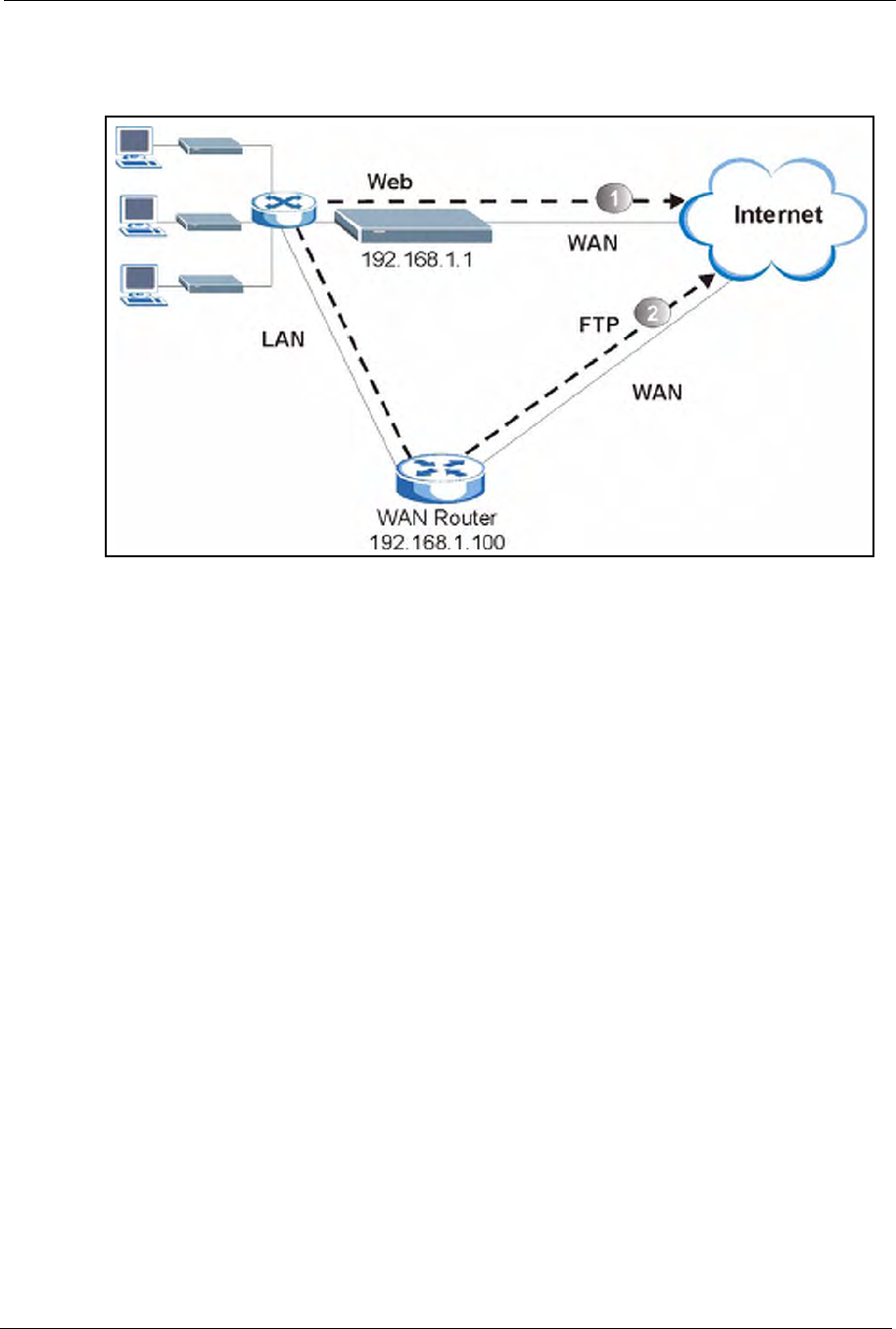
P-660H/HW/W-T Series User’ Guide
Chapter 36 IP Policy Routing 334
Route 1 represents the default IP route and route 2 represents the configured IP route.
Figure 216 Example of IP Policy Routing
To force packets coming from clients with IP addresses of 192.168.1.33 to 192.168.1.64 to be
routed to the Internet via the WAN port of the Prestige, follow the steps as shown next.
1Create a routing policy set in menu 25.
2Create a rule for this set in Menu 25.1.1 — IP Routing Policy as shown next.

P-660H/HW/W-T Series User’ Guide
335 Chapter 36 IP Policy Routing
Figure 217 IP Routing Policy Example
1Check Menu 25.1 — IP Routing Policy Setup to see if the rule is added correctly.
2Create another policy set in menu 25.
3Create a rule in menu 25.1 for this set to route packets from any host (IP=0.0.0.0
means any host) with protocol TCP and port FTP access through another gateway
(192.168.1.100).
Menu 25.1.1 - IP Routing Policy
Policy Set Name= set1
Active= Yes
Criteria:
IP Protocol = 6
Type of Service= Don't Care
Precedence = Don't Care
Source:
addr start= 192.168.1.2
port start= 0
Destination:
addr start= 0.0.0.0
port start= 80
Action= Matched
Gateway addr = 192.168.1.1
Type of Service= No Change
Precedence = No Change
Packet length= 10
Len Comp= N/A
end= 192.168.1.64
end= N/A
end= N/A
end= 80
Log= No
Press ENTER to Confirm or ESC to Cancel:

P-660H/HW/W-T Series User’ Guide
Chapter 36 IP Policy Routing 336
Figure 218 IP Routing Policy Example
4Check Menu 25.1 — IP Routing Policy Setup to see if the rule is added correctly.
5Apply both policy sets in menu 3.2 as shown next.
Figure 219 Applying IP Policies Example
Menu 25.1.1 - IP Routing Policy
Policy Set Name= set2
Active= Yes
Criteria:
IP Protocol = 6
Type of Service= Don't Care
Precedence = Don't Care
Source:
addr start= 0.0.0.0
port start= 0
Destination:
addr start= 0.0.0.0
port start= 20
Action= Matched
Gateway addr =192.168.1.100
Type of Service= No Change
Precedence = No Change
Packet length= 10
Len Comp= N/A
end= N/A
end= N/A
end= N/A
end= 21
Log= No
Press ENTER to Confirm or ESC to Cancel:
Menu 3.2 - TCP/IP and DHCP Ethernet Setup
DHCP Setup
DHCP= Server
Client IP Pool Starting Address= 192.168.1.33
Size of Client IP Pool= 64
Primary DNS Server= 0.0.0.0
Secondary DNS Server= 0.0.0.0
Remote DHCP Server= N/A
TCP/IP Setup:
IP Address= 192.168.1.1
IP Subnet Mask= 255.255.255.0
RIP Direction= Both
Version= RIP-1
Multicast= None
IP Policies= 1,2
Edit IP Alias= No
Press ENTER to Confirm or ESC to Cancel:

P-660H/HW/W-T Series User’ Guide
337 Chapter 36 IP Policy Routing

P-660H/HW/W-T Series User’ Guide
Chapter 37 Call Scheduling 338
CHAPTER 37
Call Scheduling
Call scheduling (applicable for PPPoA or PPPoE encapsulation only) allows you to dictate
when a remote node should be called and for how long.
37.1 Introduction
The call scheduling feature allows the Prestige to manage a remote node and dictate when a
remote node should be called and for how long. This feature is similar to the scheduler in a
videocassette recorder (you can specify a time period for the VCR to record). You can apply
up to 4 schedule sets in Menu 11.1 — Remote Node Profile. From the main menu, enter 26
to access Menu 26 — Schedule Setup as shown next.
Figure 220 Menu 26 Schedule Setup
Lower numbered sets take precedence over higher numbered sets thereby avoiding scheduling
conflicts. For example, if sets 1, 2 ,3 and 4 in are applied in the remote node then set 1 will
take precedence over set 2, 3 and 4 as the Prestige, by default, applies the lowest numbered set
first. Set 2 will take precedence over set 3 and 4, and so on.
You can design up to 12 schedule sets but you can only apply up to four schedule sets for a
remote node.
To delete a schedule set, enter the set number and press [SPACE BAR] and then [ENTER]
(or delete) in the Edit Name field.
Menu 26 - Schedule Setup
Schedule
Set # Name Set # Name
------ ----------------- ------ -----------------
1 _______________ 7 _______________
2 _______________ 8 _______________
3 _______________ 9 _______________
4 _______________ 10 _______________
5 _______________ 11 _______________
6 _______________ 12 _______________
Enter Schedule Set Number to Configure= 0
Edit Name= N/A
Press ENTER to Confirm or ESC to Cancel:

P-660H/HW/W-T Series User’ Guide
339 Chapter 37 Call Scheduling
To setup a schedule set, select the schedule set you want to setup from menu 26 (1-12) and
press [ENTER] to see Menu 26.1 — Schedule Set Setup as shown next.
Figure 221 Menu 26.1 Schedule Set Setup
If a connection has been already established, your Prestige will not drop it. Once the
connection is dropped manually or it times out, then that remote node can't be triggered up
until the end of the Duration.
Menu 26.1 Schedule Set Setup
Active= Yes
Start Date(yyyy-mm-dd)= 2000 - 01 - 01
How Often= Once
Once:
Date(yyyy-mm-dd)= 2000 - 01 - 01
Weekdays:
Sunday= N/A
Monday= N/A
Tuesday= N/A
Wednesday= N/A
Thursday= N/A
Friday= N/A
Saturday= N/A
Start Time(hh:mm)= 00: 00
Duration(hh:mm)= 00: 00
Action= Forced On
Press ENTER to Confirm or ESC to Cancel:
Table 117 Menu 26.1 Schedule Set Setup
FIELD DESCRIPTION
Active Press [SPACE BAR] to select Yes or No. Choose Yes and press [ENTER] to activate
the schedule set.
Start Date Enter the start date when you wish the set to take effect in year -month-date format.
Valid dates are from the present to 2036-February-5.
How Often Should this schedule set recur weekly or be used just once only? Press the [SPACE
BAR] and then [ENTER] to select Once or Weekly. Both these options are mutually
exclusive. If Once is selected, then all weekday settings are N/A. When Once is
selected, the schedule rule deletes automatically after the scheduled time elapses.
Once:
Date
If you selected Once in the How Often field above, then enter the date the set should
activate here in year-month-date format.
Weekday:
Day
If you selected Weekly in the How Often field above, then select the day(s) when the
set should activate (and recur) by going to that day(s) and pressing [SPACE BAR] to
select Yes, then press [ENTER].
Start Time Enter the start time when you wish the schedule set to take effect in hour-minute format.
Duration Enter the maximum length of time this connection is allowed in hour-minute format.

P-660H/HW/W-T Series User’ Guide
Chapter 37 Call Scheduling 340
Once your schedule sets are configured, you must then apply them to the desired remote
node(s). Enter 11 from the Main Menu and then enter the target remote node index. Using
[SPACE BAR], select PPPoE or PPPoA in the Encapsulation field and then press
[ENTER] to make the schedule sets field available as shown next.
Figure 222 Applying Schedule Set(s) to a Remote Node (PPPoE)
You can apply up to four schedule sets, separated by commas, for one remote node. Change
the schedule set numbers to your preference(s).
Action Forced On means that the connection is maintained whether or not there is a demand
call on the line and will persist for the time period specified in the Duration field.
Forced Down means that the connection is blocked whether or not there is a demand
call on the line.
Enable Dial-On-Demand means that this schedule permits a demand call on the line.
Disable Dial-On-Demand means that this schedule prevents a demand call on the line.
When you have completed this menu, press [ENTER] at the prompt “Press ENTER to Confirm
or ESC to Cancel:” to save your configuration, or press [ESC] at any time to cancel.
Menu 11.1 - Remote Node Profile
Rem Node Name= MyISP Route= IP
Active= Yes Bridge= No
Encapsulation= PPPoA Edit IP/Bridge= No
Multiplexing= LLC-based Edit ATM Options= No
Service Name= N/A Edit Advance Options= N/A
Incoming: Telco Option:
Rem Login= Allocated Budget(min)= 0
Rem Password= ******** Period(hr)= 0
Outgoing: Schedule Sets=
My Login= ChangeMe Nailed-Up Connection= No
My Password= ******** Session Options:
Authen= CHAP/PAP Edit Filter Sets= No
Idle Timeout(sec)= 0
Press ENTER to Confirm or ESC to Cancel:
Table 117 Menu 26.1 Schedule Set Setup (continued)
FIELD DESCRIPTION

P-660H/HW/W-T Series User’ Guide
341 Chapter 37 Call Scheduling
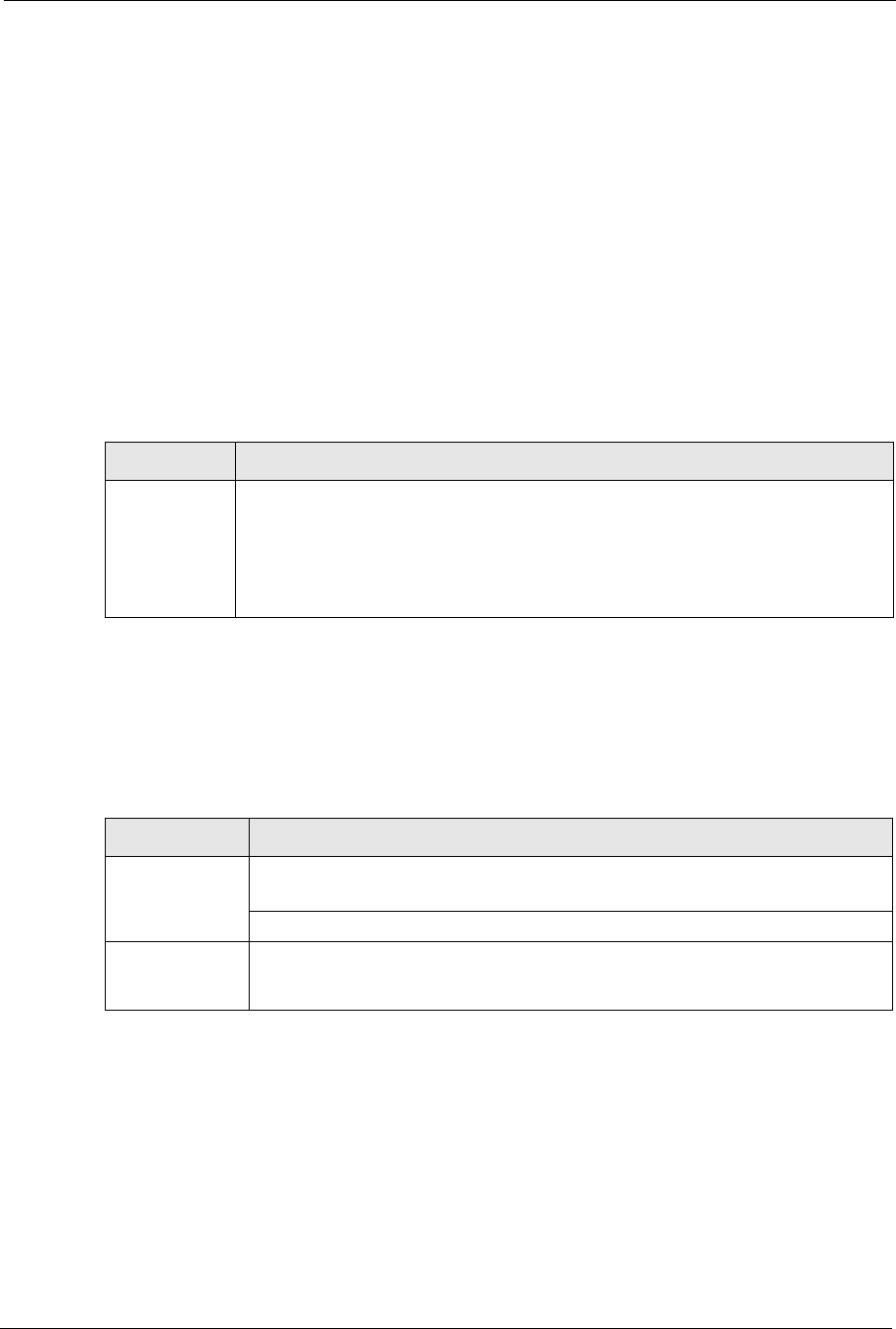
P-660H/HW/W-T Series User’ Guide
Chapter 38 Troubleshooting 342
CHAPTER 38
Troubleshooting
This chapter covers potential problems and the corresponding remedies.
38.1 Problems Starting Up the Prestige
38.2 Problems with the LAN
Table 118 Troubleshooting Starting Up Your Prestige
PROBLEM CORRECTIVE ACTION
None of the
LEDs turn on
when I turn on
the Prestige.
Make sure that the Prestige’s power adaptor is connected to the Prestige and plugged
in to an appropriate power source. Make sure that the Prestige and the power source
are both turned on.
Turn the Prestige off and on.
If the error persists, you may have a hardware problem. In this case, you should
contact your vendor.
Table 119 Troubleshooting the LAN
PROBLEM CORRECTIVE ACTION
The LAN LEDs
do not turn on.
Check your Ethernet cable connections (refer to the Quick Start Guide for details).
Check for faulty Ethernet cables.
Make sure your computer’s Ethernet Card is working properly.
I cannot access
the Prestige from
the LAN.
If Any IP is disabled, make sure that the IP address and the subnet mask of the
Prestige and your computer(s) are on the same subnet.

P-660H/HW/W-T Series User’ Guide
343 Chapter 38 Troubleshooting
38.3 Problems with the WAN
Table 120 Troubleshooting the WAN
PROBLEM CORRECTIVE ACTION
The DSL LED is
off.
Check the telephone wire and connections between the Prestige DSL port and the
wall jack.
Make sure that the telephone company has checked your phone line and set it up
for DSL service.
Reset your ADSL line to reinitialize your link to the DSLAM. For details, refer to the
Table 68 on page 204 (web configurator) or Table 108 on page 304 (SMT).
I cannot get a
WAN IP address
from the ISP.
The ISP provides the WAN IP address after authenticating you. Authentication
may be through the user name and password, the MAC address or the host name.
The username and password apply to PPPoE and PPPoA encapsulation only.
Make sure that you have entered the correct Service Type,User Name and
Password (be sure to use the correct casing). Refer to the WAN Setup chapter
(web configurator or SMT).
I cannot access
the Internet.
Make sure the Prestige is turned on and connected to the network.
Verify your WAN settings. Refer to the chapter on WAN setup (web configurator)
or the section on Internet Access (SMT).
Make sure you entered the correct user name and password.
If you use PPPoE pass through, make sure that bridge mode is turned on.
The Internet
connection
disconnects.
Check the schedule rules. Refer to Chapter 37 on page 338 (SMT).
If you use PPPoA or PPPoE encapsulation, check the idle time-out setting. Refer
to the Chapter 6 on page 90 (web configurator) or Chapter 24 on page 236 (SMT).
Contact your ISP.

P-660H/HW/W-T Series User’ Guide
Chapter 38 Troubleshooting 344
38.4 Problems Accessing the Prestige
38.4.1 Pop-up Windows, JavaScripts and Java Permissions
In order to use the web configurator you need to allow:
• Web browser pop-up windows from your device.
• JavaScripts (enabled by default).
• Java permissions (enabled by default).
Note: Internet Explorer 6 screens are used here. Screens for other Internet Explorer
versions may vary.
38.4.1.1 Internet Explorer Pop-up Blockers
You may have to disable pop-up blocking to log into your device.
Either disable pop-up blocking (enabled by default in Windows XP SP (Service Pack) 2) or
allow pop-up blocking and create an exception for your device’s IP address.
38.4.1.1.1 Disable pop-up Blockers
1In Internet Explorer, select Tools,Pop-up Blocker and then select Turn Off Pop-up
Blocker.
Table 121 Troubleshooting Accessing the Prestige
PROBLEM CORRECTIVE ACTION
I cannot
access the
Prestige.
The username is “admin”. The default password is “1234”. The Password and
Username fields are case-sensitive. Make sure that you enter the correct password
and username using the proper casing.
If you have changed the password and have now forgotten it, you will need to upload
the default configuration file. This restores all of the factory defaults including the
password.
I cannot
access the
web
configurator.
Make sure that there is not an SMT console session running.
Use the Prestige’s WAN IP address when configuring from the WAN. Refer to the
instructions on checking your WAN connection.
Use the Prestige’s LAN IP address when configuring from the LAN. Refer to for
instructions on checking your LAN connection.
Check that you have enabled web service access. If you have configured a secured
client IP address, your computer’s IP address must match it. Refer to the chapter on
remote management for details.
Your computer’s and the Prestige’s IP addresses must be on the same subnet for LAN
access.
If you changed the Prestige’s LAN IP address, then enter the new one as the URL.
Remove any filters in SMT menu 3.1 (LAN) or menu 11.5 (WAN) that block web
service.
See the following section to check that pop-up windows, JavaScripts and Java
permissions are allowed.
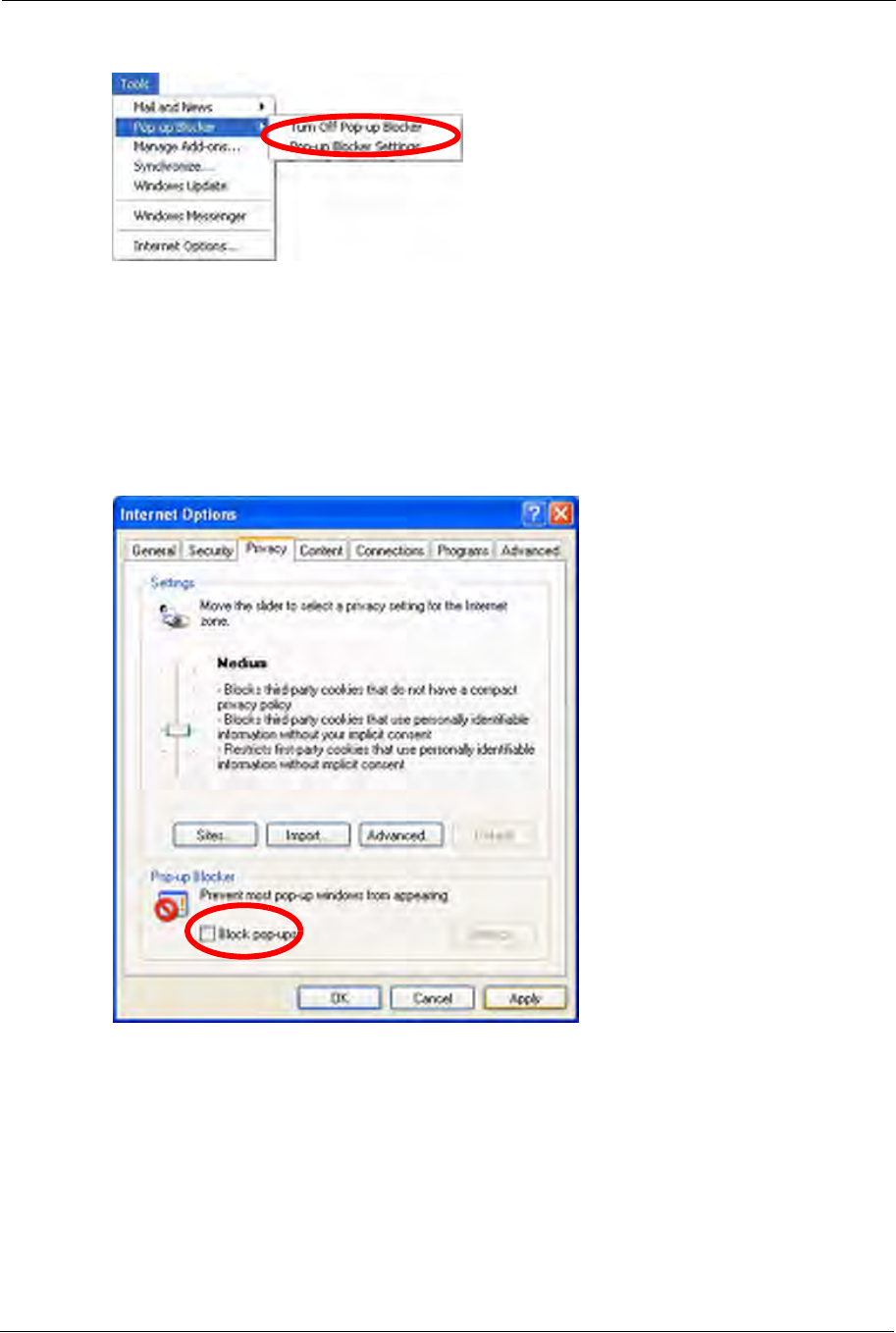
P-660H/HW/W-T Series User’ Guide
345 Chapter 38 Troubleshooting
Figure 223 Pop-up Blocker
You can also check if pop-up blocking is disabled in the Pop-up Blocker section in the
Privacy tab.
1In Internet Explorer, select Tools,Internet Options,Privacy.
2Clear the Block pop-ups check box in the Pop-up Blocker section of the screen. This
disables any web pop-up blockers you may have enabled.
Figure 224 Internet Options
3Click Apply to save this setting.
38.4.1.1.2 Enable pop-up Blockers with Exceptions
Alternatively, if you only want to allow pop-up windows from your device, see the following
steps.
1In Internet Explorer, select Tools,Internet Options and then the Privacy tab.
2Select Settings…to open the Pop-up Blocker Settings screen.
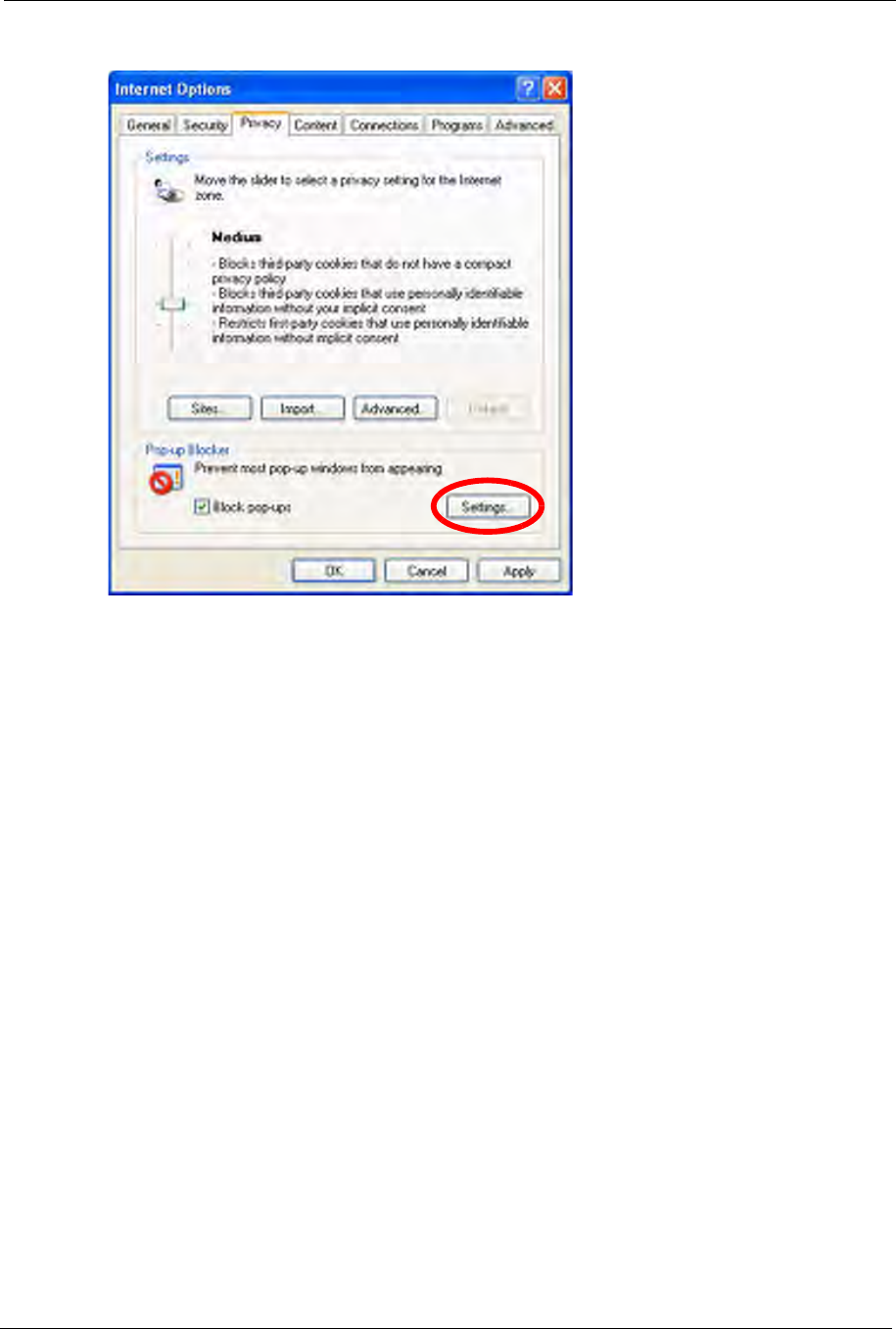
P-660H/HW/W-T Series User’ Guide
Chapter 38 Troubleshooting 346
Figure 225 Internet Options
3Type the IP address of your device (the web page that you do not want to have blocked)
with the prefix “http://”. For example, http://192.168.1.1.
4Click Add to move the IP address to the list of Allowed sites.
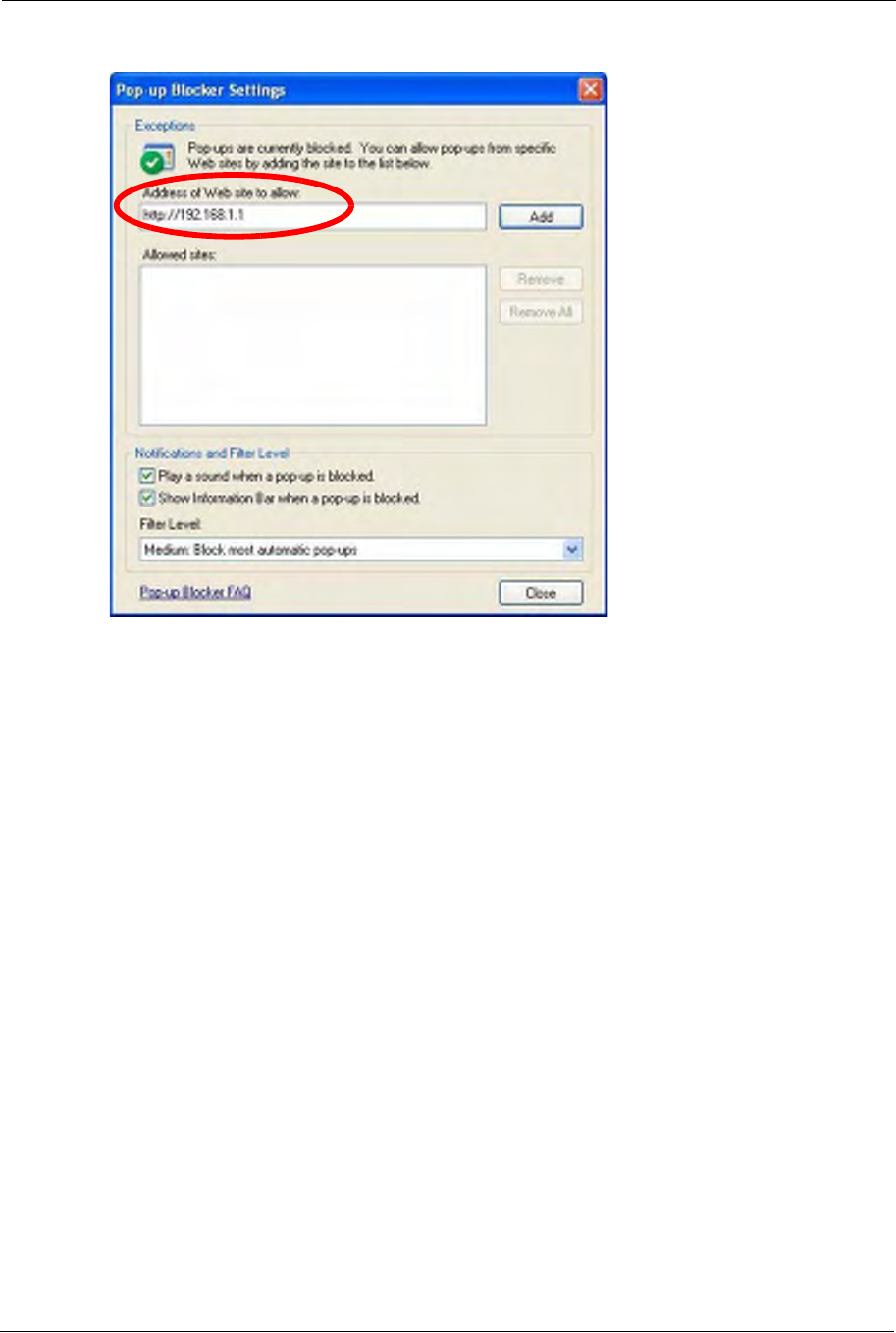
P-660H/HW/W-T Series User’ Guide
347 Chapter 38 Troubleshooting
Figure 226 Pop-up Blocker Settings
5Click Close to return to the Privacy screen.
6Click Apply to save this setting.
38.4.1.2 JavaScripts
If pages of the web configurator do not display properly in Internet Explorer, check that
JavaScripts are allowed.
1In Internet Explorer, click Tools,Internet Options and then the Security tab.
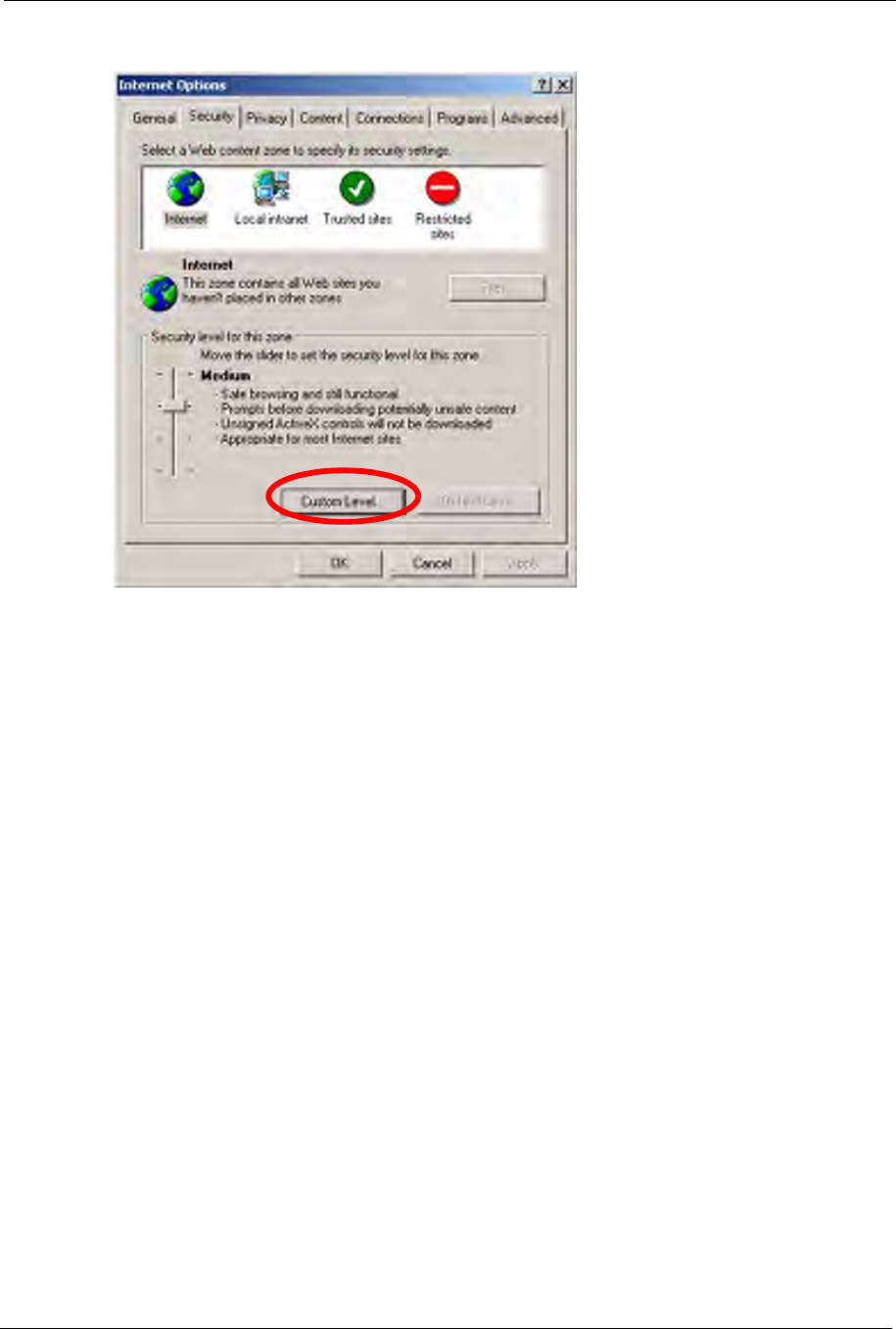
P-660H/HW/W-T Series User’ Guide
Chapter 38 Troubleshooting 348
Figure 227 Internet Options
2Click the Custom Level... button.
3Scroll down to Scripting.
4Under Active scripting make sure that Enable is selected (the default).
5Under Scripting of Java applets make sure that Enable is selected (the default).
6Click OK to close the window.
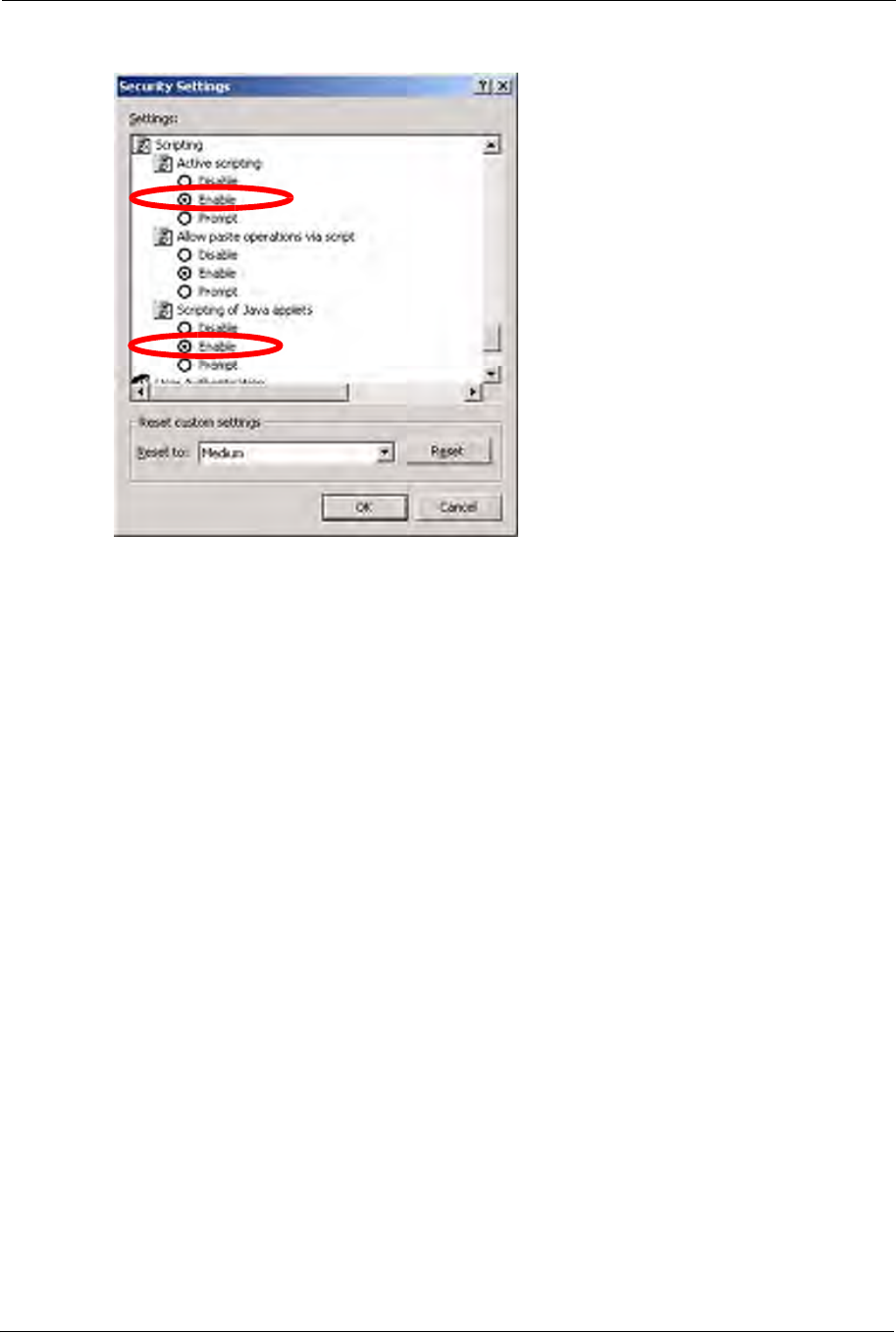
P-660H/HW/W-T Series User’ Guide
349 Chapter 38 Troubleshooting
Figure 228 Security Settings - Java Scripting
38.4.1.3 Java Permissions
1From Internet Explorer, click Tools,Internet Options and then the Security tab.
2Click the Custom Level... button.
3Scroll down to Microsoft VM.
4Under Java permissions make sure that a safety level is selected.
5Click OK to close the window.
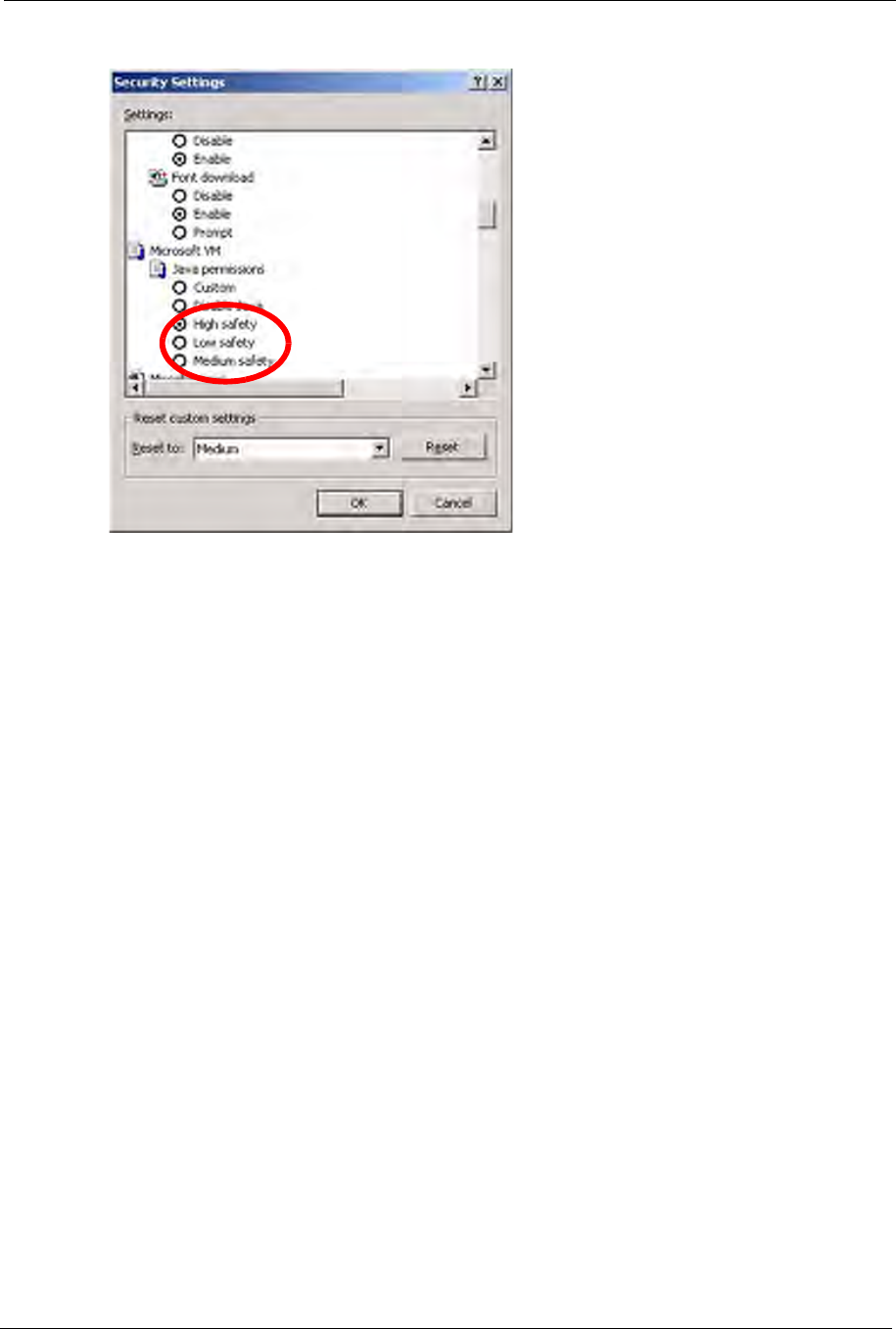
P-660H/HW/W-T Series User’ Guide
Chapter 38 Troubleshooting 350
Figure 229 Security Settings - Java
38.4.1.3.1 JAVA (Sun)
1From Internet Explorer, click Tools,Internet Options and then the Advanced tab.
2make sure that Use Java 2 for <applet> under Java (Sun) is selected.
3Click OK to close the window.
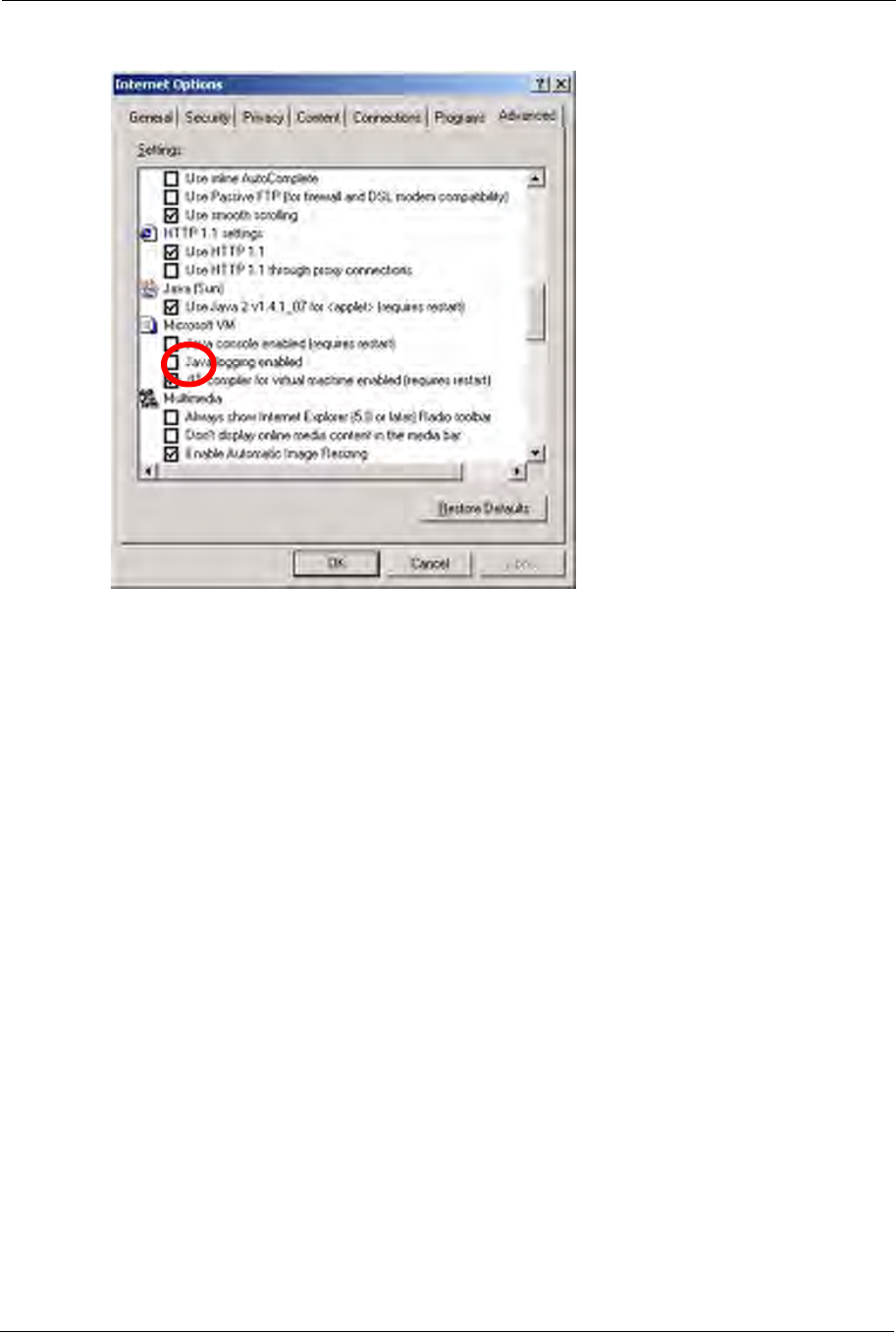
P-660H/HW/W-T Series User’ Guide
351 Chapter 38 Troubleshooting
Figure 230 Java (Sun)
38.4.2 ActiveX Controls in Internet Explorer
If ActiveX is disabled, you will not be able to download ActiveX controls or to use Trend
Micro Security Services. Make sure that ActiveX controls are allowed in Internet Explorer.
Screen shots for Internet Explorer 6 are shown. Steps may vary depending on your version of
Internet Explorer.
1In Internet Explorer, click Tools,Internet Options and then the Security tab.
2In the Internet Options window, click Custom Level.
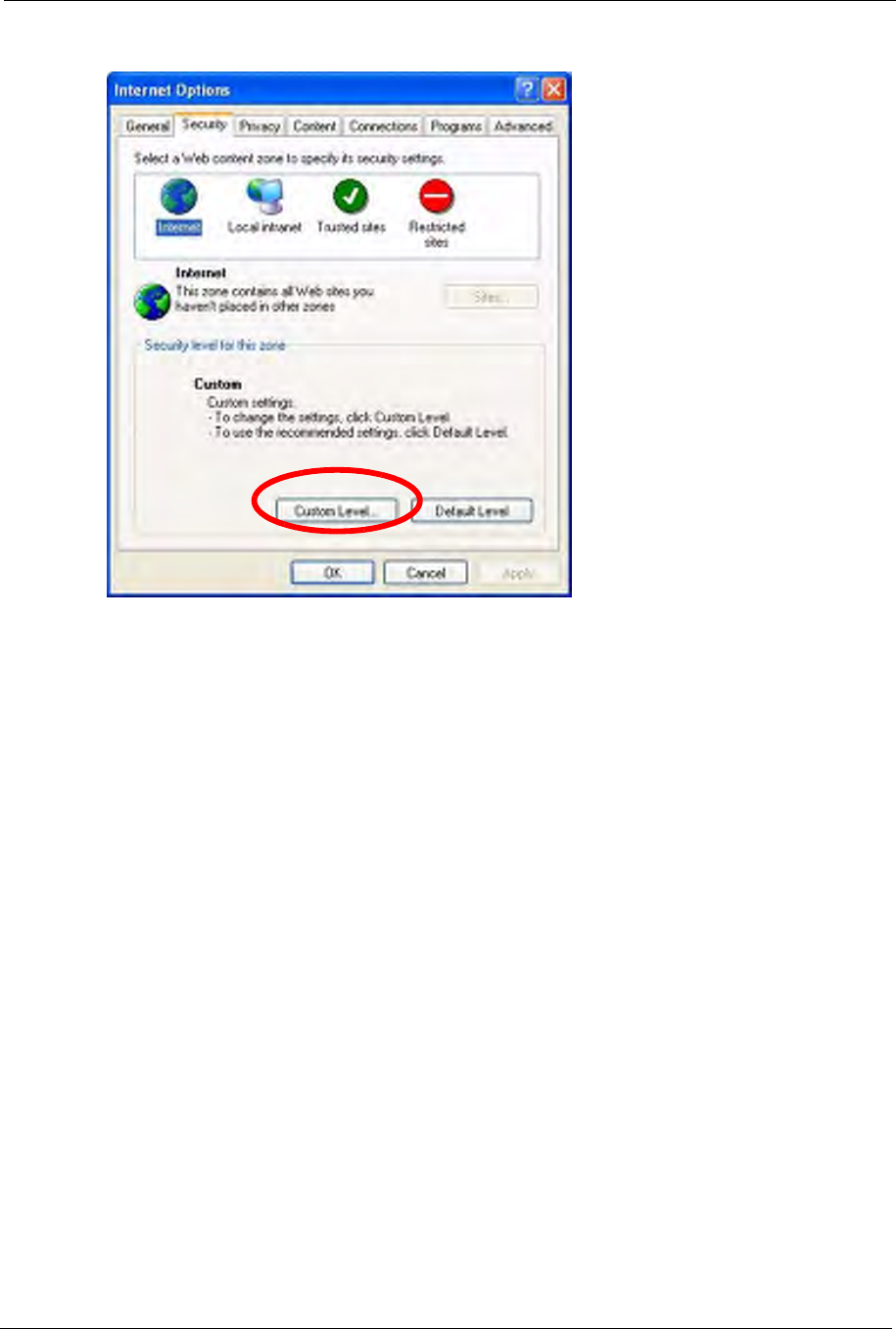
P-660H/HW/W-T Series User’ Guide
Chapter 38 Troubleshooting 352
Figure 231 Internet Options Security
3Scroll down to ActiveX controls and plug-ins.
4Under Download signed ActiveX controls select the Prompt radio button.
5Under Run ActiveX controls and plug-ins make sure the Enable radio button is
selected.
6Then click the OK button.
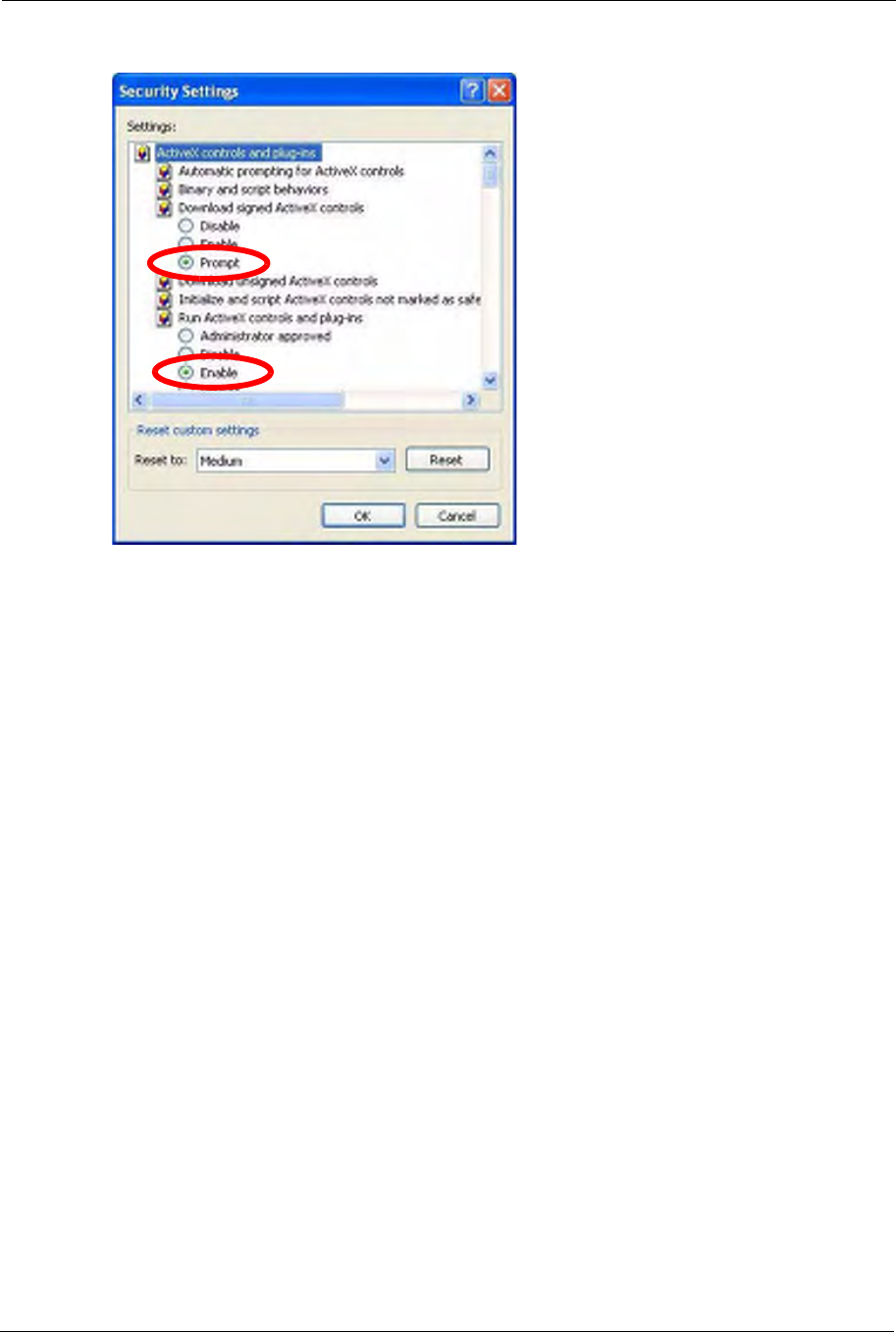
P-660H/HW/W-T Series User’ Guide
353 Chapter 38 Troubleshooting
Figure 232 Security Setting ActiveX Controls

P-660H/HW/W-T Series User’ Guide
Appendix A 354
Appendix A
Product Specifications
See also the Introduction chapter for a general overview of the key features.
Specification Tables
Table 122 Device
Default IP Address 192.168.1.1
Default Subnet Mask 255.255.255.0 (24 bits)
Default Password 1234
DHCP Pool 192.168.1.32 to 192.168.1.64
Dimensions (W x D x H) 180 x 128 x 36 mm
Power Specification 12VDC 1A
Built-in Switch (P-660H/
P-660HW)
Four auto-negotiating, auto MDI/MDI-X 10/100 Mbps RJ-45 Ethernet ports
Operation Temperature 0º C ~ 40º C
Storage Temperature -20º ~ 60º C
Operation Humidity 20% ~ 85% RH
Storage Humidity 10% ~ 90% RH

P-660H/HW/W-T Series User’ Guide
355 Appendix A
Table 123 Firmware
ADSL Standards Multi-Mode standard (ANSI T1.413,Issue 2; G.dmt(G.992.1); G.lite(G992.2)).
ADSL2 G.dmt.bis (G.992.3)
ADSL2 G.lite.bis (G.992.4)
ADSL2+ (G.992.5)
Reach-Extended ADSL (RE ADSL)
SRA (Seamless Rate Adaptation)
Auto-negotiating rate adaptation
ADSL physical connection ATM AAL5 (ATM Adaptation Layer type 5)
Multi-protocol over AAL5 (RFC2684/1483)
PPP over ATM AAL5 (RFC 2364)
PPP over Ethernet (RFC 2516)
RFC 1483 encapsulation over ATM
MAC encapsulated routing (ENET encapsulation)
VC-based and LLC-based multiplexing
Up to 8 PVCs (Permanent Virtual Circuits)
I.610 F4/F5 OAM
Other Protocol Support PPP (Point-to-Point Protocol) link layer protocol.
Transparent bridging for unsupported network layer protocols.
DHCP Server/Client/Relay
RIP I/RIP II
ICMP
ATM QoS
SNMP v1 and v2c with MIB II support (RFC 1213)
IP Multicasting IGMP v1 and v2
IGMP Proxy
UPnP
Management Embedded Web Configurator
Menu-driven SMT (System Management Terminal) management
CLI (Command Line Interpreter)
Remote Management via Telnet or Web
SNMP manageable
FTP/TFTP for firmware downloading, configuration backup and restoration.
Syslog
Built-in Diagnostic Tools for FLASH memory, ADSL circuitry, RAM and LAN
port
MAP - “Multimedia Auto Provisioner” (multimedia installation tutorial and
automatic configurator) (P-660HW)
Wireless (P-660HW/ P-
660W)
IEEE 802.11g compliance
Frequency Range: 2.4 GHz
Advanced Orthogonal Frequency Division Multiplexing (OFDM)
Data Rates: 54Mbps and Auto Fallback
Wired Equivalent Privacy (WEP) Data Encryption 64/128/256 bit
WLAN bridge to LAN
Up to 32 MAC address filters
WPA(2), WPA(2)-PSK
IEEE 802.1x
Store up to 32 built-in user profiles using EAP-MD5 (Local User Database)
External RADIUS server using EAP-MD5, TLS, TTLS

P-660H/HW/W-T Series User’ Guide
Appendix A 356
Firewall Stateful Packet Inspection.
Prevent Denial of Service attacks such as Ping of Death, SYN Flood, LAND,
Smurf etc.
Real time E-mail alerts.
Reports and logs.
NAT/SUA Port Forwarding
1024 NAT sessions
Multimedia application
PPTP under NAT/SUA
IPSec passthrough
SIP ALG passthrough
VPN passthrough
Content Filtering Web page blocking by URL keyword.
Static Routes 16 IP and 4 Bridge
Other Features Any IP
Zero Configuration (VC auto-hunting)
Traffic Redirect
Dynamic DNS
IP Alias
IP Policy Routing
MBM (Multimedia Bandwidth Management) QoS (Quality of Service)
Table 123 Firmware (continued)

P-660H/HW/W-T Series User’ Guide
357 Appendix A

P-660H/HW/W-T Series User’ Guide
Appendix B 358
APPENDIX B
Wall-mounting Instructions
Do the following to hang your Prestige on a wall.
Note: See the product specifications appendix for the size of screws to use and how
far apart to place them.
1Locate a high position on wall that is free of obstructions. Use a sturdy wall.
2Drill two holes for the screws. Make sure the distance between the centers of the holes
matches what is listed in the product specifications appendix.
Note: Be careful to avoid damaging pipes or cables located inside the wall when
drilling holes for the screws.
3Do not screw the screws all the way into the wall. Leave a small gap of about 0.5 cm
between the heads of the screws and the wall.
4Make sure the screws are snugly fastened to the wall. They need to hold the weight of the
Prestige with the connection cables.
5Align the holes on the back of the Prestige with the screws on the wall. Hang the Prestige
on the screws.

P-660H/HW/W-T Series User’ Guide
359 Appendix B

P-660H/HW/W-T Series User’ Guide
Appendix C 360
Appendix C
Setting up Your Computer’s IP Address
All computers must have a 10M or 100M Ethernet adapter card and TCP/IP installed.
Windows 95/98/Me/NT/2000/XP, Macintosh OS 7 and later operating systems and all
versions of UNIX/LINUX include the software components you need to install and use TCP/
IP on your computer. Windows 3.1 requires the purchase of a third-party TCP/IP application
package.
TCP/IP should already be installed on computers using Windows NT/2000/XP, Macintosh OS
7 and later operating systems.
After the appropriate TCP/IP components are installed, configure the TCP/IP settings in order
to "communicate" with your network.
If you manually assign IP information instead of using dynamic assignment, make sure that
your computers have IP addresses that place them in the same subnet as the Prestige’s LAN
port.
Windows 95/98/Me
Click Start,Settings,Control Panel and double-click the Network icon to open the Network
window.
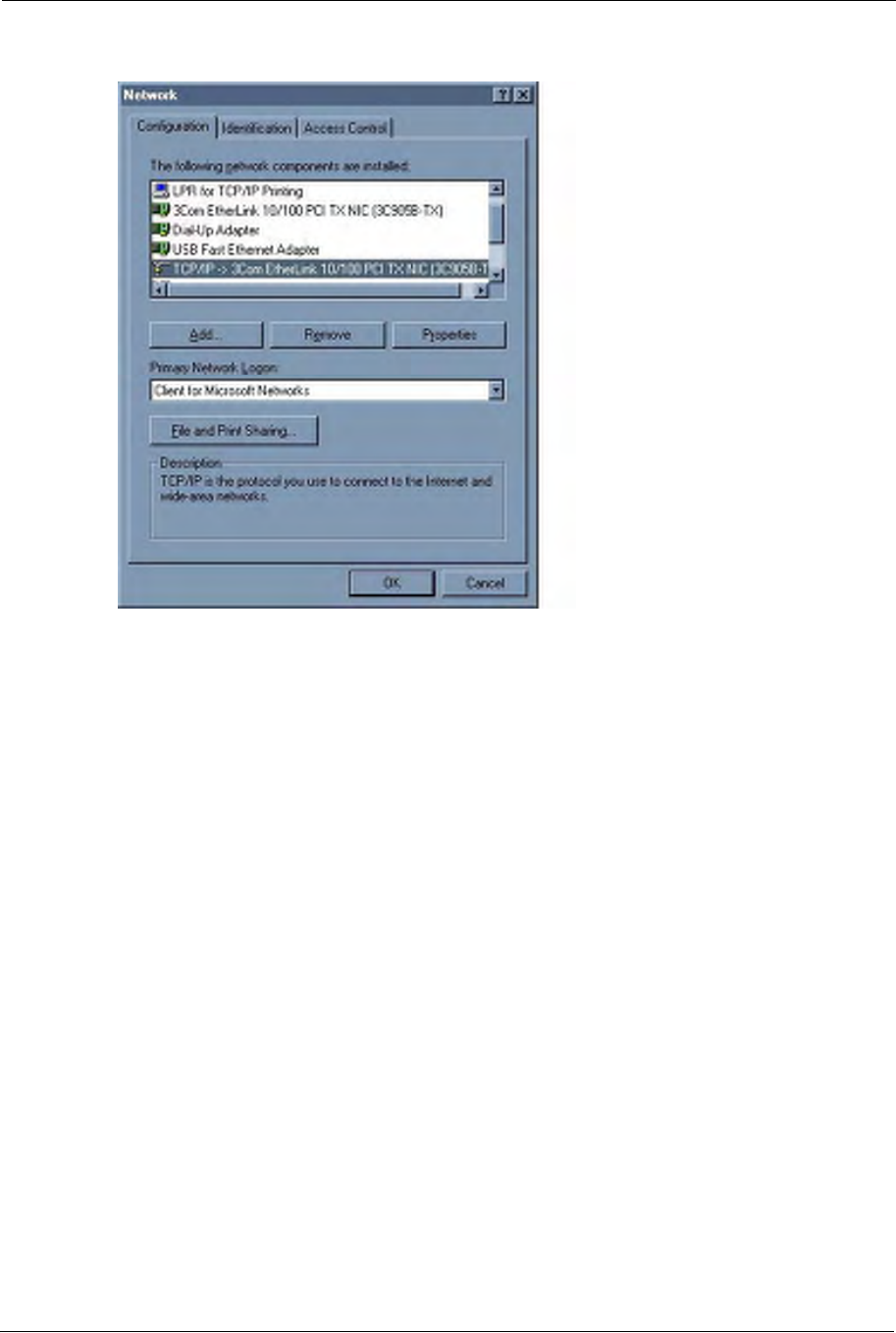
P-660H/HW/W-T Series User’ Guide
361 Appendix C
Figure 233 WIndows 95/98/Me: Network: Configuration
Installing Components
The Network window Configuration tab displays a list of installed components. You need a
network adapter, the TCP/IP protocol and Client for Microsoft Networks.
If you need the adapter:
1In the Network window, click Add.
2Select Adapter and then click Add.
3Select the manufacturer and model of your network adapter and then click OK.
If you need TCP/IP:
1In the Network window, click Add.
2Select Protocol and then click Add.
3Select Microsoft from the list of manufacturers.
4Select TCP/IP from the list of network protocols and then click OK.
If you need Client for Microsoft Networks:
1Click Add.
2Select Client and then click Add.
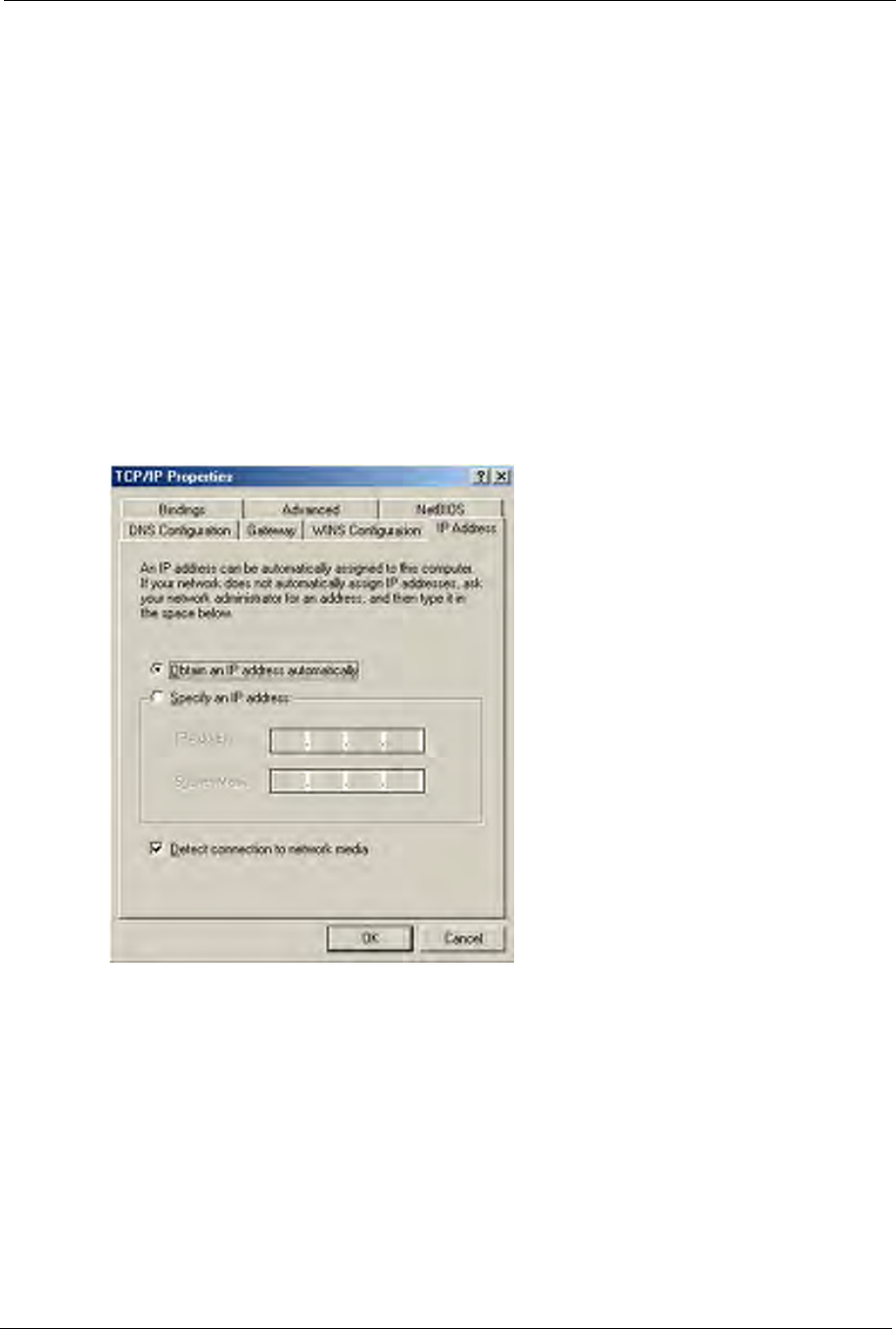
P-660H/HW/W-T Series User’ Guide
Appendix C 362
3Select Microsoft from the list of manufacturers.
4Select Client for Microsoft Networks from the list of network clients and then click
OK.
5Restart your computer so the changes you made take effect.
Configuring
1In the Network window Configuration tab, select your network adapter's TCP/IP entry
and click Properties
2Click the IP Address tab.
• If your IP address is dynamic, select Obtain an IP address automatically.
• If you have a static IP address, select Specify an IP address and type your
information into the IP Address and Subnet Mask fields.
Figure 234 Windows 95/98/Me: TCP/IP Properties: IP Address
3Click the DNS Configuration tab.
• If you do not know your DNS information, select Disable DNS.
• If you know your DNS information, select Enable DNS and type the information in
the fields below (you may not need to fill them all in).
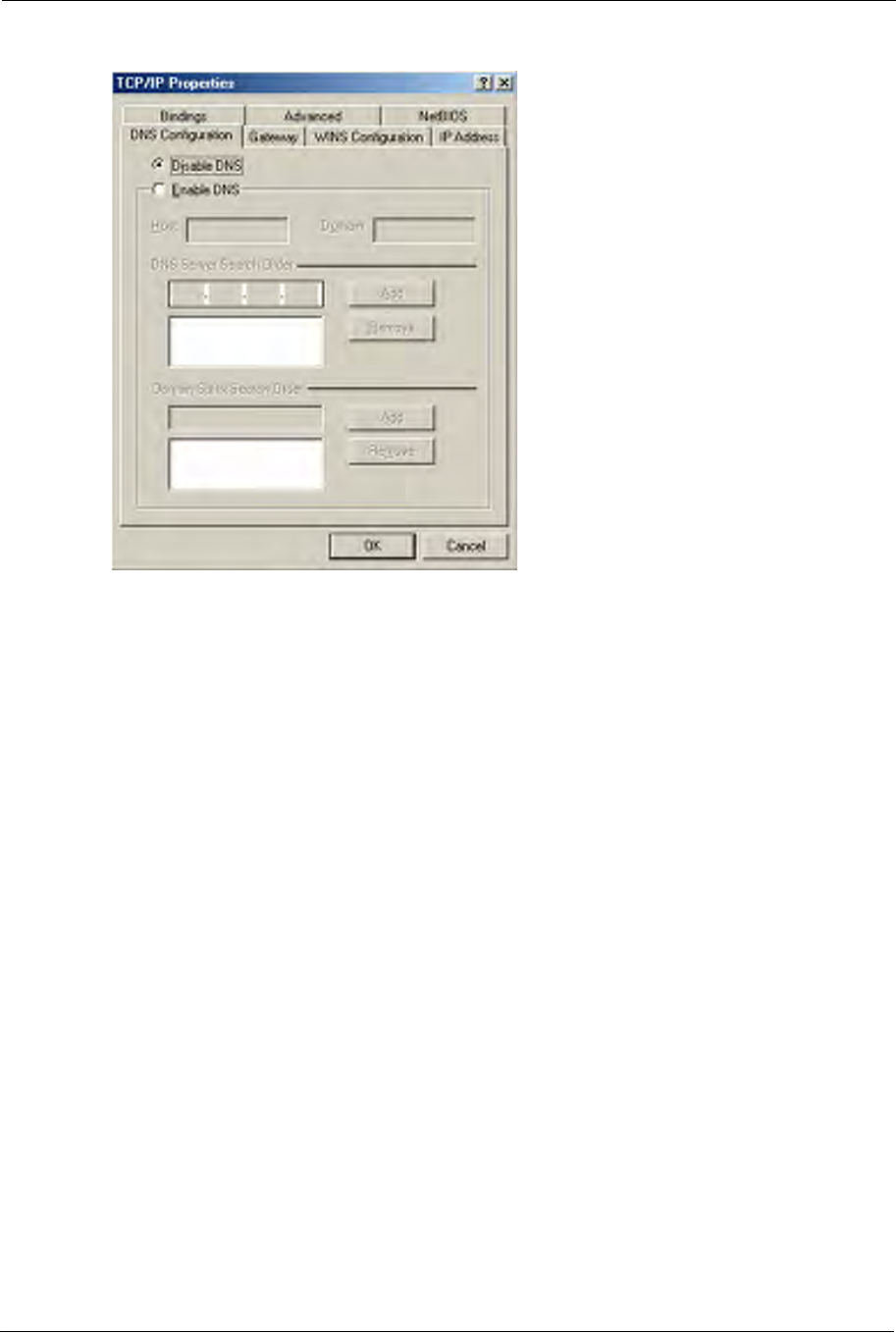
P-660H/HW/W-T Series User’ Guide
363 Appendix C
Figure 235 Windows 95/98/Me: TCP/IP Properties: DNS Configuration
4Click the Gateway tab.
• If you do not know your gateway’s IP address, remove previously installed
gateways.
• If you have a gateway IP address, type it in the New gateway field and click Add.
5Click OK to save and close the TCP/IP Properties window.
6Click OK to close the Network window. Insert the Windows CD if prompted.
7Turn on your Prestige and restart your computer when prompted.
Verifying Settings
1Click Start and then Run.
2In the Run window, type "winipcfg" and then click OK to open the IP Configuration
window.
3Select your network adapter. You should see your computer's IP address, subnet mask
and default gateway.
Windows 2000/NT/XP
The following example figures use the default Windows XP GUI theme.
1Click start (Start in Windows 2000/NT), Settings,Control Panel.
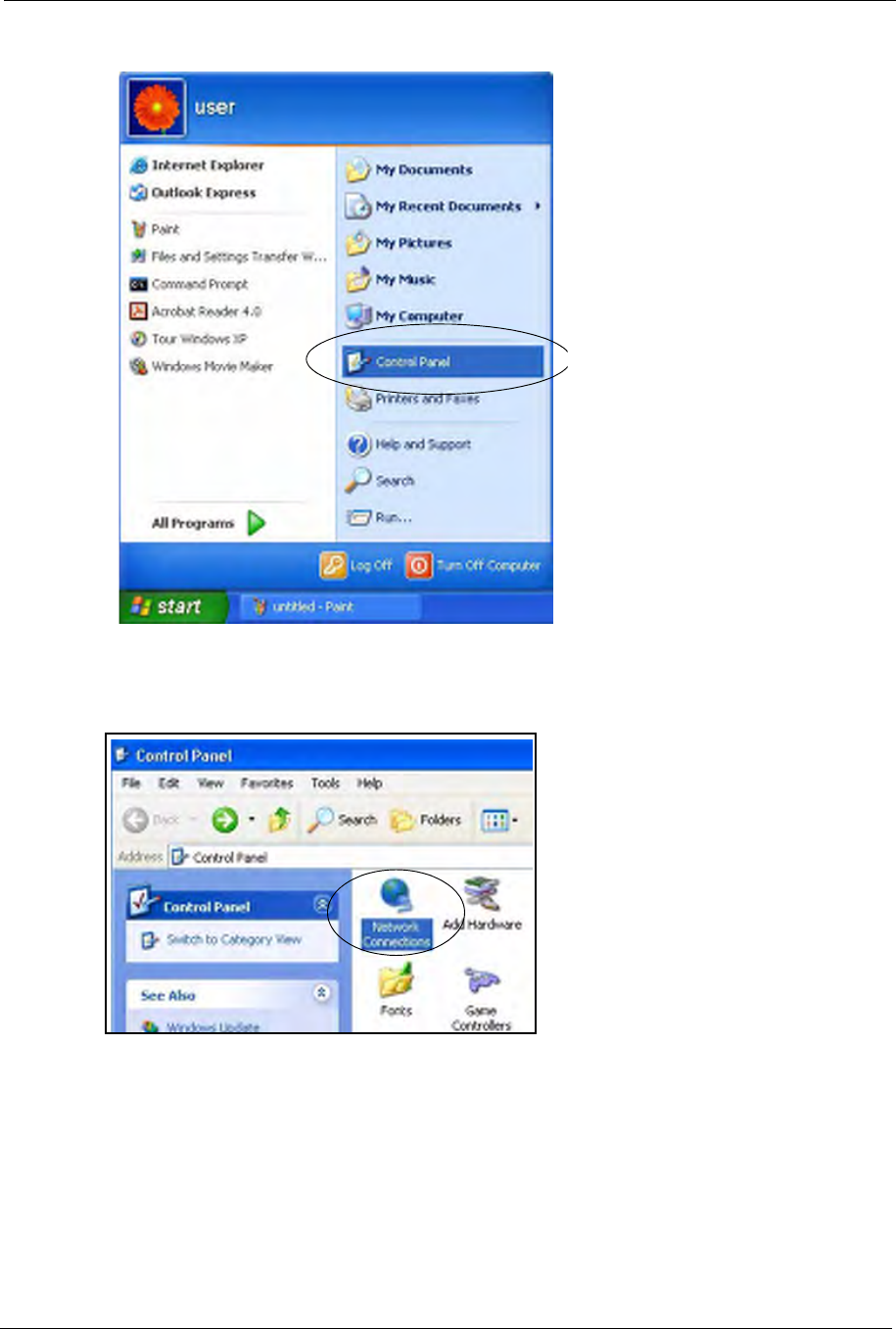
P-660H/HW/W-T Series User’ Guide
Appendix C 364
Figure 236 Windows XP: Start Menu
2In the Control Panel, double-click Network Connections (Network and Dial-up
Connections in Windows 2000/NT).
Figure 237 Windows XP: Control Panel
3Right-click Local Area Connection and then click Properties.
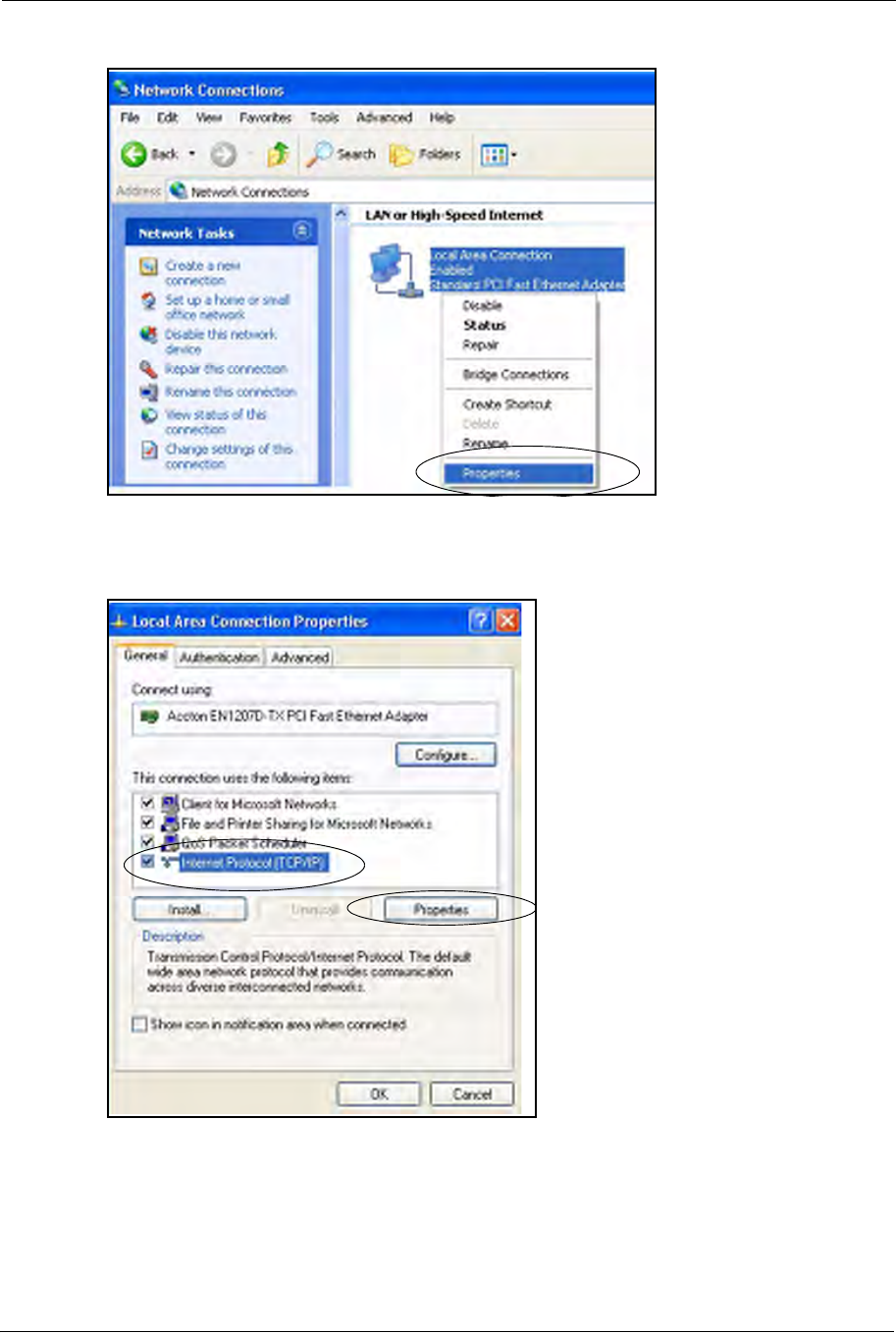
P-660H/HW/W-T Series User’ Guide
365 Appendix C
Figure 238 Windows XP: Control Panel: Network Connections: Properties
4Select Internet Protocol (TCP/IP) (under the General tab in Win XP) and then click
Properties.
Figure 239 Windows XP: Local Area Connection Properties
5The Internet Protocol TCP/IP Properties window opens (the General tab in Windows
XP).
• If you have a dynamic IP address click Obtain an IP address automatically.
• If you have a static IP address click Use the following IP Address and fill in the IP
address,Subnet mask, and Default gateway fields.
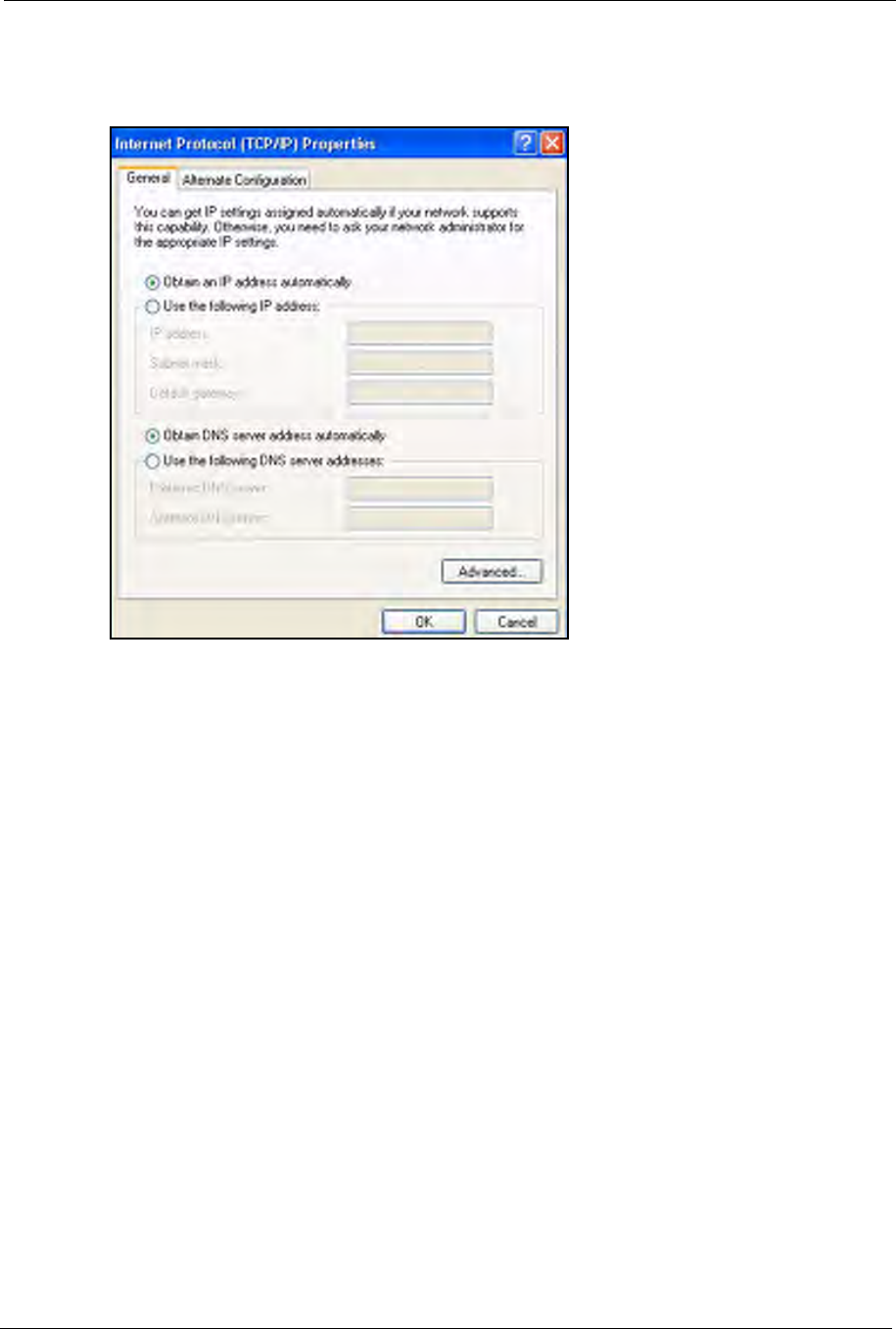
P-660H/HW/W-T Series User’ Guide
Appendix C 366
• Click Advanced.
Figure 240 Windows XP: Internet Protocol (TCP/IP) Properties
6 If you do not know your gateway's IP address, remove any previously installed gateways
in the IP Settings tab and click OK.
Do one or more of the following if you want to configure additional IP addresses:
•In the IP Settings tab, in IP addresses, click Add.
•In TCP/IP Address, type an IP address in IP address and a subnet mask in Subnet
mask, and then click Add.
• Repeat the above two steps for each IP address you want to add.
• Configure additional default gateways in the IP Settings tab by clicking Add in
Default gateways.
•In TCP/IP Gateway Address, type the IP address of the default gateway in
Gateway. To manually configure a default metric (the number of transmission
hops), clear the Automatic metric check box and type a metric in Metric.
• Click Add.
• Repeat the previous three steps for each default gateway you want to add.
• Click OK when finished.
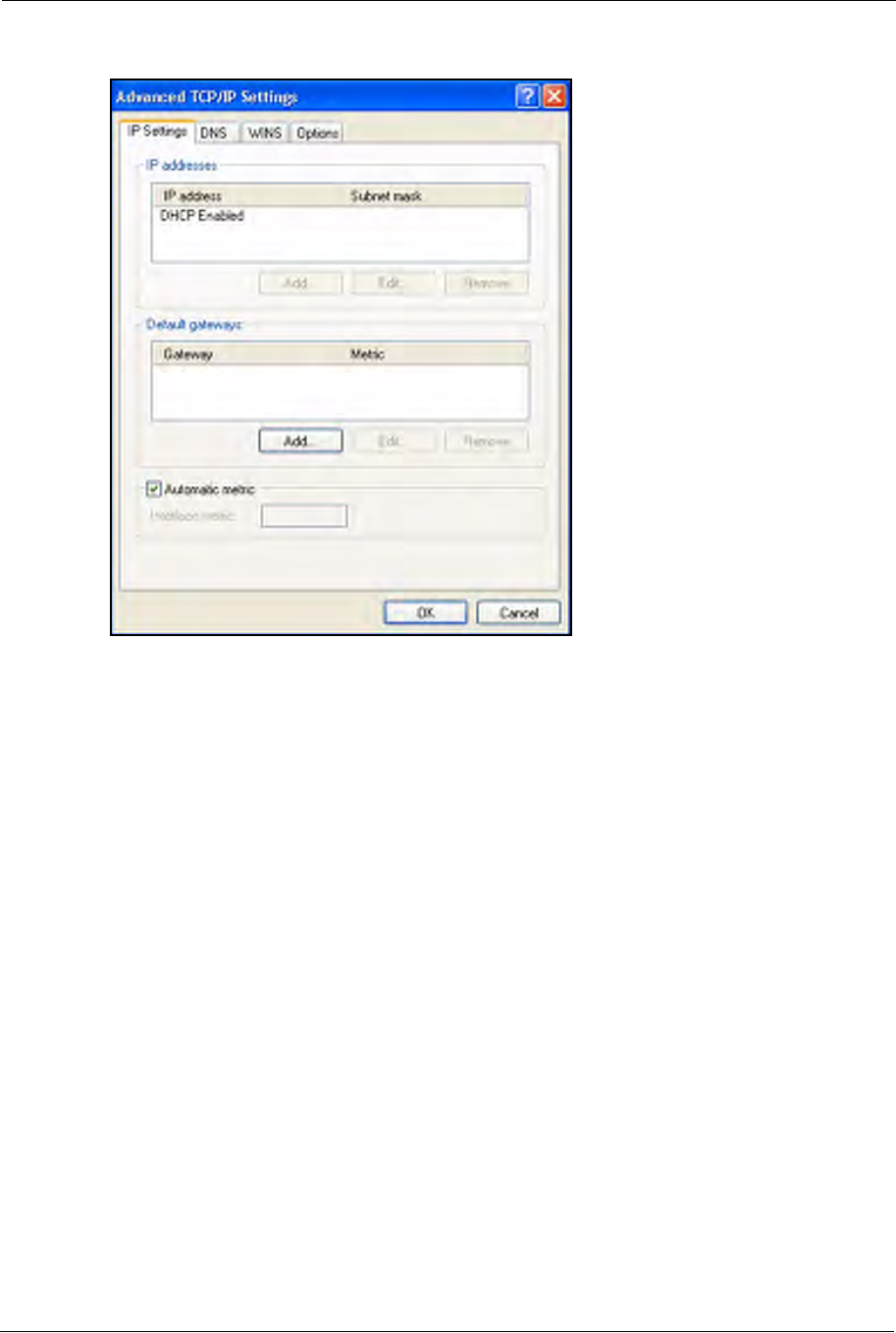
P-660H/HW/W-T Series User’ Guide
367 Appendix C
Figure 241 Windows XP: Advanced TCP/IP Properties
7In the Internet Protocol TCP/IP Properties window (the General tab in Windows XP):
• Click Obtain DNS server address automatically if you do not know your DNS
server IP address(es).
• If you know your DNS server IP address(es), click Use the following DNS server
addresses, and type them in the Preferred DNS server and Alternate DNS server
fields.
If you have previously configured DNS servers, click Advanced and then the DNS
tab to order them.
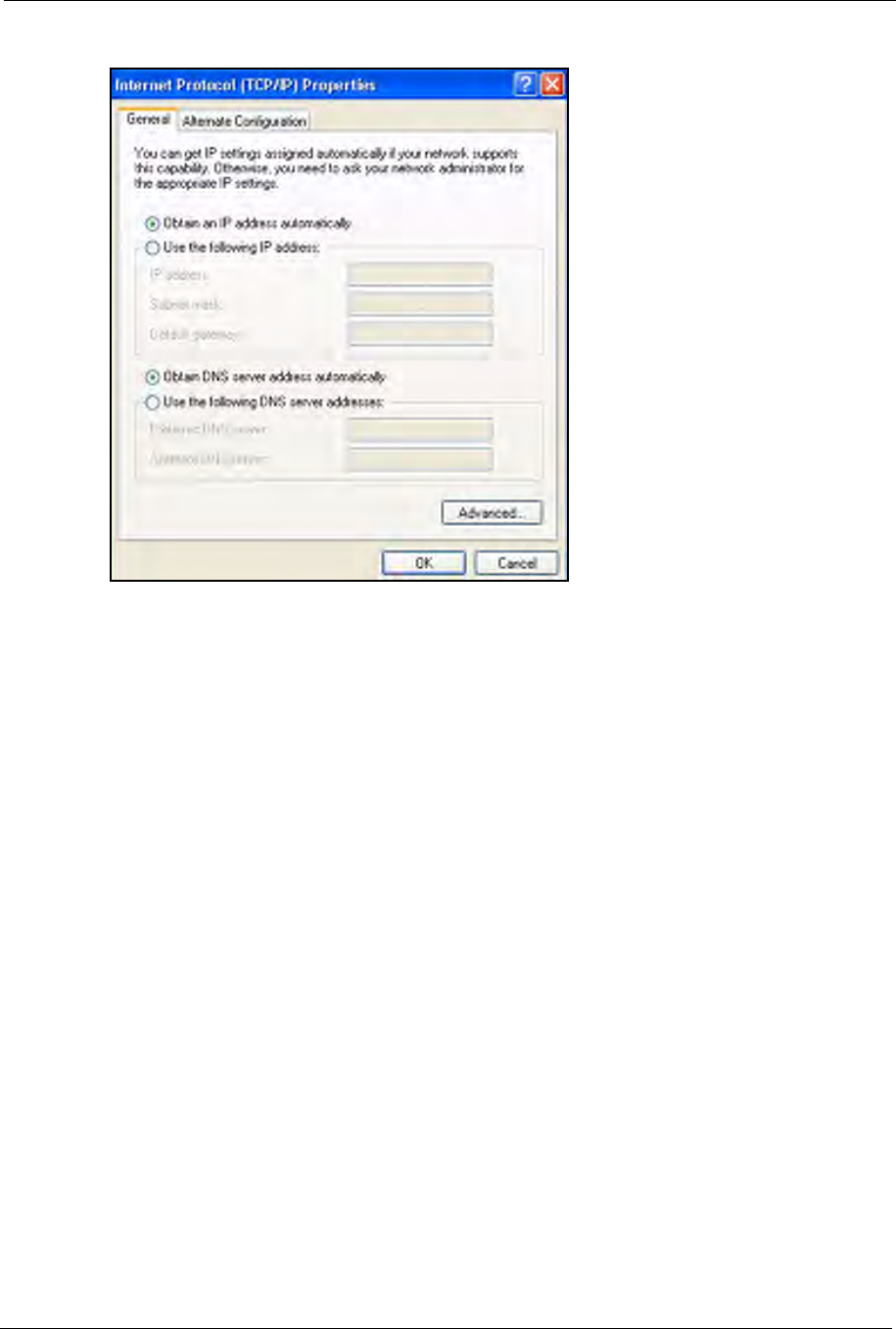
P-660H/HW/W-T Series User’ Guide
Appendix C 368
Figure 242 Windows XP: Internet Protocol (TCP/IP) Properties
8Click OK to close the Internet Protocol (TCP/IP) Properties window.
9Click Close (OK in Windows 2000/NT) to close the Local Area Connection Properties
window.
10 Close the Network Connections window (Network and Dial-up Connections in
Windows 2000/NT).
11Turn on your Prestige and restart your computer (if prompted).
Verifying Settings
1Click Start,All Programs,Accessories and then Command Prompt.
2In the Command Prompt window, type "ipconfig" and then press [ENTER]. You can
also open Network Connections, right-click a network connection, click Status and then
click the Support tab.
Macintosh OS 8/9
1Click the Apple menu, Control Panel and double-click TCP/IP to open the TCP/IP
Control Panel.
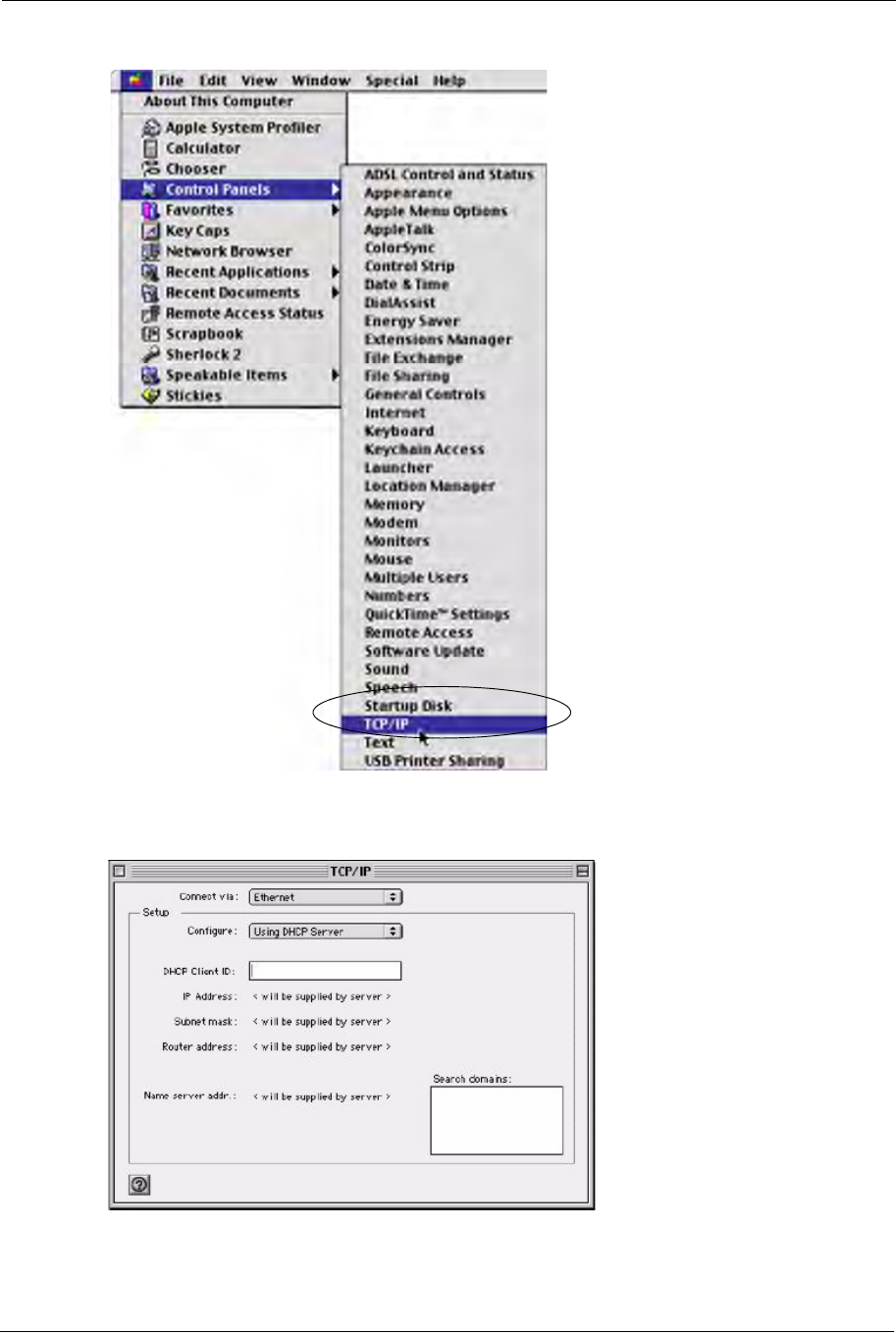
P-660H/HW/W-T Series User’ Guide
369 Appendix C
Figure 243 Macintosh OS 8/9: Apple Menu
2Select Ethernet built-in from the Connect via list.
Figure 244 Macintosh OS 8/9: TCP/IP
3For dynamically assigned settings, select Using DHCP Server from the Configure: list.
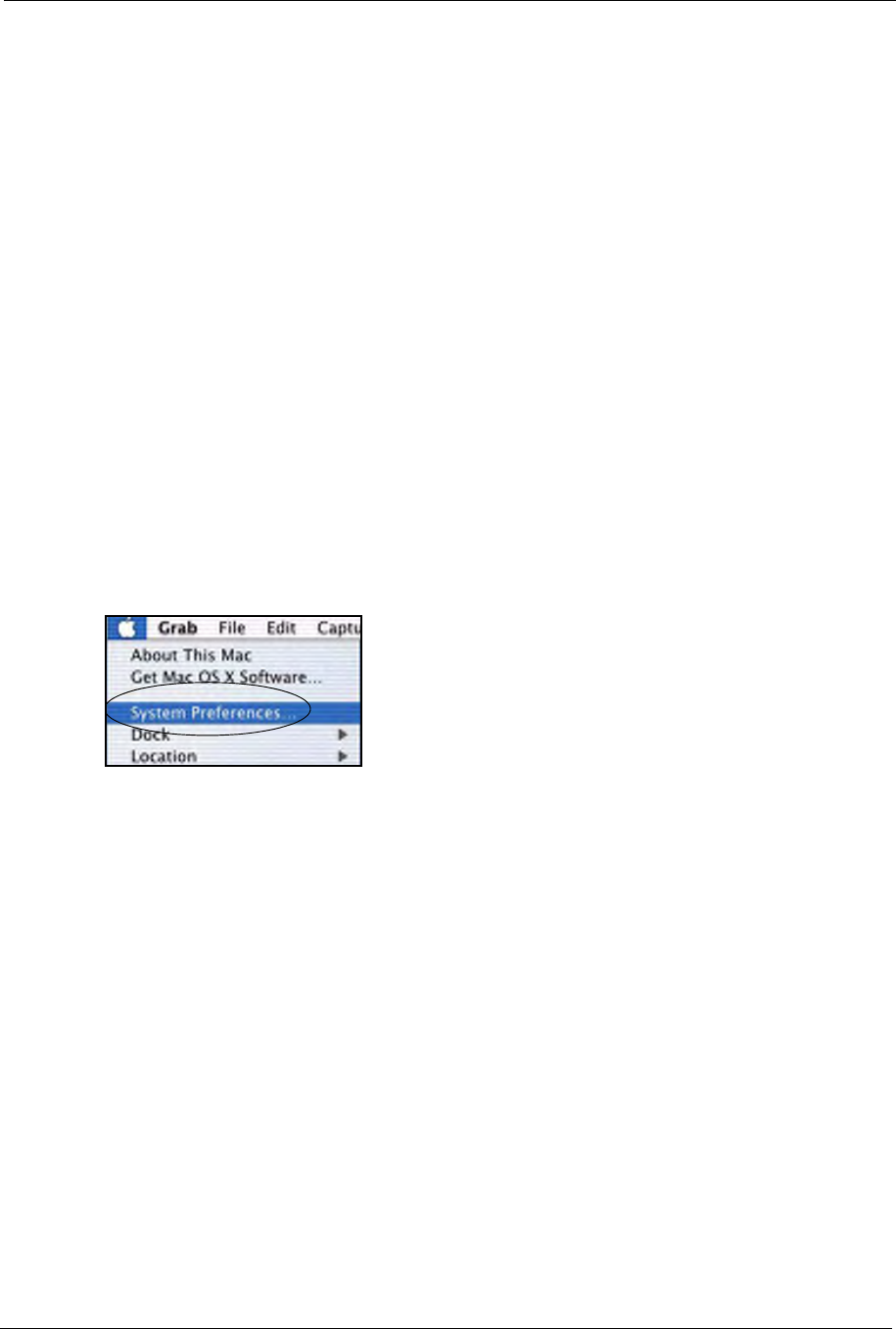
P-660H/HW/W-T Series User’ Guide
Appendix C 370
4For statically assigned settings, do the following:
•From the Configure box, select Manually.
• Type your IP address in the IP Address box.
• Type your subnet mask in the Subnet mask box.
• Type the IP address of your Prestige in the Router address box.
5Close the TCP/IP Control Panel.
6Click Save if prompted, to save changes to your configuration.
7Turn on your Prestige and restart your computer (if prompted).
Verifying Settings
Check your TCP/IP properties in the TCP/IP Control Panel window.
Macintosh OS X
1Click the Apple menu, and click System Preferences to open the System Preferences
window.
Figure 245 Macintosh OS X: Apple Menu
2Click Network in the icon bar.
• Select Automatic from the Location list.
• Select Built-in Ethernet from the Show list.
• Click the TCP/IP tab.
3For dynamically assigned settings, select Using DHCP from the Configure list.
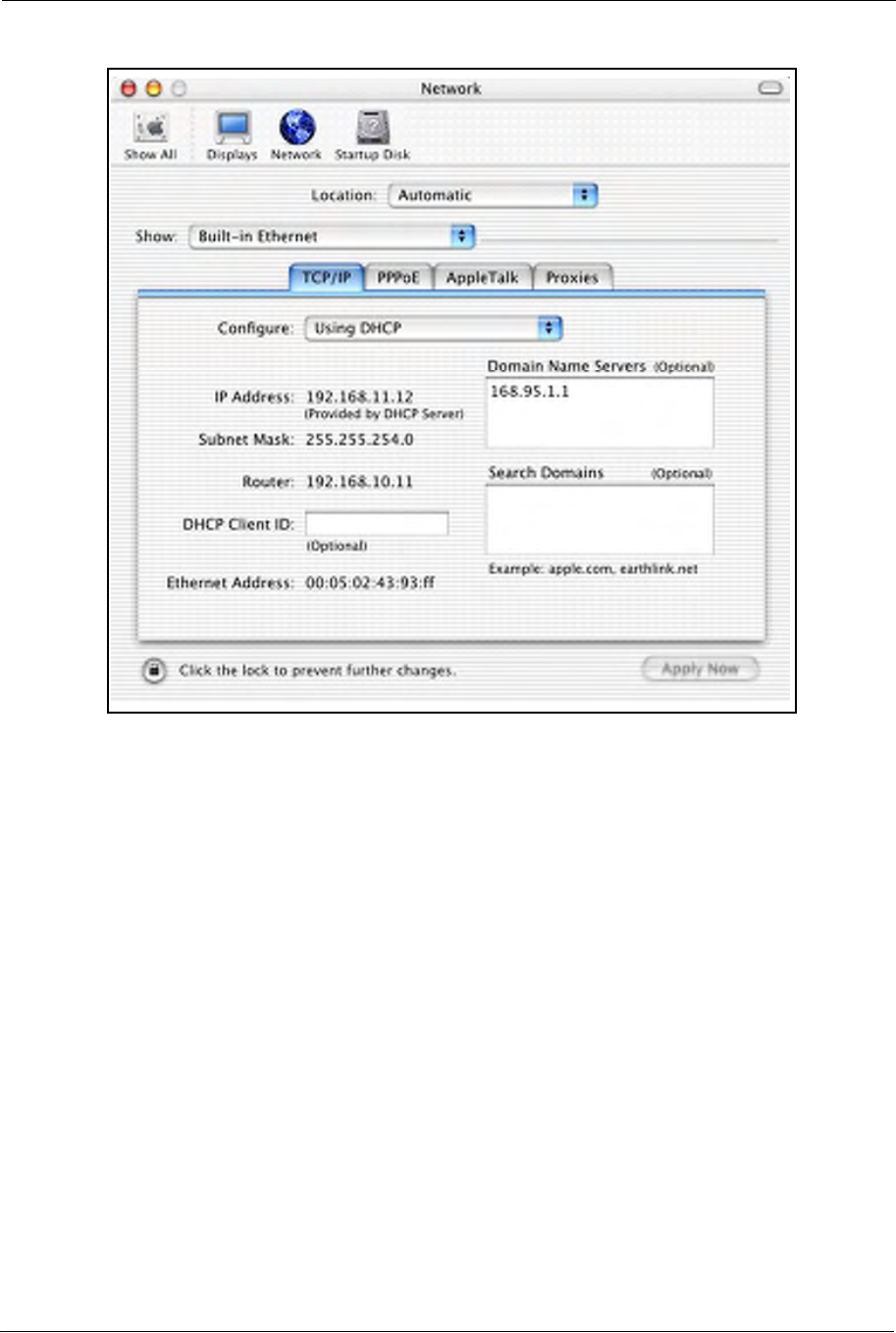
P-660H/HW/W-T Series User’ Guide
371 Appendix C
Figure 246 Macintosh OS X: Network
4For statically assigned settings, do the following:
•From the Configure box, select Manually.
• Type your IP address in the IP Address box.
• Type your subnet mask in the Subnet mask box.
• Type the IP address of your Prestige in the Router address box.
5Click Apply Now and close the window.
6Turn on your Prestige and restart your computer (if prompted).
Verifying Settings
Check your TCP/IP properties in the Network window.
Linux
This section shows you how to configure your computer’s TCP/IP settings in Red Hat Linux
9.0. Procedure, screens and file location may vary depending on your Linux distribution and
release version.
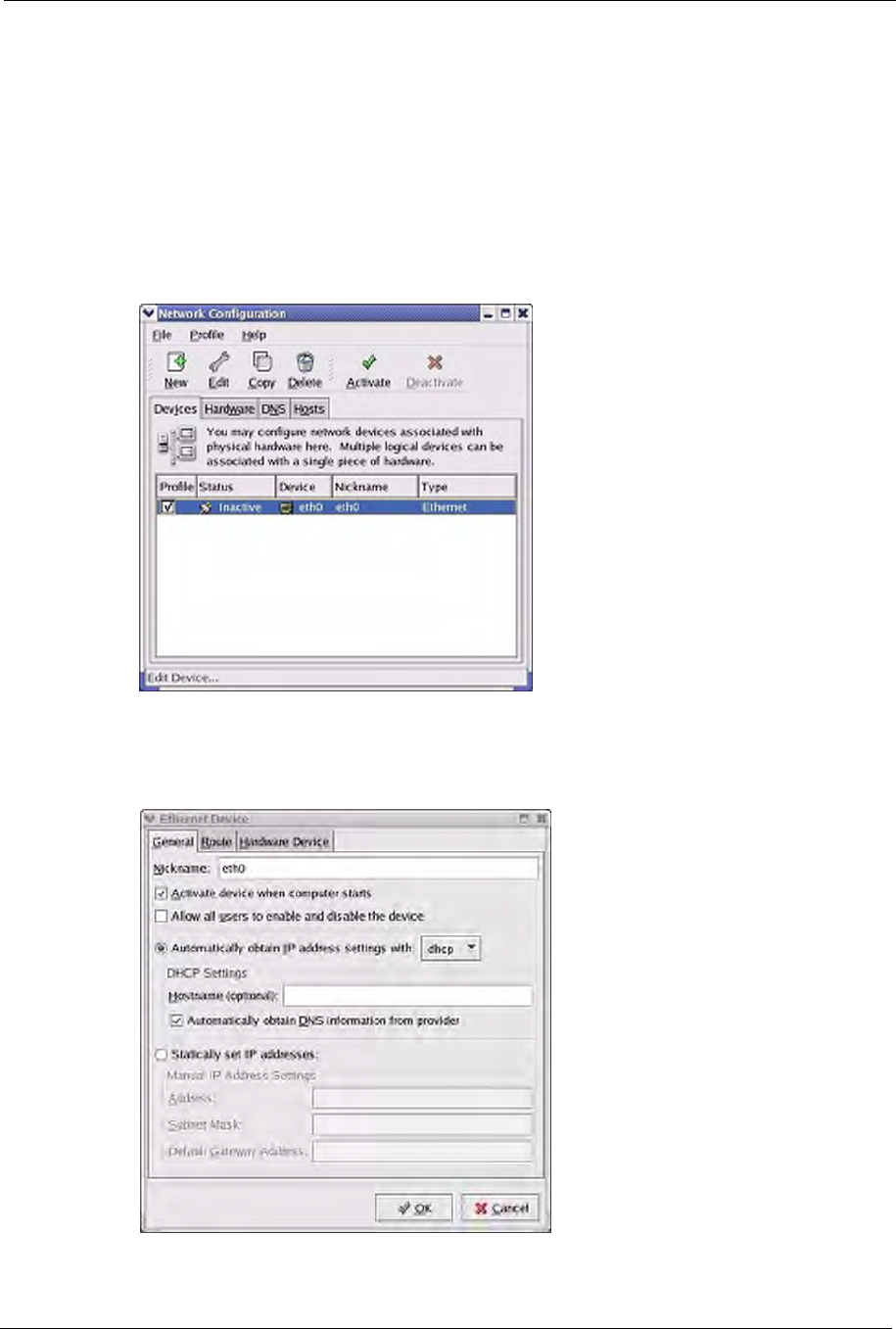
P-660H/HW/W-T Series User’ Guide
Appendix C 372
Note: Make sure you are logged in as the root administrator.
Using the K Desktop Environment (KDE)
Follow the steps below to configure your computer IP address using the KDE.
1Click the Red Hat button (located on the bottom left corner), select System Setting and
click Network.
Figure 247 Red Hat 9.0: KDE: Network Configuration: Devices
2Double-click on the profile of the network card you wish to configure. The Ethernet
Device General screen displays as shown.
Figure 248 Red Hat 9.0: KDE: Ethernet Device: General
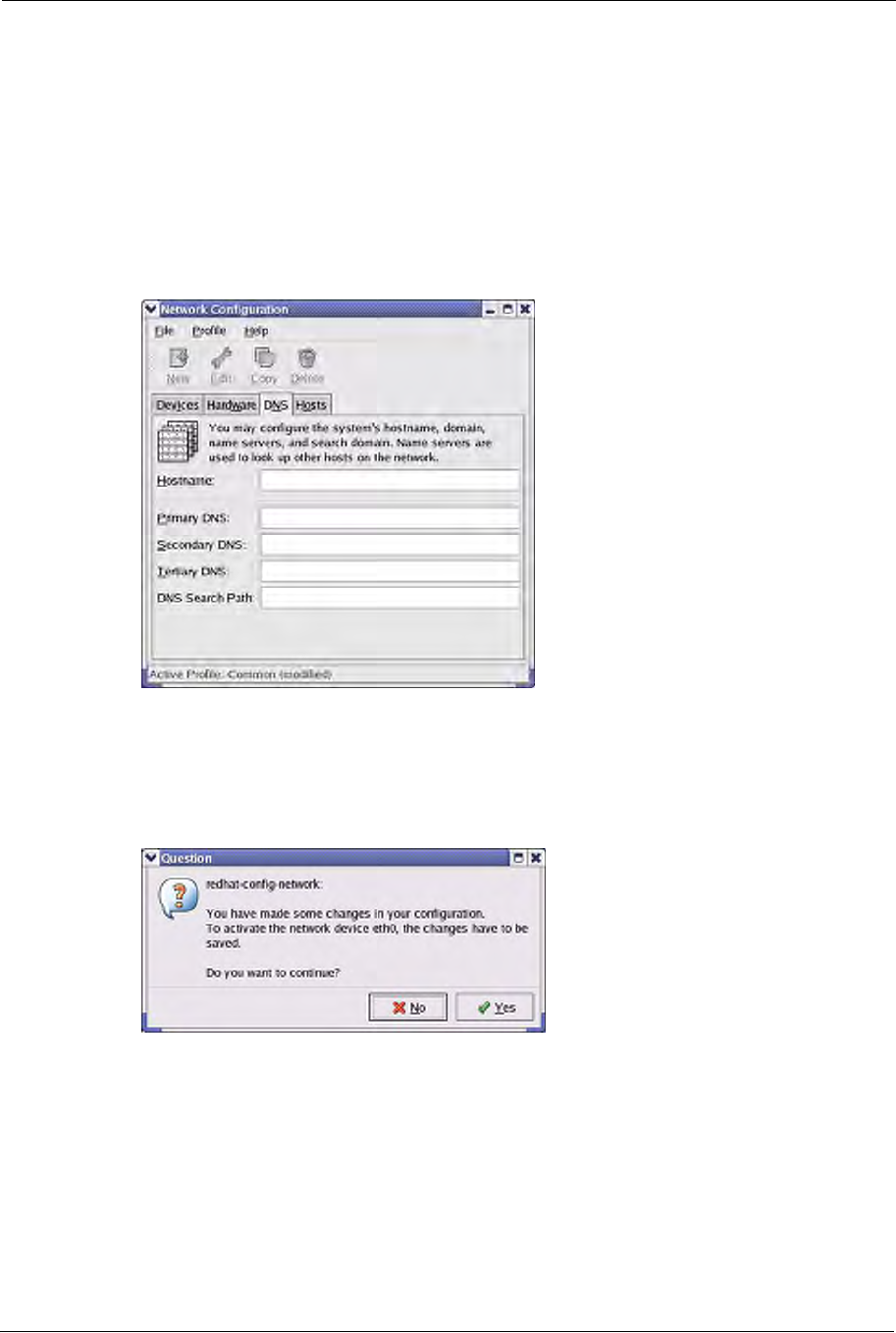
P-660H/HW/W-T Series User’ Guide
373 Appendix C
• If you have a dynamic IP address click Automatically obtain IP address settings
with and select dhcp from the drop down list.
• If you have a static IP address click Statically set IP Addresses and fill in the
Address,Subnet mask, and Default Gateway Address fields.
3Click OK to save the changes and close the Ethernet Device General screen.
4If you know your DNS server IP address(es), click the DNS tab in the Network
Configuration screen. Enter the DNS server information in the fields provided.
Figure 249 Red Hat 9.0: KDE: Network Configuration: DNS
5Click the Devices tab.
6Click the Activate button to apply the changes. The following screen displays. Click Ye s
to save the changes in all screens.
Figure 250 Red Hat 9.0: KDE: Network Configuration: Activate
7After the network card restart process is complete, make sure the Status is Active in the
Network Configuration screen.
Using Configuration Files
Follow the steps below to edit the network configuration files and set your computer IP
address.

P-660H/HW/W-T Series User’ Guide
Appendix C 374
1Assuming that you have only one network card on the computer, locate the ifconfig-
eth0 configuration file (where eth0 is the name of the Ethernet card). Open the
configuration file with any plain text editor.
• If you have a dynamic IP address, enter dhcp in the BOOTPROTO= field. The
following figure shows an example.
Figure 251 Red Hat 9.0: Dynamic IP Address Setting in ifconfig-eth0
• If you have a static IP address, enter static in the BOOTPROTO= field. Type
IPADDR= followed by the IP address (in dotted decimal notation) and type
NETMASK= followed by the subnet mask. The following example shows an example
where the static IP address is 192.168.1.10 and the subnet mask is 255.255.255.0.
Figure 252 Red Hat 9.0: Static IP Address Setting in ifconfig-eth0
2If you know your DNS server IP address(es), enter the DNS server information in the
resolv.conf file in the /etc directory. The following figure shows an example where
two DNS server IP addresses are specified.
Figure 253 Red Hat 9.0: DNS Settings in resolv.conf
3After you edit and save the configuration files, you must restart the network card. Enter
./network restart in the /etc/rc.d/init.d directory. The following figure
shows an example.
DEVICE=eth0
ONBOOT=yes
BOOTPROTO=dhcp
USERCTL=no
PEERDNS=yes
TYPE=Ethernet
DEVICE=eth0
ONBOOT=yes
BOOTPROTO=static
IPADDR=192.168.1.10
NETMASK=255.255.255.0
USERCTL=no
PEERDNS=yes
TYPE=Ethernet
nameserver 172.23.5.1
nameserver 172.23.5.2

P-660H/HW/W-T Series User’ Guide
375 Appendix C
Figure 254 Red Hat 9.0: Restart Ethernet Card
Verifying Settings
Enter ifconfig in a terminal screen to check your TCP/IP properties.
Figure 255 Red Hat 9.0: Checking TCP/IP Properties
[root@localhost init.d]# network restart
Shutting down interface eth0: [OK]
Shutting down loopback interface: [OK]
Setting network parameters: [OK]
Bringing up loopback interface: [OK]
Bringing up interface eth0: [OK]
[root@localhost]# ifconfig
eth0 Link encap:Ethernet HWaddr 00:50:BA:72:5B:44
inet addr:172.23.19.129 Bcast:172.23.19.255 Mask:255.255.255.0
UP BROADCAST RUNNING MULTICAST MTU:1500 Metric:1
RX packets:717 errors:0 dropped:0 overruns:0 frame:0
TX packets:13 errors:0 dropped:0 overruns:0 carrier:0
collisions:0 txqueuelen:100
RX bytes:730412 (713.2 Kb) TX bytes:1570 (1.5 Kb)
Interrupt:10 Base address:0x1000
[root@localhost]#

P-660H/HW/W-T Series User’ Guide
Appendix D 376
Appendix D
IP Subnetting
IP Addressing
Routers “route” based on the network number. The router that delivers the data packet to the
correct destination host uses the host ID.
IP Classes
An IP address is made up of four octets (eight bits), written in dotted decimal notation, for
example, 192.168.1.1. IP addresses are categorized into different classes. The class of an
address depends on the value of its first octet.
• Class “A” addresses have a 0 in the left most bit. In a class “A” address the first octet is
the network number and the remaining three octets make up the host ID.
• Class “B” addresses have a 1 in the left most bit and a 0 in the next left most bit. In a class
“B” address the first two octets make up the network number and the two remaining
octets make up the host ID.
• Class “C” addresses begin (starting from the left) with 1 1 0. In a class “C” address the
first three octets make up the network number and the last octet is the host ID.
• Class “D” addresses begin with 1 1 1 0. Class “D” addresses are used for multicasting.
(There is also a class “E” address. It is reserved for future use.)
Note: Host IDs of all zeros or all ones are not allowed.
Therefore:
A class “C” network (8 host bits) can have 28 –2 or 254 hosts.
A class “B” address (16 host bits) can have 216 –2 or 65534 hosts.
A class “A” address (24 host bits) can have 224 –2 hosts (approximately 16 million hosts).
Table 124 Classes of IP Addresses
IP ADDRESS: OCTET 1 OCTET 2 OCTET 3 OCTET 4
Class A 0Network number Host ID Host ID Host ID
Class B 10 Network number Network number Host ID Host ID
Class C 110 Network number Network number Network number Host ID
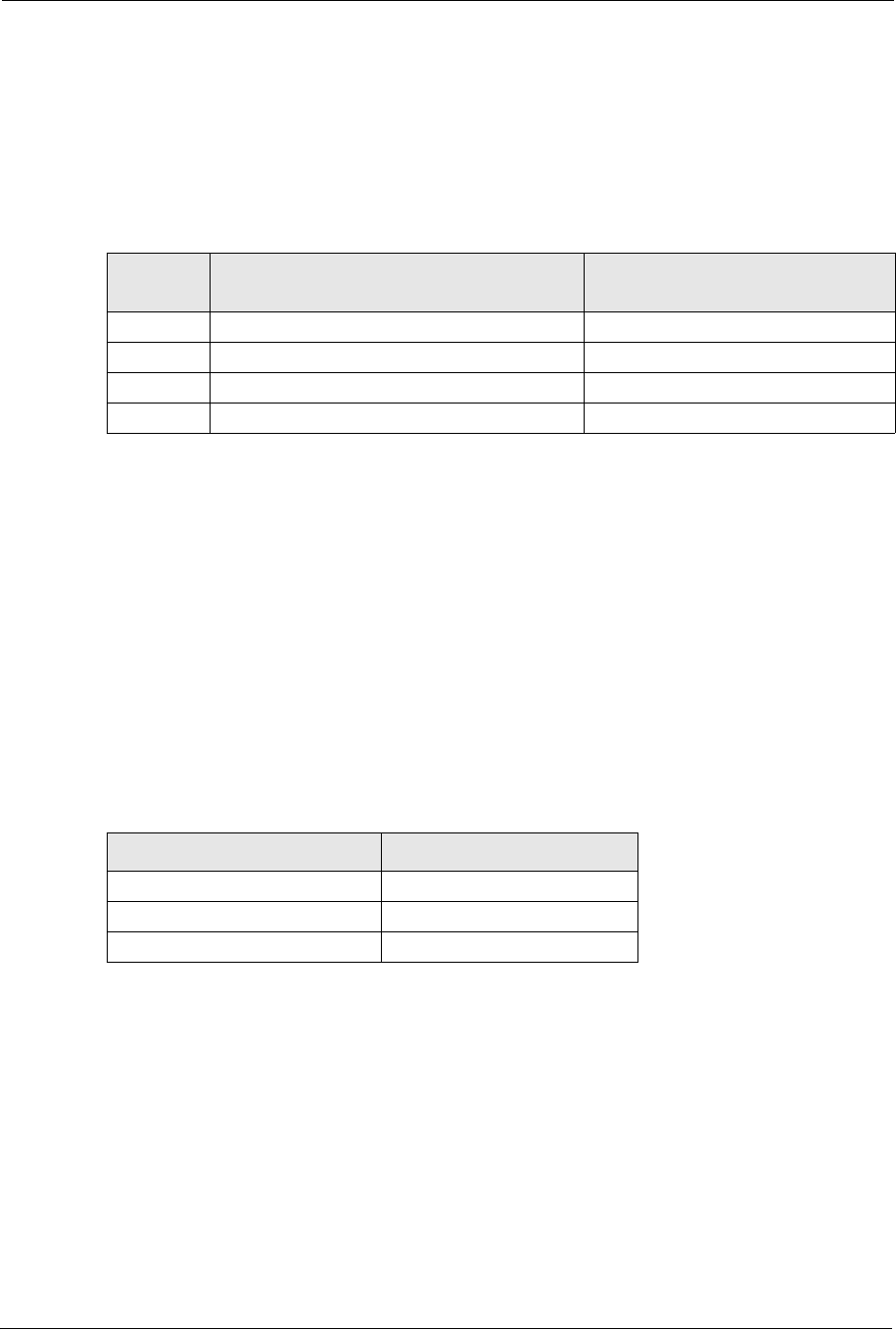
P-660H/HW/W-T Series User’ Guide
377 Appendix D
Since the first octet of a class “A” IP address must contain a “0”, the first octet of a class “A”
address can have a value of 0 to 127.
Similarly the first octet of a class “B” must begin with “10”, therefore the first octet of a class
“B” address has a valid range of 128 to 191. The first octet of a class “C” address begins with
“110”, and therefore has a range of 192 to 223.
Subnet Masks
A subnet mask is used to determine which bits are part of the network number, and which bits
are part of the host ID (using a logical AND operation). A subnet mask has 32 is a “1” then
the corresponding bit in the IP address is part of the network number. If a bit in the subnet
mask is “0” then the corresponding bit in the IP address is part of the host ID.
Subnet masks are expressed in dotted decimal notation just as IP addresses are. The “natural”
masks for class A, B and C IP addresses are as follows.
Subnetting
With subnetting, the class arrangement of an IP address is ignored. For example, a class C
address no longer has to have 24 bits of network number and 8 bits of host ID. With
subnetting, some of the host ID bits are converted into network number bits. By convention,
subnet masks always consist of a continuous sequence of ones beginning from the left most bit
of the mask, followed by a continuous sequence of zeros, for a total number of 32 bits.
Table 125 Allowed IP Address Range By Class
CLASS ALLOWED RANGE OF FIRST OCTET
(BINARY)
ALLOWED RANGE OF FIRST OCTET
(DECIMAL)
Class A 00000000 to 01111111 0 to 127
Class B 10000000 to 10111111 128 to 191
Class C 11000000 to 11011111 192 to 223
Class D 11100000 to 11101111 224 to 239
Table 126 “Natural” Masks
CLASS NATURAL MASK
A255.0.0.0
B255.255.0.0
C255.255.255.0

P-660H/HW/W-T Series User’ Guide
Appendix D 378
Since the mask is always a continuous number of ones beginning from the left, followed by a
continuous number of zeros for the remainder of the 32 bit mask, you can simply specify the
number of ones instead of writing the value of each octet. This is usually specified by writing
a “/” followed by the number of bits in the mask after the address.
For example, 192.1.1.0 /25 is equivalent to saying 192.1.1.0 with mask 255.255.255.128.
The following table shows all possible subnet masks for a class “C” address using both
notations.
The first mask shown is the class “C” natural mask. Normally if no mask is specified it is
understood that the natural mask is being used.
Example: Two Subnets
As an example, you have a class “C” address 192.168.1.0 with subnet mask of 255.255.255.0.
The first three octets of the address make up the network number (class “C”). You want to
have two separate networks.
Divide the network 192.168.1.0 into two separate subnets by converting one of the host ID bits
of the IP address to a network number bit. The “borrowed” host ID bit can be either “0” or “1”
thus giving two subnets; 192.168.1.0 with mask 255.255.255.128 and 192.168.1.128 with
mask 255.255.255.128.
Table 127 Alternative Subnet Mask Notation
SUBNET MASK SUBNET MASK “1” BITS LAST OCTET BIT VALUE
255.255.255.0 /24 0000 0000
255.255.255.128 /25 1000 0000
255.255.255.192 /26 1100 0000
255.255.255.224 /27 1110 0000
255.255.255.240 /28 1111 0000
255.255.255.248 /29 1111 1000
255.255.255.252 /30 1111 1100
Table 128 Two Subnets Example
IP/SUBNET MASK NETWORK NUMBER HOST ID
IP Address 192.168.1. 0
IP Address (Binary) 11000000.10101000.00000001. 00000000
Subnet Mask 255.255.255. 0
Subnet Mask (Binary) 11111111.11111111.11111111. 00000000
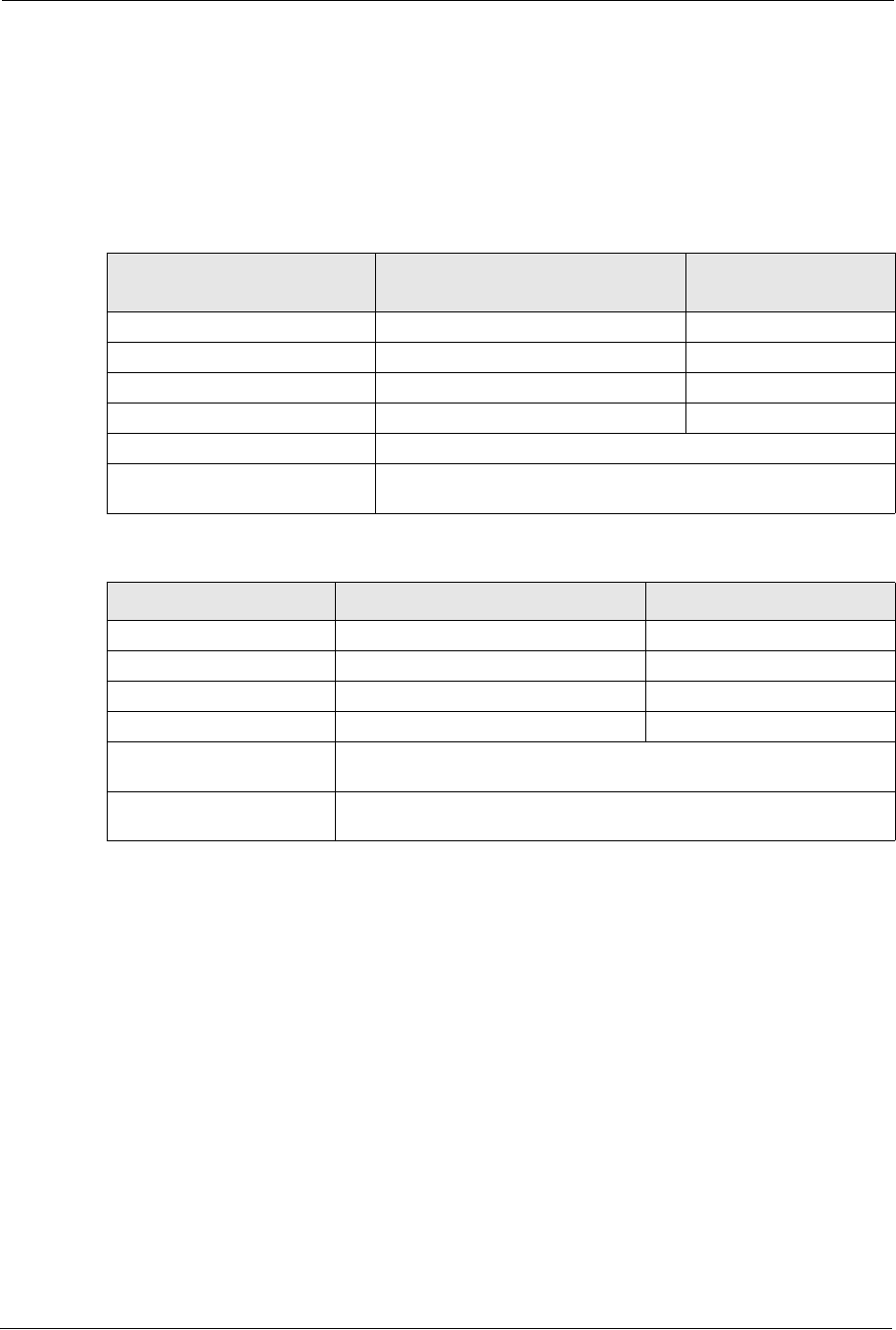
P-660H/HW/W-T Series User’ Guide
379 Appendix D
Note: In the following charts, shaded/bolded last octet bit values indicate host ID bits
“borrowed” to form network ID bits. The number of “borrowed” host ID bits determines
the number of subnets you can have. The remaining number of host ID bits (after
“borrowing”) determines the number of hosts you can have on each subnet.
The remaining 7 bits determine the number of hosts each subnet can have. Host IDs of all
zeros represent the subnet itself and host IDs of all ones are the broadcast address for that
subnet, so the actual number of hosts available on each subnet in the example above is 27 – 2
or 126 hosts for each subnet.
192.168.1.0 with mask 255.255.255.128 is the subnet itself, and 192.168.1.127 with mask
255.255.255.128 is the directed broadcast address for the first subnet. Therefore, the lowest IP
address that can be assigned to an actual host for the first subnet is 192.168.1.1 and the highest
is 192.168.1.126. Similarly the host ID range for the second subnet is 192.168.1.129 to
192.168.1.254.
Table 129 Subnet 1
IP/SUBNET MASK NETWORK NUMBER LAST OCTET BIT
VALUE
IP Address 192.168.1. 0
IP Address (Binary) 11000000.10101000.00000001. 00000000
Subnet Mask 255.255.255. 128
Subnet Mask (Binary) 11111111.11111111.11111111. 10000000
Subnet Address: 192.168.1.0 Lowest Host ID: 192.168.1.1
Broadcast Address:
192.168.1.127
Highest Host ID: 192.168.1.126
Table 130 Subnet 2
IP/SUBNET MASK NETWORK NUMBER LAST OCTET BIT VALUE
IP Address 192.168.1. 128
IP Address (Binary) 11000000.10101000.00000001. 10000000
Subnet Mask 255.255.255. 128
Subnet Mask (Binary) 11111111.11111111.11111111. 10000000
Subnet Address:
192.168.1.128
Lowest Host ID: 192.168.1.129
Broadcast Address:
192.168.1.255
Highest Host ID: 192.168.1.254
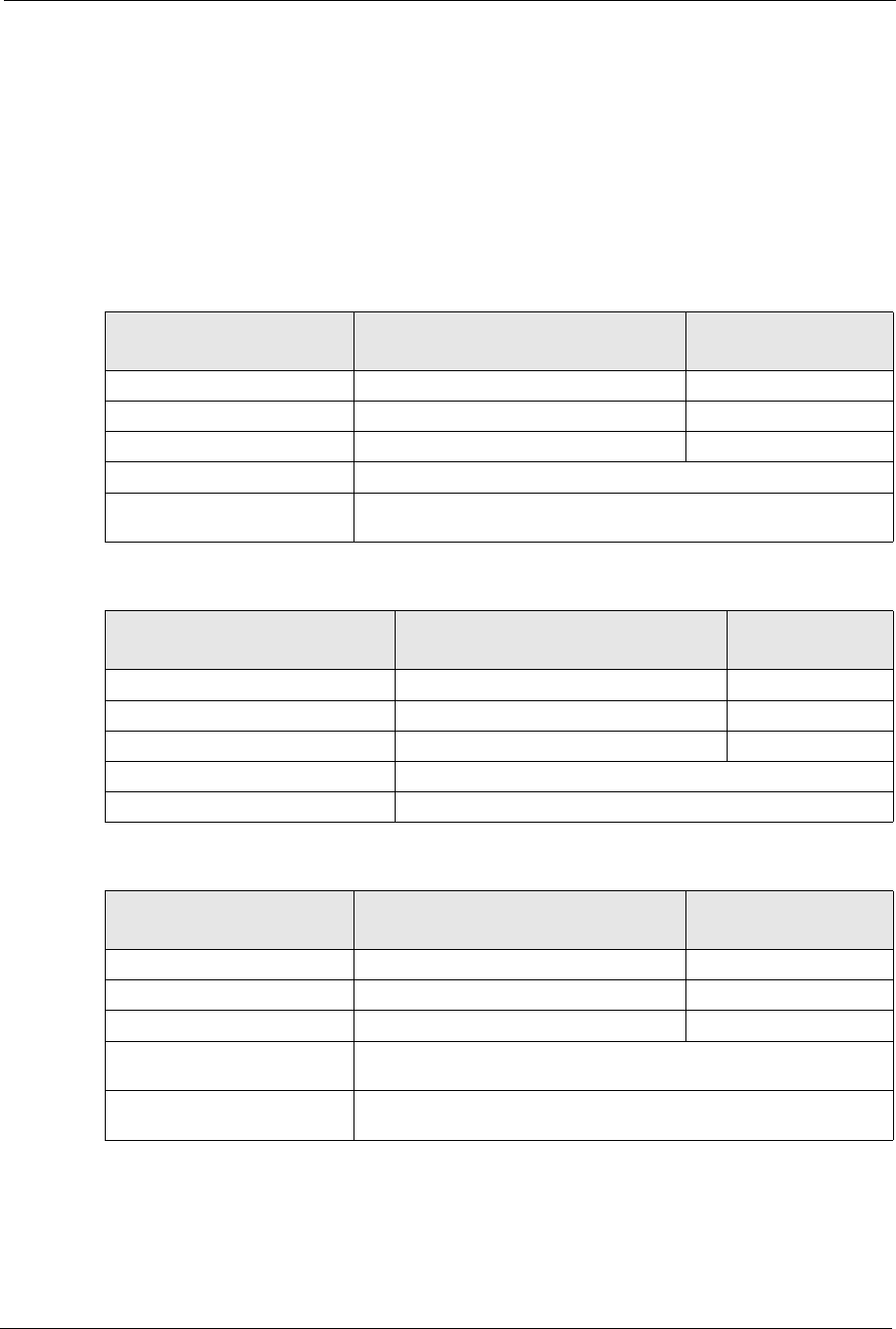
P-660H/HW/W-T Series User’ Guide
Appendix D 380
Example: Four Subnets
The above example illustrated using a 25-bit subnet mask to divide a class “C” address space
into two subnets. Similarly to divide a class “C” address into four subnets, you need to
“borrow” two host ID bits to give four possible combinations of 00, 01, 10 and 11. The subnet
mask is 26 bits (11111111.11111111.11111111.11000000) or 255.255.255.192. Each subnet
contains 6 host ID bits, giving 26-2 or 62 hosts for each subnet (all 0’s is the subnet itself, all
1’s is the broadcast address on the subnet).
Table 131 Subnet 1
IP/SUBNET MASK NETWORK NUMBER LAST OCTET BIT
VALUE
IP Address 192.168.1. 0
IP Address (Binary) 11000000.10101000.00000001. 00000000
Subnet Mask (Binary) 11111111.11111111.11111111. 11000000
Subnet Address: 192.168.1.0 Lowest Host ID: 192.168.1.1
Broadcast Address:
192.168.1.63
Highest Host ID: 192.168.1.62
Table 132 Subnet 2
IP/SUBNET MASK NETWORK NUMBER LAST OCTET BIT
VALUE
IP Address 192.168.1. 64
IP Address (Binary) 11000000.10101000.00000001. 01000000
Subnet Mask (Binary) 11111111.11111111.11111111. 11000000
Subnet Address: 192.168.1.64 Lowest Host ID: 192.168.1.65
Broadcast Address: 192.168.1.127 Highest Host ID: 192.168.1.126
Table 133 Subnet 3
IP/SUBNET MASK NETWORK NUMBER LAST OCTET BIT
VALUE
IP Address 192.168.1. 128
IP Address (Binary) 11000000.10101000.00000001. 10000000
Subnet Mask (Binary) 11111111.11111111.11111111. 11000000
Subnet Address:
192.168.1.128
Lowest Host ID: 192.168.1.129
Broadcast Address:
192.168.1.191
Highest Host ID: 192.168.1.190
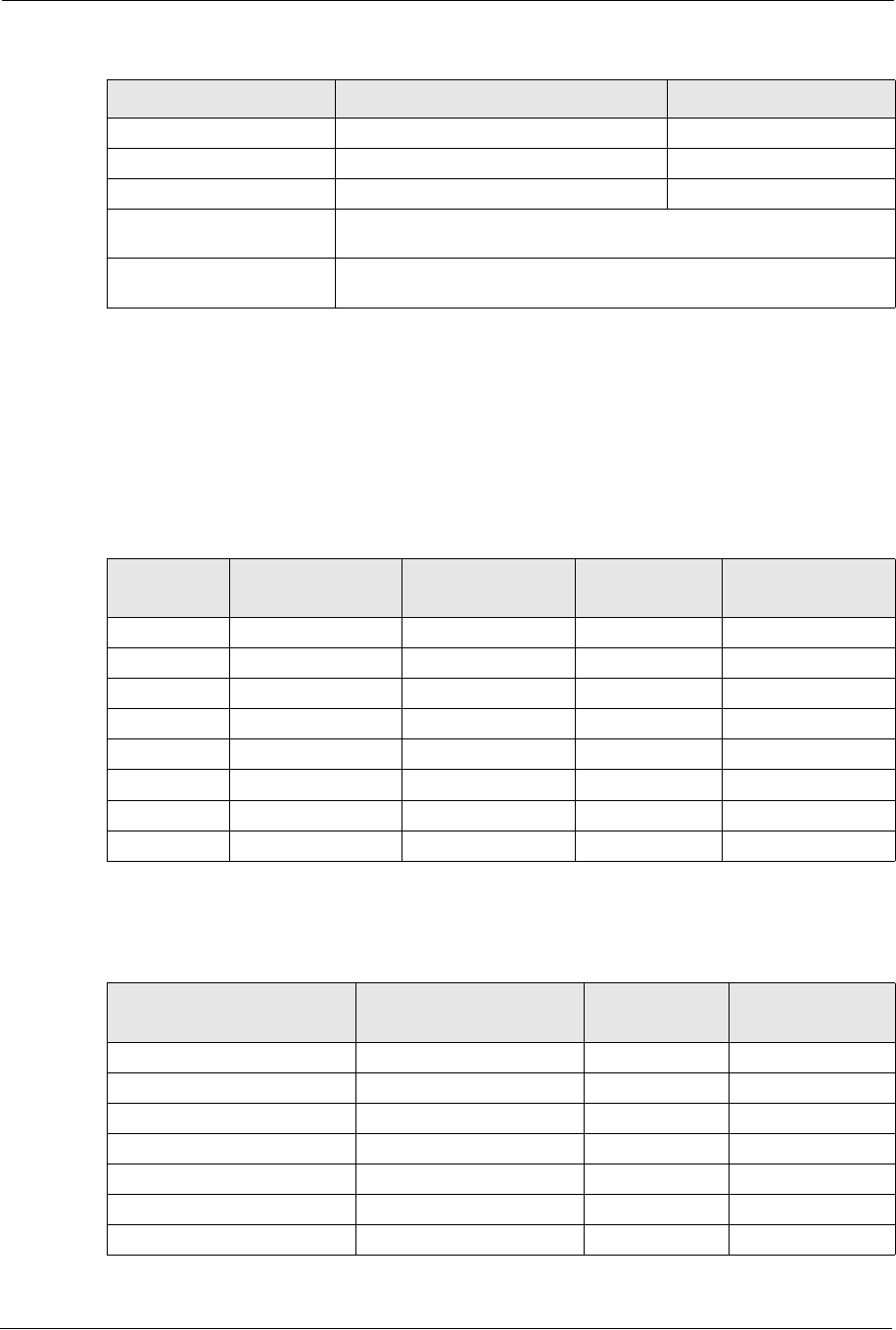
P-660H/HW/W-T Series User’ Guide
381 Appendix D
Example Eight Subnets
Similarly use a 27-bit mask to create 8 subnets (001, 010, 011, 100, 101, 110).
The following table shows class C IP address last octet values for each subnet.
The following table is a summary for class “C” subnet planning.
Table 134 Subnet 4
IP/SUBNET MASK NETWORK NUMBER LAST OCTET BIT VALUE
IP Address 192.168.1. 192
IP Address (Binary) 11000000.10101000.00000001. 11000000
Subnet Mask (Binary) 11111111.11111111.11111111. 11000000
Subnet Address:
192.168.1.192
Lowest Host ID: 192.168.1.193
Broadcast Address:
192.168.1.255
Highest Host ID: 192.168.1.254
Table 135 Eight Subnets
SUBNET SUBNET ADDRESS FIRST ADDRESS LAST ADDRESS BROADCAST
ADDRESS
1 0 1 30 31
232 33 62 63
364 65 94 95
496 97 126 127
5128 129 158 159
6160 161 190 191
7192 193 222 223
8224 225 254 255
Table 136 Class C Subnet Planning
NO. “BORROWED” HOST
BITS SUBNET MASK NO. SUBNETS NO. HOSTS PER
SUBNET
1255.255.255.128 (/25) 2126
2255.255.255.192 (/26) 462
3255.255.255.224 (/27) 830
4255.255.255.240 (/28) 16 14
5255.255.255.248 (/29) 32 6
6255.255.255.252 (/30) 64 2
7255.255.255.254 (/31) 128 1

P-660H/HW/W-T Series User’ Guide
Appendix D 382
Subnetting With Class A and Class B Networks.
For class “A” and class “B” addresses the subnet mask also determines which bits are part of
the network number and which are part of the host ID.
A class “B” address has two host ID octets available for subnetting and a class “A” address has
three host ID octets (see Table 124 on page 376) available for subnetting.
The following table is a summary for class “B” subnet planning.
Table 137 Class B Subnet Planning
NO. “BORROWED” HOST
BITS SUBNET MASK NO. SUBNETS NO. HOSTS PER
SUBNET
1255.255.128.0 (/17) 232766
2255.255.192.0 (/18) 416382
3255.255.224.0 (/19) 88190
4255.255.240.0 (/20) 16 4094
5255.255.248.0 (/21) 32 2046
6255.255.252.0 (/22) 64 1022
7255.255.254.0 (/23) 128 510
8255.255.255.0 (/24) 256 254
9255.255.255.128 (/25) 512 126
10 255.255.255.192 (/26) 1024 62
11 255.255.255.224 (/27) 2048 30
12 255.255.255.240 (/28) 4096 14
13 255.255.255.248 (/29) 8192 6
14 255.255.255.252 (/30) 16384 2
15 255.255.255.254 (/31) 32768 1

P-660H/HW/W-T Series User’ Guide
383 Appendix D

P-660H/HW/W-T Series User’ Guide
Appendix E 384
Appendix E
Boot Commands
The BootModule AT commands execute from within the router’s bootup software, when
debug mode is selected before the main router firmware is started. When you start up your
Prestige, you are given a choice to go into debug mode by pressing a key at the prompt shown
in the following screen. In debug mode you have access to a series of boot module commands,
for example ATUR (for uploading firmware) and ATLC (for uploading the configuration file).
These are already discussed in the Firmware and Configuration File Maintenance chapter.
Figure 256 Option to Enter Debug Mode
Enter ATHE to view all available Prestige boot module commands as shown in the next
screen. ATBAx allows you to change the console port speed. The x denotes the number
preceding the colon to give the console port speed following the colon in the list of numbers
that follows; for example ATBA3 will give a console port speed of 9.6 Kbps. ATSE displays
the seed that is used to generate a password to turn on the debug flag in the firmware. The
ATSH command shows product related information such as boot module version, vendor
name, product model, RAS code revision, etc. ATGO allows you to continue booting the
system. Most other commands aid in advanced troubleshooting and should only be used by
qualified engineers.
Bootbase Version: V1.02 | 08/08/2001 15:40:50
RAM: Size = 16384 Kbytes
DRAM Post: Testing: 16384K OK
FLASH: Intel 16M
RAS Version: V3.50(WB.0)b3 | 08/08/2001 16:21:27
Press any key to enter debug mode within 3
seconds.
.................................................

P-660H/HW/W-T Series User’ Guide
385 Appendix E
Figure 257 Boot Module Commands
AT just answer OK
ATHE print help
ATBAx change baudrate. 1:38.4k, 2:19.2k, 3:9.6k 4:57.6k
5:115.2k
ATENx,(y) set BootExtension Debug Flag (y=password)
ATSE show the seed of password generator
ATTI(h,m,s) change system time to hour:min:sec or show
current time
ATDA(y,m,d) change system date to year/month/day or show
current date
ATDS dump RAS stack
ATDT dump Boot Module Common Area
ATDUx,y dump memory contents from address x for length y
ATRBx display the 8-bit value of address x
ATRWx display the 16-bit value of address x
ATRLx display the 32-bit value of address x
ATGO(x) run program at addr x or boot router
ATGR boot router
ATGT run Hardware Test Program
ATRTw,x,y(,z) RAM test level w, from address x to y (z
iterations)
ATSH dump manufacturer related data in ROM
ATDOx,y download from address x for length y to PC via
XMODEM
ATTD download router configuration to PC via XMODEM
ATUR upload router firmware to flash ROM
ATLC upload router configuration file to flash ROM
ATXSx xmodem select: x=0: CRC mode(default); x=1:
checksum mode
ATSR system reboot

P-660H/HW/W-T Series User’ Guide
Appendix F 386
Appendix F
Command Interpreter
The following describes how to use the command interpreter. Enter 24 in the main menu to
bring up the system maintenance menu. Enter 8 to go to Menu 24.8 - Command Interpreter
Mode. See the included disk or zyxel.com for more detailed information on these commands.
Note: Use of undocumented commands or misconfiguration can damage the unit and
possibly render it unusable.
Command Syntax
• The command keywords are in courier new font.
• Enter the command keywords exactly as shown, do not abbreviate.
• The required fields in a command are enclosed in angle brackets <>.
• The optional fields in a command are enclosed in square brackets [].
•The |symbol means or.
For example,
sys filter netbios config <type> <on|off>
means that you must specify the type of netbios filter and whether to turn it on or off.
Command Usage
A list of valid commands can be found by typing help or? at the command prompt. Always
type the full command. Type exit to return to the SMT main menu when finished.

P-660H/HW/W-T Series User’ Guide
387 Appendix F

P-660H/HW/W-T Series User’ Guide
Appendix G 388
Appendix G
Firewall Commands
The following describes the firewall commands.
Table 138 Firewall Commands
FUNCTION COMMAND DESCRIPTION
Firewall SetUp
config edit firewall active
<yes | no>
This command turns the firewall on or off.
config retrieve firewall This command returns the previously saved
firewall settings.
config save firewall This command saves the current firewall
settings.
Display
config display firewall This command shows the of all the firewall
settings including e-mail, attack, and the sets/
rules.
config display firewall set
<set #>
This command shows the current
configuration of a set; including timeout
values, name, default-permit, and etc.If you
don’t put use a number (#) after “set”,
information about all of the sets/rules appears.
config display firewall set
<set #> rule <rule #>
This command shows the current entries of a
rule in a firewall rule set.
config display firewall attack This command shows all of the attack
response settings.
config display firewall e-mail This command shows all of the e-mail
settings.
config display firewall? This command shows all of the available
firewall sub commands.
Edit
E-mail config edit firewall e-mail
mail-server <ip address of
mail server>
This command sets the IP address to which
the e-mail messages are sent.

P-660H/HW/W-T Series User’ Guide
389 Appendix G
config edit firewall e-mail
return-addr <e-mail address>
This command sets the source e-mail address
of the firewall e-mails.
config edit firewall e-mail
email-to <e-mail address>
This command sets the e-mail address to
which the firewall e-mails are sent.
config edit firewall e-mail
policy <full | hourly | daily |
weekly>
This command sets how frequently the firewall
log is sent via e-mail.
config edit firewall e-mail
day <sunday | monday | tuesday
| wednesday | thursday | friday
| saturday>
This command sets the day on which the
current firewall log is sent through e-mail if the
Prestige is set to send it on a weekly basis.
config edit firewall e-mail
hour <0-23>
This command sets the hour when the firewall
log is sent through e- mail if the Prestige is set
to send it on an hourly, daily or weekly basis.
config edit firewall e-mail
minute <0-59>
This command sets the minute of the hour for
the firewall log to be sent via e- mail if the
Prestige is set to send it on a hourly, daily or
weekly basis.
Attack config edit firewall attack
send-alert <yes | no>
This command enables or disables the
immediate sending of DOS attack notification
e-mail messages.
config edit firewall attack
block <yes | no>
Set this command to yes to block new traffic
after the tcp-max-incomplete threshold is
exceeded. Set it to no to delete the oldest half-
open session when traffic exceeds the tcp-
max-incomplete threshold.
config edit firewall attack
block-minute <0-255>
This command sets the number of minutes for
new sessions to be blocked when the tcp-
max-incomplete threshold is reached. This
command is only valid when block is set to
yes.
config edit firewall attack
minute-high <0-255>
This command sets the threshold rate of new
half-open sessions per minute where the
Prestige starts deleting old half-opened
sessions until it gets them down to the minute-
low threshold.
Table 138 Firewall Commands (continued)
FUNCTION COMMAND DESCRIPTION

P-660H/HW/W-T Series User’ Guide
Appendix G 390
config edit firewall attack
minute-low <0-255>
This command sets the threshold of half-open
sessions where the Prestige stops deleting
half-opened sessions.
config edit firewall attack
max-incomplete-high <0-255>
This command sets the threshold of half-open
sessions where the Prestige starts deleting old
half-opened sessions until it gets them down
to the max incomplete low.
config edit firewall attack
max-incomplete-low <0-255>
This command sets the threshold where the
Prestige stops deleting half-opened sessions.
config edit firewall attack
tcp-max-incomplete <0-255>
This command sets the threshold of half-open
TCP sessions with the same destination
where the Prestige starts dropping half-open
sessions to that destination.
Sets config edit firewall set <set
#> name <desired name>
This command sets a name to identify a
specified set.
Config edit firewall set <set
#> default-permit <forward |
block>
This command sets whether a packet is
dropped or allowed through, when it does not
meet a rule within the set.
Config edit firewall set <set
#> icmp-timeout <seconds>
This command sets the time period to allow an
ICMP session to wait for the ICMP response.
Config edit firewall set <set
#> udp-idle-timeout <seconds>
This command sets how long a UDP
connection is allowed to remain inactive
before the Prestige considers the connection
closed.
Config edit firewall set <set
#> connection-timeout
<seconds>
This command sets how long Prestige waits
for a TCP session to be established before
dropping the session.
Config edit firewall set <set
#> fin-wait-timeout <seconds>
This command sets how long the Prestige
leaves a TCP session open after the firewall
detects a FIN-exchange (indicating the end of
the TCP session).
Config edit firewall set <set
#> tcp-idle-timeout <seconds>
This command sets how long Prestige lets an
inactive TCP connection remain open before
considering it closed.
Table 138 Firewall Commands (continued)
FUNCTION COMMAND DESCRIPTION

P-660H/HW/W-T Series User’ Guide
391 Appendix G
Config edit firewall set <set
#> log <yes | no>
This command sets whether or not the
Prestige creates logs for packets that match
the firewall’s default rule set.
Rules Config edit firewall set <set
#> rule <rule #> permit
<forward | block>
This command sets whether packets that
match this rule are dropped or allowed
through.
Config edit firewall set <set
#> rule <rule #> active <yes |
no>
This command sets whether a rule is enabled
or not.
Config edit firewall set <set
#> rule <rule #> protocol
<integer protocol value >
This command sets the protocol specification
number made in this rule for ICMP.
Config edit firewall set <set
#> rule <rule #> log <none |
match | not-match | both>
This command sets the Prestige to log traffic
that matches the rule, doesn't match, both or
neither.
Config edit firewall set <set
#> rule <rule #> alert <yes |
no>
This command sets whether or not the
Prestige sends an alert e-mail when a DOS
attack or a violation of a particular rule occurs.
config edit firewall set <set
#> rule <rule #> srcaddr-
single <ip address>
This command sets the rule to have the
Prestige check for traffic with this individual
source address.
config edit firewall set <set
#> rule <rule #> srcaddr-
subnet <ip address> <subnet
mask>
This command sets a rule to have the Prestige
check for traffic from a particular subnet
(defined by IP address and subnet mask).
config edit firewall set <set
#> rule <rule #> srcaddr-range
<start ip address> <end ip
address>
This command sets a rule to have the Prestige
check for traffic from this range of addresses.
config edit firewall set <set
#> rule <rule #> destaddr-
single <ip address>
This command sets the rule to have the
Prestige check for traffic with this individual
destination address.
config edit firewall set <set
#> rule <rule #> destaddr-
subnet <ip address> <subnet
mask>
This command sets a rule to have the Prestige
check for traffic with a particular subnet
destination (defined by IP address and subnet
mask).
Table 138 Firewall Commands (continued)
FUNCTION COMMAND DESCRIPTION

P-660H/HW/W-T Series User’ Guide
Appendix G 392
config edit firewall set <set
#> rule <rule #> destaddr-
range <start ip address> <end
ip address>
This command sets a rule to have the Prestige
check for traffic going to this range of
addresses.
config edit firewall set <set
#> rule <rule #> TCP destport-
single <port #>
This command sets a rule to have the Prestige
check for TCP traffic with this destination
address. You may repeat this command to
enter various, non-consecutive port numbers.
config edit firewall set <set
#> rule <rule #> TCP destport-
range <start port #> <end port
#>
This command sets a rule to have the Prestige
check for TCP traffic with a destination port in
this range.
config edit firewall set <set
#> rule <rule #> UDP destport-
single <port #>
This command sets a rule to have the Prestige
check for UDP traffic with this destination
address. You may repeat this command to
enter various, non-consecutive port numbers.
config edit firewall set <set
#> rule <rule #> UDP destport-
range <start port #> <end port
#>
This command sets a rule to have the Prestige
check for UDP traffic with a destination port in
this range.
Delete
config delete firewall e-mail This command removes all of the settings for
e-mail alert.
config delete firewall attack This command resets all of the attack
response settings to their defaults.
config delete firewall set
<set #>
This command removes the specified set from
the firewall configuration.
config delete firewall set
<set #> rule<rule #>
This command removes the specified rule in a
firewall configuration set.
Table 138 Firewall Commands (continued)
FUNCTION COMMAND DESCRIPTION

P-660H/HW/W-T Series User’ Guide
393 Appendix G

P-660H/HW/W-T Series User’ Guide
Appendix H 394
Appendix H
NetBIOS Filter Commands
The following describes the NetBIOS packet filter commands.
Introduction
NetBIOS (Network Basic Input/Output System) are TCP or UDP broadcast packets that
enable a computer to connect to and communicate with a LAN.
For some dial-up services such as PPPoE or PPTP, NetBIOS packets cause unwanted calls.
You can configure NetBIOS filters to do the following:
• Allow or disallow the sending of NetBIOS packets from the LAN to the WAN and from
the WAN to the LAN.
• Allow or disallow the sending of NetBIOS packets from the LAN to the DMZ and from
the DMZ to the LAN.
• Allow or disallow the sending of NetBIOS packets from the WAN to the DMZ and from
the DMZ to the WAN.
• Allow or disallow the sending of NetBIOS packets through VPN connections.
• Allow or disallow NetBIOS packets to initiate calls.
Display NetBIOS Filter Settings
This command gives a read-only list of the current NetBIOS filter modes for The Prestige.
NetBIOS Display Filter Settings Command Example
Syntax: sys filter netbios disp
=========== NetBIOS Filter Status ===========
Between LAN and WAN: Block
Between LAN and DMZ: Block
Between WAN and DMZ: Block
IPSec Packets: Forward
Trigger Dial: Disabled

P-660H/HW/W-T Series User’ Guide
395 Appendix H
The filter types and their default settings are as follows.
NetBIOS Filter Configuration
Syntax:sys filter netbios config <type> <on|off>
where
Table 139 NetBIOS Filter Default Settings
NAME DESCRIPTION EXAMPLE
Between LAN
and WAN
This field displays whether NetBIOS packets are blocked or forwarded
between the LAN and the WAN.
Block
Between LAN
and DMZ
This field displays whether NetBIOS packets are blocked or forwarded
between the LAN and the DMZ.
Block
Between WAN
and DMZ
This field displays whether NetBIOS packets are blocked or forwarded
between the WAN and the DMZ.
Block
IPSec Packets This field displays whether NetBIOS packets sent through a VPN
connection are blocked or forwarded.
Forward
Trigger dial This field displays whether NetBIOS packets are allowed to initiate
calls. Disabled means that NetBIOS packets are blocked from initiating
calls.
Disabled
<type> = Identify which NetBIOS filter (numbered 0-3) to configure.
0 = Between LAN and WAN
1 = Between LAN and DMZ
2 = Between WAN and DMZ
3 = IPSec packet pass through
4 = Trigger Dial
<on|off> = For type 0 and 1, use on to enable the filter and block NetBIOS
packets. Use off to disable the filter and forward NetBIOS packets.
For type 3, use on to block NetBIOS packets from being sent
through a VPN connection. Use off to allow NetBIOS packets to be
sent through a VPN connection.
For type 4, use on to allow NetBIOS packets to initiate dial backup
calls. Use off to block NetBIOS packets from initiating dial backup
calls.
Example commands
sys filter netbios
config 0 on
This command blocks LAN to WAN and WAN to LAN NetBIOS
packets.
sys filter netbios
config 1 off
This command forwards LAN to DMZ and DMZ to LAN NetBIOS
packets.

P-660H/HW/W-T Series User’ Guide
Appendix H 396
sys filter netbios
config 3 on
This command blocks IPSec NetBIOS packets.
sys filter netbios
config 4 off
This command stops NetBIOS commands from initiating calls.

P-660H/HW/W-T Series User’ Guide
397 Appendix H
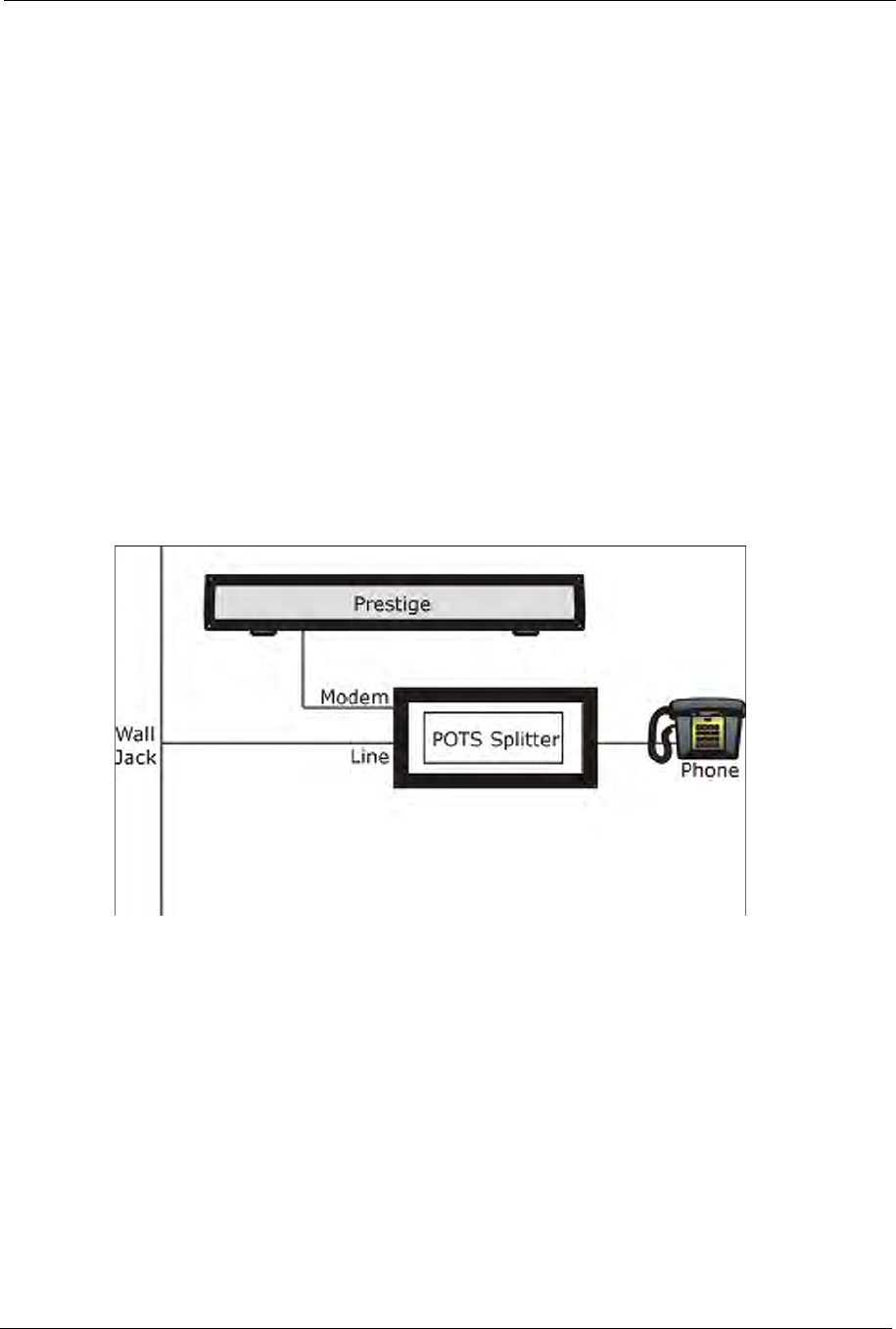
P-660H/HW/W-T Series User’ Guide
Appendix I 398
Appendix I
Splitters and Microfilters
This appendix tells you how to install a POTS splitter or a telephone microfilter.
Connecting a POTS Splitter
When you use the Full Rate (G.dmt) ADSL standard, you can use a POTS (Plain Old
Telephone Service) splitter to separate the telephone and ADSL signals. This allows
simultaneous Internet access and telephone service on the same line. A splitter also eliminates
the destructive interference conditions caused by telephone sets.
Install the POTS splitter at the point where the telephone line enters your residence, as shown
in the following figure.
Figure 258 Connecting a POTS Splitter
1Connect the side labeled “Phone” to your telephone.
2Connect the side labeled “Modem” to your Prestige.
3Connect the side labeled “Line” to the telephone wall jack.
Telephone Microfilters
Telephone voice transmissions take place in the lower frequency range, 0 - 4KHz, while
ADSL transmissions take place in the higher bandwidth range, above 4KHz. A microfilter acts
as a low-pass filter, for your telephone, to ensure that ADSL transmissions do not interfere
with your telephone voice transmissions. The use of a telephone microfilter is optional.
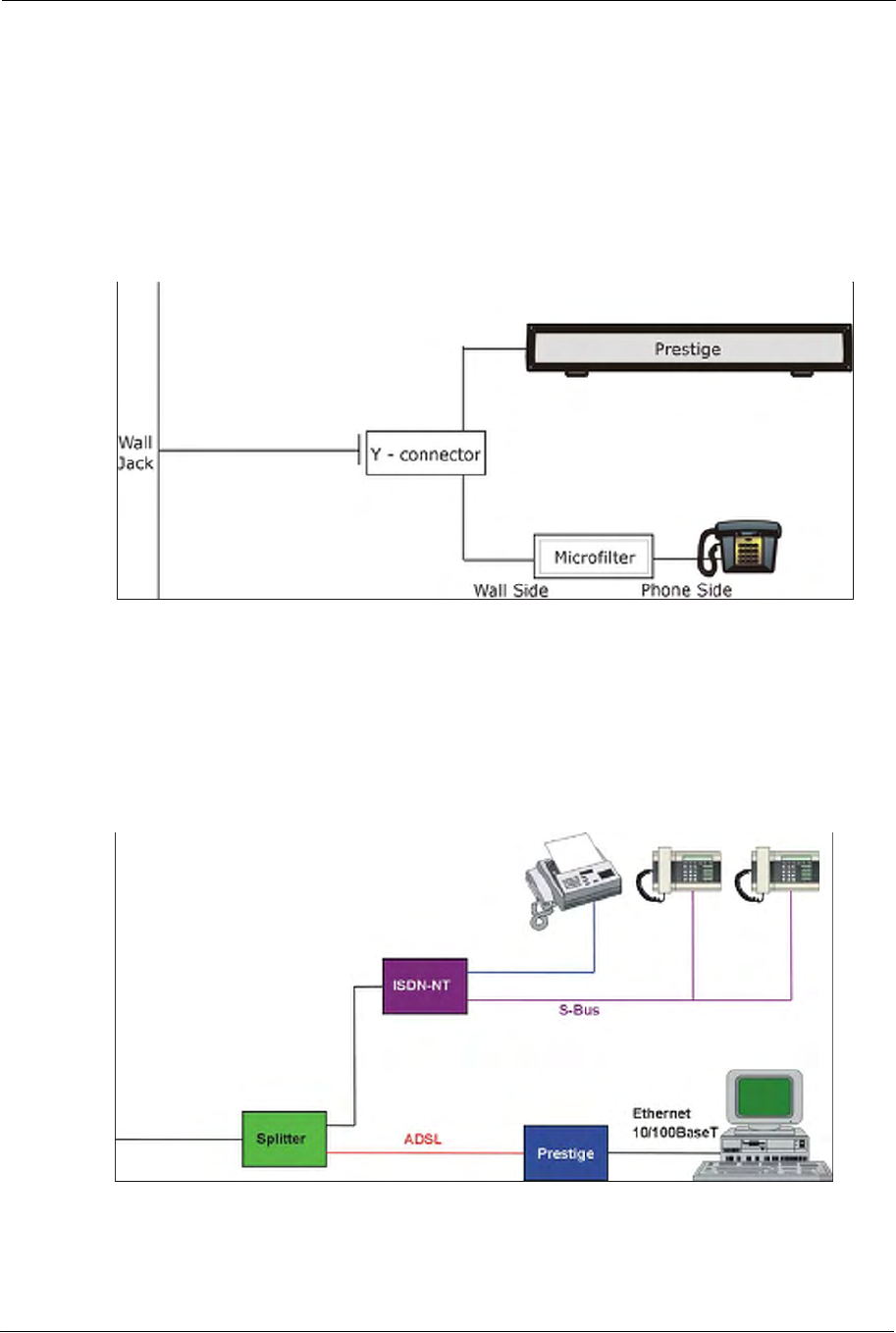
P-660H/HW/W-T Series User’ Guide
399 Appendix I
1Connect a phone cable from the wall jack to the single jack end of the Y- Connector.
2Connect a cable from the double jack end of the Y-Connector to the “wall side” of the
microfilter.
3Connect another cable from the double jack end of the Y-Connector to the Prestige.
4Connect the “phone side” of the microfilter to your telephone as shown in the following
figure.
Figure 259 Connecting a Microfilter
Prestige With ISDN
This section relates to people who use their Prestige with ADSL over ISDN (digital telephone
service) only. The following is an example installation for the Prestige with ISDN.
Figure 260 Prestige with ISDN

P-660H/HW/W-T Series User’ Guide
Appendix I 400

P-660H/HW/W-T Series User’ Guide
401 Appendix I

P-660H/HW/W-T Series User’ Guide
Appendix J 402
Appendix J
PPPoE
PPPoE in Action
An ADSL modem bridges a PPP session over Ethernet (PPP over Ethernet, RFC 2516) from
your computer to an ATM PVC (Permanent Virtual Circuit) which connects to a DSL Access
Concentrator where the PPP session terminates (see Figure 261 on page 403). One PVC can
support any number of PPP sessions from your LAN. PPPoE provides access control and
billing functionality in a manner similar to dial-up services using PPP.
Benefits of PPPoE
PPPoE offers the following benefits:
It provides you with a familiar dial-up networking (DUN) user interface.
It lessens the burden on the carriers of provisioning virtual circuits all the way to the ISP on
multiple switches for thousands of users. For GSTN (PSTN and ISDN), the switching fabric
is already in place.
It allows the ISP to use the existing dial-up model to authenticate and (optionally) to provide
differentiated services.
Traditional Dial-up Scenario
The following diagram depicts a typical hardware configuration where the computers use
traditional dial-up networking.
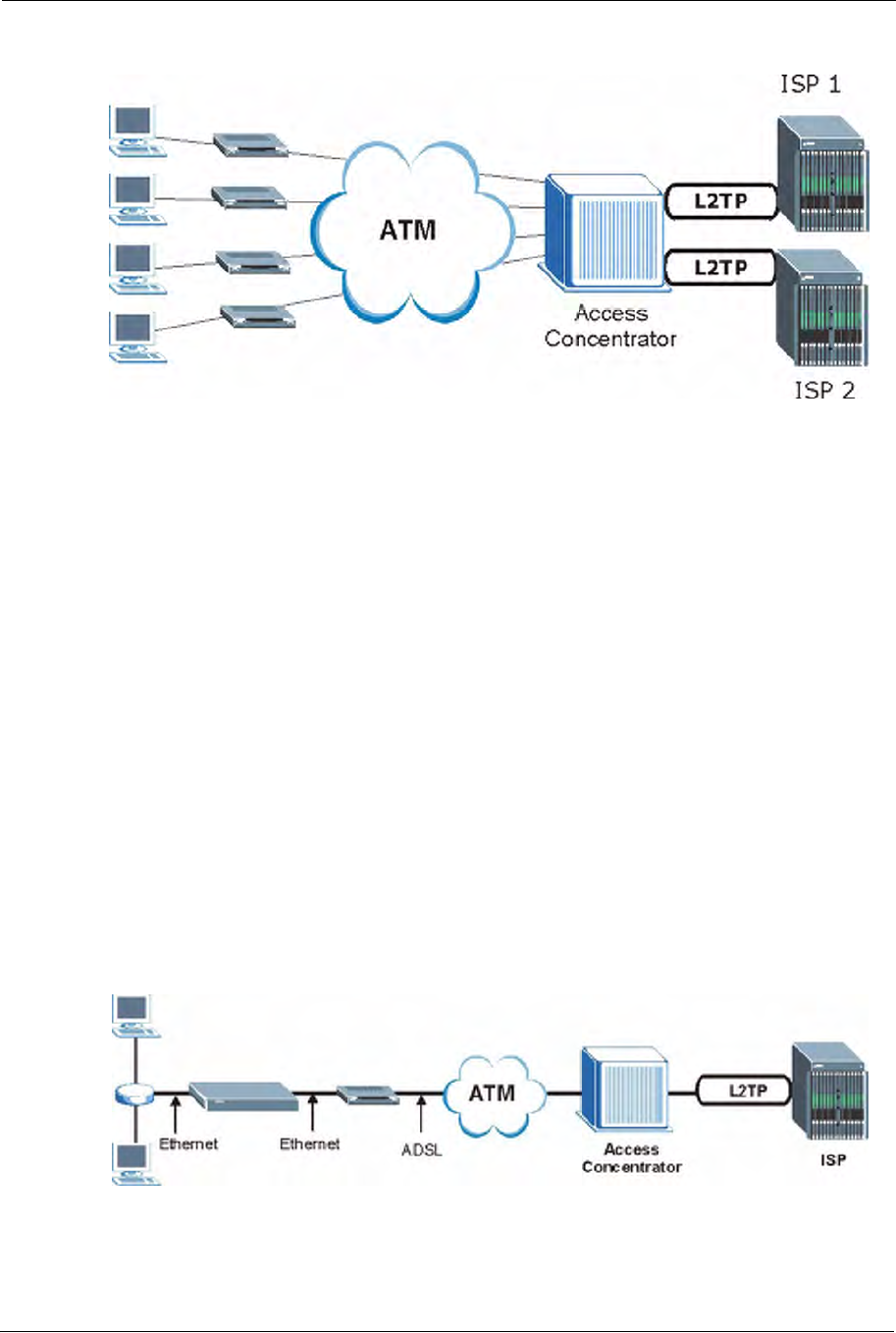
P-660H/HW/W-T Series User’ Guide
403 Appendix J
Figure 261 Single-Computer per Router Hardware Configuration
How PPPoE Works
The PPPoE driver makes the Ethernet appear as a serial link to the computer and the computer
runs PPP over it, while the modem bridges the Ethernet frames to the Access Concentrator
(AC). Between the AC and an ISP, the AC is acting as a L2TP (Layer 2 Tunneling Protocol)
LAC (L2TP Access Concentrator) and tunnels the PPP frames to the ISP. The L2TP tunnel is
capable of carrying multiple PPP sessions.
With PPPoE, the VC (Virtual Circuit) is equivalent to the dial-up connection and is between
the modem and the AC, as opposed to all the way to the ISP. However, the PPP negotiation is
between the computer and the ISP.
Prestige as a PPPoE Client
When using the Prestige as a PPPoE client, the computers on the LAN see only Ethernet and
are not aware of PPPoE. This alleviates the administrator from having to manage the PPPoE
clients on the individual computers.
Figure 262 Prestige as a PPPoE Client

P-660H/HW/W-T Series User’ Guide
Appendix K 404
Appendix K
Log Descriptions
This appendix provides descriptions of example log messages.
Table 140 System Maintenance Logs
LOG MESSAGE DESCRIPTION
Time calibration is
successful
The router has adjusted its time based on information from the
time server.
Time calibration failed The router failed to get information from the time server.
WAN interface gets IP:%s A WAN interface got a new IP address from the DHCP,
PPPoE, PPTP or dial-up server.
DHCP client IP expired A DHCP client's IP address has expired.
DHCP server assigns%s The DHCP server assigned an IP address to a client.
Successful SMT login Someone has logged on to the router's SMT interface.
SMT login failed Someone has failed to log on to the router's SMT interface.
Successful WEB login Someone has logged on to the router's web configurator
interface.
WEB login failed Someone has failed to log on to the router's web configurator
interface.
Successful TELNET login Someone has logged on to the router via telnet.
TELNET login failed Someone has failed to log on to the router via telnet.
Successful FTP login Someone has logged on to the router via ftp.
FTP login failed Someone has failed to log on to the router via ftp.
NAT Session Table is Full! The maximum number of NAT session table entries has been
exceeded and the table is full.
Starting Connectivity Monitor Starting Connectivity Monitor.
Time initialized by Daytime
Server
The router got the time and date from the Daytime server.
Time initialized by Time
server
The router got the time and date from the time server.
Time initialized by NTP
server
The router got the time and date from the NTP server.
Connect to Daytime server
fail
The router was not able to connect to the Daytime server.
Connect to Time server fail The router was not able to connect to the Time server.
Connect to NTP server fail The router was not able to connect to the NTP server.
Too large ICMP packet has
been dropped
The router dropped an ICMP packet that was too large.
SMT Session Begin An SMT management session has started.
SMT Session End An SMT management session has ended.

P-660H/HW/W-T Series User’ Guide
405 Appendix K
Configuration Change: PC =
0x%x, Task ID = 0x%x
The router is saving configuration changes.
Successful SSH login Someone has logged on to the router’s SSH server.
SSH login failed Someone has failed to log on to the router’s SSH server.
Successful HTTPS login Someone has logged on to the router's web configurator
interface using HTTPS protocol.
HTTPS login failed Someone has failed to log on to the router's web configurator
interface using HTTPS protocol.
Table 141 System Error Logs
LOG MESSAGE DESCRIPTION
%s exceeds the max.
number of session per
host!
This attempt to create a NAT session exceeds the maximum
number of NAT session table entries allowed to be created per
host.
setNetBIOSFilter: calloc
error
The router failed to allocate memory for the NetBIOS filter settings.
readNetBIOSFilter: calloc
error
The router failed to allocate memory for the NetBIOS filter settings.
WAN connection is down. A WAN connection is down. You cannot access the network
through this interface.
Table 142 Access Control Logs
LOG MESSAGE DESCRIPTION
Firewall default policy: [TCP |
UDP | IGMP | ESP | GRE | OSPF]
<Packet Direction>
Attempted TCP/UDP/IGMP/ESP/GRE/OSPF access
matched the default policy and was blocked or forwarded
according to the default policy’s setting.
Firewall rule [NOT] match:[TCP |
UDP | IGMP | ESP | GRE | OSPF]
<Packet Direction>, <rule:%d>
Attempted TCP/UDP/IGMP/ESP/GRE/OSPF access
matched (or did not match) a configured firewall rule
(denoted by its number) and was blocked or forwarded
according to the rule.
Triangle route packet forwarded:
[TCP | UDP | IGMP | ESP | GRE |
OSPF]
The firewall allowed a triangle route session to pass
through.
Packet without a NAT table entry
blocked: [TCP | UDP | IGMP | ESP
| GRE | OSPF]
The router blocked a packet that didn't have a
corresponding NAT table entry.
Router sent blocked web site
message: TCP
The router sent a message to notify a user that the router
blocked access to a web site that the user requested.
Table 140 System Maintenance Logs (continued)
LOG MESSAGE DESCRIPTION

P-660H/HW/W-T Series User’ Guide
Appendix K 406
Table 143 TCP Reset Logs
LOG MESSAGE DESCRIPTION
Under SYN flood attack,
sent TCP RST
The router sent a TCP reset packet when a host was under a SYN
flood attack (the TCP incomplete count is per destination host.)
Exceed TCP MAX
incomplete, sent TCP RST
The router sent a TCP reset packet when the number of TCP
incomplete connections exceeded the user configured threshold.
(the TCP incomplete count is per destination host.) Note: Refer to
TCP Maximum Incomplete in the Firewall Attack Alerts screen.
Peer TCP state out of
order, sent TCP RST
The router sent a TCP reset packet when a TCP connection state
was out of order.Note: The firewall refers to RFC793 Figure 6 to
check the TCP state.
Firewall session time
out, sent TCP RST
The router sent a TCP reset packet when a dynamic firewall
session timed out.
The default timeout values are as follows:
ICMP idle timeout: 3 minutes
UDP idle timeout: 3 minutes
TCP connection (three way handshaking) timeout: 270 seconds
TCP FIN-wait timeout: 2 MSL (Maximum Segment Lifetime set in
the TCP header).
TCP idle (established) timeout (s): 150 minutes
TCP reset timeout: 10 seconds
Exceed MAX incomplete,
sent TCP RST
The router sent a TCP reset packet when the number of
incomplete connections (TCP and UDP) exceeded the user-
configured threshold. (Incomplete count is for all TCP and UDP
connections through the firewall.)Note: When the number of
incomplete connections (TCP + UDP) > “Maximum Incomplete
High”, the router sends TCP RST packets for TCP connections
and destroys TOS (firewall dynamic sessions) until incomplete
connections < “Maximum Incomplete Low”.
Access block, sent TCP
RST
The router sends a TCP RST packet and generates this log if you
turn on the firewall TCP reset mechanism (via CI command: "sys
firewall tcprst").
Table 144 Packet Filter Logs
LOG MESSAGE DESCRIPTION
[TCP | UDP | ICMP | IGMP |
Generic] packet filter
matched (set:%d, rule:%d)
Attempted access matched a configured filter rule (denoted by
its set and rule number) and was blocked or forwarded
according to the rule.

P-660H/HW/W-T Series User’ Guide
407 Appendix K
Table 145 ICMP Logs
LOG MESSAGE DESCRIPTION
Firewall default policy: ICMP
<Packet Direction>, <type:%d>,
<code:%d>
ICMP access matched the default policy and was blocked
or forwarded according to the user's setting. For type and
code details, see Table 157 on page 416.
Firewall rule [NOT] match: ICMP
<Packet Direction>, <rule:%d>,
<type:%d>, <code:%d>
ICMP access matched (or didn’t match) a firewall rule
(denoted by its number) and was blocked or forwarded
according to the rule. For type and code details, see
Table 157 on page 416.
Triangle route packet forwarded:
ICMP
The firewall allowed a triangle route session to pass
through.
Packet without a NAT table entry
blocked: ICMP
The router blocked a packet that didn’t have a
corresponding NAT table entry.
Unsupported/out-of-order ICMP:
ICMP
The firewall does not support this kind of ICMP packets or
the ICMP packets are out of order.
Router reply ICMP packet: ICMP The router sent an ICMP reply packet to the sender.
Table 146 CDR Logs
LOG MESSAGE DESCRIPTION
board%d line%d channel%d,
call%d,%s C01 Outgoing Call
dev=%x ch=%x%s
The router received the setup requirements for a call. “call” is
the reference (count) number of the call. “dev” is the device
type (3 is for dial-up, 6 is for PPPoE, 10 is for PPTP).
"channel" or “ch” is the call channel ID.For example,"board 0
line 0 channel 0, call 3, C01 Outgoing Call dev=6 ch=0
"Means the router has dialed to the PPPoE server 3 times.
board%d line%d channel%d,
call%d,%s C02 OutCall
Connected%d%s
The PPPoE, PPTP or dial-up call is connected.
board%d line%d channel%d,
call%d,%s C02 Call Terminated
The PPPoE, PPTP or dial-up call was disconnected.
Table 147 PPP Logs
LOG MESSAGE DESCRIPTION
ppp:LCP Starting The PPP connection’s Link Control Protocol stage has started.
ppp:LCP Opening The PPP connection’s Link Control Protocol stage is opening.
ppp:CHAP Opening The PPP connection’s Challenge Handshake Authentication Protocol stage is
opening.
ppp:IPCP Starting The PPP connection’s Internet Protocol Control Protocol stage is starting.
ppp:IPCP Opening The PPP connection’s Internet Protocol Control Protocol stage is opening.

P-660H/HW/W-T Series User’ Guide
Appendix K 408
ppp:LCP Closing The PPP connection’s Link Control Protocol stage is closing.
ppp:IPCP Closing The PPP connection’s Internet Protocol Control Protocol stage is closing.
Table 148 UPnP Logs
LOG MESSAGE DESCRIPTION
UPnP pass through Firewall UPnP packets can pass through the firewall.
Table 149 Content Filtering Logs
LOG MESSAGE DESCRIPTION
%s: Keyword blocking The content of a requested web page matched a user defined keyword.
%s: Not in trusted web
list
The web site is not in a trusted domain, and the router blocks all traffic
except trusted domain sites.
%s: Forbidden Web site The web site is in the forbidden web site list.
%s: Contains ActiveX The web site contains ActiveX.
%s: Contains Java
applet
The web site contains a Java applet.
%s: Contains cookie The web site contains a cookie.
%s: Proxy mode
detected
The router detected proxy mode in the packet.
%s The content filter server responded that the web site is in the blocked
category list, but it did not return the category type.
%s:%s The content filter server responded that the web site is in the blocked
category list, and returned the category type.
%s(cache hit) The system detected that the web site is in the blocked list from the
local cache, but does not know the category type.
%s:%s(cache hit) The system detected that the web site is in blocked list from the local
cache, and knows the category type.
%s: Trusted Web site The web site is in a trusted domain.
%s When the content filter is not on according to the time schedule or you
didn't select the "Block Matched Web Site” check box, the system
forwards the web content.
Waiting content filter
server timeout
The external content filtering server did not respond within the timeout
period.
DNS resolving failed The Prestige cannot get the IP address of the external content filtering
via DNS query.
Creating socket failed The Prestige cannot issue a query because TCP/IP socket creation
failed, port:port number.
Table 147 PPP Logs (continued)
LOG MESSAGE DESCRIPTION

P-660H/HW/W-T Series User’ Guide
409 Appendix K
Connecting to content
filter server fail
The connection to the external content filtering server failed.
License key is invalid The external content filtering license key is invalid.
Table 150 Attack Logs
LOG MESSAGE DESCRIPTION
attack [TCP | UDP | IGMP |
ESP | GRE | OSPF]
The firewall detected a TCP/UDP/IGMP/ESP/GRE/OSPF attack.
attack ICMP (type:%d,
code:%d)
The firewall detected an ICMP attack. For type and code details,
see Table 157 on page 416.
land [TCP | UDP | IGMP |
ESP | GRE | OSPF]
The firewall detected a TCP/UDP/IGMP/ESP/GRE/OSPF land
attack.
land ICMP (type:%d,
code:%d)
The firewall detected an ICMP land attack. For type and code
details, see Table 157 on page 416.
ip spoofing - WAN [TCP |
UDP | IGMP | ESP | GRE |
OSPF]
The firewall detected an IP spoofing attack on the WAN port.
ip spoofing - WAN ICMP
(type:%d, code:%d)
The firewall detected an ICMP IP spoofing attack on the WAN port.
For type and code details, see Table 157 on page 416.
icmp echo: ICMP (type:%d,
code:%d)
The firewall detected an ICMP echo attack. For type and code
details, see Table 157 on page 416.
syn flood TCP The firewall detected a TCP syn flood attack.
ports scan TCP The firewall detected a TCP port scan attack.
teardrop TCP The firewall detected a TCP teardrop attack.
teardrop UDP The firewall detected an UDP teardrop attack.
teardrop ICMP (type:%d,
code:%d)
The firewall detected an ICMP teardrop attack. For type and code
details, see Table 157 on page 416.
illegal command TCP The firewall detected a TCP illegal command attack.
NetBIOS TCP The firewall detected a TCP NetBIOS attack.
ip spoofing - no routing
entry [TCP | UDP | IGMP |
ESP | GRE | OSPF]
The firewall classified a packet with no source routing entry as an
IP spoofing attack.
ip spoofing - no routing
entry ICMP (type:%d,
code:%d)
The firewall classified an ICMP packet with no source routing entry
as an IP spoofing attack.
vulnerability ICMP
(type:%d, code:%d)
The firewall detected an ICMP vulnerability attack. For type and
code details, see Table 157 on page 416.
traceroute ICMP (type:%d,
code:%d)
The firewall detected an ICMP traceroute attack. For type and
code details, see Table 157 on page 416.
Table 149 Content Filtering Logs (continued)
LOG MESSAGE DESCRIPTION

P-660H/HW/W-T Series User’ Guide
Appendix K 410
Table 151 IPSec Logs
LOG MESSAGE DESCRIPTION
Discard REPLAY packet The router received and discarded a packet with an incorrect
sequence number.
Inbound packet
authentication failed
The router received a packet that has been altered. A third party may
have altered or tampered with the packet.
Receive IPSec packet,
but no corresponding
tunnel exists
The router dropped an inbound packet for which SPI could not find a
corresponding phase 2 SA.
Rule <%d> idle time out,
disconnect
The router dropped a connection that had outbound traffic and no
inbound traffic for a certain time period. You can use the "ipsec timer
chk_conn" CI command to set the time period. The default value is 2
minutes.
WAN IP changed to <IP> The router dropped all connections with the “MyIP” configured as
“0.0.0.0” when the WAN IP address changed.
Table 152 IKE Logs
LOG MESSAGE DESCRIPTION
Active connection allowed
exceeded
The IKE process for a new connection failed because the limit
of simultaneous phase 2 SAs has been reached.
Start Phase 2: Quick Mode Phase 2 Quick Mode has started.
Verifying Remote ID failed: The connection failed during IKE phase 2 because the router
and the peer’s Local/Remote Addresses don’t match.
Verifying Local ID failed: The connection failed during IKE phase 2 because the router
and the peer’s Local/Remote Addresses don’t match.
IKE Packet Retransmit The router retransmitted the last packet sent because there
was no response from the peer.
Failed to send IKE Packet An Ethernet error stopped the router from sending IKE
packets.
Too many errors! Deleting SA An SA was deleted because there were too many errors.
Phase 1 IKE SA process done The phase 1 IKE SA process has been completed.
Duplicate requests with the
same cookie
The router received multiple requests from the same peer
while still processing the first IKE packet from the peer.
IKE Negotiation is in process The router has already started negotiating with the peer for
the connection, but the IKE process has not finished yet.
No proposal chosen Phase 1 or phase 2 parameters don’t match. Please check all
protocols / settings. Ex. One device being configured for
3DES and the other being configured for DES causes the
connection to fail.
Local / remote IPs of
incoming request conflict
with rule <%d>
The security gateway is set to “0.0.0.0” and the router used
the peer’s “Local Address” as the router’s “Remote Address”.
This information conflicted with static rule #d; thus the
connection is not allowed.

P-660H/HW/W-T Series User’ Guide
411 Appendix K
Cannot resolve Secure Gateway
Addr for rule <%d>
The router couldn’t resolve the IP address from the domain
name that was used for the secure gateway address.
Peer ID: <peer id> <My remote
type> -<My local type>
The displayed ID information did not match between the two
ends of the connection.
vs. My Remote <My remote> -
<My remote>
The displayed ID information did not match between the two
ends of the connection.
vs. My Local <My local>-<My
local>
The displayed ID information did not match between the two
ends of the connection.
Send <packet> A packet was sent.
Recv <packet> IKE uses ISAKMP to transmit data. Each ISAKMP packet
contains many different types of payloads. All of them show in
the LOG. Refer to RFC2408 – ISAKMP for a list of all ISAKMP
payload types.
Recv <Main or Aggressive>
Mode request from <IP>
The router received an IKE negotiation request from the peer
address specified.
Send <Main or Aggressive>
Mode request to <IP>
The router started negotiation with the peer.
Invalid IP <Peer local> /
<Peer local>
The peer’s “Local IP Address” is invalid.
Remote IP <Remote IP> /
<Remote IP> conflicts
The security gateway is set to “0.0.0.0” and the router used
the peer’s “Local Address” as the router’s “Remote Address”.
This information conflicted with static rule #d; thus the
connection is not allowed.
Phase 1 ID type mismatch This router’s "Peer ID Type" is different from the peer IPSec
router's "Local ID Type".
Phase 1 ID content mismatch This router’s "Peer ID Content" is different from the peer
IPSec router's "Local ID Content".
No known phase 1 ID type
found
The router could not find a known phase 1 ID in the
connection attempt.
ID type mismatch. Local /
Peer: <Local ID type/Peer ID
type>
The phase 1 ID types do not match.
ID content mismatch The phase 1 ID contents do not match.
Configured Peer ID Content:
<Configured Peer ID Content>
The phase 1 ID contents do not match and the configured
"Peer ID Content" is displayed.
Incoming ID Content:
<Incoming Peer ID Content>
The phase 1 ID contents do not match and the incoming
packet's ID content is displayed.
Unsupported local ID Type:
<%d>
The phase 1 ID type is not supported by the router.
Build Phase 1 ID The router has started to build the phase 1 ID.
Adjust TCP MSS to%d The router automatically changed the TCP Maximum
Segment Size value after establishing a tunnel.
Rule <%d> input idle time
out, disconnect
The tunnel for the listed rule was dropped because there was
no inbound traffic within the idle timeout period.
XAUTH succeed! Username:
<Username>
The router used extended authentication to authenticate the
listed username.
Table 152 IKE Logs (continued)
LOG MESSAGE DESCRIPTION

P-660H/HW/W-T Series User’ Guide
Appendix K 412
XAUTH fail! Username:
<Username>
The router was not able to use extended authentication to
authenticate the listed username.
Rule[%d] Phase 1 negotiation
mode mismatch
The listed rule’s IKE phase 1 negotiation mode did not match
between the router and the peer.
Rule [%d] Phase 1 encryption
algorithm mismatch
The listed rule’s IKE phase 1 encryption algorithm did not
match between the router and the peer.
Rule [%d] Phase 1
authentication algorithm
mismatch
The listed rule’s IKE phase 1 authentication algorithm did not
match between the router and the peer.
Rule [%d] Phase 1
authentication method
mismatch
The listed rule’s IKE phase 1 authentication method did not
match between the router and the peer.
Rule [%d] Phase 1 key group
mismatch
The listed rule’s IKE phase 1 key group did not match
between the router and the peer.
Rule [%d] Phase 2 protocol
mismatch
The listed rule’s IKE phase 2 protocol did not match between
the router and the peer.
Rule [%d] Phase 2 encryption
algorithm mismatch
The listed rule’s IKE phase 2 encryption algorithm did not
match between the router and the peer.
Rule [%d] Phase 2
authentication algorithm
mismatch
The listed rule’s IKE phase 2 authentication algorithm did not
match between the router and the peer.
Rule [%d] Phase 2
encapsulation mismatch
The listed rule’s IKE phase 2 encapsulation did not match
between the router and the peer.
Rule [%d]> Phase 2 pfs
mismatch
The listed rule’s IKE phase 2 perfect forward secret (pfs)
setting did not match between the router and the peer.
Rule [%d] Phase 1 ID mismatch The listed rule’s IKE phase 1 ID did not match between the
router and the peer.
Rule [%d] Phase 1 hash
mismatch
The listed rule’s IKE phase 1 hash did not match between the
router and the peer.
Rule [%d] Phase 1 preshared
key mismatch
The listed rule’s IKE phase 1 pre-shared key did not match
between the router and the peer.
Rule [%d] Tunnel built
successfully
The listed rule’s IPSec tunnel has been built successfully.
Rule [%d] Peer's public key
not found
The listed rule’s IKE phase 1 peer’s public key was not found.
Rule [%d] Verify peer's
signature failed
The listed rule’s IKE phase 1verification of the peer’s
signature failed.
Rule [%d] Sending IKE request IKE sent an IKE request for the listed rule.
Rule [%d] Receiving IKE
request
IKE received an IKE request for the listed rule.
Swap rule to rule [%d] The router changed to using the listed rule.
Rule [%d] Phase 1 key length
mismatch
The listed rule’s IKE phase 1 key length (with the AES
encryption algorithm) did not match between the router and
the peer.
Rule [%d] phase 1 mismatch The listed rule’s IKE phase 1 did not match between the router
and the peer.
Table 152 IKE Logs (continued)
LOG MESSAGE DESCRIPTION

P-660H/HW/W-T Series User’ Guide
413 Appendix K
Rule [%d] phase 2 mismatch The listed rule’s IKE phase 2 did not match between the router
and the peer.
Rule [%d] Phase 2 key length
mismatch
The listed rule’s IKE phase 2 key lengths (with the AES
encryption algorithm) did not match between the router and
the peer.
Table 153 PKI Logs
LOG MESSAGE DESCRIPTION
Enrollment successful The SCEP online certificate enrollment was successful. The
Destination field records the certification authority server IP address
and port.
Enrollment failed The SCEP online certificate enrollment failed. The Destination field
records the certification authority server’s IP address and port.
Failed to resolve
<SCEP CA server url>
The SCEP online certificate enrollment failed because the certification
authority server’s address cannot be resolved.
Enrollment successful The CMP online certificate enrollment was successful. The Destination
field records the certification authority server’s IP address and port.
Enrollment failed The CMP online certificate enrollment failed. The Destination field
records the certification authority server’s IP address and port.
Failed to resolve <CMP
CA server url>
The CMP online certificate enrollment failed because the certification
authority server’s IP address cannot be resolved.
Rcvd ca cert: <subject
name>
The router received a certification authority certificate, with subject
name as recorded, from the LDAP server whose IP address and port
are recorded in the Source field.
Rcvd user cert:
<subject name>
The router received a user certificate, with subject name as recorded,
from the LDAP server whose IP address and port are recorded in the
Source field.
Rcvd CRL <size>:
<issuer name>
The router received a CRL (Certificate Revocation List), with size and
issuer name as recorded, from the LDAP server whose IP address and
port are recorded in the Source field.
Rcvd ARL <size>:
<issuer name>
The router received an ARL (Authority Revocation List), with size and
issuer name as recorded, from the LDAP server whose address and
port are recorded in the Source field.
Failed to decode the
received ca cert
The router received a corrupted certification authority certificate from
the LDAP server whose address and port are recorded in the Source
field.
Failed to decode the
received user cert
The router received a corrupted user certificate from the LDAP server
whose address and port are recorded in the Source field.
Failed to decode the
received CRL
The router received a corrupted CRL (Certificate Revocation List) from
the LDAP server whose address and port are recorded in the Source
field.
Failed to decode the
received ARL
The router received a corrupted ARL (Authority Revocation List) from
the LDAP server whose address and port are recorded in the Source
field.
Table 152 IKE Logs (continued)
LOG MESSAGE DESCRIPTION

P-660H/HW/W-T Series User’ Guide
Appendix K 414
Rcvd data <size> too
large! Max size
allowed: <max size>
The router received directory data that was too large (the size is listed)
from the LDAP server whose address and port are recorded in the
Source field. The maximum size of directory data that the router allows
is also recorded.
Cert trusted: <subject
name>
The router has verified the path of the certificate with the listed subject
name.
Due to <reason codes>,
cert not trusted:
<subject name>
Due to the reasons listed, the certificate with the listed subject name
has not passed the path verification. The recorded reason codes are
only approximate reasons for not trusting the certificate. Please see
Table 154 on page 414 for the corresponding descriptions of the codes.
Table 154 Certificate Path Verification Failure Reason Codes
CODE DESCRIPTION
1Algorithm mismatch between the certificate and the search constraints.
2Key usage mismatch between the certificate and the search constraints.
3Certificate was not valid in the time interval.
4(Not used)
5Certificate is not valid.
6Certificate signature was not verified correctly.
7Certificate was revoked by a CRL.
8Certificate was not added to the cache.
9Certificate decoding failed.
10 Certificate was not found (anywhere).
11 Certificate chain looped (did not find trusted root).
12 Certificate contains critical extension that was not handled.
13 Certificate issuer was not valid (CA specific information missing).
14 (Not used)
15 CRL is too old.
16 CRL is not valid.
17 CRL signature was not verified correctly.
18 CRL was not found (anywhere).
19 CRL was not added to the cache.
20 CRL decoding failed.
21 CRL is not currently valid, but in the future.
22 CRL contains duplicate serial numbers.
23 Time interval is not continuous.
24 Time information not available.
25 Database method failed due to timeout.
Table 153 PKI Logs (continued)
LOG MESSAGE DESCRIPTION

P-660H/HW/W-T Series User’ Guide
415 Appendix K
26 Database method failed.
27 Path was not verified.
28 Maximum path length reached.
Table 155 802.1X Logs
LOG MESSAGE DESCRIPTION
Local User Database accepts
user.
A user was authenticated by the local user database.
Local User Database reports user
credential error.
A user was not authenticated by the local user database
because of an incorrect user password.
Local User Database does not
find user`s credential.
A user was not authenticated by the local user database
because the user is not listed in the local user database.
RADIUS accepts user. A user was authenticated by the RADIUS Server.
RADIUS rejects user. Pls check
RADIUS Server.
A user was not authenticated by the RADIUS Server.
Please check the RADIUS Server.
Local User Database does not
support authentication method.
The local user database only supports the EAP-MD5
method. A user tried to use another authentication
method and was not authenticated.
User logout because of session
timeout expired.
The router logged out a user whose session expired.
User logout because of user
deassociation.
The router logged out a user who ended the session.
User logout because of no
authentication response from
user.
The router logged out a user from which there was no
authentication response.
User logout because of idle
timeout expired.
The router logged out a user whose idle timeout period
expired.
User logout because of user
request.
A user logged out.
Local User Database does not
support authentication mothed.
A user tried to use an authentication method that the local
user database does not support (it only supports EAP-
MD5).
No response from RADIUS. Pls
check RADIUS Server.
There is no response message from the RADIUS server,
please check the RADIUS server.
Use Local User Database to
authenticate user.
The local user database is operating as the
authentication server.
Use RADIUS to authenticate user. The RADIUS server is operating as the authentication
server.
No Server to authenticate user. There is no authentication server to authenticate a user.
Local User Database does not
find user`s credential.
A user was not authenticated by the local user database
because the user is not listed in the local user database.
Table 154 Certificate Path Verification Failure Reason Codes (continued)
CODE DESCRIPTION

P-660H/HW/W-T Series User’ Guide
Appendix K 416
Table 156 ACL Setting Notes
PACKET DIRECTION DIRECTION DESCRIPTION
(L to W) LAN to WAN ACL set for packets traveling from the LAN to the WAN.
(W to L) WAN to LAN ACL set for packets traveling from the WAN to the LAN.
(D to L) DMZ to LAN ACL set for packets traveling from the DMZ to the LAN.
(D to W) DMZ to WAN ACL set for packets traveling from the DMZ to the WAN.
(W to D) WAN to DMZ ACL set for packets traveling from the WAN to the DMZ.
(L to D) LAN to DMZ ACL set for packets traveling from the LAN to the DMZ.
(L to L/ZW) LAN to LAN/
Prestige
ACL set for packets traveling from the LAN to the LAN or
the Prestige.
(W to W/ZW) WAN to WAN/
Prestige
ACL set for packets traveling from the WAN to the WAN
or the Prestige.
(D to D/ZW) DMZ to DMZ/
Prestige
ACL set for packets traveling from the DMZ to the DM or
the Prestige.
Table 157 ICMP Notes
TYPE CODE DESCRIPTION
0Echo Reply
0Echo reply message
3Destination Unreachable
0Net unreachable
1Host unreachable
2Protocol unreachable
3Port unreachable
4A packet that needed fragmentation was dropped because it was set to Don't
Fragment (DF)
5Source route failed
4Source Quench
0A gateway may discard internet datagrams if it does not have the buffer space
needed to queue the datagrams for output to the next network on the route to
the destination network.
5Redirect
0Redirect datagrams for the Network
1Redirect datagrams for the Host
2Redirect datagrams for the Type of Service and Network
3Redirect datagrams for the Type of Service and Host
8Echo
0Echo message

P-660H/HW/W-T Series User’ Guide
417 Appendix K
The following table shows RFC-2408 ISAKMP payload types that the log displays. Please
refer to the RFC for detailed information on each type.
11 Time Exceeded
0Time to live exceeded in transit
1Fragment reassembly time exceeded
12 Parameter Problem
0Pointer indicates the error
13 Timestamp
0Timestamp request message
14 Timestamp Reply
0Timestamp reply message
15 Information Request
0Information request message
16 Information Reply
0Information reply message
Table 158 Syslog Logs
LOG MESSAGE DESCRIPTION
<Facility*8 + Severity>Mon dd
hr:mm:ss hostname
src="<srcIP:srcPort>"
dst="<dstIP:dstPort>"
msg="<msg>" note="<note>"
devID="<mac address last three
numbers>" cat="<category>
"This message is sent by the system ("RAS" displays as the
system name if you haven’t configured one) when the router
generates a syslog. The facility is defined in the web MAIN
MENU->LOGS->Log Settings page. The severity is the
log’s syslog class. The definition of messages and notes
are defined in the various log charts throughout this
appendix. The “devID” is the last three characters of the
MAC address of the router’s LAN port. The “cat” is the same
as the category in the router’s logs.
Table 159 RFC-2408 ISAKMP Payload Types
LOG DISPLAY PAYLOAD TYPE
SA Security Association
PROP Proposal
TRANS Transform
KE Key Exchange
ID Identification
CER Certificate
CER_REQ Certificate Request
HASH Hash
Table 157 ICMP Notes (continued)
TYPE CODE DESCRIPTION
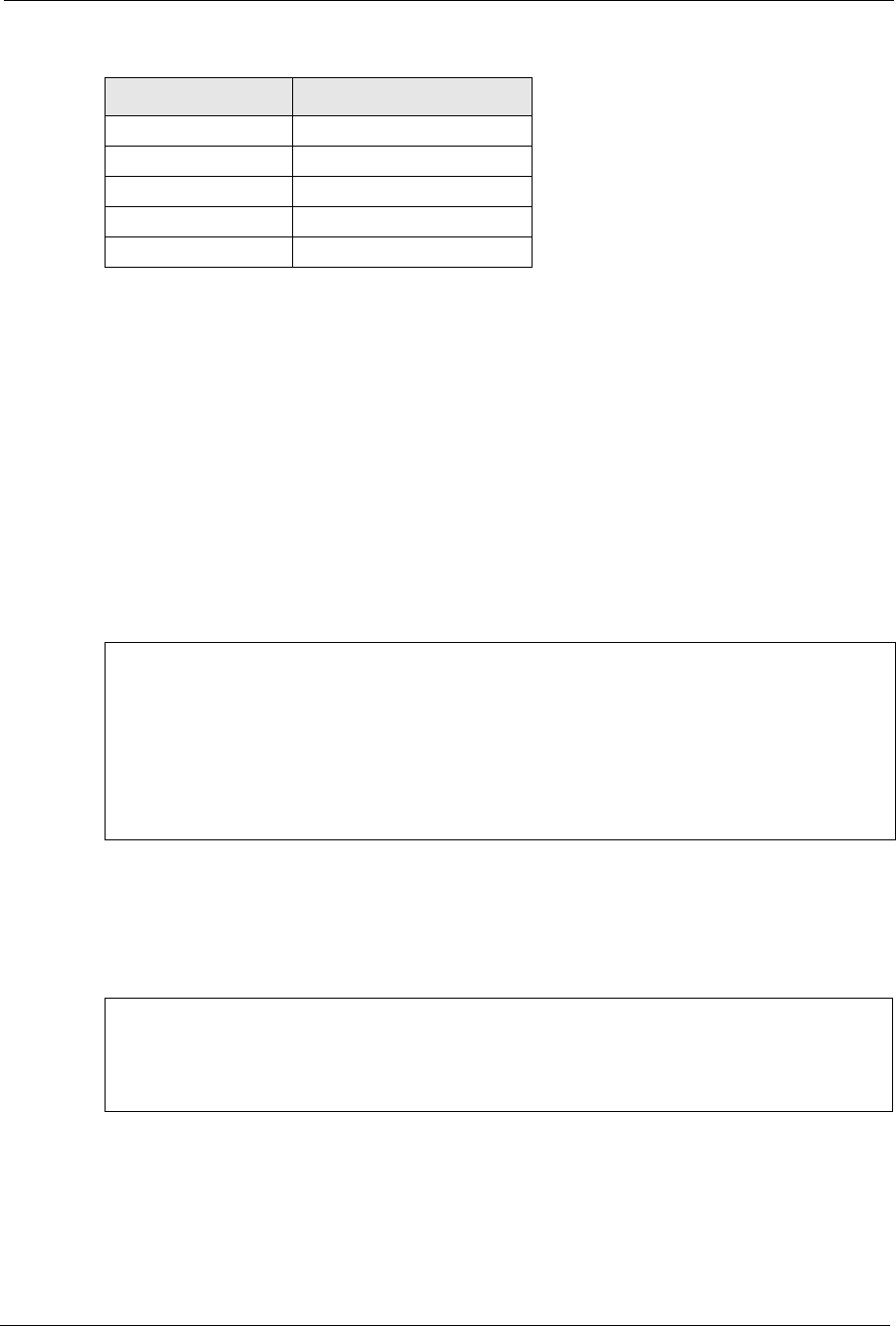
P-660H/HW/W-T Series User’ Guide
Appendix K 418
Log Commands
Go to the command interpreter interface.
Configuring What You Want the Prestige to Log
1Use the sys logs load command to load the log setting buffer that allows you to configure
which logs the Prestige is to record.
2Use sys logs category to view a list of the log categories.
Figure 263 Displaying Log Categories Example
3Use sys logs category followed by a log category to display the parameters that are
available for the category.
Figure 264 Displaying Log Parameters Example
4Use sys logs category followed by a log category and a parameter to decide what to
record.
SIG Signature
NONCE Nonce
NOTFY Notification
DEL Delete
VID Vendor ID
Table 159 RFC-2408 ISAKMP Payload Types (continued)
LOG DISPLAY PAYLOAD TYPE
Copyright (c) 1994 - 2004 ZyXEL Communications Corp.
ras>?
Valid commands are:
sys exit ether aux
ip ipsec bridge bm
certificates cnm 8021x radius
ras>
ras> sys logs category access
Usage: [0:none/1:log/2:alert/3:both] [0:don't show debug type/
1:show debug type]

P-660H/HW/W-T Series User’ Guide
419 Appendix K
Use 0 to not record logs for that category, 1 to record only logs for that
category, 2 to record only alerts for that category, and 3 to record both
logs and alerts for that category. Not every parameter is available with
every category.
5Step 5.Use the sys logs save command to store the settings in the Prestige (you must do
this in order to record logs).
Displaying Logs
• Use the sys logs display command to show all of the logs in the Prestige’s log.
• Use the sys logs category display command to show the log settings for all of the log
categories.
• Use the sys logs display [log category] command to show the logs in an individual
Prestige log category.
• Use the sys logs clear command to erase all of the Prestige’s logs.
Log Command Example
This example shows how to set the Prestige to record the access logs and alerts and then view
the results.
ras> sys logs load
ras> sys logs category access 3
ras> sys logs save
ras> sys logs display access
#.time source destination notes
message
0|06/08/2004 05:58:21 |172.21.4.154 |224.0.1.24 |ACCESS
BLOCK
Firewall default policy: IGMP (W to W/ZW)
1|06/08/2004 05:58:20 |172.21.3.56 |239.255.255.250 |ACCESS
BLOCK
Firewall default policy: IGMP (W to W/ZW)
2|06/08/2004 05:58:20 |172.21.0.2 |239.255.255.254 |ACCESS
BLOCK
Firewall default policy: IGMP (W to W/ZW)
3|06/08/2004 05:58:20 |172.21.3.191 |224.0.1.22 |ACCESS
BLOCK
Firewall default policy: IGMP (W to W/ZW)
4|06/08/2004 05:58:20 |172.21.0.254 |224.0.0.1 |ACCESS
BLOCK
Firewall default policy: IGMP (W to W/ZW)
5|06/08/2004 05:58:20 |172.21.4.187:137 |172.21.255.255:137 |ACCESS
BLOCK
Firewall default policy: UDP (W to W/ZW)
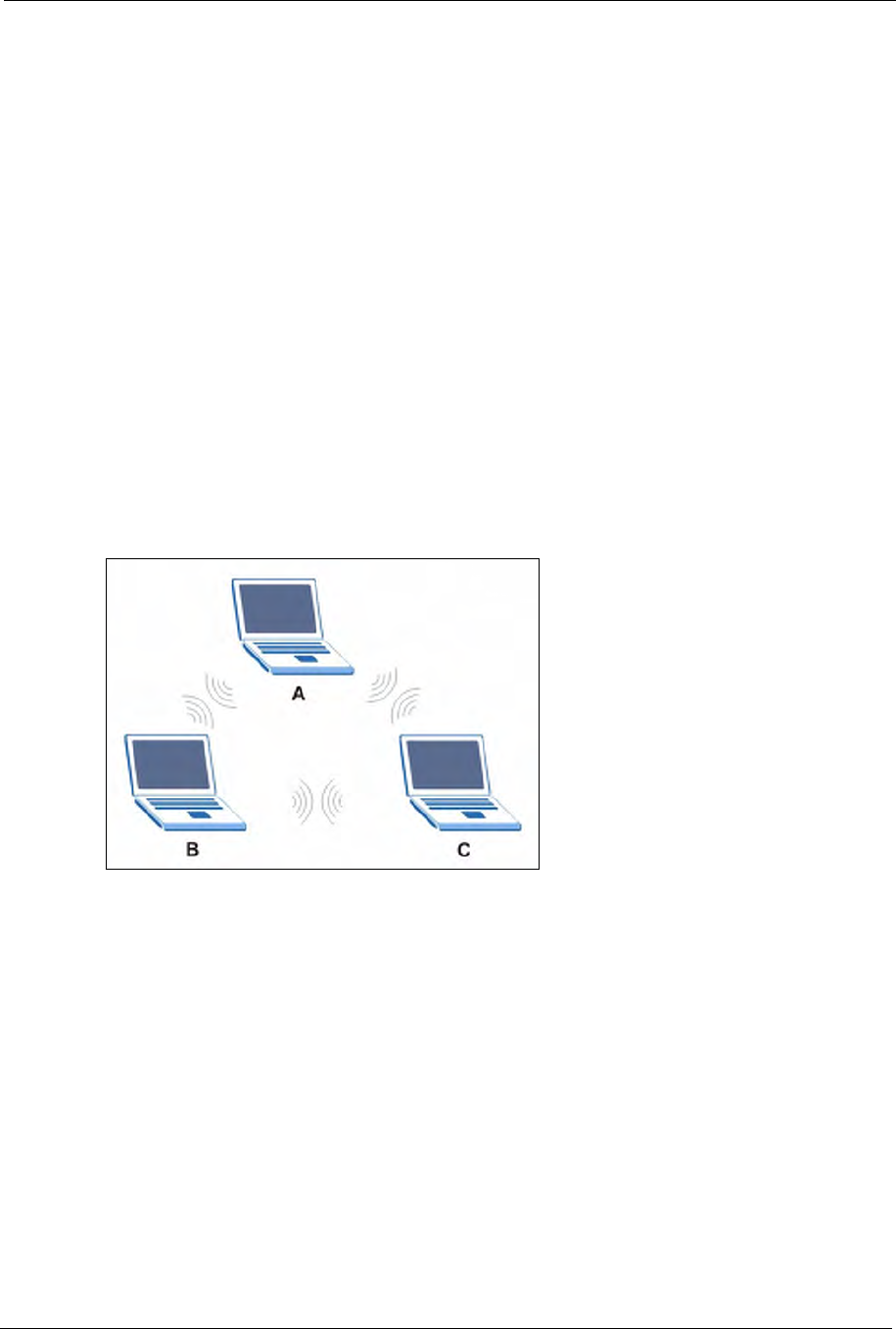
P-660H/HW/W-T Series User’ Guide
Appendix L 420
Appendix L
Wireless LANs
Wireless LAN Topologies
This section discusses ad-hoc and infrastructure wireless LAN topologies.
Ad-hoc Wireless LAN Configuration
The simplest WLAN configuration is an independent (Ad-hoc) WLAN that connects a set of
computers with wireless stations (A, B, C). Any time two or more wireless adapters are within
range of each other, they can set up an independent network, which is commonly referred to as
an Ad-hoc network or Independent Basic Service Set (IBSS). The following diagram shows an
example of notebook computers using wireless adapters to form an Ad-hoc wireless LAN.
Figure 265 Peer-to-Peer Communication in an Ad-hoc Network
BSS
A Basic Service Set (BSS) exists when all communications between wireless stations or
between a wireless station and a wired network client go through one access point (AP).
Intra-BSS traffic is traffic between wireless stations in the BSS. When Intra-BSS is enabled,
wireless station A and B can access the wired network and communicate with each other.
When Intra-BSS is disabled, wireless station A and B can still access the wired network but
cannot communicate with each other.
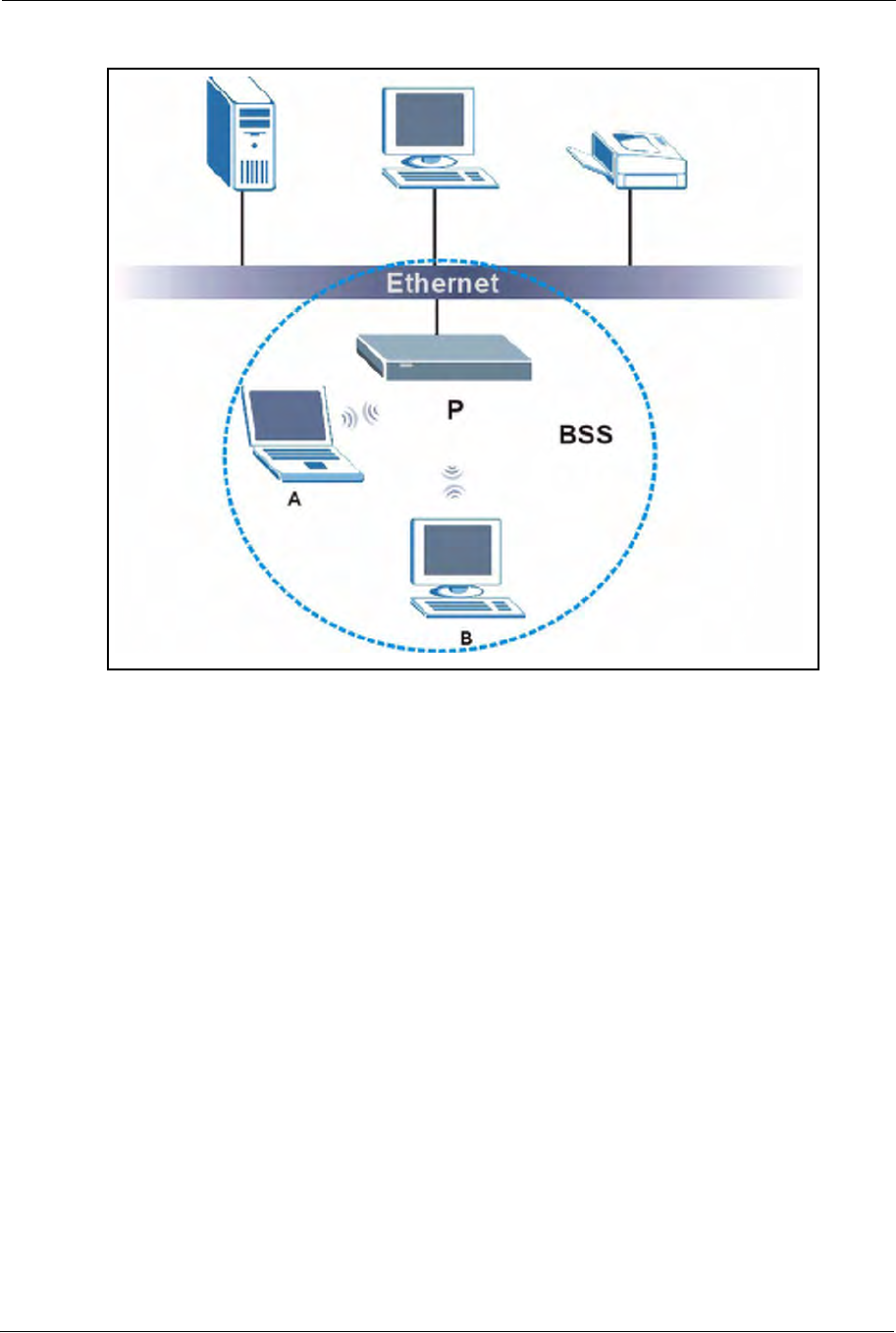
P-660H/HW/W-T Series User’ Guide
421 Appendix L
Figure 266 Basic Service Set
ESS
An Extended Service Set (ESS) consists of a series of overlapping BSSs, each containing an
access point, with each access point connected together by a wired network. This wired
connection between APs is called a Distribution System (DS).
This type of wireless LAN topology is called an Infrastructure WLAN. The Access Points not
only provide communication with the wired network but also mediate wireless network traffic
in the immediate neighborhood.
An ESSID (ESS IDentification) uniquely identifies each ESS. All access points and their
associated wireless stations within the same ESS must have the same ESSID in order to
communicate.
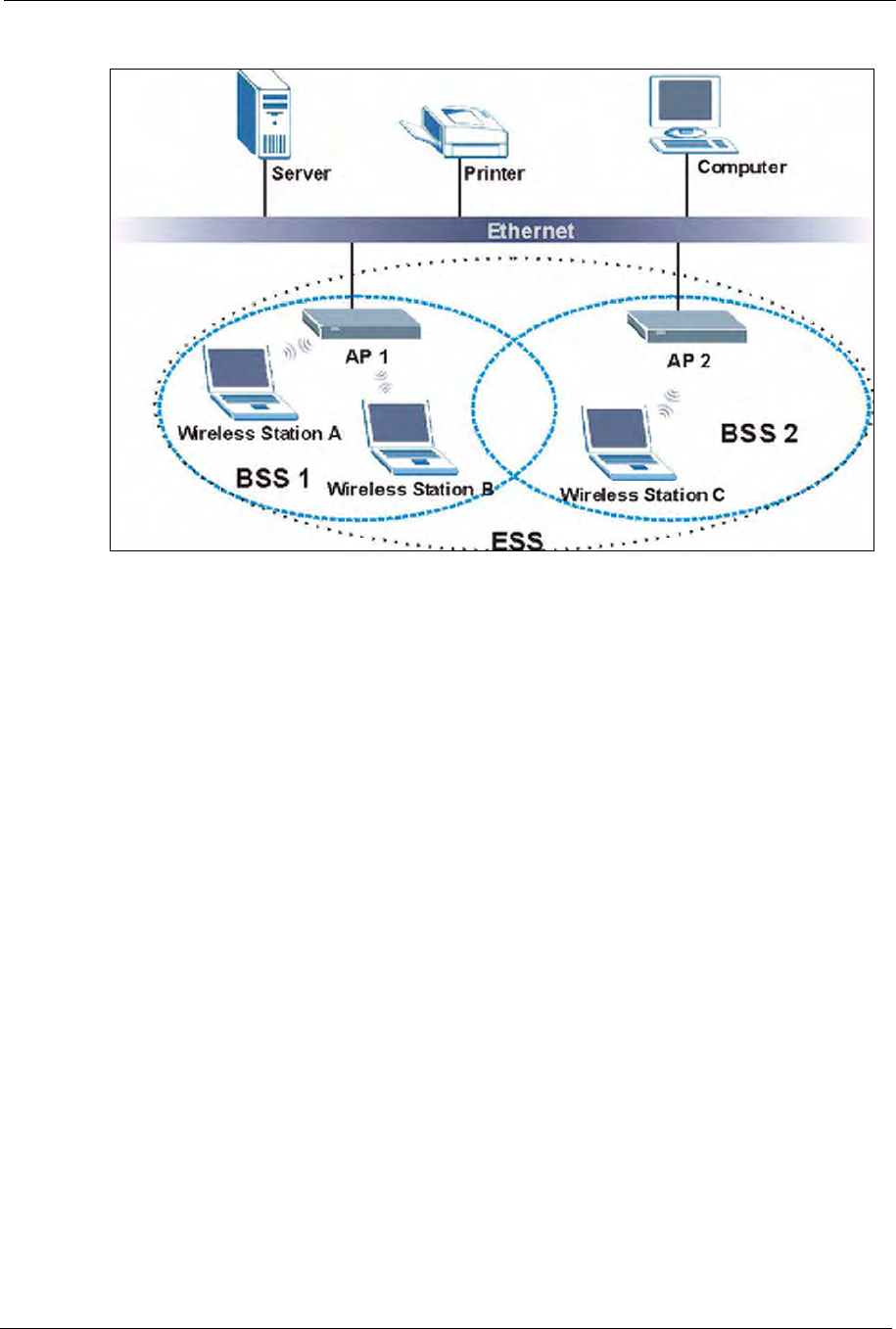
P-660H/HW/W-T Series User’ Guide
Appendix L 422
Figure 267 Infrastructure WLAN
Channel
A channel is the radio frequency(ies) used by IEEE 802.11a/b/g wireless devices. Channels
available depend on your geographical area. You may have a choice of channels (for your
region) so you should use a different channel than an adjacent AP (access point) to reduce
interference. Interference occurs when radio signals from different access points overlap
causing interference and degrading performance.
Adjacent channels partially overlap however. To avoid interference due to overlap, your AP
should be on a channel at least five channels away from a channel that an adjacent AP is using.
For example, if your region has 11 channels and an adjacent AP is using channel 1, then you
need to select a channel between 6 or 11.
RTS/CTS
A hidden node occurs when two stations are within range of the same access point, but are not
within range of each other. The following figure illustrates a hidden node. Both stations (STA)
are within range of the access point (AP) or wireless gateway, but out-of-range of each other,
so they cannot "hear" each other, that is they do not know if the channel is currently being
used. Therefore, they are considered hidden from each other.
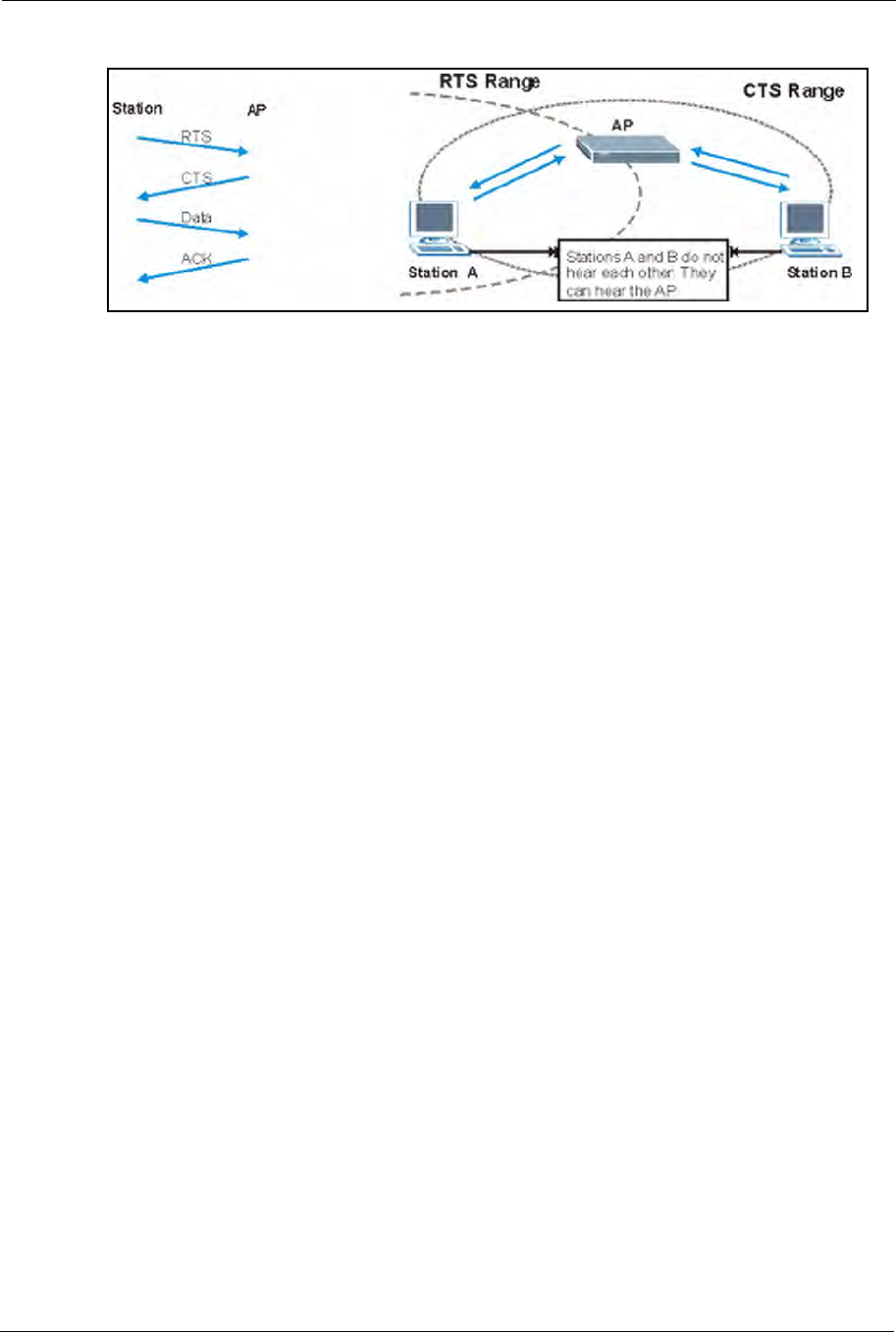
P-660H/HW/W-T Series User’ Guide
423 Appendix L
Figure 268 RTS/CTS
When station A sends data to the AP, it might not know that the station B is already using the
channel. If these two stations send data at the same time, collisions may occur when both sets
of data arrive at the AP at the same time, resulting in a loss of messages for both stations.
RTS/CTS is designed to prevent collisions due to hidden nodes. An RTS/CTS defines the
biggest size data frame you can send before an RTS (Request To Send)/CTS (Clear to Send)
handshake is invoked.
When a data frame exceeds the RTS/CTS value you set (between 0 to 2432 bytes), the station
that wants to transmit this frame must first send an RTS (Request To Send) message to the AP
for permission to send it. The AP then responds with a CTS (Clear to Send) message to all
other stations within its range to notify them to defer their transmission. It also reserves and
confirms with the requesting station the time frame for the requested transmission.
Stations can send frames smaller than the specified RTS/CTS directly to the AP without the
RTS (Request To Send)/CTS (Clear to Send) handshake.
You should only configure RTS/CTS if the possibility of hidden nodes exists on your network
and the "cost" of resending large frames is more than the extra network overhead involved in
the RTS (Request To Send)/CTS (Clear to Send) handshake.
If the RTS/CTS value is greater than the Fragmentation Threshold value (see next), then the
RTS (Request To Send)/CTS (Clear to Send) handshake will never occur as data frames will
be fragmented before they reach RTS/CTS size.
Note: Enabling the RTS Threshold causes redundant network overhead that could
negatively affect the throughput performance instead of providing a remedy.
Fragmentation Threshold
AFragmentation Threshold is the maximum data fragment size (between 256 and 2432
bytes) that can be sent in the wireless network before the AP will fragment the packet into
smaller data frames.

P-660H/HW/W-T Series User’ Guide
Appendix L 424
A large Fragmentation Threshold is recommended for networks not prone to interference
while you should set a smaller threshold for busy networks or networks that are prone to
interference.
If the Fragmentation Threshold value is smaller than the RTS/CTS value (see previously)
you set then the RTS (Request To Send)/CTS (Clear to Send) handshake will never occur as
data frames will be fragmented before they reach RTS/CTS size.
Preamble Type
A preamble is used to synchronize the transmission timing in your wireless network. There are
two preamble modes: Long and Short.
Short preamble takes less time to process and minimizes overhead, so it should be used in a
good wireless network environment when all wireless stations support it.
Select Long if you have a ‘noisy’ network or are unsure of what preamble mode your wireless
stations support as all IEEE 802.11b compliant wireless adapters must support long preamble.
However, not all wireless adapters support short preamble. Use long preamble if you are
unsure what preamble mode the wireless adapters support, to ensure interpretability between
the AP and the wireless stations and to provide more reliable communication in ‘noisy’
networks.
Select Dynamic to have the AP automatically use short preamble when all wireless stations
support it, otherwise the AP uses long preamble.
Note: The AP and the wireless stations MUST use the same preamble mode in order
to communicate.
IEEE 802.11g Wireless LAN
IEEE 802.11g is fully compatible with the IEEE 802.11b standard. This means an IEEE
802.11b adapter can interface directly with an IEEE 802.11g access point (and vice versa) at
11 Mbps or lower depending on range. IEEE 802.11g has several intermediate rate steps
between the maximum and minimum data rates. The IEEE 802.11g data rate and modulation
are as follows:
Table 160 IEEE 802.11g
DATA RATE (MBPS) MODULATION
1 DBPSK (Differential Binary Phase Shift Keyed)
2 DQPSK (Differential Quadrature Phase Shift Keying)
5.5 / 11 CCK (Complementary Code Keying)
6/9/12/18/24/36/48/54 OFDM (Orthogonal Frequency Division Multiplexing)

P-660H/HW/W-T Series User’ Guide
425 Appendix L
IEEE 802.1x
In June 2001, the IEEE 802.1x standard was designed to extend the features of IEEE 802.11 to
support extended authentication as well as providing additional accounting and control
features. It is supported by Windows XP and a number of network devices. Some advantages
of IEEE 802.1x are:
• User based identification that allows for roaming.
• Support for RADIUS (Remote Authentication Dial In User Service, RFC 2138, 2139) for
centralized user profile and accounting management on a network RADIUS server.
• Support for EAP (Extensible Authentication Protocol, RFC 2486) that allows additional
authentication methods to be deployed with no changes to the access point or the wireless
stations.
RADIUS
RADIUS is based on a client-server model that supports authentication, authorization and
accounting. The access point is the client and the server is the RADIUS server. The RADIUS
server handles the following tasks:
• Authentication
Determines the identity of the users.
• Authorization
Determines the network services available to authenticated users once they are connected
to the network.
• Accounting
Keeps track of the client’s network activity.
RADIUS is a simple package exchange in which your AP acts as a message relay between the
wireless station and the network RADIUS server.
Types of RADIUS Messages
The following types of RADIUS messages are exchanged between the access point and the
RADIUS server for user authentication:
• Access-Request
Sent by an access point requesting authentication.
• Access-Reject
Sent by a RADIUS server rejecting access.
• Access-Accept
Sent by a RADIUS server allowing access.

P-660H/HW/W-T Series User’ Guide
Appendix L 426
• Access-Challenge
Sent by a RADIUS server requesting more information in order to allow access. The
access point sends a proper response from the user and then sends another Access-
Request message.
The following types of RADIUS messages are exchanged between the access point and the
RADIUS server for user accounting:
• Accounting-Request
Sent by the access point requesting accounting.
• Accounting-Response
Sent by the RADIUS server to indicate that it has started or stopped accounting.
In order to ensure network security, the access point and the RADIUS server use a shared
secret key, which is a password, they both know. The key is not sent over the network. In
addition to the shared key, password information exchanged is also encrypted to protect the
network from unauthorized access.
Types of Authentication
This appendix discusses some popular authentication types: EAP-MD5,EAP-TLS,EAP-
TTLS,PEAP and LEAP.
The type of authentication you use depends on the RADIUS server or the AP. Consult your
network administrator for more information.
EAP-MD5 (Message-Digest Algorithm 5)
MD5 authentication is the simplest one-way authentication method. The authentication server
sends a challenge to the wireless station. The wireless station ‘proves’ that it knows the
password by encrypting the password with the challenge and sends back the information.
Password is not sent in plain text.
However, MD5 authentication has some weaknesses. Since the authentication server needs to
get the plaintext passwords, the passwords must be stored. Thus someone other than the
authentication server may access the password file. In addition, it is possible to impersonate an
authentication server as MD5 authentication method does not perform mutual authentication.
Finally, MD5 authentication method does not support data encryption with dynamic session
key. You must configure WEP encryption keys for data encryption.

P-660H/HW/W-T Series User’ Guide
427 Appendix L
EAP-TLS (Transport Layer Security)
With EAP-TLS, digital certifications are needed by both the server and the wireless stations
for mutual authentication. The server presents a certificate to the client. After validating the
identity of the server, the client sends a different certificate to the server. The exchange of
certificates is done in the open before a secured tunnel is created. This makes user identity
vulnerable to passive attacks. A digital certificate is an electronic ID card that authenticates the
sender’s identity. However, to implement EAP-TLS, you need a Certificate Authority (CA) to
handle certificates, which imposes a management overhead.
EAP-TTLS (Tunneled Transport Layer Service)
EAP-TTLS is an extension of the EAP-TLS authentication that uses certificates for only the
server-side authentications to establish a secure connection. Client authentication is then done
by sending username and password through the secure connection, thus client identity is
protected. For client authentication, EAP-TTLS supports EAP methods and legacy
authentication methods such as PAP, CHAP, MS-CHAP and MS-CHAP v2.
PEAP (Protected EAP)
Like EAP-TTLS, server-side certificate authentication is used to establish a secure connection,
then use simple username and password methods through the secured connection to
authenticate the clients, thus hiding client identity. However, PEAP only supports EAP
methods, such as EAP-MD5, EAP-MSCHAPv2 and EAP-GTC (EAP-Generic Token Card),
for client authentication. EAP-GTC is implemented only by Cisco.
LEAP
LEAP (Lightweight Extensible Authentication Protocol) is a Cisco implementation of IEEE
802.1x.
Dynamic WEP Key Exchange
The AP maps a unique key that is generated with the RADIUS server. This key expires when
the wireless connection times out, disconnects or reauthentication times out. A new WEP key
is generated each time reauthentication is performed.
If this feature is enabled, it is not necessary to configure a default encryption key in the
Wireless screen. You may still configure and store keys here, but they will not be used while
Dynamic WEP is enabled.
Note: EAP-MD5 cannot be used with Dynamic WEP Key Exchange

P-660H/HW/W-T Series User’ Guide
Appendix L 428
For added security, certificate-based authentications (EAP-TLS, EAP-TTLS and PEAP) use
dynamic keys for data encryption. They are often deployed in corporate environments, but for
public deployment, a simple user name and password pair is more practical. The following
table is a comparison of the features of authentication types.
WPA
User Authentication
WPA applies IEEE 802.1x and Extensible Authentication Protocol (EAP) to authenticate
wireless stations using an external RADIUS database.
Encryption
WPA improves data encryption by using Temporal Key Integrity Protocol (TKIP) or
Advanced Encryption Standard (AES), Message Integrity Check (MIC) and IEEE 802.1x.
TKIP uses 128-bit keys that are dynamically generated and distributed by the authentication
server. It includes a per-packet key mixing function, a Message Integrity Check (MIC) named
Michael, an extended initialization vector (IV) with sequencing rules, and a re-keying
mechanism.
TKIP regularly changes and rotates the encryption keys so that the same encryption key is
never used twice.
The RADIUS server distributes a Pairwise Master Key (PMK) key to the AP that then sets up
a key hierarchy and management system, using the PMK to dynamically generate unique data
encryption keys to encrypt every data packet that is wirelessly communicated between the AP
and the wireless stations. This all happens in the background automatically.
AES (Advanced Encryption Standard) also uses a secret key. This implementation of AES
applies a 128-bit key to 128-bit blocks of data.
Table 161 Comparison of EAP Authentication Types
EAP-MD5 EAP-TLS EAP-TTLS PEAP LEAP
Mutual Authentication No Yes Yes Yes Yes
Certificate – Client No Ye s Optional Optional No
Certificate – Server No Yes Yes Yes No
Dynamic Key Exchange No Yes Yes Yes Ye s
Credential Integrity None Strong Strong Strong Moderate
Deployment Difficulty Easy Hard Moderate Moderate Moderate
Client Identity Protection No No Yes Ye s No
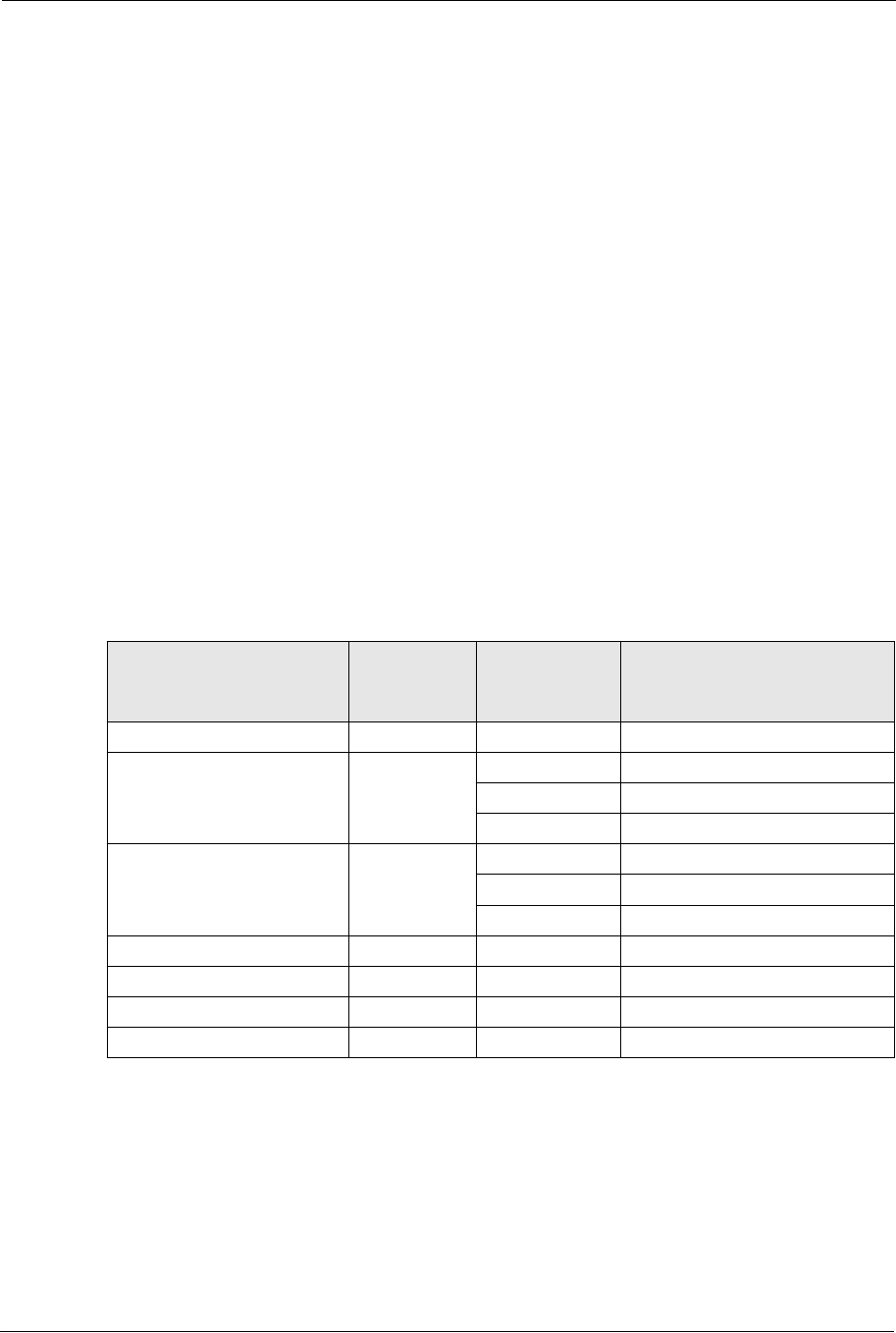
P-660H/HW/W-T Series User’ Guide
429 Appendix L
The Message Integrity Check (MIC) is designed to prevent an attacker from capturing data
packets, altering them and resending them. The MIC provides a strong mathematical function
in which the receiver and the transmitter each compute and then compare the MIC. If they do
not match, it is assumed that the data has been tampered with and the packet is dropped.
By generating unique data encryption keys for every data packet and by creating an integrity
checking mechanism (MIC), TKIP makes it much more difficult to decrypt data on a Wi-Fi
network than WEP, making it difficult for an intruder to break into the network.
The encryption mechanisms used for WPA and WPA-PSK are the same. The only difference
between the two is that WPA-PSK uses a simple common password, instead of user-specific
credentials. The common-password approach makes WPA-PSK susceptible to brute-force
password-guessing attacks but it’s still an improvement over WEP as it employs an easier-to-
use, consistent, single, alphanumeric password.
Security Parameters Summary
Refer to this table to see what other security parameters you should configure for each
Authentication Method/ key management protocol type. MAC address filters are not
dependent on how you configure these security features.
Table 162 Wireless Security Relational Matrix
AUTHENTICATION
METHOD/ KEY
MANAGEMENT PROTOCOL
ENCRYPTION
METHOD
ENTER
MANUAL KEY ENABLE IEEE 802.1X
Open None No No
Open WEP No Enable with Dynamic WEP Key
Yes Enable without Dynamic WEP Key
Yes Disable
Shared WEP No Enable with Dynamic WEP Key
Yes Enable without Dynamic WEP Key
Yes Disable
WPA WEP No Yes
WPA TKIP No Yes
WPA-PSK WEP Yes Yes
WPA-PSK TKIP Yes Yes

P-660H/HW/W-T Series User’ Guide
Appendix M 430
APPENDIX M
Internal SPTGEN
Internal SPTGEN Overview
Internal SPTGEN (System Parameter Table Generator) is a configuration text file useful for
efficient configuration of multiple Prestiges. Internal SPTGEN lets you configure, save and
upload multiple menus at the same time using just one configuration text file – eliminating the
need to navigate and configure individual SMT menus for each Prestige.
The Configuration Text File Format
All Internal SPTGEN text files conform to the following format:
<field identification number = field name = parameter values
allowed = input>,
where <input> is your input conforming to <parameter values allowed>.
The figure shown next is an example of an Internal SPTGEN text file.
Figure 269 Configuration Text File Format: Column Descriptions
Note: DO NOT alter or delete any field except parameters in the Input column.
For more text file examples, refer to the Example Internal SPTGEN Screens Appendix.
Internal SPTGEN File Modification - Important Points to Remember
Each parameter you enter must be preceded by one “=”sign and one space.
/ Menu 1 General Setup
10000000 = Configured <0(No)| 1(Yes)> = 1
10000001 = System Name <Str> = Prestige
10000002 = Location <Str> =
10000003 = Contact Person’s Name <Str> =
10000004 = Route IP <0(No)| 1(Yes)> = 1
10000005 = Route IPX <0(No)| 1(Yes)> = 0
10000006 = Bridge <0(No)| 1(Yes)> = 0
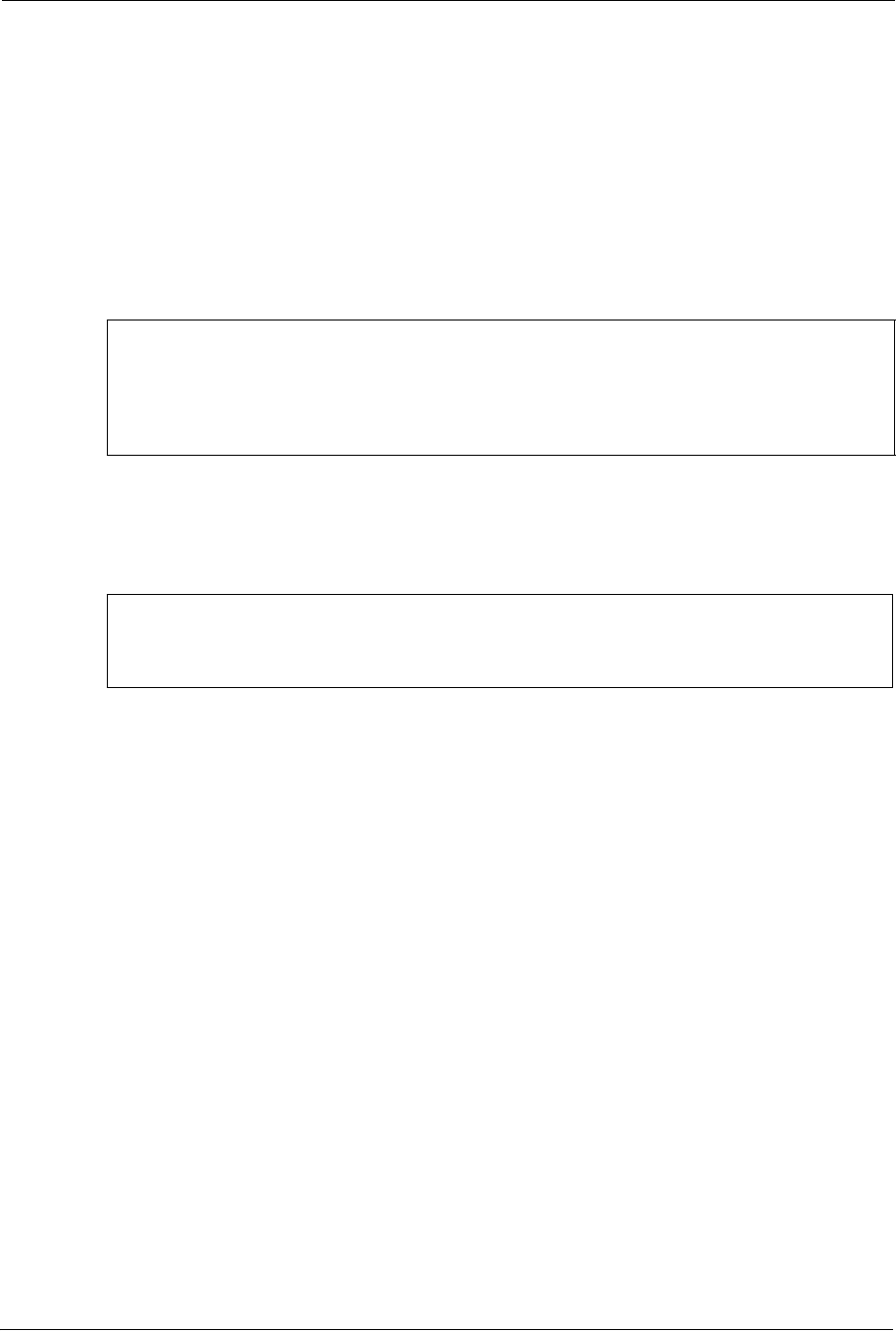
P-660H/HW/W-T Series User’ Guide
431 Appendix M
Some parameters are dependent on others. For example, if you disable the Configured field in
menu 1 (see Figure 269 on page 430), then you disable every field in this menu.
If you enter a parameter that is invalid in the Input column, the Prestige will not save the
configuration and the command line will display the Field Identification Number.Figure 270
on page 431, shown next, is an example of what the Prestige displays if you enter a value other
than “0” or “1” in the Input column of Field Identification Number 1000000 (refer to Figure
269 on page 430).
Figure 270 Invalid Parameter Entered: Command Line Example
The Prestige will display the following if you enter parameter(s) that are valid.
Figure 271 Valid Parameter Entered: Command Line Example
Internal SPTGEN FTP Download Example
1Launch your FTP application.
2Enter "bin". The command “bin” sets the transfer mode to binary.
3Get "rom-t" file. The command “get” transfers files from the Prestige to your computer.
The name “rom-t” is the configuration filename on the Prestige.
4Edit the "rom-t" file using a text editor (do not use a word processor). You must leave
this FTP screen to edit.
field value is not legal error:-1
ROM-t is not saved, error Line ID:10000000
reboot to get the original configuration
Bootbase Version: V2.02 | 2/22/2001 13:33:11
RAM: Size = 8192 Kbytes
FLASH: Intel 8M *2
Please wait for the system to write SPT text file(ROM-t)...
Bootbase Version: V2.02 | 2/22/2001 13:33:11
RAM: Size = 8192 Kbytes
FLASH: Intel 8M *2

P-660H/HW/W-T Series User’ Guide
Appendix M 432
Figure 272 Internal SPTGEN FTP Download Example
Note: You can rename your “rom-t” file when you save it to your computer but it must
be named “rom-t” when you upload it to your Prestige.
Internal SPTGEN FTP Upload Example
1Launch your FTP application.
2Enter "bin". The command “bin” sets the transfer mode to binary.
3Upload your “rom-t” file from your computer to the Prestige using the “put” command.
computer to the Prestige.
4Exit this FTP application.
Figure 273 Internal SPTGEN FTP Upload Example
Example Internal SPTGEN Screens
This section covers Prestige Internal SPTGEN screens.
c:\ftp 192.168.1.1
220 PPP FTP version 1.0 ready at Sat Jan 1 03:22:12 2000
User (192.168.1.1:(none)):
331 Enter PASS command
Password:
230 Logged in
ftp>bin
200 Type I OK
ftp> get rom-t
ftp>bye
c:\edit rom-t
(edit the rom-t text file by a text editor and save it)
c:\ftp 192.168.1.1
220 PPP FTP version 1.0 ready at Sat Jan 1 03:22:12 2000
User (192.168.1.1:(none)):
331 Enter PASS command
Password:
230 Logged in
ftp>bin
200 Type I OK
ftp> put rom-t
ftp>bye
Table 163 Abbreviations Used in the Example Internal SPTGEN Screens Table
ABBREVIATION MEANING
FIN Field Identification Number (not seen in SMT screens)
FN Field Name

P-660H/HW/W-T Series User’ Guide
433 Appendix M
The following are Internal SPTGEN screens associated with the SMT screens of your Prestige.
PVA Parameter Values Allowed
INPUT An example of what you may enter
* Applies to the Prestige.
Table 163 Abbreviations Used in the Example Internal SPTGEN Screens Table (continued)
ABBREVIATION MEANING
Table 164 Menu 1 General Setup (SMT Menu 1)
/ Menu 1 General Setup (SMT Menu 1)
FIN FN PVA INPUT
10000000 = Configured <0(No) | 1(Yes)> = 0
10000001 = System Name <Str> = Prestige
10000002 = Location <Str> =
10000003 = Contact Person's Name <Str> =
10000004 = Route IP <0(No) | 1(Yes)> = 1
10000006 = Bridge <0(No) | 1(Yes)> = 0
Table 165 Menu 3 (SMT Menu 3 )
/ Menu 3.1 General Ethernet Setup (SMT menu 3.1)
FIN FN PVA INPUT
30100001 = Input Protocol filters Set 1 = 2
30100002 = Input Protocol filters Set 2 = 256
30100003 = Input Protocol filters Set 3 = 256
30100004 = Input Protocol filters Set 4 = 256
30100005 = Input device filters Set 1 = 256
30100006 = Input device filters Set 2 = 256
30100007 = Input device filters Set 3 = 256
30100008 = Input device filters Set 4 = 256
30100009 = Output protocol filters Set 1 = 256
30100010 = Output protocol filters Set 2 = 256
30100011 = Output protocol filters Set 3 = 256
30100012 = Output protocol filters Set 4 = 256
30100013 = Output device filters Set 1 = 256
30100014 = Output device filters Set 2 = 256
30100015 = Output device filters Set 3 = 256
30100016 = Output device filters Set 4 = 256
/ Menu 3.2 TCP/IP and DHCP Ethernet Setup (SMT Menu 3.2)

P-660H/HW/W-T Series User’ Guide
Appendix M 434
FIN FN PVA INPUT
30200001 = DHCP <0(None) |
1(Server) |
2(Relay)>
= 0
30200002 = Client IP Pool Starting Address =
192.168.1.33
30200003 = Size of Client IP Pool = 32
30200004 = Primary DNS Server = 0.0.0.0
30200005 = Secondary DNS Server = 0.0.0.0
30200006 = Remote DHCP Server = 0.0.0.0
30200008 = IP Address =
172.21.2.200
30200009 = IP Subnet Mask = 16
30200010 = RIP Direction <0(None) |
1(Both) | 2(In
Only) | 3(Out
Only)>
= 0
30200011 = Version <0(Rip-1) |
1(Rip-2B)
|2(Rip-2M)>
= 0
30200012 = Multicast <0(IGMP-v2) |
1(IGMP-v1) |
2(None)>
= 2
30200013 = IP Policies Set 1 (1~12) = 256
30200014 = IP Policies Set 2 (1~12) = 256
30200015 = IP Policies Set 3 (1~12) = 256
30200016 = IP Policies Set 4 (1~12) = 256
/ Menu 3.2.1 IP Alias Setup (SMT Menu 3.2.1)
FIN FN PVA INPUT
30201001 = IP Alias 1 <0(No) |
1(Yes)>
= 0
30201002 = IP Address = 0.0.0.0
30201003 = IP Subnet Mask = 0
30201004 = RIP Direction <0(None) |
1(Both) | 2(In
Only) | 3(Out
Only)>
= 0
30201005 = Version <0(Rip-1) |
1(Rip-2B)
|2(Rip-2M)>
= 0
30201006 = IP Alias #1 Incoming protocol filters
Set 1
= 256
30201007 = IP Alias #1 Incoming protocol filters
Set 2
= 256
Table 165 Menu 3 (SMT Menu 3 (continued))

P-660H/HW/W-T Series User’ Guide
435 Appendix M
30201008 = IP Alias #1 Incoming protocol filters
Set 3
= 256
30201009 = IP Alias #1 Incoming protocol filters
Set 4
= 256
30201010 = IP Alias #1 Outgoing protocol filters
Set 1
= 256
30201011 = IP Alias #1 Outgoing protocol filters
Set 2
= 256
30201012 = IP Alias #1 Outgoing protocol filters
Set 3
= 256
30201013 = IP Alias #1 Outgoing protocol filters
Set 4
= 256
30201014 = IP Alias 2 <0(No) | 1(Yes)> = 0
30201015 = IP Address = 0.0.0.0
30201016 = IP Subnet Mask = 0
30201017 = RIP Direction <0(None) |
1(Both) | 2(In
Only) | 3(Out
Only)>
= 0
30201018 = Version <0(Rip-1) |
1(Rip-2B)
|2(Rip-2M)>
= 0
30201019 = IP Alias #2 Incoming protocol filters
Set 1
= 256
30201020 = IP Alias #2 Incoming protocol filters
Set 2
= 256
30201021 = IP Alias #2 Incoming protocol filters
Set 3
= 256
30201022 = IP Alias #2 Incoming protocol filters
Set 4
= 256
30201023 = IP Alias #2 Outgoing protocol filters
Set 1
= 256
30201024 = IP Alias #2 Outgoing protocol filters
Set 2
= 256
30201025 = IP Alias #2 Outgoing protocol filters
Set 3
= 256
30201026 = IP Alias #2 Outgoing protocol filters
Set 4
= 256
*/ Menu 3.5 Wireless LAN Setup (SMT Menu 3.5)
FIN FN PVA INPUT
30500001 = ESSID Wireless
30500002 = Hide ESSID <0(No) |
1(Yes)>
= 0
30500003 = Channel ID <1|2|3|4|5|6|7
|8|9|10|11|12|
13>
= 1
Table 165 Menu 3 (SMT Menu 3 (continued))

P-660H/HW/W-T Series User’ Guide
Appendix M 436
30500004 = RTS Threshold <0 ~ 2432> = 2432
30500005 = FRAG. Threshold <256 ~ 2432> = 2432
30500006 = WEP <0(DISABLE) |
1(64-bit WEP)
| 2(128-bit
WEP)>
= 0
30500007 = Default Key <1|2|3|4> = 0
30500008 = WEP Key1 =
30500009 = WEP Key2 =
30500010 = WEP Key3 =
30500011 = WEP Key4 =
30500012 = Wlan Active <0(Disable) |
1(Enable)>
= 0
*/ MENU 3.5.1 WLAN MAC ADDRESS FILTER (SMT MENU 3.5.1)
FIN FN PVA INPUT
30501001 = Mac Filter Active <0(No) |
1(Yes)>
= 0
30501002 = Filter Action <0(Allow) |
1(Deny)>
= 0
30501003 = Address 1 =
00:00:00:00:0
0:00
30501004 = Address 2 =
00:00:00:00:0
0:00
30501005 = Address 3 =
00:00:00:00:0
0:00
Continued … …
30501034 = Address 32 =
00:00:00:00:0
0:00
Table 165 Menu 3 (SMT Menu 3 (continued))
Table 166 Menu 4 Internet Access Setup (SMT Menu 4)
/ Menu 4 Internet Access Setup (SMT Menu 4)
FIN FN PVA INPUT
40000000 = Configured <0(No) |
1(Yes)>
= 1
40000001 = ISP <0(No) |
1(Yes)>
= 1

P-660H/HW/W-T Series User’ Guide
437 Appendix M
40000002 = Active <0(No) |
1(Yes)>
= 1
40000003 = ISP's Name = ChangeMe
40000004 = Encapsulation <2(PPPOE) |
3(RFC 1483)|
4(PPPoA )|
5(ENET ENCAP)>
= 2
40000005 = Multiplexing <1(LLC-based)
| 2(VC-based)
= 1
40000006 = VPI # = 0
40000007 = VCI # = 35
40000008 = Service Name <Str> = any
40000009 = My Login <Str> = test@pqa
40000010 = My Password <Str> = 1234
40000011 = Single User Account <0(No) |
1(Yes)>
= 1
40000012 = IP Address Assignment <0(Static)|1(D
ynamic)>
= 1
40000013 = IP Address = 0.0.0.0
40000014 = Remote IP address = 0.0.0.0
40000015 = Remote IP subnet mask = 0
40000016 = ISP incoming protocol filter set 1 = 6
40000017 = ISP incoming protocol filter set 2 = 256
40000018 = ISP incoming protocol filter set 3 = 256
40000019 = ISP incoming protocol filter set 4 = 256
40000020 = ISP outgoing protocol filter set 1 = 256
40000021 = ISP outgoing protocol filter set 2 = 256
40000022 = ISP outgoing protocol filter set 3 = 256
40000023 = ISP outgoing protocol filter set 4 = 256
40000024 = ISP PPPoE idle timeout = 0
40000025 = Route IP <0(No) |
1(Yes)>
= 1
40000026 = Bridge <0(No) |
1(Yes)>
= 0
40000027 = ATM QoS Type <0(CBR) | (1
(UBR)>
= 1
40000028 = Peak Cell Rate (PCR) = 0
40000029 = Sustain Cell Rate (SCR) = 0
40000030 = Maximum Burst Size(MBS) = 0
40000031= RIP Direction <0(None) |
1(Both) | 2(In
Only) | 3(Out
Only)>
= 0
Table 166 Menu 4 Internet Access Setup (SMT Menu 4) (continued)

P-660H/HW/W-T Series User’ Guide
Appendix M 438
40000032= RIP Version <0(Rip-1) |
1(Rip-2B)
|2(Rip-2M)>
= 0
40000033= Nailed-up Connection <0(No)
|1(Yes)>
= 0
Table 166 Menu 4 Internet Access Setup (SMT Menu 4) (continued)
Table 167 Menu 12 (SMT Menu 12)
/ Menu 12.1.1 IP Static Route Setup (SMT Menu 12.1.1)
FIN FN PVA INPUT
120101001 = IP Static Route set #1, Name <Str> =
120101002 = IP Static Route set #1, Active <0(No) |1(Yes)> = 0
120101003 = IP Static Route set #1, Destination
IP address
= 0.0.0.0
120101004 = IP Static Route set #1, Destination
IP subnetmask
= 0
120101005 = IP Static Route set #1, Gateway = 0.0.0.0
120101006 = IP Static Route set #1, Metric = 0
120101007 = IP Static Route set #1, Private <0(No) |1(Yes)> = 0
/ Menu 12.1.2 IP Static Route Setup (SMT Menu 12.1.2)
FIN FN PVA INPUT
120102001 = IP Static Route set #2, Name =
120102002 = IP Static Route set #2, Active <0(No) |1(Yes)> = 0
120102003 = IP Static Route set #2, Destination
IP address
= 0.0.0.0
120102004 = IP Static Route set #2, Destination
IP subnetmask
= 0
120102005 = IP Static Route set #2, Gateway = 0.0.0.0
120102006 = IP Static Route set #2, Metric = 0
120102007 = IP Static Route set #2, Private <0(No) |1(Yes)> = 0
/ Menu 12.1.3 IP Static Route Setup (SMT Menu 12.1.3)
FIN FN PVA INPUT
120103001 = IP Static Route set #3, Name <Str> =
120103002 = IP Static Route set #3, Active <0(No) |1(Yes)> = 0
120103003 = IP Static Route set #3, Destination
IP address
= 0.0.0.0
120103004 = IP Static Route set #3, Destination
IP subnetmask
= 0
120103005 = IP Static Route set #3, Gateway = 0.0.0.0
120103006 = IP Static Route set #3, Metric = 0
120103007 = IP Static Route set #3, Private <0(No) |1(Yes)> = 0

P-660H/HW/W-T Series User’ Guide
439 Appendix M
/ Menu 12.1.4 IP Static Route Setup (SMT Menu 12.1.4)
FIN FN PVA INPUT
120104001 = IP Static Route set #4, Name <Str> =
120104002 = IP Static Route set #4, Active <0(No) |1(Yes)> = 0
120104003 = IP Static Route set #4, Destination
IP address
= 0.0.0.0
120104004 = IP Static Route set #4, Destination
IP subnetmask
= 0
120104005 = IP Static Route set #4, Gateway = 0.0.0.0
120104006 = IP Static Route set #4, Metric = 0
120104007 = IP Static Route set #4, Private <0(No) |1(Yes)> = 0
/ Menu 12.1.5 IP Static Route Setup (SMT Menu 12.1.5)
FIN FN PVA INPUT
120105001 = IP Static Route set #5, Name <Str> =
120105002 = IP Static Route set #5, Active <0(No) |1(Yes)> = 0
120105003 = IP Static Route set #5, Destination
IP address
= 0.0.0.0
120105004 = IP Static Route set #5, Destination
IP subnetmask
= 0
120105005 = IP Static Route set #5, Gateway = 0.0.0.0
120105006 = IP Static Route set #5, Metric = 0
120105007 = IP Static Route set #5, Private <0(No) |1(Yes)> = 0
/ Menu 12.1.6 IP Static Route Setup (SMT Menu 12.1.6)
FIN FN PVA INPUT
120106001 = IP Static Route set #6, Name <Str> =
120106002 = IP Static Route set #6, Active <0(No) |1(Yes)> = 0
120106003 = IP Static Route set #6, Destination
IP address
= 0.0.0.0
120106004 = IP Static Route set #6, Destination
IP subnetmask
= 0
120106005 = IP Static Route set #6, Gateway = 0.0.0.0
120106006 = IP Static Route set #6, Metric = 0
120106007 = IP Static Route set #6, Private <0(No) |1(Yes)> = 0
/ Menu 12.1.7 IP Static Route Setup (SMT Menu 12.1.7)
FIN FN PVA INPUT
120107001 = IP Static Route set #7, Name <Str> =
120107002 = IP Static Route set #7, Active <0(No) |1(Yes)> = 0
120107003 = IP Static Route set #7, Destination
IP address
= 0.0.0.0
120107004 = IP Static Route set #7, Destination
IP subnetmask
= 0
120107005 = IP Static Route set #7, Gateway = 0.0.0.0
Table 167 Menu 12 (SMT Menu 12) (continued)

P-660H/HW/W-T Series User’ Guide
Appendix M 440
120107006 = IP Static Route set #7, Metric = 0
120107007 = IP Static Route set #7, Private <0(No) |1(Yes)> = 0
/ Menu 12.1.8 IP Static Route Setup (SMT Menu 12.1.8)
FIN FN PVA INPUT
120108001 = IP Static Route set #8, Name <Str> =
120108002 = IP Static Route set #8, Active <0(No) |1(Yes)> = 0
120108003 = IP Static Route set #8, Destination
IP address
= 0.0.0.0
120108004 = IP Static Route set #8, Destination
IP subnetmask
= 0
120108005 = IP Static Route set #8, Gateway = 0.0.0.0
120108006 = IP Static Route set #8, Metric = 0
120108007 = IP Static Route set #8, Private <0(No) |1(Yes)> = 0
*/ Menu 12.1.9 IP Static Route Setup (SMT Menu 12.1.9)
FIN FN PVA INPUT
120109001 = IP Static Route set #9, Name <Str> =
120109002 = IP Static Route set #9, Active <0(No) |1(Yes)> = 0
120109003 = IP Static Route set #9, Destination
IP address
= 0.0.0.0
120109004 = IP Static Route set #9, Destination
IP subnetmask
= 0
120109005 = IP Static Route set #9, Gateway = 0.0.0.0
120109006 = IP Static Route set #9, Metric = 0
120109007 = IP Static Route set #9, Private <0(No) |1(Yes)> = 0
*/ Menu 12.1.10 IP Static Route Setup (SMT Menu 12.1.10)
FIN FN PVA INPUT
120110001 = IP Static Route set #10, Name =
120110002 = IP Static Route set #10, Active <0(No) |1(Yes)> = 0
120110003 = IP Static Route set #10, Destination
IP address
= 0.0.0.0
120110004 = IP Static Route set #10, Destination
IP subnetmask
= 0
120110005 = IP Static Route set #10, Gateway = 0.0.0.0
120110006 = IP Static Route set #10, Metric = 0
120110007 = IP Static Route set #10, Private <0(No) |1(Yes)> = 0
*/ Menu 12.1.11 IP Static Route Setup (SMT Menu 12.1.11)
FIN FN PVA INPUT
120111001 = IP Static Route set #11, Name <Str> =
120111002 = IP Static Route set #11, Active <0(No) |1(Yes)> = 0
120111003 = IP Static Route set #11, Destination
IP address
= 0.0.0.0
Table 167 Menu 12 (SMT Menu 12) (continued)

P-660H/HW/W-T Series User’ Guide
441 Appendix M
120111004 = IP Static Route set #11, Destination
IP subnetmask
= 0
120111005 = IP Static Route set #11, Gateway = 0.0.0.0
120111006 = IP Static Route set #11, Metric = 0
120111007 = IP Static Route set #11, Private <0(No) |1(Yes)> = 0
*/ Menu 12.1.12 IP Static Route Setup (SMT Menu 12.1.12)
FIN FN PVA INPUT
120112001 = IP Static Route set #12, Name <Str> =
120112002 = IP Static Route set #12, Active <0(No) |1(Yes)> = 0
120112003 = IP Static Route set #12, Destination
IP address
= 0.0.0.0
120112004 = IP Static Route set #12, Destination
IP subnetmask
= 0
120112005 = IP Static Route set #12, Gateway = 0.0.0.0
120112006 = IP Static Route set #12, Metric = 0
120112007 = IP Static Route set #12, Private <0(No) |1(Yes)> = 0
*/ Menu 12.1.13 IP Static Route Setup (SMT Menu 12.1.13)
FIN FN PVA INPUT
120113001 = IP Static Route set #13, Name <Str> =
120113002 = IP Static Route set #13, Active <0(No) |1(Yes)> = 0
120113003 = IP Static Route set #13, Destination
IP address
= 0.0.0.0
120113004 = IP Static Route set #13, Destination
IP subnetmask
= 0
120113005 = IP Static Route set #13, Gateway = 0.0.0.0
120113006 = IP Static Route set #13, Metric = 0
120113007 = IP Static Route set #13, Private <0(No) |1(Yes)> = 0
*/ Menu 12.1.14 IP Static Route Setup (SMT Menu 12.1. 14)
FIN FN PVA INPUT
120114001 = IP Static Route set #14, Name <Str> =
120114002 = IP Static Route set #14, Active <0(No) |1(Yes)> = 0
120114003 = IP Static Route set #14, Destination
IP address
= 0.0.0.0
120114004 = IP Static Route set #14, Destination
IP subnetmask
= 0
120114005 = IP Static Route set #14, Gateway = 0.0.0.0
120114006 = IP Static Route set #14, Metric = 0
120114007 = IP Static Route set #14, Private <0(No) |1(Yes)> = 0
*/ Menu 12.1.15 IP Static Route Setup (SMT Menu 12.1. 15)
FIN FN PVA INPUT
120115001 = IP Static Route set #15, Name <Str> =
Table 167 Menu 12 (SMT Menu 12) (continued)

P-660H/HW/W-T Series User’ Guide
Appendix M 442
120115002 = IP Static Route set #15, Active <0(No) |1(Yes)> = 0
120115003 = IP Static Route set #15, Destination
IP address
= 0.0.0.0
120115004 = IP Static Route set #15, Destination
IP subnetmask
= 0
120115005 = IP Static Route set #15, Gateway = 0.0.0.0
120115006 = IP Static Route set #15, Metric = 0
120115007 = IP Static Route set #15, Private <0(No) |1(Yes)> = 0
*/ Menu 12.1.16 IP Static Route Setup (SMT Menu 12.1. 16)
FIN FN PVA INPUT
120116001 = IP Static Route set #16, Name <Str> =
120116002 = IP Static Route set #16, Active <0(No) |1(Yes)> = 0
120116003 = IP Static Route set #16, Destination
IP address
= 0.0.0.0
120116004 = IP Static Route set #16, Destination
IP subnetmask
= 0
120116005 = IP Static Route set #16, Gateway = 0.0.0.0
120116006 = IP Static Route set #16, Metric = 0
120116007 = IP Static Route set #16, Private <0(No) |1(Yes)> = 0
Table 167 Menu 12 (SMT Menu 12) (continued)
Table 168 Menu 15 SUA Server Setup (SMT Menu 15)
/ Menu 15 SUA Server Setup (SMT Menu 15)
FIN FN PVA INPUT
150000001 = SUA Server IP address for default
port
= 0.0.0.0
150000002 = SUA Server #2 Active <0(No) | 1(Yes)> = 0
150000003 = SUA Server #2 Protocol <0(All)|6(TCP)|17(U
DP)>
= 0
150000004 = SUA Server #2 Port Start = 0
150000005 = SUA Server #2 Port End = 0
150000006 = SUA Server #2 Local IP address = 0.0.0.0
150000007 = SUA Server #3 Active <0(No) | 1(Yes)> = 0
150000008 = SUA Server #3 Protocol <0(All)|6(TCP)|17(U
DP)>
= 0
150000009 = SUA Server #3 Port Start = 0
150000010 = SUA Server #3 Port End = 0
150000011 = SUA Server #3 Local IP address = 0.0.0.0
150000012 = SUA Server #4 Active <0(No) | 1(Yes)> = 0
150000013 = SUA Server #4 Protocol <0(All)|6(TCP)|17(U
DP)>
= 0

P-660H/HW/W-T Series User’ Guide
443 Appendix M
150000014 = SUA Server #4 Port Start = 0
150000015 = SUA Server #4 Port End = 0
150000016 = SUA Server #4 Local IP address = 0.0.0.0
150000017 = SUA Server #5 Active <0(No) | 1(Yes)> = 0
150000018 = SUA Server #5 Protocol <0(All)|6(TCP)|17(U
DP)>
= 0
150000019 = SUA Server #5 Port Start = 0
150000020 = SUA Server #5 Port End = 0
150000021 = SUA Server #5 Local IP address = 0.0.0.0
150000022 = SUA Server #6 Active <0(No) | 1(Yes)> =
0
= 0
150000023 = SUA Server #6 Protocol <0(All)|6(TCP)|17(U
DP)>
= 0
150000024 = SUA Server #6 Port Start = 0
150000025 = SUA Server #6 Port End = 0
150000026 = SUA Server #6 Local IP address = 0.0.0.0
150000027 = SUA Server #7 Active <0(No) | 1(Yes)> = 0
150000028 = SUA Server #7 Protocol <0(All)|6(TCP)|17(U
DP)>
= 0.0.0.0
150000029 = SUA Server #7 Port Start = 0
150000030 = SUA Server #7 Port End = 0
150000031 = SUA Server #7 Local IP address = 0.0.0.0
150000032 = SUA Server #8 Active <0(No) | 1(Yes)> = 0
150000033 = SUA Server #8 Protocol <0(All)|6(TCP)|17(U
DP)>
= 0
150000034 = SUA Server #8 Port Start = 0
150000035 = SUA Server #8 Port End = 0
150000036 = SUA Server #8 Local IP address = 0.0.0.0
150000037 = SUA Server #9 Active <0(No) | 1(Yes)> = 0
150000038 = SUA Server #9 Protocol <0(All)|6(TCP)|17(U
DP)>
= 0
150000039 = SUA Server #9 Port Start = 0
150000040 = SUA Server #9 Port End = 0
150000041 = SUA Server #9 Local IP address = 0.0.0.0
150000042 = SUA Server #10 Active <0(No) | 1(Yes)> = 0
150000043 = SUA Server #10 Protocol <0(All)|6(TCP)|17(U
DP)>
= 0
150000044 = SUA Server #10 Port Start = 0
150000045 = SUA Server #10 Port End = 0
150000046 = SUA Server #10 Local IP address = 0.0.0.0
150000047 = SUA Server #11 Active <0(No) | 1(Yes)> = 0
Table 168 Menu 15 SUA Server Setup (SMT Menu 15) (continued)

P-660H/HW/W-T Series User’ Guide
Appendix M 444
150000048 = SUA Server #11 Protocol <0(All)|6(TCP)|17(U
DP)>
= 0
150000049 = SUA Server #11 Port Start = 0
150000050 = SUA Server #11 Port End = 0
150000051 = SUA Server #11 Local IP address = 0.0.0.0
150000052 = SUA Server #12 Active <0(No) | 1(Yes)> = 0
150000053 = SUA Server #12 Protocol <0(All)|6(TCP)|17(U
DP)>
= 0
150000054 = SUA Server #12 Port Start = 0
150000055 = SUA Server #12 Port End = 0
150000056 = SUA Server #12 Local IP address = 0.0.0.0
Table 168 Menu 15 SUA Server Setup (SMT Menu 15) (continued)
Table 169 Menu 21.1 Filter Set #1 (SMT Menu 21.1)
/ Menu 21 Filter set #1 (SMT Menu 21)
FIN FN PVA INPUT
210100001 = Filter Set 1, Name <Str> =
/ Menu 21.1.1.1 set #1, rule #1 (SMT Menu 21.1.1.1)
FIN FN PVA INPUT
210101001 = IP Filter Set 1,Rule 1 Type <2(TCP/IP)> = 2
210101002 = IP Filter Set 1,Rule 1 Active <0(No)|1(Yes)> = 1
210101003 = IP Filter Set 1,Rule 1 Protocol = 6
210101004 = IP Filter Set 1,Rule 1 Dest IP address = 0.0.0.0
210101005 = IP Filter Set 1,Rule 1 Dest Subnet Mask = 0
210101006 = IP Filter Set 1,Rule 1 Dest Port = 137
210101007 = IP Filter Set 1,Rule 1 Dest Port Comp <0(none)|1(equal)
|2(not equal)|
3(less)|
4(greater)>
= 1
210101008 = IP Filter Set 1,Rule 1 Src IP address = 0.0.0.0
210101009 = IP Filter Set 1,Rule 1 Src Subnet Mask = 0
210101010 = IP Filter Set 1,Rule 1 Src Port = 0
210101011 = IP Filter Set 1,Rule 1 Src Port Comp <0(none)|1(equal)
|2(not
equal)|3(less)|4(
greater)>
= 0
210101013 = IP Filter Set 1,Rule 1 Act Match <1(check
next)|2(forward)|
3(drop)>
= 3
210101014 = IP Filter Set 1,Rule 1 Act Not Match <1(check
next)|2(forward)|
3(drop)>
= 1

P-660H/HW/W-T Series User’ Guide
445 Appendix M
/ Menu 21.1.1.2 set #1, rule #2 (SMT Menu 21.1.1.2)
FIN FN PVA INPUT
210102001 = IP Filter Set 1,Rule 2 Type <2(TCP/IP)> = 2
210102002 = IP Filter Set 1,Rule 2 Active <0(No)|1(Yes)> = 1
210102003 = IP Filter Set 1,Rule 2 Protocol = 6
210102004 = IP Filter Set 1,Rule 2 Dest IP address = 0.0.0.0
210102005 = IP Filter Set 1,Rule 2 Dest Subnet Mask = 0
210102006 = IP Filter Set 1,Rule 2 Dest Port = 138
210102007 = IP Filter Set 1,Rule 2 Dest Port Comp <0(none)|1(equal)
|2(not
equal)|3(less)|4(
greater)>
= 1
210102008 = IP Filter Set 1,Rule 2 Src IP address = 0.0.0.0
210102009 = IP Filter Set 1,Rule 2 Src Subnet Mask = 0
210102010 = IP Filter Set 1,Rule 2 Src Port = 0
210102011 = IP Filter Set 1,Rule 2 Src Port Comp <0(none)|1(equal)
|2(not
equal)|3(less)|4(
greater)>
= 0
210102013 = IP Filter Set 1,Rule 2 Act Match <1(check
next)|2(forward)|
3(drop)>
= 3
210102014 = IP Filter Set 1,Rule 2 Act Not Match <1(check
next)|2(forward)|
3(drop)>
= 1
/ Menu 21.1.1.3 set #1, rule #3 (SMT Menu 21.1.1.3)
FIN FN PVA INPUT
210103001 = IP Filter Set 1,Rule 3 Type <2(TCP/IP)> = 2
210103002 = IP Filter Set 1,Rule 3 Active <0(No)|1(Yes)> = 1
210103003 = IP Filter Set 1,Rule 3 Protocol = 6
210103004 = IP Filter Set 1,Rule 3 Dest IP address = 0.0.0.0
210103005 = IP Filter Set 1,Rule 3 Dest Subnet Mask = 0
210103006 = IP Filter Set 1,Rule 3 Dest Port = 139
210103007 = IP Filter Set 1,Rule 3 Dest Port Comp <0(none)|1(equal)
|2(not
equal)|3(less)|4(
greater)>
= 1
210103008 = IP Filter Set 1,Rule 3 Src IP address = 0.0.0.0
210103009 = IP Filter Set 1,Rule 3 Src Subnet Mask = 0
210103010 = IP Filter Set 1,Rule 3 Src Port = 0
210103011 = IP Filter Set 1,Rule 3 Src Port Comp <0(none)|1(equal)
|2(not
equal)|3(less)|4(
greater)>
= 0
Table 169 Menu 21.1 Filter Set #1 (SMT Menu 21.1) (continued)

P-660H/HW/W-T Series User’ Guide
Appendix M 446
210103013 = IP Filter Set 1,Rule 3 Act Match <1(check
next)|2(forward)|
3(drop)
= 3
210103014 = IP Filter Set 1,Rule 3 Act Not Match <1(check
next)|2(forward)|
3(drop)
= 1
/ Menu 21.1.1.4 set #1, rule #4 (SMT Menu 21.1.1.4)
FIN FN PVA INPUT
210104001 = IP Filter Set 1,Rule 4 Type <2(TCP/IP)> = 2
210104002 = IP Filter Set 1,Rule 4 Active <0(No)|1(Yes)> = 1
210104003 = IP Filter Set 1,Rule 4 Protocol = 17
210104004 = IP Filter Set 1,Rule 4 Dest IP address = 0.0.0.0
210104005 = IP Filter Set 1,Rule 4 Dest Subnet Mask = 0
210104006 = IP Filter Set 1,Rule 4 Dest Port = 137
210104007 = IP Filter Set 1,Rule 4 Dest Port Comp <0(none)|1(equal)
|2(not
equal)|3(less)|4(
greater)>
= 1
210104008 = IP Filter Set 1,Rule 4 Src IP address = 0.0.0.0
210104009 = IP Filter Set 1,Rule 4 Src Subnet Mask = 0
210104010 = IP Filter Set 1,Rule 4 Src Port = 0
210104011 = IP Filter Set 1,Rule 4 Src Port Comp <0(none)|1(equal)
|2(not
equal)|3(less)|4(
greater)>
= 0
210104013 = IP Filter Set 1,Rule 4 Act Match <1(check next)
|2( forward) |
3(drop)
= 3
210104014 = IP Filter Set 1,Rule 4 Act Not Match <1(check
next)|2(forward)|
3(drop)
= 1
/ Menu 21.1.1.5 set #1, rule #5 (SMT Menu 21.1.1.5)
FIN FN PVA INPUT
210105001 = IP Filter Set 1,Rule 5 Type <2(TCP/IP)> = 2
210105002 = IP Filter Set 1,Rule 5 Active <0(No)|1(Yes)> = 1
210105003 = IP Filter Set 1,Rule 5 Protocol = 17
210105004 = IP Filter Set 1,Rule 5 Dest IP address = 0.0.0.0
210105005 = IP Filter Set 1,Rule 5 Dest Subnet Mask = 0
210105006 = IP Filter Set 1,Rule 5 Dest Port = 138
210105007 = IP Filter Set 1,Rule 5 Dest Port Comp <0(none)|1(equal)
|2(not
equal)|3(less)|4(
greater)>
= 1
210105008 = IP Filter Set 1,Rule 5 Src IP Address = 0.0.0.0
Table 169 Menu 21.1 Filter Set #1 (SMT Menu 21.1) (continued)

P-660H/HW/W-T Series User’ Guide
447 Appendix M
210105009 = IP Filter Set 1,Rule 5 Src Subnet Mask = 0
210105010 = IP Filter Set 1,Rule 5 Src Port = 0
210105011 = IP Filter Set 1,Rule 5 Src Port Comp <0(none)|1(equal)
|2(not
equal)|3(less)|4(
greater)>
= 0
210105013 = IP Filter Set 1,Rule 5 Act Match <1(check
next)|2(forward)|
3(drop)>
= 3
210105014 = IP Filter Set 1,Rule 5 Act Not Match <1(Check Next)
|2(Forward)|3(Dro
p)>
= 1
/ Menu 21.1.1.6 set #1, rule #6 (SMT Menu 21.1.1.6)
FIN FN PVA INPUT
210106001 = IP Filter Set 1,Rule 6 Type <2(TCP/IP)> = 2
210106002 = IP Filter Set 1,Rule 6 Active <0(No)|1(Yes)> = 1
210106003 = IP Filter Set 1,Rule 6 Protocol = 17
210106004 = IP Filter Set 1,Rule 6 Dest IP address = 0.0.0.0
210106005 = IP Filter Set 1,Rule 6 Dest Subnet Mask = 0
210106006 = IP Filter Set 1,Rule 6 Dest Port = 139
210106007 = IP Filter Set 1,Rule 6 Dest Port Comp <0(none)|1(equal)
|2(not
equal)|3(less)|4(
greater)>
= 1
210106008 = IP Filter Set 1,Rule 6 Src IP address = 0.0.0.0
210106009 = IP Filter Set 1,Rule 6 Src Subnet Mask = 0
210106010 = IP Filter Set 1,Rule 6 Src Port = 0
210106011 = IP Filter Set 1,Rule 6 Src Port Comp <0(none)|1(equal)
|2(not
equal)|3(less)|4(
greater)>
= 0
210106013 = IP Filter Set 1,Rule 6 Act Match <1(check
next)|2(forward)|
3(drop)>
= 3
210106014 = IP Filter Set 1,Rule 6 Act Not Match <1(check
next)|2(forward)|
3(drop)>
= 2
Table 169 Menu 21.1 Filter Set #1 (SMT Menu 21.1) (continued)
Table 170 Menu 21.1 Filer Set #2, (SMT Menu 21.1)
/ Menu 21.1 filter set #2, (SMT Menu 21.1)
FIN FN PVA INPUT
210200001 = Filter Set 2, Nam <Str> =
NetBIOS_WAN

P-660H/HW/W-T Series User’ Guide
Appendix M 448
/ Menu 21.1.2.1 Filter set #2, rule #1 (SMT Menu 21.1.2.1)
FIN FN PVA INPUT
210201001 = IP Filter Set 2, Rule 1 Type <0(none)|2(TCP/IP)> = 2
210201002 = IP Filter Set 2, Rule 1 Active <0(No)|1(Yes)> = 1
210201003 = IP Filter Set 2, Rule 1 Protocol = 6
210201004 = IP Filter Set 2, Rule 1 Dest IP
address
= 0.0.0.0
210201005 = IP Filter Set 2, Rule 1 Dest
Subnet Mask
= 0
210201006 = IP Filter Set 2, Rule 1 Dest Port = 137
210201007 = IP Filter Set 2, Rule 1 Dest Port
Comp
<0(none)|1(equal)|2
(not
equal)|3(less)|4(gr
eater)>
= 1
210201008 = IP Filter Set 2, Rule 1 Src IP
address
= 0.0.0.0
210201009 = IP Filter Set 2, Rule 1 Src Subnet
Mask
= 0
210201010 = IP Filter Set 2, Rule 1 Src Port = 0
210201011 = IP Filter Set 2, Rule 1 Src Port
Comp
<0(none)|1(equal)|2
(not
equal)|3(less)|4(gr
eater)>
= 0
210201013 = IP Filter Set 2, Rule 1 Act Match <1(check
next)|2(forward)|3(
drop)>
= 3
210201014 = IP Filter Set 2, Rule 1 Act Not
Match
<1(check
next)|2(forward)|3(
drop)>
= 1
/ Menu 21.1.2.2 Filter set #2, rule #2 (SMT Menu 21.1.2.2)
FIN FN PVA INPUT
210202001 = IP Filter Set 2, Rule 2 Type <0(none)|2(TCP/IP)> = 2
210202002 = IP Filter Set 2, Rule 2 Active <0(No)|1(Yes)> = 1
210202003 = IP Filter Set 2, Rule 2 Protocol = 6
210202004 = IP Filter Set 2, Rule 2 Dest IP
address
= 0.0.0.0
210202005 = IP Filter Set 2, Rule 2 Dest
Subnet Mask
= 0
210202006 = IP Filter Set 2, Rule 2 Dest Port = 138
210202007 = IP Filter Set 2, Rule 2 Dest Port
Comp
<0(none)|1(equal)|2
(not
equal)|3(less)|4(gr
eater)>
= 1
210202008 = IP Filter Set 2, Rule 2 Src IP
address
= 0.0.0.0
Table 170 Menu 21.1 Filer Set #2, (SMT Menu 21.1) (continued)

P-660H/HW/W-T Series User’ Guide
449 Appendix M
210202009 = IP Filter Set 2, Rule 2 Src Subnet
Mask
= 0
210202010 = IP Filter Set 2,Rule 2 Src Port = 0
210202011 = IP Filter Set 2, Rule 2 Src Port
Comp
<0(none)|1(equal)|2
(not
equal)|3(less)|4(gr
eater)>
= 0
210202013 = IP Filter Set 2, Rule 2 Act Match <1(check
next)|2(forward)|3(
drop)>
= 3
210202014 = IP Filter Set 2, Rule 2 Act Not
Match
<1(check
next)|2(forward)|3(
drop)>
= 1
/ Menu 21.1.2.3 Filter set #2, rule #3 (SMT Menu 21.1.2.3)
FIN FN PVA INPUT
210203001 = IP Filter Set 2, Rule 3 Type <0(none)|2(TCP/IP)> = 2
210203002 = IP Filter Set 2, Rule 3 Active <0(No)|1(Yes)> = 1
210203003 = IP Filter Set 2, Rule 3 Protocol = 6
210203004 = IP Filter Set 2, Rule 3 Dest IP
address
= 0.0.0.0
210203005 = IP Filter Set 2, Rule 3 Dest
Subnet Mask
= 0
210203006 = IP Filter Set 2, Rule 3 Dest Port = 139
210203007 = IP Filter Set 2, Rule 3 Dest Port
Comp
<0(none)|1(equal)|2
(not
equal)|3(less)|4(gr
eater)>
= 1
210203008 = IP Filter Set 2, Rule 3 Src IP
address
= 0.0.0.0
210203009 = IP Filter Set 2,Rule 3 Src Subnet
Mask
= 0
210203010 = IP Filter Set 2, Rule 3 Src Port = 0
210203011 = IP Filter Set 2, Rule 3 Src Port
Comp
<0(none)|1(equal)|2
(not
equal)|3(less)|4(gr
eater)>
= 0
210203013 = IP Filter Set 2, Rule 3 Act Match <1(check
next)|2(forward)|3(
drop)>
= 3
210203014 = IP Filter Set 2,Rule 3 Act Not
Match
<1(check
next)|2(forward)|3(
drop)>
= 1
/ Menu 21.1.2.4 Filter set #2, rule #4 (SMT Menu 21.1.2.4)
FIN FN PVA INPUT
210204001 = IP Filter Set 2, Rule 4 Type <0(none)|2(TCP/IP)> = 2
Table 170 Menu 21.1 Filer Set #2, (SMT Menu 21.1) (continued)

P-660H/HW/W-T Series User’ Guide
Appendix M 450
210204002 = IP Filter Set 2, Rule 4 Active <0(No)|1(Yes
)> = 1
210204003 = IP Filter Set 2, Rule 4 Protocol = 17
210204004 = IP Filter Set 2, Rule 4 Dest IP
address
= 0.0.0.0
210204005 = IP Filter Set 2, Rule 4 Dest
Subnet Mask
= 0
210204006 = IP Filter Set 2, Rule 4 Dest Port = 137
210204007 = IP Filter Set 2, Rule 4 Dest Port
Comp
<0(none)|1(equal)|2
(not
equal)|3(less)|4(gr
eater)>
= 1
210204008 = IP Filter Set 2, Rule 4 Src IP
address
= 0.0.0.0
210204009 = IP Filter Set 2, Rule 4 Src Subnet
Mask
= 0
210204010 = IP Filter Set 2, Rule 4 Src Port = 0
210204011 = IP Filter Set 2, Rule 4 Src Port
Comp
<0(none)|1(equal)|2
(not
equal)|3(less)|4(gr
eater)>
= 0
210204013 = IP Filter Set 2, Rule 4 Act Match <1(check
next)|2(forward)|3(
drop)>
= 3
210204014 = IP Filter Set 2, Rule 4 Act Not
Match
<1(check
next)|2(forward)|3(
drop)>
= 1
/ Menu 21.1.2.5 Filter set #2, rule #5 (SMT Menu 21.1.2.5)
FIN FN PVA INPUT
210205001 = IP Filter Set 2, Rule 5 Type <0(none)|2(TCP/IP)> = 2
210205002 = IP Filter Set 2, Rule 5 Active <0(No)|1(Yes)> = 1
210205003 = IP Filter Set 2,Rule 5 Protocol = 17
210205004 = IP Filter Set 2, Rule 5 Dest IP
address
= 0.0.0.0
210205005 = IP Filter Set 2, Rule 5 Dest
Subnet Mask
= 0
210205006 = IP Filter Set 2, Rule 5 Dest Port = 138
210205007 = IP Filter Set 2, Rule 5 Dest Port
Comp
<0(none)|1(equal)|2
(not
equal)|3(less)|4(gr
eater)>
= 1
210205008 = IP Filter Set 2, Rule 5 Src IP
address
= 0.0.0.0
210205009 = IP Filter Set 2, Rule 5 Src Subnet
Mask
= 0
210205010 = IP Filter Set 2, Rule 5 Src Port = 0
Table 170 Menu 21.1 Filer Set #2, (SMT Menu 21.1) (continued)

P-660H/HW/W-T Series User’ Guide
451 Appendix M
210205011 = IP Filter Set 2, Rule 5 Src Port
Comp
<0(none)|1(equal)|2
(not
equal)|3(less)|4(gr
eater)>
= 0
210205013 = IP Filter Set 2, Rule 5 Act Match <1(check
next)|2(forward)|3(
drop)>
= 3
210205014 = IP Filter Set 2, Rule 5 Act Not
Match
<1(check
next)|2(forward)|3(
drop)>
= 1
/ Menu 21.1.2.6 Filter set #2, rule #6 (SMT Menu 21.1.2.5)
FIN FN PVA INPUT
210206001 = IP Filter Set 2, Rule 6 Type <0(none)|2(TCP/IP)> = 2
210206002 = IP Filter Set 2, Rule 6 Active <0(No)|1(Yes)> = 1
210206003 = IP Filter Set 2, Rule 6 Protocol = 17
210206004 = IP Filter Set 2, Rule 6 Dest IP
address
= 0.0.0.0
210206005 = IP Filter Set 2, Rule 6 Dest
Subnet Mask
= 0
210206006 = IP Filter Set 2, Rule 6 Dest Port = 139
210206007 = IP Filter Set 2, Rule 6 Dest Port
Comp
<0(none)|1(equal)|2
(not
equal)|3(less)|4(gr
eater)>
= 1
210206008 = IP Filter Set 2, Rule 6 Src IP
address
= 0.0.0.0
210206009 = IP Filter Set 2, Rule 6 Src Subnet
Mask
= 0
210206010 = IP Filter Set 2, Rule 6 Src Port = 0
210206011 = IP Filter Set 2, Rule 6 Src Port
Comp
<0(none)|1(equal)|2
(not
equal)|3(less)|4(gr
eater)>
= 0
210206013 = IP Filter Set 2,Rule 6 Act Match <1(check
next)|2(forward)|3(
drop)>
= 3
210206014 = IP Filter Set 2,Rule 6 Act Not
Match
<1(check
next)|2(forward)|3(
drop)>
= 2
241100005 = FTP Server Access <0(all)|1(none)|2(L
an)|3(Wan)>
= 0
241100006 = FTP Server Secured IP address = 0.0.0.0
241100007 = WEB Server Port = 80
241100008 = WEB Server Access <0(all)|1(none)|2(L
an) |3(Wan)>
= 0
241100009 = WEB Server Secured IP address = 0.0.0.0
Table 170 Menu 21.1 Filer Set #2, (SMT Menu 21.1) (continued)

P-660H/HW/W-T Series User’ Guide
Appendix M 452
Table 171 Menu 23 System Menus (SMT Menu 23)
*/ Menu 23.1 System Password Setup (SMT Menu 23.1)
FIN FN PVA INPUT
230000000 = System Password = 1234
*/ Menu 23.2 System security: radius server (SMT Menu 23.2)
FIN FN PVA INPUT
230200001 = Authentication Server Configured <0(No) | 1(Yes)> = 1
230200002 = Authentication Server Active <0(No) | 1(Yes)> = 1
230200003 = Authentication Server IP Address =
192.168.1.32
230200004 = Authentication Server Port = 1822
230200005 = Authentication Server Shared
Secret
=
111111111111
111
111111111111
1111
230200006 = Accounting Server Configured <0(No) | 1(Yes)> = 1
230200007 = Accounting Server Active <0(No) | 1(Yes)> = 1
230200008 = Accounting Server IP Address =
192.168.1.44
230200009 = Accounting Server Port = 1823
230200010 = Accounting Server Shared Secret = 1234
*/ Menu 23.4 System security: IEEE 802.1x (SMT Menu 23.4)
FIN FN PVA INPUT
230400001 = Wireless Port Control <0(Authentication
Required) |1(No
Access Allowed)
|2(No
Authentication
Required)>
= 2
230400002 = ReAuthentication Timer (in second) = 555
230400003 = Idle Timeout (in second) = 999
230400004 = Authentication Databases <0(Local User
Database Only)
|1(RADIUS Only)
|2(Local,RADIUS)
|3(RADIUS,Local)>
= 1
230400005 = Key Management Protocol <0(8021x) |1(WPA)
|2(WPAPSK)>
= 0
230400006 = Dynamic WEP Key Exchange <0(Disable) |1(64-
bit WEP) |2(128-bit
WEP)>
= 0
230400007 = PSK = =

P-660H/HW/W-T Series User’ Guide
453 Appendix M
Command Examples
The following are example Internal SPTGEN screens associated with the Prestige’s command
interpreter commands.
230400008 = WPA Mixed Mode <0(Disable)
|1(Enable)>
= 0
230400009 = Data Privacy for Broadcast/
Multicast packets
<0(TKIP) |1(WEP)> = 0
230400010 = WPA Broadcast/Multicast Key Update
Timer
= 0
Table 171 Menu 23 System Menus (SMT Menu 23) (continued)
Table 172 Menu 24.11 Remote Management Control (SMT Menu 24.11)
/ Menu 24.11 Remote Management Control (SMT Menu 24.11)
FIN FN PVA INPUT
241100001 = TELNET Server Port = 23
241100002 = TELNET Server Access <0(all)|1(none)|2(L
an)|3(Wan)>
= 0
241100003 = TELNET Server Secured IP address = 0.0.0.0
241100004 = FTP Server Port = 21
241100005 = FTP Server Access <0(all)|1(none)|2(L
an)|3(Wan)>
= 0
241100006 = FTP Server Secured IP address = 0.0.0.0
241100007 = WEB Server Port = 80
241100008 = WEB Server Access <0(all)|1(none)|2(L
an) |3(Wan)>
= 0
241100009 = WEB Server Secured IP address = 0.0.0.0
Table 173 Command Examples
FIN FN PVA INPUT
/ci command (for annex a): wan adsl opencmd
FIN FN PVA INPUT
990000001 = ADSL OPMD <0(glite)|1(t1.413
)|2(gdmt)|3(multim
ode)>
= 3
/ci command (for annex B): wan adsl opencmd

P-660H/HW/W-T Series User’ Guide
Appendix M 454
FIN FN PVA INPUT
990000001 = ADSL OPMD <0(etsi)|1(normal)
|2(gdmt)|3(multimo
de)>
= 3
Table 173 Command Examples (continued)
FIN FN PVA INPUT

P-660H/HW/W-T Series User’ Guide
455 Appendix M

P-660H/HW/W-T Series User’ Guide
Index 456
Index
Numerics
110V AC 5
230V AC 5
A
Abnormal Working Conditions 6
AC 5
Access methods 270
Accessories 5
Acts of God 6
Address Assignment 63
Address mapping 110
Address Resolution Protocol (ARP) 67
ADSL, what is it? 40
ADSLstandards 42
Airflow 5
Alternative Subnet Mask Notation 378
American Wire Gauge 5
Any IP 43,66
How it works 67
note 67
Any IP Setup 69
Any IP table 201
AP (access point) 422
applicaions
Internet access 46
Application-level Firewalls 119
AT command 307
ATM Adaptation Layer 5 (AAL5) 90
ATM layer options 243
Attack Alert 151
Attack Types 123
Authentication 238,239
Authentication databases 82
authentication databases 294
Authentication protocol 239
AWG 5
B
Backup 307
Backup Typ 100
Bandwidth Borrowing 187
bandwidth budget 182
bandwidth capacity 182
Bandwidth Class 182
bandwidth class 182
Bandwidth Filter 183
bandwidth filter 183
Bandwidth Management 182
Bandwidth Management Statistics 193
Bandwidth Manager Class Configuration 190
Bandwidth Manager Class Setup 190
Bandwidth Manager Monitor 194
Bandwidth Manager Summary 188
Basement 5
Blocking Time 150,151
Borrow bandwidth from parent class 191
Bridging 239,250
Ether Address 252
Ethernet 250
Ethernet Addr Timeout 251
Remote Node 250
Static Route Setup 252
bridging 215
Brute-force Attack, 122
BSS 420
Budget Management 319,320
BW Budget 191
C
CA 427
Cables, Connecting 5
Call filtering 272
Call filters
Built-in 272
User-defined 272
Call Scheduling 338
Maximum Number of Schedule Sets 338
PPPoE 340

P-660H/HW/W-T Series User’ Guide
457 Index
Precedence 338
Precedence Example 338
CBR (Continuous Bit Rate) 97
CDR 302
CDR (Call Detail Record) 301
Certificate Authority 427
Certifications 4
change password at login 49
Channel 422
Interference 422
Channel ID 227
CHAP 238
Charge 6
Circuit 3
Class B 3
Class Name 191
Collision 298
Command Interpreter Mode 318
Communications 3
Community 287
compact 45
compact guide 48
Compliance, FCC 3
Components 6
Computer Name 214
Condition 6
Conditions that prevent TFTP and FTP from working
over WAN 309
Configuration 63,200
configuration file 306
Connecting Cables 5
Consequential Damages 6
Contact Information 7
Contacting Customer Support 7
Content Filtering 154
Categories 154
Schedule 156
Tursted computers 156
URL keyword blocking 155
Content filtering 154
content filtering 43
Copyright 2
Correcting Interference 3
Corrosive Liquids 5
Cost Of Transmission 241,248
Country Code 299
Covers 5
CPU Load 298
CTS (Clear to Send) 423
Custom Ports
Creating/Editing 141
Customer Support 7
Customized Services 141
Customized services 141
D
Damage 5
Dampness 5
Danger 5
Data Filtering 272
data privacy 293
Dealer 3
default LAN IP address 48
Defective 6
Denial of Service 119,120,150,270
Denmark, Contact Information 7
Destination Address 134
Device Filter rules 281
device model number 205
Device rule 281
DHCP 44,63,64,114,200,224,299
DHCP client 44
DHCP relay 44
DHCP server 44,200,224
DHCP table 200
diagnostic 202
Diagnostic Tools 296
Disclaimer 2
Discretion 6
Distribution System (DS) 78
DNS 224
Domain Name 63,107
domain name 214
Domain Name System 63
DoS 120
Basics 120
Types 121
DoS (Denial of Service) 43
DoS attacks, types of 121
DSL (Digital Subscriber Line) 40
DSL line, reinitialize 204
DSL, What Is It? 40
DSLAM (Digital Subscriber Line Access Multiplexer) 46
Dust 5
Dynamic DNS 44,114,215
dynamic DNS 44,215
Dynamic Host Configuration Protocol 44
Dynamic WEP Key Exchange 427

P-660H/HW/W-T Series User’ Guide
Index 458
Dynamic WEP key exchange 82
dynamic WEP key exchange 293
DYNDNS Wildcard 114
E
EAP 70
EAP Authentication 426
EAP authentication 292
ECHO 106
Electric Shock 5
Electrical Pipes 5
Electrocution 5
E-mail
Log Example 180
embedded help 50
Encapsulated Routing Link Protocol (ENET ENCAP) 90
Encapsulation 90,234,237
ENET ENCAP 90
PPP over Ethernet 90
PPPoA 90
RFC 1483 91
Encryption 428
Equal Value 6
Error Log 300
ESS 421
ESSID (Extended Service Set Identification) 74
Ethernet 355
Europe 5
Exposure 5
Extended Service Set 421
F
Failure 6
Fairness-based Scheduler 185
FCC 3
Rules, Part 15 3
FCC Rules 3
Federal Communications Commission 3
Filename Conventions 306
filename conventions 307
Filter 222,272
Applying Filters 283
Ethernet Traffic 284
Ethernet traffic 284
Filter Rules 275
Filter structure 273
Generic Filter Rule 279
Remote Node 242
Remote Node Filter 242
Remote Node Filters 284
Sample 282
SUA 281
TCP/IP Filter Rule 277
Filter Log 302
Filter Rule Process 273
Filter Rule Setup 276
Filter Set
Class 276
Filtering 272,276
Filtering Process
Outgoing Packets 272
Finger 107
Finland, Contact Information 7
Firewall
Access Methods 132,270
Address Type 140
Alerts 135
Anti-Probing 148
Creating/Editing Rules 138
Custom Ports 141
Enabling 135
Firewall Vs Filters 129
Guidelines For Enhancing Security 127
Introduction 119
LAN to WAN Rules 134
Policies 132
Remote Management 270
Rule Checklist 133
Rule Logic 133
Rule Security Ramifications 133
Services 146
SMT menus 270
Types 118
When To Use 129
firmware 205,306
upgrade 205
upload 205
upload error 206
Fitness 6
Fragment Threshold 227
Fragmentation Threshold 423
Fragmentation threshold 423
France, Contact Information 7
FTP 106,158,325
Restrictions 325
FTP File Transfer 313
FTP Restrictions 158,309
FTP Server 264
Full Rate 398
Functionally Equivalent 6

P-660H/HW/W-T Series User’ Guide
459 Index
G
Gas Pipes 5
Gateway 248
Gateway Node 252
General Setup 214
Generic filter 281
Germany, Contact Information 7
God, act of 6
H
Half-Open Sessions 150
Harmful Interference 3
Hidden Menus 210
Hidden node 422
High Voltage Points 5
Hop Count 241,248
Host 53
Host IDs 376
HTTP 107,119,120,121
HTTP (Hypertext Transfer Protocol) 205
I
IANA 65
IANA (Internet Assigned Number Authority) 141
IBSS 420
ICMP echo 123
Idle timeout 239
IEEE 802.11g 45,424
IEEE 802.11i 45
IEEE802.1x 292
IGMP 66
IGMP support 241
Independent Basic Service Set 420
Indirect Damages 6
initialization vector (IV) 428
Install UPnP 164
Windows Me 164
Windows XP 166
Insurance 6
Integrated Services Digital Network 42
Interactive Applications 328
Interference 3
Interference Correction Measures 3
Interference Statement 3
Internal SPTGEN 430
FTP Upload Example 432
Points to Remember 430
Text File 430
Internet Access 43,46,230,233,234
Internet access 54,230
Internet Access Setup 254,343
Internet access wizard setup 54
Internet Assigned Numbers AuthoritySee IANA 65
Internet Control Message Protocol (ICMP) 123,148
IP Address 64,106,200,224,248,252,278,299,304,
330
IP Address Assignment 91
ENET ENCAP 92
PPPoA or PPPoE 91
RFC 1483 92
IP Addressing 376
IP alias 44,230
IP Alias Setup 231
IP Classes 376
IP Filter 279
Logic Flow 278
IP mask 277
IP Packet 279
IP Policies 332
IP policy 230
IP policy routing 328
IP Policy Routing (IPPR) 44,230
Applying an IP Policy 332
Ethernet IP Policies 332
Gateway 332
IP Pool Setup 63
IP Protocol 331
IP protocol 328
IP protocol type 146
IP Routing Policy (IPPR) 328
Benefits 328
Cost Savings 328
Criteria 328
Load Sharing 328
Setup 329
IP Spoofing 121,124
IP Static Route 246
IP Static Route Setup 247
ISDN (Integrated Services Digital Network) 42
K
Key Fields For Configuring Rules 134

P-660H/HW/W-T Series User’ Guide
Index 460
Key management protocol 293
L
Labor 6
LAN 297
LAN Setup 62,90
LAN TCP/IP 64
LAN to WAN Rules 134
LAND 121,122
Legal Rights 6
Liability 2
License 2
Lightning 5
Link type 297
Liquids, Corrosive 5
LLC-based Multiplexing 243
Local Network
Rule Summary 136
Local User Database 294
Local user database 85
Log and Trace 300
Log Facility 301
Logging Option 278,281
Logical networks 230
Login 238
Logs 176
M
MAC (Media Access Control) 200
MAC (Media Access Control) address. 75
MAC address 252
MAC Address Filter 227
MAC address filter 227
Filter action 228
MAC Address Filter Action 76,228
MAC Address Filtering 75
MAC filter 71
Main Menu 211
maintenance 196
management idle timeout period 49
Management Information Base (MIB) 287
Materials 6
Maximize Bandwidth Usage 185
Maximum Burst Size (MBS) 94,97
Max-incomplete High 150
Max-incomplete Low 150
MBSSee Maximum Burst Size 234
Media Access Control 250
Media Bandwidth Management 43
Merchantability 6
Message Integrity Check (MIC) 428
Message Logging 300
Metric 92,241,248
MSDU (MAC Service Data Unit) 227
Multicast 66,241
Multiplexing 91,234,237
multiplexing 91
LLC-based 91
VC-based 91
Multiprotocol Encapsulation 91
My WAN Address 240
N
Nailed-Up Connection 92
NAT 64,106,107,281
Address mapping rule 111
Application 104
Applying NAT in the SMT Menus 254
Configuring 256
Definitions 102
Examples 261
How it works 103
Mapping Types 105
Non NAT Friendly Application Programs 267
Ordering Rules 259
What it does 103
What NAT does 103
NAT (Network Address Translation) 102
NAT mode 108
NAT Traversal 162
navigating the web configurator 50
NetBIOS commands 123
Network Address Translation 234
Network Address Translation (NAT) 44,254
Network Management 107
New 6
NNTP 107
North America 5
North America Contact Information 7
Norway, Contact Information 7

P-660H/HW/W-T Series User’ Guide
461 Index
O
One-Minute High 150
Opening 5
Operating Condition 6
Operating frequency 227
Out-dated Warranty 6
Outlet 3
P
Packet
Error 297
Received 297
Transmitted 297
Packet Filtering 129
Packet filtering
When to use 129
Packet Filtering Firewalls 118
Packet Triggered 302
Packets 297
Pairwise Master Key (PMK) 428
PAP 239
Parts 6
Password 208,212,238,287
password 208
Patent 2
Peak Cell Rate (PCR) 94,97
Permission 2
Photocopying 2
Ping 304
Ping of Death 121
Pipes 5
Point to Point Protocol over ATM Adaptation Layer 5
(AAL5) 90
Point-to-Point 40
Point-to-Point Tunneling Protocol 107
policy-based routing 328
Pool 5
POP3 107,120,121
Port Numbers 106
Postage Prepaid. 6
Power Adaptor 5
Power Cord 5
Power Outlet 5
Power Supply 5
Power Supply, repair 5
PPP Encapsulation 243
PPP Log 303
PPP session over Ethernet (PPP over Ethernet, RFC
2516) 90
PPPoA 237
PPPoE 93,402
Benefits 93
PPPoE (Point-to-Point Protocol over Ethernet) 44,93
PPPoE pass-through 245
PPTP 107
Preamble Mode 424
Precedence 328,331
Pre-Shared Key 293
Format 77
Prestige model 306
Priority 191
Priority-based Scheduler 185
Private 241,248
Product Model 7
Product Page 4
Product Serial Number 7
Products 6
Proof of Purchase 6
Proper Operating Condition 6
Proportional Bandwidth Allocation 183
Protocol 277
Protocol filter 281
Protocol Filter Rules 281
PSK 293
Purchase, Proof of 6
Purchaser 6
PVC (Permanent Virtual Circuit) 90
Q
Qualified Service Personnel 5
Quality of Service 328
Quick Start Guide 38
R
Radio Communications 3
Radio frequency 74
Radio Frequency Energy 3
Radio Interference 3
Radio Reception 3
Radio Technician 3

P-660H/HW/W-T Series User’ Guide
Index 462
RADIUS 425
Configuring 87
Shared Secret Key 426
RADIUS Message Types 425
RADIUS Messages 425
RADIUS server 290
RAS 299,329
Rate
Receiving 297
Transmission 297
real-time application 182
Receiving Antenna 3
Registered 2
Registered Trademark 2
Regular Mail 7
reinitialize the ADSL line 204
Related Documentation 38
Relocate 3
Re-manufactured 6
Remote DHCP Server 224
Remote Management
Firewall 270
Remote Management and NAT 159
Remote Management Limitations 158,325
Remote Management Setup 324
Remote Node 236,297
Remote Node Profile 238
Remote Node Setup 236
Remote node 236
Remote Node Index Number 297
Removing 5
Reorient 3
Repair 5,6
Replace 6
Replacement 6
Reproduction 2
Required fields 211
Reset button, the 49
resetting the Prestige 49
Restore 6
Restore Configuration 311
Return Material Authorization (RMA) Number 6
Returned Products 6
Returns 6
RF (Radio Frequency) 45
RFC 1483 91
RFC 1631 102
RFC-1483 237
RFC-2364 237,238
RFC2516 44
Rights 2
Rights, Legal 6
RIP 224,241
RIPSee Routing Information Protocol 65
Risk 5
Risks 5
RMA 6
romfile 306
Root Class 190
Routing 230
Routing Information Protocol 65
Direction 65
Version 65
Routing Policy 328
RTS (Request To Send) 423
RTS (Request To Send) threshold 74
RTS Threshold 227,422,423
RTS(Request To Send) 227
Rule Summary 136
Rules 134
Checklist 133
Key Fields 134
LAN to WAN 134
Logic 133
Predefined Services 146
Summary 136
S
Safety Warnings 5
Sample IP Addresses 241
Saving the State 124
Schedule Sets
Duration 339
Scheduler 185
SCRSee Sustain Cell Rate 234
Security In General 128
Security Parameters 429
Security Ramifications 133
Separation Between Equipment and Receiver 3
Serial Number 7
Server 105,256,258,260,261,262,263,264,321
Server behind NAT 260
Service 5,6,134
Service Personnel 5
Service Type 142,343
Services 106
setup a schedule 339
Shared secret 88,291
Shipping 6

P-660H/HW/W-T Series User’ Guide
463 Index
Shock, Electric 5
SMT Menu Overview 209
SMTP 107
SMTP Error Messages 179
Smurf 122,123
SNMP 107
Community 288
Configuration 287
Get 287
GetNext 287
Manager 286
MIBs 287
Set 287
Trap 287
Trusted Host 288
Source Address 134,140
Source-Based Routing 328
Spain, Contact Information 7
Splitters 398
Stateful Inspection 43,118,119,124,125
Prestige 126
Process 125
Static route 246
Static Routing Topology 246
SUA 106,107
SUA (Single User Account) 106,254
SUA server 106,108
Default server set 106
SUA vs NAT 106
SUA/NAT Server Set 109
Sub-class Layers 190
Subnet Mask 64,140,224,240,248,299
Subnet Masks 377
Subnetting 377
Supply Voltage 5
Support E-mail 7
Supporting Disk 38
Sustain Cell Rate (SCR) 97
Sustained Cell Rate (SCR) 94
Sweden, Contact Information 7
Swimming Pool 5
SYN Flood 121,122
SYN-ACK 122
Syntax Conventions 38
Syslog 146,301
Syslog IP Address 301
Syslog Server 301
System
Console Port Speed 299
Diagnostic 303
Log and Trace 300
Syslog and Accounting 301
System Information 298
System Status 296
System Information 298
System Information & Diagnosis 296
System Maintenance 296,298,307,310,315,318,319,
321
System Management Terminal 210
System Parameter Table Generator 430
System password 290
System Security 290
System Status 297
System Timeout 159,326
T
Tam p e ring 6
TCP Maximum Incomplete 150,151
TCP Security 126
TCP/IP 120,121,159,281,304
Teardrop 121
Telecommunication Line Cord. 5
Telephone 7
Television Interference 3
Television Reception 3
Tel n e t 159,208
Telnet Configuration 159
Temporal Key Integrity Protocol (TKIP) 428
Text File Format 430
TFTP
Restrictions 325
TFTP File Transfer 315
TFTP Restrictions 158,309
Three-Way Handshake 122
Threshold Values 150
Thunderstorm 5
Time and Date Setting 320,321
Time Zone 322
Timeout 219
TOS (Type of Service) 328
Trace Records 300
Traceroute 124
Trademark 2
Trademark Owners 2
Trademarks 2
Traffic Redirect 98,99
Setup 219
Traffic redirect 98,101
traffic redirect 43

P-660H/HW/W-T Series User’ Guide
Index 464
Traffic shaping 93
Translation 2
Transmission Rates 43
TV Technician 3
Type of Service 328,330,331,332
U
UBR (Unspecified Bit Rate) 97
UDP/ICMP Security 127
Undesired Operations 3
Universal Plug and Play 162
Application 162
Security issues 163
Universal Plug and Play (UPnP) 44
Universal Plug and Play Forum 163
UNIX Syslog 300,301
UNIX syslog parameters 301
Upload Firmware 313
UPnP 162
Upper Layer Protocols 126,127
User Authentication 428
User Name 115
User Profiles 85
user profiles 294
V
Value 6
VBR (Variable Bit Rate) 97
VC-based Multiplexing 237
Vendor 5
Ventilation Slots 5
Viewing Certifications 4
Virtual Channel Identifier (VCI) 91
virtual circuit (VC) 91
Virtual Path Identifier (VPI) 91
Voice-over-IP (VoIP) 182
Voltage Supply 5
Voltage, High 5
VPI & VCI 91
W
Wall Mount 5
WAN (Wide Area Network) 90
WAN backup 99
WAN Setup 218
WAN to LAN Rules 134
Warnings 5
Warranty 6
Warranty Information 7
Warranty Period 6
Water 5
Water Pipes 5
Web Configurator 48,50,119,127,134,271
web configurator screen summary 50
Web Site 7
WEP
Default Key 227
WEP (Wired Equivalent Privacy) 45,75,227
WEP Encryption 227
WEP encryption 73
Wet Basement 5
Wi-Fi Protected Access 77
Wi-Fi Protected Access (WPA) 45
Wireless Client WPA Supplicants 79
Wireless LAN 226
Configuring 73
Wireless LAN MAC Address Filtering 45
Wireless LAN Setup 226
Wireless port control 80,293
Wireless security 70
WLAN
Interference 422
Security parameters 429
Workmanship 6
Worldwide Contact Information 7
WPA 77,293
Supplicants 79
with RADIUS Application Example 78
WPA Mixed Mode 293
WPA -Pre-Shared Key 77
WPA with RADIUS Application 78
WPA-PSK 77
WPA-PSK Application 77
Written Permission 2

P-660H/HW/W-T Series User’ Guide
465 Index
X
XMODEM protocol 307
Z
Zero Configuration Internet Access 43
Zero configuration Internet access 94
ZyNOS 2,307
ZyNOS (ZyXEL Network Operating System) 306
ZyNOS F/W Version 307
ZyXEL Communications Corporation 2
ZyXEL Home Page 4
ZyXEL Limited Warranty
Note 6
ZyXEL Network Operating System 2
ZyXEL_s Firewall
Introduction 119